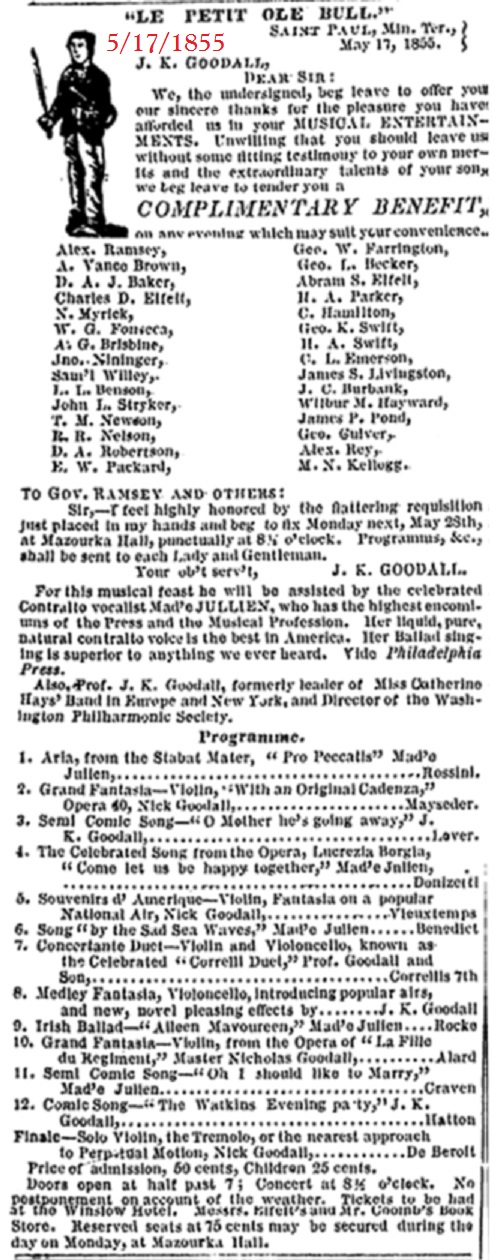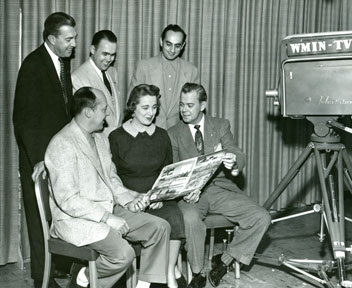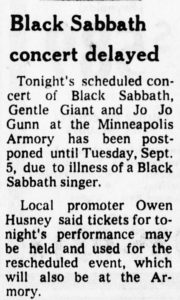This “Events” page of my Twin Cities Music Highlights website is a chronological list of concerts and other music-related happenings that took place here in the Twin Cities, primarily focusing on national acts that came here. The chronology generally stops at 1974, with a few exceptions, mostly for St. Louis Park-related people and events. If you have more information, memories, photos, or ads, please contact me!
If you know what you are looking for, use the search feature in the menu bar to go right to it.
NOTES
*Almost all of these dates come from ads that were published ahead of time, and there is no guarantee that the event actually took place unless there is a comment or review with it. Lots of times bands cancelled or were substituted after the show was listed in a “Coming Events” section of a magazine or newspaper. Don’t be shy about correcting me.
*I have a TON of information and photos yet to post. I also got better at photo shopping pictures, so I hope to be replacing many of them, if I live long enough.
*This site is poorly annotated and can never be a book because in most cases I can’t go back and trace my sources. The beauty of websites.
VERY IMPORTANT!
This Events page got TOO LONG, so I was forced to cut it up some. All shows at certain venues are now listed under the appropriate venue page. Still working on this. So far, this is true for:
- Depot
- Danceland
- Guthrie Theater
- Eagles Hall/Labor Temple
- Metropolitan Sports Center (“Met Center”)
- Minnesota State Fair
- Someplace Else
Events at Mazourka Hall: 1850 – ?
The earliest known hot spot for entertainment in the Twin Cities was the Mazourka Hall, built in 1850 at Third and Exchange Streets in St. Paul. See Venues listing for pictures and information about this important dance hall.
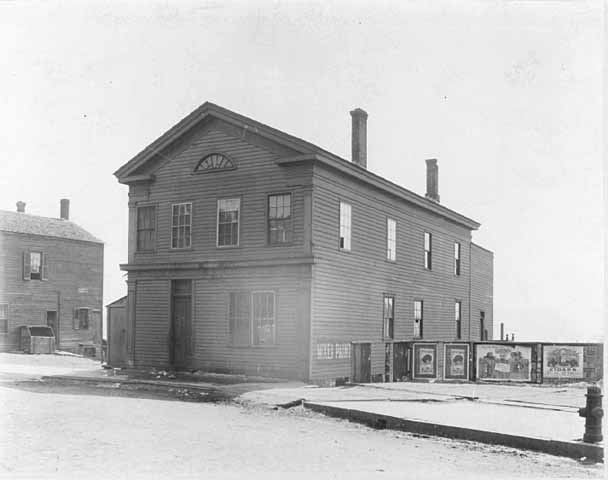
Mazourka Hall – Courtesy Minnesota Historical Society
Adelina Patti and Ole Bull: 1856
In 1856, Adelina Patti and Ole Bull appeared together in Fletcher’s Hall for a concert. Patti was just 13 years old at the time , but would become the world’s most acclaimed soprano of her time. The Minneapolis Journal described the visit:
The company came by stage from St. Paul on a hot July day. They had been journeying west for several weeks, and as one of them expressed it, had at last reached a jumping-off place. Miss Patti’s father accompanied the party.’
Ole Bull’s scrutiny of the floor resulted in the propping up of the floor; the supports being placed in Archie McGhee’s store so that the audience might not fall through.
The stage was located on the Helen Street side of the hall and in order to reach it the performers were obliged to walk a plank from their “dressing room” over the heads of part of the audience
Dixie in St Paul: 1858
An article by Irv Letofsky in Select Magazine (March 1961), tells the story of the Minnesota connection to the very Southern song “Dixie.” There is no question that the song was written by Daniel Decatur Emmett, but there is some controversy as to where and when. According to St. Paul historian Mark Fitzpatrick, Dan wrote it in the summer of 1857 on the porch of his brother’s house in St. Paul. His brother was Lafayette Emmett, who was the first Chief Justice of the Supreme Court of Minnesota. (Lafayette’s house, perhaps the first brick residence in the city, was located at 279 West Seventh Street and was torn down in 1942.) Dan was in town that summer playing in the Old Gents’ Band, backing Sallie St. Clair’s Varieties in Market Hall. Fitzpatrick asserts that Dan took the “crude manuscript” to the Munger Ben’s Music Hall on Kellogg Blvd. and played it on his violin, receiving enthusiastic applause. “Newspaper files in the Twin Cities reveal frequent and insistent testimonies of oldtimers that “Dixie” was first sung to Russ Munger and that Munger asked Emmett to present it in a show at the old Ingersoll Hall on Wabasha Street between Second Street and Kellogg Blvd.” This was probably an earlier version of the song.
Other experts claim that the song was written the next year, when Emmett returned to New York City and joined Dan and Jerry Bryant’s Minstrels. Dan asked Emmett to write a “walkaround’ or “hooray” number for the next show – something catchy that people would whistle in the street. That story was that he composed the song “Dixie,” which was brought to the public a year and a half later in a show called “Pocohontas,” (sic) showing in New Orleans. It was sung by Miss Susan Denin and “the audience immediately lost its collective mind.”
Emmett told conflicting stories of the origin of the song, but shortly before his death in 1904 he told Lamp Magazine:
On Saturday night Dan Bryant requested me to write a walkaround for the following week. The time allotted me was unreasonably short, but, notwithstanding, I went to my hotel and tried to think out something suitable. But my thinking apparatus was dormant.
Then, rather than disappoint Bryant, I searched through my trunk and resurrected the manuscript of “I Wish I Was in Dixie’s Land,” which I had written years before. I changed the tempo and rewrote some of the verses, and in all likelihood, if Dan Bryant had not made that hurry-up request, “Dixie” never would have been brought out.
Minnesota Cadet Lancers: 1883
A tune called “Minnesota Cadet Lancers” was written by Lawrence Schaich in 1883. The tune was “Respectfully Dedicated to Gov. L.P. Hubbard, St. Paul, Minn.” What’s interesting is that the second page has “figures in full for dancing,” as taught by Prof. R.H. Evans at his academy, Sherman hall, St. Paul.
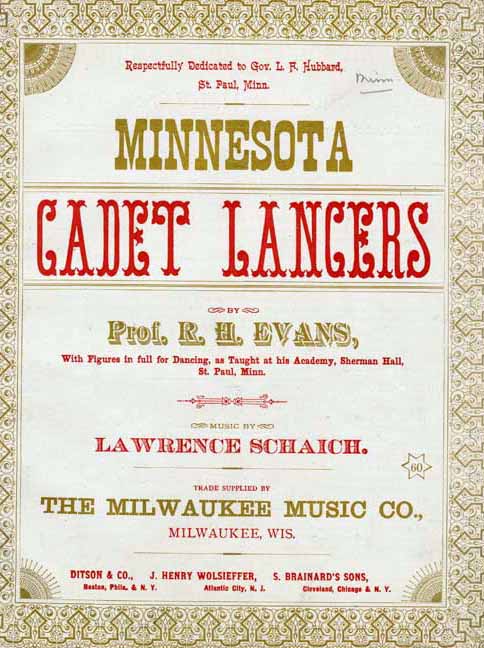
Above and below: Minnesota Historical Society
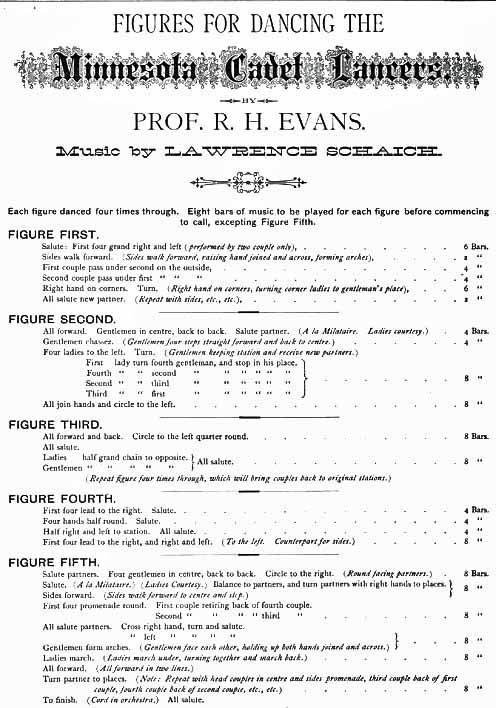
The Grand Opera House celebrated its opening all through the week of April 2, 1883. Musicians included:
- Theodore Thomas’s Orchestra
- Minnie Hauk
- Marie Litta
- The Amherst Glee Club
- The Oberlin Glee Club
- And to furnish lighter entertainment, the Chicago Church Choir Opera company in “Pinafore,” “Chimes of Normandy, and “Patience.”
The audiences were overjoyed with Thomas, but felt that both Hauk and Litta would have been more effective in genuine opera, than in a concert version of it. Minnie Hauk, who was known to b more or less temperamental, lived up to her reputation by exhibiting certain wilful eccentricitities. As the chorus was ready to sing the finale of the first act of “Lohengrin,” she suddenly walked off the stage, leaving them quite nonplussed. The next evening she dismissed the orchestra and sang with piano accompaniment, because they could not transpose the parts one note for her. (Minneapolis Tribune, February 10, 1935)
Fair Minneapolitan Waltz: 1886
In 1886 Gabriel Garzon published the “Fair Minneapolitan Waltz” for piano, “Respectfully Dedicated to the Ladies of Minneapolis.” Garzon was apparently from the 1st Regt. Artillery Mexican Band.
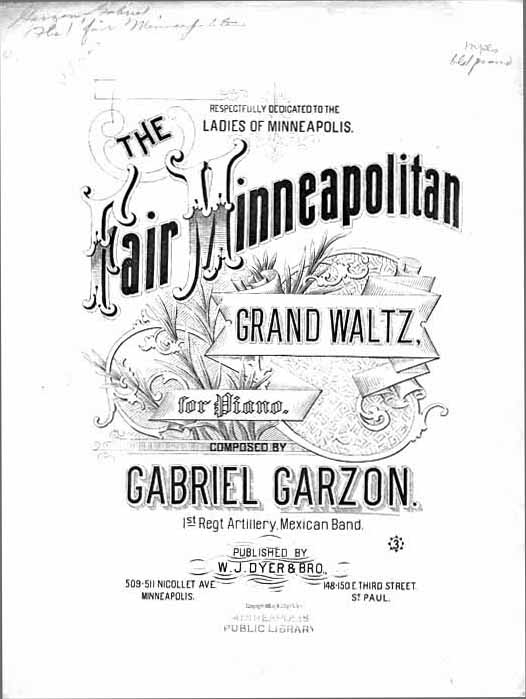
Minnesota Historical Society
Return of Adelina Patti: 1887
The biggest musical event of the decade was the return of Adelina Patti. Although advertised as her first and last visit to Minneapolis, she had been here in 1856, at the age of 13, a child phenom. She was now making her farewell tour, slated for March 2, 1887, at the Washington Rink. This was apparently an enormous roller skating rink, located at 10th Ave. No and Washington Ave. It measured 330 ft. by 100 ft., with an annex measuring 150 ft. by 50 ft. – at least as reported in 1884 at its Grand Reopening. The description of this event by the Minneapolis Tribune is pretty funny:
Those who had bewailed the moral condition of Minneapolis, saying that “nothing draws like a prizefight,” were compelled to admit that nothing draws like Patti, for the crowds that set out to attend the concert soon became a jam, and then a moving sea that poured itself into the old Washington rink. As usual, there were many assisting artists, including Sofia Scalachi, but it was Patti for whom the the audience eagerly waited. She sang an aria from “Lucia,” using for encore, “Within a Mile of Edinburgh Town,” and “Coming Through the Rye,” and for her second number, “The Last Rose of Summer,” with “Home, Sweet Home” to follow. The program concluded with selections from “Semiramide” and the audience was finally forced, reluctantly, to say a long farewell to Adelina Patti, queen of song.
Sangerfest: 1889
According to the Minneapolis Tribune,
Quite the biggest affair of 1889 was the northwestern sangerfest, at the Exposition building, where a chorus of about 700 voices sang under the direction of Richard Stempf. (February 10, 1935)
Boston Symphony Orchestra: 1890
From the Minneapolis Tribune, February 17, 1935:
The grandest musical event in the history of Minneapolis to that date occurred when Arthur Nikisch came in May [12], 1890, with the Boston Symphony Orchestra. The concert was given in the University coliseum, and to take care of the crowds the railroads had trains stop at the University station, and street car and horse car service was amplified. There were a few drawbacks to the occasion. The acoustics of the building were peculiar, the electric lights hissed throughout the evening, the orchestra had had no rehearsal in the auditorium and the manager had seen fit to lighten the quality of the program, doubtless feeling that it might be above the comprehension of the audience. But everyone marveled at Nikisch’s conducting and was pleased to know that the American musical public had transcended his most favorable anticipation of it.
The Minneapolis Journal Waltzes: 1890
Ion Arnold composed “The Minneapolis Journal Waltzes,” as played by the Reeves American Band at the Minneapolis Exposition in 1890. The tune was dedicated to the “Orpheus.”
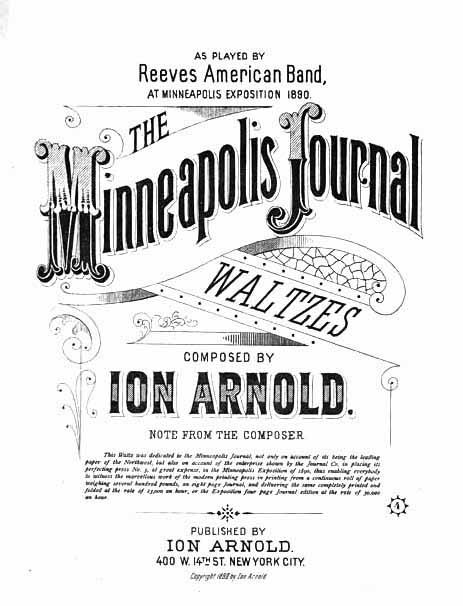
Minnesota Historical Society
Minneapolis Musicians Union Local 73: 1891
The Minneapolis Musicians Union Local 73 was organized on April 30, 1891. It was chartered on June 8, 1901.
Minstrel Shows: 1891
The phenomenon of Minstrel Shows is beyond controversial and apparently came late to Minnesota. Wikipedia gives the peak years of the genre as the 1830s and 1840s. A quick look at the Minneapolis newspaper archives shows that the first such show came to Minneapolis in 1867 and every year thereafter. 1890 appears to be the year that the shows ramped up in popularity locally, appearing in ads for several local theaters. The first shows were probably traveling shows featuring white men in blackface: the first troupe was called Duprez and Benedict.

December 7, 1891
As these faded, the genre continued as sketches on variety shows or as entertainment put on by schools and church groups. Push back finally came in the early 1960s; Minneapolis Tribune columnist George Grimm made it clear in his “I Like it Here” column of February 27, 1960, that they weren’t funny anymore, and no long acceptable. He reprinted the column verbatim on January 19, 1963, and vowed to keep reprinting it every two years. Wikipedia did point out that Archie Bunker appeared in blackface in 1975, but here in Minnesota, it appears that the odious olios had about a 100 year run. The last one I found in the paper was put on by a school PTA in Blaine in 1969.
The Appeal: 1892
William A. Weir wrote a song called “The Appeal,” “Respectfully Dedicated to J.Q. Adams, editor of The Appeal, the leading Afro-Amierican journal of the U.S.” The Appeal was founded in St. Paul in 1885; the song was published in St. Paul by W.J. Dyer and Bro.
The Minnesota Boat Club March: 1891
“The Minnesota Boat Club March” was written by Emile Oberhoffer in 1893. The song was dedicated to the Minnesota Boat Club of St. Paul. It was composed for the pianoforte and has no words.
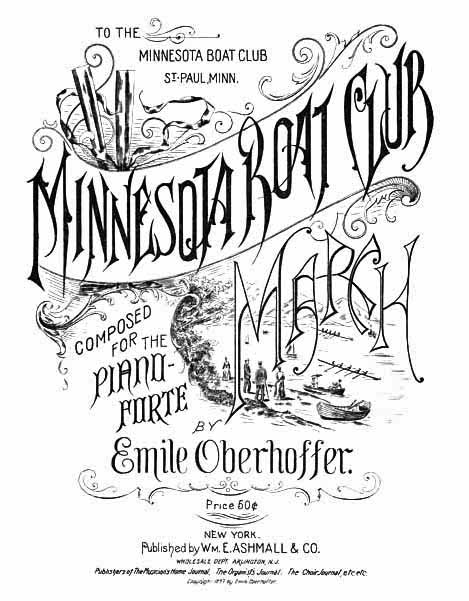
Minnesota Historical Society
Norwegian Independence Day: 1897
On May 17, 1897, Norwegian Independence Day, the statue of Ole Bull was dedicated in Loring Park.
University Two-Step: 1897
James H. Morrison, Jr. composed the “University Two-Step” in 1897, dedicated to the faculty and students of the U of M. Other than the words “Rah! Rah! Rah! Ski-U-Mah! Varsity! Varsity! Min-Ne-So-Ta!” there are no actual words to the song.
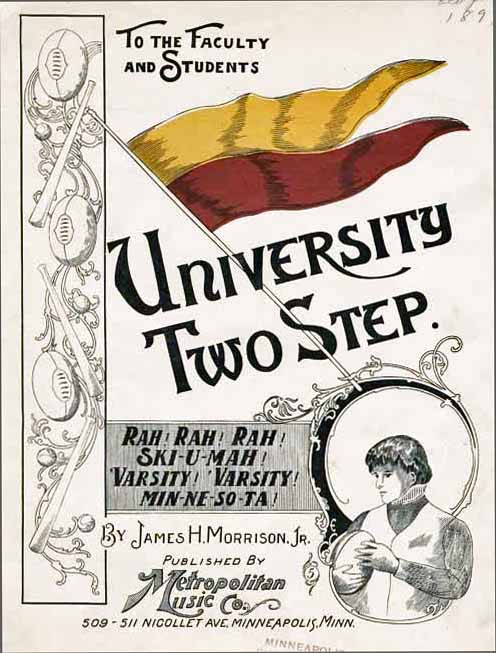
Minnesota Historical Society
Minneapolis Journal March, 1899
“The Minneapolis Journal March,” a two-step or cake walk, was composed by Edmund Braham in 1899.
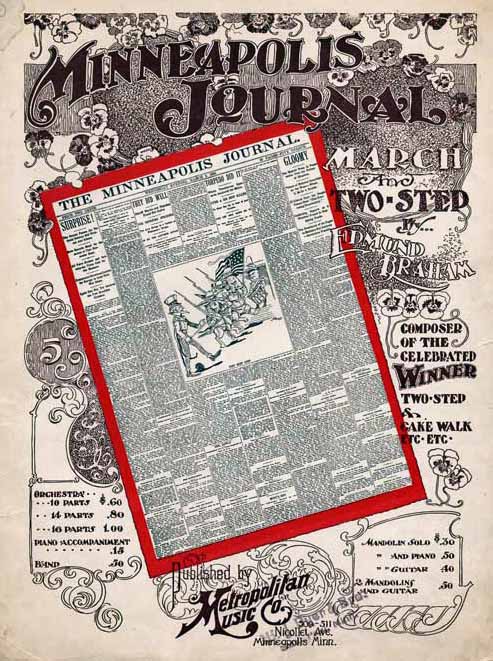
Minnesota Historical Society
The Minneapolis Song: 1903
“The Minneapolis Song” was published in 1903, word and music by “Monssini.” Inside it says acc. by L.O. Shibley. The chorus goes:
“Minneap’lis, of fair city of bright waters
Yet brighter, fairer be thy sons and daughters
Sailing gaily on thy lakes and laughing waters
Minneap’lis beautious city of the west”
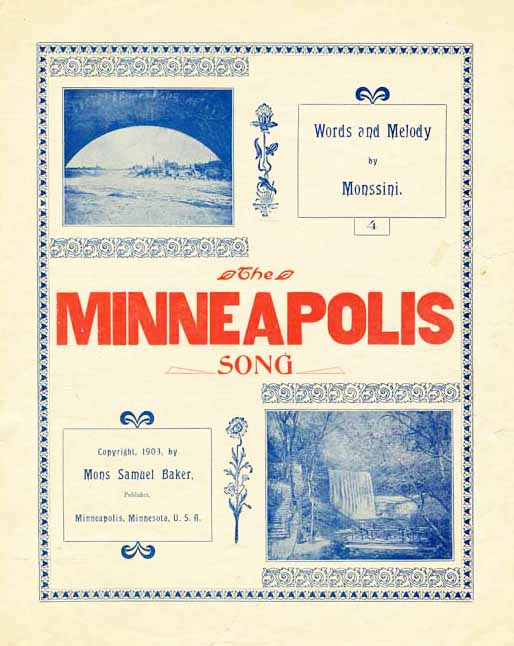
Minnesota Historical Society
Another 1903 song was the “Minnesota Street Rag,” composed by Fred Swanson. It was published by the American Music Publishing Co. in St. Paul.
Snelling: 1904
“Snelling,” a march and two-step composed by Schurer Werner, was published in St. Paul in 1904. Photos of both the Fort and the man are on the cover of the sheet music.
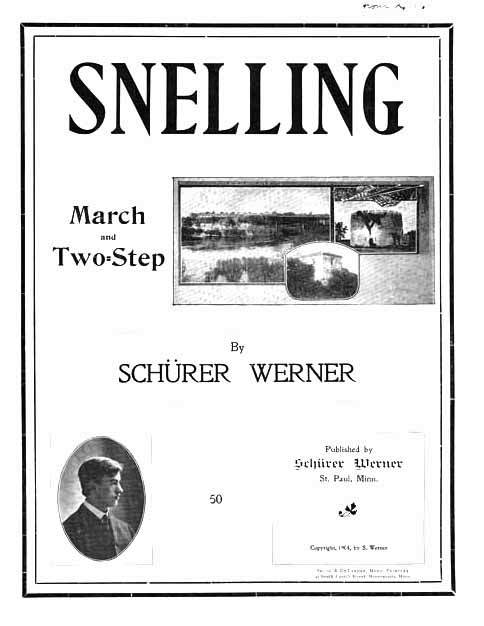
Minnesota Historical Society
Hollow Skating Rink Band: 1907
This is something called the Hollow Skating Rink Band, St. Paul, 1907.
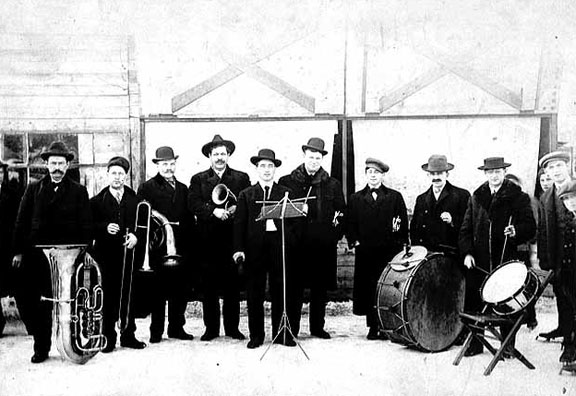
Minnesota Historical Society
Floating Dancing Pavilion: 1908
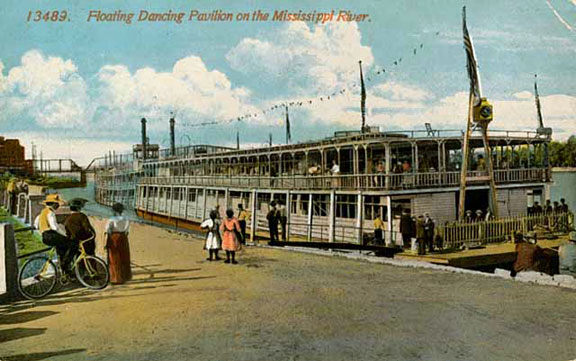
Floating Dancing Pavilion on the Mississippi River, 1908 – Minnesota Historical Society
Ski-U-Mah, an Indian Intermezzo: 1908
A new song in 1908 was “Ski-U-Mah, an Indian Intermezzo,” dedicated to the U of M’s football team. Words by Peter Fandel, music by Louis Rosenberger. Published by Rosenberger Publishing Co., 56 E. 6th Street, St. Paul.
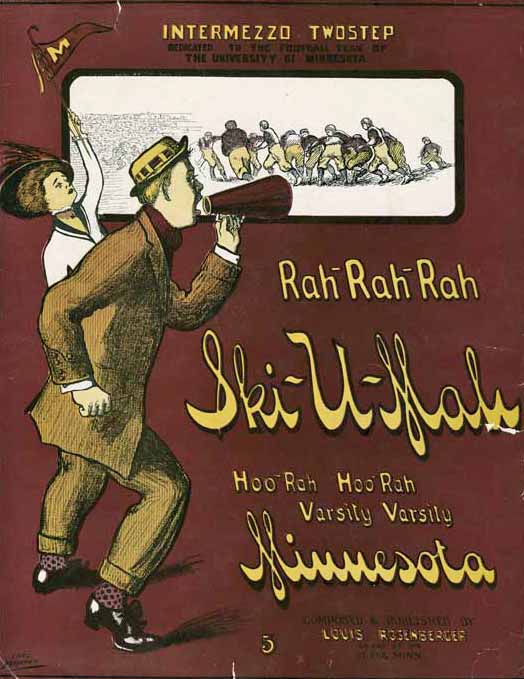
Minnesota Historical Society
Street Dance at a Carnival: 1910
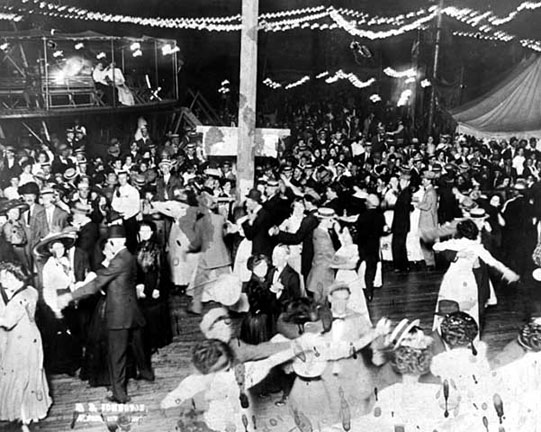
Street dance at a carnival in the Thomas-Dale neighborhood of St. Paul, near Rice and University. Minnesota Historical Society
Crossing the Desert: 1914
“Crossing the Desert,” a march and two-step for pianoforte, was composed by Arthur Wasshausen of Minneapolis. The song was “Respectfully dedicated to Zuhrah Temple,” Minneapolis, Minnesota, November 12, 1914. The sheet music was published by Ivy M. Wasshausen, 3503 33rd Ave. So., Minneapolis.
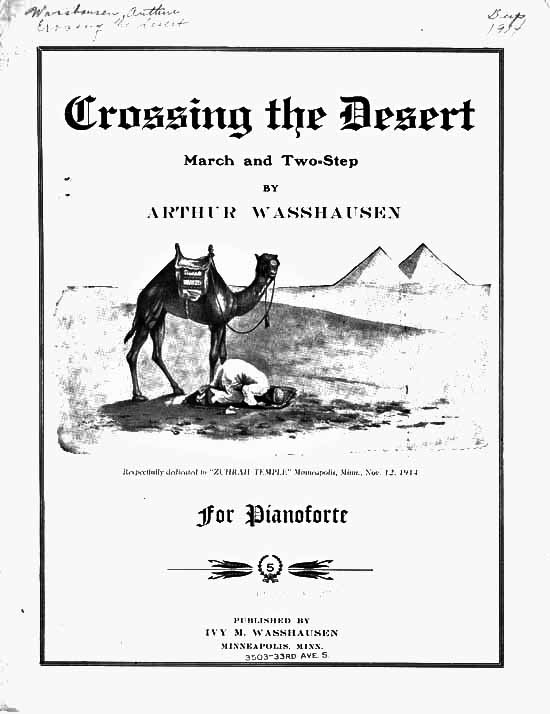
Minnesota Historical Society
Social Dance in the IOOF Hall: 1915
Assuming this is in St. Louis Park: “Odd Fellows and Rebekahs and their friends enjoyed a very pleasant social dance in the IOOF Hall Monday evening [January 4] after the regular Rebekah session at which over forty couples tripped the light fantastic to the strains of music furnished by Johnnie, Frank Sefcik, Miss Sue Wheeler.”
Married Folks Dancing Club Events: 1915
The Married Folks Dancing Club held their events in Olson’s Hall in Hopkins starting on January 9, 1915. The Hennepin County Enterprise had fun reporting this:
Big Attendance Marks First Ball
Seventy Odd Couples of Married Folks Worship at Shrine of Terpsichore With Old Style Dances
No dazzling young tango artist or the spritliest spirit that ever danced the maxixe nor the sweetest thing that ever adorned the floor in the turkey trot – none of ’em – have anything on Hopkins’ married folks when it comes to mixin’ it at the shrine of Terpsichore as revealed by the first dance of the Married Folks Dancing Club held in Olson’s Hall Saturday evening.
There probably is not much difference in the amount of enthusiasm shown by the married folks at their hop but there is a difference in the kind of dances enjoyed. The married ‘uns eschewed the later creations which are the inventions of a few dancing masters for monetary reasons only, and the old style waltz, the two step, the Bohemian polka, the rye waltz, and others with an occasional old fashioned quadrille thrown in all went to make up the program of the evening at which some seventy odd couples participated and enjoyed themselves to the limit – and then some.
It would be superfluous to state that the first session was a grand success. Grey headed lads and lassies and lads with wide, smooth “boulevards” prominent when their heads were uncovered, who had not “mixed” for years and whose feet had not been “shook” for so long that a specie of “hesitation” was apparent early in the evening, finally warmed to the fun and when quitting time came still stayed on for another hour of pleasure and enjoyment.
…
There will be no “youngsters” there to offend you with the “boll wiggle weavel,” the “honey bug” or any of the rest of those new fangled “aggravations,” for the unmarried kiddies are all barred.
For the second dance, “The ladies are all requested to bring baskets with lunch for two and coffee will be served in the hall. Contrary to the usual custom the ladies will be allowed to select their supper partners instead of the gentlemen.” I hope so! Claggett’s Orchestra provided the music for both dances.
Dance at Opera Hall: 1915
A dance was held at Opera Hall in Hopkins after a basketball game between the Hopkins AA “quint” and the Apex quint of Minneapolis on January 14, 1915, and repeated on March 27. Music for both dances, “which will be attended by a large number of young folks from Minneapolis, will be furnished by Claggett’s Orchestra of six pieces.”
There was a big masquerade ball at Dania Hall on February 27, 1915.
On April 30, 1915, Claggett’s Orchestra went to Green Isle for a grand ball. Green Isle is a tiny town in Sibley County; in 1910 it had 192 families.
All Star Home Talent Minstrel Show: 1915
St. Louis Park held an “all star home talent minstrel show” at the High School Auditorium on December 1, 1915, under the auspices of the St. Louis Park Commercial Club. We may have a picture of this.
Hellraising in Hopkins: 1915
If you thought these rural dances were all civilized and proper, apparently you were wrong. The good ladies of Hopkins had had enough of these rootin’ tootin’ hoedowns.
December 4, 1915. To the Honorable Council of the Village of West Minneapolis. [Hopkins wasn’t officially Hopkins until 1928.] Gentlemen:
We, the ladies of the Women’s Improvement League of Hopkins, hereby make an urgent petition that your body take steps to remedy the depolorable conditions that attend some of our Saturday night-Sunday morning dances by passing an ordinance calling for a 12 o’clock lid, and also restraining outside elements from using Hopkins as a “dumping ground” for their undesirable population. It is not through our own people that Hopkins gets its reputation but it is on account of these outside influences that the wrong impression is received and given out. A repetition of such dances as was given here on Saturday, November 27th, would be an insult to every man, woman and child of this village.
We feel that a twelve o’clock lid would do much toward remedying the conditions and that it would not work a hardship on any of the dancing public or lodges of our town.
Hoping that the above will meet with some favorable action by your Body and that it will be accepted as a move for a “Better Hopkins,” we respectfully submit the same for your consideration.
The report prefaced this petition in the Hennepin County Review with these words:
Every right-minded person desiring the best for their village should give this subject their keenest attention and do all in their power to make the name of Hopkins one to be proud of.
Now if we only knew where they were holding these rowdy dances!
Thank you to Mary Raabe of the Hopkins Historical Society for sending along this item!
Married Folks Dancing Club Opening Ball: 1916
The Married Folks Dancing Club held their 1916 Opening Ball on January 22, 1916 at Olson’s Hall, Hopkins. Music furnished by the Hopkins Orchestra.
Minnesota Mine: 1918
The song “Minnesota Mine” was presented to the Minnesota Federation of Women’s Clubs by the Federation’s Fifth District in 1918. Words were by Margaret Landor, music by Willard Patton. The song was published in Minneapolis, home of the Fifth District.
United Artists’ Symphony Orchestra: 1920
On April 17, 1920, Dick Long conducted the United Artists’ Symphony Orchestra at the Minneapolis Auditorium. They may have been showing movies at the same time.
The School of Dancing was taught by Claire Coutant at Carville Hall, 26 W. Lake Street. An ad from October 2, 1920, lists the dances taught as Russian Toe, Greek, Oriental, Buck and Wing, and Ballroom.
Performances: 1920
Clarence William Miller remembered the following musicians who performed in the North Side night clubs:
- Eli Rice
- Rook Ganz
- Ray Dyset
- Leon Lewis
- Clarence Johnson
- The Pettifords
- Scottie Williams’ Combo
- Mr. Black’s Band
On April 17, 1920, Dick Long conducted the United Artists’ Symphony Orchestra at the Minneapolis Auditorium. They may have been showing movies at the same time.
The School of Dancing was taught by Claire Coutant at Carville Hall, 26 W. Lake Street. An ad from October 2, 1920, lists the dances taught as Russian Toe, Greek, Oriental, Buck and Wing, and Ballroom.
Performances: 1921
A male trio “will sing every day at Gopher Gunners’ Carnival,” advertised the Minneapolis Morning Tribune in March 6, 1921. “Every conceivable brand of music will be offered in the Gopher Gunners’ carnival all next week, according to Dr. Arthur E. Allen, director. Among these will be a trio presenting songs hot off the music press and sung probably for the first time in Minneapolis. The trio included Ronald Jonson, Arthur White and Harry Kessell.
“Yes, Blossom’s Here Again!” crowed the Minneapolis Morning Tribune on March 6, 1921. That’s Blossom Seeley, appearing at the Orpheum in “Miss Syncopation.” Assisting her were Bennie Fields, Sam Miller and Harry Stover.
The Everett McClay Post of Eden Prairie gave a series of dances at Millers Hall in the fall of 1921. These locations were never identified – guess everyone knew where Millers Hall was.
Gopher Gunners’ Carnival: 1921
A male trio “will sing every day at Gopher Gunners’ Carnival,” advertised the Minneapolis Morning Tribune in March 6, 1921. “Every conceivable brand of music will be offered in the Gopher Gunners’ carnival all next week, according to Dr. Arthur E. Allen, director. Among these will be a trio presenting songs hot off the music press and sung probably for the first time in Minneapolis. The trio included Ronald Jonson, Arthur White and Harry Kessell.
“Yes, Blossom’s Here Again!” crowed the Minneapolis Morning Tribune on March 6, 1921. That’s Blossom Seeley, appearing at the Orpheum in “Miss Syncopation.” Assisting her were Bennie Fields, Sam Miller and Harry Stover.
The Everett McClay Post of Eden Prairie gave a series of dances at Millers Hall in the fall of 1921. These locations were never identified – guess everyone knew where Millers Hall was.
By the Waters of Minnetonka: 1921
In 1921 the song “By the Waters of Minnetonka, An Indian Love Song” by Thurlow Lieurance was published. The song was dedicated to George Oscar Bowen and the Mendelssohn Club. It appears that it was included in a 1925 compilation of Lieurance’s Indian songs.
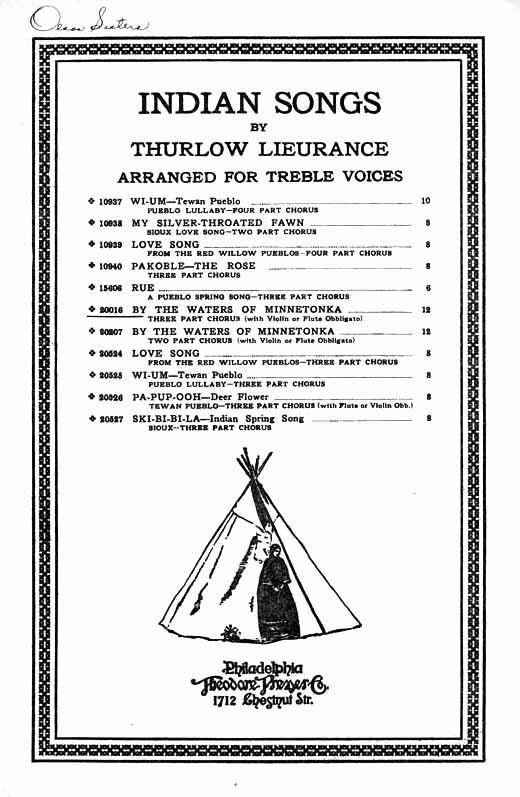
Minnesota Historical Society
Minnie from Minnesota: 1921
Another Minnesota number from 1921 was “Minnie from Minnesota,” a one step, fox trot ballad. Words, music, and all arrangements by Ed Chenette. “As Refreshing as the North Wind – As Magnetic as the North Star”
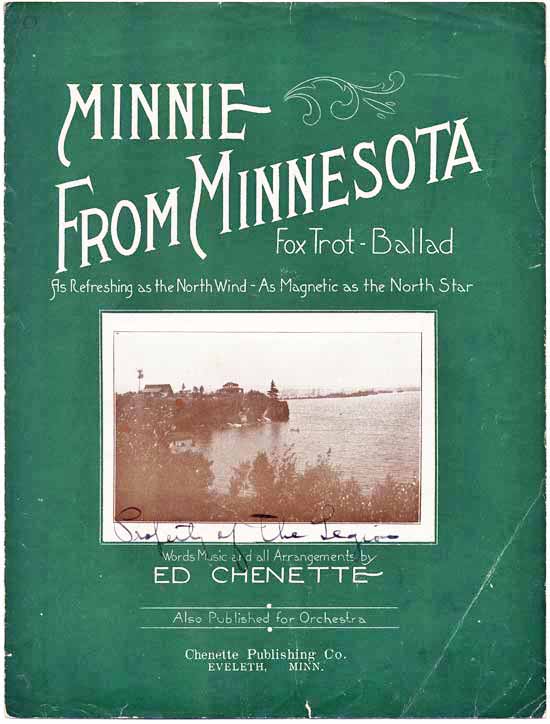
Minnesota Historical Society
Although Chenette was apparently from Eveleth, this sheet music is fun because it has a page that introduces a “New Novel Movement in Dancing” called SWAYING. “Also every amusing and effective where the audience is seated, in the Parlor, Theater, etc.” “SWAYING” is more fun than the Shimmy – Swing It – Sway It – Dance It – Play It. When used when audience is seated, in theatre or parlor, have them take hold of hands and sway throughout entire Chorus.”
Shores of Minnetonka: 1921
And still another local tune from 1921 was “Shores of Minnetonka,” a sweet love song with words by Gus Kahn and music by Percy Wenrich. The first line of the chorus is:
“Drift with me, along the shores of Minnetonka
where I first made love to you”
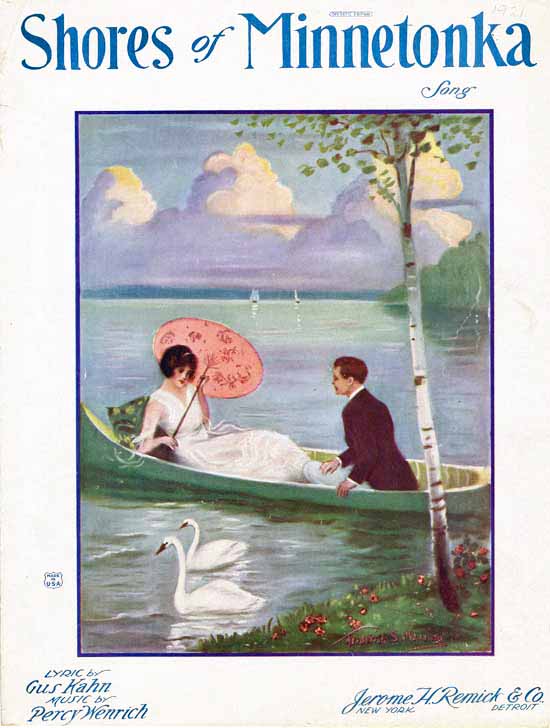
Minnesota Historical Society
Dances: 1922
A look into what the black community was listening and dancing to in the 1920s comes from the Northwestern Bulletin, a weekly out of St. Paul. There was also the Western Appeal, which began in 1885 and became just the Appeal in 1889. It must have been a Minneapolis-based paper, as the Appeal and the Northwestern Bulletin ran concurrently from February 1922 until they merged to become the Northwestern Bulletin-Appeal in January 1924 until August 1925. I started looking at the Northwestern Bulletin when it started in March 1922.
And it looks like the tiny black community was having some fun in the Roaring ’20s! Despite Prohibition, and the fact that they were unwelcome at downtown hot spots, they held their own dances, balls, picnics, and other gatherings.
The sponsors of these events were generally clubs or Fraternal organizations like the Elks, Masons, and the Knights of Pythias.
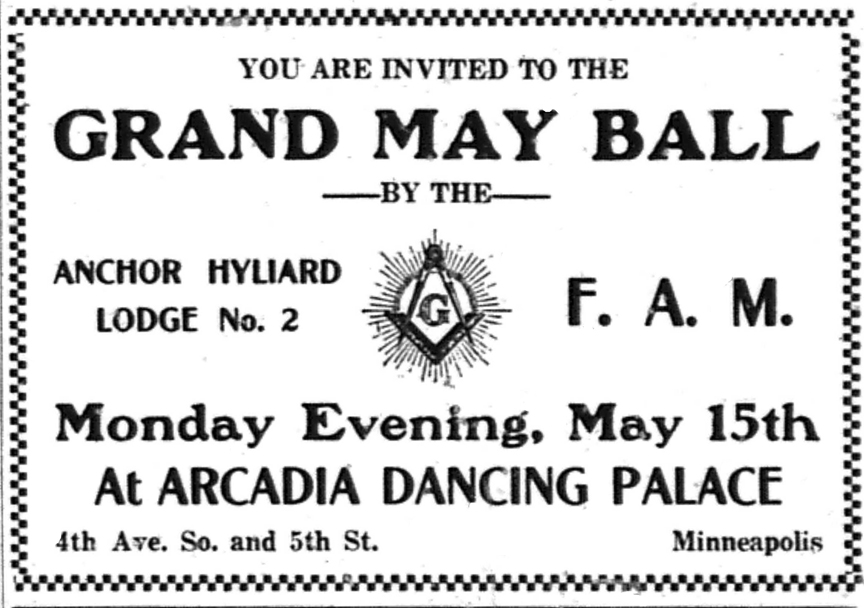
Northwestern Bulletin, 1922
By the way, just to make it interesting, there were two Arcadia Dancing Palaces:
- 8th and Cedar in St. Paul – this was referred to as Dreamland Hall in March 1922, but that name would come back again and again as well.
- 315 Fifth Street So. in Minneapolis.
And there were two Coliseums, too:
- Lexington and University, St. Paul
- 2708 West Lake Street, Minneapolis. This building still stands!
Other popular venues were:
- Union Hall, St. Paul
- Elk’s Hall, Minneapolis
- South Side Ballroom, Minneapolis
And then there were the dances! One enticement to come to a ball or a dance was to learn a new dance.
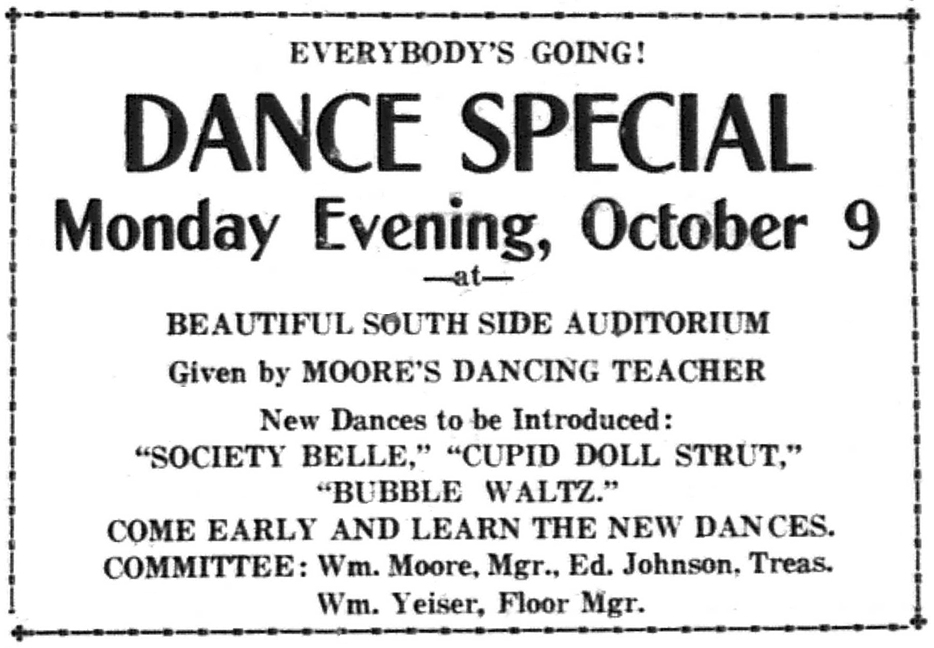
Northwestern Bulletin, 1922
The Hennepin County Enterprise shows that things were hoppin’ west of Minneapolis:
- There was a Town Hall Dance in Minnetonka Mills on October 8, 1922 – admission 25 cents. “New and Old Dances”
- In October there was a Masquerade Ball at the Oak Knoll Barn on Superior Blvd. (which became Wayzata Blvd.), five miles west of (Minneapolis?) city limits. Music by Ernie and His Oriole Syncopators.
- A New Year’s Eve Dance was held at Olson Hall (Hopkins?), with music by the Hopkins Junior Band.
Songs: 1922
As for the songs of the time, here’s a list available from the Peyer Music Co. See Record Stores for ads for more stores from 1922 and 1923.
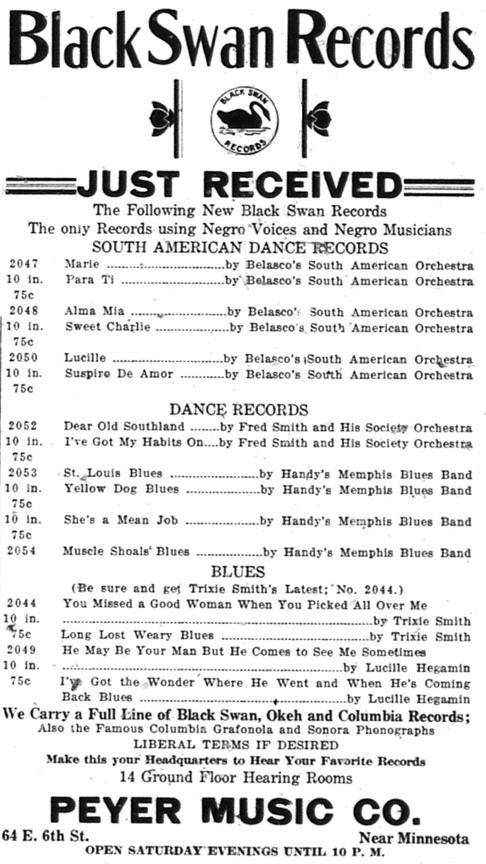
Northwestern Bulletin, May 20, 1922
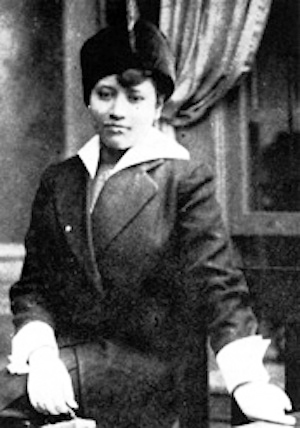
Lucille Hegamin, singer of “He May be your Man but he Comes to see Me”
Moonlight River Excursion: 1922
A big activity in the summer was the Moonlight River Excursion, taking off from Jackson Street. Each excursion advertised in the Northwestern Bulletin took place on the Steamer Red Wing and Barge Manitou. I count 14 of these in the summer of 1922, sponsored by groups like the Unity Club, the Twin Cities Pleasure Club “Depot Red Caps,” the Kingston Girls of Minneapolis, and the Railroad & Working Men’s Association. I would guess these were also fundraisers. The band pictured below only has about half a dozen men, but Moore’s band had up to 15 members at some points.
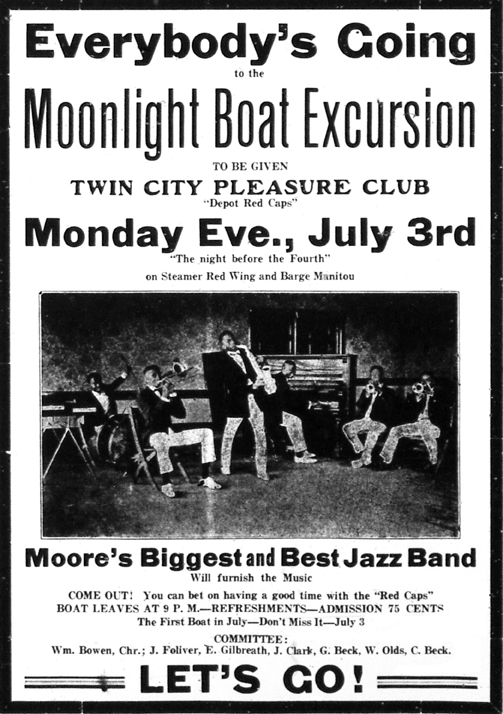
Northwestern Bulletin, 1922
Bands: 1922
As for the bands, one stood out head and shoulders above the rest – apparently the crowds either never tired of the many iterations of William Moore’s orchestra, or there weren’t many other jazz bands around in 1922-23. The number of pieces in Moore’s bands and orchestras varied, and a few times he moved into whimsy, calling his men Moore’s Jazz Hounds; by the end of 1923 he was calling it Moore’s Town Talk band. A quick and dirty tally of the 1922 events I recorded showed that he played at 42 out of 67 dances! His band featured Louis Sklar on saxophone and clarinet, and David Brown on sax as well
Other bands had much better names:
- Steven’s Jazz Canaries/Harmony Kings/Harmony Boys, featuring “Sid” Williams, (Sheik of the Piano). The Harmony Kings were “the Boys that put the “Pep” in Pepper.” Stevens’ Orchestra was Moore’s closest competitor.
- New Jazzland Orchestra
- Gopher’s Jazz Knockers (“Come and hear them play those Gopher Blues; That Gopher Club Punch Can’t Be Beat”)
- Little Bennie’s Argentine Red Caps
- Nu-Way Jazz Hounds, “Featuring Irresistible Syncopation of Mirth”
Bluettes: 1922
In October 1922 you could hire the Bluettes, a five piece girl orchestra, playing music for all occasions. The novelty band emphasized harmony and featured solos, according to its publicity. Manager: Alfred O. Payette; Director, Richard L. Nelson.
Guessing Party and Dance: 1922
Many of the dances were fundraisers – the one below was to buy uniforms for musicians. The South Side Auditorium, located at 12th Ave. So. and 3rd Street, was a hugely popular venue for dances in the black community in the 1920s.
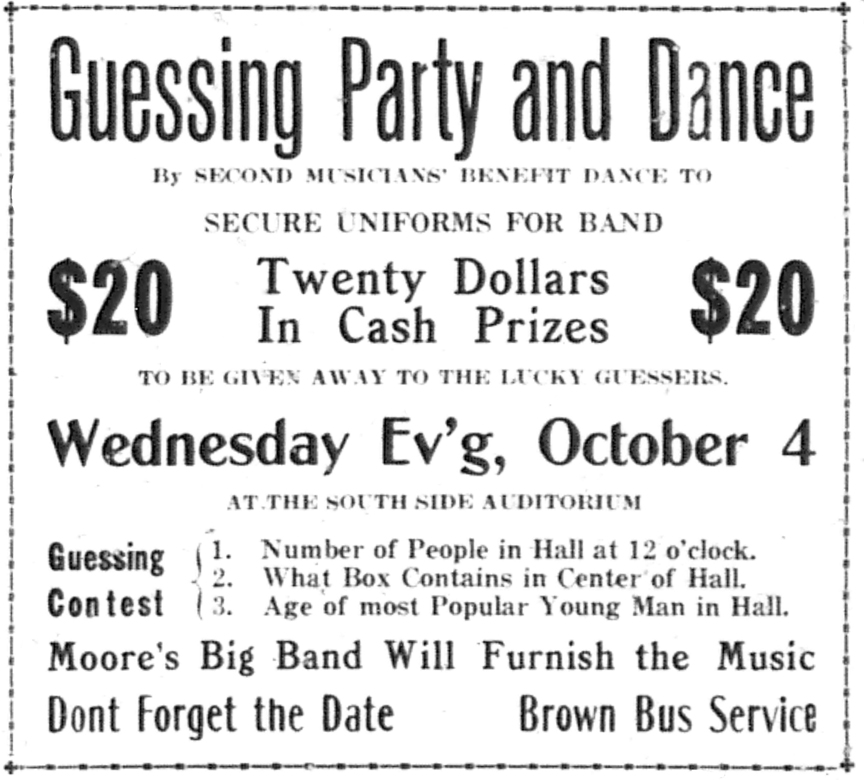
Northwestern Bulletin, 1922
Grand Exposition and Style Show: 1923
On December 10-11, 1923, the St. Paul Negro Business League sponsored the Second Grand Exposition and Style Show at the St. Paul Auditorium. Monday was Minneapolis Night and Tuesday was St. Paul Night. Special features included:
- Vaudeville Dancing
- Speaking by Governor J.A.O. Preus and St. Paul Mayor Arthur E. Nelson
- Popularity Contest (very common in the black community back then)
- Style Revue
- Band Concert
- Dancing all Evening
The Program included music by Moore’s Concert Orchestra and the Capital City Colored Chorus. Dance music was provided by Moore’s Town Talk Band. In the ad we get a list of musicians in Moore’s band:
Violins: William Wise, Jack Austin, Herbert Patterson, Governor Cook
Cornets: Winslow Allen, Todd Williams, Red Bunk, Peter Robinson
Saxophones: Thomas Roulette (also Assistant Director), Theodore Burks, Robert Singer
Piano: Earl Cason
Drums: George Lee
Bass: William Carter
Trombone: Fred Baker
Librarian: Ernest Parker
Director: J.W. Moore
Dinner Dance at the Community House: 1924
The Woman’s Club of Lake Minnetonka put on a dinner dance on February 16, 1924, at the Community House. Music was provided by the “well-known a popular Kelsey Orchestra of Minneapolis… acknowledged to be the best in Minneapolis.” (Minnetonka Record, February 15, 1924)
Ukuleles: 1925
Ukuleles were all the rage in 1925, and Wendell Hall, the “Red Headed Music Maker” and the “Pineapple Picador,” played one on WCCO radio. He was a big deal – Eveready Batteries sponsored him and painted their tops red in his honor!
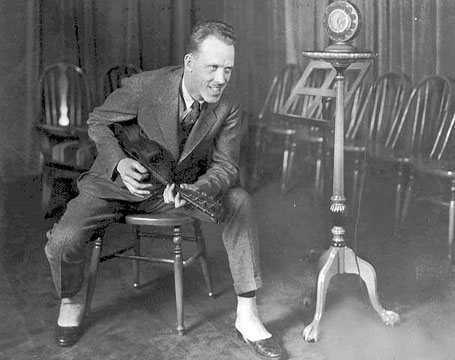
Minnesota Historical Society
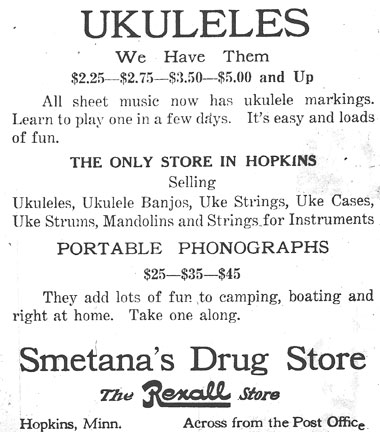
Ad from the Minnetonka Record
Bob Bass Orchestra: 1925
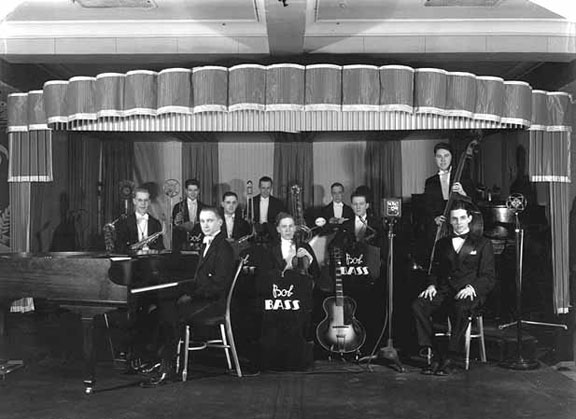
Bob Bass Orchestra, 1925. Minnesota Historical Society
Perfect Records: 1926
In July 1926 you could buy a 59 cent Perfect Record – Plays on all Phonographs – at the Minnetonka Electric Co. Recording artists on Perfect Records included:
- Cliff Edwards
- Lee Morse
- Jimmy Flynn
- Boyd Senter
- Betty Morgan
20th Annual Hennepin County Fair: 1926
The 20th Annual Hennepin County Fair, August 26-28, 1926, featured the usual band concerts by the Hopkins, Osseo and Robbinsdale bands, but also dancing every afternoon and evening to Mabel Connell’s Girls Orchestra on the newly finished dance floor at the Pavilion. The County Fairgrounds were in Hopkins.
Moonshiner’s Dance Part One: 1927
In May 1927 the Gennett Record Company recorded local artists at the Lowry Hotel. It was during these sessions that “Moonshiner’s Dance Part One” was recorded by Frank Cloutier and the Victoria Cafe Orchestra. The side was included in Folkways’ “Anthology of American Folk Music” that was released in 1952. Read much more about this amusing record Here. Hear this strange song on YouTube. A comment on that page says that the fact that this song was recorded there saved the building.
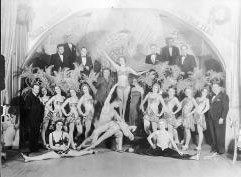
Minnesota Historical Society
First Phonograph Recording
The Minnesota Historical Society’s photo below shows the apparatus that recorded the first phonograph recording in St. Paul, May 1927. In it are Harold Soule, recording engineer, and Grace Slovetsky. Wally Erickson’s Orchestra was apparently one of the earliest groups recorded.
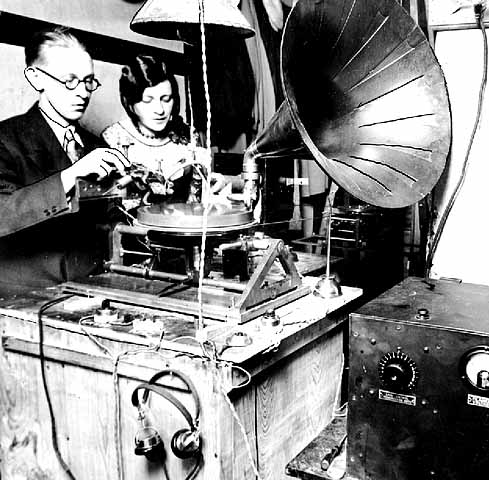
Minnesota Historical Society
Twin Cities Shuffle: 1927-1930
Richard Raichelson describes the musical tenor of the 1920s in the notes of a record he released in 1984 called “Twin Cities Shuffle – 1927 to 1930.”
In Minneapolis, during the twenties, the entertainment strip was along or near 7th Street. It housed numerous clubs, restaurants, theaters, and hotels. Dayton’s tearoom had a three-piece band led by Dick Long. Denny’s, a speakeasy was close by in the basement of Hudson’s Jewelry Store. For 6 years, beginning in 1931, Norvy Mulligan’s band played in the Flame Room of the Radisson Hotel on 7th near Hennepin. They broadcast over KSTP in a program titles, “Dancing in the Twin Cities,” which featured Norvy’s orchestra in Minneapolis and the band at the St. Paul Hotel. Previously, Mulligan’s 12-piece band, with Frankie Roberts, had played at the Coconut Grove on 6th and Hennepin, a club frequented by gangsters. In St. Paul, the classy Boulevard de Paris, now a grocery store, was located near the Coliseum. Mulligan remembered hearing Ban Pollack’s Orchestra there, with Teagarden, in the early part of 1932. Norvy’s band played the club after prohibition ended. Mulligan’s Minnesotans, with Doc Evans, were at the Excelsior Amusement Park, in the town of Excelsior, on and off for 7 years.
Most of the songs were recorded at the Lowry Hotel in St. Paul. Songs on the record are:
- Darktown Shuffle by Eddie Carlew’s Baby Aristocrats Orchestra, recorded 1927
- Indiana HUD, same as above
- Wabash Blues by Tom Gates and His Orchestra, 1927
- The Bucket’s Got a Hole In It, same as above
- Alabama Stomp by Walter Anderson and His Golden Pheasant Hoodlums, 1927
- Melancholy, same as above
- Hokus, same as above
- Sugar Foot Strut, same as above
- Brainstorm, by George Osborn and His Orchestra, 1927
- Black Maria, by Arnold Frank and his Roger’s Cafe Orchestra, 1927
- Jealous, by the Marigold Entertainers, 1929
- When My Sugar Walks Down the Street, same as above
- I Get the Blues When it Rains, by Wally Erickson and his Coliseum Orchestra, 1929
- Hard Luck, same as above
- Skirts, by Slatz Randall and his Orchestra, 1930
- I’m a Ding Dong Daddy From Dumas, same as above
Scott County Fair: 1927
The Scott County Fair in Shakopee took place September 1-3, 1927, reported the Hennepin County Enterprise. Musical features included:
- Free Vaudeville attractions twice daily, with “a very high-class program of Vaudeville features that will entertain and thrill fair visitors of all ages and temperaments.
- The Shakopee Concert Band, playing popular concert numbers
- Dances in Dawson’s Hall on Friday and Saturday evenings, with music by the popular dance orchestra, the Royal Merrymakers. “The orchestra has agreed to play the hottest of hot dance numbers.”
Northwest Radio Show: 1927
The Northwest Radio Show at the Minneapolis Auditorium in September 1927 featured the music of the Buick Gold Seal Vagabonds and soloist Walter Mallory, the Buick Master tenor. The orchestra was under the direction of Clarence E. Olson. The Vagabonds song on the radio in the winter of 1926, sponsored by the Pence Automobile Co. Radio fans made the selection of the band for the Radio Show. (Hennepin County Enterprise, September 22, 1927)
Matt’s Sweet Shop: 1927
Denizens of Hopkins could now go to Matt’s Sweet Shop, which boasted an “Amusement Room, Dance if you like. A delightful place to spend the evening,” advertised proprietor Matt Weldon in October.
Dark Moments: 1927
The Richfield Lutheran Brotherhood gave a minstrel show on October 21, 1927 at the Richfield Roosevelt School auditorium, 58th Street and Blaisdell Ave. “The title of the show is ‘Dark Moments’ by a few white men and is staged under the direction of F.E. (Bud) Neilsen. Music was furnished by the Munsingwear Corporation Orchestra. This inevitably involved white men in black face, although whether any of these men had actually known any black men is a good question. The part of Little Eva was played by Alfred Kallstrom.
Demonic Dance in Red: 1928
Here’s something weird: Art students in the Palettite Society staged a “Demonic Dance in Red” at the Minneapolis School of Art on April 13, 1928. It was the annual benefit ball, with over 100 art students and about 200 guests in various and bizarre costumes. Unfortunately, the band wasn’t named.
The entire building, at 200 East 25th Street, had been transformed through decorations to conform with the popular conception of Hades. There was a dragon 45 feet long, standing guard over a cavern filled with bats. Satan’s disciples danced in the cavern which, under normal conditions, is the auditorium of the school.
Public Dance: 1928
From the Hennepin County Review comes this notice of public dances at the F.J. Kopesky Place starting on June 23, 1928.
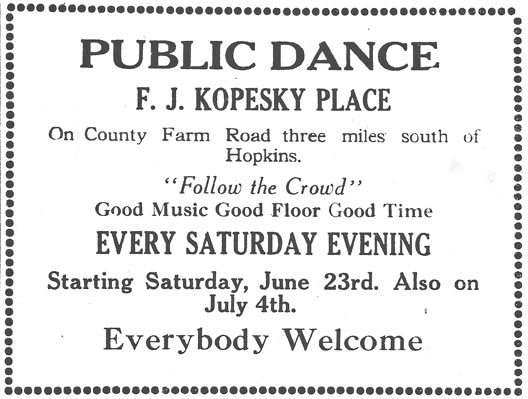
Minnesota Theater: 1928
Louis Armstrong played the Minnesota Theater during the week of June 23, 1928.
Paul Whiteman appeared at the Minnesota Theater the week of June 29, 1928, reported the Minnetonka Record. With the Whiteman Orchestra was legendary cornetist Bix Beiderbecke. This is worth quoting at length:
[Whiteman] was the guest of Hal Kiedel at the Minnetonka Country Club Tuesday morning. Included in the party were Roy Bargy, pianist, composer and recording artist; several boys from the orchestra; and our own Eddie Dunstedter.
The ensuing golf match between Mr. Whiteman and Mr. Dunstedter was the culmination of a bitter feud of long standing between these two artists. In the two half “swore-some” that followed it is needless to say that these to great stylists shot a par 36 for the first nine. Mr. Dunstedter claimed a victory by virtue of the fact that Paul wore rubber-toed shoes and he couldn’t hear him kick the ball around. While Mr. Whiteman indignantly declared he was champion, inasmuch as he couldn’t throw the ball as far as Eddie.
It must be said that as a great golfer Eddie is certainly a wonderful – organist, and Mr. Whiteman’s par 3 on the second hole was a classic and will probably be talked about for years – by him.
Anyway, we are glad such notables visited us.
Eddie Dunstedter recorded some classic Christmas albums,and taught organ at the McPhail Music Center from 1965 to his death in 1974.
New Orleans Rhythm Kings: 1928
In an article about jazz in the Twin Cities, written for Select Magazine in 1960, Leigh Kamman wrote:
According to Alan Doerr, “A red hot band from Chicago that called itself the New Orleans Rhythm Kings came to play in the Twin Cities around 32 years ago. In four years its members had become tops in new era of revival Dixieland. They played at the Marigold Ballroom in Minneapolis. When they departed they left a whole generation of young Minnesota musicians flushed with jazz fever. Their converts remained, keeping jazz alive through the depression and war years when it all but died in most other parts of the country.”
Modern Jazz Piano Lesson
In 1928 Charles Thompson taught a 10-course lesson in modern jazz piano – Studio 110, Studio Building, 64 So. 11th Street, Minneapolis.
Dances: 1928
On May 26, 1928, there was a dance at Olson’s Hall in Hopkins, featuring the University Troubadours, a Hot Six-Piece Band. No apparent reason to say where Olson’s Hall was.
600 guests attended the U of M’s 1928 Senior Prom, which took place in the Gold, Spanish, and Italian Rooms of the Radisson Hotel. There was pre-prom entertainment at 10:30 pm, the Grand March at 11, and a dance that called for “16 dances besides two extras.” Dinner was finally served after midnight, with more entertainment staged during dinner.
The folks down Hopkins way had a dance every Saturday summer night at the Oak Knoll Barn on Superior Boulevard (now I-394) with music by Ernie and His Oriole Syncopators. Gents 50 cents, Ladies free. On October 20 it was a masquerade – “A real good time for all”
An “Endurance Dance” was held starting on Monday, June 18, 1928. See Dance Marathons.
Autumn: 1928
The autumn, 1928, dancing season opened in Hopkins on September 22 when the Eagles Aerie No. 76 held the first dance of a series at Olson’s Hall. Music provided by the popular Silver Mask Orchestra.
31st Annual Scott County Agricultural Society Fair: 1928
The 31st Annual Scott County Agricultural Society Fair was held in Shakopee, August 30-September 2, 1928. Entertainment included free Vaudeville Attractions, the Shakopee Concert Band and the popular Shakopee Trio. Dances were held in Dawson’s Hall with “the snappiest of hot music.”
Bear Cat Dance Marathon: 1928
The Bear Cat Dance Marathon took place at the Kenwood Armory starting on September 5, 1928, apparently going on for 104 hours with the help of Hopkins resident Jimmy Manchester, who entertained for eight hours each day.
Olson’s Hall Free Public Dance: 1928
Bren Brothers’ Hardware Store in Hopkins sponsored a free public dance at Olson’s Hall on September 8, 1928, featuring the “Clever, Talented Entertainers” the Hudson Hot Suns, “a famous colored singing orchestra,” “one of the best singing dance orchestras that has ever been heard here.” “These jolly colored boys are widely known, their music is of the best and their antics are most amusing.”
Dancing Parties: 1928
The first of several delightful dancing parties was given at the Masonic Temple, Albert Pike Lodge, Hopkins on November 23, 1928. Prizes of poultry were presented to several fortunate ladies.
The Thanksgiving dance at Olson’s Hall, Hopkins, was on November 28, 1928, with music by the Joseph Smykal Orchestra.
An All-Minnesota Dance Marathon was held in 1928 at the Coliseum Ballroom. See Dance Marathons.
“Hurrah! Zuhrah Hurrah!” was a march dedicated to the Zuhrah Temple of Minneapolis in 1928. Words and music were written by Harry Larusson, and the song was written for band, drum and bugle corps, and chanters.
Performances: 1929
In June 1929 Paul Whiteman and his Orchestra made a repeat appearance to the Minnesota Theater. The three night stand also featured the Rhythm Boys, one of which was a young Bing Crosby. The orchestra played four shows per day between movie screenings: “the greatest business in the history of the city,” per Bing Crosby: Day by Day by Malcom Macfarlane’s (2001). (SpyTwinCities.com)
In July 1929 Vess Ossman and Rex Schepp, “the crack banjo team,” appeared at the Minnesota Theater, according to the Music Trade Review (per SpyTwinCities.com). The article noted that they “are using new No. 6 Ne Plus Ultra model Silver Bell banjos purchased before their recent New England trip, and are scoring triumphs where ever they appear.”
On September 21, 1929, the Williston Park Commercial Club sponsored a dance at the Hopkins pavilion on the Hennepin County Fairgrounds, featuring the music of the Minnetonka Nite Hawks.
Sophie Tucker performed at the Orpheum Theatre.
Hank’s Hermits: 1929
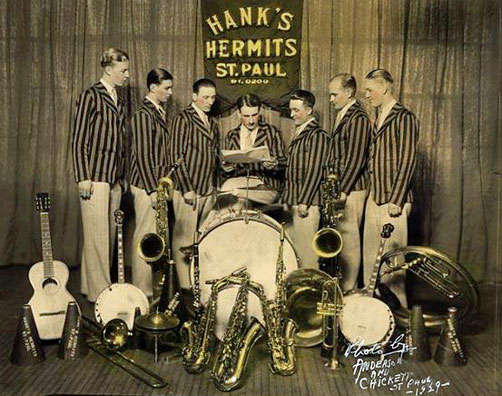
Hank’s Hermits, St. Paul, 1929. Minnesota Historical Society
Minnetonka Record: 1931
The Minnetonka Record advertised dances at Fink’s Pavilion at Tonka Bay for two weekends in August 1931. The band was the Bert Betters Orchestra.
Also in the Minnetonka Record was an ad for a dance on November 8, 1931, at Happ’s Auditorium in Chaska, featuring the Tiny Little Orchestra from Galveston, Texas. A new Ford Coach was to be given away on November 26 – listen to WDGY every Saturday between 5:30 and 6:00 pm and get your free dance tickets.
Performances: 1932
Bing Crosby appeared at the Minnesota Theater from May 27 to June 2, 1932, “in a cine-variety show,” according to Bing Crosby: Day by Day by Malcom Macfarlane’s (2001). (SpyTwinCities.com)
This is odd: St. Louis Park’s Town drunk Scotty Hudson advertised in the Hennepin County Review: “Learn Hawaiian – Guaranteed Course – Popular and Hawaiian Music – Taught by numbers the easy method.” Where did Scotty Hudson learn Hawaiian?
In the same issue of the Hennepin County Review is an ad for the Studio of Music Instruction, 3716 Jackson Street [now Alabama Ave.] in St. Louis Park. Piano, voice, dramatic art, horn and Hawaiian guitar. Was Hawaiian a fad in 1932? The location was and is now the site of Union Congregational Church, although in 1932 the church might not have taken up the entire block.
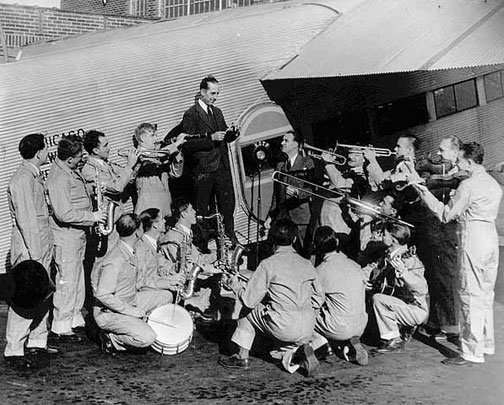
This must be George Osborn and his All-Plane Mechanics Orchestra, broadcasting on KSTP, 1932. Minnesota Historical Society. Okay, I made part of that up.
Theatergoers flocked to hear famed silent screen star Pola Negri speak and sing at the Orpheum Theatre.
The Lady from St. Paul: 1932
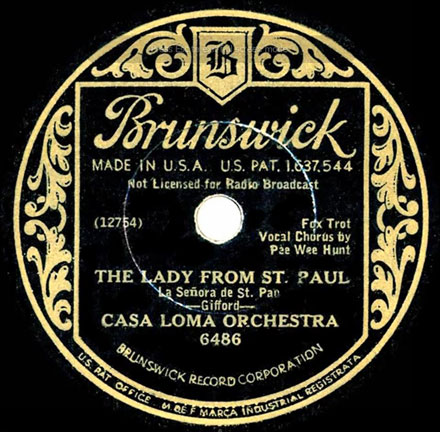
Disc courtesy of The Rick Colom Collection, digitally processed from the original 78rpm: Brunswick 6486 – The Lady From St. Paul (Gifford) by Casa Loma Orchestra, vocal by Pee Wee Hunt, recorded in NYC December 19, 1932. LISTEN HERE Thanks for posting, Dale Burback! (He says it was also recorded by Bobby Gordon & His Rhythm.
Super Dance Attraction: 1933
Disc courtesy of The Rick Colom Collection, digitally processed from the original 78rpm: Brunswick 6486 – The Lady From St. Paul (Gifford) by Casa Loma Orchestra, vocal by Pee Wee Hunt, recorded in NYC December 19, 1932. LISTEN HERE Thanks for posting, Dale Burback! (He says it was also recorded by Bobby Gordon & His Rhythm.
Minneapolis Spokesman: 1934
The Minneapolis Spokesman, the city’s African-American newspaper, began publication on August 10, 1934. One of the first great features was the “Amateur Man about Two Towns,” where readers found out that
Mother Carver’s place on the Sixth Avenue North Road is still the gathering place for those in the know. Frank Hines tickles the ivories at the nite spot, and Tommy Lewis croons as only Tommy can.
The Spokesman was rich with ads and articles about dances that were generally given by social groups. Some of these included:
- The Gloom Chaser’s Club gave a Gloom Chasers Cabaret Ball at the K.P. Hall on August 15, 1934, featuring Babe Salter & His Creolians
- The Clover Leaf Club sponsored a dance at the Aragon Ballroom featuring Joe Billo and his 12-piece band on September 17. On October 1 the entertainers were Eli Rice and his Cotton Pickers, a 15-piece band.
- St. Paul’s Hallie Q. Brown House sponsored a dance with music by Tom “Cab” Coleman and the Harlem Hypocrites.
- Waiters Union No. 614 presented Grant Moore and His Brunswick Recording Orchestra at the St. Paul Coliseum. They broadcast nightly over radio station WTCN. The ad for the September 24 dance promised “Dancing Until Your Feet Are Sore – There’ll Be Plenty of Blue and White Cabs at the Door.”‘
- The Imperial Club began a series of Matinee Parties at the Elks’ Rest on Sunday, September 23, 1934. Admission was 35 cents and music was provided by Scottie Williams and his Black Cat Orchestra.
- In December 1934 the Balloon Club presented Rook Ganz and his Radio Broadcasting Cotton Club Orchestra at a dance at Apex Hall in the Kistler Building. Ganz’s regular gig was at the Cotton Club on Excelsior Blvd. in St. Louis Park.
- On Christmas Eve 1934, Scottie Williams and Rook Ganz appeared at Apex Hall, sharing the stage with Mae Nolan, Burlesque Star, who gave her “Late Snake Hips Dance.”
- The next morning (3 am to 7 am, that is), a second annual breakfast dance called the Town Talk Dance was given by Ray Dysart and his K.C. Rhythm Kings at the Matthews Tavern.
- And on December 25, 1934, two more dances, one in the afternoon and one a Ball at night, were at Apex Hall and featured Eli Rice and his Dixie Cotton Pickers Orchestra.
Ethel Waters: 1935
Ethel Waters made a visit to the Twin Cities in May 1935, appearing in a Broadway production.
Dances from the Minneapolis Spokesman: 1935
On February 17, 1935, a matinee dance at Apex Hall featured Robert Freeman and Willie Davenport and their Brownskin Follies, Sizzling Star Ethel Cross, and The South Side Orchestra, all from the South Side Club.
The Credjafawn Club gave a Pre-Lent Dance at Norway Hall featuring Eli Rice’s band. on February 27, 1935. This club of young black people was organized on October 16, 1927, with ten charter members. The name was created by taking a letter at random from the first names of each of the members. Its objectives were to organize social functions, literary pursuits, and charitable efforts. By 1945 the club had 95 members.
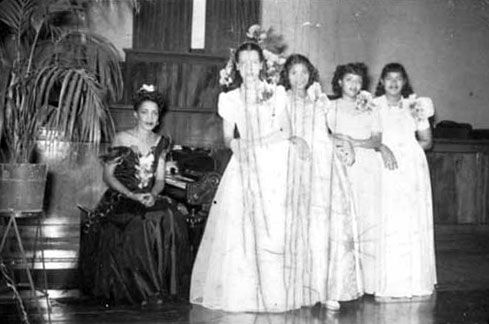
Credjafawn Melody Maids in 1940 – Minnesota Historical Society
The Social Twelve held a dance on March 4, 1935 at the Eagles Ball Room in St. Paul, featuring Eli Rice and his band.
Breakfast Balls, starting at midnight and ending at 6 am, were held at the Apex Hall in March 1935 featuring Mack Swain and his 14-piece band.
Apex Hall was hoppin’ in April 1935, this time with Frank Hines and his Rhythm Venders and two floor shows featuring Kelly Stone and Eddie Estes’ Brownskin Follies with Dorothy and Gwendolyn. Apparently the term “Brownskin Follies” was not copyrighted.
The Second Annual Brownfield Follies was presented by an all-amateur cast on April 26, 1935, at the Hallie Q. Brown Community House in St. Paul. An article in the Minneapolis Spokesman revealed that one act featured a “Slave Mart scene,” Florence Ward would impersonate “Jo Baker,” and that “The finale ends in a sizzling hot finish rockin’ and Rhythm number done in cellophane costumes.” Sounds fabulous!
Soon after, on May 10, Hallie Q. Brown hosted a Charity Ball given by the Women’s Auxiliary of the St. Paul Urban League. Music to be provided by “Lord” Byron Doty. “The leading people of the Twin Cities are numbered among the patrons of the annual affair,” reported the Minneapolis Spokesman.
Williams and June: 1935
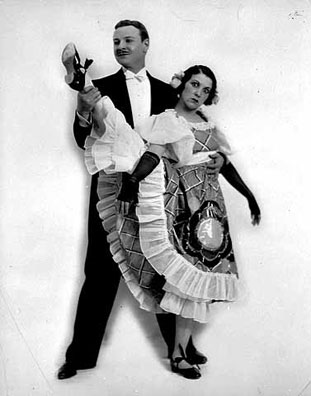
Here is the dance team of Williams and June, 1935. John Williams was apparently well known; June (aka Beulah Gleason) doesn’t look too thrilled. Minnesota Historical Society
White Heat: 1935
Leigh Kamman remembers that when he was in Jr. High and High School in St. Paul (about 1935-’39), there was a show on WDGY called “White Heat,” hosted by George Carson Putnam who did hep cat alliterative introductions. His theme song was “Ride Red Ride” by Henry “Red” Allen. The show was on at 3 PM Monday through Friday, and played jazz.
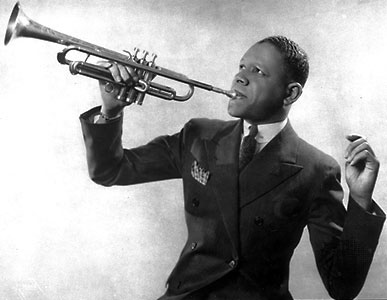
Red Allen
More Dances from the Minneapolis Spokesman: 1935
On May 15, 1935, Eli Rice and his New 11-Piece Band gave their Farewell Appearance at the Deutsch Haus in St. Paul, a show sponsored by the Minnesota Colored Gophers Baseball Club. The Mammoth Floor Show included Bennie & Rogers, Cecelia Williams, Kelly Stone, Marion Abernathy, Oliver Harris, Richard Rice, William Davenport, and Robert Freeman.
AKA (presumably a black fraternity or sorority) advertised an “Apache Dance” to be held at Stepka’s Como Gardens at Western and Como Avenues.
A dance on June 17, 1935 at the Aragon featured the Harlem Play Girls, “the first big time girls’ band to appear in Minneapolis. Their only and last appearance before leaving for tour of the West Coast.”
A matinee dance at the Apex in June featured Popo Warfield and his Brownskin Steppers, accompanied by Johnny Wheeler and his 6-Piece Orchestra.
On July 15 Carroll Dickerson and his Orchestra appeared at the Aragon Ballroom, direct from the Grand Terrace Cafe, Chicago. Not sure what this means: “Also Recently Featured 14 – CBS Radio Artist – 14.” After the show, attend the Breakfast Ball at the Apex, starting at 1:30 am and featuring Rook Ganz and his Cotton Club Orchestra.
The Niceroma Club, Inc., sponsored a Moonlight Excursion Down the Old Mississippi on July 29, with music by Babe Salters and His Creolians.
Another excursion was sponsored by the Gloom Chasers Club on August 5 on the Donna Mae, with the Donna Mae Boat Orchestra.
A “Battle of Music and Breakfast Ball” was held on August 15 at midnight in benefit of Citizens Community Union Picket Lines. Four bands would play at Apex Hall: Rook Ganz, Scottie Williams and His Black Cat Orchestra, C. Sharp and his Seven Flats, and the Apex Night Club Band. “Help Us Help Our People” The ad was donated by C.E. Newman, publisher of the Minneapolis Spokesman.
The Triangle Clubs of the Twin Cities sponsored a Gigantic Picnic and Dance at Harriet Island in St. Paul on August 26. No band was mentioned, but there would be popularity and bathing beauty contests.
On August 19 we are exhorted to “Come out and hear a real band,” namely Grant Moore and his Orchestra at a Breakfast Ball at Apex Hall.
Earl Fraser and his band apparently made their debut at the Aragon Ballroom on September 16. “Everybody Attends Dances at the Aragon” “Come out, hear the newest and most sensational band in the Northwest.”
The Dance Masters hosted a Joe Louis Victory Ball at the Coliseum Ballroom in St. Paul on September 30. On October 14 they hosted the Southerners band at the same venue.
The Biggest Dance of the Season featured Walter Barnes and his Famous Royal Creolians (Chicago’s Favorite Band) at the Aragon Ballroom on October 7, 1935.
On October 28 the Fite-Baker Harlem Hi Hatters, an “out-of-town orchestra with a group of big-time entertainers,” played for a dance at the Aragon Ballroom. The floor show featured Buddy Short, Velda Shannon, and Carroll Watkins.
The Apex’s Hallowe’en Breakfast Dance featured Rook Ganz and His Cotton Club Orchestra with Bill Pugh, Magic Voiced Singer. The Apex Band would also play, and there were two floor shows featuring Van Epps & Clifton Phillips’ Revue with the Brown Sisters.
A Cabaret Ball featuring Walter Barnes and His Creolians appeared on November 13 at Apex Hall.
The Annual Pre-Thanksgiving Dance at the Veterans’ Hall, St. Paul Auditorium, took place on November 23, 1935, under the Auspices of Leslie Lawrence Post No. 497, American Legion. “Hot, Tantalizing Music by Crooning Little Joe and His Rug Cutters, Featuring Rose Grant, ‘The Personality Directress.'”
The Social Twelve were back with a Fall Cabaret Dance on November 18 at the Flying Dutchman.
The Keystone Bar featured 6 per cent beer, Ed Pursell at the piano, and the Silver-Voiced Baritone of Jack Meredith in the Mystic Cavern.
A dance was held at the Apex Club on November 20 “in Honor of” Noble Sissle, which probably meant that Sissle and his band would be appearing elsewhere in the city and coming to the Apex afterwards. Music would be by the Apex Band and the floor show featured McDonald, Clifton Phelps, Van Epps and Apex Chorus. “Twin City Musicians and Entertainers Will be out in full force to welcome Sissle Company.
On November 25 Reese Martin presented “The Event of the Season,” a dance at the Aragon Ballroom featuring Red Perkins and his Dixie Ramblers. Four Thanksgiving turkeys were given away.
The Jolly Sixteen Club gave a dance at the Pearl Inn on November 25.
A Thanksgiving Cabaret Ball at the Apex started on November 27 and ended at breakfast on the 28th. A Battle of Music pitted the Apex Nite Club Band against Clarence Johnson’s Stumble Inn Orchestra.
Billed as the first matinee dance of the season was a Battle of Music at the Apex featuring the Apex Orchestra and Clarence Johnson’s Stumble Inn Aces. A Floor Show featured “Ethel Cross, Torch Singing M.C.; Sonny Nichols, RKO Favorite; and Epps and Phillips, Dancers Excellent.” Prizes were a box of cigars for Gentlemen and Combination Cigarette Lighter for Ladies.
Christmas Night festivities at the Apex included Rook Ganz and his Cotton Club Orchestra; Ethel Cross, emcee; and petite dancer Pearl Harvey. “Put your presents on the Apex Christmas Tree – You and your friends will enjoy this unique way of receiving gifts.”
Big New Year’s Eve Dance at the Aragon Ballroom featured Walter Erickson’s Red Hot Band. “The first time in the Twin Cities that the colored people have been able to secure such a lovely ballroom on a holiday.” Dancing from 9:30 to 4:30.
Hopkins’ Armistice Celebration: 1935
Hopkins’ Armistice Celebration (now Veterans’ Day) began with an Army Slumgullion Dinner at the Legion Hall, followed by a dance at Olson’s Hall, sponsored by the George R. Wolff Post of the VFW.
Larry Lyons: 1935
In August 1935, saxophone player Larry Lyons of the Carlos Molina Orchestra drowned in Christmas Lake. The band had been playing a two-week engagement at the New Radisson Inn, Christmas Lake. Lyons went out alone in a row boat, and when he reached deep water about 300 feet from shore he dove into the lake, sending the boat out of reach. He called for help but he was too far out. Professional divers were called to retrieve his body: Jack Thompson of Minneapolis and Indian Joe of St. Paul. It took seven days to find him: “Diving and dynamite had been employed but it remained for Indian Joe with his mystery methods to find the body. When asked how he did it Indian Joe smiled an inscrutable smile and said, ‘That’s our secret.'” Lyons, just 35 years old, had been with Molina for two years, and traveled with his wife.
Vine Hill Tavern: 1935
The Vine Hill Tavern offered a Real Italian Spaghetti Dinner for 15 cents, with Excellent Dance Music, and as an added attraction, the Famous Nicollet Hotel Dance Team of Chickie and Sunny, Entertainers Extraordinary. All this on August 8, 1935, advertised in the Hennepin County Review (Hopkins) and the Minnetonka Record.
A Night in Spain: 1936
On May 11, 1936, the Minnesota-Iowa Club gave its first cabaret dance party, “A Night in Spain,” at Norway Hall, with music by Roy Disert’s Band.
Sterling Minstrel Show: 1936
On May 15, 1936, a Sterling Minstrel Show was presented at the Hallie Q. Brown House, featuring St. Paul’s best song artists, six comedians full of jokes, and five big acts in olio.
Coming Out Party: 1936
On May 22 the Waiters’ Union Local 614 sponsored the Coming Out Party as Host to the following social clubs:
- Cameo
- Jr. Cameo
- 20th Century
- Credjafawn
- Jr. Credjafawn
- Modernettes
- Socialites
- Diplomats
- Gloom Chasers
- Wolverines
- And others
The dance was at the Coliseum Ballroom and featured Gordan Parks and His Casa Nova Band.
KSTP Studios: 1936
A publication called “KSTP Market Data” gives a list of NBC Network broadcasts originating at the KSTP studios during the last six years. Among them were:
“Dancing in the Twin Cities,” a regular Sunday evening program that was a regular feature of the NBC networks since 1933. Included were the orchestras of:
- Blue Steele
- Bernie Cummins
- Paul Pendarvis
- Lou Blacke
- Don Gonzales
- Ted Weems
- George Hamilton
- Norvy Mulligan
- Cecil Golly
- Buddy Fisher
- Jimmy Joy
- Barney Rapp
- Bob McGrew
Also recorded at KSTP studios were:
- Ben Bernie and the Pabst Blue Ribbon Program, recorded during a local theater engagement of Bernie’s Orchestra
- Ethel Shutta and George Olsen and His Music, recording a commercial for Nestle’s Chocolate during a local theater engagement of the orchestra
- Abe Lyman and His Orchestra, Vivian Segal, and Frank Munn, recording a commercial Phillip’s Milk of Magnesia during a local theater engagement
Jimmie Lunceford’s Orchestra: 1940
Jimmie Lunceford and his Orchestra came to the Coliseum Ballroom in St. Paul on January 22, 1940. Featured were the Lunceford’s Glee Club and the Lunceford Trio: Sy Oliver, Willie Smith, and Eddie Tompkins. It was this nationally renowned band’s first appearance in the Twin Cities. 2,000 people attended the event.
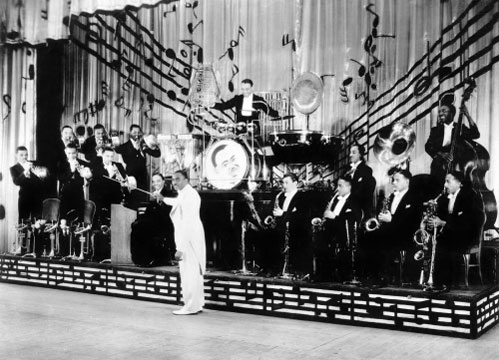
Jimmie Lunceford’s Orchestra, 1935
Swing Show: 1940
Les Saefke described a big Swing show at the Orpheum in the fall of 1940: (Hennepin History, Fall 1991)
[Harry] James formed his own band, the Music Makers, and came back to the Orpheum in the fall of 1940. He featured Dick Haymes on vocals, who had just replaced Frank Sinatra, and the newly popular, Ink Spots. The Ink Spots stole the show with their renditions of their hits, “If I Didn’t Care” (their theme); “We Three,” “Do I Worry,” “Maybe,” “Java Jive,” etc. It was ironic that Gloria Jean, Universal Studios child singing star, attracted the biggest crowd on the weekend and she didn’t even sing. She was just interviewed by James, in an apologietic manner while the rest of the show was devoted to the great Swing of his Music Makers. Each show ended with his greatly anticipated, loud and exotic, “Two O’Clock Jump.”
Performances: 1940
Contralto Marian Anderson made her annual appearance in the Twin Cities on March 20, 1940, at the Minneapolis Auditorium. Her program was predominantly classical, with an ending section of Negro Spirituals.
Dining Car Employee’s Union Local 516 gave their third annual dance at Stem Hall, St. Paul Auditorium, on April 19, 1940. Music was provided by El Herbert and his Swing Band. Committee members represented the Omaha, Soo Line, Great Northern, and Northern Pacific Railroads.
Les Hite and his Cotton Club Orchestra came from Los Angeles to play for a dance at Stem Hall at the St. Paul Auditorium on May 4, 1940. It was Hite’s first appearance in the Twin Cities. Hite, with torch singer Tonie Anthony and Cudellus Martin, saxophonist from the Twin Cities, was dubbed “the heat wave from California” that “taught Hollywood how to swing.”
KSTP’s Sunset Valley Barn Dance began a series of Saturday night broadcasts on October 26, 1940. See TV Shows.
Baritone Paul Robeson appeared at Northrop Auditorium on October 23, 1940, as part of the University Artists Course. This was his first U.S. tour following four years of touring in Europe. Robeson sang folk songs on tour, but was also an acclaimed actor, appearing in “Emperor Jones,” “All God’s Chillun,” “Porgy,” and “Show Boat.”
October 26, 1940, was a Homecoming Dance at the St. Paul Auditorium, Ramsey Hall, with music by the Southern Serenaders.
On October 26, 1940, the Clef Club was described as newly decorated and reopened with a “big imported floor show.” “The Clef Club will be the night club in the Twin Cities catering to Negro patronage,” reported the Spokesman. Manager Scottie Williams promised a show with “a snappy group of entertainers” including:
- Carroll Lee, female impersonator
- Alma Smith, torch singer
- Chase and Ray, the “Brown Dots,” dancers par excellence
- A chorus of dancing girls, in a show produced by Jackie Hudson
- Music by Walter Lear and His Six-Piece Orchestra
On November 21, 1940, an Inaugural Ball was held at the St. Paul Auditorium to crown the Mayor of Bronzeville. Salesman James W. “Jimmy” Slemmons was elected Mayor, campaigning on the fight for jobs for the black community.
The Clef Club, “Twin Cities Brightest Night Spot,” presented a Big Surprise Floor Show starting on December 21, 1940. Party goers were invited to see Jessie Scott do the “La Congo.”
Jessie Scott was at the Clef Club on New Year’s Eve, 1940, as well, along with “Skip, Hop and Jump, Three Dancing Demons.” Music was provided by Walter Lear and His Gents of Rhythm.
Andrews Sisters: 1941
Originally from Mound, Minnesota, the Andrews Sisters were big stars by 1941. On February 5, 1941, the came home to the Orpheum Theater for a public appearance, sharing the stage with the 3 Stooges! All this and a movie for 25 cents!
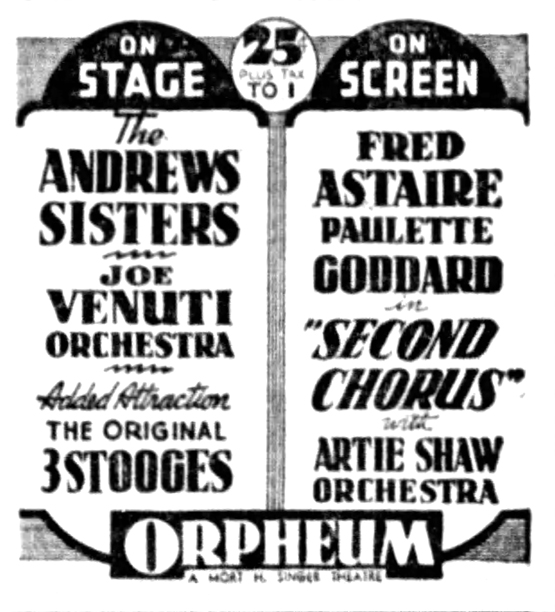
Stepin Fetchit: 1941
After the remark about the Ink Spots’ “Uncle Tom” clowning, it is odd to see two subsequent ads in the paper:
Stepin Fetchit appeared at the Princess Theater, 12 – 4th Street NE, March 4-7, 1941. Born Lincoln Perry, Fetchit was Hollywood’s first black movie star, “appearing in more motion pictures than any other colored artist.” His breakthrough film was “Hearts of Dixie” in 1929. He became the “Screen’s Laziest Comedian,” famous for rolling his eyes and speaking and moving agonizingly slowly. His film career had its ups and downs, and pretty much ended in 1937. But he continued to tour around the country.
His live stage act was described in Mel Watkins’ biography of the actor:
..Perry skillfully contrasted his absentminded coon lethargy with the silken finesse of his dancing. Onstage, he would come meandering out, scratching his head, looking utterly confused and lost. Mouth agape, eyes half closed, shoulders slouched, arms dangling, he would slip into a practically incoherent monologue; delivered in a whining monotone to no one in particular, most often it has little meaning beyond the visual impression of confusion.
Then, suddenly, the gangling actor would spring into a spirited dance routine that, when first encountered, often astounded audiences. His facial expression changed subtly, the half closed eyelids lifted, eyes momentarily widening to reveal a flash of energy, near-arrogance, that the simpleton mask had intentionally concealed.
An item in the Spokesman also noted his odd hobby of collecting cashmere suits made from the wool of the sacred goats of India, at $275 each (with two pairs of pants). “The slow motion comic has about $4,125 worth of clothes hanging in his hotel closet. Fetchit has one tailor in Hollywood, another in New York and they both know his weakness – clothes.”
Appearing with Step were:
- Abdul Sender, Egypt’s Greatest Pianist
- Patsy Mack
- Penny and Perry Tucker
- Claudette Colbert and Ray Milland in the film “Arise My Love”
Also odd was an ad for the Swing Town Minstrels, Ladies’ Cast of St. Thomas Guild, Auzie Dial, Guest Artist, illustrated with an image that would seem offensive even then. The show was at Benton Hall, YWCA, March 6, 1941.
Stage Bars: 1941
The Second World War saw the advent of what Stebbins calls Stage Bars, a significant event in the jazz community.
A stage bar or theatre lounge is an establishment which serves liquor and features some sort of entertainment from and elevated stage or stand rather than from the floor. Usually there is no public dancing in these places, although some stage bars have entertainment for a certain length of time (‘the show’) followed by a period when the band plays for dancing. The audience may be entertained by a strip act, comedy act, musical performance or a combination of these. Jazz musicians are generally hired to play the music for the strip shows. Their music usually a raucous form of jazz.
The real importance of the introduction of the stage into bars lies in their potential as a place where a form of concert can be presented. To be sure, the presence of liquor creates a situation which is less than perfect from the standpoint of presenting a serious performance, but the musicians probably gain more attention than if they were playing for dancing. This innovation has benefited modern jazz musicians. Their experimentation with meter and tempo has led them out of the dance field to some extent.
One reason for this development was a stiff excise tax on clubs where dancing was allowed.
Events: 1941
Still a teenager, Leigh Kamman was hired to do studio clean up at WMIN Radio, and eventually talked his way into a late-night, on-air slot. He and a schoolmate—Sev Widman—launched “Studio Party Wham,” named after a Jimmie Lunceford recording. He and Sev showcased big bands and small combos, conducted in-studio interviews, chatted with a panel of jazz connoisseurs and played popular records of the day. At age 80, Kamman vividly remembers those late teenage years: “Though my friends and I were underage, we hung out at the Hotel St. Paul where they were booking the big bands of Les Brown and Harry James. There was a lower-level room called Club Casino with swing dancing and a tremendous social element.” For his WMIN show he tracked live broadcasts of artists such as Joe Sullivan, Doc Evans and Bob Zurke from Mitch’s Roadhouse in Mendota. According to Kamman, “The place sat about 150 people. You could bring your favorite beverage and buy the mix… true roadhouse style.” (Minnesota Monthly, 2003)
Cab Calloway and his Cotton Club appeared for a week at the Orpheum Theater starting January 17, 1941 – price, 25 cents. The name Mort H. Singer is on the ad – perhaps the promoter. The Spokesman observed, “There was not an ‘Uncle Tom’ number in the Cab Calloway show.. In contrast, the Ink Spots.. spoiled their performance for many Negroes by their clowning, which added nothing to their act!”
Count Basie and his Orchestra came to the Minneapolis Armory on April 14, 1941.
The Minneapolis NAACP Coronation Ball was held at the Royal Arcanum Hall, 3011 First Ave. So., on June 9, 1941. Music was provided by Paul Thomason’s Orchestra.
Dr. W.D. Brown was elected Mayor of Bronzeville at the second annual Inaugural Ball, held on Thanksgiving night, November 20, 1941, at the Eagles Hall (later the Labor Temple). Check the link for the fascinating story of the Mayor of Bronzeville!
Marian Anderson appeared with the Minneapolis Symphony Orchestra on November 28 and 29, 1941.
Oh dear. The Clef Club, now “The Home of Happy Feet” presented a gala affair on December 21, 1941, featuring “Snake Hips” and His Rhythm Girls, Peggy O’Neal from Chicago, and Little Bobby Green. Music by Steep Pittman and His Musical Gents. Snake Hips and the gang were also on hand at the Clef Club for a Breakfast Ball on Christmas Eve Night and a dance on Christmas night.
On December 22 Eli Rice presented a pre-Christmas dance at the Labor Hall, 720 – 4th Street So. in Minneapolis. Rice’s band was listed as the 12 New Orleans Cotton Pickers.
The Four Notes: 1941
In his autobiography, Overcoming, W. Harry Davis described how vocal quartets would be formed at the Phyllis Wheatley Settlement House. His group, formed in the summer of 1941, was called the Four Notes, and included David Faison, Charlie Waterford, Hank Majors, and later Rufus Webster. They mostly imitated the Ink Spots and the Mills Brothers. One day they sang for the Wheatley Board, which included Min Himmelman, whose husband was the manager of Brown’s Clothing Store. After arranging for the group to record a radio commercial for the store, she told them of another opportunity.
The Ink Spots appeared in Minneapolis beginning on November 22, 1941, at the Orpheum Theater. The group had a contest to see which local group could imitate them the best. They acted as judges at auditions at radio station WDGY. The Spokesman reported that the contest was sponsored by the Orpheum, WDGY, and Minneapolis Beautiful, Inc., headed by Mrs. M.D. Himmelman. The quartet that best imitated the style of the Ink Spots would appear at all performances at the Orpheum on November 28. Davis also said that the winner would get a two-week’s engagement at Curly’s, a downtown night spot.
The Four Notes won, but they were too young to appear at a club that served liquor. They pulled it off by growing moustaches, but Miss Dorsey from Wheatley refused to play piano for them. “We convinced our friend Rufus Webster to replace Miss Dorsey at the piano” and fulfilled the engagement. After Curly’s they played the Flame – one week in the Minneapolis location and one week in St. Paul. But after two weeks at the Happy Hour, draft notices began to appear, first for David Faison, then Hank Majors, then Rufus Webster. “The Four Notes had a short career.”
Frank Sinatra: 1942
Frank Sinatra appeared at the Prom Ballroom on March 25, 1942.
War-related Events: 1942
Rick Shefchik provides a fun backstory on the photo above from his book From Fields to Fairways:
In the chapter on Midland Hills Country Club, I wrote about head pro Wally Mund’s efforts to keep the club afloat during the difficult war years. Because Mund was well-connected with the PGA of America, he was able to convince Bob Hope and Bing Crosby to stop at Midland Hills for an exhibition match while they were in town with the Caravan. Here’s the relevant passage from my book:
“On Saturday, May 9, 1942, the PGA sponsored a War Relief match at Midland Hills featuring Bing Crosby, Bob Hope, ‘Lighthorse’ Harry Cooper of Golden Valley, and Wally Mund. Hope and Crosby were part of the Hollywood Victory Caravan that was touring the country that spring to raise money for Army and Navy relief funds. Included in the caravan were Olivia de Havilland, Joan Bennett, Joan Blondell, Claudette Colbert, Charles Boyer, Cary Grant, Pat O’Brien, Merle Oberon, Eleanor Powell, Bert Lahr, Grouch Marx, Desi Arnaz, Stan Laurel and Oliver Hardy.
“Hope and Crosby tried to get in a round of golf at each stop. Despite appearing somewhat worse for the previous evening’s wear in the two most familiar photographs of this event, Hope beat Crosby one-up at Midland. the match was restricted to twelve holes because the entertainers were doing a matinee show at the St. Paul Auditorium, followed by an evening performance in Minneapolis.”
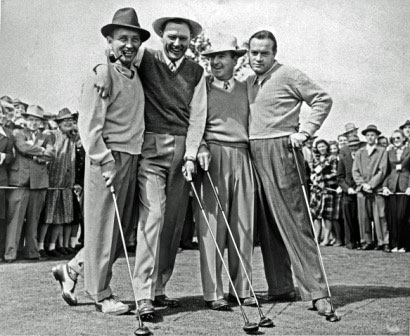
Rick also provided the photo above. Thanks, Rick!
Service Center Dance: 1942
This one looks a little dull.
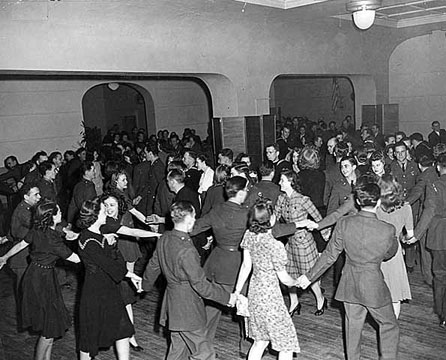
Minnesota Historical Society
Double Victory Dance:1942
From the Minneapolis Spokesman:
NAACP Dance Tonight at St. Paul Auditorium
Minnesota’s Negro draftees who are being inducted into service this July are invited to attend the Double Victory Dance and Queen Crowning contest given by the St. Paul branch of the NAACP, Friday night, July 3rd, at Ramsey Hall, St. Paul Auditorium…. This dance is being given to raise fund to send a delegate to the National Convention and carry on work against discrimination, according to Mrs. Dwight Reed, Sr. chairman of the “On to Los Angeles” Committee.
The dance started at 10 pm and music was provided by Rook Ganz and His Band.
Fourth of July Picnic: 1942
A Fourth of July Picnic was held at Bass Lake (5 miles west of Robbinsdale) for the black community, featuring:
- Double Header Soft Ball Game – Minneapolis vs. St. Paul
- Horse Shoe Pitching Contest – Minneapolis vs. Duluth vs. St. Paul
- Speed Boat Thrills
- Southern Bar-B-Q Meats
- Breakfast Ball at the Clef Club starting at 11 pm
- Music for all event by Rook Ganz and His Gents of Rhythm
Events: 1942
On August 1, 1942, the American Federation of Musicians (AFM) went on strike against major record companies due to a dispute over royalty payments. Union musicians could not make records but could perform on radio broadcasts or in concerts. AFM President James Petrillo was against recording because he saw it as a substitute for live musicians. Singers, members of a different union (AFTRA) were not affected and many recorded backed by vocal groups. Record companies settled individually in 1943 and 1944. See a great explanation of the strike Here.
Duke Ellington and His Orchestra was the feature attraction at the Ninth Annual Grand Ball of the Minnesota League of Credit Unions at the St. Paul Auditorium, October 31. A concurrent concert at the Minneapolis Auditorium was headed by Jan Savitt and his Top Hatters. Tickets were provided for 1,000 servicemen. A Junior Halloween Grand Ball was staged on October 30 at the St. Paul Auditorium, also with Duke Ellington. Following the events, John Esquire in the Spokesman deemed the music excellent but the decorum of the musicians “lousy.” He reported that the musicians
loafed all over the band stand. They drank what was obviously liquor from paper cups. A trombone soloist was glassy-eyed from drink or something else. They visited with the crowd constantly and several times the stand was only half full of band members when Duke began to tickle the piano. The attractive little bronze-skinned singer was pleasing until she sang a risque off-color song which was completely bad taste in view of the large number of youngsters present. Such poor taste and conduct from one of the acknowledged top bands of the country is strange to behold. One explanation offered the writer is that when these bands come to the Twin Cities they are made so welcome that they lose control.
Marian Anderson presented a recital at the concert bowl of the Minneapolis Auditorium on November 24, 1942, accompanied by Franz Rupp. This was Miss Anderson’s sixth consecutive annual appearance in the Twin Cities and the first of an 80-concert tour.
The Clef Club was the place to be on Christmas Eve and New Year’s Eve, 1942. The Breakfast Balls, featuring Walter Lear and His Boogie Woogie Band, started at 10 pm and lasted all night.
Platter Chatter: 1943
St. Louis Park High student Mary Ellen Erickson procured the autograph of Frankie Carle (sigh). But there were some at Park who were hip. Dig this article called “Platter Chatter” by student reporter Jim Church in the Echo:
Come on, cats, don’t be squares or ickys. Bring in all the solid jazz discs ‘n hear ’em played in the auditorium during the eleventh and twelfth grade lunch hour. Hear the place rock to the righteous swing of Goodman on the licorice stick or Sampson’s “Boogie Express” on the 88. Say! Have you heard Goodman’s “Bugle Call Rag” with Krupa on the tubs? Jan Garber has made a complete switch from his sweet orchestra to a jump band. Now that he has got away from the Guy Lombardo type of music, we feel sure he’ll succeed…Sinatra is 4-F in the Army which goes to show that no one wants him. … A hep cat’s dream of heaven is Goodman’s recording of “Sing-Sing-Sing” on a twelve inch Victor platter. The trouble is it is almost impossible to obtain. Ammons and Johnson, masters of the eight-to-the-bar, are set for Hollywood picture work… Harry James is coming out with another M.G.M. film, “Mr. Co-ed,” in which Harry begins with a blues theme and rides into a torrid tempo… Watch for Charlie Spivak’s movie “Pin Up Girl” … Well! End of study hour (?) so I’ll hang up. Amen!
Everything from Bach to Boogie Woogie: 1943
Don Leary’s Automatic Sales Co. (Nicollet Island record shop) sold “Everything from Bach to Boogie Woogie.” Artists in the ad included:
- Bing Crosby
- Jimmie Noone, Dean of Modern Hot Clarinetists
- Duke Ellington
- Pine Top Smith
- Red Nichols and His Five Pennies
- Cab Calloway
- Benny Goodman and His Boys
- The Boswell Sisters
Events: 1943
In January 1943 you could see the Ink Spots, the Lucky Millinder Band, and the movie “Nightmare” with Diana Barymore, all at the Orpheum Theater.
The musical event of the year was the production of “Porgy and Bess” at the Lyceum Theater, 11th and Nicollet, on February 8-11. The show starred Todd Duncan and Etta Moten, with Alexander Smallens conducting the orchestra.
Paul Robeson appeared with the Minneapolis Symphony Orchestra at Northrop Auditorium on April 2-3, 1943.
KSTP’s Sunset Valley Barn Dance did a remote broadcast on Saturday, April 3, 1943, from the St. Louis Park High School auditorium stage. The two stage shows, at 8:30 and 10:15 pm, were sponsored by the Brookside (Elementary School) PTA. The night before, the show came from the American House, 444 Rice Street, St. Paul. Future dates would be at Mahtomedi (April 9) and South High in Minneapolis (April 10).
The club with the all-time best name, the Rhumboogie Club, opened on June 15, 1943, at 128 Hyland Ave. The club was replaced by the Cara Okara Cafe by November 1945, and it appears that Hyland Ave. was wiped out completely with highway and other construction. But in 1943, “You’ll Enjoy Yourself.” I believe it!
Another club with a great name was Club Bengassi, “For an Evening of Fun.” Opened in August 1943.
The Clef Club hosted a Thanksgiving Ball featuring Jimmy Baker’s Orchestra.
Marian Anderson appeared with the Minneapolis Symphony Orchestra on December 3 and 4, 1943.
It was the Clef Club again for Cabaret Dances on December 25 and New Year’s Eve, with entertainment and floor show music by Jimmy Baker’s Band.
Rhumboogie Club Christmas Night and New Year’s Eve: 1943
Here’s some 1943 holiday fun at the Rhumboogie Club.
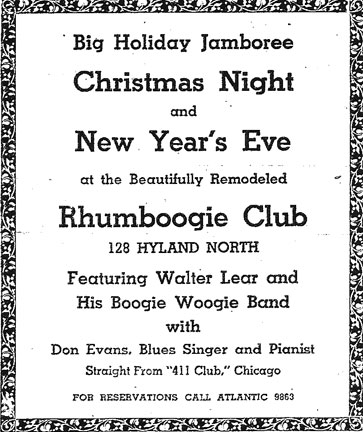
Jazz at the Philharmonic: 1944
“Blues, Part 2” by Jazz at the Philharmonic was the first of 50 nominations for the first rock ‘n’ roll record, according to a book of that name by Jim Dawson and Steve Propes. Granz put together the first Jazz at the Philharmonic show in 1944 as a benefit for 21 Mexican youths convicted in the Zoot Suit Riots of 1943. I don’t know if every tour included the Twin Cities; I’ve placed a date next to the ones that did for sure:
1st National Tour: Late Fall/Winter 1945-46
2nd National Tour: May 17, 1946, Minneapolis Auditorium
3rd National Tour: October 28, 1946, Minneapolis Auditorium
4th National Tour: April 6, 1947, Minneapolis Auditorium Concert Bowl
5th National Tour: Fall 1947
6th National Tour: May 2, 1948, Minneapolis Auditorium Concert Bowl (reported locally as the 5th tour)
7th National Tour: Fall 1948
8th National Tour: Spring 1949
9th National Tour: October 20, 1949, Minneapolis Auditorium Concert Bowl
10th National Tour: Fall 1950
11th National Tour: October 12, 1951, Minneapolis Auditorium
12th National Tour: October 10, 1952, Minneapolis Auditorium
13th National Tour October 9, 1953, Minneapolis Auditorium
14th National Tour: October 15, 1954, Minneapolis Auditorium
15th National Tour: September 30, 1955, Minneapolis Auditorium (The 15th Tour was supposedly renamed the 16th Tour just weeks before the start of the tour but that isn’t reflected by Minneapolis newspapers.)
16th National Tour: September 28, 1956, Minneapolis Auditorium
17th National Tour: September 27, 1957, Minneapolis Auditorium
September 25, 1959 was given as a tentative date but not confirmed
Zoot Suits: 1944
“Zoot Suits! Full Drape – Single and One Button Roll. Also Full Drape Zoot Sport Coats and a complete line of Full Peg Drape Zoot Pants. Only at Morris Clothing, 211 Marquette.” The illustration looks nothing like a west coast Zoot Suit – just a guy with kind of baggy pants.
Events: 1944
Appearing at the Orpheum Theater in February 1944:
- The Ink Spots
- Ella Fitzgerald
- Cootie Williams
- Movie “Around the World” with Joan Davis
The show moved to the RKO, with the movie “Whistling in Brooklyn”
The Daughter Elks presented the first dance to be given in ten years at the beautiful Plamor Ballroom, soon to be renamed the CIO Hall, 8th Street and 4th Ave So. Jimmie Baker and His Gentlemen provided the music for the Grand Easter Dance on April 10.
The Friendly Ten Club held a dance on July 3 at the CIO Hall featuring Jimmy Tyler and His Blue Rhythm Boys.
Fletcher Henderson came to Stem Hall in the St. Paul Auditorium on November 6, 1944. Tickets were $1.00.
The 11th Annual Credit Union Grand Ball was held at the Minneapolis Auditorium on November 11, 1944. Bud Strawn and his orchestra played in the main ballrom for Al Wiklund’s jitterbug contest from 8 to 9 pm and for “modern dancing” from 9 pm to 1 am. Wiklund taught classes on jitterbugging at Coffman Union at the U of M. “King” Tommy Thompson, His Radio and Dance Band, played “old time” music in the Rathskellar from 9 to 1am. 6,000 people were expected.
Artie Shaw played the RKO Orpheum on December 4, 1944. Frankie Carle played the same venue that month.
Paul Robeson performed “Othello” at the Lyceum Theater on December 11 to 13, 1944. Also in the cast were Jose Ferrer and Uta Hagen.
Royal Arcanum: 1944
The Royal Arcanum, at Lake Street and First Ave. So., hosted a series of dances, starting with the premier full dress appearance of King Larry (Lawrence) Griffin his Rhythmaires, billed as “one of two of the greatest associated bands in the Northwest.” Also featured were local eccentric dancer Stanley Gardner, and vocalists Doris Escue, Ernestine Danforth, and Mary Lewis. Managers C. Clifton Jackson and Bobby Marshall said that this truly great dance will “bring together at one time under one roof at least three of our own local talented youth, positively on their way up to big time, as well as the two greatest musical organizations in this section.” Track star Jesse Owens was appearing in Minneapolis the same week, and was invited to attend the dance. 400 people jammed the hall to enjoy the show. Follow-up shows were given on September 4 and 9.
Football Jamboree
A Football Jamboree was held on September 28, 1944, with 600 students from St. Louis Park and Hopkins high schools at Donaldson’s Tea Room. DJs Bill Kirby and Jim Boyson hosted a half hour broadcast on WTCN Radio that featured school songs and cheers. DJ Larry Clinton played music for dancing after the show.
Katherine Dunham: 1944
Famed dancer Katherine Dunham presented her Tropical Revue at the Lyceum Theater, September 28-October 1, 1944. Dunham was a dancer, choreographer, author, educator, and social activist. This is video of her in the film “Stormy Weather” from 1943. Photo of Miss Dunham below from about 1937.
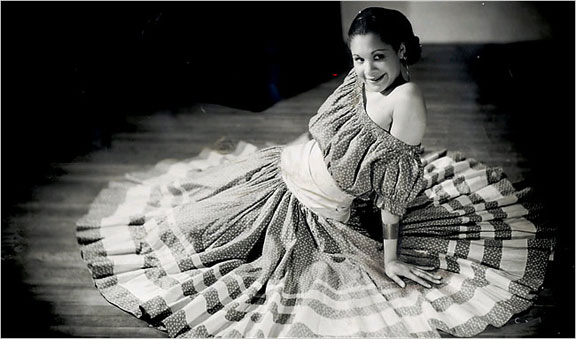
Bandwagon: 1944
A full-length musical/campaign for Roosevelt called “Bandwagon” came to the Lyceum Theater on October 14 and 15, 1944. Producer Eddy Royce sent out a call for new-dealer entertainers to perform in the show, and came up with this interracial cast:
- Will Geer, emcee
- Orelia and Pedro, whirlwind Afro dancers from Cuba
- Helen Tamaris and Daniel Nagrin, concert dancers from the Metropolitan Opera
- Woodie Guthrie
- Cissco Houston
- Bernie Hern, comedian
- Mary Lou Williams, leading female exponent of Jive Piano
Top Flight, a Musical Fantasia: 1944
The St. Paul Branch of the NAACP presented “Top Flight, a Musical Fantasia” on October 25, 1944, in the theater section of the St. Paul Municipal Auditorium. It was described as a vaudeville arrangement with:
- Twin City talent
- Stars from Chicago
- Snookum Russell and His Hollywood Orchestra
- Vocalist Iona Wade
100 seats were given away free to purchasers of $25 war bonds.
Tommy Dorsey: 1944
Tommy Dorsey, His Trombone, and His Orchestra (49 people) were busy in December 1944. On Saturday the 16th they played a dance at the Prom, and on Sunday the 17th they were at the Minneapolis Auditorium for a modern concert at 3pm and a dance at 8 pm.
Panorama of Folk Songs: 1944
An extraordinary program of music was presented on December 12, 1944:
BALLAD SINGERS TO OFFER PANORAMA OF FOLK SONGS
Seated around a table on the stage of Northrop Auditorium the American Ballad Singers, led by Elie Siegmeister, composer and director, will be presented in concert by the University Artists course Tuesday evening.
Their program is a musical folk history of amazing variety. It will include ballads of the American Revolution, songs of bad men, lovers, heroes, jailbirds, tollers, mountaineers, children – a veritable American panorama in song.
Director Siemeister, in gathering and arranging these songs, has gone to the people for his program material – to the mountains, prairies, cities and backwoods regions. He has listened to Alabama cotton-pickers and the street peddlers of his native New York.
THE PROGRAM:
Music of Early America –
- Ode on Science
- Birds’ Courting Song
- Song of the Sea
- Deaf Woman’s Courtship
- Poor Wayfaring Stranger
- Children’s Games
- Sweet Betsy From Pike
Americans at Work –
- Hammer Ring
- Peg and Awl
- Pat Works on the Railroad
- Street Cries
- Cotton Dance Song
American Christmas Carols –
- A Virgin Unspotted
- Rise Up Shepherd An’ Foller
- Mary Had a Baby
- Twelve Days of Christmas
The Melting Pot –
- Upon a Mountain
- Cooper O’Fife
- Schlof Bobbell
- Finnegan’s Wake
Folk Songs of Today –
- I’m Sad and I’m Lonely
- The Devil and the Farmer’s Wife
- Chilly Winds
- Rye Whiskey
Harvest Moon Ball : 1945
A Harvest Moon Ball was held at the St. Paul Auditorium.
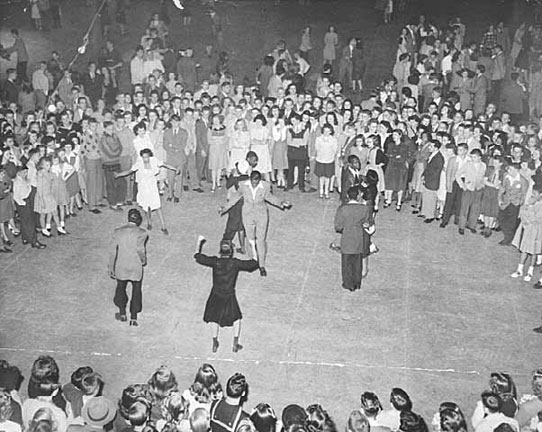
Minnesota Historical Society
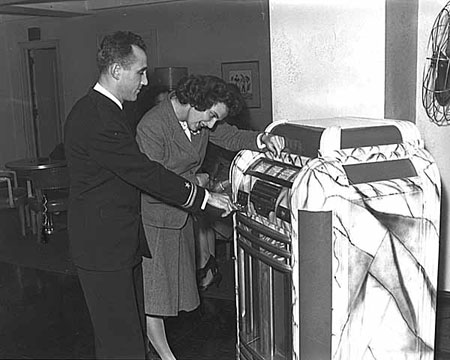
Minnesota Historical Society
Events: 1945
A sign that teenagers were coming into their own was an ad introducing the “Hep Shop For High-Schoolers” at Brown’s Bon-Art Clothes at 306-14 Nicollet Ave. The graphic is of two youngsters jitterbugging.
The Sportsman’s Club sponsored a jam session with the Navy Band and members of the Count Basie, Duke Elliington, and Cab Calloway bands at the CIO Hall on January 7. They must have all been in town. Subsequent jam sessions were held on February 4 (featuring “Chickee”), February 11 (Cab Calloway’s Orchestra invited), and February 18 (singing lyrics by “Chickie”).
Marian Anderson made her annual appearance in the Twin Cities on January 14, 1945, at the Concert Bowl at the Minneapolis Auditorium. This performance was a recital.
Rook Ganz was in trouble again in February 1945 when he was arrested on a charge of white slavery for transporting a 19-year-old girl from Minneapolis to Deadwood, South Dakota, for immoral purposes. He was arrested by the FBI and held in the Hennepin County jail under $5,000 bail. Turns out Ganz’s real name was Wilbur Thompson, according to the Spokesman (Hilliard Thompson according to Joined at the Hip). The trumpeter had led the orchestra at the El Patio in St. Louis Park and was a popular dance entertainer.
The Navy Band and guest artists provided the music for a Sunday night jam session at the CIO Hall on February 25. A Gigantic Floor Show was also in store – featuring “Chickee.”
The Elks Grand Ball and Popularity Contest was held by the Ames Lodge on March 2 at Norway Hall, with music by Walter Lear’s Gents of Rhythm.
The Friendly 16 Club gave a picnic-dance on May 30 at Norway Hall, with music by Jimmy Tyler’s Blue Rhythm Boys.
Howard Brown and His 5 Great Knights of Rhythm appeared at the Elk’s Rest in June 1945.
Brutus Cassius, owner of Dreamland, opened the 38th Street Canteen on October 19. The venue was specifically for teens aged 15-18 and was to be supervised by the mothers of the kids. It was open Fridays from 8:30 to 11:30 and Sundays from 5:30 to 9pm. It was located at the corner of 38th Street and Fourth Ave. and had a “Coke Bar” and “a vendor.” Cassius and wife Florence had two teens of their own: Donald Brutus, 16, and Alvedia Eugenia, 17, both students at Central High in Minneapolis.
20 Limited, Inc. gave a First Anniversary Dance at the CIO Hall on October 20, 1945. Fun and Favors for All, Music by Jimmy Baker and His Jive Band, featuring “Miss Cherry” and his floor show specialty.
Local band singer Mary Walker appeared with Paul Thomason and his Sweet Rhythm band at the Post Cafe in St. Paul in October 1945. The band members, who also sang individually and as a group, were:
- Paul Thomason, piano
- Mym Carter, bass
- Reuben Floyd, trumpet
- Ernie Lewis, drums
The Railroad Men’s Social Center sponsored their First Annual Benefit Ball at the CIO Hall on October 27, with music by the Rhythm Kings. The group’s goal was to raise funds to buy equipment and a location for a recreation center. “Such a project is needed at this time more than ever, with Negro veterans returning from war and service camps, and no facilities to offer them. With the indoor season coming, and nowhere to g, it is advantageous to promote such an establishment for the community welfare,” urged the Spokesman.
The two Black Elks Clubs in Minneapolis, Ames and Minnehaha, sponsored a Grand Halloween Ball at Norway Hall. Music was provided by Sir Walter Lear and His Rhythmeers, featuring Mose Evans, vocalist and emcee.
The Friendly Sixteen Club gave an Armistice Day Dance on November 11, 1945 at the CIO Main Hall, with music by “Popeye” and His All-Stars.
Famous blind jazz pianist Art Tatum made his first Minneapolis appearance on November 14, 1945, in the Concert Bowl of the Minneapolis Auditorium. Tatum had been reluctant to travel outside of New York. The promoter was C.C. Milkes of Greater Minneapolis Attractions.
Marian Anderson appeared with the Minneapolis Symphony Orchestra on November 23-24, 1945, at Northop Auditorium.
The Blue Monday Club have a Cabaret Dance at the CIO Hall on December 2, 1945, with music by Howard Walker’s Rhythm Kings.
After a hiatus during the War, the Mayor of Bronzeville contest was back, with a goal of being more than a popularity contest. The theme was “What will the Negro Contribute to the Postwar Era?” 1940 Mayor Jimmie Slemmons was again elected Mayor, with a close edge over Edward “Gene” Harris of St. Paul, who dubbed himself “The Man with the Atomic Personality.” A crowd of 700 people came to the Inaugural Ball at Norway Hall on December 7. Minneapolis Mayor Hubert Humphrey attended the Ball and made remarks, while Minneapolis Spokesman editor and sponsoring Associated Negro Credit Union vice president Cecil Newman served as emcee. Music was provided by Howard Brown and His Orchestra.
The Melodee Record Shop, 706 Hennepin Ave., (See Record Stores) began to advertise in the Minneapolis Spokesman. A squib says “All of the top Negro orchestra recordings are available at the Hennepin Ave. store.” The first ad said “Jazz Headquarters – Latest Blues, Folk and Jazz Records – WE GOT EM!”
Another was the Olson Highway Phonograph Record Shop, 1307 Olson Memorial Highway, Maurice T. Strong, proprietor. Also known as Maurice’s Record Shop, it sold Swing, Sweet Blues, and Spirituals
Minneapolis Ain’t Talkin’ to St. Paul: 1945
Sometime in 1944 or 1945, the Roberts Brothers recorded the immortal “Minneapolis Ain’t Talkin’ to St. Paul.” Well, maybe not immortal, but kind of fun. The song, recorded on Bel-Tone Records (not to be confused with Beltone Records), was made into a brilliant video by our friend Neal Bond – click for some fun! The short-lived Bel-Tone Records was based in Hollywood and the Miller Brothers don’t Google, so it’s pretty certain that this wasn’t a local production. The Miller Brothers, by the way, were:
- Marty Roberts, Guitar
- Danny Roberts, Bass
- Virgil Bingham, Piano
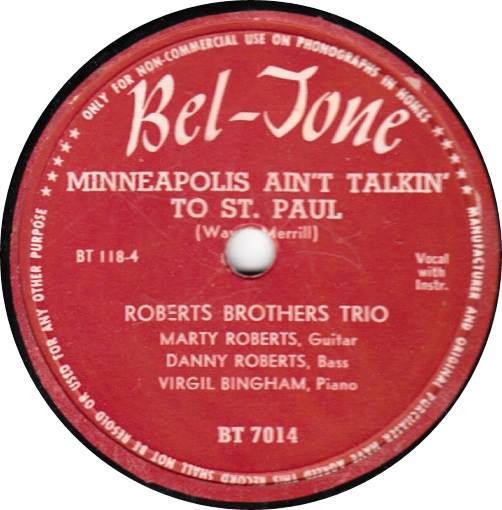
Image courtesy Dale Burback via Derik Olson
What Was the First Rock ‘n’ Roll Record: 1945
The 1945 candidates in What Was the First Rock ‘n’ Roll Record? by Jim Dawson and Steve Propes are:
- “The Honeydripper” by Joe Liggins and His Honeydrippers
- “Be-Baba-Leba” by Helen Humes with the Bill Doggett Octet
Hazel Scott: 1945
Hazel Scott appeared at the Minneapolis Auditorium Concert Bowl on October 12, 1945. This acclaimed jazz pianist and singer had recently married Congressman Adam Clayton Powell, Jr. At age 25 she had already appeared in five films. The Spokesman warned: “Twin Cites Can Expect Heat Wave.”
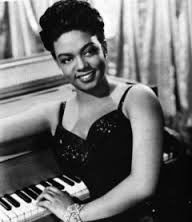
Hazel Scott
Fifth Annual Negro Newspaper Week: 1946
On February 24, 1946, WCCO observed the Fifth Annual Negro Newspaper Week with a special CBS program, featuring:
- Helen Hayes, narrator
- Josh White singing “The House I Live In”
- Lionel Hampton and His Famous Orchestra
- Carlton Moss Dramatization with an all-star cast
- Dr. Charles Drew of Howard University
- Carol Brice, the brilliant young Negro contralto
- The Ink Spots
- A special message from the War Department and the President of the United States
Sugar Chile: 1946
Seven year old phenom Frankie “Sugar Chile” Robinson appeared at the Minneapolis Auditorium on May 8, 1946, presented by C.C. Milkes. Sugar Chile could play piano at 18 months and belted out a song like Fats Waller. This was his first tour of the Northwest. Also appearing were the Deep River Boys. Here is a video of this extraordinarily talented young man.
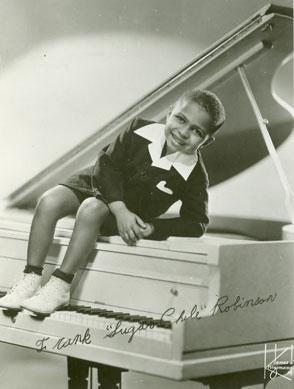
Merrymen of Rhythm: 1946
The Merrymen of Rhythm, featuring Dorothy Ashby, billed as the newest sensation band to hit the Twin Cities, appeared on April 13 at the CIO Hall. They gave a repeat performance on May 29, 1946, at a dance given by the Friendly Sixteen Club – Free Ham Given Away!
Snookum Russell: 1946
Snookum Russell and His Hollywood Orchestra, featuring Alice Rose, Southland’s First Lady of Song, came to the CIO Hall on May 4, 1946. Russell had made several records on the Trilon label, including “Rocking the Blues.”
Jazz at the Philharmonic: 1946
The second national tour of Jazz at the Philharmonic concerts came to the Twin Cities on May 17, 1946. The ad was difficult to read, but some of the performers were:
- Lester Young, tenor sax
- Coleman Hawkins, tenor sax
- Meade Lux Lewis, piano
- Buck Clayton, trumpet
- Kenneth Kersey, piano
- Miss Holmes
- Shadow Wilson, drums
Bruce Dybvig‘s Big Band: 1946
Bruce Dybvig‘s Big Band won the Look Magazine All-American amateur jazz band award at Carnegie Hall in 1946. Most of the band members were between 15 and 17 years old. Follow the link to read the bittersweet tale of this talented musician just a bit out of step with the times.
Events: 1946
Nat Towles appeared at the St. Paul Auditorium on January 2, 1946.
Duke Ellington and His World Famous Orchestra appeared at the Minneapolis Auditorium on January 23, 1946. Minneapolis bass player Oscar Pettiford had just joined Ellington’s band a few weeks prior; Esquire Magazine had deemed him the best bass player in American bands. The promoter was C.C. Milkes.
Paul Robeson performed at the Concert Bowl at the Minneapolis Auditorium on January 27, 19466, as part of Mrs. Carlyle Scott’s Sunday Series, which may have been a radio show.
February 2, 1946, was the debut of Irving Williams and His Rhythmaires, the former Wold-Chamberlain Navy Band. They performed in the Azure Room of the Mandalay Club, which apparently was a restaurant. The band played again on February 10, this time at the Dreamland Annex, which could have been the same place, as the address given for the Mandalay Club (347 E. 38th Street) was just across the street from Dreamland. That dance was billed as a Dance for Grown Ups. On March 3 and 24 the band played at the CIO Hall, this time billed as the 10-piece Irving Williams’ Ex-Navy Band, featuring vocalist Judy Perkins. The band provided the music for St. Thomas’s 12th Annual Easter Style Parade, featuring Auzie Dial (the Hazel Scott of the Northwest). Dances would continue every Saturday night at the CIO Hall.
Auzie Dial was the pianist in the Robin Hood Room of the Hotel Dyckman. The Spokesman reported, “She is also a favorite of many members of the millionaire set here who ask for her talent at their most exclusive private affairs.” In 1946 Miss Dial noted that “the town is going sweet due to the influence of Sinatra and Perry Como. Boogie is on its way out, but that’s all right… When you get into a boogie rut you can’t get out of it.”
Howard Brown and His Five Great Knights of Rhythm provided the music for the weekly Sunday matinee dance at the Elks Rest on February 22, 1946.
The Gay Nighters Club presented a dance on May 18, 1946, at the CIO Hall featuring the music of Nat Towles and His Decca Recording Orchestra, Exotic Song Stylist Florine, and nationally-known blues singer Joe Simmons. They made a repeat performance on August 10.
The Dorie Miller Post No. 544 of the American Legion presented an Independence Eve Frolic at Ramsey Hall, St. Paul Auditorium, with music from Joe Broadfoot and His Rhythm Boys.
The Gay Nighters were back with a cabaret-style dance on July 14, 1946, at the CIO Hall featuring Lloyd Hunter and his National Orchestra – St. Louis Record Smasher.
The Credjafawn Social Club picnic and dance on Harriet Island took place on July 19, 1946, and featured a jitterbug contest. Music was provided by Irving Williams’ X-Navy Band.
Lucky Millinder and his Decca Recording Band appeared at a dance at the CIO Hall on July 28, 1946.
“Here It ‘Tis” “This Is It” “The Cats and Gaters will be Jumping at the “BROWN DERBY,” a floor show (featuring Lillian Goodhue) and dance at the Phyllis Wheatley House on August 10, 1946. Music by the X-Navy Band, and local talent such as the “Ink Tots.”
Gospel singer Sister Rosetta Tharpe, with singers and soloists, appeared at the CIO Hall on August 11, 1946. The show featured Mme. Marie Knight, “Golden-Voiced Evangelist Singing Favorite,” and was presented by the King David Lodge No. 2.
Joe Broadfoot’s Orchestra provided the music at the Big Halloween Party and Dance at the Elks Rest.
Fletcher Henderson and His Orchestra appeared at Stem Hall, St. Paul Auditorium, on November 11, 1946, presented by Northwestern Artists Corp.
Percy Hughes and His Ex-Navy Band performed at an Armistice Day Day, Cabaret-Style Dance, November 11, 1946, at Norway Hall. The dance was sponsored by Brutus Cassius, owner of Dreamland, and featured:
- Judy Perkins, Pleasing Vocalist
- David “Duffy” Goodlow, Dynamic Trumpeter
- Bobby Crittenden, Mr. Drums
- Frank Lewis, noted Arranger and Tenor Sax
Josh White, “The New Idol of New York’s CAFE SOCIETY” and Successor to Hazel Scott there, came to the Lyceum Theater on November 16, 1946. He was billed as “America’s Greatest Singer of Folk-Songs, Blues and Ballads.” The show was presented by Al Sheehan.
Paul Robeson made one of his now regular appearances, at the Concert Bowl of the Minneapolis Auditorium on November 17, 1946. “Comparable to the greatest singers and actors of any race or age,” read the ad. His concert was one of a series of four; one of the other artists was Jascha Heifetz.
Joe Broadfoot and His Orchestra provided music for a Gardenia Party at the Elks Rest on November 17, 1946. Gardenias were given away to the first 30 ladies in attendance. Mercedes Brown was on hand, singing your favorite songs.
Spike Jones appeared at the Minneapolis Auditorium on November 23, 1946. So many people were turned away that he came back for another “corn-cert” on February 20, 1947
Woody Herman’s Orchestra came to the Minneapolis Auditorium on December 13, 1946.
The usual dances at the Elks Rest, including special dances on December 24 and 25, were now featuring Ira Pettiford and His Jesters of Rhythm, with a floor show with Kelly Stone, Ira Pettiford, and others. Mercedes Brown was the vocalist.
Percy Hughes’s Ex-Navy Band provided the music at the Christmas Dance at the Treasure Inn, December 25, 1946.
Percy Hughes: 1946
In 1946 saxophonist Percy Hughes returned from the military to his native Minneapolis and joined the Wold Chamberlain Navy Band, a/k/a the X-Navy Band, which up to that time had been led by Irv Williams. Williams left for New York and Hughes was elected to be the new leader. The band became known as Percy Hughes and His Orchestra, the most well-known jazz band in the Cities. Their first regular job was at the Treasure Inn in St. Paul. Frequent vocalists with the band were Percy’s wife Judy Perkins and Dickie Mayes. Jazz disk jockey Leigh Kamman promoted the group on his show, featuring them on remotes from venues like the Calhoun Beach Hotel and the Radisson downtown. The band also played at private parties and fraternal balls, many of which were advertised in the Minneapolis Spokesman. Other residencies were at Snyder’s Restaurant and the Flame Cafe, downtown Minneapolis. In 1956 he began a long stay at the Point in Golden Valley, until it burned down in 1973. From there he moved to the Kashmiri Room at the Ambassador Motor Inn on Highway 12 in St. Louis Park, where his trio played until 1982. All this time, Percy Hughes was a full-time mailman for 30 years, and he also was an avid tennis player, going on to win awards for coaching. Percy Hughes was a true force in Minneapolis jazz, and he’s not done yet! Read more about him in the book Sports and All That Jazz: The Percy Hughes Story by Jim Swanson (Nodin Press 2011).
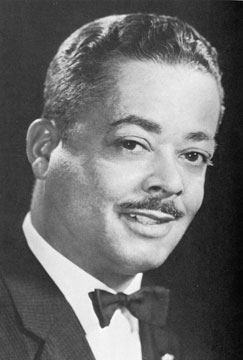
Percy Hughes
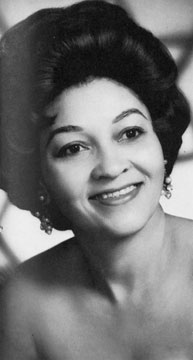
Judy Perkins
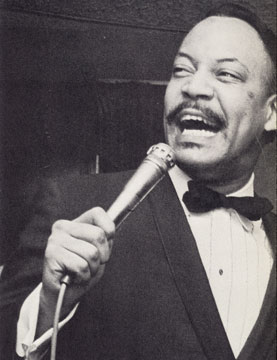
Dickie Mayes
Photos above from the 1970 book Minneapolis Negro Profile by Walter R. Scott, Sr.
What Was the First Rock ‘n’ Roll Record: 1946
The 1946 candidates in What Was the First Rock ‘n’ Roll Record? by Jim Dawson and Steve Propes are:
- “House of Blue Lights” by Freddie Slack and His Orchestra with Ella Mae Morse (I like the version by Chuck Miller)
- “That’s All Right” by Big Boy Crudup
- “Open the Door, Richard” by Jack McVea and His All Stars
Twin Cities Jazz Musicians Awards: 1946
Twin Cities Jazz Musicians Awards, 1946: Stem Hall, St. Paul. Wish we had the names!
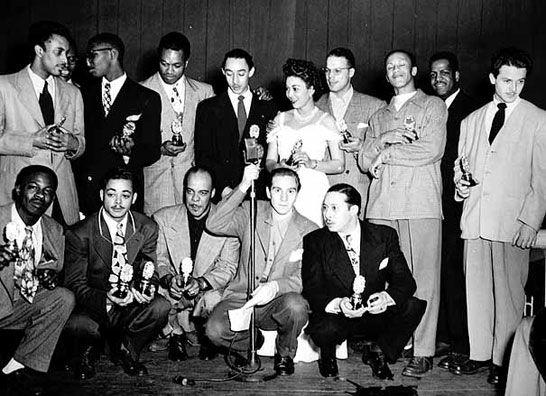
Minnesota Historical Society
The Melodee Record Shop: 1946
Songs featured in ads for the Melodee in the Minneapolis Spokesman in 1946 indicate that Rhythm & Blues was moving in quickly on Swing:
- Prisoner of Love, Billy Eckstine
- Abernathy’s Boogie, Marion Abernathy
- She’s Gone With the Wind, Wynonie “Blues” Harris
- A Hundred Years from Today, Cats ‘N Jammers
- Jazz at Philharmonic Album
- Wise Woman Blues, Dinah Washington
- Blue, Billy Eckstine
- Evening, T. Bone Walker
- Darktown Poker Club, Phil Harris
- King Cole, Lester Young and Red Callender Trio – album
- Spirituals by Coleman Bros., Sister Rosetta Tharpe and the Jubileers
- Cecil Gant
- Don’t Explain, Billie Holliday
- I’ve Got a Right to Cry, Erskine Hawkins
- Oooo Walkie Talkie, Dinah Washington
- It Ain’t Gonna Be Like That, Three Blazes
- Boogie Blues, Gene Krupa
- I’ve Got to Pass Your House, Billy Eckstine
- Roll ‘Em Katy, Jay McShann
- Rich Man Blues, Dinah Washington
- Merle’s Mood, Illinois Jacquet
- R.M. Blues, Roy Milton
- Ave Maria, Marian Anderson
- After Hours, Erskine Hawkins
- One Day the Lord Will Call, Southern Suns Quartette
- Look Out, Metronome All Stars
- Tippin’ In, Erskine Hawkins
- Claire De Lune, Jose Iturbi
- They All Say I’m the Biggest Fool, Buddy Johnson
- Let the Good Times Roll, Louis Jordan
- Jelly – Jelly, Billy Eckstine
- Don’t Take Your Love From Me, Luis Russell
- Christmas Song, King Cole Trio
- Postman Blues, Dinah Washington
X-Navy Band: 1946
On August 4, 1946, the X-Navy Band performed at a dance at the CIO Hall, with proceeds to help the Ames Elks Lodge Drum and Bugle Corps go to the Elks National Convention in Buffalo, New York. This was the first time I spotted that the band was directed by Percy Hughes, Jr., who took over from Irv Williams. Also performing was the Twin Cities’ own June Hawkins, “One of the Stars of Such Broadway Productions as ‘Carmen Jones,’ ‘Porgy and Bess,’ and ‘St. Louis Woman.'” The Drum and Bugle Corps also gave a demonstration.
Count Basie and James Rushing: 1946
Count Basie and James Rushing appeared at the RKO Orpheum on September 19, 1946. The show also included:
- Ann Moore, Vivacious Vocalist
- Bob Bailey, A Man of Note
- Jo Jones, Drummer Man
- Two Zethyrs, “Slow Motion”
- Coles & Atkins, Tall Dark & Dance-some
- Pete Nugent, Tops in Taps
- On the screen was the movie “Crack-Up” with Pat O’Brien, Claire Trevor, and Herbert Marshall
Bill “Bojangles” Robinson: 1946
Bill “Bojangles” Robinson and His Concert Revue appeared at the Minneapolis Auditorium on October 6, 1946. Robinson was 68 at the time. The show was presented presented by C.C. Milkes Also on the bill were:
- Deep River Boys
- Olivette Miller, Harpist
- Frances Palm, Contralto
Bel negre with Voodoo to Jive: 1946
Modern dancer Katherine Dunham appeared at the Lyceum Theater with her show called “bel negre” with “Voodoo to Jive!” The show was presented for three days starting October 24, 1946
Merry Men of Rhythm: 1946
An ad in the September 27, 1946, Spokesman reported that the Merry Men of Rhythm had a standing gig at the Rochester, 1691 Rice Street. On November 2, 1946, the Rochester became the fabled Treasure Inn.
Duke Ellington and His Orchestra: 1946
Duke Ellington and His Orchestra made its second appearance in Minneapolis on November 13, 1946, at the Minneapolis Auditorium. Ellington would perform his newest musical suite, “The Deep South,” a piece in four movements before his two-night stand at Carnegie Hall scheduled for November 21 and 22. Appearing with Ellington were vocalists Mariiono Cox, Kay Davis and Albert Hibbler. A special feature of the concert was the appearance of famed French guitar virtuoso Django Reinhardt, who was scheduled to play at least four numbers, some without accompaniment, in the next-to-closing spot. This would be his only U.S. tour. See a cool collage on Reinhardt on Robb Henry’s blog.
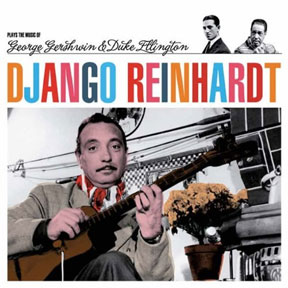
Jazz at the Philharmonic: 1946
Jazz at the Philharmonic was back at the Minneapolis Auditorium on October 28, 1946, again presented by Norman Granz and locally by C.C. Milkes. Appearing were:
- Coleman Hawkins
- Roy Eldridge
- Lester Young
- Buck Clayton
- Meade Lux Lewis
- Shadow Wilson
- Kenneth Kersey
The Southernaires: 1946
The Southernaires appeared in concert in the theater section of the St. Paul Municipal Auditorium on December 3, 1946, sponsored by the St. Paul Branch of the NAACP. Proceeds were to be used to balance the budget and set up a fund to fight legal cases. The group had been featured on the radio since 1929 with African chants, spirituals, slave songs, and Negro music, as well as the classics and ballads. Members were:
- Spencer Odom, accompanist and arranger
- William Edmonson, basso
- Jay Stone Toney, baritone
- Lowell Peters, second tenor
- Ray Yeates, lyric tenor.
Events: 1947
Percy Hughes and the X-Navy Band performed at the Treasure Inn in St. Paul on January 11, 1947, with vocals by his (soon-to-be or already?) wife Judy Perkins.
Marian Anderson appeared at Northrop Auditorium on January 22, 1947, as a part of the University Artists Course.
Spike Jones presented a “corn-cert” at the Minneapolis Auditorium on February 20, 1947. He had just been here the previous November, but came back quickly because so many people had been turned away.
Tim Bender sponsored a cabaret dance at the CIO Hall on March that would feature an all-star orchestra of the best Negro and white bandsmen in the Northwest, reported the Spokesman. They would include Dell Otis, Dave Goodloe, Bobby Green, and Irving Williams.
Fred Waring and His Pennsylvanians performed at the Minneapolis Auditorium on March 16, 1947.
Nat “Lotsa Papa” Towles and His Orchestra came to the CIO Hall on March 23, 1947, in a concert sponsored by the Knights. Towles had appeared with Louis Jordan at Chicago’s Regal Theater and had rocked the Apollo in New York City. In the lower ballroom of the Hall, a cabaret dance was held with the “ever popular” Prince Rogers’ Combo with the romantic voice of Dick Mayes and the Merry Jesters, America’s newest Pied Pipers. This was apparently a traveling road show called “Cavalcade,” and included Omar “Satchmo” Williams, 17-year-old Canadian pianist.
Lloyd Kirk, lyric baritone and singer of “Sacred Spirituals, Classic, Folk Songs” appeared at Benton hall, YWCA on March 27, 1947. He was described as a radio, recording, and concert artist.
The Twin Cities Amusement Club succeeded in bringing Lionel Hampton and His World Famous Orchestra to the Minneapolis Auditorium on April 23, 1947
“LET THE GOOD TIMES ROLL” Says Tiger Jackie Reynolds, Boxer Turned Promoter. Rock and Swing with the Percy Hughes Orchestra, featuring lovely Judy Perkins, Vocalist. Stem hall, St. Paul Auditorium, July 19, 1947. A featured attraction was a dancing contest between Minneapolis Bronzeville and St. Paul Bronzeville. Sponsored by Jackie Reynolds Rosenbloom.
A Battle of the Bands ensued at the CIO Hall on July 26 between Bobby Williams’ Orchestra of Minneapolis and Teddy Massey’s Orchestra of St. Paul. Presented by the Apollo Club.
A Coronation Ball, crowning the Queen of the Fezzah Temple, was held on August 8, 1947, at Norway Hall. Music was provided by Percy Hughes and his Orchestra.
A Labor Day Dance was held at the Elks Rest on September 1, 1947, with music by Ira Pettiford and the Jesters.
On October 23, 1947, St. Louis Park teens attended an Edina Teen Canteen at 50th and Wooddale, where there was something called a Disk Jockey Joggle featuring Don Leary, emcee. Apparently kids competed to be disk jockeys, with the grand prize winner to appear on Don Leary’s radio show.
On October 31, 1947, the St. Thomas Men’s Club held their first annual Masquerade Ball at Norway Hall.
Marian Anderson performed with the Minneapolis Symphony Orchestra on October 31 and November 1, 1947.
A Battle of the Bands was sponsored by the Leader Club at Stem Hall (the old St. Paul Auditorium) between Percy Hughes’ Ex-Navy Band and the New Merry Men on November 10.
The King David Lodge #2 Masons held a Thanksgiving Ball at Norway Hall on November 27. Music was provided by Ira Pettiford and the Jesters of Rhythm.
The Mayor of Bronzeville Fifth Annual Ball was held on November 27, 1947, at the Labor Temple. The show, sponsored by the Associated Negro Credit Union, was broadcast on WCCO, and Cedric Adams did the honors of inducting James W. Slemmons as Mayor. Music was provided by David Falson and His Gents of Swing, featuring Dickie Mayes. This would be the last in Minneapolis. After several years without a competition, the Credit Union issued a formal statement bringing it to an end in 1954.
Yet another event on November 27, 1947, was a Thanksgiving dance at the CIO Hall with the Percy Hughes Band and his singer/wife Judy Perkins.
“We Call it Jazz,” a concert for modern big bands, was held on December 14, 1947. 1,000 people showed up at the Radisson Hotel Ballroom for the session that featured the music of Bruce Dybvig. The account of the event, presented in the September 1950 issue of The St. Paul Musician, did not name the co-sponsors, but just said they were a local disc jockey and a brother-in-law of Eddie Condon.
A Gigantic Stage Show featuring local talent was staged at the Minneapolis YWCA on December 16, 1947. Cedric Adams was the emcee, and the program also included a movie and music by Percy Hughes and His Orchestra.
July at the Treasure Inn: 1947
Bands employed in July at the Treasure Inn included:
- Prince Rogers Combo
- Dave Faison Band
- Percy Hughes and His Orchestra
Melodee Record Shop: 1947
Songs advertised in the Spokesman by the Melodee Record Shop in 1947 include:
- Time to Change Your Town, Wynonie Harris
- I’m the Drummer Man, Jesse Price
- Bless You, Ink Spots
- When a Woman Loves Her Juice, Eddie Vinson
- Jazz at the Philharmonic Volume 4 – album
- Solitude, Billie Holiday
- I’m Yours, Luis Russell
- Hawk’s Boogie, Erskine Hawkins
- I Like ‘Em Fat Like That, Louis Jordan
- Old Maid’s Boogie, Eddie Vinson
- S.M. Blues, Lester Young
- Come Out of the Rain, King Cole Trio
- Don Byas – Saxophone improvisations – album
The Ravens: 1947
The Ravens were a New York based R&B vocal group that included Leonard Puzey, whose career began when he won an amateur talent contest at the Apollo Theater in 1946. The group was most famous for their song “Old Man River,” and recorded several classic songs until they broke up in 1955. Puzey joined other groups, but eventually found himself stranded in St. Paul. Incredibly, he decided he liked Minnesota and started driving a bus for Talmud Torah. He and fellow Raven Maithe Marshall lived at Menorah Plaza (Marshall died in 1989). The Ravens were inducted into the R&B Hall of Fame in 1991. Leonard Puzey passed away on October 2, 2007 at the age of 83. There are some really good web sites on the Ravens: jazzwax.com, Marv Goldberg’s R&B Notebooks, and many performances on youtube.
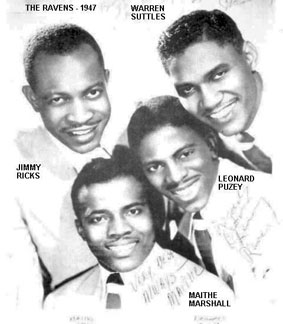
Louis Armstrong: 1948
On May 8 Louis Armstrong and Jack Teagarden appeared at the St. Paul Auditorium for a jam session. The next night the two appeared at the Minneapolis Auditorium on a bill with Earl “Fatha” Hines, Arville Shaw, Big Sid Catlatt, Barney Bigard, and Velma Middleton. The show was promoted by Bob Smith and KSTP’s Don Hawkins was the emcee.
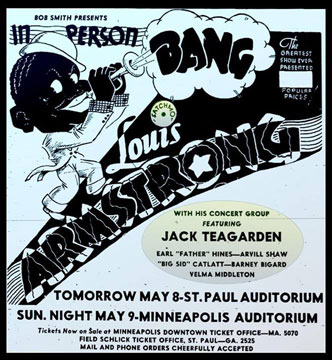
Norman Granz’s Jazz: 1948
Norman Granz’s Jazz at the Philharmonic’s Sixth national tour came to the Minneapolis Auditorium’s Concert Bowl on May 2, 1948. The show featured:
- Sarah Vaughan
- Charlie Parker
- Flip Phillips
- Dexter Gordon
- Red Rodney
- Duke Jordon
- Tommy Potter
- Barney Kessel
- Stan Levy
Events: 1948
On January 1, 1948, a recording ban went into effect, started by James Petrillo of the American Federation of Musicians (AFM). This was Petrillo’s second strike, the first lasting from 1942 to 1944. See a piece on these strikes Here.
St. Louis Park High School held its Lumberjack Days Dance, with “Taxi Calloway’s All-Negro Band” appearing in blackface.
Duke Ellington appeared at the Minneapolis Auditorium on January 21, 1948.
A concert and dance featuring Ella Fitzgerald and Illinois Jacquet was held at the Minneapolis Armory on February 1. Bob Smith was apparently the promoter, and Leigh Kamman of WLOL was the emcee.
The WCCO program “Neither Free Nor Equal” won an award from the National Conference of Christians and Jews.
Arty “Fritz” Watkins and the Northern Lights with Mercedes Brown, vocalist, played a dance at the CIO Hall on February 27.
In April 1948 the “We Call it Jazz” radio program was broadcast from the Treasure Inn, which announced that no set-ups or beer would be served during the program.
The Phyllis Wheatley House was the site of the “Jim Jam Jump” dance given by the Cordileon Society, music by the Prince Rogers Combo.
Kenneth Stuart: “In 1948, I believe it was, I went to the Flame in St. Paul to worship at the stage/altar where Anita O’Day was performing. It was great being at a table in the front and seeing her up close. I was fairly young then and wasn’t yet sure what music I liked best but I wasn’t interested in be-bop. It was music none of us understood and as we went to various venues around we were amazed at, what seemed to us, freneticism in movement, of fingering, of drummers and horn players not seeming to be in accord with each other. We were snobs but didn’t know it. Dixieland was more acceptable than what they were playing. The Duke, Count, Earl, Woody, Artie, Tommy, Jimmy. These artists were where it was at and I’m sure that our reticence to accept the bebop cacophony was the reason it took so long for it to be, at least, partially accepted. Not only in the Cities but elsewhere as well.”
KSTP-TV was the first television station in Minnesota, signing on the air April 27, 1948, from the Prom Ballroom. Some local musicians that took part in the first telecast were Johnny Bravus (sic), tenor; Jack Donovan, trombone; Dougie Peterson, bass; Sid Osterlund, drums; and Wally Morgan, piano. The effort was masterminded by John (?) Wolf, a local radio DJ. Kenneth Stuart says he wasn’t there but roomed with Jack Donovan who said it was a “trip.”
In April 1948 Radio City Theater hosted Stan Kenton and His Orchestra, June Christy, and the King Cole Trio. Also on the bill was the Wallace Beery film “Alias a Gentleman.” While in town Nat King Cole was refused admittance to the Carnival Club, where he had been invited to a party. The club issued an apology.
On May 31, 1948, the Duke and Duchess Club hosted a matinee dance at the Treasure Inn with music by Hensley Hills’ Band.
A Mardi Gras benefit dance was held at the Phyllis Wheatley House on June 18, 1948, sponsored by Musicians’ Local #73. Music was provided by Stanley Berry and His Barons, and Lillian Goodhue directed the stage show.
A Labor Day Cabaret Ball was held at Norway Hall on September 8, 1948, featuring Chet Christopher and the Northwest’s Leading BeBop Artists, which appear to have been from out of town.
A Halloween Dance at Stem Hall featured the Chester Harris Orchestra, “the sweetest music band in the Twin Cities.”
KSTP’s Sunset Valley Barn Dance was broadcast from the St. Louis Park High School auditorium on December 17. The event was sponsored by the Mohawks, which were similar to the Boy Scouts, as a fundraiser to build a cabin.
By at least 1948, WCCO had a competitor to the Sunset Valley Barn Dance, the Red River Valley Gang. See TV Shows
David LaVay was a dance teacher headquartered at the Dyckman Hotel, teaching ballroom, tap, ballet, and stage routines.
The 1948 candidates in What Was the First Rock ‘n’ Roll Record? by Jim Dawson and Steve Propes are:
- “Tomorrow Night” by Lonnie Johnson
- “Good Rockin’ Tonight” by Wynonie Harris and His All Stars
- “We’re Gonna Rock, We’re Gonna Roll” by Wild Bill Moore
- “It’s Too Soon to Know” by the Orioles
- “Boogie Chillun” by John Lee Hooker
- “Guitar Boogie” by Arthur Smith and the Crackerjacks
Edina Shop: 1948
From the July 28, 1948, Southwest Shopper:
Record Buyers Test Choices Over Phone at Edina Shop
Ever try picking your phonograph records over the telephone instead of from the listening booth of the store? Well, you can at the Edina Record and Television shop, 3833 W. 50th St., by Dialing WH. 0503. Jean Wagner, owner, got the novel idea because many people call wanting to choose music for themselves or as a gift and are not sure just what they want. They may know some of the words, the tune, or type type of music, but the rest is left to the dealer’s imagination.
“We try to hum (and we can’t carry a tune), recite words to songs, guess, and have even gone so far as to turn up the volume in a nearby booth and hope our party will hear it,” says Mrs. Wagner.
“One day we decided ‘Enough of this, play it through the telephone attachment and let them get a good listen.’
“We hope this will be a service to our Edina and Southwest Minneapolis residents, not an afternoon’s amusement. It’s for the use of mothers wanting to listen to children’s music because they can’t leave the house, or a git for some relative or friend overlooked until the last minute, or for folks planning a party and forgetting until the last that they were the dancing kind of guests.”
Club Friday: 1949
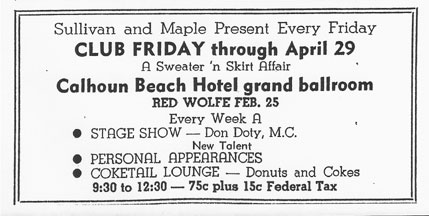
St. Louis Park Echo, February 23, 1949. Don Doty was a disk jockey, station at the time unknown.
Events: 1949
Percy Hughes had spent the winter of 1948-49 as the house band at Snyder’s Night Club in downtown Minneapolis and the summer of 1949 at Bar Harbor in northern Minnesota. In September he returned to Minneapolis and played at the Labor Temple, again with singer/wife Judy Perkins.
Ira Pettiford was a regular on Fridays and Sundays at the Elks Rest, with Joe Broadfoot on Saturdays.
A Halloween Masquerade Jam Session took place at the Cassisus Bar and Cafe, with music by Maurice Talley’s Harlem Bopcats.
The 16th Annual New Year’s Eve Cabaret Dance at Stem Hall featured Mel Carter’s Great Band.
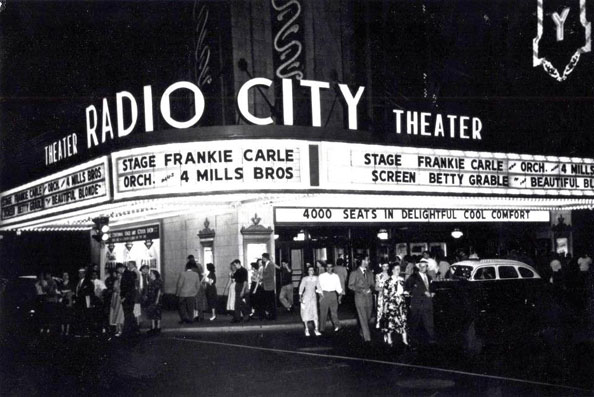
Frankie Carle gave this photo to Reed Hagen
What Was the First Rock ‘n’ Roll Record: 1949
The 1949 candidates in What Was the First Rock ‘n’ Roll Record? by Jim Dawson and Steve Propes are:
- “Drinkin’ Wine Spo-Dee-O-Dee” by Stick McGhee and His Buddies
- “Rock the Joint” by Jimmy Preston and His Prestonians
- “Saturday Night Fish Fry” by Louis Jordan and His Tympany Five
- “Mardi Gras in New Orleans” by Professor Longhair
Events: 1950
On March 14 St. Louis Park High School janitor Carl J. Chrest won a television set on the national “Stop the Music” radio show. He was able to identify the songs “Bibbidy Bobbidy Boo,” “Chopsticks,” and “Give My Regards to Broadway.”
Marian Anderson appeared at Northrop Auditorium with the Minneapolis Symphony Orchestra on March 17 and 19, 1950.
Spike Jones appeared at the Lyceum Theater on March 28, 1950.
A stage show starring Jack Benny, Rochester, Phil Harris, and Vivian Blaine took place at the St. Paul Auditorium Arena on May 19, 1950.
Dizzy Gillespie, “America’s Greatest New All-American Trumpet Star and his Entire Band,” appeared at St. Paul’s Flame on June 27, 1950.
The Phyllis Wheatley House hosted Percy Hughes and his orchestra with vocalist Dickie Mayes on September 22, 1950.
In October 1950, Echo reporter Joan Bye presented a record review called “Discs to Please Park.” On the list were songs featured in movies and “Dance Date” records arranged and presented by Xavier Cugat, Les Brown, Tony Pastor, and Hall McIntyre. For jazz fans, Stan Kenton’s “Innovations in Modern Music,” “The Cuban Episode,” and “Incident in Jazz” are recommended, and there are selections endorsed for Dixieland fans. Park native David Lloyd was one of the performers to appear with the Minneapolis symphony orchestra that winter.
Bandleader Horace Heidt hosted a 2 1/2 hour musical review from the Minneapolis Auditorium on October 22, 1950, that was broadcast nationally over CBS radio.
Gopher Elks Lodge #105 sponsored their annual Big Cabaret Dance at the St. Paul Auditorium Veterans Hall on November 20, 1950. Entertainment was by the Percy Hughes Orchestra with the “dynamic singer Dickie Mayes.”
A Holiday Hop at Stem Hall on December 22, 1950, featured the music of the Percy Hughes Orchestra with vocalist Judy Perkins.
The Sheiks of Rhythm was St. Louis Park High’s resident Swing Band. Members were Jack Bassart, director, Bob Anderson, Bob Bechtold, Dewaine Osman, Norma Domian, Alan Lecklitner, Darleen Thorson, Bill Harrison, and Art Lunow. The Toga Tri girls organized a Fish Dance, featuring Spike Lee’s younger brother Pike Lee and his Fish Scalers…
What Was the First Rock ‘n’ Roll Record: 1950
The 1950 candidates in What Was the First Rock ‘n’ Roll Record? by Jim Dawson and Steve Propes are:
- “The Fat Man” by Fats Domino
- “Rollin’ and Tumblin” by Muddy Waters
- “Birmingham Bounce” by Hardrock Gunter and the Pebbles
- “I’m Movin’ On” by Hank Snow and His Rainbow Ranch Boys
- “Teardrops From My Eyes” by Ruth Brown with Budd Johnson’s Orchestra
- “Hot Rod Race” by Arkie Shibley and His Mountain Dew Boys
Toast-and-Jam Session: 1950
In the September 16, 1950, St. Louis Park Echo, there is an ad for John K. Sherman’s “Toast-and-Jam Session – a New Saturday Breakfast Series” from 9 to 10 AM, Fountain Room, Fourth Floor, Maurice L. Rothschild Young-Quinlan Co., 9th and Nicollet Downtown. It advertised “Celebrities! Blues-Dixieland-Bebop! – Breakfast! Hi-School Bigshots! – Surprises! Sherman was the Music, Art, and Drama Critic for the Minneapolis Star-Tribune. Aha! A precursor to the famous Dayton’s shows of the ’60s?
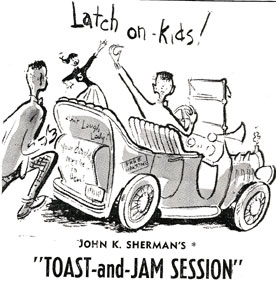
Republican Talent Show: 1950
Also on September 17, 1950, at the St. Paul Auditorium Theater Section:
Don’t Miss the Big
REPUBLICAN TALENT SHOW
Cedric Adams (in person as master of ceremonies) Presents
Governor Luther W. Youngdahl
and our star studded slate of talented candidates, selected only three days before!
PLUS
5 BIG ACTS 5
- Bud Jacobson, His Magic and Patter
- Murtha & Mack, Songs and Dances
- Pop Wiggins and Elmer, Stars of Sunset Valley Barn Dance
- Cedric Adams’ Amateur Talent, and
- The Great Orchestra of Gordie Bowen
Long on fun, short on Speeches – guaranteed to generate the greatest Republican enthusiasm in the history of our state – don’t miss the opportunity to be one of those specially selected Republican workers present!
[Youngdahl was Governor of Minnesota from 1947 to 1952. He was notable for outlawing slot machines during his first term as Governor.]
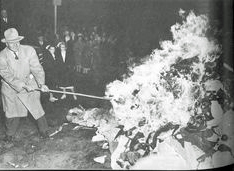
Youngdahl burning slot machines
Events: 1951
Marian Anderson sang with the Minneapolis Symphony Orchestra at Northrop Auditorium on January 18, 1951, an Annual Pension Fund Benefit Concert.
Percy Hughes and His Orchestra, featuring vocalist Dickie Mayes, performed for a Cabaret Dance at the St. Paul Auditorium in April 1951, sponsored by the Dining Car Employees Union #576.
Hazel Scott, “star of motion pictures, concerts, radio,” gave a piano concert at the Lyceum Theater on April 15, 1951.
Charlie “Yard Bird” Parker appeared at the Flame in St. Paul on April 21, 1951.
Stan Getz came to the Flame in St. Paul on May 8, 1951.
Webster and Black presented Lionel Hampton headlining a Cavalcade of Jazz with 30 artists and a 20 piece orchestra, on June 16, 1951, at the Minneapolis Auditorium.
On September 2, 1951, radio station KEYD presented The Blind Boys in Person at 9:15 am. They also appeared at Graham Temple at 3pm.
After the Edina-St. Louis Park Football game on September 21, 1951, students from both schools were invited to a Jam Session in the Edina gym with Don Leary’s Band.
Teenagers were wearing Levi’s jeans constantly, says the Echo.
Stan Kenton with June Christy appeared at the Minneapolis Auditorium Concert Bowl on November 12 and the St. Paul Auditorium Theater on November 13.
The Key Club, located at the South of the Border Bar, opened on December 19, 1951 at 1327-29 Washington Ave. So. The first act was the Four Blazes.
In 1951 there were 1,744 musicians in the Minneapolis musicians’ union.
What Was the First Rock ‘n’ Roll Record: 1951
The 1951 candidates in What Was the First Rock ‘n’ Roll Record? by Jim Dawson and Steve Propes are:
- “Rocket 88” by Jackie Brenston with His Delta Cats (actually Ike Turner’s band)
- “Sixty Minute Man” by the Dominoes
- “Cry” by Johnnie Ray
Big Jazz Show: 1951
A big jazz show came to the Minneapolis Auditorium on November 21, 1951. Featured artists were:
- Duke Ellington
- Nat King Cole and His Trio
- Sarah Vaughan
- Timmie Rogers
- Peg Leg Bates
- Stump and Stumpy
- Patterson and Jackson
- Marie Bryant Dancers
Events: 1952
Jack Benny’s singing group the Sportsmen appeared at the Builders’ Show at the Minneapolis Auditorium, February 16-24, 1952.
Jimmy Dorsey appeared at the Prom Ballroom, February 16, 1952
Frankie Carle appeared at the Prom Ballroom, March 21, 1952
Spike Jones and His City Slickers – New Musical Depreciation Revue of 1952 appeared at the Prom Ballroom – April 5, 1952
Stan Kenton appeared at the Prom Ballroom, April 25, 1952
The U of M held its Black Book Dance on April 25, 1952, in the Union’s Main Ballroom with music by Dick Kast and his Orchestra. In an ad in the Minnesota Daily, Men and/or Boys were invited to meet “Stenos, Models, Nurses, Receptionists and Coeds; – over 2500 girls attended last year’s dance,” it promised. “Friday is Your Night to Make Out!” Apparently this was an escapade of the Engineering school, which in the ’50s was bereft of women. At the dance Queen Colleen of the Engineers would be crowned, and the boys were exhorted to fix up dates for the engineers’ crawl on May 10. At some point in this silliness the engineers would present the opera “Il Cuspidore.”
A show called the Piano Parade took place at the Lyceum Theater on April 26, 1952, and featured the Art Tatum Trio, the Erroll Garner Trio, Meade Lux Lewis, and Pete Johnson.
Vaughan Monroe, star of the Camel Caravan, with Orchestra, Vocalists, Entertainers – The Most Talked About Band in America – appeared at the Prom Ballroom, May 9, 1952
Blue Barron Orchestra appeared at the Prom Ballroom, May 16, 1952
Ray Anthony, the Young Man with the Horn appeared at the Prom Ballroom, May 23, 1952
U of M President J.L. Morill banned Paul Robeson from performing at the University, calling him an “embittered, Anti-American, Anti-democratic propagandist.” Robeson was not deterred, performing at the Union Men’s Ballroom (could this be the CIO Hall?) on June 3, 1952, in a show sponsored by the Young Progressives of America, reported the Minnesota Daily.
George Shearing appeared at the Flame on June 6-12, 1952.
Ralph Flanagan Orchestra appeared at the Prom Ballroom, June 6, 1952
Les Brown appeared at the Prom Ballroom, June 27, 1952
Don Cornell appeared at the Prom Ballroom, July 19, 1952
Woody Herman appeared at the Prom Ballroom, July 25, 1952
Ralph Marterie appeared at the Prom Ballroom, August 2, 1952
Clyde McCoy and his Sugar Blues Orchestra appeared at the Prom Ballroom, August 8 and 9, 1952
Fresh Approach of Billy May appeared at the Prom Ballroom, August 15, 1952
Neal Hefti, Frances Wayne, and the Cavaliers appeared at the Prom Ballroom, August 29-30, 1952
Ella Mae Morse appeared at the Prom Ballroom on October 4, 1952.
Tony Pastor, King of the Saxophone appeared at the Prom Ballroom, October 10, 1952
Republican Vice Presidential candidate Richard Nixon made an appearance at the Minneapolis Armory on October 23, with a production that included a 40-piece brass band, Ukranian dancers, and folk singers.
Billy Eckstine, the George Shearing Quintet, and Count Basie and His Big Band appeared at the Minneapolis Auditorium on October 25, 1952.
Pee Wee King, America’s Number 1 Western Dance Band, appeared at the Prom Ballroom on October 25/26, 1952.
Harry James appeared at the Prom Ballroom, October 31 and November 1, 1952
The U of M’s Homecoming Dance featured the Four Aces on November 1, 1952. There were also three orchestras.
Clyde McCoy and his Sugar Blues Orchestra appeared at the Prom Ballroom, November 14, 1952
Louis Jordan and His Tympany Five came to the St. Paul Auditorium on November 24. It was his first Twin Cities appearance since – and then the ad is aggravatingly illegible!
Billy May’s Orchestra appeared at the Prom Ballroom, November 28 and 29, 1952
Clyde McCoy and his Sugar Blues Orchestra appeared at the Prom Ballroom, December 27, 1952
New Year’s Eve at the Radisson Ballroom included entertainment by popular recording artists Ozzie Osburn and Zachary Dante.
The papers and shows were full of “Bop” jokes, featuring “Hipsters.”
Biggest Show of 1952
The Biggest Show of 1952 was presented at the Minneapolis Auditorium on May 7, starring:
- Frankie Laine
- Patti Page
- Billy May
- Illinois Jacquet
- The Choclateers
- Jay Lawrence
- Don Rice
- The Clark Brothers
Brotherhood of Sleeping Car Porters Annual Dance: 1952
The Twin Cities Division of the Brotherhood of Sleeping Car Porters gave their annual dance at the CIO Hall on May 17, 1952. Entertaining was the Irving Williams Orchestra.
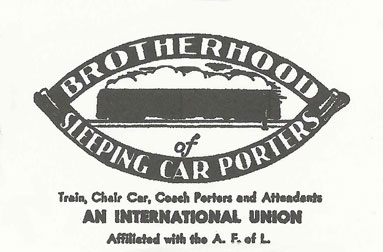
Great U of M Panty Raid: 1952
his may have a tenuous connection to music, but I’ll bet these crazy kids liked their tunes. On Monday night, May 20, 1952… well, let’s let the Jean Worrall of the Minnesota Daily tell it:
Minnesota men staged a “panty raid” last night and were met with tear gas, police and cries of “chicken.”
Minneapolis and campus policemen dealt out the tear gas and arrests. And Comstock coeds furnished the cries of “chicken” as about 300 men – mostly from Pioneer and Centennial halls – milled outside the locked doors of Comstock.
The raid began about 8 p.m. when Pioneer and Centennial residents gathered outside their dormitories and began making their way toward Comstock.
Before the raid was over, they also had visited Sanford and Powell halls and Gamma Phi Beta, Alpha Phi and Chi Omega sorority houses. Coeds retaliated by storming Pioneer and Centennial. More than 1,000 students were involved or “just watching” by the time the raiding ended about midnight.
First news of the raid began circulating yesterday afternoon. By dinner time counselors in the women’s dormitories had been instructed to go from door to door on each floor to warn coeds that “a lingerie raid was imminent” and that doors should be locked. …
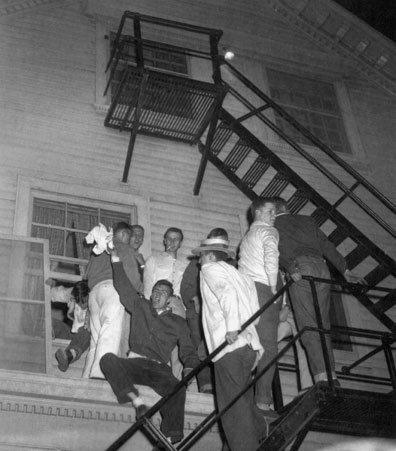
Apparently this was the first of such panty raids on campus, following a trend that had erupted around the country. The Administration was furious, bound and determined to punish the ringleaders, but with so many involved, it is doubtful that anyone was kicked out. Except maybe for that guy above holding the goods….
Johhnie Ray Goes to Jail: 1952
There was some excitement in July 1952, when Johnnie Ray, the “Prince of Wails,” came to town for a week at the Radio City Theater. It seems Ray, his opening comic Gary Morton, and a “couple of thirsty local well wishers” were drinking heavily in his room on the 17th floor of the Radisson Hotel.
According to his biographer, Jonny Whiteside, “Johnnie was inspired to pay a call at the gift shop in their hotel’s lobby. Naturally, he was drawn to the kiddies’ toy section – alcohol not only stimulated, it also seemed to regress him to his childhood. He obtained the perfect summer fun accoutrement: roller skates and water pistols for everyone in the party.” They proceeded to roller skate through the lobby and into the restaurant. Minneapolis detective/house dick Ray Williamson brought them to the station when they “squared off” when being asked to pipe down. They were charged with disorderly conduct, but his road manager bailed him out and they were released after about an hour.
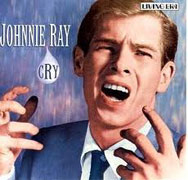
The Minneapolis Star was shorter on details, but there were a couple of discrepancies. First, it said it was the seventh floor (did the hotel have 17 floors?) second, noted that the star was not charged but let go after an hour of “peaceful talk at headquarters.” Neither account says when this happened (Ray and company were there for a week, leaving on the night of Thursday, July 10).
What Was the First Rock ‘n’ Roll Record: 1952
The 1952 candidates in What Was the First Rock ‘n’ Roll Record? by Jim Dawson and Steve Propes” are:
- “One Mint Julep” by the Clovers
- “Rock the Joint” by Bill Haley and the Saddlemen
- “Have Mercy Baby” by the Dominoes
- “Lawdy Miss Clawdy” by Lloyd Price. Lloyd Price has come out with a book declaring “Lawdy Miss Clawdy” the first rock ‘n’ roll song and himself as “The True King of the 50s.”
Key Club: 1952
The Key Club promised “They Key to Pleasure in Fullest Measure.” Acts in 1952 included:
- Cozy Eggleston’s Combo
- Irv Williams’ Combo
- The Delta Boys, “America’s Finest Sepia Combo”
- Hank Hazlett
- Little Donna Hightower, Decca’s famous recording artist
- Stomp Gordon Combo, “King of Bop and Boogie – the Character who stomped his way to fame with his All Star Combo”
Norman Granz’s Jazz: 1952
Norman Granz’s Jazz at the Philharmonic came to the Minneapolis Auditorium on October 10, 1952. Artists were:
- Ella Fitzgerald
- Flip Phillips
- Lester Young
- Charlie Shavers
- Hank Jones
- Buddy Rich
- Roy Edridge
- Ray Brown
- Barney Kessel
- The Gene Krupa Trio
- The Oscar Peterson Trio
Biggest Show of 1952
The “Biggest Show of 1952” took place on November 9 at the Minneapolis Auditorium. Acts included:
- Nat King Cole
- Stan Kenton
- Sarah Vaughan
- Stump & Stumpy
- George Kirby
- Teddy Hale
- The Congaroos dance troupe
Photos of the WTCN DJs after the show, courtesy of the Pavek Museum of Broadcasting.
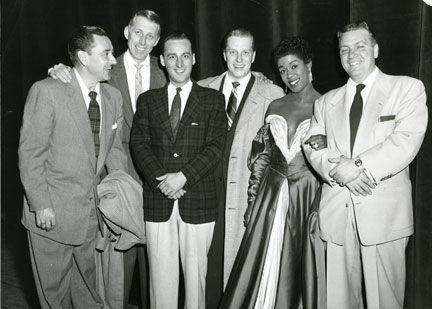
?, Stan Kenton, Sev Widman, Jack Thayer, Sarah Vaughan, and Jimmy Delmont.
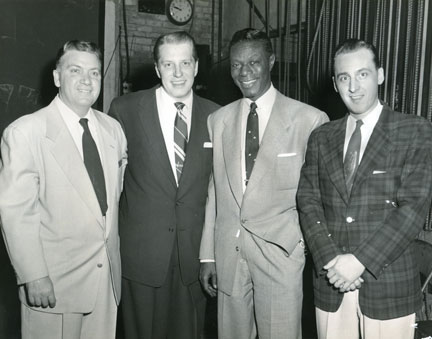
Delmont, Thayer, Nat King Cole, and Widman. From Jim Nagro Collection.
Events: 1953
Vaughn Monroe appeared at the U of M Convocation on January 8, 1953, at Northrop Auditorium.
Kenn Harlan and the Fools For Fun played at dances at the Dug Out, 206 So. Third Street, on January 16, 1953.
Blue Barron, Music of Yesterday and Today, appeared at the Prom Ballroom on January 16, 1953
Songstress Sunny Gale was the featured artist at the 1953 Sno Ball at the U of M, January 24.
Baritone William Warfield appeared at Northrop Auditorium as part of the University Artists Concert Series on February 4, 1953. Warfield sang “Old Man River” in the movie “Showboat” and was touring as Porgy in “Porgy and Bess.”
Big issues discussed in the Minnesota Daily in 1953 were whether it was wise to lower the voting age to 18, and whether the loon or the woodpecker should be the state bird.
Les Brown appeared at the Prom Ballroom on February 21, 1953.
Spike Jones appeared at the Builder’s Show at the Minneapolis Auditorium on March 14, 1953.
Les Paul and Mary Ford appeared at the Home Show in St. Paul on April 4, 1953.
The Just For Fun Club sponsored an Easter Matinee Dance on April 5, 1953, at Kruger’s Haymow. Oscar Frazier’s Band provided the music, and a prize was awarded to the best dressed person.
The Greeks at the U of M gave a dance at the Calhoun Beach Hotel on April 10, 1953, as a benefit for Minneapolis cerebral palsy victims. Music was provided in three ballrooms.
The Minnesota Daily advertised white bucks – for girls!? Only $6.95 at Campus Fashions. For men it was “Look Smarter… Feel Smarter in ALL WHITE BUCKS – a real campus favorite. $12.95. Also with a new style with red foam-crepe sole. And then there were “dirty bucks.” Pre-dirtied, I guess. Another fashion must was Bermuda shorts, a “Leisure Leader.” The Daily notes that they have been a long time must on Eastern campus and have finally come to the Midwest this year, a compromise between pedal pushers and regulation shorts. “Gone is the ‘sloppy-Joe’ look and here to stay is the trim, carefully groomed appearance for leisure hours.” Ah, the fifties.
Jan Garber appeared at the Prom Ballroom on April 10, 1953
Eileen Barton appeared at the Prom Ballroom on April 17, 1953
Buddy Morrow played at the Stardust Dance on April 18, 1953, at the U of M.
Ray Anthony appeared at the Prom Ballroom on April 20, 1953
Henry Busse and His Famous “Hot Lips” Orchestra appeared at the Prom Ballroom on May 18, 1953
Eddy Howard played at Schlief’s Little City on May 21, 1953 – a rare non-polka date?
Dick Jurgens appeared at the Prom Ballroom on June 5, 1953
Bobby Wayne with Tommy Reed and Orchestra appeared at the Prom Ballroom on June 12, 1953
Ralph Marterie and His Down Beat Orchestra – “The Man Born for the Horn” – appeared at the Prom Ballroom on June 26 and 27, 1953
Ralph Flanagan appeared at the Prom Ballroom on July 10 and 11, 1953.
Sauter-Finegan Orchestra – 25 musicians and singers – appeared at the Prom Ballroom on July 21, 1953
Frankie Carle appeared at the Prom Ballroom on July 24, 1953 – piano and orchestra
Sonny (“Long Gone”) Thompson and his Orchestra featuring vocals of Lula Reed, August 7, 1953. This is a Universal Attraction. Place?
Les Brown appeared at the Prom Ballroom on August 21 and 22, 1953
The Bamboo Room was apparently dark for the summer of 1953. Fall acts included Oscar Frazier and His Four Notes.
Tommy and Jimmy Dorsey appeared at the Prom Ballroom on October 2 and 3, 1953
Felicia Sanders, the Voice of Moulin Rouge at the Radisson Hotel, appeared at a dance at the Union Ballroom at the U of M on October 8, 1953.
At the Flame Cafe on October 9, 1953, was Johnny Savage’s jazz Quintet in the main room and the Dave Dudley Trio in the Cocktail Lounge.
Jimmy “Dancing Shoes” Palmer appeared at the Prom Ballroom on October 23, 1953
Pee Wee Hunt (Dixieland) appeared at the Prom Ballroom on October 30, 1953
Freddy Martin appeared at the Prom Ballroom on November 6, 1953
The 1953 Homecoming Dance at the U of M featured Freddy Martin and his Singing Sax in the main ballroom, Doc Evans in the main lounge, Bill Lawrence and Dick Finch in the Armory, and Dick Marrone in the Cafeteria. All this on November 7.
Woody Herman and His Third Herd appeared at the Prom Ballroom on November 20-21, 1953
Fred Waring and the Pennsylvanians appeared at the St. Paul Auditorium on November 25, 1953.
Ray Anthony and His Chesterfield Orchestra appeared at the Prom Ballroom on November 27, 1953.
Minneapolis: 1953
Jill Corey was well-known for singing American pop standards during the 1950s. She sang with the Percy Faith Orchestra and was a regular on one of Johnny Carson’s first television shows. In 1953 she was featured on the cover of Life Magazine and released her first single, “Minneapolis.” It was written by Bob Hilliard and Minneapolis-native Sid Lippman. To listen, click Here. Nice find by Jesse Jamison!
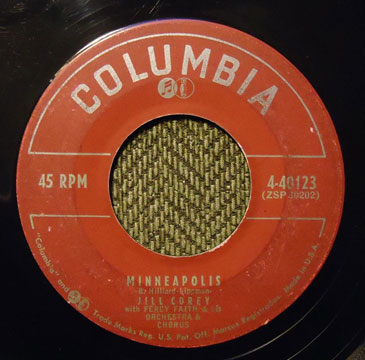
What Was the First Rock ‘n’ Roll Record: 1953
The 1953 candidates in What Was the First Rock ‘n’ Roll Record? by Jim Dawson and Steve Propes are:
- “Kaw-Liga” by Hank Williams and the Drifting Cowboys
- “Hound Dog” by Big Mama Willie Mae Thornton with Kansas City Bill
- “Honey Hush” by Big Joe Turner
- “Money Honey” by the Clovers
- “Gee” by the Crows
Crazy Man Crazy: 1953
Bill Haley and His Comets’ “Crazy Man Crazy” also came out in 1953, entering the Billboard Pop Chart in June. It was featured in the “Glory in the Flower” episode of the TV series “Omnibus,” which starred James Dean as an angry juvenile delinquent out on bail after being arrested on a marijuana charge. He’s much more criminal-minded than the James Stark character he would later play in “Rebel Without a Cause.” The owner of the cafe in which the teleplay is set throws him out for spiking Cokes with alcohol. The show begins with the jukebox playing “Crazy Man, Crazy,” much like Haley’s “Rock Around the Clock” would later kick off the film “Blackboard Jungle.” James Dean is the first jitterbugger out on the dance floor. (IMDB)
Key Club: 1953
“Always something new at the Key Club, where we make things happen:”
- Ever Modern Jazz Group, with members formerly with Woody Herman’s Band. “Hottest Jazz band in the country.”
- Five Young Moderns Jazz Group (the former with piano added)
- Hank Hazlett Trio and four vocalists featuring Little Donna Hightower – “Man Alive it’s Jump & Jive Music With Drive”
- Scat Johnson Trio
- Great Jimmy Binkley, Blue Note recording band
- Bill Boone, the Man with the Horn
American Familiar Music: 1953
On October 28, 1953, the St. Paul Auditorium hosted a night of singing American Familiar Music with a company of 38 voices.
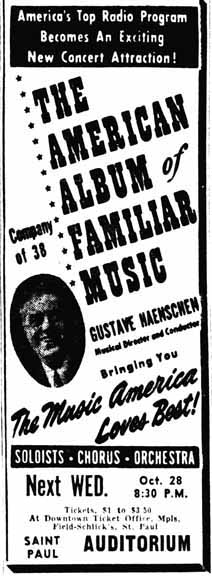
Jazz at the Philharmonic: 1953
Jazz at the Philharmonic came to the Minneapolis Auditorium on October 9, 1953. Performers included:
- Gene Krupa
- Ella Fitzgerald
- Oscar Peterson
- Flip Phillips
- Roy Eldridge
- Benny Carter
- Charlie Shavers
- Bill Harris
- Ben Webster
- J.C. Heard
- Ray Brown
- Herb Ellis
- Raymond Tunla
- Lester Young
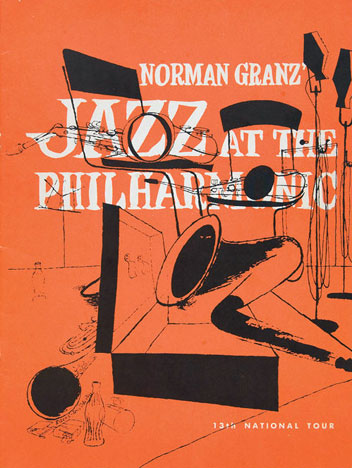
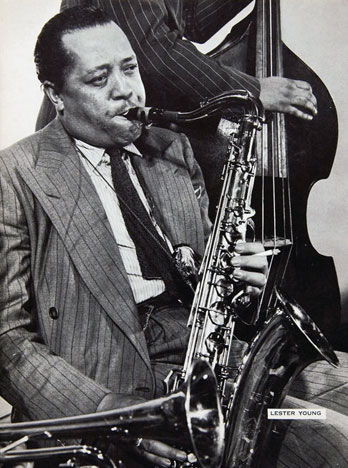
Program from the 1953 show and photo of Lester Young from the Program.
Festival of Modern Jazz: 1953
The Festival of Modern Jazz played two shows at the RKO Orpheum Theater in Minneapolis on December 1, 1953. The Minnesota Daily reported that it was the first time a non-vaudeville presentation of modernists has gone on an extended national tour. The lineup included:
- Stan Getz
- Dizzy Gillespie – also emcee
- Erroll Garner
- June Christy
- Lee Konitz
- Stan Kenton was absent but apparently his band was there
Events: 1954
Stan Kenton gave a concert (January 8) and a dance (January 9) at the Prom. (1954)
Duke Ellington and His Famous Orchestra performed at the St. Paul Auditorium on January 12, 1954, in conjunction with a “Parade of Youth.” 8 acts – singing – dancing – musical show
Ray Anthony played for the Sno-Ball on January 22, 1954, at the U of M Union Ballroom.
Percy Hughes and Oscar Frazier played at the “Tunic Twirl” for the U of M’s Greek Week. The dance was on February 22, 1954, at the Prom, and admission was free if you wore a tunic. Toga!!
The Dave Brubeck Quartet, with Paul Desmond on alto sax, performed at the Lyceum Theater on April 11, 1954.
The Blue Barron Orchestra performed at the Prom on April 23, 1954.
Louis Armstrong provided the music for the Stardust Dance at the U of M on April 24, 1954.
Martin and Lewis and the All Star Hollywood Revue – catering to all age groups from crib to cribbage – came to the St. Paul Auditorium on May 15, 1954.
The Brotherhood of Sleeping Car Porters, Twin Cities Division AFL Affiliate gave their annual dance at Stem Hall on May 21, 1954. Percy Hughes and His Great Band entertained. “The Ladies Auxiliary will crown the Twin Cities Queen during Intermission.”
Harry James and Buddy Rich came to the Prom on June 4, 1954.
Lionel Hampton, His Orchestra and Revue, appeared at the Minneapolis Auditorium on August 1, 1954.
In the fall of 1954, Bermuda shorts were all the rage for high school girls, accented with argyle socks. Pink and black were popular colors.
Park High had a sock hop sponsored by the Red Cross, with prizes for the gayest socks. “Soc” hops went back as far as 1950. Another novelty was the “Turnabout” dance, where the girls did the asking, driving, and paying.
For some reason they were teaching dancing in Demonstration Speeches class at Park High. “The girls were quite cooperative, but teaching the mambo to boys is like teaching it to a herd of billy goats,” remarked speech teacher Roger DeClerq.
“The Biggest Show” was scheduled for the Minneapolis Auditorium on November 5, 1954, featuring Billy Eckstine, Peggy Lee, Pete Rugolo, and the Drifters. On October 30, 1954, the Minneapolis Tribune reported that the show had been cancelled. Richard Morrison wrote in to further clarify that the last performance on the tour was October 30 in Des Moines and the rest were cancelled. A similar show came through in 1957.
Ebony Social Club held its Grand Opening Dance on December 30, 1954, with music by Eddie Boyd and His Orchestra (Ellis Productions). The next night, Prince Rogers and His House Rockers were the musical attraction.
Disc and Needle Record Store: 1954
The Park High Echo had an ad for the Disc and Needle Record Store in its January 13, 1954 issue. The ad gave the top 8 songs of the day:
- O Mein Papa by Eddie Calvert
- Marie by the Four Tunes
- Till Then by the Hilltoppers
- Changing Partners by Patti Page
- The Bunny Hop by Ray Anthony
- The Creep by Lee Roy and His Band
- Stranger in Paradise by the Four Aces
- Bell Bottom Boogie by Teresa Brewer
Apparently rock ‘n’ roll had not hit home quite yet.
The Wild One: 1954
The film “The Wild One” starring Marlon Brando as a motorcycle tough was released in February 1954. The movie was based on a short story published in Harper’s Magazine about a real-life incident where a motorcycle gang invaded a small town. Not sure if it had any rock ‘n’ roll on the soundtrack, but it certainly embodied the spirit of youth and rebellion.
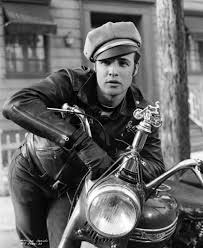
First Rock ‘n’ Roll Record: 1954
Many contenders for the first rock ‘n’ roll record in 1954, according to Dawson and Propes:
- In July 1954 Elvis released his first record, “That’s All Right”/”Blue Moon of Kentucky.” In September he released “Good Rockin’ Tonight”/”I Don’t Care if the Sun Don’t Shine.” Unclear if anyone outside of the South heard these Sun releases.
- “Sh-Boom” entered the Billboard Pop chart in August 1954. The original version by the Chords, the cover version by the Crew Cuts, and the takeoff by Stan Freburg were all listed.
- (“We’re Gonna) Rock Around the Clock” by Bill Haley and His Comets. This song wouldn’t hit the charts until it was used on the soundtrack of the film “Blackboard Jungle.” See 1955 below. Haley’s “Shake, Rattle and Roll” hit the Billboard Chart on August 21, 1954. “Dim Dim the Lights” would hit the Pop chart in November and the R&B chart in January 1955.
- “Riot in Cell Block #9” by the Robins (precursors to the Coasters)
- “Earth Angel (Will You be Mine)” by the Penguins
- “Tweedle Dee” by LaVern Baker and the Gliders
- “Pledging My Love” by Johnny Ace
- “I’ve Got a Woman” by Ray Charles
Key Club Shows: 1954
1954 Shows at the Key Club:
- Five Cats and a Kitten
- “Peewee” Glover, sensational sax player
- Earl Jackson and His Trio, D.P. Black, promoter
- Four Gentlemen of Jest, D.P. Black, promoter
- Oscar Frazier and the Four Notes
- Erice Giere, Stanley Williams on drums, Ira Pettiford
- Hank Hazlett
- Wild Bill Boone
Early Twin City Radio R&B: 1954
Unlike many large metropolitan areas, the Twin Cities did not have a large enough African-American community to support a black radio station until the mid 1960s. But some stations began to take baby steps in airing these kinds of tunes, which, before the term rock ‘n’ roll was coined, was just called the Blues. Possibilities are:
- WLOL’s “Swing Club” program with Bob Bradley.
- Late night request program hosted by “Uncle Merle” (Edwards) on WMIN. David Hersk remembers that Edwards played plenty of rock ‘n’ roll in 1954-55. “I remember recording “Rock Around the Clock” from a WMIN broadcast on my Wilcox Gay recorder. Merle announced me when I called in, and gave me five seconds of dead air to start my home recorder at 78 rpm.” “Rock Around the Clock” was recorded in 1954 and became big news in 1955. Below is not the best picture of Merle but that’s him seated on the left. Others in the photo are Hall Newell, Stuart A. Lindman and Norm Page. Next to Merle are Meg Kingbay and Frank Siefert. Photo dated October 30, 1953, donated by Lindman to the Pavek Museum of Broadcasting.
- Dick Driscoll remembers working at WDGY during those early years and trying to sneak in some hipper tunes, but management was not pleased.
- David Anthony Wacher says “the first station locally was WTCN with a one hour show playing rockabilly/R&B.”
- Available ratings books show that March 1955 was the advent of the “Mr. Rhythm” show on WCOW. The show ran Monday-Friday from 6 or 6:30 pm until the daytime-only station went off the air when the sun went down. During the summer of 1955 it was also on Saturdays, and for a couple of months at 7:30 pm on Sunday. Sam Sherwood explained:
Joe Zingale called himself “Mr. Rhythm.” Here was a country station, WCOW and Saturday Afternoon and Evening, along came Mr. Rhythm and played the real soul of Rhythm ‘n Blues. You can’t imagine how his popularity took off. When he was on the air, there were hundreds and hundreds of people around the radio station just hanging out and listening to the music. Joe then took it a step further and booked the St. Paul Auditorium for a Rhythm ‘n Blues show with great locals such as Augie Garcia. Joe came from Cleveland Ohio and was a time salesman for WCOW and he just got this wild idea about playing that music. It was an overnight smash.”
Joe urged the Tedescos to change the station’s format to all R&B, and they considered it, but since they were only a 1,000 watt daytimer, they figured that a more powerful station would just steal the format and leave them hanging. See more under WCOW in Radio Stations.
Jazz at the Philharmonic: 1954
Jazz at the Philharmonic came to the Minneapolis Auditorium on October 15, 1954. This 14th tour included:
- The Oscar Peterson Trio
- Buddy Rich
- Louis Bellson
- Ella Fitzgerald
Don Leary’s Record Shop Top Hits: 1955
Don Leary’s record shop in Miracle Mile published its 8 Top Hits in the March 28, 1955 issue of the Trib:
- “Mr. Sandman” by the Chordettes, a legitimately original record
- “Naughty Lady of Shady Lane” by Archie Bleyer, originally done by the Mills Brothers and then the Ames Brothers
- “Dim the Lights” by the 4 Top Hatters, which was probably a cover of Bill Haley’s “Dim Dim the Lights (I Want Some Atmosphere),” which was probably a cover by someone else.
- “Sincerely” by the Chordettes, a cover of the McGuire Sisters, which was a cover of the Moonglows (see below)
- “Melody of Love” by Archie Bleyer again. The song hit the charts that year by five different artists, none of which were Mr. Bleyer.
- “Let Me Go Lover” by someone named Mary Del. The song was on the charts by four other singers, most notably Joan Weber who took it to #1.
- “Make Yourself Comfortable” by another unknown, Maddy Russell. Three others actually took this to the charts, most notably Sarah Vaughan.
By the way, Archie Bleyer was the orchestra leader for Arthur Godfrey, who discovered the Chordettes, and they were both on Cadence Records. Not sayin’ Don Leary and Cadence had a thing going. Not sayin’.
Blackboard Jungle: 1955
This seminal film came to Minneapolis’s Gopher Theater on April 27, 1955. It starred Glen Ford as a teacher at an all-male technical high school in New York City. The story was a cautionary tale about juvenile delinquency – to the sound of a drum beat, a crawl read:
We, in the United States, are fortunate to have a school system that is a tribute to our communities and to our faith in American youth.
Today we are concerned with juvenile delinquency — its causes — and its effects. We are especially concerned when this delinquency boils over into our schools.
The scenes and incidents depicted here are fictional.
However, we believe that public awareness is a first step toward a remedy for any problem.
It is in this spirit and with this faith that BLACKBOARD JUNGLE was produced.
Then WHOMP, it goes right into “(We’re Gonna) Rock Around the Clock” by Bill Haley and His Comets over the opening credits and beyond, showing some of the boys dancing to it on the playground. This was the first time many people had heard anything resembling rock ‘n’ roll, and it was a sensation – many folks remember sitting through it again just to hear the song. The movie stayed at the Gopher with an exclusive engagement for two months, then moving down to second and third run theaters. By June 15 the Gopher estimated that 85,769 people had seen it.
The song “(We’re Gonna) Rock Around the Clock” (just billed as “Rock Around the Clock” in the movie credits) hit the Billboard Pop Chart on May 14, 1955 and the R&B chart in June. Haley had 9 songs on the Pop charts in 1954 and ’55. Jim Ramsburg guesses that only Merle Edwards would have played them on his overnight show in 1955.
Although the film supposedly led to violence in other cities, there is no evidence that anything related to the movie happened here. There were two incidents of teen violence in St. Paul on April 27, but the St. Paul Pioneer Press attributed them to a long-running gang feud and a fight between two girls that attracted 300 onlookers. Will Jones of the Trib spoke with Minneapolis Police Captain Clifford G. Bailey, who said that “for every kid in that schoolroom, I’ve known a counterpart in Minneapolis. Fortunately, they haven’t all been in the same room at once.”
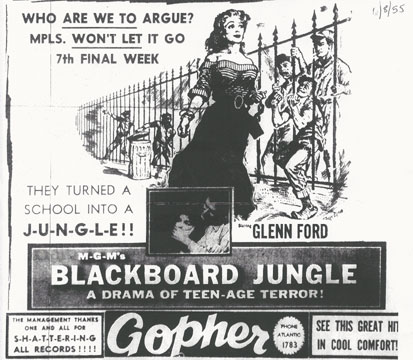
The last day of “Blackboard Jungle” at the Gopher was July 5th. On the 6th there was a “Gala Re-Opening of our Beautiful New Theater,” with the carpet, seats, concession stand, and bathrooms completely redone. How they did that overnight I don’t know. The Grand Opening was broadcast over WTCN radio with appearances by DJs Don Doty, Sev Widman, Larry Fischer, and Jack Thayer.
The movie started up in second run theaters in July and was shown in almost every theater in the Twin Cities eventually. It finally disappeared from the screens in the fall.
Elvis: 1955
Elvis released three records on the Sun label in 1955:
- “You’re a Heartbreaker”/”Milkcow Blues Boogie” (January)
- “Baby Let’s Play House”/”I’m Left, You’re Right, She’s Gone” (April)
- “Mystery Train”/”I Forgot to Remember to Forget” (September)
None made the Billboard Pop charts, although the last two made the Country and Western charts. Elvis signed with RCA Victor in November 1955.
Events: 1955
Lewis Buggs and His Combo, featuring Prince Rogers at the piano for your dancing pleasure, appeared at the Ebony Social Club in the Kistler Building, January 7-9, 1955.
Tiny Bradshaw and His Orchestra appeared at the Ebony Social Club in the Kistler Building, January 28, 1955.
Bud’s Music Center, 820 Excelsior Blvd. in Hopkins, opened in February 1955.
Tex Beneke appeared at the Prom Ballroom on March 23, 1955.
Anita O’Day appeared at the Flame Cafe on Nicollet on March 30, 1955.
An April Echo reported that Bermuda shorts were a big fad for guys. The Trib posed the question “Why do men wear Bermuda shorts on campus?” in a May article. A follow-up in a September Echo said that they were still popular for girls and guys.
And speaking of Bermuda shorts, Augie Garcia’s “Hi Yo Silver” is believed to be the first rock ‘n’ roll record made in Minnesota. Vic Tedesco says it sold 150,000 copies. Click on the link to see much more about the “Godfather of Minnesota Rock.”
Bill Haley’s Comets appeared at the Prom Ballroom on April 6 (teenage only) and April 9 (general public), 1955. This is significant because it was before “Blackboard Jungle” had hit Minneapolis, and there probably weren’t many who knew who he was. In fact, it was “Shake, Rattle and Roll” that was included in the ad, not “Rock Around the Clock.” Also on the bill was Henry Charles and his Orchestra.
A big Easter Cabaret Dance was held at Elks’ Rest on April 10, 1955, featuring Howard Brown’s Band. It was a benefit for the Elks Drum and Bugle Corps.
Dick and Don Maw presented Woody Herman in his first concert in Minneapolis at the Lyceum Theater on April 11, 1955. Also on the bill was Carmen MacRae. Besides promoting jazz concerts, brothers Dick (sax) and Don (drums) also had their own 12 piece band.
The Four Lads appeared at the Prom Ballroom on May 6, 1955.
The Lionel Hampton Orchestra and Revue appeared at the Kato Ballroom on April 13, 1955.
Eddy Arnold and the Jordanaires came to the Minneapolis Auditorium on May 8 and 9, 1955.
Duke Ellington performed at Northrop Auditorium on May 20, 1955. All proceeds went to build a student union on the St. Paul campus.
The Leon Lewis Combo had an extended engagement at Del’s Orchid Club.
Count Basie appeared at the Flame Cafe in Minneapolis on June 7-9, 1955.
Webb Pierce with his Wondering Boys and Red Sovine appeared at the Prom Ballroom on June 18, 1955.
Buddy Rich came to the Minneapolis Flame Cafe from July 13-25, 1955.
Illinois Jacquet “Rhythm & Blues King” and His 7 Piece Band appeared at the Flame in Minneapolis on July 26, 1955.
Ray Anthony and His Chesterfield Orchestra appeared at the Prom Ballroom on July 29, 1955.
The Modern Jazz Quartet appeared in the Walker Art Center Courtyard on August 2, 1955.
The movie “The Wild One” must have been the inspiration for the song “Black Denim Trousers,” written by Jerry Lieber and Mike Stoller and sung by the Cheers, which hit the Billboard pop chart in September 1955. (The Cheers included Bert Convy, later of game show fame). WDGY played a version by someone named Jackie Brooks, and the song was also covered by Vaughn Monroe, of all people, that November. That fall the Echo reported that biker gear was gaining popularity in the high schools.
The Dave Brubeck Quartet featuring Paul Desmond was brought to the Lyceum Theater on October 9, 1955 by Dick and Don Maw.
On October 17, 1955, the St. Paul Dispatch published the Best Selling Pop Records:
- “Yellow Rose of Texas” by Satirist Stan Freberg. Freberg was having fun with rock ‘n’ roll. Back in 1952 he’d done a number on Johnnie Ray’s “Cry,” renamed “Try.” His “Yellow Rose of Texas,” done in a “swing march,” reached #16 on the charts. He would go on to record his versions of “Heartbreak Hotel” and “Hound Dog,” but found that pretty soon rock ‘n’ roll got so goofy that it was hard to make it much goofier. Try satirizing “The Martian Hop.”
- “I Hear You Knockin'” by Gale Storm (original by Smiley Lewis, later done by Fats Domino)
- “Moments to Remember” by the Four Lads
Mantovani and his “New Music” and 45 piece orchestra came to Northrop Auditorium on October 26.
There was still no full time rock ‘n’ roll radio station, but rock ‘n’ roll was in the air. Take for example the Show of Shows! at the Grand Theater in November 1955 (Adults Only). Plus… Home Town Girl featuring Brownskin Models, Peachy Pinups – a Rocking ‘N Rolling Burlesque.
The Four Lads appeared at the Prom Ballroom on November 5, 1955.
Johnny Desmond appeared at the Prom Ballroom on November 11, 1955.
Pee Wee King appeared at the Prom Ballroom on November 24, 1955.
Eddy Howard appeared at the Prom Ballroom on November 25, 1955.
Les Elgart appeared at the Prom Ballroom on December 4, 1955. He also appeared at the Kato Ballroom on December 7.
James Moody and His Orchestra appeared at the Ebony Social Club in the Kistler Building on December 30, 1955.
WDGY: 1955
Meanwhile, WDGY was starting to play covers. In with Perry Como and Doris Day, scripts saved all these years by DJ John Evans include:
- “Sincerely” by the McGuire Sisters (noted as No. 2 in the Twin Cities) in 1955. Out on the East Coast, of course, they were playing the original version by the Moonglows. The Sisters’ version sold six times better.
- One rather funny cover was “Tweedle Dee,” not by Lavern Baker or even Georgia Gibbs, but by someone named Vicky Young.
- The Fontane Sisters, who sang on the Perry Como Show, got hip with the song “Rock Love,” which did not hit the radar when done the year before by Lula Reed.
- June of ’55 brought the “Popcorn Song,” which is pretty good by Cliffie Stone (“Too Pooped to Pop”).
- But what’s this: the ultimate abomination: “Bo Diddley” by the (are you ready?) the Harmonicats! Oy.
- Les Paul did “Sleep,” perhaps the one by Little Willie John, but he’s Les Paul so that’s okay.
- The Four Knights are doing “Glory of Love,” which was best done by the Five Keys in 1951, but the song was written in 1936 so who’s to gripe.
- In July the McGuire Sisters were back with a song just called “Rhythm and Blues.” Somehow the word got out.
- Ray Anthony had one called “Juke Box Special.”
- Even Perry Como rocked with an actually great tune called “Tina Marie.”
- A Sammy Cahn song called “Day by Day” by the Four Freshmen is not exactly even a cover, but a wonderful song and Brian Wilson’s inspiration for the Beach Boys’ harmony.
- Oh, here’s another one: “Drinking Wine Spoli Oli” by the Five Strings. Presumably this is Sid King and the Five Strings, a rockabilly band. Kind of a mild cover of “Drinkin’ Wine Spo-Dee-O-Dee” by Stick McGhee and his Buddies.
- The year closes out with the Fontane Sisters back with “Seventeen,” a pretty good song if done by Boyd Bennett and His Rockets, a rockabilly band.
What Was the First Rock ‘n’ Roll Record: 1955
The 1955 candidates in What Was the First Rock ‘n’ Roll Record? by Jim Dawson and Steve Propes are:
- Chuck Berry’s “Maybelline,” which hit the Billboard Pop and Rhythm & Blues charts in August. The flip side, “Wee Wee Hours,” would make the R&B chart in September. “Thirty Days” would hit the R&B chart in October
- “Bo Diddley” by Bo Diddley
- “Tutti Frutti” by Little Richard
Key Club Shows: 1955
- Boyd Moore Combo featuring Eva Gee, blues and torch singer, fresh from extensive eastern tour
- “Nature Boy” Brown sax and his Harlem Playboys, direct from Chicago
- Horace Henderson, brother of Fletcher Henderson (off an on from 1956 to 1960)
Hennepin County Fair: 1955
Slim Jim and the Westerners were featured at the Hennepin County Fair, held on July 29-31, 1955.
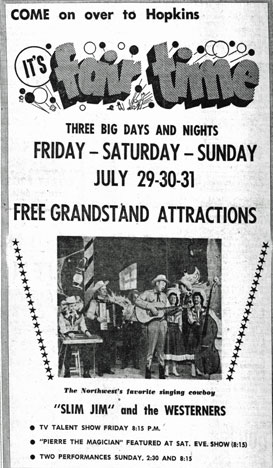
Rock ‘n’ Roll Revue: 1955
On July 29, 1955, the RKO Orpheum offered a special midnight movie, one night only, called “Rock ‘n’ Roll Revue.” The star-studded lineup included:
- Lionel Hampton and His Orchestra
- Joe Turner
- Nat “King” Cole
- Dinah Washington
- Duke Ellington and His Band
- Larry Darnell
- The Clovers
- Ruth Brown
- Delta Rhythm Boys
- Nipsey Russell
- Extra: Willie Mays
- Willie Bryant of the Apollo Theater, emcee
Norman Granz’s Jazz: 1955
Norman Granz’s Jazz at the Philharmonic came to the Minneapolis Auditorium on September 30, 1955. Appearing were:
- Ella Fitzgerald
- The Gene Krupa Quartet
- Dizzy Gillespie
- Buddy Rich
- Oscar Peterson
- Flip Phillips
- Roy Eldridge
- Illinois Jacquet
- Eddie Shu
- Lester Young
St. Louis Park Echo: 1955
A November 1955 list of favorite songs in the St. Louis Park Echo:
- Autumn Leaves
- Moments to Remember
- Love is a Many-Splendored Thing
- Love and Marriage
- Black Denim Trousers
- He
- Yellow Rose of Texas
- Someone You Love
- Bonnie Lassie
- 16 Tons
Still no real rock ‘n’ roll at dear old Park High.
Rebel Without a Cause: 1955
The film “Rebel Without a Cause” starring James Dean as a disaffected teen opened in Minneapolis at the RKO Orpheum Theater on November 23, 1955. It moved to the RKO Pan on December 30, 1955 and continued in second run theaters well into 1956. Perhaps a follow-up to this excellent film was the not-so-excellent “Teenage Crime Wave,” which opened at the Lyric Theater on December 7. Other great film names were “Lawless Street,” “Running Wild” and “Juke Box Gangs.”
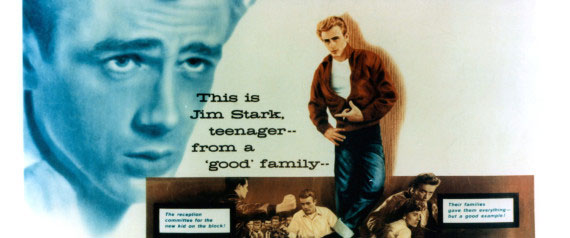
WDGY and The Advent of Top 40: 1956
Before WDGY went to real rock ‘n’ roll, it still had some covers and pretenders to play:
- What is “A Teen Age Prayer” by Robbin Hood (and then Kitty White)?
- “Rock and Roll Waltz” by Kay Starr – ’nuff said.
- “Dungaree Doll” by Eddie Fisher is actually pretty good.
- “Sixteen Tons” by Tennessee Ernie Ford was popular with everyone.
- “Band of Gold” by Don Cherry crossed over, as did
- “No, Not Much” by the Four Lads.
- “The Great Pretender” shows up by Jackie Riggs instead of the innocuous Platters – c’mon!
- Oh, and in February we first see Pat Boone, doing the El Dorados’ “At My Front Door.”
- And one of my all-time favorites, “Lipstick, Candy and Rubbersole Shoes” by Julius LaRosa. Fabulous.
And that’s what they played on WDGY on February 5, 1956.
Then on February 6, 1956, WDGY became Minnesota’s first Top 40 radio station when it was purchased by Todd Storz. Former KSTP utility man Herb Oscar Anderson hit the ground running and WDGY caught on fast, going from a station with not much identity and a 4 share to a rock ‘n’ roll monster with a 20 share, second only to monolith WCCO. For much more on the advent of rock ‘n’ roll radio in the Twin Cities, see the WDGY section in Rock ‘n’ Roll Radio Stations.
Caveat: Although WDGY became synonymous with the term rock ‘n’ roll, ‘DGY DJ Jim Ramsburg reports that “Storz had a hard and fast rule that we were not to use the term rock and roll – ever.” The station eased into it, playing Elvis Presley, naturally, but also many songs that mom and pop might like to hear. It also played a lot of Pat Boone-like covers of real Rhythm & Blues songs, at least at first.
The genesis of Top 40 is full of apocrypha. Many stations had already had “Top 10” shows – An item from February 23, 1956, comments on the “Top 10 fad.” One account of how the number 40 came to be was that when Storz bought his station in New Orleans in 1953, a competing station had a Top 20 show where the counted down the records for an hour every evening, so Todd Storz figured if 20 was good, 40 was better. Ramsburg says that the number 40 was chosen because that’s how many songs (with commercials) that could be played in three hours. Ramsburg remembers that the Number 1 song had to be played every hour, but the rest were up to the DJs. He remembers being particularly sick of “The Wayward Wind.” Here in the Twin Cities, although the concept was not entirely new, it was new as a concept for an entire station’s programming.
An article from March 20 in Variety gives the down side:
As far as most of the stations is concerned, here’s the rub: They’re confining themselves almost entirely, if not entirely, to disk jockey shows and the same leading pop tune recordings are played innumerable times during the course of 24 or fewer hours, let alone a week.
There just aren’t enough new top pop recordings hitting the market, of course, to permit sufficient musical variety. and station operators are keeping their fingers crossed and hoping that their dialers won’t be driven insane listening to the same tunes almost interminably. They concede that “listeners probably are paying a high price for the possibility of getting money for nothing by having their lobar extremities assailed by the same song over and over.”
Rock Around the Clock Film: 1956
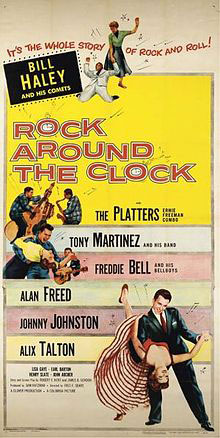 The film “Rock Around the Clock” premiered at the Gopher Theater in downtown Minneapolis (619 Hennepin Ave.) on March 23, 1956. It was advertised as “The screen’s first great rock ‘n’ roll feature!” “Here’s the jet-rhythm-and-romance story that you’ll dig with delight! The Rock ‘n’ Roll songs-and-dances that are rocking the nation!” Alan Freed presented:
The film “Rock Around the Clock” premiered at the Gopher Theater in downtown Minneapolis (619 Hennepin Ave.) on March 23, 1956. It was advertised as “The screen’s first great rock ‘n’ roll feature!” “Here’s the jet-rhythm-and-romance story that you’ll dig with delight! The Rock ‘n’ Roll songs-and-dances that are rocking the nation!” Alan Freed presented:
- Bill Haley and His Comets
- The Platters
- Ernie Freeman Combo
- Tony Martinez and His Band
- Freddie Bell and His Bellboys
Kevin Carlson found these photos in the Motion Picture Herald issue dated April 28, 1956.
Caption: “Vern Hutsinger, manager of the Gopher theatre, in Minneapolis, turned in the best action pictures of his “Rock Around the Clock” promotion – which, incidentally, swept the country, with “Rock ‘n’ Roll” addicts doing teen-age tailspins, and liking it.
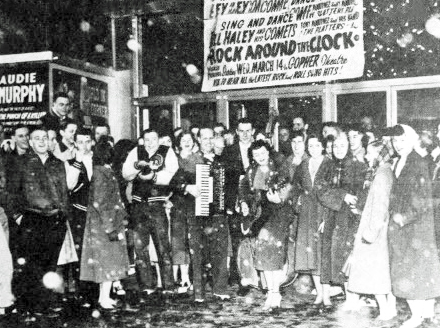
In the first picture above, they’ve gathered in front of the theatre – and those big blobs that look like golf balls are really snow flakes, as caught by the camera in Minnesota.
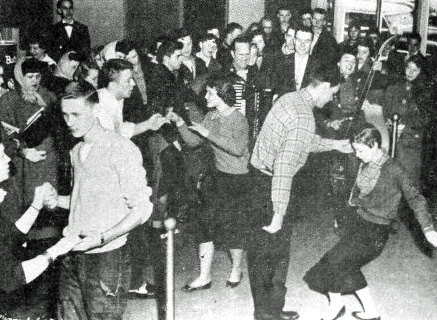
[Above], the same youngsters are dancing in the theatre lobby – and they not only would but could, dance indefinitely to such swing music. High school student councils and newspapers editors were appreciative of the harmless quality of this youthful exuberance, as natural publicity for a motion picture. We’ll see you later, alligator! After a while, crocodile!
RIOT IN HOPKINS
On June 18, 1956, Time Magazine reported that “In Minneapolis a theater manager withdrew a film featuring the music after a gang of youngsters left the theater, snake-danced around town and smashed windows.”
After months of searching, (this was in the days before the searchable database) I found an article in the Minneapolis Star about this so-called riot. Ironically, it was in the Star (April 25, 1956), which hated rock ‘n’ roll and didn’t even advertise the movie. Turns out, the incident happened in Hopkins, a western suburb of Minneapolis. I was so excited to finally find it that you’ll have to indulge me if I reprint the entire article:
Teen-agers Rock ‘n’ Roll Into Trouble
Hopkins police were attempting to pin down blame for an outbreak of “rock ‘n’ roll” vandalism in the suburb.
Windows were broken in a greenhouse and the junior high school, fences were uprooted, doorbells run and garbage cans kicked over in an outbreak of teen-age violence following a movie.
The cause of it all, according to Hopkins police superintendent Howard Puck, was a “rock ‘n’ roll” movie, “Rock Around the Clock,” the weather (54 degrees) and, generally, spring.
The disturbance began in the Hopkins theater, Puck said, where the group of boys and girls, aged 16 to 18, were “carried way” (he meant “sent”) by the violent rhythms of Bill Haley and His Comets.
They left the theater after the first show and started a “snake dance” under the bright lights of Hopkins’ “White Way,” Excelsior Avenue.
They walked five or six abreast down the sidewalks, clearing the way until police were called out. Puck said the celebrators numbered around 30 or 40 at times ass they gathered reinforcements.
Police forced them to “break it up,” and they dispersed into smaller groups.
Norman Gustafson, 14 Sixteenth Ave. No., florist, heard them coming down the alley near his greenhouse at Sixteenth and Excelsior, “raising the dickins” with garbage cans.
“They were singing a ‘rock ‘n’ roll’ song,” said Gustafson today, “so they started rolling a few rocks at my greenhouses. Around 20 windows were broken.”
Singing the rocking music, some of the teen-agers made for the junior high school, also on Excelsior Avenue, “rolled” more rocks at windows in the building and uprooted fences on the school grounds.
Puck said some of the celebrators were apprehended, placed on individual reports and their parents were notified.
“We’re working on it yet,” the suburban chief said, “talking to eight or 10 of those who took part. It’s difficult to find out who actually caused the property damage, however.”
Puck said the city’s teen-agers have no place to eat, get a Coke, or congregate for all nights. Youth activities are scheduled several nights a week, he said, but there is no place for kids to gather on other evenings.
“I’ve been talking to civic groups,” he said, “telling them about the problem. The main problem is kids coming in from other suburban areas because of our central location.”
“Other suburban areas” meaning St. Louis Park, my hometown, no doubt!
The film was gone from the area by the end of May. I did ask WDGY DJs Bill Diehl and Bill Armstrong if they remembered anything about this incident, and they didn’t at all.
Second Annual State Basketball Tournament Dance: 1956
Dick and Don Maw organized the Second Annual State Basketball Tournament Dance at the Minneapolis Armory, March 23 and 24, 1956. Entertainment was the Maws’ own 12 piece band with vocalist Geordie Hormel, Zephyr Records recording star (and according to this web site, its president). In attendance were disk jockeys:
- Al Paulson, WTCN
- Don Kelly, WMIN
- Dan Anderson, WLOL
- Don Doty, WTCN
dee jay Magazine: 1956
Vol. 1, No. 1 of dee jay Magazine came out in April 1956. Right off the bat, there is an editorial about how records should be kept to 2:20 or less. Reasons are vague: “If variety is the spice of life it is also the lifeblood of radio and television. Records with a running time of three minutes or more do not contribute to the best in effective programming. Although the length of time may be no criterion as to whether it will reach hit status, we think that 2:30 is the limit to which the disk jockey should be reasonably expected to publicize a records.” The recommendation was that records to be played on the radio and jukeboxes should be subject to an industry-wide standard – records for “consumer” use could be whatever the “diskery” chose. Read into that what you will. Disk Jockeys will tell you how grateful they are when Marty Robbins released the four+ minute “El Paso” so they could go to the bathroom.
dee jay Magazine also gave record recommendations, in the categories of:
- Popular – Georgia Gibbs singing “rock ‘n roll,” Patti Page bowing to the r&b trend, and all the other usual suspects except maybe “Rock Island Line” by Lonnie Donnegan and “Long Tall Sally” by Pat Boone
- Rhythm and Blues – Lavern Baker, the Robins, Ray Charles, The Platters, Chuck Berry, Little Richard, The Coasters, Little Walter, B.B. King
- Country and Western – Elvis is on this chart, along with early Jerry Reed, Chet Atkins, Webb Pierce, Carl Smith, Marty Robbins and Kitty Wells
- Jazz. This one’s funny. A Hollywood DJ advises “If you don’t know music, stick to the top ten.” “If you’re just starting a jazz show, don’t make the common mistake of going ‘Way Out’ with the wild stuff. This is often caused by over enthusiasm and the desire to please your listeners….Balance your show with good commercial sides by Sinatra, the Hi-Los’s, Carmen McRae, etc. Don’t play anything you don’t understand, and most important, I think, is some actual knowledge of music. If you don’t have it, stick with the ‘Top Ten’ and don’t try to play jazz.”
Elvis Brings His Pelvis: 1956
On May 13, 1956, Elvis performed two shows in the Cities. The ad promised singers, dancers, and comedians as well. Bill Diehl reports that the 2:00 show at the St. Paul Auditorium drew only 800 fans, and the 8:00 show at the Minneapolis Auditorium drew a paltry 1,300. Mothers Day and tornado warnings kept the crowds away, and local booking agent T.B. Skarning lost his shirt. Elvis gashed his head with a broken guitar string at the St. Paul show, and Colonel Parker yanked opening act Augie Garcia early, afraid he was stealing the show. For much more, including photos, see Elvis in the Twin Cities.
Favorite Songs: 1956
The May 16, 1956, St. Louis Park Echo proclaimed “Elvis Presley Hits Top.” “With spring’s arrival, new record releases appeal to the ‘be-bop glasses and blue suede shoes’ set.” “New records will please the lover of ballads or blues, vocal harmony or instrumentals.” Favorite songs listed were:
- “Strange Love” by the Native Boys (with a South African influence) (an obscure but nice choice)
- “Mr. Wonderful” by Teddi King
- “Joey Joey Joey” by Billy Eckstine
- “Roving Gambler” by Tennessee Ernie Ford
- “Rock Island Line” by Lonnie Donnegan
- “Standing on the Corner” by the Four Lads – enthusiastically nominated for the theme of Steve Cannon’s Girl-Watchers’ Club.
Easy listening/instrumental favorites were “Midnight Blues” by Nelson Riddle and “Port au Prince.”
Another, slightly hipper list came out of Burk’s Music Shops, 6th and Wabasha and 7th and Robert in St. Paul:
- I Want You, I Need You, I Love You by Elvis
- The Wayward Wind by Gogi Grant
- Moonglow and Theme from “Picnic” by Morris Stoloff, George Cates, and the McGuire Sisters (it was common for several artists to record a popular song and fight it out on the charts)
- My Prayer by the Platters and the Ink Spots
- I Almost Lost My Mind by Pat Boone
- I’m In Love Again by Fats Domino and the Fontane Sisters
- Be-Bop-A-Lula by Gene Vincent
- Whatever Will Be, Will Be by Doris Day
- Standing on the Corner by the Four Lads, Dean Martin, the Mills Brothers
- Glendora by Perry Como
- On the Street Where you Live by Vic Damone, Eddie Fisher, Francis Wayne, and Lawrence Welk
- Allegheny Moon by Patti Page and Billy Regis
- More by Perry Como (flip of Glendora)
- Transfusion by Nervous Norvus
Liberace: 1956
Liberace rolled into town on May 26-27, 1956. The flier below is from a previous appearance, since he looks very young and it assumed people didn’t know how to pronounce his name. But by 1956 he was a phenomenon, and the little old ladies just loved him!
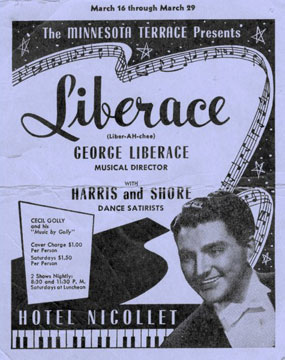
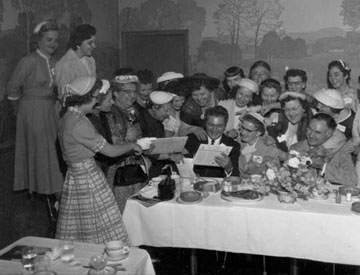
Above and below: Minnesota Historical Society
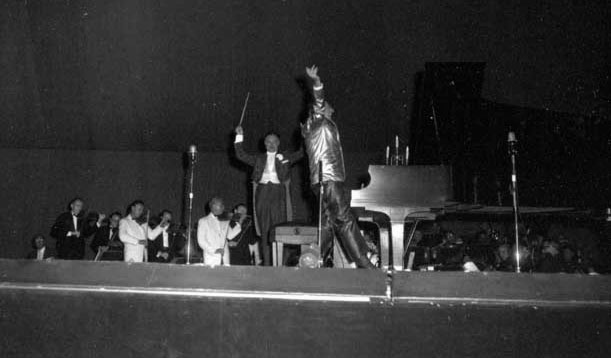
Rhythm and Blues Revue: 1956
The Minneapolis Spokesman advertised a “Rhythm and Blues Revue” film to be shown one time only at midnight at the RKO Orpheum on June 29, 1956. This may have been derived from the “Rock ‘n’ Roll Revue” that was shown on July 29, 1955. The ad blasted “Rock ‘n’ Roll with this sensational screen show! Nation’s Top Sepia Stars!” The lineup was impressive:
- Nat “King” Cole
- Joe Turner
- Ruth Brown
- Cab Calloway
- Count Basie
- Sarah Vaughan
- Lionel Hampton
- Amos Milburn
- Delta Rhythm Boys
- Mantan Moreland & Nipsey Russell
- The Larks – Freddy & Flo Robinson
- Paul “Hucklebuck” Williams and his Orchestra
- Willie Bryant of the Apollo Theater, emcee
Events: 1956
The Goodfellows Club held a New Year’s Dawn dance at 2 am on January 1, 1956, at Eaton’s Ranch, featuring C.V. Williams and the House Rockers with Dickie Mayes and Maurice Tally.
The Four Freshmen performed on January 7, 1956, at the Prom Ballroom.
Phil Silvers and Patti Page were the entertainers at the Auto Show at the Minneapolis Auditorium, January 8-14, 1956.
In January 1956, the St. Louis Park student combo the Blue Flames entertained at the “Jump Ball” sponsored by Amica Tri. Members were:
- John Duck – clarinet
- Alan Gelhar – cornet
- Chuck Heinecke – tenor sax
- John Lindahl – drums
- Jim Elsness – piano
Danny Overbea and His Orchestra appeared at the Ebony Social Club on January 20, 1956.
The Modern Jazz Quartet, Chris Connors, and Herbie Mann appeared at the Lyceum Theater on January 29, 1956, promoted by Dick and Don Maw.
A Gala Shrine Frolic with Preston Love and His Orchestra (“The Happy Boy With the Horn”), appeared at the Marigold Ballroom on January 30, 1956.
The Hank Hazlett Trio was featured at the Key Club on January 30, 1956.
Sonny “Long Gone” Thompson and his Orchestra appeared at the Ebony Social Club on February 16, 1956.
Pre-Teen dances were held at the St. Louis Park Community Center on Lake Street every Friday. A February 19, 1956, issue of the Minneapolis Sunday Tribune pictured Marge Primus and Kenneth Baker, both 10, trying out a new step.
Hot rods were spotted in the St. Louis Park High parking lot in 1956 – Jay Sargent got 12 people in his 1936 Ford.
The Flame Cafe on Nicollet Ave. went all-country in February 1956.
The Minneapolis Star, which hated rock ‘n’ roll, quoted Dr. Francis J. Braceland of the “Institute of Living” in Hartford, Connecticut as saying that it was a “cannibalistic and tribalistic” form of music. Now that wasn’t racist, was it?
Del’s Orchid Club featured Joe Williams and Hank Hazlett.
The Builders Show took place at the Minneapolis Auditorium on March 10-18, 1956. Entertainment was provided by the folks of the WLS Barn Dance, including Homer and Jethro.
Eddie “Cleanhead” Vinson, orchestra leader and saxophone player, began a stint at the Key Club starting March 19, 1956. “This fabulous orchestra will set a policy of ‘better’ entertainment at the Key Club. Music as you like it plus exotic dancing.” With the new policy came a 50 cent admission fee on the weekends.
Rock ‘n’ roll had taken over the culture in early 1956. An Oldsmobile ad says “Make a Date with the Newest Rocket 8! Come in an Rocket ‘Round the Block! (or ’round the town if you like!). Meanwhile, a Dayton’s ad starts, “Here’s the style, Crocodile! Snappy Rock ‘n’ Roll sport shirt. You’ll be in fashion’s swing (or any other tempo!) with a new Rock ‘n’ Roll shirt… Striped denim hats with wire brims that twist into any shape… Ivy League chino pants with the new trim look, strap in back [back buckle].”
Here’s the Star again, reporting a disturbance in Eau Claire, Wisconsin, where kids actually danced in the aisles at a show where records and a movie were played. Police were able to restore order, thankfully, and make those darn kids sit down. This was on the front page, August 6, 1956.
Peggy Lee did two shows daily at the Industry on Parade Show at the Minneapolis Auditorium on April 11-15, 1956.
Chuck Berry and his orchestra appeared at Norway Hall on April 13, 1956, promoted by D.P. Black.
Starting April 16, 1956, Jimmy Witherspoon, blues singer; Betty DeQuincy, dancing entertainer fresh from Detroit; and Stomp Gordon and His Combo began entertaining at the Key Club. Starting April 16, 1956, Jimmy Witherspoon, blues singer; Betty DeQuincy, dancing entertainer fresh from Detroit; and Stomp Gordon and His Combo began entertaining at the Key Club.
Count Basie also appeared on May 13, 1956, at the Minneapolis Armory, a Dick and Don Maw production. Basie’s 17 piece band featured Joe “Every Day” Williams, Downbeat’s #1 Blues vocalist. Also appearing was “Zephyr Records‘ exciting new modern jazz group” the Bob David Quartet.
The Key Club featured Duke Groaner and His Combo plus Audrie DeYoung, exotic dancer, on May 14, 1956.
Yogi Yorgesson, nee Harry Stewart, was killed in a car crash in May 1956. He made records such as “I Yust Go Nuts at Christmas” in a Minnesota-Swedish dialect, but according to Will Jones in 1950, it didn’t go over too well here in Minnesota, where he was not from and spent very little time. One of his songs was “My Little Old Shack in Minneapolis, Minnesota,” a parody of “My Little Grass Shack In Kealakekue, Hawaii.” And in case you’re wondering, it was Stan Boreson, not Yogi, who did “Walking in my Winter Underwear,” so brilliantly interpreted by Casey Jones.
On May 24, 1956, Woody Herman and the Third Herd played for the Marigold Ballroom’s 40th Anniversary, the first name band to play there since Paul Whiteman 26 years ago.
A picnic at Libby’s Pavilion (Bass Lake) was advertised in the Spokesman for May 27, 1956. Music was provided by the Rock and Roll All Stars, featuring Maurice Talley, vocalist.
At the Key Club in May-June 1956, we see Bob Wilson and His Combo plus Black Velvet, interpretive and exotic dancer.
Louis Armstrong and His All Stars appeared at the St. Paul Auditorium on June 5, 1956, a Dick and Don Maw production.
On June 18, 1956, the Minneapolis Tribune published a photo of Carlotta Carly and John Wade “Dancing the Bop” at a dance at the Phyllis Wheatley House to the music of (S. Stanley) Berry and His Barons. Very cool.
At the Key Club you could see Tiny Davis and Her Hell Divers, June 25, 1956.
Little Richard and His Orchestra appeared for a dance at the Junior Pioneer Hall in St. Paul on June 26, 1956.
A note from July 1956 says that Dick and Don Maw and their Orchestra with WTCN “will turn Park Plaza Hotel Ballroom into a teenage club” complete with teenage chorus girls and Geordie Hormel as the featured artist. Not sure where that was or if it really happened.
Jerry Reed, “new country-western star of Capitol records, will be guest artist at the Flame Cafe this week (July 17 – 20, 1956). A singer and entertainer, he is also a composer, and writer of his two latest hits, “Mister Whiz” and “When I Found You.”
Camille Howard, song stylist and pianist; Larry Rice and Combo; and comedian Mickey Martin, emcee were performing at the Key Club on July 23, 1956.
Performing at the Key Club in August 1956 were Billy Brooks and Piney Brown, song stylists and Jimmy Binley Combo.
Hank Thompson appeared at the Marigold Ballroom on August 13, 1956.
At the Flame Cafe September 12-15, 1956, was Kenny Roberts, a yodeler whose favorite trick was leaping into the air while playing guitar and harmonica at the same time, giving him the nickname “The Jumping Cowboy.”
On September 26, 1956, the 100 Twin Drive In presented “One-Way Ticket to Hell,” which had something to do with “Teen-Age Madness” and “Understanding Today’s Children.” The ad is pretty bare-bones but the description on IMDB is pretty spicy.
In an interview in the Minneapolis Tribune, Fats Domino says that it’s not the music that causes teenagers to riot, but beer.
The White House in Golden Valley instituted a new policy of engaging name acts such as Hadda Brooks, and insisted that patrons listen to the entertainment and curtail the fights, according to Will Jones of the Trib.
The Bamboo Room hosted Connie Newman and His Famous Trio on October 5, 1956.
Entertainers at the Key Club on October 5, 1956, were Larry Wrice and His Chicago All Stars; Florence Devereaux, song stylist; and Tequila, exotic dancer.
The Dave Brubeck Quartet with Paul Desmond performed at the Lyceum Theater on October 21, 1956, promoted by Dick and Don Maw.
At the Heights Theater, the first 500 adults or juniors received 8×10 Fan Photos of Elvis. The movie wasn’t even an Elvis film, but the jungle adventure “Run for the Sun.” Meanwhile, there were 32,000 pre-orders of Elvis’ next release, and nobody even knew what it was.
WDGY Disk Jockey Herb Oscar Anderson was interviewed in the St. Louis Park Echo on October 24, 1956. “Andy””s familiar greeting was “Hi ya gang, it’s a lovely day today.” Anderson worked at KSTP before coming to WDGY. He said that WDGY’s Top 40 lists were more in tune with actual popularity, since they were based not just on record sales but juke box plays and requests from various establishments including hotels and night clubs. His favorite pop singers were Elvis, Eddie Fisher, and Fats Domino. He, his wife Terry, and son Johnny were new residents in the Park.
In October and November, 1956, you could see Miss Wiggles, sensational exotic dancer, aka, “The Upside Down Girl,” at the Key Club.
The Alvin Burlesk Theater was getting into the rock ‘n’ roll business in ’56, if in name only. An ad dated November 7 touted two big shows on one stage with a cast of 40. One was the Black and White Revue, with “Miss Japan” Tura Satana, later known for her role in Russ Meyer’s 1965 film “Faster Pussycat! Kill Kill!” The other show was billed as the “Rock ‘n’ Roll Show of ’56,” featuring the 5 Shepards (Recording Stars), Jack Turner (Mr. Mimic), Geo. Williams (Feature Comic), Tinny Kennedy (The Sepia Elvis Presley), Tommy Badger (And His Comets), Exotic Nadza and “6 Delovies – 6.” I’d a given anything to see this show!
Teenage movies came pouring from the theaters. On November 8, “Teenage Rebel” came out at the State Theater, starring Ginger Rogers and Michael Rennie. They weren’t the teenagers – they were Betty Lou Keim and Warren Berlinger. “Hear! The Top Hit Song! ‘Cool it Baby!'”
The Bamboo Room featured Twin Cities jazz veteran Hank Hazlett “and his famous trio” starting November 8, 1956, followed by Oscar Frazier and his Combo.
On November 15, 1956, the Lyric Theater presented a “Twin Bop Rock ‘n’ Sock Show!” First feature was “Shake, Rattle and Rock!”, a story of Rock ‘n’ Roll vs. The “Squares” and featuring music by Fats Domino, Joe Turner, Choker Campbell and his band, Tommy Charles, and Annita Ray. Fats’s newest Imperial recording was given away to the first 100 Junior and Adult Patrons. The second feature was “Runaway Daughters,” where you could SEE: “Teenage Girls on a Speed-Crazy Thrill Hunt! Why Parents are to Blame for Delinquent Daughters! The Teenagers Side of the Rock ‘n’ Roll Question!”
Elvis’s first movie, “Love Me Tender,” opened on November 21, 1956, at the RKO Orpheum. “He’s a fightin’ man! He’s a singin’ man! He’s a lovin’ man!” Will Jones of the Trib reported that policemen were on hand in case of trouble but there was none to be had, at least during the early show. A male heckler was met with “Shut up!” by the girls, who sobbed as Elvis’s character was shot in the end.
Rudy Hunter and the Fabulous Tones (from Hollywood), were at the Key Club on November 29, 1956.
One of the greatest rock ‘n’ roll movies of all time is “The Girl Can’t Help It,” which came to the Wabasha Paramount at the end of December 1956. The film starred Tom Ewell and Jayne Mansfield, but featured performances by Julie London, Ray Anthony, Fats Domino, the Platters, Little Richard, Gene Vincent, the Treniers, Eddie Fontaine, the Chuckles, Abbey Lincoln, Johnny Olenn, Nino Temple, and oh, by the way in the corner of the ad, Eddie Cochran. “Rock yourself into your happiest time.” On the other end of the spectrum was the juvenile delinquency flick “One Way Ticket to Hell.” Very dire indeed. Not to mention “Hot Rod Girl” and “Girls in Prison.”
The Four Coins appeared at the Radisson Flame Room on December 6, 1956.
The Dozier Boys, Fresh from Chicago, graced the stage at the Key Club on December 15, 1956. Chubby Newsom, vocalist from Detroit, joined them on December 21, 1956.
The 1956 Contest Craze
To call attention to its new identity, on its first day as the new Top 40 station, WDGY kicked off a cash giveaway contest craze that would involve almost every other station and force hopeful listeners to buy lots of portable radios. Read about this short-lived but crazy phenomenon Here.
Oscar Socks: 1956
The new St. Louis Park Senior High School opened in the fall of 1956. Things got off to a rough start, as the Minneapolis Star reported:
It all started…when an early-morning disk jockey [WDGY’s Herb Oscar Anderson] plugging “Oscar Socks” urged students to don knee-highs of one design left leg, contrasting design right leg. Girls responded in droves…But Principal Edward Foltmer…suppressed the fad promptly. “We’d be opposed to any distracting influence at school,” he explained with a cautious smile. “We can’t allow bizarre clothing.” A bag lunch protest last Friday, with many girls wearing black and spurning the school’s hot lunch, followed. Boys at St. Louis Park High came to the girls’ rescue. “The boys wore their shirt tails out in protest after we weren’t allowed to wear Oscar Socks,” student Elaine Smedberg said. “But the administration made ‘em pull the shirt tails in. So the boys hiked up their pants, wore them around their ribs. Then a week ago, about 15 boys peroxided their hair.” Next morning, “the kids hissed the principal and started singing ‘Chain Gang’ in school,” other girls reported.
The School’s student council came to the rescue and calmed the situation down. The PTA put a teenage dress code on its next agenda. Oh, and it wasn’t Sam Cooke’s “Chain Gang;” in 1956 there was another song with that name, with two versions on the charts by Bobby Scott and Len Dresslar. Oddly (or not so oddly), the Park High Echo did not report on the incident.
Pop Concert Committee: 1956
This is hilarious. The Minnesota Historical Society labels this photo, Pop Concert Committee, 1956. Don’t these guys look like they could really shake ’em down? For the record, their names are Edward Andrew Furni, Jay Laramy, Theo Maier, and Edward P. Ringius. I’m sure they did a great job!
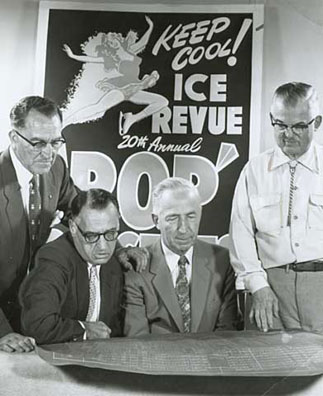
WLOL: 1956
On July 31, 1956, Will Jones of the Trib reported that Leigh Kamman at WLOL was playing
Teresa Brewer’s recording of “Sweet, Old-Fashioned Girl” in which she kids the bejeebers out of rock and roll. Second up was “A Teen-Ager Sings the Blues” in which a young girl gets very torchy over a soda. Suggested sequel “Banana Split for One, Please, James.” Steve Cannon’s pick for new hit of the week is something called “I’m in Love with Elvis Presley” sung by someone named Virginia Lowe.
WMIN: 1956
Although WMIN’s Merle Edward had been playing some rhythm ‘n’ blues back in 1955, and 1958 hit lists show that they were playing rock ‘n’ roll then, apparently they were bucking the trend at least for a little while as evidenced by this September 28, 1956 Will Jones item in the Trib:
Had a talk with Alice Presley, the new disk jockey on WMIN, the anti-Presley station. She plays old Goodman records and what she calls “the better hit parade things. Young citizens come around and ask how she’s related to Elvis Presley. Her stock answer: “I’m sorry, but my agent doesn’t permit me to discuss my relationship with Elvis.”
She says there is now an Alice Presley fan club. Her original contract was for the month of September, and now she’s sweating out a renewal for October. She really can’t talk much about being a kin of Elvis, because her real name is Doris Hoffman, and she spends her days working for an advertising agency. Her explanation of the inspiration behind her radio name: “Anything for a buck.”
Perhaps this was the station that Larry Lehmer was referring to in his book The Day the Music Died: “When Minneapolis radio station WSPT [?] banned Elvis Presley records later that year, the station received several threatening phone calls. A rock was thrown through the station window with a note saying: ‘I am a teenager – you play Elvis Presley or else we tear up this town.'” WSPT is licensed to Steven’s Point, Wisconsin and was never a Minneapolis station, so this story needs some clarification.
Jazz at the Philharmonic: 1956
Norman Granz’s Jazz at the Philharmonic appeared at the Minneapolis Auditorium on Friday, September 28, 1956, featuring:
- Ella Fitzgerald
- Gene Krupa Quartete
- Modern Jazz Quartet
- Oscar Peterson Trio
- Jo Jones
- Stan Getz
- Dizzy Gillespie
- Roy Eldridge
- Illinois Jacquet
- Flip Phillips
- Sonny Stitt
- Eddie Shu
- John Lewis
- Milt Jackson
The Biggest In-Person Show of ’56′
“The Biggest In-Person Show of ’56” came to the Minneapolis Auditorium on Wednesday, November 21, 1956, featuring:
- Bill Haley and the Comets
- The Platters
- Clyde McPhatter
- Frankie Lymon and the Teenagers
- The Clovers
- Chuck Berry
- Ella Johnson
- Shirley & Lee
- Buddy Johnson and His BIG Orchestra
- The Flairs
- Shirley Gunter
Rock Rock Rock: 1957
On January 17, 1957, Alan Freed’s movie “Rock Rock Rock” appeared at the Tower Theater in St. Paul. The movie introduced Tuesday Weld, and included performances by:
- The Moonglows
- The Flamingos
- Chuck Berry
- Laverne Baker
- Frankie Lymon and the Teenagers
- Jimmy Cavallo and his House Rockers
- The Three Chuckles
- Connie Francis
- Cirino and the Bowties
- Johnny Burnette Trio
Rock, Pretty Baby! Film: 1957
The film “Rock, Pretty Baby!” opened on January 16 at the RKO Orpheum in Minneapolis, promising “The Whole Wonderful Story of Today’s Rock-And-Roll Generation! … told the way they want it told!” Featuring 12 “wonderful” tunes, the film starred Sal Mineo, John Saxon, and included Fay Wray and Rod McKuen! (Did you know that McKuen was the beatnik in the 1959 novelty song “The Mummy” by Bob McFadden and Dor (Rod spelled backwards)?)
Jimmy Rogers: 1957
Jimmy Rogers was a “Marathon Drummer” who could play for 80 hours straight, supposedly. He began an extended appearance at the Key Club on January 17, 1957, with different singers and exotic dancers appearing with him through February.
RCA-Victor: 1957
On January 19, 1957, RCA-Victor sent a trainload of its top talent to the Cities as part of its national tour on behalf of the March of Dimes. Once they arrived, they split up to make appearances at many venues around town, including
- All of the TV and radio stations
- A party for record dealers
- The Sister Kenney Institute; the patients were doing so well that only nine were at the hospital that weekend.
- Dayton’s Tea Room; Mary Mc Elmurry remembers, “My mom took me to see Julius La Rosa on the 12th floor. She made me turn my Elvis purse around so no one could see it. Sure wish I still had that purse. It could be worth some bucks!”
- The Prom Ballroom at 9 pm.
Mickey and Sylvia seem to be the only rock ‘n’ roll singers on the list, but there were some some near misses, including Eddie Fisher, Lou Monte, and the Browns.
Modern Jazz for 57” Show: 1957
Dick and Don Maw brought in a “Modern Jazz for 57” show to the Minneapolis Auditorium on January 20, 1957. On the bill were:
- Chet Baker Quintet
- Chris Connor
- Art Blakey and His Jazz Masters
- Herbie Mann
- Ralph Sharon
- Bob Davis Quartet
Birdland Stars of ’57 Show: 1957
The “Birdland Stars of ’57” show was came to the Minneapolis Auditorium on May 25. Performers on the tour were:
- Billy Eckstine
- Sarah Vaughan
- Count Basie and His Orchestra featuring Joe Williams
- Jeri Southern
- Bud Powell Trio
- Chet Baker
- Lester Young
- Zoot Sims
Events: 1957
At the Boulevard Beauty Shop at Minnetonka Blvd. and Dakota Ave. in St. Louis Park, one could get an “Elvis Presley Haircut” for a mere $1.50. Described as “carefree, short, and brief – just like you. See it in Life Magazine.”
Johnny Cash was in town on April 20, 1957, for a “Private Function,” according to people who keep track of that sort of thing.
Decca recording artist and pianist Horace Henderson (brother of Fletcher Henderson) and His Rock ‘n’ Roll Combo began an extended appearance as the house band at the Key Club in March 1957. “Big Floor Show.. With Plenty of Sock.” Other entertainers appearing at this time included comedy team Butterbeans and Susie (a/k/a Jodie and Susie Edwards). Henderson would appear at the Key Club off and on until 1960.
The Minneapolis NAACP Youth Council Dress Up Dance was held at the Calhoun Beach Hotel on May 29. Entertainment was by the Big “M” Sextet and the Squires. Wonder if this is the group that became known as the Big M’s and made some recordings at Gaity Records in 1959. They were a black group with a white guitarist.
Pat Boone, the Four Lads, and the Fontaine Sisters were in town in June 1957.
On June 2, 1957, the Will Mastin Trio, starring Sammy Davis, Jr., appeared at the Lyceum Theater. Six other performers were on the bill.
Bermuda shorts were still all the rage for guys, advertised at Fantle Bros./Cook’s at Miracle Mile in St. Louis Park in June 1957 for $7.95.
From June to August 1957 the headliner at the Key Club was Rose Mary Gaiters, a singer “Second only to Ruth Brown,” with the Duke Groner Combo and a rotation of exotic dancers (one billed as a “variety girl.”)
Deane Wenger of 1409 Kentucky Ave. in St. Louis Park was a WLOL Lucky Car Call Winner in July 1957 for listening to WLOL in his car.
National act Jay McShann, “The Band that Jumps the Blues,” appeared at the Key Club in August 1957 with the Rhythm Kings Trio (dance, song, comedy) and Princess Lola De Conge, popular exotic dancer.
In August 1957 Jimmy Binkley and his Popular Combo, the Dutch and Dutchy comedy team, and Lottie the Body were the featured performers at the Key Club.
Roy Milton and His Solid Senders appeared at the Key Club in September 1957 with Johnny “Guitar Jr.” Rogers and Tequila, Tempest of Dance.
The WLOL Big 5 disk jockeys hosted the Royal Crown Cola Teen Roller Party at the Pastime Arena in St. Louis Park, Sundays from 2-5 pm, according to October and November 1957 music surveys.
Duke Ellington and His Famous Orchestra appeared at the Marigold Ballroom on November 6, 1957.
WDGY DJ Stanley Mack was the first disk jockey ever to appear at a St. Louis Park High School dance, announced the Echo on November 6, 1957. The Charity Ball was sponsored by tenth grade homeroom 332 in the gym, with proceeds earmarked to the Hennepin County Tuberculosis Association. “This record dance is more dressy than a sock hop, but less than a semiformal,” chairman Carol Gross explained. “Mr. Mack will bring 50 free records to the dance which he will give away, using his ‘magic spot method,'” said entertainment chairman Myra Shiff.
A Dance and Fur Show was held at the Leamington Hotel, featuring Evelyn (The Voice) Twine, Rook Ganz, Percy Hughes, Oscar Frazier, Mel Carter, Ira Pettiford, and others. Minks were provided by Earle of Beverly Hills and modeled by Gwen Bartlett of Kansas City.
Bullmoose Jackson and His Buffalo Bearcats performed at the Key Club in November 1957. Also on the bill was “the very popular singer and dancing star Vi Kemp – A Daring Performer.. a touch of genius.”
Mercury Recording Star Sil Austin appeared at the Key Club in December 1957 with Olivette Miller, the World’s Greatest Swing Harpist, and Bert Gibson, Sensational Tap Dancer.
The Key Club’s 1957 New Year’s Eve show featured the Rhythm Kings (dance, song, comedy), Ira Pettiford and His Orchestra, Wild Bill Boone, Mel Carter, and exotic dancer Lady Ducongue.
Polka doesn’t show up on this page very often, but here’s the “Minneapolis Polka” by Whoopie John. The flip side was the “St. Paul Waltz.” Wunnerful, wunnerful. Here are the labels from a 78 posted on Facebook by Caleb Spooner.
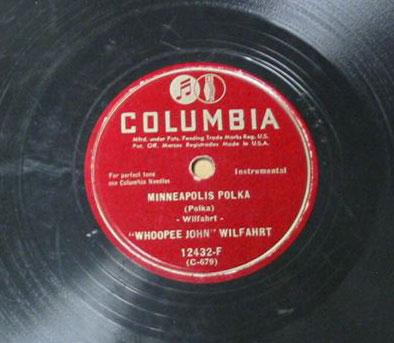
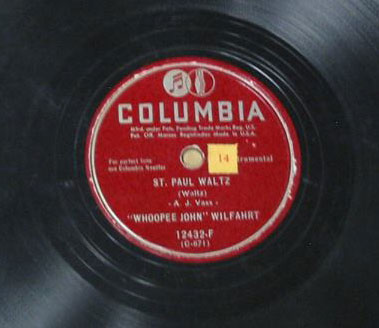
Red Foley and his Ozark Jubilee: 1957
Red Foley and his Ozark Jubilee cast flew to Minneapolis for their appearance at Metropolitan Stadium on July 21, 1957. Apparently flying was unusual enough to mention in the headline of the article. The article noted that Foley had given up a sports career for his singing career, and had sold more than 14 million records in the past 20 years. Other artists on the show included:
- Marvin Rainwater
- The Foggy River Boys
- Shisk & Whistler
- Bill Wimberly’s Band
Also in the show were locals David Stone of KSTP-TV, Texas Bill Strength of KEVE Radio, and Johnny T of WISK.
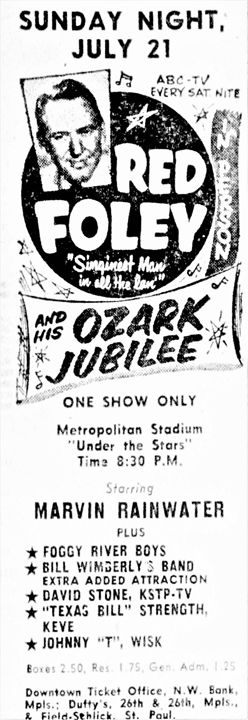
Untamed Youth: 1957
“Teenagers Go ROCKALYPSO Wild… UNTAMED YOUTH” started its run at the Lyric Theater on July 27. Mamie Van Doren starred in this film where “Punishment Farm for Teen-Age Cons… Makes ’em Wilder!” Miss Van Doren was by no means a teenager, but she was certainly “the girl built like a Platinum Powerhouse.” This movie is so bad that even Turner Classic Movies described it as “absolutely awful.” Van Doren sang something called “”OOBALA BABY,” a strange collaboration between Les Baxter and poor Eddie Cochran, who was in the movie. Cochran was reduced to playing air guitar with his cotton sack, singing a song called “Cotton Picken” – by Les Baxter. After a long day of picking cotton, these Hollywood rock ‘n’ rollers had lots of energy to dance and have cat fights in their underwear. On the same bill was something called “Hooked! – Pent-up Punks on a Penthouse Binge…” And they say the ’50s were so provincial.

Jazz for Moderns Tour: 1957
The Jazz for Moderns fall tour came to the St. Paul Auditorium Theater on November 10, 1957. Performing were:
- George Shearing
- Gerry Mulligan
- Chico Hamilton
- Miles Davis
- Australian Jazz
- Helen Merrill
Winter Dance Party: 1959
On Wednesday, January 28, 1959, the ill-fated “Winter Dance Party” came to the Prom Ballroom in St. Paul. The show was emcee’ed by WDGY DJ Bill Diehl. At the Prom was a crowd of 2,000 people, including a lot of screaming girls.
Performers on the tour included:
Buddy Holly, nee Charles Hardin Holley. Buddy was performing without the Crickets; accompanying him were Waylon Jennings on bass and studio musician Tommy Alsup on guitar.
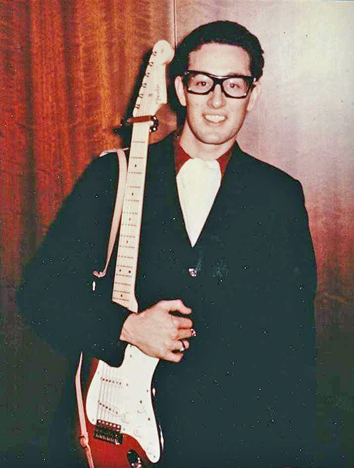
Buddy Holly
The Big Bopper, nee J.P. Richardson
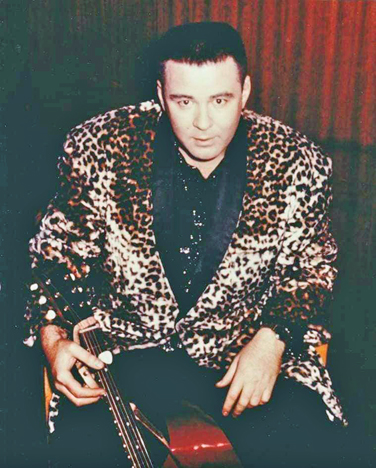
The Big Bopper
Ritchie Valens, nee Richard Valenzuela
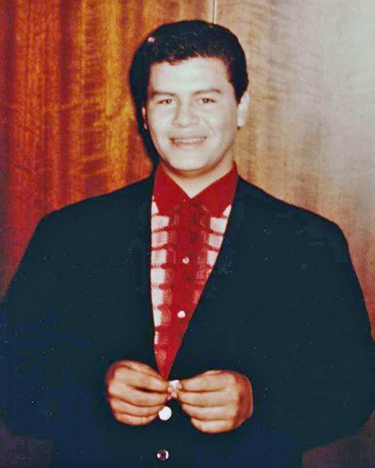
Ritchie Valens
Dion (DiMucci)
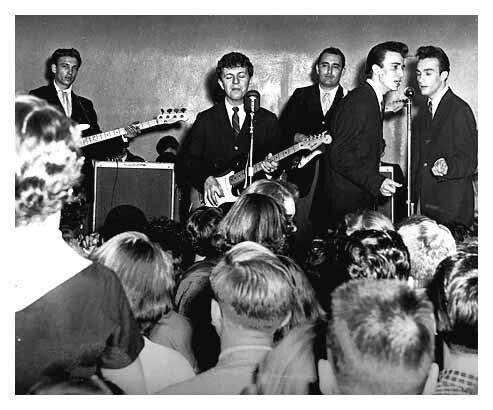
Pictured are Waylon Jennings on bass, Dion, Tommy Alsup on guitar, and the Belmonts
Frankie Sardo, nee Frank Sardo Avianca. Frankie was on the tour on the strength of a regional hit record called “Fake Out.” Not this region. The posters listed his song “Take Out,” which indicates how minor this hit was. Sardo also sang the flip side of his record, an Elvis impersonation called “Classroom.”
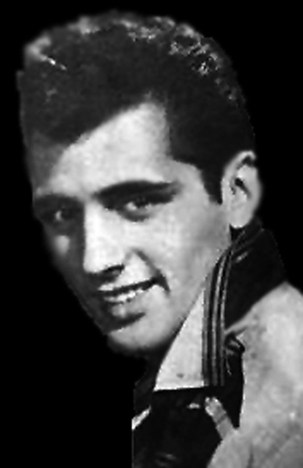
Frankie Sardo
THE ROUTE OF THE TOUR
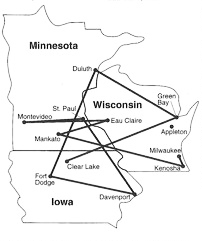
The Winter Dance Party was no party at all. It was a grueling series of one-nighters that were reached on a bus with failing heat in the coldest months of winter. The route criss-crossed the area, making the journey more onerous than would seem necessary. In 2013, Claire Mogren made a list of shows on the Winter Dance Party Itinerary; the information below is from her list and other information on the Internet.
- January 23: Milwaukee: George Devine’s Million Dollar Ballroom
- January 24: Kenosha, Wis.: Eagles Ballroom (with Debbie Stevens)
- January 25: Mankato, Minn.: Kato Ballroom. Bill Diehl was the emcee.
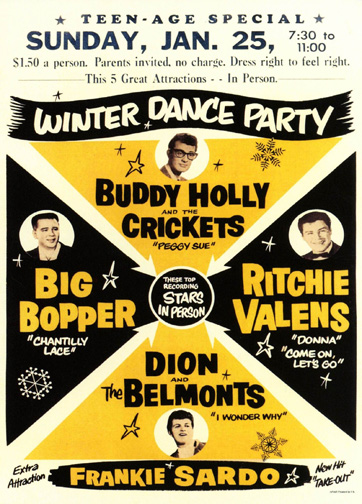
- January 26: Eau Claire, Wis.: Fournier’s Ballroom
- January 27: Montevideo, Minn.: Fiesta Ballroom
- January 28: St. Paul: The Prom Ballroom. Local band the Del-Ricos, which included Darwin Eckholm (aka Donald K. Martin), opened the show.
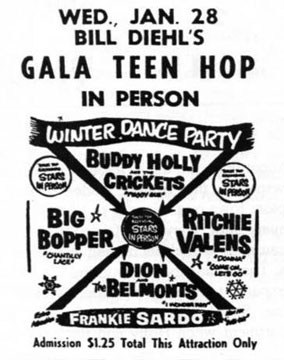
- January 29: Davenport, Iowa: Capitol Theater
- January 30: Fort Dodge, Iowa: Laramar Ballroom
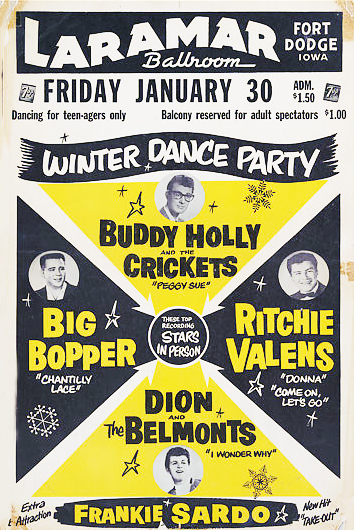
- January 31: Duluth Armory
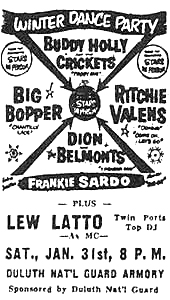
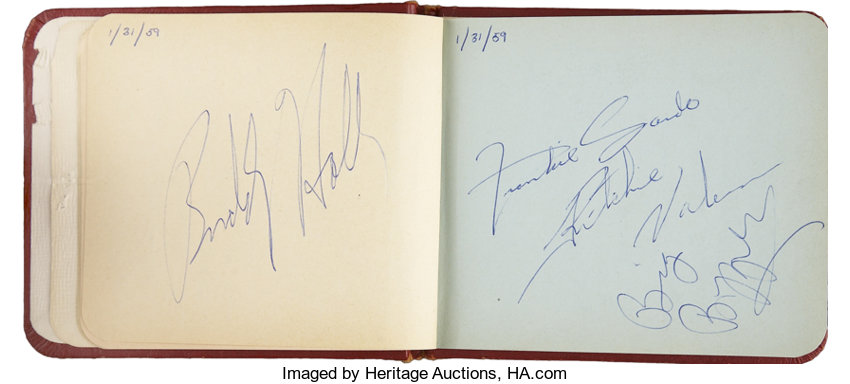
Autograph book from the Duluth Armory Show. Thanks, Jonathan Birnbaum
- February 1: Appleton, Wis.: Cinderella Ballroom (Cancelled due to bus trouble)
- February 1: Green Bay, Wis.: Riverside Ballroom
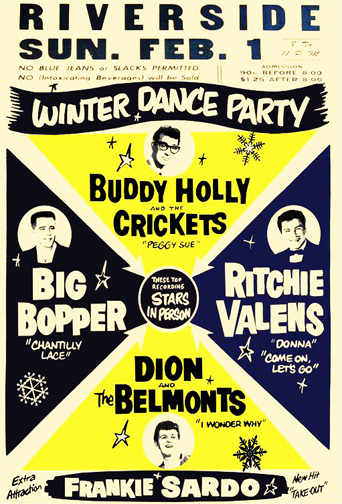
- February 2: Clear Lake, Iowa: Surf Ballroom
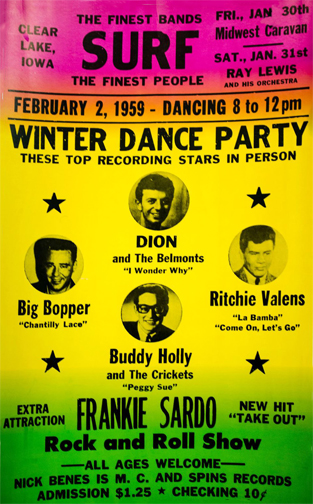
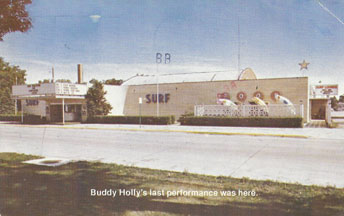
THE CRASH
After the show in the Clear Lake, Holly was fed up and decided to hire a small plane to get himself and his band to the next venue, which was a long drive in a cold bus to Moorhead. Waylon Jennings gave up his seat to the Bopper, who had the flu, and Tommy Allsup gave up his seat to Valens on a coin toss.
The plane took off at 12:55 am on February 3, with 21-year-old pilot Roger Peterson and the three musicians. Within five minutes it had crashed into a cornfield; all aboard died instantly. The Civil Aeronautics Board concluded that the probable cause of the accident was “the pilot’s unwise decision to embark on a flight” that required him to be able to fly on instruments, which he could not do. In addition, the plane had an attitude gyroscope that was different from what he was used to, making him believe he was climbing when he was actually descending – nose down at 170 miles per hour. In addition, Peterson was provided with “seriously inadequate” weather information, which “failed to even mention adverse flying conditions which should have been highlighted.” (Wikipedia)
The rest of the performers on bus didn’t find out about the accident until they arrived at the hotel and they saw the news on TV.
Grief struck the country; on the day the musicians died, Bill Diehl did a three-hour show on WDGY playing nothing but songs by the three young stars.
Incredibly, the death of the three stars did not stop the tour. The tour continued with other stars filling in. Bobby Vee, Jimmy Clanton, and Fabian starred in at least one show each, and Frankie Avalon finished the tour.
- February 3: Moorhead, Minn. Armory (with Bobby Vee)
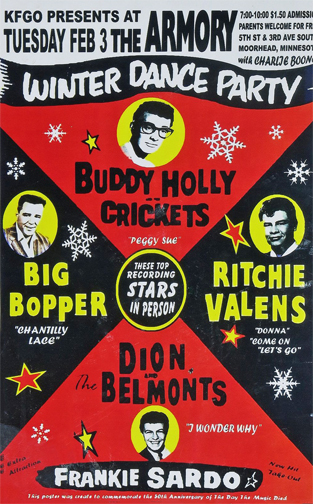
This poster is a repro.
- February 4: Sioux City, Iowa
- February 5: Des Moines: Val Air Ballroom
- February 6: Cedar Rapids, Iowa: Danceland Ballroom
- February 7: Spring Valley, Ill.: Les Buzz Ballroom
- February 8: Chicago: Aragon Ballroom
- February 9: Waterloo, Iowa: Hippodrome
- February 10: Dubuque, Iowa: Melody Hill
- February 11: Louisville: Memorial Auditorium
- February 12: Coshocton, Ohio: Coshocton Armory (with Frankie Avalon, Debbie Stevens)
- February 13: Youngstown, Ohio: Memorial Auditorium
- February 14: Peoria, Ill. Armory
- February 15: Springfield, Ill. State Armory
A good book on this tragic event is The Day the Music Died: The Last Tour of Buddy Holly, the Big Bopper, and Ritchie Valens, by Larry Lehmer.
Four Laddies: 1958
In February 1958, the “Four Laddies” performed on the local show “Record Hop” (see Rock ‘n’ Roll TV Shows). These youngsters were St. Louis Park students Joanne Spillcke, Judy Phelps, Sandy Hagen, and Chris Stewart.
Dinner with Drac: 1958
On March 2, WDGY disk jockey Stanley Mack was “fired” for playing a “shock record” that management had banned. The record was called “Dinner With Drac” by John Zacherle. After he announced that he had been canned, the kids jammed the switchboard and called his house. (The paper reported his St. Louis Park address the next day.) General Manager Jack Thayer called it a “terrible record… Mack went on the air at noon and he must have played that thing eight times in a row. I heard it on my car radio and I just blew my stack.” After Mack got the sack he continued to play it until Program Manager Bill Armstrong took over the program. The March 2, 1958 Minneapolis Sunday Tribune put a good cap on the story: “One Mack fan, a 15-year-old Sue Glad, complained to the Tribune, ‘This isn’t the first time WDGY has suppressed a song. They never did play ‘Short Shorts.'”
WDGY jock Jim Ramsburg tells us that it was all a publicity stunt: “If memory serves correctly, it happened on a Saturday. I was working at the station that day – the GM, Jack Thayer, was also there and it was his idea. Stanley Mack began playing the song repeatedly and Thayer somehow (not directly) got the word to a young reporter at the Tribune. She came running over to the station and we all played it straight that Stan had ‘locked himself’ inside the studio. (The studio door did have an electronic lock controlled by a switch inside the studio, but it could also be opened from the adjacent control room.) The story wound up on the front page of Sunday’s Tribune. On Monday a Tribune editor called Thayer and berated him for ‘taking advantage’ of the reporter and vowed that the paper would ban all mention of WDGY in its news section in the future.”
The Sack: 1958
In 1958 an unfortunate fashion fad was the “sack dress,” also known as the chemise. Apparently a ’20s look was the intention, as it was accompanied by a flapper headband and (ugh!) tights. Gerry Granahan wrote a song about it called “No Chemise, Please!” that reached #23 on the charts. On March 5, 1958, Bob Possehl, reporter for the St. Louis Park Echo, had this to say:
Males Veto Modern Modes
Nowadays the only way you can tell which direction a girl is walking is by looking at the point on her ducktail and assuming that she is moving the opposite way.
She does try to overcome the handicap of “sack” dresses, lovingly called chemises, by using her new pointed shoes to “lead the way home.”
How can she possibly adore something that disguises her womanly attributes as a paper sack would an hour glass? Is this feminine logic?
She even covers her legs with such shocking stockings that it’s hard to look at them without sunglasses.
Most of the boys are in favor of returning to the “good ol’ days” when sheaths and curly locks distinguished members of the fairer sex.
A couple of weeks later, Sue Berstein retaliated with an article entitled “Females Frigid to Fanciful Fashions,” decrying the boys’ fads of loud plaid vests and pants with the buckle in the back.
The ad below is unfortunately undated but may be a spoof of the fad.
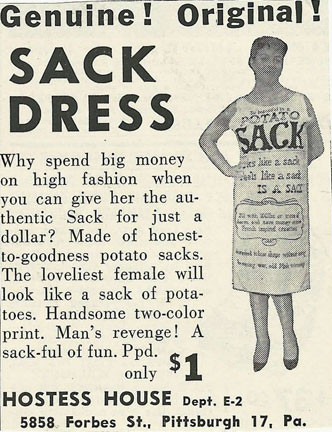
Disk Jockey Convention 1: 1958
The Storz Stations, which included WDGY, hosted the first-ever Pop Music Disk Jockey Convention & Radio Programming Seminar in Kansas City at the Muehlebach Hotel on March 7, 8 and 9, 1958. Newly-employed Bill Stewart coordinated the event. Full-page ads in Broadcasting and other radio/TV magazines promoted free registration “open to all Disk-Jockeys, Program Directors, Record Industry Management Personnel and Broadcasting Industry Management Personnel.” Stewart framed the convention as a seminar offering privileged information from high-dollar media experts, radio group executives and major-market air talent. Topics for discussion included “How to Run Profitable and Successful Record Hops,” “The Ingredients for Today’s ‘Formula’ Radio,” and “Is Rock and Roll a Bad Influence on Teenagers?”
A gala “All Star Show” featured Tony Bennett, The Four Lads, Laverne Baker, Andy Williams, The Crew Cuts, and many others. The gathering was attended by many of the biggest names in radio at the time, including the Presidents of the Hooper and Pulse rating services, Gordon McLendon, well-known New York Disk Jockeys Martin Block, Jack Lacy, Al “Jazzbeau” Collins, Peter Tripp and Chicago’s Howard Miller. Participating record companies included Columbia, DOT, Mercury, RCA-Victor, Atlantic, Roulette, Capitol, ABC-Paramount and Epic. The beauty part is that it was free to the DJs, underwritten by the record companies. Says so right on the registration form.
The convention was relatively boring, with Mitch Miller somehow asked to speak, although it was widely known that he hated rock ‘n’ roll. Plus Kansas City in March was no picnic. But things got better. Just wait til May 1959.
The Biggest Show of Stars for ’58: 1958
T.J. Skarning brought “The Biggest Show of Stars for ’58” to the Minneapolis (8pm) and St. Paul (3pm) Auditoriums on Sunday, May 4, 1958, featuring 17 acts:
- Sam Cooke
- The Everly Brothers
- Paul Anka
- Clyde McPhatter
- George Hamilton IV
- LaVern Baker
- Frankie Avalon
- The Silhouettes
- The Royal Teens
- The Storey Sisters
- The Crescendos
- The Monotones
- Jackie Wilson
- Jimmy Reed
- Jimmy Dell
- Harold Cromer, Master of Ceremonies
- Paul Williams and His Orchestra

Don’s Records and Hi-Fi: 1958
In 1958 E.F. Sandberg bought Don Leary’s record store at Miracle Mile for his son Don to operate, and it became Don’s Records and Hi-Fi. The Grand Opening, held on April 24-26, 1958, featured 12,000 records and offered orchids to the ladies and candy for the kids. (Men apparently never got anything at these Grand Openings.) Appearances were made by Disk Jockeys Roy Carr (WTCN), Jim Boysen (WLOL), and Stanley Mack (WDGY). Beverly Reinicke, who had worked for Don Leary for the last three years, was announced as an employee of the new store. An ad in the April 23, 1958, St. Louis Park High Echo announced the grand opening with much hep cat patois.
Alan Freed’s Big Beat: 1958
On April 25, 1958, Alan Freed’s Big Beat show rolled into Minneapolis. Tickets were $2.75. On the bill that night at the Minneapolis Municipal Auditorium were 17 acts, including:
- Buddy Holly and the Crickets
- Chuck Berry
- Screamin’ Jay Hawkins
- The Diamonds
- Jerry Lee Lewis
- Frankie Lymon
- Danny and the Juniors
- Billy and Lillie
- Billy Ford
- The Chantels
- Larry Williams and His Orchestra
- Dicky Doo and the Don’ts
- The Pastels
- Jo Ann Campbell
Local musician Sherwin Linton described the show:
Screamin’ Jay Hawkins wore a bright orange zoot suit and opened with “Little Demon” while shaking around a lot, and then sang ” I Put A Spell On You.” It was fantastic. Sam “The Man” Taylor was the back up orchestra and played the arrangement exactly like the record. About 15 other acts followed, with Buddy Holly and The Crickets, Chuck Berry, and Jerry Lee’s closing in a Bright Yellow suit and ending by tossing the mic through the back curtain creating a loud blast when it hit the wall. Greatest Rock and Roll Show ever.
Sherwin adds:
WDGY personality Bill Diehl was invited onstage by Alan Freed and Bill introduced a couple of the acts.
Sherwin also scored a coup with the poster:
I got the original poster, which was red and black on heavy card stock, 18 x 24. I sold it in 2006 to a Boston collector for $20,000. I had some copies made on the same card stock.
He sold copies of the prints, and one of them holds a place of honor in my living room!
Minnesota’s State Centennial: 1958
Part of Minnesota’s celebration of its Centennial was a musical performance by Judy Garland. Born Frances Ethel Gumm, Judy was born on June 10, 1922 in Grand Rapids, Minnesota. Her parents were vaudevillians who had settled in Grand Rapids to run a movie theater that featured vaudeville acts.
Wikipedia:
“Baby” (as she was called by her parents and sisters) shared her family’s flair for song and dance. Her first appearance came at the age of three, when she joined her elder sisters Mary Jane “Suzy/Suzanne” Gumm and Dorothy Virginia “Jimmie” Gumm on the stage of her father’s movie theater during a Christmas show and sang a chorus of “Jingle Bells.” The Gumm Sisters performed there for the next few years, accompanied by their mother on piano.
The family moved to California in 1926; Judy lived in Grand Rapids the first four years of her life.
From Ben Welter’s blog in the Strib:
Minnesota’s sweetheart filled stadium with song
Accompanied by 32 “hand picked” members of the Minneapolis Symphony Orchestra, Judy Garland fought through a case of laryngitis on May 11, 1958, to help her home state celebrate its centennial. More than 20,000 gathered at the U’s old Memorial Stadium on that steamy Sunday to hear Garland belt out such hits as “The Trolley Song” and “For Me and My Gal.” Midway through one song, she stopped and said: “Can I start again? I missed the lyric. Isn’t this terrible? I was trying to be so good.” Garland… finished the show with – what else? – “Over the Rainbow.”
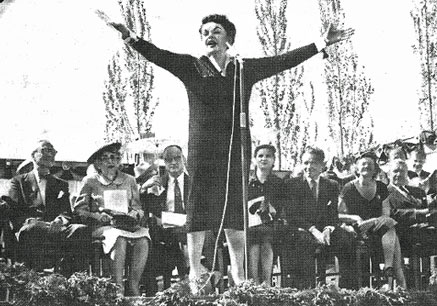
Events: 1958
KRSI radio debuted in June 1958, but it promised “no long commercials, soap operas, kiddie shows, rock ‘n’ roll, ‘top 40,’ or ‘over-enthusiastic’ disk jockeys,” reported the St. Louis Park High Echo.
In the fall of 1958, Pastime Arena manager Larry Tobin came before the St. Louis Park City Council to request permission to hold a public dance at the Arena on October 3 from 10-11:30. Only Councilman Jorvig voted nay. Subsequent dances were approved as well, including the Twin City Teen-Dance held New Year’s Eve and advertised in the St. Louis Park Echo newspaper. The Pastime became the Roller Garden, still there today.
Louis Armstrong appeared at the St. Paul Auditorium Theater Section on October 26, 1958.
They Named it Minnesota: 1958
Famed songwriters Sid Lippman and Sylvia Dee won a contest to compose the official centennial song, “They Named it Minnesota,” which was performed by the Apollo Club at the event. Kristi Putnam Gibson was able to find two verses of the song and sent them to Neal Bond’s Minnesota Music History Channel:
They took 10,000 lakes and some rich green vine,
and added the forest of Norway pine,
and high in the sky they made the North Star shine,
and they named it Minnesota.
They took 10,000 lakes and some rich green land,
and threw in some hills they had on hand,
and made it a paradise but twice as grand,
and named it Minnesota.
To Know Him is to Love Him: 1958
Found! In the book Wall of Pain, the Biography of Phil Spector by Dave Thompson (2003): The story is about the song “To Know Him is to Love Him” by the Teddy Bears, Spector’s first group. It was originally a B side, but even released as an A side the feeling was that it was “under-produced, under performed. The girl had a nice enough voice, but where was the music, where was the ‘ooomph’? You couldn’t sell a record unless it has some ‘ooomph.’
Not in Los Angeles, anyway. Although one or two courageous DJs had flipped the record over under their own steam, the city itself seemed to leave the Teddy Bears on the shelf. Way out in Fargo, North Dakota, however, KFGO’s Charlie Boone couldn’t get enough of it. By the beginning of September [1958], listeners to his daily Boone in the Afternoon show were hearing ‘To Know Him is to Love Him’ every day. (Boone himself would become an international name six months later, as host of the last ever Buddy Holly concert.) The first orders for the single began trickling in.
Days later, KDWB Minneapolis followed suit, only this time it was the station’s programme director, Lou Riegert, who fell in love with the record, and made sure that all his DJs gave it a spin. More orders came in, a handful at first, then more and more.
By the middle of the month the song had reached the top 100, based on regional sales alone. The song eventually made it to #1 in the first week of December.
Rock for Freedom: 1958
On September 19, 1958, the Minneapolis Spokesman reported that “300 St. Paul Youngsters ‘Rock’ For Freedom & NAACP.”
“WE’RE GONNA ROCK FOR FREEDOM” might well have been the cry of 300 of St. Paul’s youth as they flocked to the block party sponsored by radio station WTCN under the auspices of the Youth Chapter of the St. Paul branch of the NAACP last Wednesday night in the 800 block of Iglehart. Admission to the affair was the price of a youth membership in the NAACP. A total of 50 new members were enrolled making the chapter’s membership total to almost 300. WTCN furnished music and refreshments to the singing and dancing youths in the roped-off area and, according to all reports, a ‘good time was had by all.’
Jazz for Moderns: 1958
On November 13, 1958, jazz writer and historian Leonard Feather emcee’ed a show called “Jazz for Moderns” (venue unknown). The featured acts were:
- The Four Freshmen
- Dave Brubeck Quartet
- Sonny Rollins Trio
- Maynard Ferguson Orchestra.
St. Paul Auto Show: 1958
The St. Paul Auto Show took place on November 26-30 at the St. Paul Auditorium and featured:
- The Four Lads
- The Three Suns
- Leo DeLyon (?)
- Lillian Briggs
Key Club: 1959
In 1959 the Key Club took over where the Labor Temple had left off a few years before, bringing major Rhythm & Blues acts to the Twin Cities.
- Sister Rosetta Tharpe, January 1959
- Cozy Cole and Quintet featuring Barney Bigard, January 14, 1959
- Big Maybelle, January 26, 1959
February shows at the Key Club:
- Roy Milton, February 1959
- Jimmy Witherspoon, February 1959
Key Club Shows, March-April 1959
- Sarah Vaughan, March 16-22, 1959
- T-Bone Walker, March 23-29, 1959
- Abbey Lincoln, March 30-April 5, 1959
- Ray Charles and the Raelettes, April 6-12, 1959
- Ernestine Anderson, April 13-19, 1959
- Joe Medlin, April 20-23, 1959
- Della Reese, April 24-May 3, 1959
May shows at the Key Club:
- Lambert, Hendricks, and Ross, May 4-10, 1959
- Chris Connor and her Trio, May 11-16, 1959
- Miles Davis, May 18-24, 1959
- Tommy Edwards and Donna Hightower, May 25-May 31, 1959
June shows at the Key Club:
- Eddie “Lockjaw” Davis, solo tenor sax, with singer Donna Hightower, June 1-7, 1959
- Martha Davis and Spouse, June 8-14, 1959
- Ruth Brown and the Paul Williams Band, June 15-21, 1959
- Clyde McPhatter, June 22-28, 1959
- Louis Jordan and His Tympany Five, June 29-July 11, 1959
July shows at the Key Club:
- Stepin Fetchit, well past his prime, and Lonnie Sattin, July 13 – 17, 1959
- Miles Davis with John Coltrane and Cannonball Adderly
- Brook Benton, July 27-August 2, 1959
August shows at the Key Club:
- Bobby Freeman, August 10-16, 1959
- Ink Spots, August 17-30, 1959
- Sammy Turner, with Doris Hines, August 31-September 6, 1959
September shows at the Key Club:
- Steve Gibson and the Red Caps – as seen on Ed Sullivan, Jackie Gleason, and Arthur Godfrey, September 7-21, 1959
- Anita O’Day, September 20-27, 1959. She got sick in New York and missed her opening night but showed up for the rest of the run. Charles Hanna of the Minneapolis Tribune reported that it was her first performance in Minneapolis; she had appeared in St. Paul in 1948 and 1949.
- Nellie Lutcher, September 28-October 11, 1959
October shows at the Key Club:
- Roy Hamilton, October 12-18, 1959
- Hammond organ stylist Bill Doggett, October 19-25, 1959
Auto Show: 1959
Big names at the 1959 Auto Show:
- Nat King Cole, January 9-12
- Frankie Laine, January 13-18. Reporters at St. Louis Park High continued to demonstrate their squareness in a February 4 article in the Echo about meeting Frankie Lane (sic).
National Dance Contest: 1959
A national dance contest was sponsored by the American Federation of Musicans to find the best new dance band of the year. On March 16, 1959, the local contest, sponsored by the Minneapolis Musicians’ Association, took place at the Marigold Ballroom. Each band would play four numbers. The winner would compete in a regional contest in Des Moines; a semi-final in Chicago; and the final in New York. The winner was promised a recording contract with Decca records, a national TV appearance, all new instruments, and weeks of bookings at ballrooms all over the country. Entry was free, bands could not have more than 15 pieces, and the music had to be “modern dance music.” “(Other contests for rock ‘n’ roll, hillbilly, western, old time, Dixieland, or be-bop may be held later.)” Bands would be judged on showmanship (appearance and presence); tone quality; rhythm; and musical arrangements.
Open House: 1959
Junior Miss at Knollwood Plaza held an Open House on April 2 and 3, 1959. Advertised were door prizes, entertainment, a disk jockey broadcasting direct from store, refreshments, and informal modeling. In the April 15 issue of the Echo, reporter Dede Smith told of the appearance by the Kingston Trio, “dressed in Ivy League clothes and spouting the latest ‘Frisco jazz talk.” The Kingston Trio had performed at Northrop Auditorium on April 3 and were scheduled to appear at Southdale the Saturday after the 15th.
Dancing in Tonka: 1959
On April 25, 1959, the Tonka Bay Village Hall opened its doors for a series of teen dances for teenages from 14 to 17 years old. Chaperones were the parents of Tonka Bay, Excelsior, Shorewood, and Greenwood, and the dances were endorsed by the South Shore Community Council. Admittance was 10 cents, and there was a strict dress code of slacks and sports coats for boys and “date dresses” or skirts for girls. The teens must have behaved themselves; at first the dances were over by 10, the 10:30 by May. In 1960 they lasted until 11.
There was no indication of where the music was to come from or what kind it would be, but appearing at at least two of the dances were Carol Lombard and Mike McGrath, “dancers from KSTP.” This has to be “Hi-Five Time” – see TV Shows. (Minnetonka Record)
Disk Jockey Convention II: 1959
The notorious Second Annual International Radio Programming Seminar and Pop Music Disk Jockey Convention, which became synonymous with “Babes, Booze and Bribes,” was held at the glamorous Americana Hotel in Miami Beach on May 29-31, 1959, hosted by Todd Storz, owner of WDGY and several other Top 40 stations. 2,500 jocks came down to listen to speakers, make contacts, and get educated about how to make their programs better. Ha! The liquor flowed like… wine, prostitutes (local and imported) were on call, and the record companies were giving away cars, trips, and who-knows-what-else to curry favor with the men who could make or break a song. Sessions were hosted by individual record companies; for example, Saturday breakfast was sponsored by Atlantic Records, co-hosted by Ahmet Ertegun and Jerry Wexler themselves. Alan Freed was on the program, as was our own Charlie Boone, who was working in Fargo at the time. Other big-name jocks included Robin Seymour, Gordon McLendon, and Al “Jazzbo” Collins. The payola was flowing and so blatant that it led to Congressional hearings and the ruin of careers, most notably Alan Freed’s. But it was a fun party.
The Pavek Museum of Broadcasting has a copy of the program, and the list of entertainers was phenomenal:
- Peggy Lee and George Shearing, who made the LP “Beauty and the Beat!” during one of the cocktail parties
- David Seville and Julie London, who hosted a Saturday afternoon cocktail party
- Count Basie and Ronnie Hawkins and the Hawks, an odd combination, at a dance and barbeque
On Saturday night there was a three-hour All Star Show emcee’ed by the “Daddyo of the Disk Jockeys,” Martin Block, who was presented with a huge cake in recognition of his 25 years in the business. Keynote speaker at the banquet and show was former Tennessee Governor Frank Clement, who stressed the importance of DJs in forming public opinion. Performers at the extravaganza were:
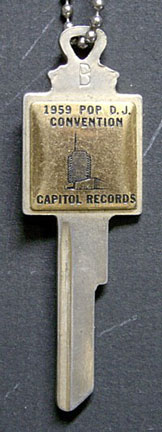 Pat Boone
Pat Boone- Cathy Carr
- Chris Connor
- Vic Damone
- Alan Dean
- Connie Francis
- Johnny Horton
- Peggy Lee
- Lou Monte
- Patty Page
- The Playmates
- Lloyd Price
- Connie Russell
- Jimmy Rodgers
- Jack Scott
- George Shearing
- Dodie Stevens
- Gary Stites
- Kirby Stone Four
- Jesse Lee Turner
- Caterina Valente
- Andy Williams
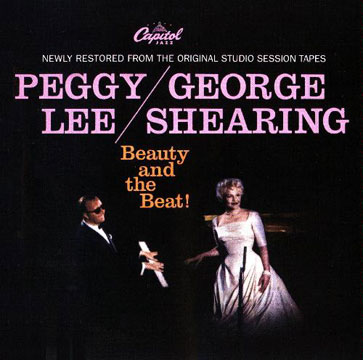
As the jocks were on their way home, readers of the Miami News were reading the famous headline on the first page: “For Deejays: Babes, Booze And Bribes,” written by Haines Colbert. Some excerpts:
- [DJs] were given the greatest buttering-up since Nero was persuaded he was a fiddle virtuoso.
- There was constant praise for the apparently unbelievable talent required to put a record on a turntable, play it and sell it to all those wonderful people out there in radioland.
- One promotion man said, “You can buy some of them with an air-conditioner; some with money and some with a girl.”
- “A lot of these guys think they’re gods. You hardly can blame them, either.”
- “We put out one record sung by a kid with no voice and no reputation. We spent $100,000 on the promotion – most of it entertaining disc jockeys – and it got into the [top] 10 in four weeks.”
- “I would guess that the payoffs to the disc jockeys in one form or another run to well over $1,000,000 a year.”
- “It’s a lousy situation, but I don’t see how anything can be done about it. As we tell them all the time, without the disc jockeys we’re dead.”
Well, the poop hit the air conditioner, and the blatant payola led to Congressional hearings and the ruin of careers, most notably Alan Freed’s. But it was a fun party.
Events: 1959
Mahalia Jackson appeared at a concert at the St. Paul Auditorium on May 1, 1959. It was sponsored by the Elks, with proceeds going to a scholarship fund.
Maurice Turner and Irv Williams appeared at the River Road Club nightly.
B.B. King appeared at a Mother’s Day Matinee Dance at the Marigold Ballroom on May 10, 1959, presented by the Horsemen.
WLOL-FM featured dance band music on Fridays and Saturdays, according to an article in the June 4, 1959 Echo St. Louis Park High School newspaper. “We’re promoting a better brand of music because we believe that most teenagers are getting tired of rock ‘n’ roll,” a spokesman said. Really? Eight Miracle Mile merchants sponsored the program.
Willie Mabon appeared at the Marigold Ballroom for a Sunday Matinee dance on June 14, 1959. It was billed as a “Wash and Wear Affair,” promoted by The Horsemen.
In the June 1959 issue of Select (precursor to Twin Citian/City Pages), Jerry Mayeron advertised his services to book the finest society dance orchestras – one artist or a gala stage production – for your private party or club party. Featured was Arthur Godfrey Talent Winner Mary Davies.
The Youth Chapter of the Minneapolis NAACP gave their Second Annual Semi-Formal Dance at the Calhoun Beach Hotel on July 10, 1959. Appearing for the second year were the Big M’s.
Bobby Bland appeared at the Marigold Ballroom on July 26, 1959.
On the night of August 21, 1959, when the bars let out at Kent Street and Rondo Ave. in St. Paul, trouble broke out and the Spokesman reported that police cracked heads with batons and threatened to use fire hoses.
The Shrine Gala Day at the Marigold Ballroom was on September 25, 1959, 9 pm “til unconscious.” Music was provided by Hank Hazlett and His Band.
Golden Valley jazz venue the White House refused to seat three black patrons and a jury found for the defendants, awarding them damages.
The Key Club featured unknown jazz singer Gloria Smyth from November 2 to 15, 1959.
WDGY sponsored a contest to win an interview Troy Donahue, who was at the Nicollet Hotel promoting his film “A Summer Place.” St. Louis Park High student Susan Fuehrer was a winner, and brought her sister Mary with her for the exciting event.
No rock ‘n’ roll was played on radio station WMMR, which was broadcast from Coffman Union at the U of M to the dorms. Park senior Irwin Gold a/k/a Dean Curtis reported that its repertoire was easy listening and swing.
The Key Club presented the stage act of Christine Jorgensen, who was known more for her sex change operation than her stage show.
Bobby Vee: 1959
Bobby Vee, a Fargo kid, put together a band called the Shadows and performed at the Moorhead show that night. Later that year he came to Minneapolis to record “Suzie Baby” on SOMA Records. It was re-released on Liberty Records and broke the Billboard charts on August 31, 1959, reaching Number 77. His next record only charted to 93, but then “Devil or Angel,” a cover of a song by the Clovers from 1956, hit Number 6 in 1960 and he was on his way, charting 38 records during his career.
Zimmy at Gaity: 1959
David Hersk built a recording studio in his parents basement in the mid-fifties, which became Gaity Records. David’s friend Derik Olson tells a story David never told publicly, but shared with him at lunch one day:
In 1959 a group of folkies from Dinkytown came into his basement studio to record a few tracks. Among them was Bob Zimmerman. Bob sat down at the piano that David had in the studio. After banging away loudly for a few minutes, David asked him to stop, because he just wasn’t making anything that sounded good to David’s ears. David doesn’t remember who the group was, or what they recorded. So that’s the story of the almost first time Bob Dylan ever recorded in a studio. If that disc had been made, with Bob on it, it would be worth tens of thousands of dollars, I’m sure. David didn’t want me to write about that story on my blog, for fear of backlash from Bob. I assured him that I was sure Bob wouldn’t care, or have any legal recourse even if he did. But David asked me to not share the story, so I didn’t. Now that he is gone, I feel people should know about this little tidbit of MN music history.
Thanks for sharing, Derik. Read more about Gaity Here. David passed away on July 19, 2016.
Beatniks in the Cities: 1959
The October 1, 1959 Trib posed the question: “Does the Twin Cities have its share of beatniks? The people interviewed were skeptical:
- Suzanne Wolfe said “Yes, even if the majority of beatniks aren’t serious about it. There are a number of beatniks at the U of M. They wear trench coats and goatees.
- Errol Kantor said “No. Most beatniks are out in California. The fellows at the University who wear trench coats and goatees are all pseudo-intellectuals.
- Sonja Blagen thought Minneapolis had its share but that St. Paul didn’t have one beatnik joint.
- Matthew Levison, a student at the U, said “No. Perhaps 10 percent of those popularly known here as ‘beat’ are actually so. The balance are nothing more than hangers-on. Beat movement is entirely nihilistic in 20th century tradition. Its center is New York and the West Coast.
- Bonnie Erickson made the decision unanimous: “The concentration of individualistic existentialists, as I prefer to call the ‘beatniks,’ is definitely in Minneapolis. Only a few are sincere iconoclasts. Fakes who claim to be beatniks do it for attention, rather than for a purely esthetic cause.
Caravan of Stars: 1959
On October 28, 1959, the Dick Clark Caravan of Stars was scheduled to come to the Minneapolis Auditorium. The show was to include all the WDGY disk jockeys and:
- Paul Anka
- Lloyd Price
- Annette
- Duane Eddy
- Jimmy Clanton
- LaVern Baker
- The Coasters
- The Drifters
- The Skyliners
- Bobby Rydell
- The Jordan Bros
- Phil Phillips
- Arnold Dover (emcee when Dick Clark could not appear; Clark was not scheduled to appear in Minneapolis)
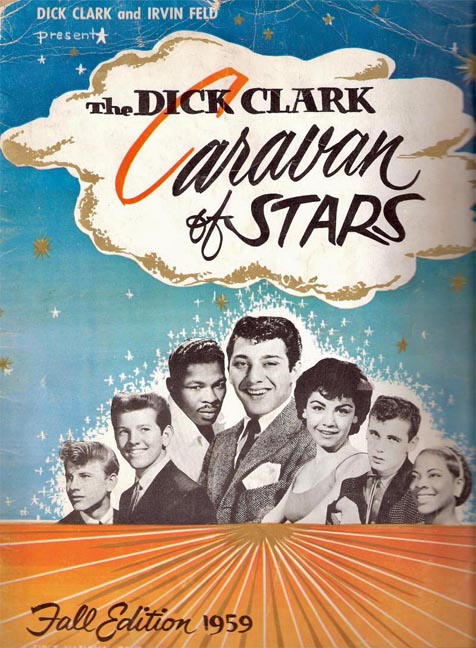
From blog of Jerry Fuentes http://rnrhistorian.blogspot.com/2011/12/caravan-of-stars-1959.html
On October 19, 1959, the front page headline in the Minneapolis Star read, “Dick Clark’s Show Barred From City.” Police Chief Milton E. “Buzz” Winslow cancelled this show “for the peace and welfare of this city.”
Reasons for this action included a riot that broke out the previous Saturday at the Caravan of Stars show in Kansas City. However, there had been violence at four similar shows in Minneapolis.
1. On November 21, 1958, eight policemen were hospitalized when violence broke out at the armory. (This did not show up in a search for the word armory.)
2. On December 6, 1958, during a private teen-age dance at the armory, five teenage girls were hospitalized. (Not newsworthy either)
3. On October 28, 1958, five squad cars had to be sent to the Minneapolis Auditorium when a gang of youths prepared for an attack of 12 officers hired to provide security at a teen-age dance. (Nope)
4. On April 25, 1959, Buzz cited yet another case where a musical show got out of hand when the audience began dancing in the aisles and on the stage. If this was at the Minneapolis Auditorium, this was the Stars of the Grand Ole Opry. Yee Ha!
“I am certain violence will occur again,” Winslow told the Associated Press.
HOLD ON THERE, BUZZ
It turned out that Buzz didn’t have the authority over the Minneapolis Auditorium, which was owned by the City, so he appealed to the Committee that oversaw it to shut the show down.
On October 21, the City Council Buildings and Grounds Committee decided that the show could go on it 30 policemen (the number Winslow said he would need) could be provided. However, by then the promoter, T.B. Skarning, had thrown in the towel and cancelled the show. Ticket sales had stopped, and he said that “scare publicity” after the riot in Kansas City had led to the cancellation.
KANSAS CITY IN CHAOS
Blogger Jerry Fuentes describes the Kansas City show, which took place on October 17, 1959:
The Caravan gains its first negative notoriety when midway through the show, fights break out among the 12,000 plus audience and police moved in to break up the melee. In all, 49 men were arrested ranging in age from 17 to 50 for disturbing the peace and public drunkenness. Although Dick Clark was not at the show, his association with the show drew lots of press and he held a news conference in New York to defend the Caravan. He denied that the performers were responsible for what happened and said, “What happened was certainly unfortunate, but it only reflects the attitude of a few of the thousands of people there.”
Rollie Williams: 1959
Rollie Williams was a presence in St. Louis Park for many years. From November 1959 to November 1960, Northwest Guitar and Organ Studio (aka Northwest Guitar and Accordion) was located at 3699 Joppa “under personal supervision of Rollie Williams.” The company’s Minneapolis office was located at 6436 Penn Avenue South. On November 18-26, 1960 the store had an open house at its new location at 4520 Excelsior Blvd., this time called Rollie Williams Music Company. It became R.W. Music Co., and was at that location until about 1974. A second location at 504 Cedar Ave. So. in Minneapolis opened in September 1969.
Year of the Folk Boom: 1960
From the Little Sandy Review Issue 11:
The year 1960 was, among other things, the Year of the Folk Boom. Folk LPs and single sold across record counters like hotcakes; the Kingston Trio was on everybody’s Top Ten list; guitar and banjo sales soared; coffee houses sprang up like weeds in college area; everyone had Odetta’s new LP; and Jean Ritchie and John Lee Hooker even got on television. Strange things were happening. For the first time in history, American folk music became Big Business: it was found that you could make a buck by knowing such old chestnuts as SKIP TO MY LOU or DOWN IN THE VALLEY. (You could, in f act, make even more by writing them.) Madison Avenue and Tin Pan Alley, taking stock of the situation, set about rewriting our American heritage 1960 style. Most of our songs were debased beyond recognition, and folk (in most cases, folkum) albums flew off the presses so fast you literally needed an IBM machine to count them. (Our estimate: there were at least 300 different folk albums released in 1960.) Any three people walking down the street became a folk group, and, chances were, had an LP out within a week. The Weavers, Harry Belafonte, and Odetta were in and out of Carnegie Hall so often it made your head spin. Mitch Miller (substitute any record company president) frantically grabbed four college kids, bought them two guitars and a banjo (in this case a TENOR banjo!), dressed them in Bermudas, and sent them off to Newport (where, of all things, they were accepted). Teenagers swooned over Dave Guard and Bob Shane and called Nick Reynolds “cute.”
For more interesting commentary by the Little Sandy Review, see Publications.
Events: 1960
Illinois Jacquet appeared at the Key Club, starting January 4, 1960.
The Weavers appeared at Northrop Auditorium on January 30, 1960.
The Kingston Trio appeared at the Minneapolis Auditorium on February 13, 1960.
Jazz singer and pianist Hazel Scott appeared at Freddie’s in April 1960.
Singer Cle’a Bradford performed at the Key Club the week of May 6, 1960
Tony Bennett and the Ralph Sharon Trio began a stint at Freddie’s starting May 9, 1960. Buddy Hackett was also on the bill.
Chris Connor and Her Trio performed at the Key Club the week of May 13, 1960.
Bo Diddley played an engagement at the Loon Teen Club (which became Mr. Lucky’s) on May 14-20, 1960.
Oscar Peterson played Freddie’s on May 21, 1960.
Josh White brought his repertoire of blues, spirituals, and folk music to Freddie’s on May 23, 1960. He was followed by an appearance by Bob Newhart.
Frankie Lymon performed at the Key Club the week of May 25, 1960.
The “Biggest Show of Stars” came through the Cities in 1960, with 10-12 acts including Frankie Avalon, the Paris Sisters, and Cliff Richard. (Can’t find this…)
Dorothy Dandridge and Vaughan Monroe were some of the performers at the Radisson Flame room in the fall of 1960.
Comedian Shelley Berman performed at the Minneapolis Auditorium on October 21, 1960.
The Limelighters and comedian Mort Sahl performed at Northrop Auditorium in the fall of 1960.
Skirts at the knee were considered too short by some St. Louis Park High School boys. Really??
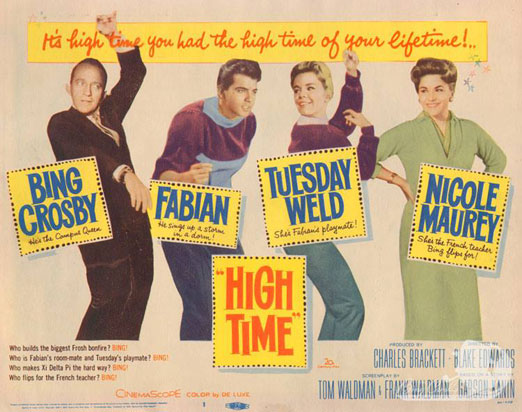
Arne Fogel’s favorite Rock ‘n’ Roll Movie
Key Club: 1960
Appearing at the Key Club:
- Etta James, February, 1960
- Billy Eckstine, February 26, 1960
- The Flamingos – March 28, 1960
- Step Brothers, April 15, 1960
- Dakota Staton, April 22, 1960
The Key Club featured the following entertainers in 1960:
- Loray White (Sammy Davis, Jr.’s ex-wife), June 6, 1960
- Cab Calloway, June 20, 1960
- Redd Foxx, July 7, 1960
- Hortense Allen Revue, September 12, 1960
- The Treniers, October 1960
Diablos: 1960
St. Louis Park High spawned the folk group the Diablos, featuring Jerry Roberts on vocals, piano, and ukelele and Vicki Dulac on drums. The group was on the Mary Jo Tierney TV Show, Judge Wright Talent Show, and played around town at places like Stillwater Prison and mental institutions, according to an article in the Echo in May 1960.
Jazz Festival: 1960
A three-day jazz festival was held at Northrop Auditorium in 1960, sponsored by the University of Minnesota’s Department of Concerts and Lectures in cooperation with the Coffman Union Board of Governors:
Friday, May 13:
- Dave Brubeck Quartet: St. Louis Park High reporter Dave Perlman interviewed Brubeck, who said that the album “Time Out” was written by his brother Howard, with accompaniment by the New York Philharmonic. Critics did not like the song “Time Out,” which had a 5/4 beat patterned on African rhythms and took three years to write.
- Miriam Makeba
- Lambert, Hendricks & Ross with the Ike Isaacs Trio
- Union Jazz Workshop Quintette
- Coleman Hawkins Quartet
Saturday, May 14:
- Ahmad Jamal Trio
- Ernestine Anderson
- Harry Blons
- The Signatures
Sunday, May 15:
- Louis Armstrong
- Clara Ward and the Ward Singers
- Rod Aaberg and His 15-Piece Band
Johnny Cash and The Fendermen: 1960
The Johnny Cash Show rolled into town, performing at the Minneapolis Auditorium on May 15, 1960.
Other performers were Johnny Horton, Kitty Wells, and The Fendermen. The Fendermen consisted of Phil Humphrey and Jim Sundquist, from Madison, Wisconsin. Amos Heilicher was their agent. They were booked for this show at the last minute because of their skyrocketing popularity in the Twin Cities. “Muleskinner Blues” (written in 1931 by Jimmie Rodgers) was originally released on Cuca Records in 1959. They re-recorded it in at Kay Bank Studios in Minneapolis and it was released on SOMA It entered the Billboard chart on May 23, 1960. The record peaked at #5 and stayed on the chart for 18 weeks. On June 11, 1960, they appeared on American Bandstand. Lightning didn’t strike twice, there was litigation between the two record companies, and the two split up in 1961. The Fendermen were inducted into the Mid-America Music Hall of Fame in 2005.

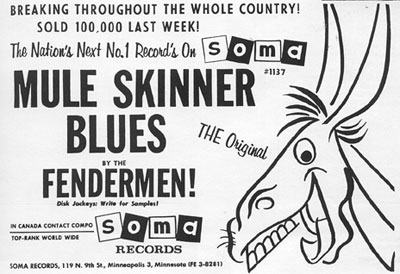
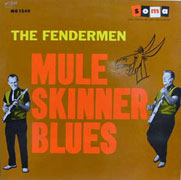
Hurry Down to Bleecker: 1960
Ron Johnson, from Deephaven, and Gordon Ramsey, from St. Paul, went to Hamline University and on May 19, 1960, the Minnetonka Record reported that they were on the staff of NBC in New York. Ramsey had recorded the “new hit,” a beatnik ditty called “Hurry Down to Bleecker,” arranged by Ron. This obscure tune is actually on YouTube! Photos below were most generously provided by Henry Perone. (Gordon, you spelled the name of your college wrong.)
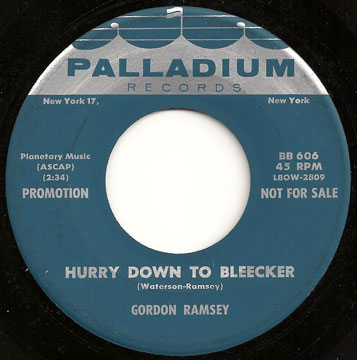
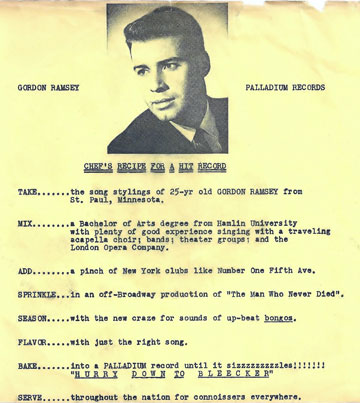
Dylan Party Tape: 1960
MAKING THE TAPE
Thanks to Minneapolis resident Cleve Pettersen, the original recording of what fans and music buffs know as the “Minnesota Party Tape” was made available to the public at the library in the Minnesota History Center in St. Paul in 2004.
Petterson’s son Leif Petterson described in an article on Salon (May 8, 2019):
In the summer of 1960, my then fifteen-year-old father, Cleve Pettersen, went to Radio Shack and bought one of the first commercially available, portable reel-to-reel tape recorders. The thing was the size of a small ottoman and weighed about as much as a boulder of the same dimensions. It cost $50, which is over $400 in today’s economy, so not an insignificant purchase for a fifteen-year-old.
Pettersen wanted to get a local folk singer to sing songs into his new recorder and asked some local musicians who would be willing. He had no takers until a 19-year-old Bob Dylan agreed to be recorded in the fall of 1960. Pettersen and his friend Bil Golfus went to an apartment 711 on 15th Ave. S.E. in Minneapolis (alternately described as Dylan’s, his girlfriend Bonnie Beecher’s, or rented by Dylan’s roommate, Hugh Brown) and hung out with Dylan, Bonnie, and friend Cynthia Fischer. (Bonnie would one day marry Grateful Dead/Woodstock character Wavy Gravy.)
Pettersen set up the recorder and Dylan casually sang 12 folk songs into it. The songlist:
- Blues yodel No. 8
- Come see Jerusalem (sung with Cynthia Fincher/Fischer)
- San Francisco Bay Blues
- I’m a Gambler
- Talkin’ Merchant Marine
- Talkin’ Hugh Brown
- Talkin’ Inflation Blues (song by Tom Glazer is referred to as Talkin’ Lobbyist on the recording)
- Red Rosey Bush
- Johnny I hardly Knew You
- Jesus Christ
- Streets of Glory
- K.C. Moan
Other songs mentioned by Petterson’s son were:
- I Thought I Heard That Casey When She Blowed
- I’m Gonna Walk the Streets of Glory
Petterson never saw Dylan again, and by December 1960, Bob had left Minnesota for Greenwich Village. Petterson kept the tape for 44 years until he decided to donate it to the Minnesota History Center. It is available for listening at the library and cannot be duplicated.
THE HOUSE
Dylan lived in the ground floor middle unit of the building pictured above. It was demolished in 2014.
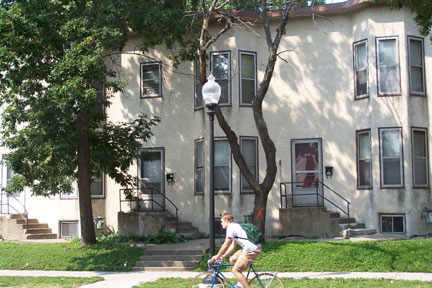
Apartments where “Minnesota Party Tape” was recorded
THE TAPE
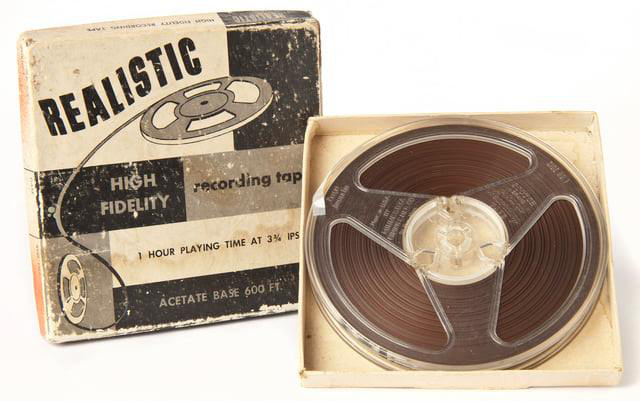
Image courtesy Minnesota Historical Society
The writing on the box below is thought to belong to Dylan’s girlfriend Bonnie Beecher, who had borrowed the tape. One theory about Dylan’s name is that he originally took it – not from Dylan Thomas – but from Marshal Dillon.
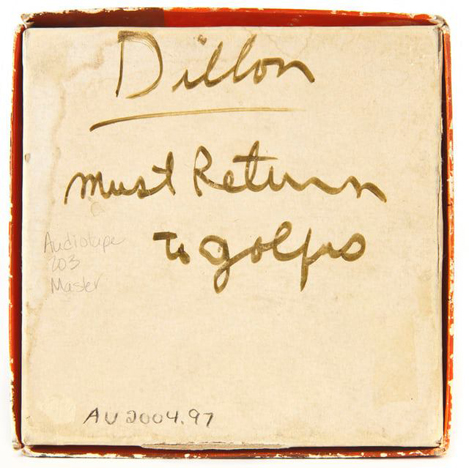
Image courtesy Minnesota Historical Society
Dylan lived in a couple of places at the U, including the Sigma Alpha Mu Jewish fraternity at 928 SE 5th Street.
Events: 1961
On the subject of records, in the January 18, 1961 Echo, Park High reporter Linda Weiner wrote “LPs Offer Wide Variety of Subjects, Albums Range from Bernstein to Buddy.” She meant Buddy Hackett, not Holly. In fact she mentioned no rock ‘n’ roll at all.
Roy Milton’s band, featuring Mickey Champion, blues and ballad singer, were appearing at the Key Club starting January 19, 1961. They apparently had a long stand, as they were still there on March 12, when they did a show at the Marigold Ballroom.
Folk music was all the rage, and St. Louis Park High had a group called the Statesmen, consisting of Dave Kushner, Jeff Liebo, Chuck Enestvedt, and Steve Hobart.
The Little Sandy Review reported on an appearance by comedian Shelley Berman at an unidentified “posh Mpls. night club,” with folk singers the Clancy Brothers and Tom Makem on the bill.
The Ink Spots Revue, featuring Bill Josephs and Daisy Banke, appeared at the Key Club on March 15, 1961.
Odetta, “the most dramatic interpreter of American Folk Music,” appeared at the St. Paul Auditorium Theatre on May 19, 1961, presented by Paul Fink.
Joe Williams, formerly with Count Basie, appeared at the Marigold Ballroom on June 16, 1961.
Pianist Eddie Heywood appeared at Freddie’s in July.
Big Joe Turner, “Boss of the Blues,” came to Stem Hall on September 22, presented by the Progressive Gents. Also appearing were Lefty Bates and his band.
Sarah Vaughan appeared at Freddie’s on October 2, quite a difference from the bawdy Rusty Warren, who followed her.
The St. Louis Park Echo reported that since October 5, recorded music was being piped into the study halls, corridors and lunchroom of the high school “to soothe, settle and satisfy the students as they study.
However, these soft and smooth sounds often tend to disturb the class routine rather than contribute to it. Sometimes one may find himself listening to the background music instead of to the instructor. At other times the entire class may burst into laughter as the tune changes from something quiet and moody to the “tooty” notes resembling those made by a circus calliope. …. Before and after school the music is very pleasant to hear. Between classes it is impossible to hear.
Mantovani and his “New Music” came to Northrop Auditorium on October 18, 1961. Probably didn’t twist.
The Jolly Northerners presented a Holiday Dance at the Johnny Baker Post Hall (2951 – 5th Ave. So.) on December 23, with music by the Big M’s.
Minnesota Folk Song Society: 1961
From the Little Sandy Review, Issue 13:
The Minnesota Folk Song Society got off to an enthusiastic start with a Hootenanny that featured local talent. It was encouraging to see a 3 1/2 hour program that contained no youngsters performing commercial folkum. The acts were about equally divided among Bluegrass, Blues, and Old-Timey Hillbilly performers.
The magazine later reported that Bob Dylan made “a brief, but extremely telling, appearance at a University hootenanny,” so maybe it was this one.
5th Annual Rod and Custom Show: 1961
Rock ‘n’ roll and muscle cars go together, so here’s a graphic from the 5th Annual Rod and Custom Show:
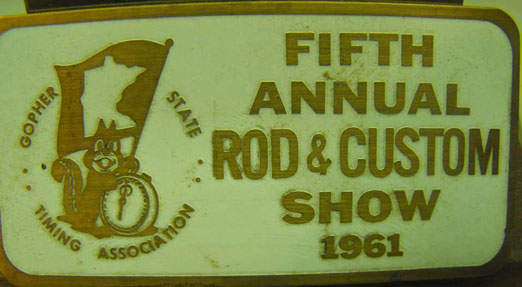
Key Club Shows: 1961
Key Club Shows:
- Earl Bostic, November 14, 1961
- International Jazzmen, November 20, 1961
- The Flamingos, November 24-December 3, 1961
- Bill Doggett, December 4, 1961
In December 1961 the Twist had hit and the Key Club was on top of it. Will Jones reported on December 18 that:
It was a wild, wild night at the Key Club. Bill Doggett’s twist music proved so infectious one woman patron jumped onstage and began to strip which isn’t exactly the idea. The management hustled her off.
On December 22, 1961, an ad in the Minneapolis Spokesman says “It’s Twisting Time at the Key Club – Learn to Dance the Twist with the Hortense Allen Dancers and the Bill Pinkard Combo. Dance on the largest nite club dance floor in the Twin Cities.” Also featured was Harold Connors, blues singer formerly with B.B. King.
“Twist” Night: 1962
On January 5, 1962, dance instructor David La Vay held an all-city “Twist” Night at the Marigold Ballroom featuring that perennial rock ‘n’ roll group, Mike Waggoner and the Bops.
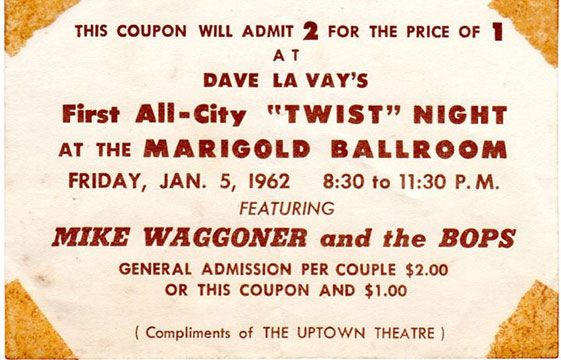
Twist Around the Clock: 1962
On January 12, 1962, the film “Twist Around the Clock” came to the Lyric theater on Hennepin Ave. near 7th Street.
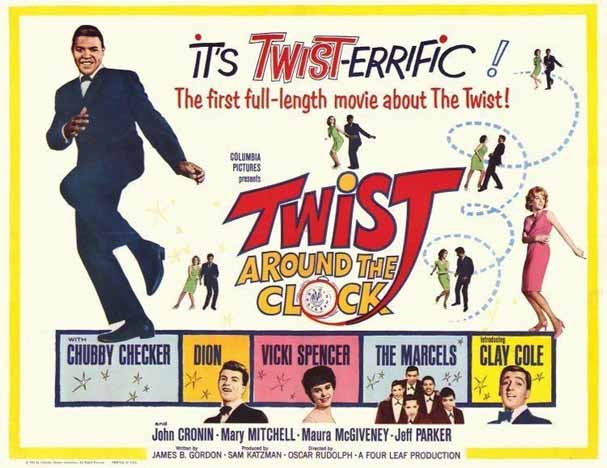
Events: 1962
St. Louis Park High held a twist contest on January 20, 1962, won by Jackie Dubbe and Jack Beaudoin. The Echo reported that the fad was wildly popular except that it led to horrible side aches, and advised twisters “not to eat anything before engaging in this dance, and those with weak hearts and stomachs should forget this madness.”
The Brothers Four appeared at Northrop Auditorium on January 13, 1962. It was a Greek Week Benefit Performance, part of the University Artists Course.
On January 30, 1962, Will Jones reported that the socialites and suburbanites had discovered the Key Club and invaded the place on weekend nights to be taught the dance by “those wild, wild” Hortense Allen Dancers.
Brook Benton appeared at Freddie’s on February 19, 1962 – the paper said he was mobbed when he was here several months ago.
The Kingston Trio appeared in town on February 22, 1962.
Sonny Thompson performed at the St. Paul Auditorium on February 27, 1962.
The Chad Mitchell Trio also performed in February 1962 at Macalester College.
WDGY sponsored a 17 lap (50 mile) run around Lake Harriet on February 17, 1962. The run was inspired by JFK’s famous phrase, “with vigah!”
Bob Dylan’s self-titled first album was released on March 19, 1962. It did not chart on Billboard, but was given a very positive review in Issue 22 of the Little Sandy Review.
The Brothers Four were at O’Shaughnessy Auditorium at the College of St. Thomas on March 30, 1962.
A weak form of competition was the Four Saints, appearing at the Padded Cell – “they’re WILD!”
Not quite sure, but Chubby Checker may have been here on April 20, 1962. (See May 3 below.)
Jerry Lee Lewis, possibly touring with Fabian, Bobby Vee, and Faron Young, was in Minneapolis on April 22, 1962, the day that his three-year-old son Steve Allen Lewis (named for the entertainer) accidentally drowned in the family pool at his home in Memphis. It was Easter Sunday.
On May 28, 1962, Vic Burton of the Minneapolis Daily Herald told this story in his Night Beat column:
FEAR, INCORPORATED: A Twin City newsman had just wrapped up a controversial story, expecting all along to hear loud cries of anguish from those the story affected. The day the story was was publicized, the reporter returned home and waited for the phone calls. A bit later in the evening the phone rang and a mysterious voice whispered, “Urgent … must know where to meet you. I have the $1,000 ransom money but we have to agree on the place. This is agent 11-30, I will contact you.” Then the mystery caller hung up, leaving a very puzzled and most disturbed reporter holding a buzzing receiver in his hand. With thoughts of cement buckets and rivers and long rides in big, black cars flashing through his mind, the reporter spent a rather sleepless night.
And since his music tastes are somewhat above the primitive stage, he hadn’t been listening to WDGY and didn’t know the phone call was nothing but a publicity gimmick.
In June 1962 the White House in Golden Valley had a new outdoor garden with an ice rink, where you could see the Robin Nelson Ice Show.
In June 1962 Excelsior was the scene of a four day “Jazz-Arts Festival” at the Minnetonka Center of Arts. One of the highlights was entertainment by teenagers in the Minnetonka area, including a twist contest won by Pam Witcher and Tom Punch. Doc Evans’ Dixieland band provided the music. The Minneapolis Daily Herald, which was picking up the slack during the Star and Tribune strike, featured kids doing the twist and the mashed potato at Excelsior Park. Barbara Linow (?) sang with Tom Sechrest’s band.
Sounds of Jazz ’62 – II: In late June the Walker Art Center Arts Council featured local composer-arranger Thomas Talbert, musician Irv Williams, and 11 other Twin City musicians at a concert on the south yard of the Walker Art Center (inside in case of rain).
Raunchy comedienne Rusty Warren began a two week stand at Freddie’s on June 19, 1962. She’s “Sin-Sational!”
Little Jr. Parker performed at Stem Hall on July 8, 1962.
On July 15, Club “15” presented a Benefit Matinee Dance for the NAACP Freedom Fund at the Union Hall on Ford Parkway.
The song “Summers in Minneapolis” was published in 1962 (copyright 1959). Words and music were written by Robert Kirkendahl.
Louis Armstrong came to town for the Minneapolis Jaycees’ Second “Music Under the Stars” concert series at Met Stadium on July 30, 1962. He came with a group of five musicians and a vocalist.
On August 1, 1962, Vic Burton’s Night Beat column in the Minneapolis Daily Herald (which was subbing for the Star/Tribune, which was on strike), described the Key Club’s Twist show, emceed by Leroy Watts. There were three women who demonstrated the dance: Helena DeCarlo, Penny Wallace, and Watts’s daughter, Cyoreta. They also got the audience up on the floor; one night Watts said they had 200 beginning twisters on the dance floor at one time.
Brothers Jerry and Irv Trestman opened Trestman Music Center in South Minneapolis in 1962. It later moved to St. Louis Park, at 5600 Excelsior Blvd. Irv died in 1985 and Jerry sold the business in 2007.
Johnny Cash was in town on September 8, 1962, performing at a “Private Function.”
Jimmy Reed and Lefty Bates performed at Stem Hall on September 9, 1962, presented by Royal Attractions. Leroy “Lefty” Bates was a Chicago Blues guitarist.
Gene Chandler appeared at the “Ford Local Hall” on September 30, also presented by Royal Attractions.
Bobby Darin was in town in October 1962.
On October 21, 1962, Twin Cities folk group the Yeomen recorded an LP called “Session One: The Yeomen.” The four 17-year-olds from Edina had been friends since third grade: Bob Finkenauer, Jack Otterness, Keith Critchlow, and Don Bennett. The record was a Minneapolis Junior Achievement project, and the recording engineer was David Hersk.
Miriam Makeba and the Tarriers gave a folk music show at Northrop Auditorium on November 3.
Johnny Mathis came to the Minneapolis Auditorium on November 9, 1962.
Ray Charles performed at the Minneapolis Auditorium Concert Bowl on November 19, 1962.
In December 1962, look in the sky for KDWB’s Santa Copter!
If you believe the Echo, ukuleles were popular in late 1962.
Dickey Lee played the Marigold Ballroom on December 26, 1962.
In a feature about where to hear folk singers around the country, Life Magazine’s December 14, 1962 issue reported that the Chad Mitchell Trio would be performing at Freddie’s Downtown from December 31, 1962 to January 12, 1963. It also recommended the Padded Cell (near beer) and Le Zoo (sing alongs).
Harlem Globetrotters: 1962
The Harlem Globetrotters were in town on February 25, 1962 for two big shows. The event also featured:
- Cab Calloway
- Two Table Tennis Stars
- Variety Show
The Mashed Potato: 1962
On March 3 Dee Dee Sharpe’s “Mashed Potato Time” hit the airways and reached #2 for two weeks on the pop chart and #1 on the R&B chart. The way it was explained to me is that you stomp your feet as if you were mashing potatoes.. The first song about the lowly tuber was “(Do the) Mashed Potatoes” by Nat Kendrick and the Swans, which reached #84 on the pop chart in 1960. This was a two-part instrumental done on the sly from his record company by James Brown (Kendrick was his drummer). More potato silliness was to follow, including one I can’t think of right now where the guy swoons about how romantic it was to do the mashed potato with you. Who thinks up these things? And who does them in a tux?
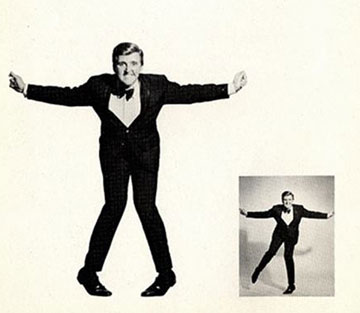
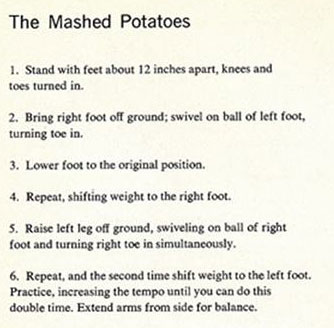
Northwest Boat, Sports and Travel Show: 1962
The Northwest Boat, Sports and Travel Show took place at the Minneapolis Auditorium from March 30 to April 8, 1962. A 15-act stage show took place twice daily, featuring these “Internationally famous entertainers:”
- Mike Serino, from Chicago
- Captain Schreiber’s Chimps, from Berlin
- Johnny O’Neill, Hollywood
- The Elkins Sisters, Vienna
- Loral I. Armstrong and Her Dogs, Anoka
- Willy Kee, Hollywood
- Rudi Sisters and Rudy, Paris
- Miller and Archer, New York City
- Flipper the Seal, Goodman, Missouri
The M.C. was Joe McKenna, from Orlando, and the show was backed by the Sportsman Show Orchestra.
The Loon Club: 1962
THE LOON CLUB hosted a series of big name acts in the summer of 1962:
- Jerry Lee Lewis, April 12
- Kalin Twins, May 6
- The Champs, May 7-13
- Bo Diddley, May 17-20 (he also played the Loon in May 1960)
- Preston Epps of “Bongo Rock” fame on June 10, 1962.
- Bill Haley and His Comets from June 11 through the 17th.
- Muddy Waters from June 18-24.
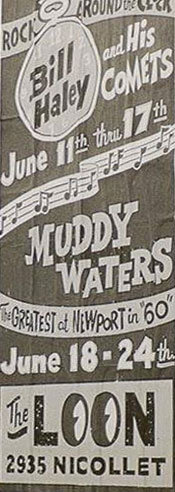
Ad posted by Eric Plumb
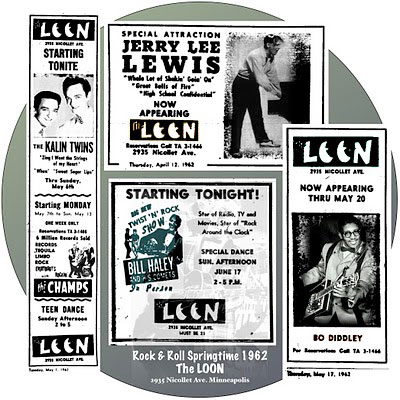
Collage courtesy Robb Henry
Blondie and Dagwood: 1962
Even Blondie and Dagwood were twisting in May 1962!
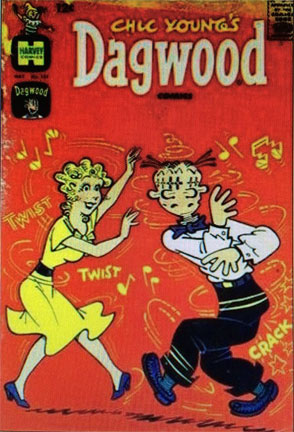
Twist Show: 1962
A big Twist show came to town on May 3, 1962, performing at the St. Paul Auditorium (7 pm) and the Minneapolis Auditorium (8:30 pm). Acts included:
- Chubby Checker
- Joey Dee and the Starlighters
- Gary (U.S.) Bonds
- Dee Dee Sharp
- The Dovells
- The Carroll Bros
- Plus Celebrities Twisting
- Extra! Bobby Gregg & Friends (Jam Part 1)
Danceland: 1962
May 12, 1962, was WDGY High School Fun Day & Night with music by Mike Waggoner and the Bops and the Doradoes from noon to five. Also on tap was a twist contest, with trophies to winners. “Three brave WDGY disk jockeys will try to break the world’s DJ roller coaster record of 47 rides.” That night at Danceland there was a Battle of the Bands, with the Ricochets and the Doradoes.
Big show on Memorial Day, May 30, 1962 at Danceland. For $1.85 you could see, hear, and dance to:
- Del Shannon
- Brian Hyland
- The Belmonts
- Jamie Coe (“Cleopatra”)
- Kenny Chandler (“It Might Have Been”)
- The Gigolos (Huh?)
Bill Diehl emceed the big July 4th Twistathon, to the music of the Champs.
The Twist: 1962
1962 was all about the Twist. Hank Ballard had recorded the song in 1959, and Chubby Checker covered it in 1960, when it reached #1, but somehow it came back with a vengeance in 1962, hitting #1 all over again.
Thank-Going Hop: 1962
KDWB gave an annual Thank-Going Hop at the Armory, with profits going to Cerebral Palsy. The November 23, 1962, lineup included the one and only Fabian! The way Steve tells it, he went just to get some pictures of girls. Well, there was a big accident on the freeway, and all the press, including the AP, take off to get pictures. Someone from KDWB sees Steve and asks him to take photos of Fabian for them. Unfortunately, Steve hadn’t counted on bringing extra batteries or film, so he could only get a few shots. Then he goes home to develop the photos, only to find that he had major problems with his developer. Says Steve, “This is the best I could salvage and would not even give them to KDWB.” Well, I think they’re great!! The DJ in the first picture is Hal Murray (thanks, Paul Hedberg!).
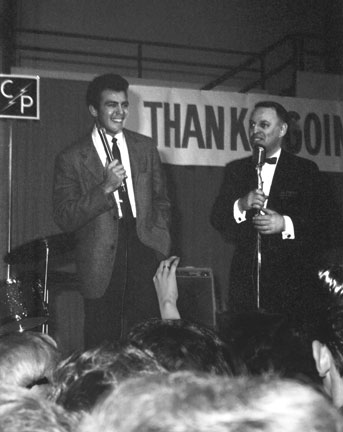
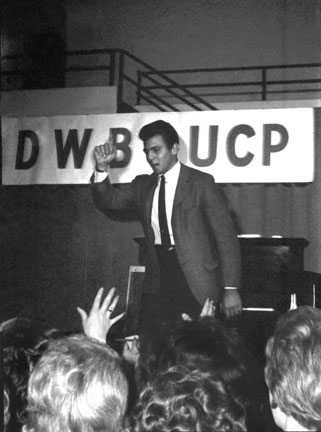
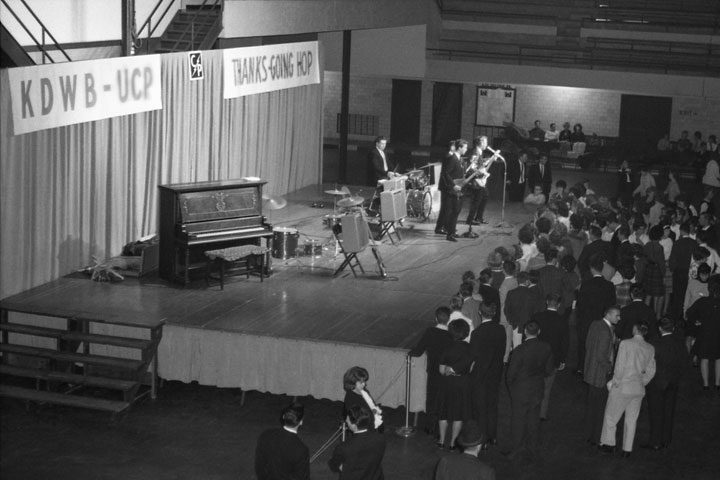
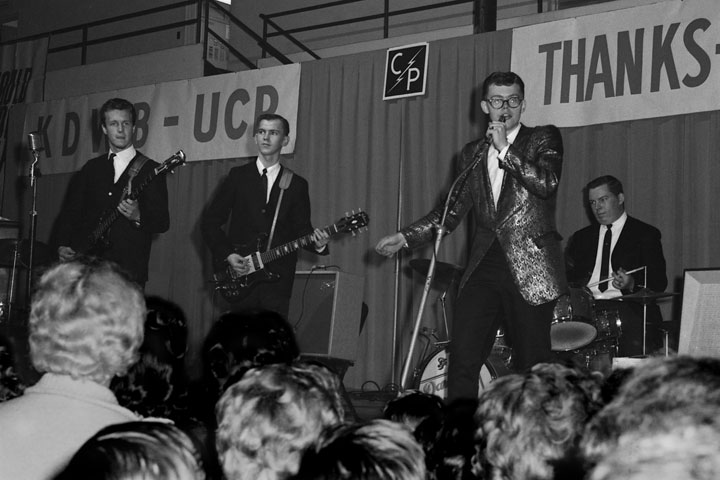
These last two are of Damon Lee and the Diablos, with Tom Nystrom on drums. Other possible members are Skip Dahlen, Ken Sand (lead guitar), Tom Weiss, and/or Bill Suech (bass).
Ninth Annual Upper Midwest Auto Show: 1963
The Ninth Annual Upper Midwest Auto Show brought in first class entertainment:
- The McGuire Sisters, January 11 – 14, 1963
- Rusty Draper, January 15 – 17, 1963
- Ricky Nelson, January 18 – 20, 1963
Special shows were “reinforced” by:
- Leo De Lyon, MC and comedian
- Jose Cole, equilibrist
- Frank Cammarata, organist
- Sasha Tormas, violinist
- Gordie Bowen’s 15-piece orchestra
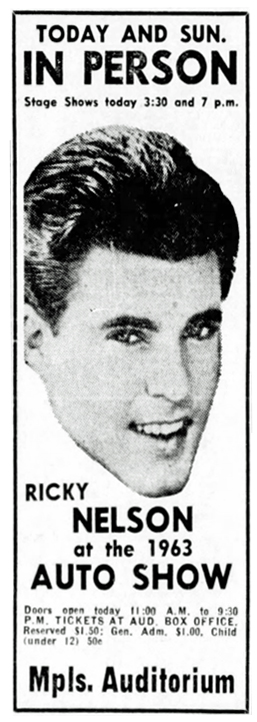
Minneapolis Tribune
Jim Matteson remembered:
Rick left after his set in a very showy (probably not very necessary) phalanx of cops – leaving Burton , the Bass player, and the drummer – all recognizable from the ends of Ozzie and Harriet T V episodes – to be their own roadies – so i went up on the stage and talked with them while they were packing up, bold as brass – real nice fellows.
Events: 1963
By March 8, 1963, Entertainment columnist Will Jones of the Tribune stated that the Twist was dying, but the Jockey Club, which had prospered during the Twist boom, responded by running a “4-girls-4” chorus line led by Gloria Bush, aka Sheena, aka Jerry. “What she devised is a half-twisting chorus line. Right now they’re twisting on an every-other-show basis, doing nontwist numbers the rest of the time, and rehearsing for the days when they may not twist at all.”
An ad announced the “50 Mile” Paper Dolls, Twisting With Vigah!” The reference was to a challenge to the Marines and to the citizenry from President Kennedy to walk 50 miles.
If 1962 was all about the Twist, 1963 was all about folk music. Or what passed for folk music. For if folk music was handed down from generation to generation, how could you write new folk music? Anyway, the movement became a fad, and the clubs advertised in the Minneapolis Tribune all touted their singers as folk singers, whether they were or not.
The Contemporary Folk Group was from Minneapolis, and almost hit the big time, performing at the Troubadour Club in Hollywood in February 1963. They performed at the Chalet in Crystal in June 1963. They also did “folk type commercials for Aunt Jemima, Quaker Oats, and B.F. Goodrich,” reported Will Jones. The group consisted of Dick Winther, Jerry Longie, Ed Knutson, and Jerry Goodge.
The Kingston Trio, Stan Getz and His Bossa Nova Quintet, and comedian Ronnie Schell appeared at the Minneapolis Auditorium on February 22, 1963.
The Harlem Globetrotters came to the Minneapolis Auditorium for two shows on February 24, 1963. Also on the bill were Cab Calloway, five undescribed variety acts, and two table tennis stars.
The Dave Brubeck Quartet appeared at the Macalester Field House on March 15, 1963.
The Northwest Builders Show took place at the Minneapolis Auditorium from March 15-24, 1963, with appearances by Jimmy Dean, the Skeets Trio, the Ashtons, and local announcer Howard Viken. The troupe did 19 shows in the two weeks.
The Northwest Boat, Sports & Travel Show took place from March 29 to April 7, 1963, and an ad boasted a 15-act stage show of Internationally famous entertainers, but no location or list of acts was provided. Two shows were to be presented per day.
Will Jones is hilarious. In May 1963 he told a long story about how the Musicians’ Union was giving clubs a hard time, and in response many were pulling their live music and bringing in:
that Parisiann phenomenon, the all-record night club. There’s already a modified version of it in the Lipstick Lounge at the rear of the Black Angus restaurant. After pianist Joe DeMarsh was given his notice in the middle of the hassle with the musicians, the Lipstick Lounge took out its piano and installed a hi-fi record player in the piano bar, with a girl disc jockey behind it..
The girl in charge of records is Kay Clark Nygaard, who for disc-jockey purposes is being billed as K.C. Nygaard. The curvy Mrs. Nygaard is a bit of a kook with a big toothy smile and a pair of Ben Franklin glasses that tend to slide down her nose. She was three hours late for work on her opening night because she had trouble selecting just the right dress…
The requests ran to Brubeck and Jamal and Kenton the night I visited the Lounge. Sometimes Mrs. Nygaard vocalized along with a record, and once she stood on the bar and twisted, but mostly she just sat smiling and wiggling and making sly little comments to the customers..
Will Jones, May 26, 1963:
All right, folk-music faddists, hear this:
Folk singer Pete Seeger, a recent visitor, observed that Minnesota’s folk music is the so-called old-time music played by the polka and oompah bands hereabouts. New Ulm, Minn., for example, is a hotbed of folk music.
“It really means,” observed folk singer Maury Bernstein, “that Whoopee John is our Leadbelly.”
There you are, kids. If you’re really with it, you’ll start demanding to hear the Six Fat Dutchmen and Fezz Fritsche and Elmer Scheid and all the rest of those cats in your favorite coffeehouses. Or is it only folk music from some other are that has the snob appeal.
WDGY DJ Bill Diehl appeared at a Record Hop at the Lucky Twin Drive-In on June 15, 1963. The Lucky Twin, located at 35 W and Highway 12, featured two Elvis movies (I hesitate to say films) that night: “Girls, Girls, Girls” and “Blue Hawaii.”
Oh to be young on June 19, 1963:
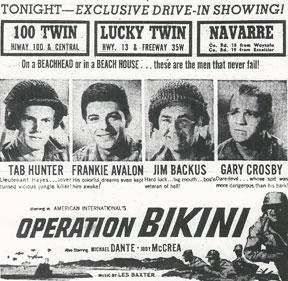
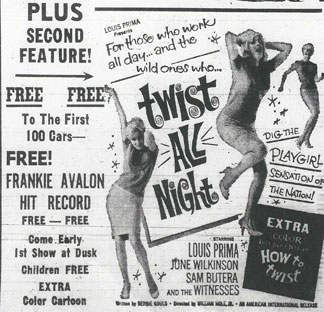
This is too funny: There is an ad for Breezy Point Lodge (on Big Pelican Lake) and the Co-Owner and Developer is Ginny Simms – Kay Kaiser’s girl singer! It gets better: the Convention Director is… Ish Kabibble! This is not a joke!
Fred Waring and His Pennsylvanians came through with their “Wonderful World of Music” tour on July 1, 1963, at Met Stadium. Included on the tour was our own Miss Betty Ann McCall, accordionist extraordinaire and runner up to the Miss Minnesota contest in 1959. It was part of a “Music Under the Stars” series sponsored by the Minneapolis Jaycees.
On July 6, 1963, the Lucky Twin Drive-In Theatre (35W and Highway 12) featured a DANCE-DANCE-DANCE with Bill Diehl (“N.W.’s Top Disc Jockey”) and Mike Waggoner and the Bops. On the screen was “The Cool and the Crazy.” The IMDB only shows a 1958 movie by this name, with the plotline: “High school thug is front man for a local marijuana ring.” Hard to believe Bill Diehl would be associated with that – although he was tops with the teens, he was secretly a square!
Harry Belafonte and a cast of 32 came to the St. Paul Auditorium for five days on July 9-13, 1963.
In about July 1963 Ann Oleson and Genie Evans bought the Scholar, and celebrated with (what else?) a Hootenanny.
Hootenanny ’63 (no details) happened at the Minneapolis Auditorium on July 26, 1963.
Al Hirt and his New Orleans Jazz Group appeared at Met Stadium on July 29, 1963. It was part of a “Music Under the Stars” series sponsored by the Minneapolis Jaycees. Also appearing were the Schmitz Sisters.
Meat-packing heir Geordie Hormel was a regular singer at the White House in Golden Valley. He’d had his own club, King’s Wood, apparently in Austin, but it failed. Hormel was apparently a real character.
On September 17, 1963, you could go to the St. Paul Auditorium Arena and – if you wanted to – you could Sing Along With Mitch. Also on the ticket were Leslie Uggams and 50 singers, dancers, and musicians.
Will Jones reported that Bob Hope promised a hootenanny to end all when he introduced the team of Hoot, Nanny, and Hope on his comedy special on September 27, 1963.
McGuire’s Restaurant and Lounge, not normally a place for young people, featured the Folksinging Voyagers in September 1963. Gene Bass and Bob Monfort sang calypso, songs from Israel to Ireland, American Ballads, comedy and novelty numbers.
Nat King Cole appeared at the Minneapolis Auditorium on October 30, 1963, with the Merry Young Souls and Joe Zito’s 19-piece orchestra.
In 1963 WDGY DJ Bill Diehl was the emcee at a Halloween dance at the St. Louis Park Roller Garden featuring the Trashmen, who had released their national smash hit, “Surfin’ Bird” earlier that month. Expecting about 800 kids, an estimated 2100 showed up. The enthusiastic crowd pushed in the building’s glass door, and Diehl had to call the police department and hire 5-6 members of the local constabulary to keep the peace. Even at only $2 a head, money was made hand over fist, stuffed in wastebaskets and whatever they could find. Diehl had promoted the dance in partnership with his brother, who was a plastic surgeon. So much money was made that his brother was ready to quit his practice and keep promoting dances, but the next three turned out to be flops, so he returned to facelifts. See more about about the Trashmen here.
Jack Benny appeared with the Minneapolis Symphony Orchestra at Northrop Auditorium on November 7, 1963. Benny did 7-8 of these benefit concerts a year. The reviewer in the Tribune was not impressed with Benny’s… anything, and said that conductor Stanislaw Skrowaczewski was mean to him, but it was probably all in the act, since Benny was said to be hilarious. Which shows that he is a pro, since days before his wife had been robbed of $250,000 in jewels in her hotel room in New York City and he was hopping mad. Mary Livingstone was unharmed and the jewels were insured.
Perhaps the first mention of the Beatles in a Minneapolis paper appeared in the Tribune on November 10, 1963, with a UPI story dateline London. The article was couched as a fairy story and kind of made fun of them, except that it was quite impressed that the group was making $14,000 a week.
The Beatles, who just a year ago were making only about $50 a week, have turned Britain topsy-turvy with their brand of music, called the ‘Mersey sound,’ the ‘Liverpool sound,’ ‘Beat with a Drive’ and ‘Pop with a beat.’ …. In recent weeks, police in cities throughout Britain have become engaged in almost uncontrolled warfare with thousands of young fans…
The Ahmad Jamal Trio appeared at the Macalester Fieldhouse on November 16, 1963.
Beach Boys at Danceland: 1963
Click here for this epic event that took place on May 3, 1963.
Teenagers Underground Music Society: 1963
WTCN’s 1963 Annual Report published an article from Variety that said that some of the radio station’s “elder rock ‘n’ roll stamper outer staffers” had formed the “Teenagers Underground Music Society,” with a membership of 2,000. The station
avowedly largely confines its programming to only “the sound of beautiful music,” which means the higher quality melodies, and the Society in line with a current campaign to bring youngsters into its listeners’ fold.
In order to join the Society “underground movement” the teenager is required to sign a pledge not to mention Chubby Checker in young children’s presence, to slip “Sheherazade” on the turntable at any Twist party when they shouldn’t be, but happen to be present, and to register complete disgust at any Elvis Presley mention (boooo), etc.
Called “music jungle fighters,” members are enlisted in such “underground units” as the “Beethoven Brigade,” “Bach Battalion,” “Dvorak Division,” and “Puccini Patrol.”
The Chad Mitchell Trio appeared at the Minneapolis Auditorium Concert Bowl on May 17, 1963. Franklin Hobbs of WCCO radio was the emcee. The concert was promoted by William A. Meyer, a U. of M. student.
The Freewheelin’ Bob Dylan: 1963
“The Freewheelin’ Bob Dylan” was released on May 27, 1963. Although his first LP failed to chart, this second release reached Number 22 and was on the Billboard chart for 32 weeks. This time the Little Sandy Review was quite unkind, using such phrases as:
- melodramatic and maudlin
- affected and pretentious
- strangely foppish manner of singing
- dull and monotonous
- bad beatnik poetry
- no logical continuity or point
- wacky verses
The LSR didn’t count Dylan out, but hoped that he would veer closer to his folk roots. It also reported that some copies were released that omitted “Girl From the North Country,” “Masters of War,” “Bob Dylan’s Dream,” and “Talking World War III Blues” and instead included “Rocks and Gravel,” “Let Me Die in my Footsteps,” “Gamblin’ Willie’s Dead Man’s Hand,” and “Talking John Birch Blues.” Collectors items?
Sam Cooke Show: 1963
On June 1, 1963, The Sam Cooke show came to the Minneapolis Auditorium Concert Bowl, with Gorgeous George as emcee. Featured acts were:
- Jerry Butler
- Dee Clark
- The Crystals
- The Drifters
- Little Esther Phillips
- Solomon Burke
- Dionne Warwick
- Johnny Thunder
- Little Julius High
- The Upsetters Band (Little Richard’s old band)
Six Days on the Road: 1963
“Six Days on the Road” by Dave Dudley made its debut on the Billboard pop chart on June 8, 1963. The song was recorded at Kay Bank Studios. Released in mid-May 1963, went to Number 2 on the Billboard Hot Country Singles chart that summer. The record peaked at Number 32 on the Billboard Hot 100. It also reached Number 13 on Billboard‘s easy listening chart. From a web site that has since gone away:
Songwriters Earl Green and Carl Montgomery were a pair of over-the-road drivers for Robbin’s Floor Products in Tuscumbia, Alabama, who made a regular six-day run to Pittsburgh with a load of floor tile. With a guitar along for the ride, the pair penned a factual account of their experiences, as they consumed amphetamines (“little white pills”) to stay awake and tried to dodge ICC inspection stations (“I’m a little overweight and my log book’s way behind”). The song’s gear jammer jargon also refers to specific truck models (“Jimmy” is a nickname for GMC, while “White” was a popular brand now owned by Volvo) and driving techniques (“Georgia overdrive” is a slang term for neutral). Greene and Montgomery recorded a demo of “Six Days on the Road,” which they slipped to Cajun singer Jimmy C. Newman during a visit to the Grand Ole Opry. Newman didn’t think the song suited his style and had Nashville publisher Jimmy Key pass the tape on to their mutual friend Dave Dudley, in Minneapolis, who stashed the song in his guitar case. The last minute addition also worked to the strength of teen guitar sensation Jimmy Colvard, who did his best Duane Eddy impression.
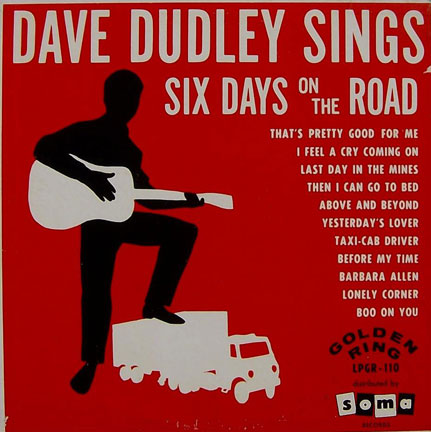
Unfortunately, according to Dudley, both Colvard and Montgomery committed suicide. About Colvard, Sherwin Linton remembered:
Jimmy moved to Nashville and became a top studio player there and was also a member of the name band “Barefoot Jerry”. In 1975 he went into the North Woods in Minnesota and took his life. Warner Brothers produced a two page ad in his memory in Billboard Magazine. That was a great recognition.
About Montgomery:
he was hoping that he could always write songs as big as “Six Days” and I guess it just kind of overwhelmed him and he never could live up to that expectation again. It just got to him. (Do You Hear That Beat, Gary A. Myers, Page 24.)
Play it Cool: 1963
The British movie “Play it Cool” was released here at the Lyric Theater on June 13, 1963, featuring Brits Helen Shapiro and Billy Fury and Fargo’s own Bobby Vee. Couldn’t find much of a plotline, but here’s the trailer.
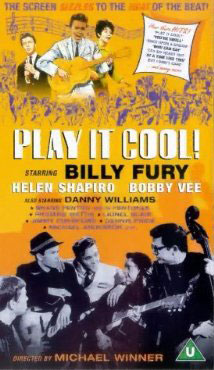
Mercury Records: 1963
Will Jones reported that Mercury Records released seven folk albums at once:
- The Smothers Brothers
- Knob Lick Upper 10,000
- Inman and Ira
- Flatt and Scruggs
- Josh White
- The Couriers
- Sheldon and James
A Song for Minneapolis: 1963
What you can learn on Facebook: In about 1963 the Minneapolis Chamber of Commerce ran a contest to write a song about the city. The winning entry, “A Song for Minneapolis!,” was written by local resident Dick Wilson and composer Ray Charles, who led the choral group the Ray Charles Singers (“Love Me With All Your Heart”). The two had also written “We’re Gonna Win Twins.” Hear it on this web page from Hymie’s Vintage Records.
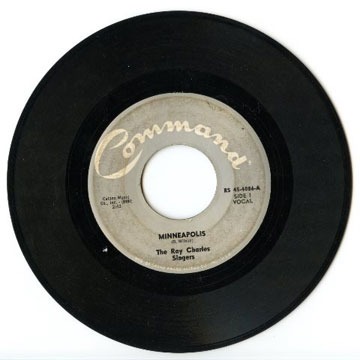
Doris Hines: 1963
1963 was the year that New York native Doris Hines came to the Twin Cities. Doris’ talent was discovered early when she won an Arthur Godfrey Talent Scouts Show. (Photo below left) Over her long career, she performed with or opened for Sarah Vaughan, Ella Fitzgerald, Maya Angelou, Duke Ellington, Dinah Washington, Harry Belafonte, Nat King Cole, Freddy Cole, and Illinois Jacquet. Doris came to Minnesota for a two week performance; the job was held over for two years, and Doris decided to stay, becoming a familiar performer at such local venues as The Sheraton Ritz, The Point, The Key Club, Ruby’s Cabaret, Big Al’s and The Sherwood. She also brought her talents to the stages of the Guthrie, Ordway, Orchestra Hall, Orpheum Theater and Penumbra Theater, and sang with local legends Percy Hughes and Irv Williams. She was the first African American woman to be seen in a Minnesota television commercial, appearing in Northwestern Bell’s “Get Out of Town Fast” long distance promotion. Doris has six children, including Gary Hines, director of the acclaimed ensemble Sounds of Blackness. The 1970 book Minneapolis Negro Profile by Walter R. Scott, Sr., said about Doris: This vivacious local young vocalist is known as a Brown Bombshell in the business with torrid vocals and heart-stirring soul music renditions.” See a 1980 performance here. Doris was inducted into the Minnesota Rock/Country Hall of Fame in 2010 and also a recipient of a Minnesota Black Music Award. Thanks to Gary Hines for providing this information.
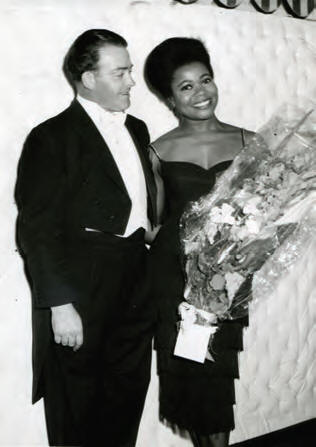
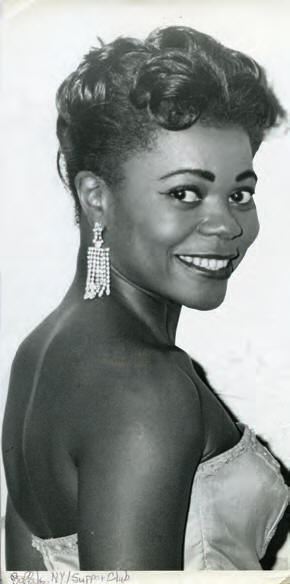
Meade Lux Lewis: 1963
Will Jones of the Tribune reported that Meade Lux Lewis was drawing crowds at the piano bar at the Chateau de Paris in the Dyckman Hotel every night. (August 23, 1963) He was either still there or there again in October.
Although the Lewis name has been associated with boogie-woogie, and although Lewis plays boogie from time to time to satisfy those who request it, his better offerings are unmistakably up-to-date. Lewis clearly is a man who listens to contemporary jazz sounds with appreciation, who keeps producing new ideass of his own, and who combines and performs them all with the ease and taste and authority or a solid musician who has been on the scene for a long time.
Beach Party: 1963
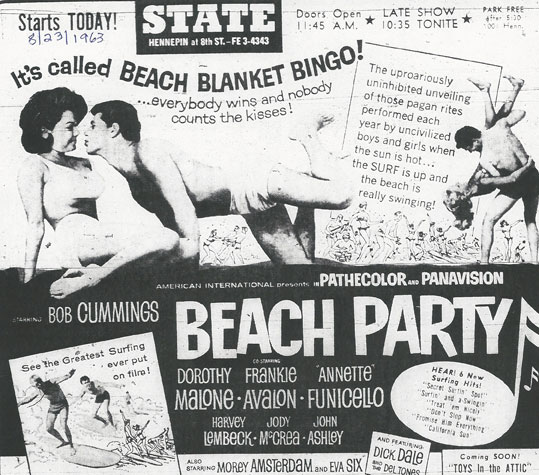
July 23, 1963
Route 66 in Minneapolis: 1963
The cast and crew of the hip show Route 66 came to town in July 1963 to film three episodes in Minneapolis. By this time Tod Stiles’ (Martin Milner) original traveling companion, Buz Murdock (George Maharis) has been replaced by Lincoln Case (Glenn Corbett) because Maharis came down with hepatitis. Will Jones reported that the filming took a crew of 60, plus 15 or 20 wives and a couple of dozen children of crew members who travel with the show during the summer. Filming the three hour-long episodes was expected to take about a month. The whole crew stayed free at the Sheraton-Ritz Hotel, which was a prominent locale for the first episode.
On July 25, 1963, the Minnetonka Record reported that the crew had been to Parade Stadium and in Excelsior the week before. On August 1 the Record reported that hundreds of onlookers crowded the Excelsior shoreline last week to watch the cast and crew work at the Amusement Park and the Mark Knowlton home in Excelsior. More scenes were being taken at a Hopkins raspberry farm, it reported.
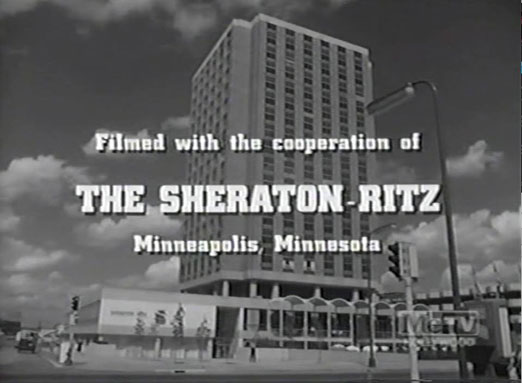
The episodes were:
- “Where Are the Sounds of Celli Brahms?” aired October 18, 1963. As Tod and Linc drive across a bridge into Minneapolis they are stopped and told that they are the millionth visitors of the season, qualifying Linc (who is driving) to be a judge of the Aquatennial Queen contest. Tod gets a job at the Sheraton-Ritz. They meet Celli Brahms (Tammy Grimes), a no-nonsense career girl whose job is to soundproof the hotel. A girl from a poor family enters the contest and wins, according to Jones.
- “And Make Thunder His Tribute,” aired November 1, 1963. Tod and Linc find work with an eccentric farmer. He is at odds with his son about using any new farming ideas and actually uses a shotgun for noise to scare birds away from his crop. The son and he escalate the battle between them over the possible use of the farm as the site of a motel.
- “Kiss the Monster – Make Him Sleep, aired January 24, 1964 (originally scheduled to air November 22, 1963). “Tod and Linc are in Minneapolis working in construction on a river lock project. Linc becomes “involved” with the sister of their boss. She resents her brother being overprotective and buying off her men friends. Linc tries to help her make it on her own but later finds she has neuroses involving dependency and nymphomania.” (synopsis from imdb.com)
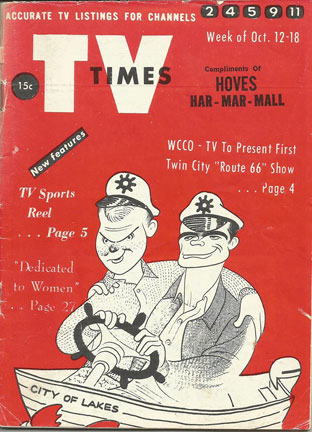
TV Times image courtesy Jeff Lonto
Ray Charles: 1963
Ray Charles appeared at the Minneapolis Auditorium on October 6, 1963. Joann Neumer, reviewer for the Echo, was NOT impressed:
[His] inimitable styling was at rock bottom…. His “Big Band Sound” was too big. “Georgia on my Mind” put half the audience to sleep and they were still a bit groggy when he wailed out a half-hearted rendition of “What’d I say.” This wasted evening hid its consolation, however.
After the performance – one one of those spur-of-the-moment things – a friend and I wheedled Ray’s “valet” into letting us talk with the “High Priest.” We found ourselves the next day in the Nicollet Hotel for a four hour jam session with Ray, his band and the Raelettes.
Small and wiry, Ray Charles is not the dynamic figure he is on record. Nervous to the point of being antsy, his raspy drawling voice made quoting him impossible. His singing and speech projection are at two different levels, sadly enough.
Stamina and durability are his two main assets. After his Minneapolis concert, he sat up until 6 in the morning cutting and arranging the contents for his appearance in Iowa and Tennessee. As he is extremely moody, he is also unpredictable. Changing beats in the middle of a song account for his sometimes mediocre performances.
American Outdoor Hootenanny Festival: 1963
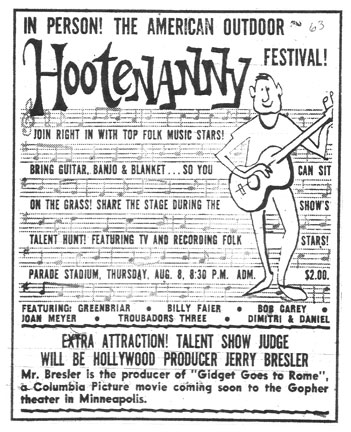 On August 8, 1963, the traveling American Outdoor Hootenanny Festival came to Parade Stadium, produced locally by Ray Colihan. Participants were encouraged to bring their guitars, banjos, and vocal chords (and $2), sit on the grass, and be discovered in the talent hunt. Then it turns out that the first two hours featured “TV and Recording Folk Stars,” including:
On August 8, 1963, the traveling American Outdoor Hootenanny Festival came to Parade Stadium, produced locally by Ray Colihan. Participants were encouraged to bring their guitars, banjos, and vocal chords (and $2), sit on the grass, and be discovered in the talent hunt. Then it turns out that the first two hours featured “TV and Recording Folk Stars,” including:
- The Greenbriar Boys
- Bill Faier
- The Troubadours Three
- Bob Carey
- Joan Meyers
- Dimitri and Daniel
Only then it was time for the amateurs. That made it 10:30 p.m. on a Thursday night so how many folkies were discovered that night is unknown… The top prize for original material was a publishing contract with Davidson Country Music.
Chancellors: 1963
More St. Louis Park music, this time Rock ‘n’ Roll! In September 1963 the Chancellors played a dance at St. Louis Park High School. This photo from the yearbook isn’t very good but it’s all we have. Dave Rivkin and John Hughes were from Park. A previous iteration of the band called the Continentals had played at Park High that spring.
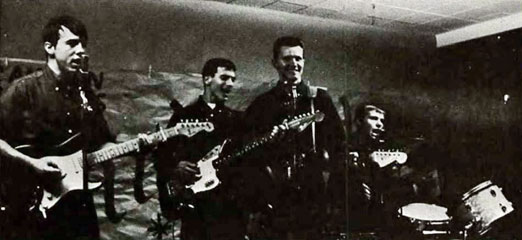
Irv Letofsky: 1963
Irv Letofsky, subbing for Will Jones, started his October 7, 1963, column: “I was sitting around the living room the other morning waiting for folk singing to die. I was hoping they would kill each other off. But now they’ve collected into hootenanny gangs and proliferate.” He goes on about the latest Peter, Paul and Mary album, which contains three songs by “22-year-old Bob Dylan, the sulking Minnesota expatriate. Of these, two are inconsequential” [that would include “Don’t Think Twice It’s All Right”] but he was duly impressed with “Blowin’ in the Wind.” “Anyone who watched the TV coverage of the civil rights march on Washington and heard Peter, Paul and Mary sing it before the quarter million demonstrators must have been touched. It was haunting. If nothing else survives this era of social protest after all the profits are taken out of it, this one may.”
More Irv Letofsky (he’s funny), October 11, 1963: “I was trying to do my bit to help drown out folk singing – when I’m besieged. Two young nuts named Gary Flanders and Bob Liebo went into the booking business through Metropolitan Enterprises, they call it. Their first effort will be the Midwest Hootenanny, they call it [October 12] at Convention Center in Bloomington.” Stars:
- The Travelers Three
- The Contemporary Folk Group, a rising local company
- Maxine Sellers
- Robert Glaze – the last two singers from Chicago
Hootenanny For Dancers: 1963
From the St. Louis Park Echo, September 1963:
Hootenanny For Dancers
What is a hootenanny? The dictionary’s slang definition is “a meeting of folk singers, especially for public entertainment.”
On September 14, St. Louis Park’s first hootenanny was presented by the Parkettes to raise funds for their planned tour of Europe next summer.
The almost four-hour festival provided entertainment for everyone who paid his $1.50. There was a wide range of folk music as well as the dancing of the Parkettes.
The show was opened with the Parkettes dancing, followed by the master of ceremonies, Hal Murray of radio station KDWB. The Contemporary Folk Group was the first of the folk singers, followed by The Countrymen.
Maury Bernstein was next, playing his accordion and telling jokes. The Flinthill Singers from Washburn High then entertained with the Goldbriers following. After the intermission, The Bondsmen, Jeff Espina, The Blues Stompers and Gary Holmberg entertained.
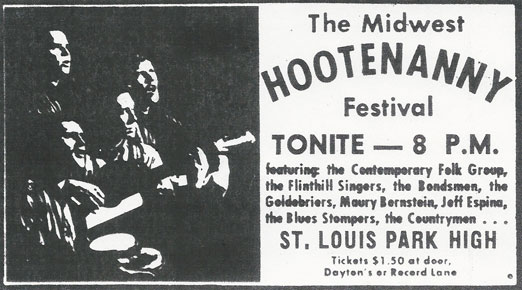
Hootenanny Hoot: 1963
In October 1963 there was something called the Hootenanny Hoot at the Orpheum Theater. This was a remake of a remake of a remake, filmed in black and white on the MGM backlot in nine days. No matter that half the folk artists were really country stars. A big budget Sam Katzman production.
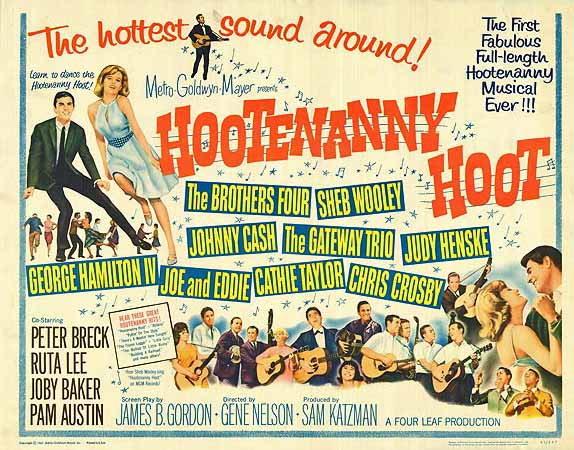
Hootenanny TV show: 1963
Jack Linkletter, host of the national “Hootenanny” TV show, brought a traveling show to the Minneapolis Auditorium on October 22, 1963, featuring:
- The Big Three (perhaps including Mama Cass?)
- Joe and Eddie
- Les Baxter’s Balladeers
- Raun MacKinnon, an 18-year old self-taught guitarist
Inter-University Hootenanny: 1963
An Inter-University Hootenanny was planned for the Minneapolis Auditorium on November 10, 1963, but it was cancelled because of a disappointing advance sale. (Dan Sullivan, Entertainment News, Minneapolis Tribune, November 17, 1963) It was to feature:
- The Clancy Brothers
- Tommy Makem
- Oscar Brand
- Judy Collins (buried in the list)
- Josh White, Jr.
- Jean Ritchie
Folk Music Revival Has America Singing – And Minneapolis Strums Along: 1963
A feature in the Tribune dated November 10, 1963, by Allan Holbert was titled “Folk Music Revival Has America Singing – And Minneapolis Strums Along.” He reported that the fad had pushed guitar sales to more than 400,000 last year, leaving some manufacturers backordered as much as two years. [Just wait ’til the Beatles hit!] “One reason for the new popularity is the wide range of songs, styles, messages and performers that can be included under the term folk music.” “Folk music in Minneapolis is the Monday night hootenanny at the Padded Cell, a night spot that formerly booked jazz and now offers folk music every night.” Local groups were the Flinthill Singers from Washburn High School and the Yeomen from Edina High School, who put out a record but broke up when it was time for college. Local groups going for professional status were the Contemporary Folk Group and the Goldbriars. Guitar store owner and teacher Rollie Williams reported that kids wanted to trade in their electric guitars for acoustic models. Performers around the U of M highlighted in the article were:
- Dave ‘Snaker’ Ray, “a shaggy-haired white student who sings Negro blues as few non-Negroes can. ‘Blues Rags and Hollers,’ an LB album recorded recently by Ray, ‘Spider’ John Koerner and Tony ‘Little Sun’ Glover, has been selling briskly to traditional fok music fans throughout the country.”
- Jeff Gilkenson, John Hay and Rod Bellville, “three students who sing bluegrass, a kind of hillbilly style, under the collective name of The Down and Outfit. They accompany themselves on guitar, banjo, fiddle and a cheap cello that’s plucked like a bass.”
- Jeff Espina, “the son of Spanish immigrants, whose guitar technique and voice are highly regarded by both performers and fans around town.”
- Maury Bernstein, “who describes himself as an international folksinger. He isn’t quite sure whether he’s more interested in being a folk musician or a folk musicologist. He sings in 19 languages, but he looks more like the musicologist than the successful commercial folksinger of today. He wears tweedy old sport coats and bow ties instead of bright button down shirts. His long curly hair would look ridiculous with an Ivy League trim, and he plays not a guitar, but an accordion.”
Johnny Mathis: 1963
Johnny Mathis, with Sy Zenter and His Nationally Famous Orchestra, played the Minneapolis Auditorium on November 15, 1963. Zola Thompson has this memory:
My parents lived on E. 16th Street and must have been taking care of our two little ones (born in 1960 and 1963). My husband and I passed the parking lot on the east side of the auditorium late and were flagged down by a black man, all alone in the lot with the hood up on a new black Cadillac. He said his car wouldn’t start. We told him about a gas station/garage on about 14th Street and 4th Avenue. We could see it from the lot. The owners lived next to it or above the garage. Wish I could remember their names but were well known in the neighborhood. Then the man told us his name was Johnny Mathis and he’d just finished a show at the auditorium.
Kennedy Assassination: 1963
We have three accounts of what happened musically on that tragic day when President John F. Kennedy was assassinated in Dallas on November 22, 1963.
THE UNDERBEATS
Rod Eaton of the Underbeats provided this account of the night:
This Underbeats poster hung on the wall in Jim Johnson’s home studio. How it got there is an interesting story. As the band got rolling back in 1963 people asked for posters to advertise our appearances. So I made some. One of our early gigs was at Osseo High School. The contract was signed by Terry Santo – a student. November 22nd was a Friday – the day President Kennedy was shot dead in Dallas. We assumed the dance would be cancelled. But the students and teachers agreed it would be a good thing to proceed. As we were setting up in the school gym, someone – it may have been Terry – asked us to begin by playing the National Anthem. The Anthem isn’t an easy piece for a guitar band. This was well before Jimi Hendrix turned it into a piece of Woodstock history. But Jim [Johnson] worked through the chords and, with some drum rolls and cymbal crashes from me, led the kids in singing our National Anthem. That moment is vivid in my memory.
After the dance Terry took this poster home. Thirty or so years later she became friends with Jim and offered him the poster. At the time Jim had no place to hang it. He asked Terry to keep it for him. A short while later Jim moved into his own home. Terry again offered him the poster – and it was hung on Jim’s wall. Thanks for telling me the story, Terry.
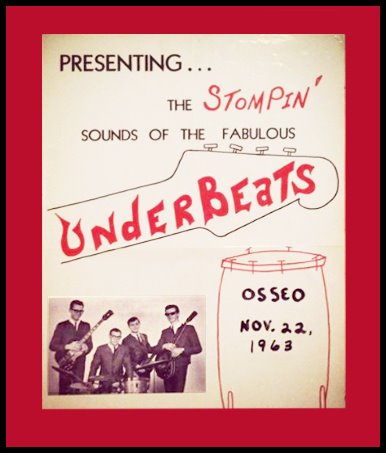
Image courtesy Underbeats Facebook Page, via Rod Eaton
MYRON LEE AND THE CADDIES
Myron Lee and the Caddies was an early rock ‘n’ roll group from Sioux Falls. On the 50th anniversary of the assassination of President Kennedy on November 22, 1963, Myron posted this story on Facebook:
In early November of 1963, 58 people met at a New York City hotel for the Dick Clark Caravan of Stars Tour. The next morning we boarded two buses for a short trip across the river to Teaneck, New Jersey, where we rehearsed 12 acts doing 6 songs each. This lasted about five hours and then it was time to change clothes and do our first show to start a six week tour. I knew who the acts were in advance so we had already done a lot of work on the songs before we left Sioux Falls. Myron Lee and The Caddies were on Bus #1 with Dick Clark sitting up front across from the bus driver. Some of the stars on the show were Brian Highland, The Ronettes, Paul and Paula, The Thymes, Little Eva, Freddie Cannon, and Bobby Vee was the headliner. Del Shannon joined us for a couple of shows and The Rolling Stones did two shows with us in Philadelphia.
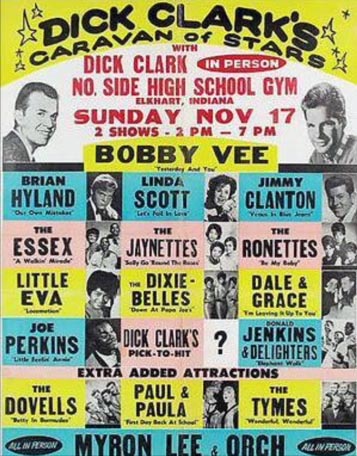
Courtesy of Myron Lee
By November 20th we had traveled down the east coast and across country, arriving in Sioux City, Iowa, to do a show in the auditorium that night. The band and I looked forward to this date because a lot of family members came to visit us and enjoy the show. It was a GREAT show and the band was tight with great musicians. Jerry Haacke – bass, Curt Powell – lead guitar, Stu Perry – drums, Fred Scott – sax, and Joel Shapiro – sax.
On November 21st we did a show in Wichita, Kansas, drove all night and arrived in Dallas, Texas around 10AM on November 22nd, 1963. We checked into a downtown hotel and the plan was to get some sleep before the night show. I was brushing my teeth and planned on getting some sleep when an announcer on TV stated that the president’s motorcade would be arriving in about 30 minutes and the parade route was just two blocks from our hotel. I called Brian Highland who had a room next to mine and asked him to join me. We were so excited in 1963 to have a chance to see the President of the United States up close and just a few feet away. There were people lined up on both sides of the street as far as you could see. We could spot that black limo two blocks away and all of the sudden there they were right in front of us. We felt and wanted to believe that the Kennedys were looking right at us as they smiled as waived their hands in our direction. We were ready to head back to the hotel when we spotted a sign that read Nieman Marcus so we decided to check it out. Just as we were about to enter the store, we heard what we thought were firecrackers.
Never in our wildest dreams in those innocent times would we think we were hearing gun shots three blocks away. We entered the store and there was a little television set on the counter near the cash register. All of the sudden the screen showed “News Bulletin.” A local TV personality came on and said “It is believed that gunshots have been fired at the presidential motorcade.” A few seconds later, Walter Cronkite came on and read that very emotional statement we’ve all seen many times. Brian and I, the city of Dallas, and people all over the world were in shock. We quietly walked back to the hotel not saying much. For the rest of the day and night, all we heard were sirens. Later on that afternoon we watched TV as Air Force One took off to fly back to Washington, DC. I could see the plane on TV and I also spotted it live out of my hotel window as it disappeared into the clouds.
After this happened the show that night was canceled of course and the next two dates also. One of those dates was Nashville, which I so much was looking forward to. I’ve always had a special thing for Nashville and country music. We continued the tour four days later I think in St. Louis. I will be forever grateful to Bobby Vee as he recommended my band to Dick Clark.
Now 50 years later, it all comes back to me like it happened only yesterday.
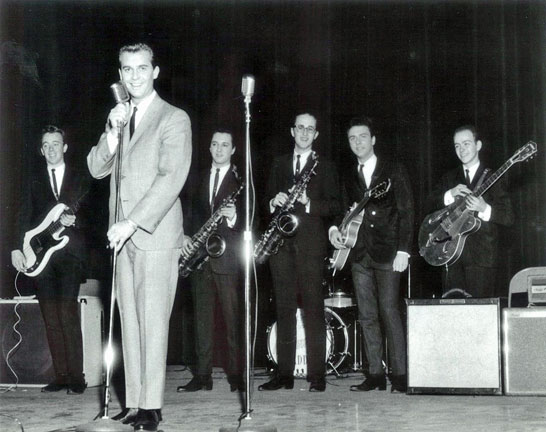
Photo from Myron Lee’s Web site
PETER NERO
Pianist Peter Nero was scheduled to perform with the Minneapolis Symphony in a sold-out show at Northrop Auditorium on November 24, 1963, but because of the assassination the concert was rescheduled for March 9, 1964.
Thanksgiving Hop: 1963
KDWB presented the annual 13-hour Thanksgiving Hop on November 29, 1963, at the Minneapolis Armory. Admission was $1 donation at the door with net proceeds donated to Cerebral Palsy. It went from 10 AM to midnight. Appearing were:
- The Ripchords
- Lou Christie
- The Pixies
- Vic Dana
- Diane Rey
- Debby Dovell
- Tim and the Galaxies
- The Belmonts
- The Corvets
Special Attraction Lou Riegert and the Troops – and all the swinging gentlemen of KDWB. Lou Riegert was a KDWB jock and later became Lou Waters of CNN fame.
Auto Show: 1964
The Auto Show was held in the Minneapolis Auditorium from January 10-19. Entertainers included:
- Roger “Mr. Piano” Williams – January 10 and 11
- The Osmond Brothers – January 12-16
- Jerry Van Dyke
- The Topnotchers
- Leo DeLyon – comedian and emcee
Surfin’ Bird: 1964
The biggest record to come out of Minneapolis to date was “Surfin’ Bird” by the Trashmen. The record was released in December 1963, and peaked at No. 4 on the Billboard chart on January 25, 1964, after 13 weeks. Surfin’ Bird was followed up by “Bird Dance Beat,” which spent 7 weeks on the chart and peaked at No. 30 on March 7, 1964. Much has been written about the Trashmen – for a page from me, please follow this link.
Events: 1964
The New Christy Minstrels appeared at Northrop Auditorium on January 25, 1964.
The local folk group the Goldebriars made its network debut on the national “Hootenanny” show in January 1964. The group got together in 1962, playing at LeZoo in the spring of ’63 and then at the Padded Cell. Members were Ron Neilson (West High), Curt Boettcher (former U of M), and sisters Dottie and Sheri Holmberg (White Bear Lake). The group expanded to six pieces, relocated to Los Angeles, and released two LPs on Epic Records. Here’s an article about the Goldebriars.
On February 8, 1964, the Prom Ballroom hosted the Caravelles, Counts Four, and the Jack Gabel Sextet as part of its “rock vs. smooth” programming. It generally had a big band and a teen band every weekend.
In the wake of the Beatles, every male teenager wanted to play the guitar. If you were a pre-teen, there were substitutes, courtesy of with-it toy companies.
Battle of the Bands, SLP High School, Feb. 15, 1964: Chancellors vs. the Rays. Each band played for 20 minutes at a time, and at the end of the night the kids voted for the best band. Never heard of the Rays. And if you didn’t like rock ‘n’ roll there was a jazz combo in the activity room.
Peter, Paul and Mary appeared at the Minneapolis Auditorium on February 22, 1964.
Allan Sherman, my favorite singing comedian, appeared at the St. Paul Auditorium Theater Section on March 7, 1964, a benefit for the Women’s American Organization for Rehabilitation Through Training. Tickets were a mere $5 donation!
And if that weren’t enough, on March 7, 1964, the Padded Cell featured the Hollywood Quintet. Oh well.
Peter Nero appeared with the Minneapolis Symphony Orchestra at Northrop Auditorium on March 9, 1964. This sold-out concert was originally scheduled for November 24, 1963, but was cancelled in light of the Kennedy assassination.
If you were looking for something completely different on April 10, 1964, Victor Borge was telling jokes and playing piano at the St. Paul Auditorium Theatre.
And more folk music could be heard on April 10, 1964, at the Padded Cell, where the featured performer was (are you kidding?) Charlie Swagman. I’ll bet he was jolly.
The PTA at Brookside Elementary School in St. Louis Park sponsored a Hoot-nanny at the school carnival on April 11, 1964. Those who could sound like the Christy Minstrels (presumably the New Christy Minstrels) were encouraged to participate. Seven ponies were available for riding, and the prizes included transistor radios. Other activities included a trading post, country store, chuck wagon, merry-go-round, make-up booth, candy peg board, and a fish pond. One of the musical participants was the newly-formed Jaguars, all students of Brookside School.
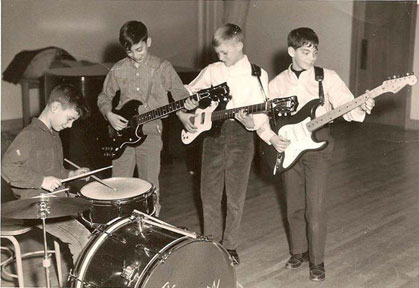
Seen practicing their “British Invasion” song list are Bobby Rivkin on drums (age 8), Stephen Rivkin, Craig Schadow, and Gary Oxman, all on guitars and all age 12. The honed their skills playing dances at the old Community Center, Central Jr. High Canteens, and possibly the Roller Garden. Bobby, of course, went on to play with Prince and the Revolution, and Stephen became a big Hollywood film editor. Older brother David Rivkin was already making his way through some classic Twin City bands. Read more about the Rivkins here. Thanks ever so much to Craig Schadow for the photo.
Competing with the Brookside Jaguars on April 11, 1964, was Johnny Cash, listed as performing at the “Civic Auditorium.”
Jayne Malana, an assistant to Dick Shapiro remembers:
In (I think) 1964 although I don’t remember the date, the Beach Boys played the Armory. After the show, we (the five band members — Brian, Carl, Dennis, Mike and Al, and their manager, who I think was their father, and I) went to dinner at Giovanni’s on Hennepin Avenue. They were staying at the Inn Towne Motel near the Greyhound Station. I dropped them off there that night and went home like a good girl. The next morning I picked them up and drove them to the airport in my mom’s ’53 Plymouth. There must have been another car, too, but I don’t remember it. I still have a picture strip of Dennis Wilson and me in a photo booth at the airport that day. Dennis left his sport coat in the car and I kept it for years. My mother finally got rid of it.
Stebbins reported that in 1964 there were 22 jazz groups working in and around Minneapolis. The majority were playing for dancing, two backed strip acts, and six played for listening. Approximately one-fourth of the working musicians were black and almost all were male. There were around 2,000 members in the Minneapolis musicians’ union.
Dick Gregory, the Freedom Singers, and top jazz and calypso artists appeared at the Minneapolis Auditorium on May 10, 1964, sponsored by the Minneapolis Friends of Civil Rights in cooperation with the Student Nonviolent Coordinating Committee (SNCC).
On June 5, 1964, KDWB presented The School’s End “Battle of the Bands in the Round!” with Gregory Dee and the Avanties, the Jades, the Lancers, the Mystics, and the Wanderers. At Aldrich Arena “on St. Paul’s East Side.”
In July 1964, WDGY brought Jimmy Gilmer and the Fireballs (“Sugar Shack”) to Danceland.
Tony Bennett and Duke Ellington appeared at Met Stadium on August 22, 1964.
Sammy Davis, Jr. came to Met Stadium in August 1964.
Club “15” held their annual Bermuda Short Dance at Ford Parkway Hall on August 30. Music was provided by Mojo Buford and his “Chi 4.”
WDGY gave away tickets to a Beatles concert in Chicago on September 5, 1964. But they also advertised an album of Beatle songs as mangled by the Hollyridge Strings. Oh why?
1964 was the breakout year for the Chancellors, which included two members from St. Louis Park: David Rivkin and John Hughes. The other members were Mike Judge and Dan Holm. In October 1964 the band recorded their famous version of “Little Latin Lupe Lu” and also “YoYo” at Kay Bank Studios. Rivkin was associated with three major Twin Cities bands, starting with four years with the Chancellors. In 1965 David left the Chancellors to join the High Spirits In late 1968, David moved to join Stillroven. Now known as David Z, he had two brothers: born Robert Rivkin, Bobby Z is a musician and producer, most famous for being Prince’s drummer as a member of the Revolution. Steven E. Rivkin is a film editor and producer.
Ray Charles performed at the St. Paul Auditorium Theater on October 9 and the Minneapolis Auditorium on October 10, 1964.
Harry Belafonte and Greek singer Nana Mouskouri came to Northrop Auditorium on November 11, 1964.
The Modern Jazz Quartet appeared at Northrop Auditorium on November 15, 1964.
“Mr. Dynamite” James Brown and His Famous Flames gave a dance and show at the Minneapolis Auditorium on November 17, 1964.
Marian Anderson came to Northrop Auditorium on November 24 as part of her Farewell Tour.
Beatlemania: 1964
Beatlemania hit big when the Fab Four crossed the pond and appeared on the Ed Sullivan Show on February 9, 1964. Local reaction was swift:
- Reviewers in the TV Times could hardly think of enough synonyms for “trash.”
- On February 5, Will Jones of the Minneapolis Tribune reported that from the moment the Beatles arrive, WDGY will follow their progress with five one-minute beeper-telephone reports daily, supplied by Radio Pulsebeat News. Before the ink was dry on the Trib, KDWB “worked a fast shuffle” and signed with the same company, edging out their rival, Jones reported the next day. Curses! Foiled again!
- Front page headline on the Tribune, February 10: “‘Beatlemania’ Hits City.” It was not pretty, calling it a “disease,” “malady” and “epidemic” caused by a “germ.” Ringo was called “homely” and complained about teenagers combing their hair down to their noses or, if they were in a hurry, buying Beatle wigs. Buyer for Woodworth’s couldn’t keep the darn things in stock. Kids were accused of rebelling against “conformity to cultural stereotypes.” They haven’t even seen the Stones yet.
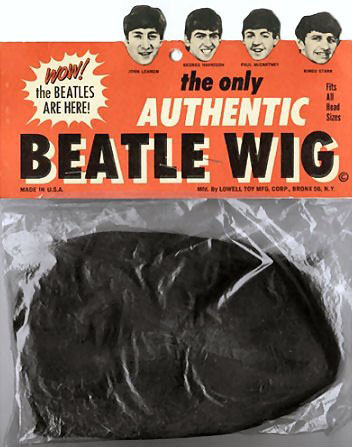
- Meanwhile, back in St. Paul, the Beetles (formerly the Tornadoes) performed at the Belmont Supper Club in Beatle wigs on February 12, 1964.
- On February 15, KDWB’s Ed Rudy was the station’s Eastern Correspondent covering the Beatles’ first American tour.
- In the February 22, 1964, edition of the TV Times there were extensive ads for Beatle wigs at two drug stores and a Ben Franklin in Wayzata. Plus there was a coupon for 50 cents off on said Beatle wig.
- Speaking of Beatle wigs, Will Jones described the Compleat Beatles kit he received from Capitol Records: “besides copies of their first single records and album to be released in this country, a large lapel button bearing photos of all four and the command, ‘Be a BEATLE Booster!’ There’s also a newsletter and a tabloid newspaper devoted entirely to the Beatles. the tabloid shows the Beatle-cut coif for women, and also four Capitol executives wearing Beatle wigs. There’s an ad for Beatle wigs (‘reasonably authentic’) for $2 each.”
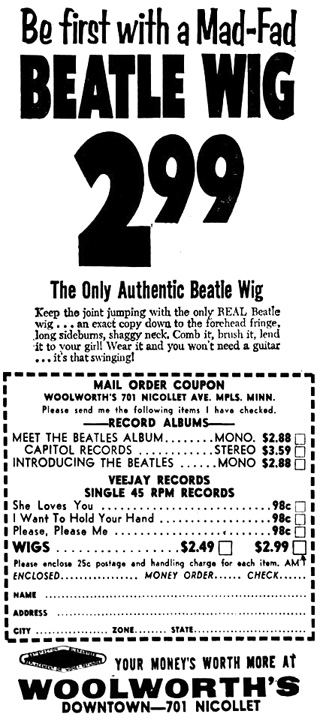
- KDWB’s music survey for March 14, 1964 advertises the Beatles Closed Circuit TV show on the giant screen, March 14 and 15 at the St. Paul Auditorium Theatre and the Minneapolis Armory. Tickets were $2 and available at Field-Schlick and Melody Music City. The show was promoted by National Talent Consultants, Beverly Hills, represented in Minneapolis by 23-year-old Larry Goldblatt. At the Armory, a group of kids showed up at 2am the night before, and a National Guardsman let them in for their safety but kicked them out at sunrise. About 100 kids were literally beating down the doors at 8 am, although fewer than 1,000 of the expected 7,000-8,000 seats were filled for the 11am show.
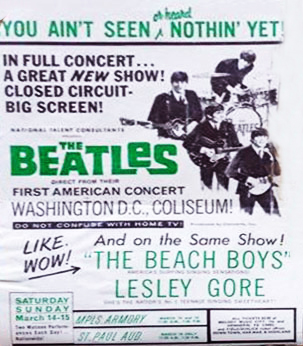
St. Louis Park Rockers: 1964
“Drums, Guitars Resound as Parkites Go Musical,” read the headline of an article in the St. Louis Park High School Echo on March 4, 1964. Several groups were featured, including:
- The Chancellors, formerly the Continentals, have in their group John Hughes, junior, on drums and Dave Rivkin, sophomore, on guitar. “We enjoy our work,” John declares. They have been together about eight months.
- The Treblemen include Randy Resnick on guitar and Mike Mock, juniors, on drums. “We would like to make good like the Trashmen and see the Beatles to go grass,” says Mike. [What does that mean?] “The combined power of the amplifiers of our group,” says Randy, “is in the neighborhood of 150 watts, while the average table radio runs about a watt. This is true of most bands of this sort.”
- Another rock-and-roll group is the Lords, for which Dave Fisch, senior, provides the drum accompaniment. In contrast to most groups, the Lords also have a tenor saxophone.
- Barry London, senior, is a member of a group that plays a type of music many Parkites may not be completely familiar with. His group is called the London Jazz Trio, and consists of a guitar, drums and Barry on piano. “We try to take a standard popular song and improvise from it, always coming back to the original melody,” Barry states.
- The field of folk music also has its devotees at Park. Don Feinberg, junior, and Ian Swatez, junior, are members of the Fireside Singers. They have been together since last summer and recently performed at Snow Day at Camp Iduhapi.
- Another folk group is the Voyageurs Three, a group that includes Gary Gears, senior. Gary and the group performed at Park’s Varsity Show last fall.
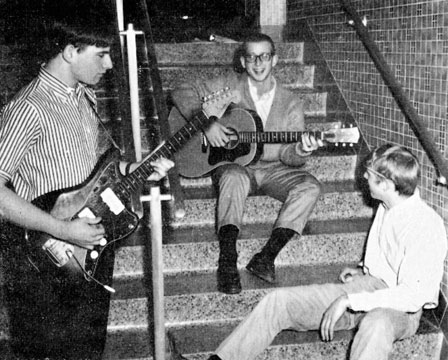
“Representing the many musical groups at Park are juniors Randy Resnick and Ian Swatez, who are engaged in an informal ‘surfenanny.’ Junior Fred Anderson is teaching them his Kingston Trio arrangement of ‘Drag City.'”
Castaways
The Castaways were one of the big local rock bands in the Twin Cities, playing all over the urban, suburban, and exurban areas, including up north in the ballrooms and resorts. Writing about one of the most successful Garage Bands of all time is beyond my ken, but I can share some local gigs and pictures.
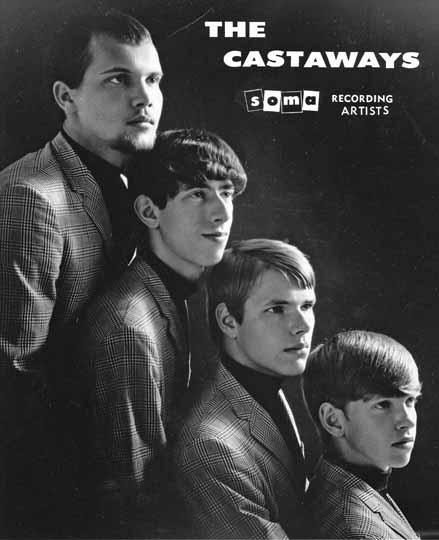
The Castaways consisted of Robert Folschow (Southwest), Roy Hensley (Richfield), Jim Donna (DeLaSalle), and Dennis “Ludwig” Craswell (Richfield). Denny’s the one on the bottom, looking like he was about 12 years old.
THEIR START
On April 10, 1964, the St. Louis Park dance team the Parkettes hosted the River City Talent Tournament at the Minneapolis Auditorium. Professional acts included Jimmie Rodgers and the Big Three, a group from Greenwich Village featuring Cass Elliot. The Castaways placed first in the rock and roll category, beating out the Blazemen from North High. They won the $50 prize with “(Turn On Your) Love Light.” This big win led to professional jobs, press interviews, and more, essentially launching their career.
“LIAR, LIAR”
The band went on to have a huge monster national hit, “Liar, Liar,” written by Jim Donna and Denny Craswell and produced by Timothy D. Kehr. Kehr was also a a booking agent, music reviewer, record producer, magazine publisher, and more. “Liar, Liar” entered the Billboard chart on August 14, 1965 and stayed there for 14 weeks, peaking at #12 on October 23, 1965. Unfortunately, their followup, “Goodbye Babe,” didn’t fare as well – it entered Billboard’s Bubbling Under chart on November 13, 1965 where it stayed for only two weeks and made it to #101.
Nevertheless, the momentum of “Liar, Liar” was huge, and in ’65 they went out to California for 22 days. They appeared on many rock ‘n’ roll TV shows, including “Where the Action Is,” “The Lloyd Thaxton Show,” “Shivaree,” “Never Too Young,” and “American Bandstand.” When they played on “Hollywood a Go Go,” Roy Hensley ruptured a tonsil.
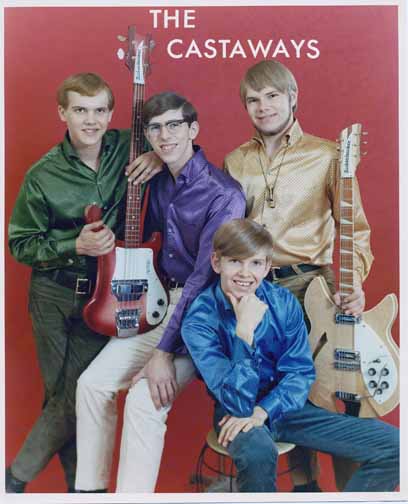
In 1967 they were even in a beach movie called “It’s a Bikini World.” (Only afterwards did the Beach Boys advise them never to do a beach movie.) Universal Pictures paid them $800 just for playing the song twice, reported the Minneapolis Tribune. (Check out Denny’s wink at the end of the scene!) During their career they worked with major stars like the Animals, Beach Boys, Sonny and Cher, and the Shangri-Las.
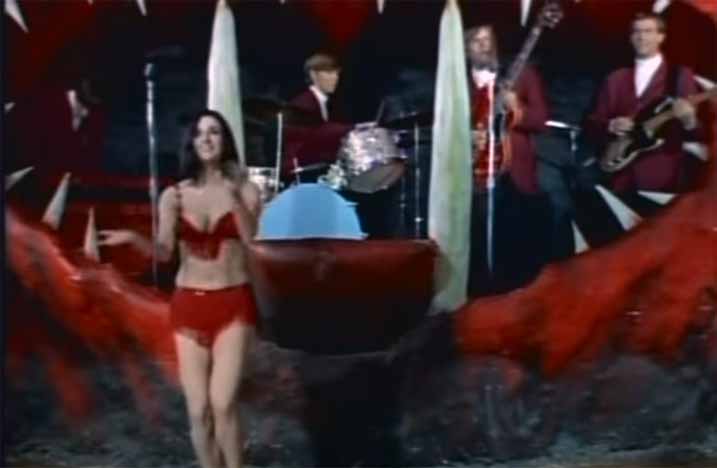
Gary Gimmestad remembers “the Castaways performing at a dance (1968?) in the gym of Incarnation (Catholic school) in South Minneapolis. It was most memorable because the Castaway’s drummer had metal pans on a couple of his drums which contained the flames from burning lighter fluid during the climax to the only live version of he Beatles’ ‘A Day in the Life’ I’ve ever heard.”
Did I mention that Denny was kind of my cousin? His dad’s brother married my dad’s sister, so his Uncle Dick was also my Uncle Dick. And Uncle Dick was a heckuva guy.
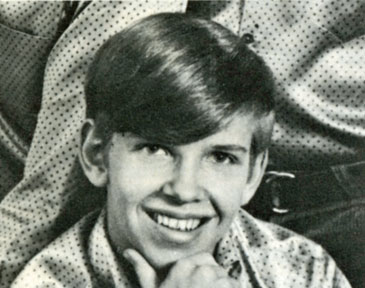
Denny Craswell, 1967
CASTAWAYS II
Dennis Libby provides us with a great photo of the second iteration of the Castaways. He wrote that they were
a vital, somewhat influential and too frequently overlooked ensemble, despite being consistently the most authentic version having two of the original members Denny Craswell and Roy Hensley as carryover mainstays of the “Liar, Liar” recording. Despite the fact this version with myself, Tom (Foot) Husting, and now legendary influencer Gregory Dee Maland out- recorded and out lasted all but the Jim Donna version, with five singles, an LP, numerous inclusions on Greatest Hits CDs extensive gigging for nearly five years, and Connie Hechter award for best album, our considerable accomplishments are often overlooked and overshadowed by the original band. Here we are from 1968 modeling leatherwear for Dayton’s Department Store.
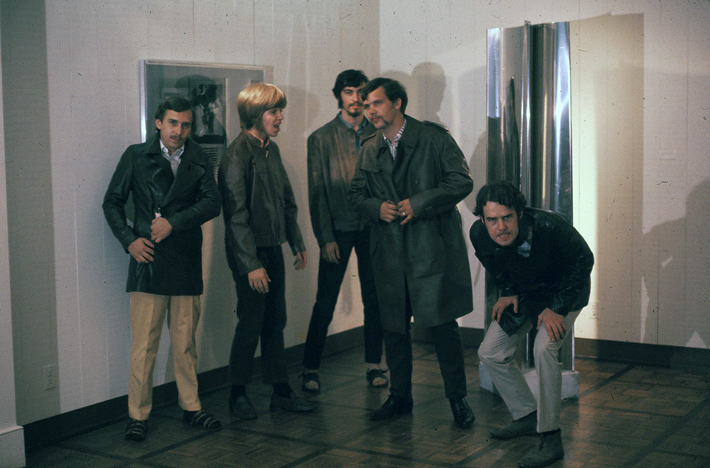
Dennis Libby, Denny Craswell, Tom “Foot” Husting, Roy Hensley, and Gregory Dee. Photo courtesy Dennis Libby
Lots More Blues, Rags and Hollers: 1964
Koerner, Ray, and Glover released “Lots More Blues, Rags and Hollers” in June. As with their first album, it was well received by the Little Sandy Review.
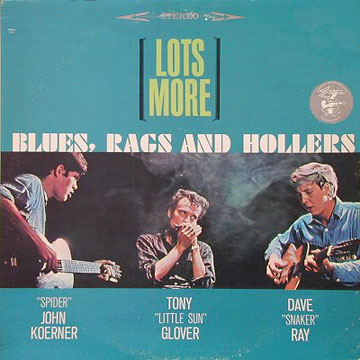
The Rolling Stones: 1964
June 12, 1964: The Rolling Stones performed at Danceland. There are so many versions of this story that I’ve made a separate page for the event.
The Key Club was still around, but not advertising in the Spokesman nearly as much. On July 2, 1964 it presented Mojo Buford, but also a Saturday afternoon Bikini Beach Party.
Meade Lux Lewis: 1964
Meade Lux Lewis was a boogie-woogie piano player and composer who had been appearing in the Twin Cities since at least 1946.
From Wikipedia:
Lewis was quite fond of the Minneapolis area, where a niece lived, and would visit as often as he could. He appeared annually at the White House Restaurant in Golden Valley. He began a successful three-week engagement there in May 1964. Around two a.m. the morning of Sunday, June 7, leaving the parking lot of the White House and heading east on Olson Memorial Highway, Lewis’ Chrysler Imperial was rear-ended by one Ronald Bates, who was traveling an estimated 80 mph. Lewis’ car was pushed 400 feet, impacting a tree and killing him instantly. He was 58. Bates survived, but his passenger died the following day.
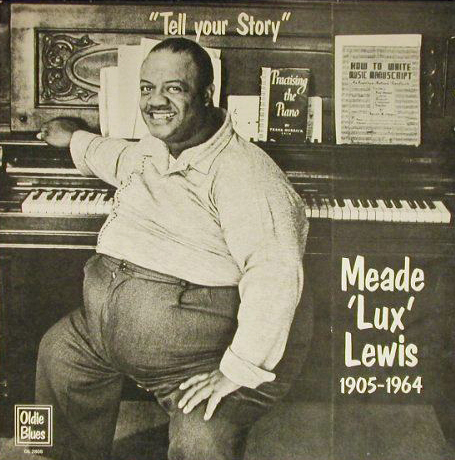
Super Colossal Midsummer Hop: 1964
On July 14, 1964, KDWB sponsored a “Super Colossal Midsummer Hop!” aka “Battle of the Bands in the Round” at Aldrich Arena. Appearing were:
- The Underbeats
- Keith Zeller and the Starliners
- The More-Tishans
- The Tremadons
- The Sting-Rays
Rock ‘n’ Roll Show
On July 17, 1964, WDGY sponsored a rock ‘n’ roll show at Parade Stadium in conjunction with the Aquatennial. Acts included:
- Jan and Dean
- Johnny Cymbal
- Johnny Nash
- Betty Everett
- Jerry Wallace
- The Initials
- New singing sensation Frankie Randall, with his song “Girls in Summer Dresses”
Mr. Lucky’s: 1964
August 28, 29, and 30, 1964, were big nights at Mr. Lucky’s:
- On Friday, August 28, there was a Battle of the Bands between the Chancellors and the Renegades. (“If it’s a Rich Dance it’s the Finest”)
- Saturday night featured a dance with the Chancellors
- Sunday was Mr. Lucky’s First Annual Scholarship Dance featuring “The Stompin’ Underbeats,” “The Accents,” and “The Chancellors.” Proceeds from the dance will provide two Mr. Lucky’s Scholarships for deserving freshmen students at the University of Minnesota. Recipients will be selected by the University Scholarship Committee. Services were donated by the bands, Pepsi Cola, KDWB, Mr. Lucky’s Club, and Rich Enterprises.
Big Al’s: 1964
Big Al’s became a force in jazz shows, presenting:
- Jimmy McGriff
- Ahmad Jamal
- Juaria Moore
- Jimmy Smith, September 17-26, 1964
Dave Clark Five: 1964
The Dave Clark Five Came to the Minneapolis Armory on November 17, 1964. Kevin Odegard says that they “rocked the rafters. Best sound and (black)light show ever (their own)… They were a monstrous, huge live act. One of the three best shows I ever saw. Two more happened in rapid succession the next year with the Yardbirds (Page on bass, Beck on lead) at Dayton’s 8th floor auditorium and the lads from Liverpool at Metropolitan Stadium. Nothing before or since ever came close to those shows.” [The Yardbirds were at Dayton’s on August 5, 1966.] On December 12, 1964, Billboard Magazine reported that the group grossed $10,000 but concert promoter Ray “Big Reggie” Colihan lost $4,000; he had paid $25,000 for two shows, one in Des Moines. Gregory Dee and the Avanties were remembered as the opening act.
Rod Eaton of the Underbeats remembers:
Ray “Big Reggie” Colihan famously brought the Rolling Stones to his Danceland and the Beatles to Met Stadium in Bloomington. He’s less remembered for bringing the Dave Clark Five to the Minneapolis Armory. They were riding their hit “Glad All Over.” As with the Stones and Beatles, Ray claimed he lost money on the Dave Clark Five. Following the concert, Ray attended a birthday party. The Accents, Avanties, and Underbeats all played at the concert and all attended the party. Forty-percent of the Five also showed up. Pat and I ended up giving one of them a ride back to their hotel around 2 AM. I don’t recall which one, but I didn’t really know any of their names. I do remember he was friendly and polite. In fact, both of the Brits behaved themselves with us Yanks at the party. But we did have them outnumbered.
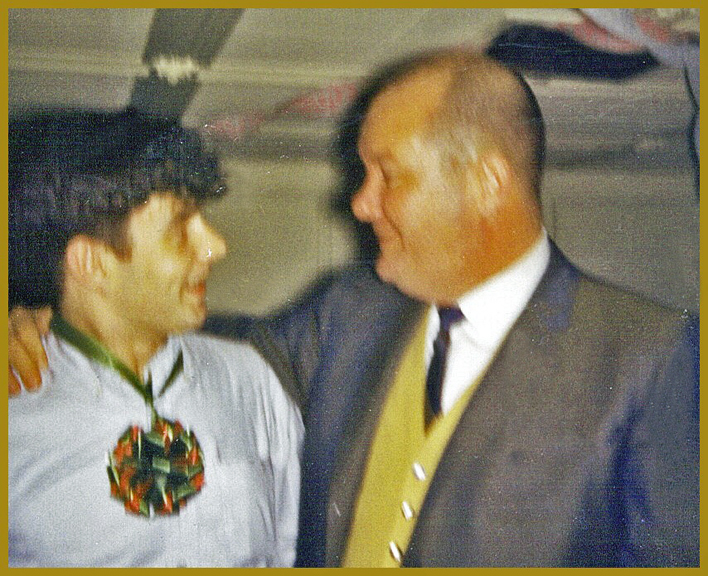
That’s Greg Maland of Gregory Dee and the Avanties with Ray. Photo courtesy Rod Eaton
The Gestures: 1964
The Gestures’ big hit, “Run Run Run,” hit the Billboard chart on November 14, 1964 and had an 8 week run, peaking at #44 on December 19, 1964. The Gestures hailed from North Mankato and featured Dale Menten, Gus Dewey, Tom “Zeeth” Klugherz, and Bruce Waterston. KDWB DJ Lou Riegert heard the second of three versions of the song and suggested changes, and the final version was recorded at Kay Bank Studios. The record was a big success (it was played on “American Bandstand”), reaching #1 in Minneapolis and New York and #3 in Los Angeles. The band signed with SOMA, but the label was unable to keep up with demand (and unwilling to make payola payments). In addition, the record came out the same week as “I Want to Hold Your Hand” was released. Despite selling about 248,000 copies, the band broke up in 1965. Menten went on to enjoy a successful career in music. Marigold Ballroom image posted by Dale Menten. The June 2014 Mankato Magazine has a story about the 50th Anniversary of this big hit by their native sons.
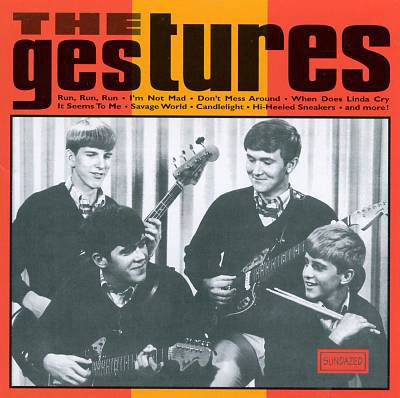
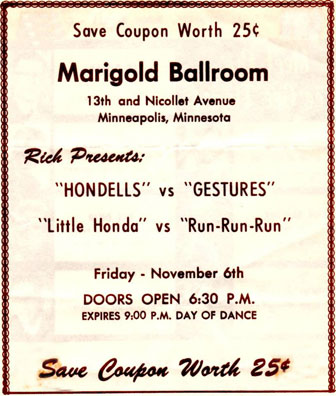
Events: 1965
Local group the Escapades played their first job on New Year’s Eve, opening up for Chuck Berry at the St. Paul National Guard Armory. The Escapades pretended to be British, sporting Beatle wigs and accents. Fellow musicians weren’t fooled but their fans were – at least for awhile.
1965 saw the High Spirits become major players in the local music scene. Over the lifespan of the band, it included up to six residents from St. Louis Park. Click for detailed information about this (mostly) St. Louis Park band.
Louis Armstrong worked hard at the Upper Midwest Auto Show, doing two shows a day for ten days, January 8-17, 1965. Tickets were $1.50, but available for half price at Super Valu stores.
Bob Reed’s journal shows the Trashmen performing at the Walker Art Center on February 6, 1965, and at the Prom on February 27, 1965.
An epic blizzard prevented Bobby “Blue” Bland from making a KUXL-sponsored dance at the Marigold Ballroom in March 1965, but a local musician was found to substitute, admission price lowered, and the event still drew 2,600 people.
The Trashmen played a rare local gig at a Hawaiian Surfari at Coffman Union at the U of M. With special entertainment: exotic dancer LaLoni! Prizes for the Swingingest Hula Dancer, Brightest Shirt, Brightest Muu Muu. April 30, 1965.
Larry O’Connell says the best Battle of the Bands took place at Aldrich Arena during the summer of ’65: noon to midnight!
Why not? Jonah and the Wailers and the Inmates were at the Shoreview Roller Rink on June 19, 1965.
Peter, Paul and Mary, with Dave Brubeck, appeared at the Met Center on June 23, 1965. Well, this isn’t true, since the Met wasn’t built yet. We’ll call this a placeholder.
Dizzy Gillespie and his Quintet, including James Moody, performed at Davy Jones’ Locker at the Downtowner Motel in July 1965 and got a heavenly review from Don Morrison in the Minneapolis Star.
The Trashmen came to the Marigold Ballroom on August 20, 1965.
The Beatles came to town on August 21, 1965 and had a terrible time. See their separate page for the details. Meanwhile, out here in the suburbs, Archie Walker had a Beatle wig (made by Hoigaard’s out of dyed mops) placed on the revolving Beetle at his Volkswagen dealership in homage to the visiting moptops. That summer you could get imported British clothes at J.W. Stephens in downtown Minneapolis.
The appearance of the Beatles created a huge market for guitars at local music stores, as every guy suddenly wanted to become a rock ‘n’ roll star, mostly for the chicks. At B-Sharp, guitar sales quintupled, jump starting the local music renaissance here in the mid 1960s. See a poster for B-Sharp on Robb Henry’s blog.
Horror producer William Castle made an unlikely appearance at a party at the Cascade 9 to celebrate the premier of an unnamed movie at the State Theater, according to Nancy Nelson’s column in the Twin City a-Go-Go magazine, August 1965.
Dan Holm of the Chancellors reports that the band provided backup for Jan and Dean in a 1965 show at Danceland. The group was given the wrong key, but because of their professional musicianship they were able to adapt onstage.
Little Stevie Wonder appeared at Carleton College in August.
Paul Revere and the Raiders came to the Minneapolis Armory on August 19, 1965.
The Byrds performed in St. Paul in August/September.
Local dates for the Trashmen in September 1965 were:
- The University of Minnesota, September 20
- The Prom, September 24
The Miss Teenage Twin Cities Pageant aired on September 28, 1965 on Channel 11.
A new shop called The Losers was opened up downtown next to Music City at Seventh and Hennepin. Twin City a’ GoGo reported “you won’t believe it when you walk into the place. They sell everything! Contemporary greeting cards, tiki gods, lighters the size of a boulder, rare coins, and they even have an art gallery. The proprietor is as unique as his establishment. His name is Hal Krieger and he states that the motto of The Losers is, ‘Where madness is a way of life.'” An item says that Danny Klayman, a comedian from St. Louis Park, was appearing at “The Losers,” a well-known downtown daytime spot – same place?
According to Bob Reed’s journal, the Trashmen played the Minneapolis Auto Show on October 16 and 17, 1965.
In an October 17, 1965, article in the Minneapolis Tribune about the success of “Liar Liar,” band booker and record producer Dick Shapiro estimated that there were “350 rock ‘n’ roll bands in the Twin Cities area that are ‘good enough to get away with a dance job.'”
The Northwest Skiing and Winter Sports Fair, a/k/a Ski-a-Go-Go, was held on October 22 at the Minneapolis Exhibition Hall. Performing were the Del Counts, the Fables, and the Deacons.
A December 1965 issue of the Westwinds newspaper of Westwood Jr. High reports that Granny dresses, though not exactly functional, are one of the fashion statement one sees lately.
Sonny and Cher were scheduled to perform at the Minneapolis Auditorium on December 30, 1965.
The Crusher: 1965
On January 9, 1965, the Novas debuted their seminal recording, “The Crusher.” For better or worse, it followed the tradition of novelty records breaking out of Minneapolis.
230 lb. lead singer Bobby Nolan (age 17) lived on 44th Street, just over the St. Louis Park line in Edina. The band had been previously known as the Avons. Other members were Ted Berquist (bass); Jeff Raymond (drums); and Ross Ingram (lead guitar).
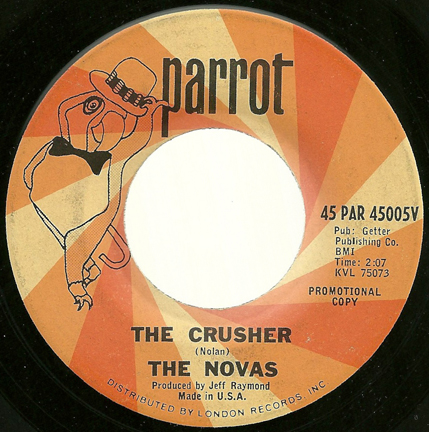
Rod Eaton says that the song was recorded at the original Dove Recording Studios in St. Louis Park before the studio moved to Bloomington. Darold “Arv” Arvidson was the engineer — he hated the recording. It was the studio’s first session. The record was turned down by SOMA, and the Heilichers really kicked themselves for that when it took off when distributed on the Parrot Label (same as Tom Jones).
It reached number 88 on the charts, appearing on the radar for three weeks, peaking on January 16, 1965. Apparently some in-fighting resulted in this genuine masterpiece not reaching #1. See a great interview here.
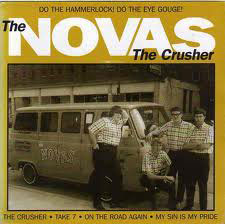
Leave it to Doug Spartz to find Bobby Nolan, who recreated his masterpiece as he was inducted into the Minnesota Rock/Country Hall of Fame on April 27, 2007.
THE MILWAUKEE MAULER
The real Crusher was wrestler Reggie “The Crusher” Lisowski (July 11, 1926 to October 22, 2005), who hailed from Milwaukee and performed on “All Star Wrestling,” straight from the Calhoun Beach Hotel on Channel 11.
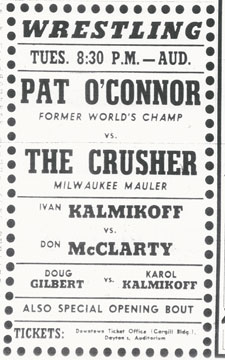
Alas, the Crusher died in 2005.
KDWB-a-Go-Go Dance Party: 1965
The KDWB-a-Go-Go dance party was a happening at the Minneapolis Armory on Saturday night, January 16, 1965. As this vintage radio aircheck of Don Duchene tells us (the commercial is at 08:48), you could get six continuous hours of music and dancing for $1.50! KDWB’s Swingin’ Gentlemen presented:
- Jan and Dean
- Mickey Lee Lane (I had to look him up too)
- The Mystics
- The Stingrays
- The Corvets
The show was a benefit for the March of Dimes.
Builders’ Show: 1965
Liberace was the entertainment at the Builders’ Show at the Minneapolis Auditorium, March 12-21, 1965. Here he is with Princess Kay (Karen Bracken) from that trip.
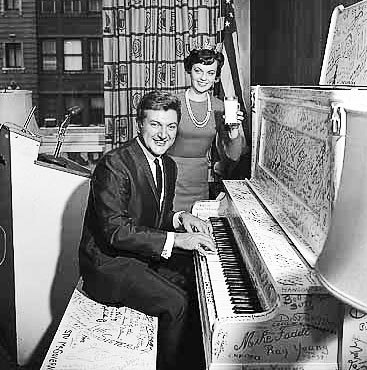
Minnesota Historical Society
Dick Clark Caravan of Stars: 1965
Blogger Jerry Fuentes says that the Dick Clark Caravan of Stars came to Minneapolis (venue unknown) on June 2, 1965:
Dick Clark’s Caravan was heavily booked throughout 1965 with more shows planned than ever before. They also featured something no other Caravan had offered – British acts. Although Clark was vocal about American concert promoters paying way too much money to British Invasion artists in 1964, even he had to knuckle under to the demand for British artists this year. Consequently, Clark made contract offers to a number of groups. The first to accept was the Zombies. However visa issues delayed their arrival so this unit began shows on April 15 and the Zombies didn’t join for the first 10 shows. A week later a second unit hit the road with Herman’s Hermits headlining. These two units criss-crossed the country and even shared one date.
Acts on the Unit 1 show were:
- Del Shannon
- Zombies
- The Larks
- Ikettes
- DeeDee Sharp
- Shangri-Las
- Tommy Roe
- Ad Libs
- Velvettes
- Jimmy Soul
- Executives
- Jewel Aikens
- Mel Carter
- Mike Clifford
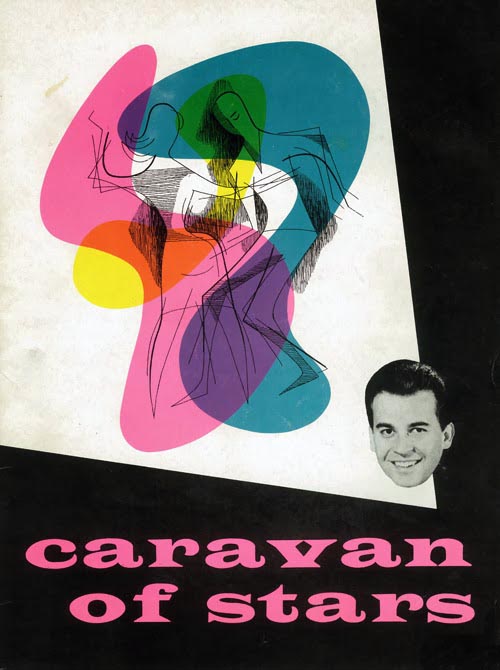
From blog of Jerry Fuentes
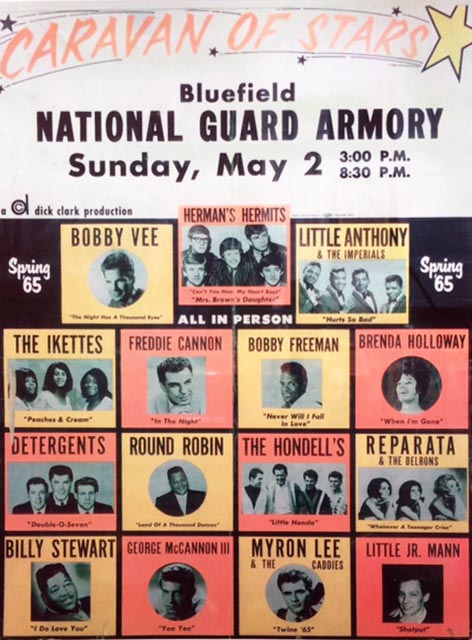
Courtesy Myron Lee
Note: I did NOT find any evidence that this show actually came to the Twin Cities.
H.T. Three: 1965
Hal Witzman provided this description of the H.T. Three and their hit, “Cool Breeze:”
Back in 1965, I was in a “studio” band called the H. T. Three. The band was formed by musician/songwriter Harley Toberman. The H. T. Three consisted of Harley Toberman (piano, organ, vocals), Myron Goodman (drums), and myself (guitar, vocals). We went into newly formed Dove Recording Studio in St. Louis Park to record Harley’s original songs. One of those songs was a jazz/rock instrumental titled “Cool Breeze.” The song was played on the radio quite a bit in the Minneapolis and Los Angeles areas in 1966. Since it was an instrumental, the disk jockeys liked it because they could play it before the hourly breaks and do “talk overs.”
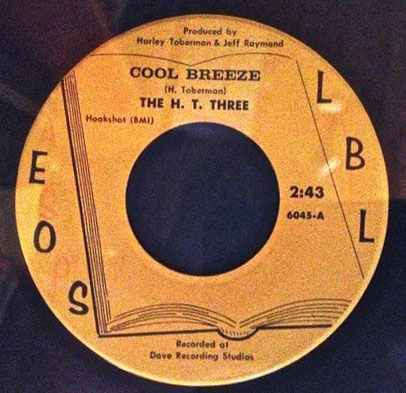
The record was reviewed in the March 26, 1966, issue of Cashbox magazine, earning a B+ (Very Good). Comments were “Stimulating and powerful jazz-tinged session.”
The song is also included on the horrendously expensive “Money Music” compilation.
Wolfman Jack: 1965
Think of the Wolfman and you may think Mexico, but Bob Smith had several ties in Minnesota. In January 1965, the Wolfman made his first appearance in the Twin Cities when he and record store owner/record label owner George Garrett bought radio station KUXL AM 1570. The Wolfman did not appear on the air, but he managed the station and from there he recorded his oldies shows he broadcast from border radio station XERF in Mexico. He didn’t own his share of the station for long, leaving the next year. But in 1974, with newfound fame, he came back and bought a house in Minnetonka. He made a deal with KDWB to broadcast live shows and also do a syndicated radio show. That arrangement ended in January 1975. He was back in 1980-82 to do occasional oldies shows on station WWTC. The Wolfman died in July 1995.
Goliards: 1965
Also from the Echowan, here are the Goliards: Al Strand, Bob Lidfors, lead singer Ed Holland, and Terry Rentz (sitting). At a youth conference, 1965-66.
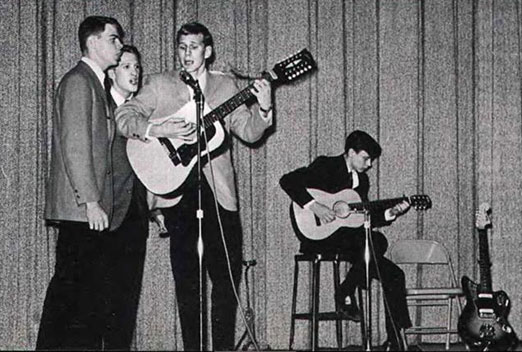
The Coronados: 1965
The Coronados played for the Sadie Hawkins dance at St. Louis Park High School in October 1965. Did someone say that James Walsh on the keyboards?
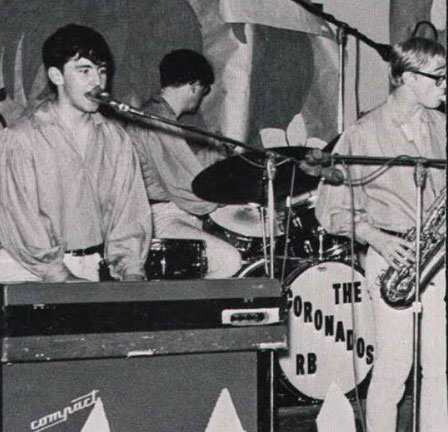
Photo from the Echowan yearbook.
KDWBeach Boys: 1965
On November 19, 1965, the “KDWBeach Boys” performed at the Minneapolis Auditorium. Also appearing were the Gentrys, the Strangeloves, and the Castaways. Ticket prices were $2.50, $3.50, and $4.50. Roland Anderson sent this radio commercial for the event, this entry from his journal, and the images below.
Tonight Shari and I went to the Beach Boys show at the Minneapolis Auditorium. [We were on the main floor in row 1, undoubtedly the most expensive tickets at $4.50.] The KDWB disc jockeys were the hosts. The Castaways lead it off with Liar Liar and then the Strangeloves were on. The Gentrys, who followed, were tremendous. After the Gentrys there was an intermission and then finally the Beach Boys came on and first sang “Fun Fun Fun.” They said Brian Wilson couldn’t make it because he was writing songs and getting richer so they had a sub. [It may have been Glen Campbell.] They also sang “Help Me Rhonda,” “I Get Around,” “Barbara Ann,” “Little Surfer,” “Surfin’ USA” and “Do You Want to Dance?” besides others. When the Beach Boys first came out, we couldn’t see a thing because everyone was standing, but the cops got them out of the way.
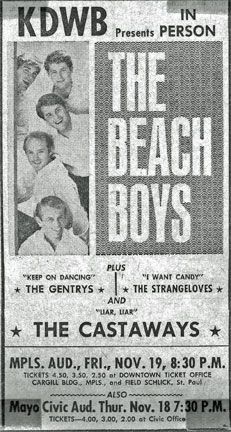
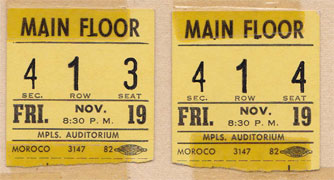
Bob Dylan: 1965
Bob Dylan appeared at the Minneapolis Auditorium on November 5, 1965, before an audience of 9,000. He refused any contact at all with anyone, but the day before he was cruising Dinkytown looking for Tony Glover, visiting old spots, and hanging out at McCash’s Bookstore.
Jerome Norlander remembers:
My roommates and I (having just left small-town Minnesota for our freshman year at the U of M) walked from our ramshackle duplex near Dinkytown to the auditorium for that concert. I remember he sat alone on stage and the mic wasn’t working for his first song; you could hardly hear that he was singing at all. He had to stop and wait for it to be connected. He had just gone electric that summer, and later he brought the band out. I’m pretty sure the band was the Band, but that meant nothing to us at the time.
Others at the show remembered his folkie friends booing the electric set, just as he had been at the Newport Folk Festival (where Pete Seeger was reportedly so mad he tried to cut the power with an axe!) The Twin City a’ Go Go reviewer was not impressed, calling the music “tedious, uninspired, and harsh.”
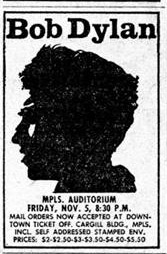
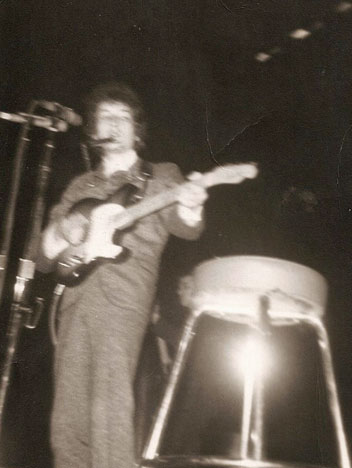
Photo posted by Steve Klemz – taken by his sister.
Frank Cammarata: 1965
A November 25, 1965, ad in the Minnetonka Record offered organ lessons by Frank Cammarata, ABC-Paramount Recording Artist. Cammarata did indeed make two LPs for the label, The Golden Touch in 1959, and The Golden Touch Plays 26 Golden Favorites in 1961. He also made a 7 inch EP in 1961. Originally from Milwaukee, he received a degree in music from the U of M in the 1950s and from then until he retired in 1990 he was the music director for the combined music departments of the Brooklyn Center and Brooklyn Park school districts. On the side the performed at such places as the Radio City Theater in Minneapolis and the St. Paul Hotel and the Driftwood Room at the Lowry Hotel in St. Paul. He died in 2003 at the age of 75.
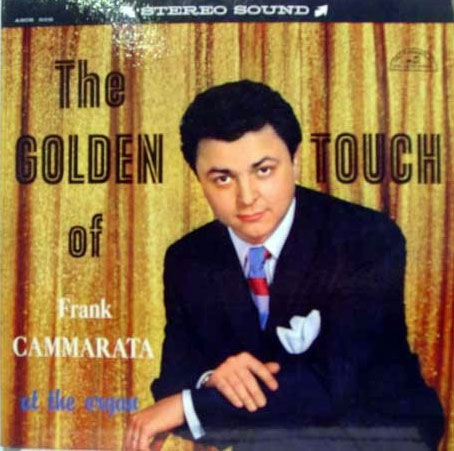
Events: 1966
Louis Armstrong was back at the Auto Show at the Minneapolis Auditorium, January 7-16, 1966.
The Kingston Trio’s scheduled performance at Northrop Auditorium for January 18, 1966 was moved to February 9 and then to February 18 because the wife of one of the members was due to have a baby. The February 18 show went on as scheduled.
Dudley Riggs moved his Brave New Workshop to 2605 Hennepin in late ’65/early ’66. The owners of his previous building at 207 E. Hennepin did not renew his lease. The satire repertoire group was started in 1961. In a Twin City a’ Go Go interview, Riggs revealed that he had opened a coffeehouse in 1958, but in 1959 it became a haunt of beatniks, to Riggs’ consternation.
In March 1966 Teri Rogers, organist for Teri and the Lancers, started a rock ‘n’ roll column in the St. Paul Musician, the newsletter of the St. Paul Musicians Union. Given the antipathy for rock ‘n’ roll on the part of the union members, it’s not surprising that the column didn’t last long.
An April 1966 issue of the Westwinds newspaper from Westwood Jr. High in St. Louis Park announced that paper dresses were in this spring. Not available in stores yet, these wild colored dresses could be had through the mail.
Johnny Cash and company came to the “Minneapolis Convention Hall” on April 16, 1966.
Marcia from Marcia and the Lynchmen reports that they were one of the teen bands highlighted in the St. Paul Pioneer Press Pictorial Magazine, June 5, 1966, “Those Teen Bands.” The article was entitled “Behind the Twang of the Guitar” and the text was by Bill Diehl. Maddie Shay scanned her copy for us but WordPress ate it. I’ll try to get it back up soon!
June 10, 1966, was the fifth annual “School’s Out Spectacular” at Aldrich Arena in St. Paul, sponsored by KDWB. Over 5,000 kids attended the event, dancing to eight bands, including the Ides of March and Dee Jay and the Runaways. Funds raised went to the Ramsey County Jr. Sheriff”s Patrol for rain coats, hats, and safety signs.
The Animals and Herman’s Hermits played the Minneapolis Auditorium on July 1966. The concert was reviewed by Dave Mona in the Minneapolis Tribune, with counterpoint by a local teenager. The opening act was the local band The Marvelous Marauders.
The National Ballroom Operators Association awarded citations to the Castaways, the Hot Half Dozen, Michael’s Mystics, and the Underbeats for being outstanding, neat and danceable bands.
In an October 1966 interview with the Underbeats in In-Beat magazine, there is a telling paragraph:
“The group agreed that the rise of quality pop music has revived this country’s interest in rhythm and blues but their interest is not desegregated. They pointed out that, ironically, it is difficult for Negro R and B bands to get jobs in the Twin Cities. This, they said, was because many places in the Twin Cities won’t serve or hire Negroes. ‘A lot of really good Negro musicians can’t even get in groups because the group is afraid that if they take them, they won’t get jobs.'”
Gene Chandler played Stem Hall on October 9, 1966.
Sammy Davis, Jr. with Count Basie and His Orchestra performed at the St. Paul Auditorium on October 13, 1966.
The Temptations played the Marigold Ballroom on October 16, 1966.
Joe Tex appeared at Stem Mall, St. Paul Auditorium, on November 2, 1966.
Ray Charles played the Minneapolis Auditorium on November 6, 1966.
Dave Brubeck was at the Minneapolis Auditorium (and/or the St. Paul Auditorium Theater) on November 19, 1966.
The Lovin’ Spoonful played the Minneapolis Convention Center on November 27, 1966. T.C. Atlantic was the opening band.
December 26, 1966, was billed as the “Biggest Dance in History,” held at the Minneapolis Auditorium. On the bill were the Fabulous Flippers, the Electras, the Underbeats, the Del Counts, T.C. Atlantic, the Castaways, Michael’s Mystics, the Accents, and “many more.”
Mike Jann and Tony Andreason of the Trashmen started Metrobeat Records in 1966. The LP “The Best of Metrobeat” now goes for $200. See a partial 45 discography here.
Pete Fountain: 1966
Dixieland clarinetist Pete Fountain performed at Northrop Auditorium on July 5, 1966.
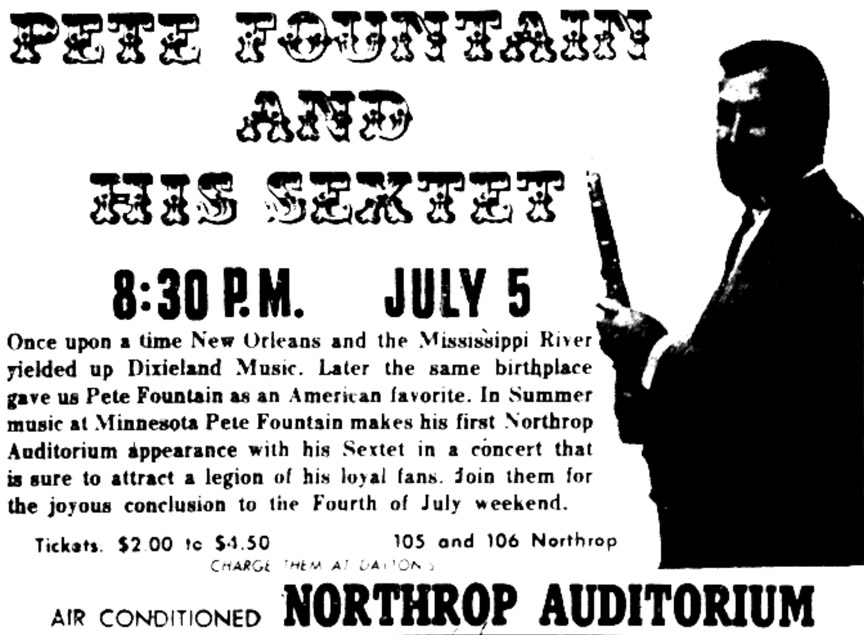
1966
Peter Rabbit: 1966
Dee Jay and the Runaways hit the national Billboard chart with the fun song “Peter Rabbit” in May 1966. The group was from Spirit Lake, Iowa, and the song was popular here in Minneapolis. Everything you need to know about this song is on this website! The song peaked at Number 45 on July 9, 1966.
Joey Dee and the Starlighters: 1966
Joey Dee and the Starlighters had a one week stand at the Whisky Go Go in St. Paul. Joey Dee’s Starlighters came and went, and got younger and younger. Some of them went on to form the Young Rascals.
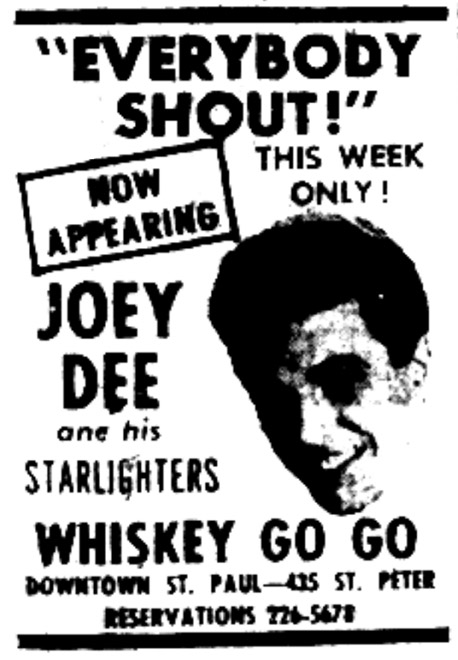
July 10, 1966
Flinthill Singers: 1966
The Flinthill Singers did the rounds at the local shopping malls in 1966. Why “Folk Music” is in quotation marks in this ad is beyond me.
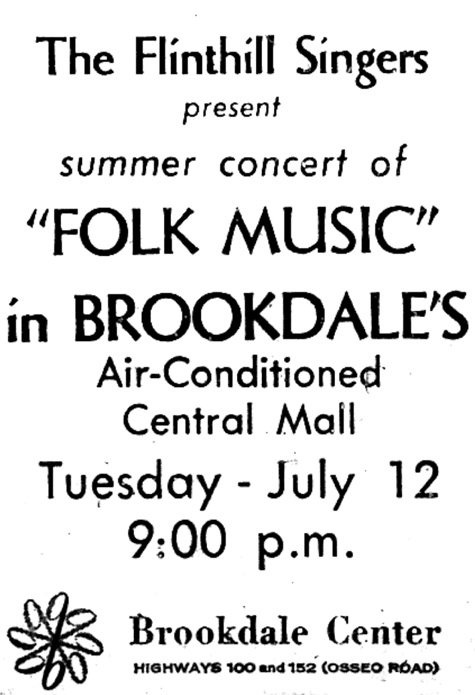
1966
Brique: 1966
Hey Hey, it’s The Brique! An Edina band that undertook a 100-hour marathon in a garage at the Elmer Schueneman farm, 5720 Dewey Hill Road (now a Cahill subdivision). Members of this group of 14 and 15 year olds were:
- Cliff Holm, bass
- Bob Wilkinson, rhythm guitar
- Steve Smith, lead singer
- Gary Schueneman, lead guitar
- Dave Smith, drums
The manager of this fab five was Mark Riegert, brother of KDWB disk jockey Loveable Lou Riegert (aka Waters), also from Edina.
The article states that at least two members of the band were required to play at one time, while the others slept on hammocks in the garage. Steve Smith said “We pattern ourselves after the Stones.” The reporter found it necessary to explain that “The Stones are a long-haired English singing group.”
Wilkinson turns out to be the same Robert Wilkinson of the Flamin’ Oh’s! When asked what they played for 100 hours, he remembers, “songs like Gloria, Louie Louie, and Stones songs like a million times”
Here’s a photo from the Lake Harriet Courier, courtesy of fellow music history sleuth Mark Kaplan.
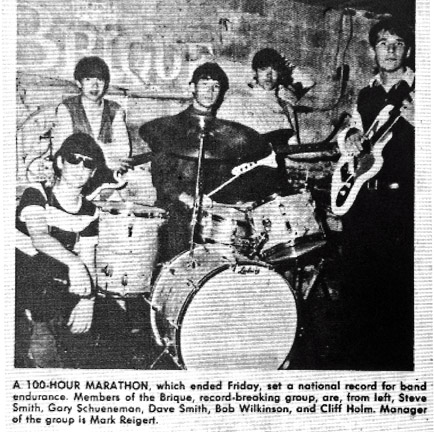
What the World Needs Now is Love: 1966
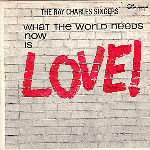 Not to be confused with the Ray Charles Singers, who put out an album in 1966 called “What the World Needs Now is Love.” On that Command LP was a song called “Minneapolis,” written by the prolific Dick Wilson and that “other” Ray Charles. The Minneapolis Chamber of Commerce held a and this was the winning entry. Hymie’s Records (bless them) has posted the song so you can hear it Here.
Not to be confused with the Ray Charles Singers, who put out an album in 1966 called “What the World Needs Now is Love.” On that Command LP was a song called “Minneapolis,” written by the prolific Dick Wilson and that “other” Ray Charles. The Minneapolis Chamber of Commerce held a and this was the winning entry. Hymie’s Records (bless them) has posted the song so you can hear it Here.
Marigold Ballroom: 1966
Pam Schmitz found this fabulous poster, advertising a six-hour marathon of the Cities’ favorite bands, playing at the Marigold Ballroom on September 9, 1966.
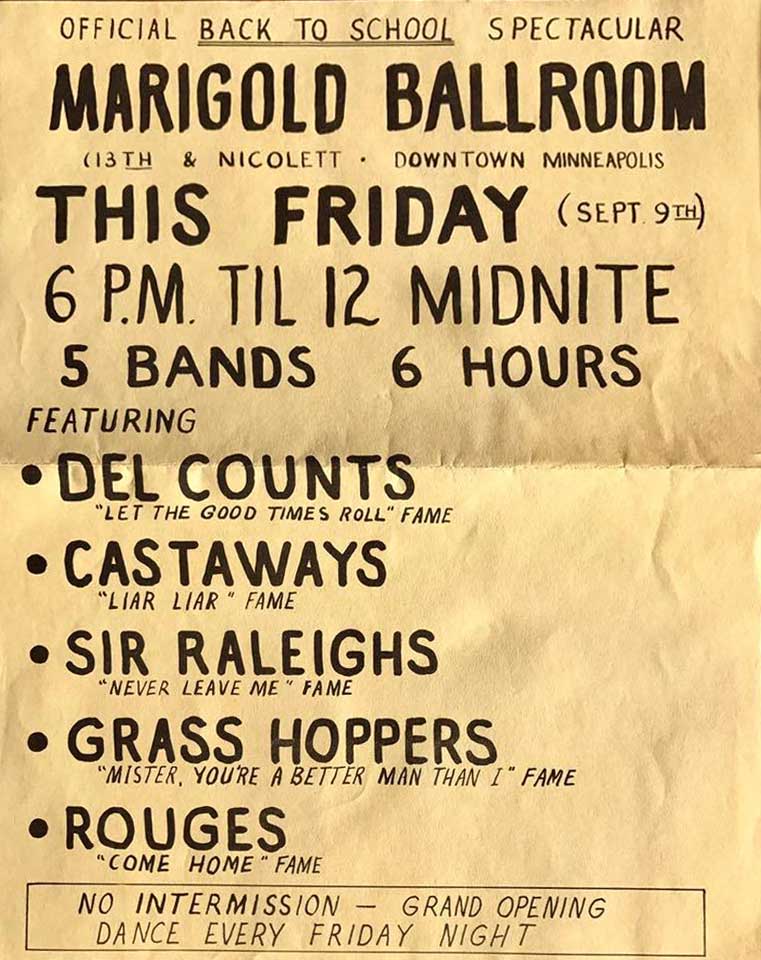
Mamas and Papas in Minneapolis: 1966
The Mamas and Papas made their only appearance in the Twin Cities on October 24, 1966, at Convention Hall in the Minneapolis Auditorium. The show was sponsored by KDWB.
One of the two warm-up bands was Dave Brady and the Stars. The “Stars” were regulars three days a week at Magoo’s. The band was noted for being one of the first “mixed groups” to widely popularize the Motown style of music (Temptations, Impressions, Imperials, Four Tops, Jackie Wilson, Sam and Dave, Smokey Robinson, Martha and the Vandellas, etc.) in many of the numerous dance clubs around the Twin Cities and the five state region.
A review of the concert by Brian Anderson of the Minneapolis Tribune on October 26 reported that Brady and the Stars played for 20 minutes, followed by a group called Seven Sons “from Chicagoland.” At the break, the audience, estimated at 5,000 and called “hippies” by the KDWB DJ, was disgruntled about the delay. But after two hours, the Mamas and Papas did show up for a 40 minute show, which was well received by the crowd that was described as mostly college students or older teens. The show was what you might call “freewheeling:”
When the Mamas felt like singing from the floor, they sat on the floor and sang. When the group felt like walking around they walked around. When they felt like talking to the light crew (“keep those bottom lights on and all we’ll get is knee-cap shots”) they talked to the light crew.
T.C. Atlantic: 1967
Rod Eaton of T.C. Atlantic, as posted on Facebook:
In January, 1967 T. C. Atlantic recorded a live album at the Bel-Rae Ballroom. “Arv” Arvidson dragged Dove Recording Studios’ 4-track Ampex recorder and a bunch of microphones to the ballroom for the session. That’s me leaning over the recorder to talk to Arv. Drums were recorded on one track, the other instruments on another. Vocals were placed on the third track, and crowd noise on the fourth. It really didn’t matter all that much, though, since everything bled together. The band didn’t have anyone mixing vocal levels in those days – that came a bit later for local bands. We were used to balancing our voices as we played – by listening to one another – and that’s the way things were laid down that night. With the cooperation of the Bel-Rae folks we set up early and did some sound checks. But most of that work went out the window as the night progressed and we turned up our amps. Listening to the album today, you hear all the technical imperfections and musical rough edges. But there’s energy and excitement in the performance and the crowd reaction is constantly supportive. I think there are a few songs that sound good. Fifty years later, I’m pretty proud of that band.
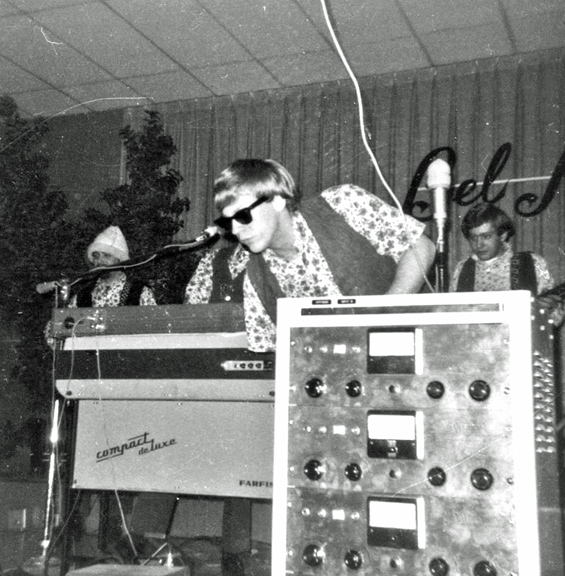
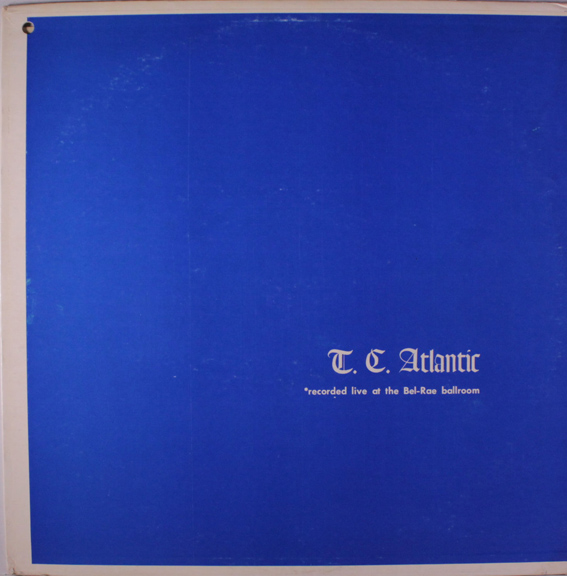
Events: 1967
The group We Five appeared at Northrop Auditorium on January 14, 1967. The concert was the finale to Greek Week at the U of M, and proceeds went to scholarships for Indian students.
KUXL hosted the Impressions at the Marigold Ballroom on January 22, 1967. Also appearing were the Amazers.
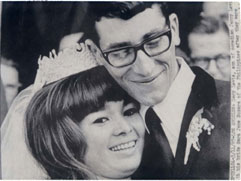
WCCO-TV aired this picture of Gary Lewis and his new wife, so we presume the happy couple were in the Cities on March 11, 1967, but there’s no guarantee.
Did I get my first record player on my birthday in 1967? I don’t remember, but it was white, and not quite a Close ‘n’ Play.
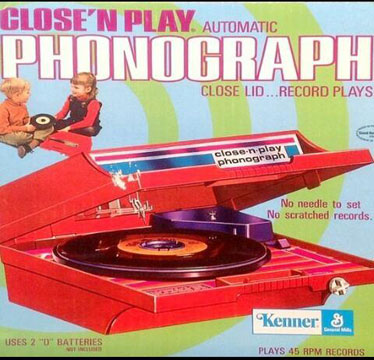
March 26, 1967, saw the invasion of Paul Revere and the Raiders, and their co-stars of the show “Where the Action Is,” including Tina Mason, Steve Alaimo, and Keith Allison. Also appearing were Roy Head and a back-up band called Flash and the Board of Directors. The show took place at the St. Paul Auditorium Arena. Emcees were Johnny Canton and Scott Burton.
James Brown and his 18 Piece Orchestra appeared at the Minneapolis Auditorium on April 25, 1967, presented by Toby Zeno of Metro Attractions. An ad, apparently from the Minneapolis Spokesman, called this “The Largest Twin Cities Rhythm & Blues Concert Ever Scheduled in the Twin Cities Area. (A Show for the Entire Family)” Oddly enough, despite the popularity of Brown and his previous appearances in the Twin Cities, there doesn’t appear to be any publicity for this performance in the Minneapolis Star or Tribune. It may be due to the fact that trouble broke out in conjunction with Brown’s concerts in 1966 in Los Angeles and Kansas City?
Connie Hechter, in the TCM Insider (April 29, 1967), found Brown to be “TOO MUCH!” but perhaps for lack of publicity, the crowd was small.
When an artist of this caliber comes through, the house should be packed. It’s not often you can watch this type of “action” show in person. We have to support these acts, gang, if we want more of them!
The Surfers – local band with members from Hopkins and Minnetonka – made a record in a private home studio in St. Louis Park. See Robb Henry’s blog for a brief history of this short-lived band.
Vice President and Mrs. Humphrey attended a Minneapolis Symphony Ball on May 6 in Southdale’s Garden Court. “For the swinging ball-goers there was more lively dancing to the Underbeats in a separate room,” reports The Music Scene.
An article by JoJo Esko in the May 1967 Music Scene commented on how Twin Cities audience don’t applaud performers. One guess is that the Scandinavians don’t want to bring attention to themselves.
May 22, 1967, was the date of the first Connie Awards.
Some of the kids around Lake Minnetonka were apparently not happy with the action at Danceland, and formed the Lake Area Student Association (LASA) to sponsor dances at the Surfside Club in Mound. The students were from Wayzata, Minnetonka, and Hopkins High Schools. LASA got its start after a party at the home of Mr. and Mrs. Charles Cook got out of hand. The Cooks helped organize the group; Mrs. Cook said, “We wanted to hold the dance in a nice place. The kids’ dignity is hurt by some of the places they must go to dance.” Attendance at the first dance was not as much as expected but was deemed a success. (Minnetonka Herald, June 22, 1967)
On June 25, the Beatles appeared on a BBC program “Our World,” which was broadcast to 31 countries and an estimated 500 million people.
Trestman Music Center’s 2nd Annual Battle of the Bands drew 64 bands. It took place June 28-30 and July 5-7 in Richfield. Contestants had to be ages 13-17 and non-professional. First place went to the Defenders.
Donald K. Martin played soul sounds on his overnight show on KDWB.
In June 1967 the Star’s Forrest Powers interviewed Jan Melchior of WDGY and Sam Sherwood of KDWB and both agreed that they stuck to the standard Top 40 format:
From 6 a.m. till 9 a.m., the dic jockey is a “conservative swinger,” playing to both the teens and the young aduluts who are up and about at the time. The pitch grows a bit softer from 9 a.m. to 3 p.m., when the housewives make up the main audience, bu the tempo begins to “really swing” thereafter when the teen-agers start arriving home from school.
Melchoir and Sherwood were also asked about Gordon MacLendon’s charge that “tunes glorifying dope addition and immorality in general are being pushed for radio play.” Both stations said that they check the lyrics before they play a song and ask the publisher to send the words if they are hard to understand. Which doesn’t explain “White Rabbit.”
A Preservation Hall concert featuring Kid Thomas and His 8 Algiers Stompers was presented on July 12, 1967, in the Grand Crown Ballroom of the New Hopkins House in Golden Valley.
Marcia and the Lynchmen were one of the opening bands at the Buckinghams concert at the Minneapolis Armory on July 12, 1967. Leader Tim Lynch of Edina would be drafted that October, serving in Vietnam until 1970. He died of cancer in 1997 at the age of 49.
WDGY sponsored a show by Aretha Franklin at the Minneapolis Auditorium on July 19, 1967. Johnny Canton introduced her. Marcia and the Lynchmen were scheduled to be an opening act, but Marcia was in a car accident just before the concert.
Jimmie Rodgers had an extended engagement at the Manor Restaurant in St. Paul. Later that year, on December 1, 1967, he suffered traumatic head injuries after the car he was driving was stopped by an off-duty police officer near the San Diego Freeway in Los Angeles. He had a fractured skull and required several surgeries. Initial reports in the newspapers attributed his injuries to a severe beating with a blunt instrument by unknown assailants. He recovered but his career was over.
A new booking agency called Uphill Productions, based in St. Louis Park, announced its startup in July 1967, with a wish to give new groups a start.
The Monkees played the St. Paul Auditorium on August 4. See the Individual Page on the Monkees in Minnesota.
On August 10, 1967, Dayton’s St. Paul sponsored a Back to School event that featured the Litter and Danny’s Reasons.
Denny Waite remembered that the Litter invited the Who (but not the Hermits) over for a party after the concert, but only Pete Townsend showed up and he was incredibly shy.
Robert Wilkinson remembers,
I was at this concert. It was awesome. We went to the Downtowner Motel afterward and hung out with them for a bit. All the doors of the rooms were open and various members of all the bands were wandering around from room to room drinking and partying. My favorite era of the Who, or anything before Tommy.
Spanky and Our Gang came back on September 21, 1967, to Northrop Auditorium.
In October 1967 KDWB sponsored a cheerleading competition where cheerleaders from 20 schools submitted tapes and kids called in to vote for their favorite school. On the last night there were so many calls that they spilled into other exchanges.
Not sure I understand this one: On October 27, 1967, “WWTC Radio Presents First Twin City Appearance. Live and Direct from Palmer’s House. Imogene (The Horse) and Fritz (The coach driver). See Them at Jennings Red Coach Inn, 11 am to 6 pm.”
The Byrds performed at the Marigold Ballroom (and also in Mankato), some time between September 10 and November 10, 1967.
Tom Pinkert was a freshman living in the dormitories at the U of M 1967-68. “My circle of friends used to go over to the West bank and see a local band called The Paisleys. They performed in a fire trap called Dania Hall circa 1967-68. There was always a psychedelic light show. I just found a clip on youtube from a slightly later era which captures the spirit.”
Simon and Garfunkel appeared at Augsburg College on November 10, 1967.
The Young Rascals played the Minneapolis Auditorium on November 24, 1967. The show was opened by the local band the Nickel Revolution. NR member Kent Saunders says: “They were a great bunch of guys, and very supportive of our comparatively rookie status. I even have a Gene Cornish guitar pick, with his name on it, as a memory.” For an eyewitness account, see the Nickel Revolution’s blog. Also advertised to be on the bill were Dave Brady and the Stars and the Seraphic Street Sounds (formerly the Escapades). WDGY’s Scott Burton was the emcee.
The Shadows of Knight came to the New City Opera House on December 9, 1967, inaugurating a new policy of presenting national acts.
Sergio Mendes and the Brazil ’66 and Glen Campbell came to the new Met Center on December 16, 1967. Mendez had been here previously in the spring of 1966.
KDWB presented a Christmas Concert series that featured area high schools on Christmas Eve and Christmas day. Each school presented a half hour concert. 13 schools participated.
KQRS’s George Donaldson Fisher did a progressive rock show in the winter of 1967.
KUXL featured an Oldies show on Saturdays from 5-6:30, with DJ Bill Blast.
WDGY: 1967
Remember Elvis? WDGY did on March 31, 1967, hosting a triple feature at the France Ave. Drive-In. Must have been a warm spring.
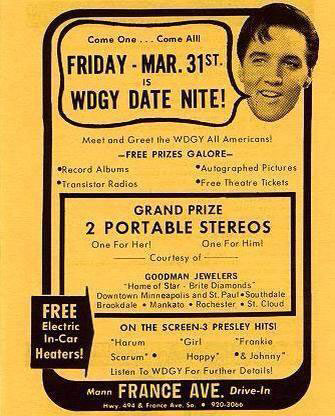
Johnny Cash: 1967
Johnny Cash came to the Minneapolis Auditorium on April 22, 1967, with the entire family. Cash would return on June 22, 1967, sez here.
- June Carter Cash
- Mother Maybelle and the Carter Family
- The Tennessee Three
- Carl Perkins
- The Statler Brothers
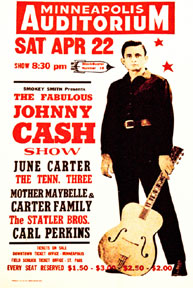
Hennepin County Library
Mr. One-Man Riot: 1967
James (Dynamite) Brown – “Mr. One-Man Riot” – played the Minneapolis Auditorium on April 25. The show included his 18-piece orchestra and several other acts. it was billed as the “largest Twin Cities rhythm & blues concert ever scheduled in the Twin Cities area” in the Spokesman. Young reporters from In-Beat Magazine got an all-expense paid trip to Brown’s next venue – see Publications.
Psychedelic Soundburst: 1967
On May 7, 1967, the “Psychedelic Soundburst” (or Sound-Burst) took place at Aldrich Arena. The show, emcee’ed by KDWB’s Charlee Brown and Earl L. Trout III, was billed as the “Biggest Dance in the History of Aldrich Arena” and promised the world’s best light show – the Fillmore Light Show. The Music Scene reported that the show was presented by Rich Hanson, who planned another for June called “School’s Out – Book Burning Blast.” (did this happen?)
Featured performers were:
- The Del Counts
- The Hot Half Dozen
- Danny’s Reasons
- The Litter – “a group that equals The Electric Prunes in sight and sound”
- Grasshoppers – Headliners
- Happy Dayz(e?)
- Youngsters
- Sir Raleighs
- The Chancellors, just home from triumphant tour of Kansas
- Dozen
- The High Spirits
Del Counts: 1967
The Del Counts never made an appearance on any of the national charts, but they had regional success in the Twin Cities of Minneapolis and St. Paul. On June 3, 1967, one of their songs, a cover of “What is the Reason,” went to #4 on the KDWB Radio Big 6 Plus 30 chart, and #13 on WDGY Radio 1130’s 30 Star Survey. That record was also mentioned as a Breakout Single in Billboard Magazine’s May 27, 1967 edition. Local teens also fondly recall their rockin’ cover of “Let The Good Times Roll.”
Danny’s Reasons: 1967
Danny’s Reasons appeared on Bill Carlson’s show “This Must be the Place” on June 10, 1967. On the show Danny crowned “Miss 16:” are you out there Miss 16? Here are some pictures of the band on the show, courtesy of the Pavek Museum of Broadcasting.
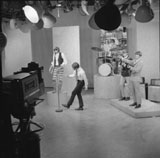
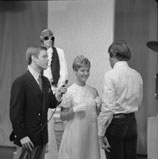
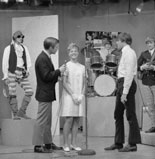
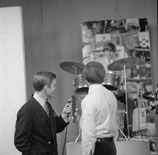
The Ike and Tina Turner Revue: 1967
The Ike and Tina Turner Revue hit the stage on July 10, 1967, at the Minneapolis National Guard Armory for a dance and show.
On hand were the Ikettes, Bobby John, the Dixie Cups, and Jimmie Thomas in a 5 1/2 hour show. Danny’s Reasons opened, and from there were heading to New York where they were booked to appear on the Tonight Show and Merv Griffin Show.
One young lady named Polly who was there says that she remembers “Tina having at least one black eye and bruises all over her legs. Poor Tina! Great concert.”
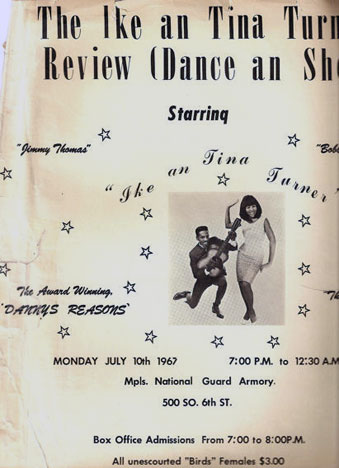
Courtesy Danny’s Reasons website
Hippies: 1967
Marshall Fine, student reporter for the St. Louis Park Echo, wrote a story about the hippie phenomenon and interviewed some of the performers who were here for the Aquatennial. Sonny Bono: “Because I have long hair and wear extravagant clothes, to the adults, I’m a hippie. But to the hippies, I’m not a hippie. My ideas are too conventional.” Marty Balin: “Sure, but what is a hippie? It’s just a name. Adults had to call us something because we were happening and they had to label us something, to prove to themselves that they knew what was going on. Personally, I think ‘hippies’ sounds like the name of a breakfast cereal.” Grace Slick: “It’s not that we all walk around loving each other, but we just don’t like violence. That’s why there’s so much protest of the war in Vietnam. But we’re only human. We’ll argue and get mad just like anyone else.” Fine ended his article: “Predictions have been made that the hippie culture will die out within the next year. If so, it will not go unnoticed. Summer ’67 is proof enough of that.”
Sonny Without Cher: 1967
Sonny and Cher were scheduled to perform at at an Aquatennial show at the Minneapolis Convention Hall on July 14, 1967. WDGY’s Johnny Canton:
Frankly, it was I who convinced Sonny to appear sans Cher at WDGY’s Minneaplis Auditorium concert July 14th. Cher had just suffered a miscarriage a few days prior to our concert and Sonny was reluctant to appear without her, much less leave her. The night before he was to fly to Minnesota, I was on the phone with Sonny at their home. The doctor was with Cher and both Cher and the doctor convinced Sonny it would be OK for him to do the show. I applied some pressure and he acquiesced and came to Minnesota. In order to cover for Cher, I put Sonny on the air and we appealed to our female listeners to “audition” to sing with Sonny at the concert. We had several viable singing candidates and it turned out to be one heckuva show with that twist. It was the first time Sonny had ever appeared without Cher. I nearly experienced suffering from an ulcer considering it was a well-promoted WDGY show and had Sonny not appeared we would have had much egg on our faces.
The day after, the Tribune did not report a miscarriage, but that Cher had begun to hemorrhage while on a shopping trip in Hollywood the night before. (Cher suffered four miscarriages before they had Chastity in 1969.) Sonny made a personal plea on WDGY for girls to audition to sing with him. 21 girls auditioned and five girls were chosen to sing:
- Mary Gonzalez, 17, Glenville: “Baby Don’t Go”
- Becky Bothof, 18, Albert Lea: “Just You” and “Bang! Bang!”
- Tere Berns, 18, Bloomington: “The Beat Goes On”
- Tami Peterson, 14, New Ulm: “Unchained Melody”
- Kathy Stasik, 16, Minneapolis: “I Got You Babe”
Sonny, 27, wore a pale blue brocade suit minus lapels, a multi-colored silk shirt, and white boots. But he insisted he was not a hippie, and said he “deplores the use of narcotics and other hippie conventions, but sympathizes with the hippies. ‘They’re lost,’ he said. ‘They want answers.'” (Minneapolis Tribune, July 15, 1967)
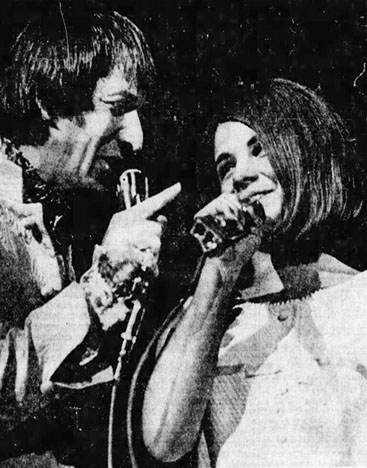
Sonny and Becky Bothol; photo from Minneapolis Tribune
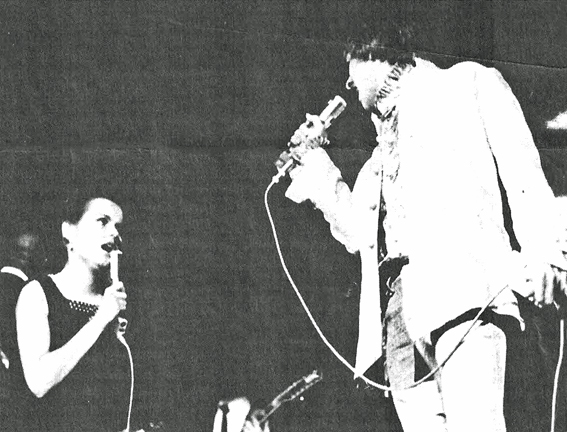
Tere Berns and Sonny Bono. Photo in Sun-Suburbanite, taken by Mike Barich
Stillroven and the Del Counts opened the concert.
Happening ’67
On July 19, 20, and 21, 1967, KDWB and the Aquatennial sponsored “Happening ’67” at the Minneapolis Convention Hall.
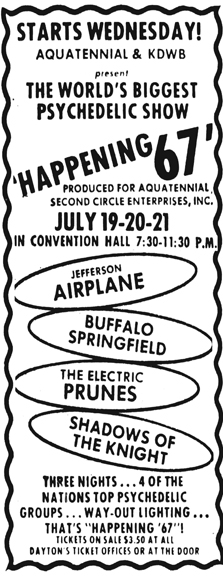
The T.M.C. Insider reported that the event was:
unofficially planned to make Minneapolis the place “where it’s at” this summer. KDWB and the Aquatennial are hoping that a lot of the flower children from all over the country will congregate at “the world’s largest happening” in the Minneapolis Auditorium. … Happening ’67 will be a three day psychedelic feast – That’s right, a three day freakout. In the stage area will be sheets of brilliant silver mylar, interspersed with fabrics as colorful as possible, to accent the silver. There will be three screens. From the back, projectors will flash colored lights which are electronically controlled so that they keep time with the music – pulsating when the timbre of the music does. Cost for the lighting equipment – $100,000.
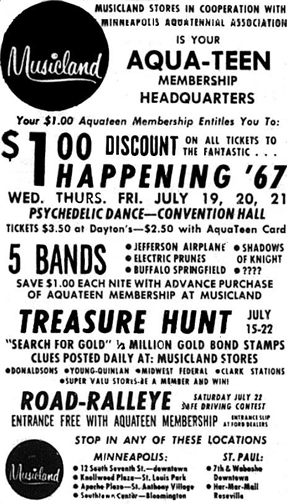
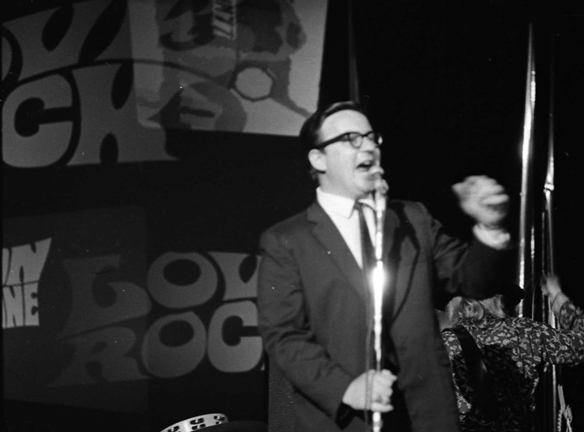
MC Charlee Brown – Photo copyright Mike Barich, St. Paul
Appearing were:
Jefferson Airplane (These photos taken at the July 19, 1967, show)
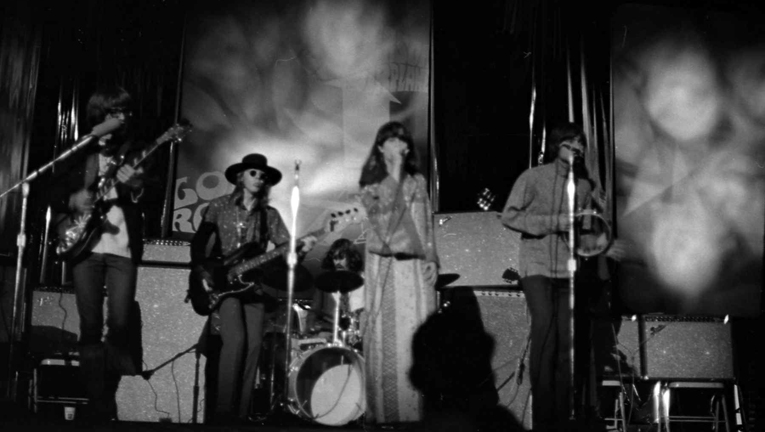
Jefferson Airplane photo copyright Mike Barich, St. Paul
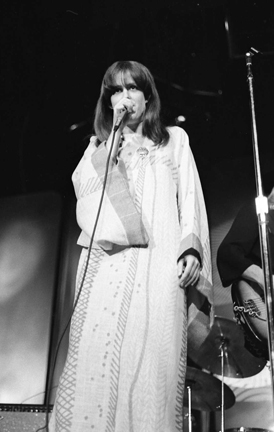
Grace Slick photo copyright Mike Barich, St. Paul
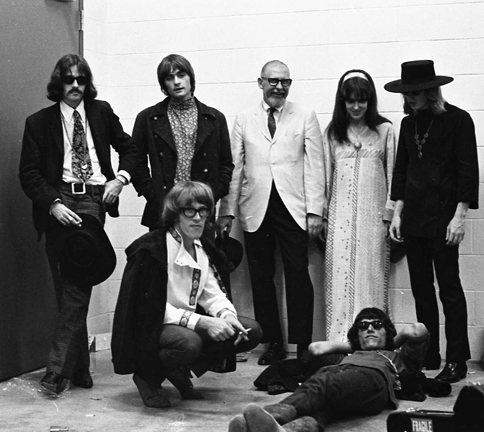
Airplane backstage; photo copyright Mike Barich, St. Paul
- Buffalo Springfield
- The Shadows of Knight
- The Electric Prunes
The four groups played in rotation over the three days.
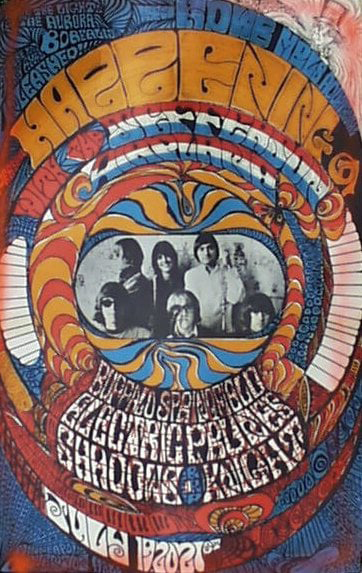
Poster by Larry “Joaquin” Hudek
REVIEWS
Will Jones gave a generally good review of the event, describing three huge rear-projection screens that had colored lights and images flashing on them from behind, frequently in synchronization with the music. “Sometimes the shadows of what appeared to be nude go-go dancers appeared on the screens. Our party strolled behind the screens to see what went on behind there [and found] go-go dancers in bikinis making those lively silhouettes.” They were chased away by the police though, which Jones said “put a crimp in the proceedings.” He also cited a young man who was not impressed: “‘This isn’t really very well done at all. There aren’t enough lights. Not enough things popping.’ He looked around the hall slowly with his experienced eye and then announced, ‘They need at least five or six more big lights.'”
Molly Ivins, then a Tribune staff writer, observed “If most of the kids were hippies, then they were too young to grow beards. Their clothes ranged from Carnaby Street Moderate to All-American Slob. The Jefferson Airplane was the big hit of the evening. The Airplane has more fun, more noise, more style and more hair than the three other groups. The kids danced, sat, lay down, or just stood listening to the music and watching the lights and a no-sense film made by Marcus the Hippie and his friends.”
Beverly Kees from the Minneapolis Star focused on the disinterest of the audience the unspecified night she attended, counting the house at 2,100. She never mentioned the bands or who was in them, except for the Airplane. “For the most part the teens watched silently and unsmiling.” “During infrequent and brief pauses between songs, applause was sporadic.” The last group, the Airplane, got more attention and applause. “The teens applauded and quietly walked out.”
Ric from Facebook remembered, “Neil Young did not play with Buffalo Springfield. It was Doug Hastings, from the Daily Flash, who filled in while Neil had left the group for awhile. I was disappointed. The Airplane did not play at least one of the dates as Buffalo Springfield headlined the day I was there.” Larry says, “I don’t remember any chairs. They played on a stage a few feet above the dance floor.”
The KDWBeat Magazine, August 26, 1967:
KDWB – Where The Action Is! For three nights the Jefferson Airplane, Buffalo Springfield, Electric Prunes and Shadows of Night filled the flour city with their flower music. “Happening ’67” was a total experience. Each group wished they could have stayed longer, but about 11:30 each night, some guy would come in and yell, “Hey, they’re rolling up the sidewalk!”
On Friday all the groups were taken out to Lake Minnetonka for an afternoon on the largest boat on the lake. Even though most of the people were from California, they were truly impressed. The groups said they really hated to leave the twin cities. The Jefferson Airplane said that they wished they could have stayed longer, but they had to get out to the airport because someone had written “Spirit of St. Louis” across the fuselage. The Electric Prunes asked, ‘Is St. Paul really putting Minneapolis on?’ And then they were gone.”
Riots of 1967
On July 19, 1967, sparked by an incident at the Aquatennial Torchlight Parade, racial unrest erupted along Plymouth Avenue in North Minneapolis. Crowds threw rocks and set fires over two nights. Governor Harold LeVander called in 600 national guardsmen. Three people were shot, two policemen and one fireman injured, there were 34 arrests, and four businesses burned to the ground. A KDWB news cruiser was destroyed and the reporter called in his report from a phone booth. For a day-to-day description of activities, as taken from the Minneapolis Tribune, see my page on Race, Creed, and Color.
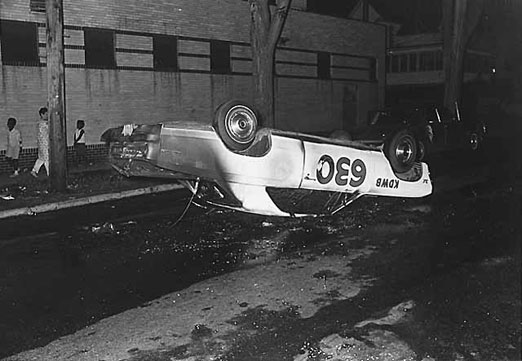
Minnesota Historical Society
Love-Ins at Loring Park: 1967
It was the Summer of Love, and Minneapolis joined in with a series of Love-Ins in Loring Park.
JUNE 18, 1967
The first one was on Sunday, June 18, 1967, at 2:00 pm. It was sponsored by Psychedelia, Subterranean Productions, and KDWB – DJ Sam Sherwood was listed on the poster, which may mean he made an appearance. The poster was designed by local artist Joaquin (Lawrence Hudek), a partner who ran the Psychedelia head shop.
The bands were:
- The Unholy Alliance
- The Litter
- Maurice (Jacox?)
- The Great Western Exhibit
- The Spectrum
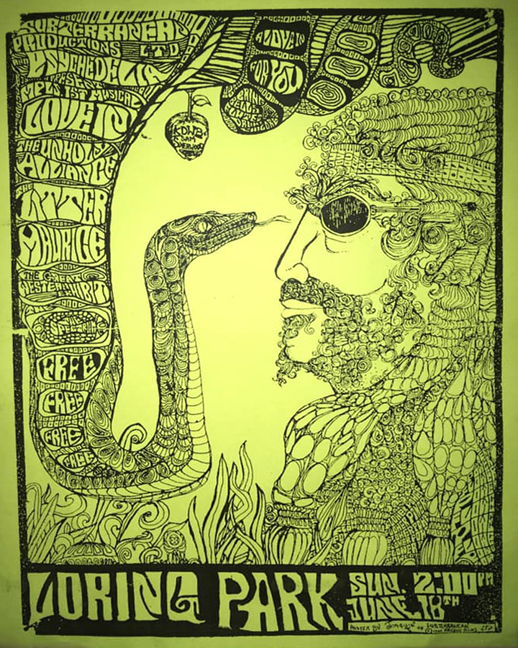
Many thanks to John P. Koski
JULY 23, 1967
200 people gathered for a Love-In in Loring Park on July 23, 1967. The four-hour event was organized by the Free Music Society.
Music was provided by:
- The Family
- Jokers Wild
- The Weeds. Any former Weeds out there?
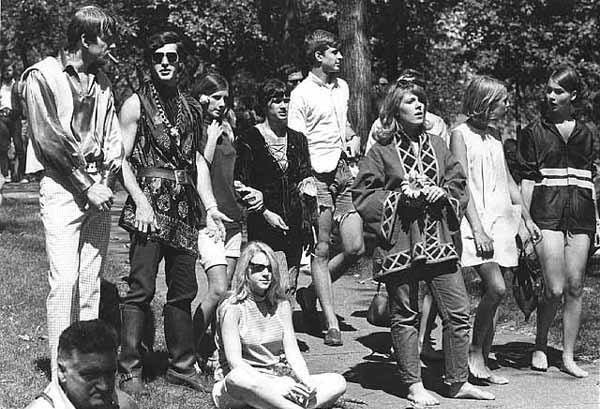
July 23, 1967. Photo courtesy Minnesota Historical Society
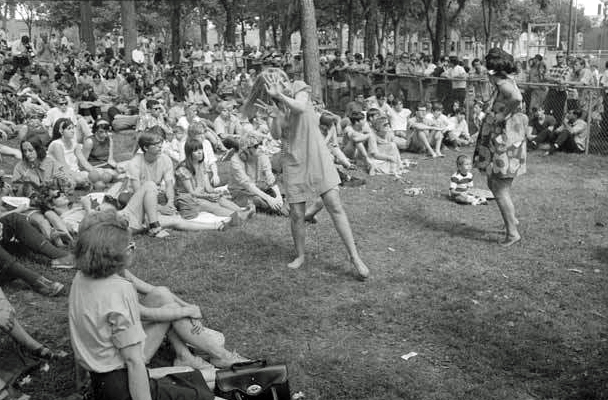
July 23, 1967. Photo courtesy Minnesota Historical Society
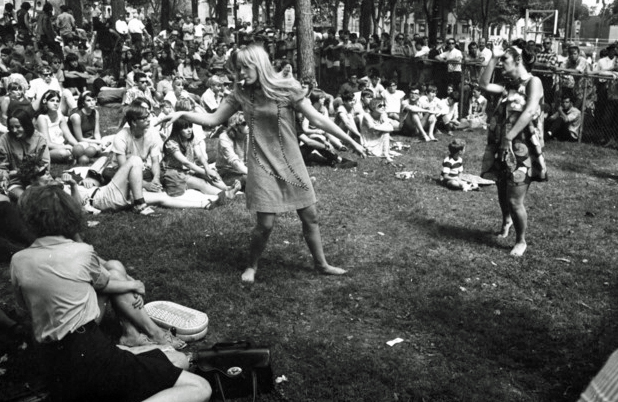
July 23, 1967. Photo courtesy Minnesota Historical Society
It was at this or another 1967 Love-In that Blue Sandalwood Soap performed “Friends I Haven’t Met Yet.” Here is a performance of that song. Dan Knutson with Harley Toberman, Steve Luck and Dave Bergsland play while various people grab the 8mm camera and trip out. The song was featured on the show “Mad Men,” Season 6 in April 2013.
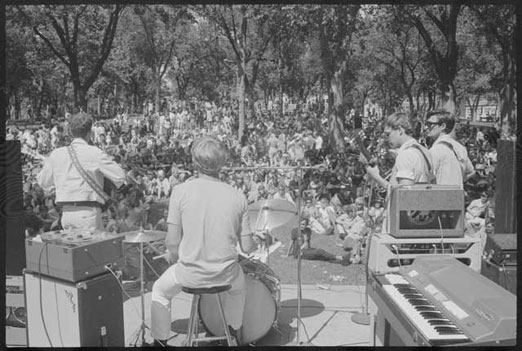
Photo by St. Paul Dispatch and Pioneer Press, courtesy Minnesota Historical Society
FLYING HIGH
More on Blue Sandalwood Soap: They recorded a demo for the ad agency that had Northwest Orient as a client. As Harley Toberman explains, “They didn’t like it – too “hippie” 🙂 We just did it for fun. Recorded in a little studio in St. Paul with Dan Knutson Singing/guitar, Harley Toberman on Farfisia, Steve Luck on Bass, and Cyril Paul on Bongos. This song and 17 others can be found on the LORING PARK LOVE INS by Blue Sandalwood Soap CD, downloadable on Amazon.com and iTunes.” (I got mine on discogs.)
OCTOBER 1, 1967
The only other hit I got for “Love-In” came on October 1, 1967. There were two that day:
One was at Powderhorn Park, where people were shown playing with an open parachute.
The other was a “hippie art show” in the parking lot of the Fourth Northwestern National Bank, 401 Riverside Ave.
The Trip: 1967
The movie “The Trip” opened at four drive-ins around town on July 26, and Peter Fonda was making the publicity rounds. In an interview with Will Jones, Fonda revealed that Roger Corman made the first seven reels but ran off to Europe to avoid paying taxes, so Fonda and his friends finished it. The film is about a director of TV commercials who takes LSD and the latter part of the picture records his experiences. “It’s the psychedelic climax that Fonda concentrated on, writing the music, urging the film editor to insert one- and two-frame flashbacks and flashforwards, and even shooting some extra scenes on the Sunset Strip after Corman had departed. Fonda said he didn’t take LSD during the making of the picture, but had had enough previous experience with it to know what it’s about.” Unfortunately, “It’s a Bikini World,” that opus starring my cousin Denny Craswell (and the rest of the Castaways), was only billed as the “Action Packed Second Feature!!”
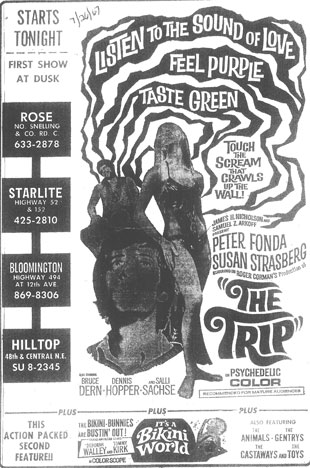
Super Sunday: 1967
KDWB presented “Super Sunday,” starting with their third annual Drag Race Festival at Minnesota Dragways (Highway 242 in Coon Rapids) on August 20, 1967. 10,260 spectators watched 552 cars race, and trophies were presented by Miss Mann Theaters Teenager (where is she now?). Also featured was a grudge match between Earl Trout and Tac Hammer.
That night at the Minneapolis Auditorium they presented Herman’s Hermits, the Blues Magoos, and the Who, who totally wrecked their instruments. Ticket prices ranged from $3.25 to $5.25, with discount tickets available at Pedwin Shoes at Knollwood.
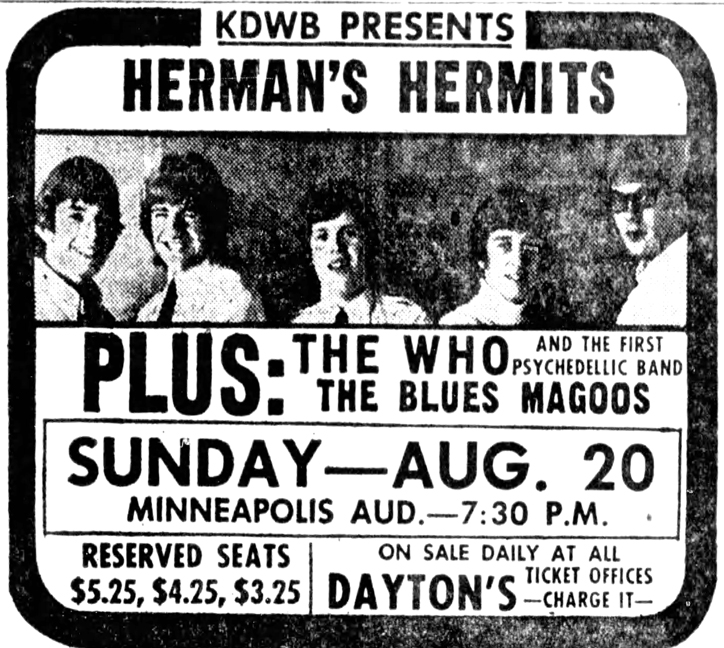
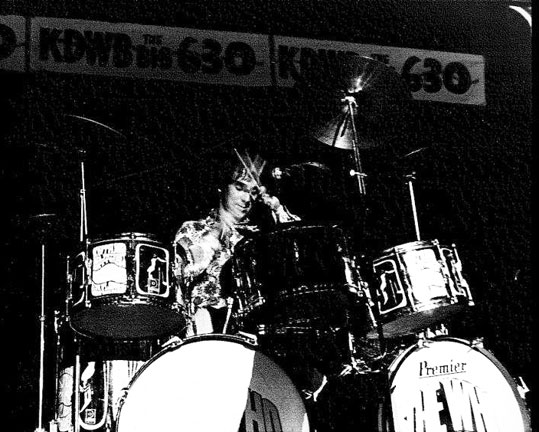
Keith Moon – Photo copyright Mike Barich, St. Paul
Mike says the band kept most of his negatives, but he still has the drum sticks!
Back to School Dance: 1967
On August 21, 1967, a 12-hour Back to School dance was held at the Aldrich Arena, featuring the following local bands: (Thanks to who ever posted this poster on Facebook!)
- The Mystics
- The Del Counts
- Pride & Joy
- Showtime
- The Marauders
- The Bananas
- The Grasshoppers
- Sunshine World
- Zarathustra
- Kaleidoscope
- The Sir Raleighs
- Fairchild
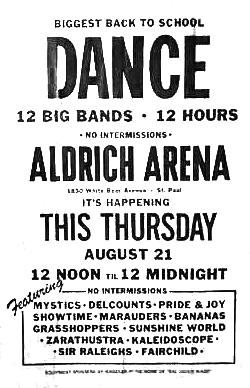
I had this item also: In August 1967 the Fillmore Light Show came to Aldrich Arena, with six top bands (unnamed in the ad). Not sure if this is the same event. A search of Aldrich Arena only brings up hockey games.
WDGY/Minnesota Vikings Huddle Club: 1967
In October 1967, boys ages 8 to 15 could join the WDGY/Minnesota Vikings Huddle Club, co-sponsored by the breakfast drink “Beep.” For $1.00 membership, you got:
- Membership card
- Official T-shirt
- BEEP for Breakfast certificate
- Vikings insignia
- Player-of-the-Week Contest
- Father-Son Banquet where you could meet the Vikings
Tackle Grady Alderman was the Honorary Huddle Club President. Join Today! (Minnetonka Herald)
KDWB DJ Earl L. Trout III Jailed: 1967
On September 16, 1967, KDWB DJ Earl L. Trout III was jailed for obstructing traffic, and he refused to be bailed out until $10,000 was raised for the Aid for Leukemia Stricken Children Fund. Read about it in The Beat Magazine, courtesy www.Radiotapes.com
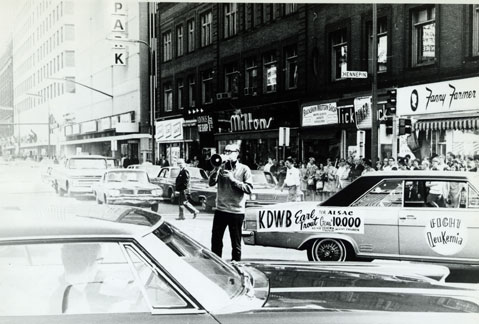
Photo copyright Mike Barich, reproduced with permission
Up With People: 1967
The Sing Out Troupe came to town in October 1967 to perform an original musical, “Up With People,” at the Minneapolis Auditorium, the St. Paul Auditorium, Hopkins High School, Blake School, and several other area schools. The group started in 1965 with 130 young people at a youth conference sponsored by the Moral Rearmament, a nonprofit, nonsectarian group espousing “absolute moral standards, and love of home, homeland, and humanity.” By 1967 there were three troupes of 150 members each. They traveled the country, with members staying in the homes of the host cities and subsisting on money from home and donations (e.g., Munsingwear donated some underwear..) They travel out of suitcases on a bus: “Sometimes it’s rugged, but directing your lives to absolute moral standards takes much more guts than doing just what’s easy and fun,” one participant said. “Hippies who discuss problems but don’t do anything about them don’t accomplish anything, and they hurt us.” (Minnetonka Herald) The group morphed into Up with People, founded by J. Blanton Belk in 1965 as a positive voice for young people during a turbulent period in the United States. Its historic path officially began in 1968 when it was incorporated as a 501(c)(3) international, educational non-profit entity.
Night of Stars: 1967
October 8, 1967, saw a huge Night of Stars at the St. Paul Auditorium. Participants were:
- Frank Sinatra
- Dean Martin
- Milton Berle, Master of Ceremonies
- Nancy Sinatra
- Pat Henry, comedian
- The Four Step Brothers
- The 5th Dimension
- Morgana King, jazz singer who later acted in the Godfather I and II movies
- Trini Lopez
- Buddy Rich and His Orchestra
According to the program, Hubert H. Humphrey, then our Vice President, was the special guest.
Fortunately, Dan Simon saved his program! He also remembered that Dean Martin was a no-show.
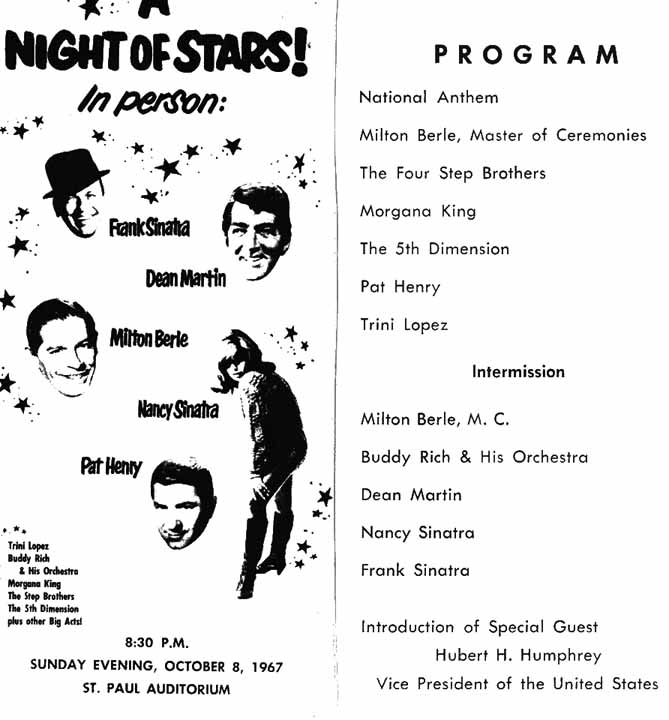
Courtesy Dan Simon
Go For a Goal, North Stars: 1970
The Metropolitan Sports Center was built for the new National Hockey League expansion team, the Minnesota North Stars. The first game of the season was on October 11, 1967, on the road against the St. Louis Blues, another expansion team. The game ended in a 2-2 tie. On October 21, 1967, the North Stars played their first home game against the California Seals. Spectator seats were in the process of being installed as fans arrived at the arena for the first time. The North Stars won 3-1.
In 1970, a team song was written by Herb Pilhofer and Dick Wilson, called “Go For a Goal, North Stars.” Arne Fogel gives us great background info: “That’s me singing on it. Dale Menten is probably there as well, and also a guy on many sessions at the time, Bruce Winther. Most prominent female voice on the disc is that of Joanie Knutson (Joanie Pilhofer at that time). We cut the song during one session, and were called in several days later to re-do it; the client could not hear the articulation of the ‘L’ at the end of the word ‘Goal’ (it sounded like ‘Go for a Go’). So, we did it again, and that’s why you can hear us seemingly ‘over-articulating’ the letter ‘L’ at the end of the word ‘Goal’… ” Just saw this for sale for $337.50, but you can Hear it Here.
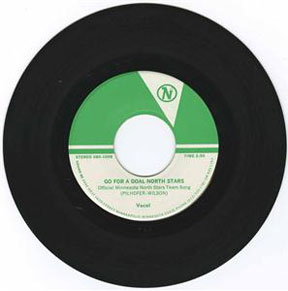
Teensters! Here is what’s next in YOUR Music: 1967
December 1, 1967, Minneapolis Auditorium: “Teensters! Here is what’s next in YOUR Music: hear a dynamic new dimension in sound: BILL PAGE and the world’s first All Ampliphonic Orchestra. In Person – in Live Stereo! Hear the ‘Sounds of the Sonic Sixties’ … conducted by Bill Page, for many years featured soloist with Lawrence Welk, and numerous Hollywood TV shows. For the first time, a complete orchestra – all electronically enhanced! See a big Hollywood production using exciting film backgrounds on rear-screen projection, featuring top TV and radio Vocalists!” Participants were:
- Emcee Mel Jass
- Burt Hanson – Vocalist on WCCO radio, Arthur Godfrey Show and Don McNeil Breakfast Club
- Dorothy Harpell – Vocalist and star of her own Canadian radio and TV shows
- Scott Page – Bill’s 15 year-old son and trumpet virtuoso; appeared on Lawrence Welk Show at age 8.
New Year’s Eve Party: 1967
Magoo’s/New City Opera House hosted two New Year’s Eve Party extravaganzas that featured eight local bands. All those bands and a Magooburger – sounds like heaven!
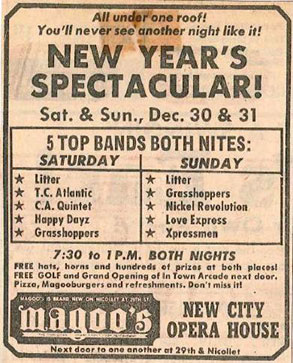
Events: 1968
The Lemon Pipers appeared at the New City Opera House on January 12, 1968.
Julian “Cannonball” Adderley appeared at Northrop Auditorium on January 20, 1968. His Quintet also included his brother Nat. Guitarist Wes Montgomery and vocalist Jean Dushon were also on the bill.
On January 29, 1968, Donald Broas’s application to turn the Chanhassen Body Shop into a teenage night club was unanimously turned down by the village council. “Fears were expressed as to the adequacy of parking facilities, whether the village could handle the influx of some 500 additional teenagers, the traffic problems which would arise and proper policing of the dance hall.” Damn teenagers! (Minnetonka Herald, 2/8/1968)
Al Hirt, with Pee-Wee and the Young Set, appeared at Northrop Auditorium on February 10, 1968.
In the February 24, 1968, issue of The Beat, “KDWB Asks YOU To Help Bring The Beatles Back to U.S.” Earl Trout III spearheaded the letter writing effort to get the Beatles back. At issue was the promise of the audience to be quiet so the music could be heard. The goal was to send Trout to London with a million cards, letters, and petition signatures. Alas..
SUPER SCENE ’68
On March 8, 1968, WDGY sponsored “Super Scene ’68.” The show was at the Metropolitan Sports Center in front of 6,000 fans. It was co-sponsored by WDGY, and the station’s DJs Scott Burton and Johnny Canton cut fine figures in their Oleg Cassini Nehru suits (the “Raja” model), courtesy Kieffer’s. Also appearing were JJ Bowman and Jerry Brooke. The show was produced by Dick Shapiro and the list of performers was impressive:
- Wilson Pickett (the Insider said the band used the gig for practice)
- The Hollies
- Strawberry Alarm Clock (Insider said “disappointing”)
- The Mystics
- The Del Counts
- The Sir Raleighs
- The Nickel Revolution. Read an account of this monumental event on the Nickel Revolution’s blog.
Connie’s Insider noted a “shortage of Negroes” at the show, wondering if they knew that Pickett was on the bill.
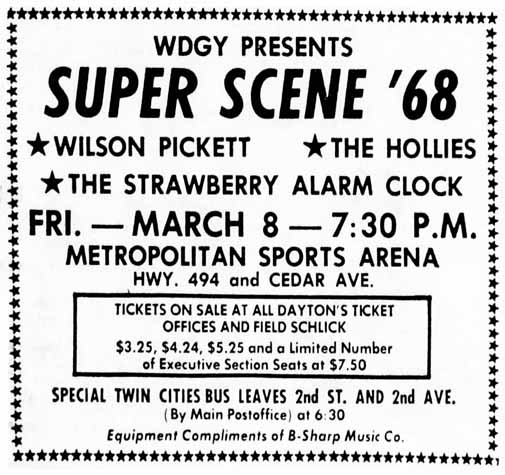
Minneapolis Star, March 4, 1968
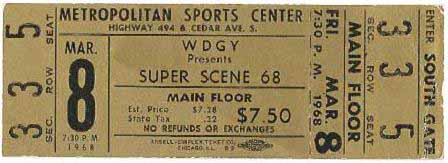
Ticket image courtesy Jerry Lenz, Nickel Revolution
Joan Baez appeared at the St. Paul Auditorium on March 12, 1968. Also appearing were anti-war activist Daniel Berrigan and Spider John Koerner.
Them and the Litter appeared at the New City Opera House/Magoos on March 15 and manager Gary Jorgensen said it was the biggest crowd in two years.
KRSI sponsored its third annual Hawaiian Holiday from March 23 to April 7, 1968. “Spend two fabulous weeks in sun-drenched, blue-skied, sandy-beached Hawaii! Join the KRSI ‘Hawaiian Holiday’ that’s strictly for Suburban swingers! Program Director Tom Wynn will be your happy host. Plan now!”
The Temptations played the Minneapolis Armory on April 7, 1968. Members were David Ruffin, Paul Williams, Melvin Franklin, Eddie Kendricks, and Otis Williams. Martha Reeves and the Vandellas may have also been on the bill.
Checker recording star Little Milton, with local band Maurice McKinnis and His Fabulous Blazers, appeared at a dance at the Minneapolis Armory on Friday, April 12, 1968. The show was emceed by KUXL’s Jack Harris and Billy G. Little Milton’s hits were listed in an ad in the Insider as “We’re Going to Make It,” “Blind Man,” and “More and More.”
Duke Ellington, Tony Bennett, and comedian Jack E. Leonard appeared at the Minneapolis Auditorium on April 28, 1968. Ellington brought a 15-piece band. Leonard’s jokes were on and off-color.
Cream performed at the New City Opera House on May 5, 1968. Here’s a link to a story about this epic event!
Herb Alpert, Blue Cheer and the Castaways (an odd grouping to say the least) played Williams Arena at the U of M on May 11, 1968. Nearly 17,000 attended.
May 27, 1968, was the date of the Second Annual 1968 Connie Awards.
Local musician and man-about-town Arne Fogel recorded a song back in ’68, kind of a Simon and Garfunkel/Chad and Jeremy type ditty called “I Once Had a Dream“ (aka “December Song”), recorded at Dove Studios with fellow singer/songwriter Steven Longman. The record never made it to the big time, but is available from Get Hip Records on a Dove Records compilation called “Free Flight.” Arne started his singing career when he was 17, and made his mark singing over 1,500 commercials and jingles. He owns every Bing Crosby record ever released, and shares his record collection on various radio shows.
St. Louis Park High Junior Barb Friedman got the chance to made a demo of her songs in New York in June 1968. Besides singing, Friedman played guitar, piano, drums, tambourine, bongos, harmonica and recorder. She played for school clubs, community organizations, and at local places like Big B’s Pizza at Texa-Tonka Shopping Center. She also played at the Cafe Extempore and with an Aquatennial traveling group. She taught guitar at Park Music.
The Beach Boys played the St. Paul Auditorium on July 9, 1968. Also on the bill were Gary Puckett and the Human Beinz.
Frank Sinatra and the Four Seasons played a benefit concert for the Citizens for Humphrey Committee at the Met Center on July 16, 1968.
By August 13, 1968, Jonny Matthews was playing “Underground Music” on KDWB, 11 pm to 5 am.
On August 20, 1968, Simon and Garfunkel appeared at the Minneapolis Auditorium at 8 pm.
On August 23, 1968, the Vanilla Fudge was scheduled to do a show at the Minneapolis Armory, but never showed up. Local Group the Nickel Revolution opened the show, followed by Tommy Boyce and Bobby Hart. Next came bubblegum act 1910 Fruitgum Company, which overcame its nursery rhyme image to pull out a performance that satisfied the crowd screaming for Vanilla Fudge. Read a great account of the event on the Nickel Revolution’s blog. Promoter Arne Sigarski had to provide refunds for that show.
The Spokesman advertised a free concert in Loring Park featuring the Marvelettes on August 30, 1968. It was sponsored by the Mayor’s Council on Youth Opportunity.
The St. Paul Police Historical Society’s web site reports: “During the evening of August 30, 1968, violence erupted in Stem Hall of the St. Paul Auditorium when police officers attempted to intervene in a fight between patrons. An officer responding to the call for assistance was wounded by gunfire. The incident sparked a full-scale riot that rapidly spread to the streets, where large numbers of citizens hurled bottles, rocks and other debris at police lines. Extensive vandalism and property damage was reported from area businesses and private citizens in the area of the riots. The severity of the violence led to a total recall of the Department’s sworn personnel. After reinforcements arrived and the unruly crowd dispersed, rioting continued in the Selby-Dale area well into the early morning hours. The disorder continued for the next 24 hours, eventually resulting in the wounding of three officers by sniper fire.
Lawrence Welk played the Met Sports Center on September 3, 1968.
THE RASCALS
The Rascals performed at the Minneapolis Armory on September 18, 1968. Bruce Arneson remembers that the opening act was the local band Seraphic Street Sounds, a short lived, amazing combo, with each member a lead singer in their own right. Michael O’Gara ended the set with the Jay and the Americans’ song “Cara Mia,” holding that ‘big note’ at the end like a true ‘Opera Star.’
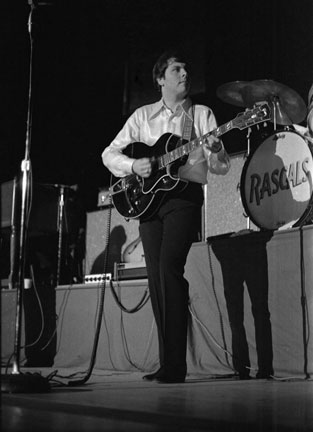
Photo copyright Mike Barich
The New Christy Minstrels appeared at the Hamline University Fieldhouse on September 24, 1968. Where magazine described them as “a lively group of eight young singers.. which combines banjo music with folk singing and a great deal of enthusiasm.”
Harry Belafonte headlined a show at the Minneapolis Auditorium on September 24, 1968. The show also included Dolores Hall, Kim Weston, and the Belafonte singers and orchestra.
Donovan appeared at the Minneapolis Auditorium on October 13, 1968.
Flatt and Scruggs appeared at the Guthrie on October 13, 1968.
JOE TEX, BOYCE & HART, RASCALS, TINY TIM
Joe Tex; Tommy Boyce and Bobby Hart; the Young Rascals, and Tiny Tim played the Met Center on October 18, 1968.
Local group the Sir Raleighs were the opening act. According to MinnesotaFunFacts.com, the Moody Blues first U.S. concert appearance was scheduled for Minneapolis that night, but their equipment was held-up in U.S. Customs in Boston. The show was a benefit for the newly-formed Robert Kennedy Institute for Social Advancement, an organization formed to “develop better understanding between the general public and the American Indian.” (Minneapolis Tribune, October 13, 1968)
David Hicks remembers:
I was an usher for Bob Sims (who had the ushering concession) from 1966 to 1971 and I saw many of these concerts. The Tiny Tim concert at Met Center was sort of neat to me. He entered the stage (the stage was not at the end of the arena but on the side right in front of the hockey benches) with the lights out from one of the entrances for the hockey team and I was asked to escort him to the stage. He had a wireless microphone which was quite new at the time, and was talking to the crowd in an eerie voice as we entered the arena. There I was walking with Tiny Tim escorting him by the elbow from the dressing room to the stage. For a 17 year old kid it was quite a thrill.
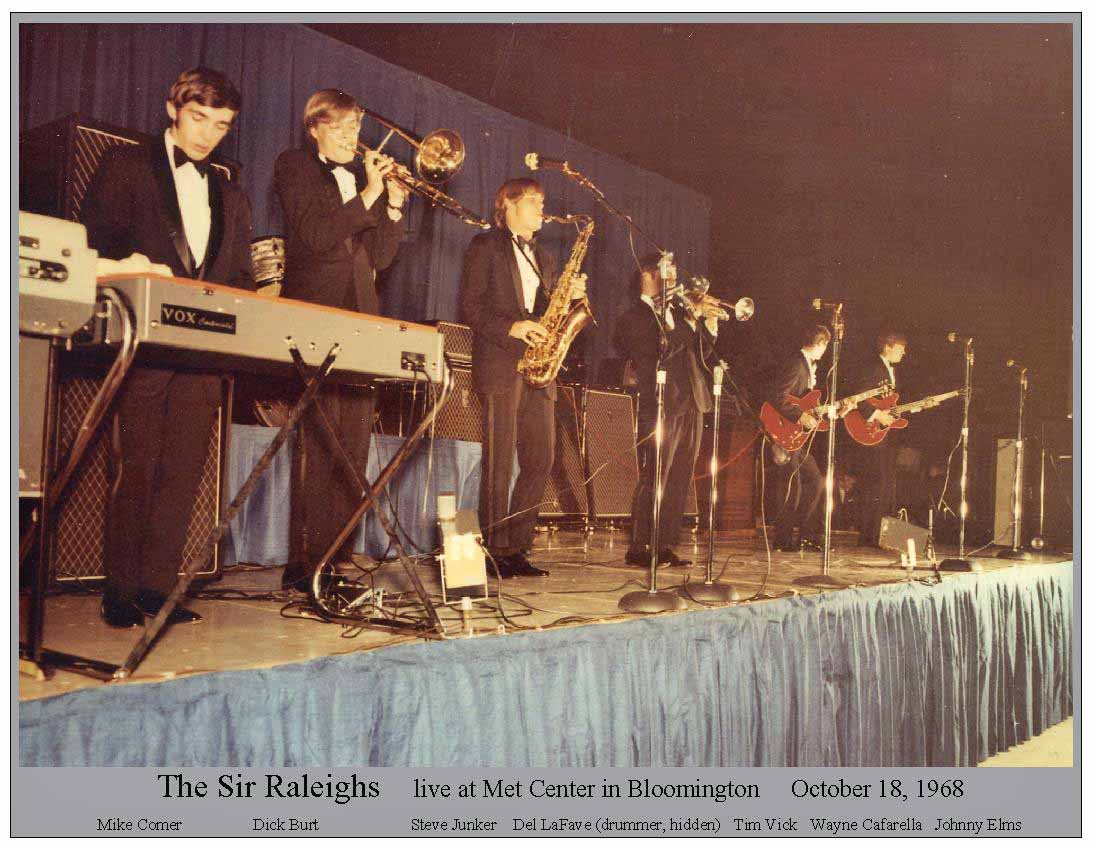
Photo courtesy minniepaulmusic.com
Baritone John Gary appeared at Northrop Auditorium on November 2, 1968, as part of a Celebrity Series under the University Artists Course.
A strange pairing of Eddy Arnold and the Cowsills appeared at the Met Sports Center on November 3, 1968.
In his November 18, 1968 column “Musically Yours” in the TV Digest, Timothy D. Kehr writes of the group H.P. Lovecraft. Was this local? Can’t find it anywhere. But Howard Philips Lovecraft was a poet and novelist.
Pianist Van Cliburn appeared at Northrop Auditorium on November 19, 1968.
A jazz festival at the Minneapolis Auditorium featured Hugh Masekela and Herbie Mann on November 29, 1968.
The Four Tops appeared at the Minneapolis Armory on December 3, 1968.
ANDY WILLIAMS, ROGER MILLER
Andy Williams and Roger Miller played the Met Center on December 6, 1968 at the WDGY Holiday Spectacular. Johnny Canton remembered:
One of WDGY’s largest concerts/shows starred then-popular Andy Williams along with Roger Miller at Met Center. It was our Christmas Concert and we filled Met Center. Of course, Andy was the pride of network TV at the time with his weekly show. Miller was no slouch either having had several hit songs. The entire WDGY air staff had a chance to take the stage and emcee. Great evening!
The Brothers Four appeared at Melby Hall, Augsburg College, on December 7, 1968. Bass player Bob Flick later married Minnesotan Loni Anderson.
Blue Cheer appeared at the New City Opera House on December 8, 1968, in front of a small crowd of 200-300 people. Also on the bill were Happy Dayz and White Lightning. “They were too damn loud,” one reviewer complained. Michael on Facebook remembers: “Saw that Blue Cheer show. Super loud, total noise until they stopped and sang the phrase ‘ain’t no time for the summertime blues.’ Then total noise again …”
GRAND OLE OPRY
A Grand Ole Opry Show show came to the Met Center on December 28, 1968, starring:
- Jeannie C. Riley
- Dave Dudley
- Billy Grammer
- Bobby Lord
- The Compton Brothers
- Jim and Jesse and the Virginia Boys
- Comedian Red Murphy
A Different Breed of Cat: 1968
The Dave Rooney Trio recorded their album “A Different Breed of Cat” at Diamond Lil’s on February 2 and 12, 1968. Leigh Kamman was the producer and Dick Driscoll was the recording engineer. Cool cars, cool chicks, cool cats!
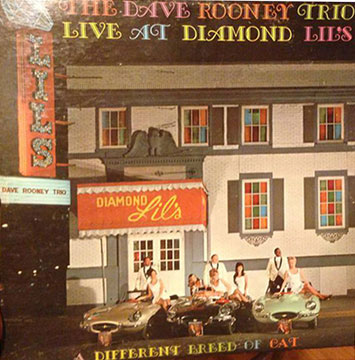
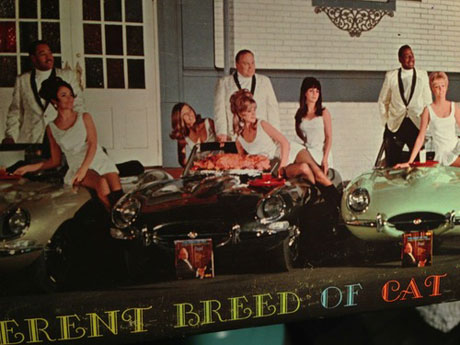
Minneapolis Auditorium: 1968
Buck Owens and his Buckaroos appeared at the Minneapolis Auditorium on February 17. Now you may say that Buck Owens isn’t rock ‘n’ roll, but the show was advertised on my February 10, 1968 WDGY 30 Star Survey, so here it is. Also on the bill were Freddie Hart, Tommy Collins, Kay Adams and Wynn Stewart.
The Righteous Brothers appeared at the Minneapolis Auditorium on March 10, 1968 – new time and date from a previous booking.
An Easter Fair took place April 9 to 14, 1968 at the Minneapolis Auditorium, and featured the Electric Prunes and Blue Cheer, two of the noisiest national bands running. Another band was The Mob, and local groups the Underbeats and Perspectives were slated to appear. Also there were the gentler Buffalo Springfield — and Pat Paulson, who was running for President for the first of six times.
Johnny Cash and folks were at the Minneapolis Auditorium on April 20, 1968.
Not exactly rock ‘n’ roll, but Tony Bennett appeared at the Minneapolis Auditorium on April 28, 1968. The show also featured Duke Ellington and His Orchestra and comedian Jack E. Leonard. The show was Bennett’s only Midwest appearance and was presented by Ken Roberts.
Gladys Knight and the Pips appeared at the Minneapolis Auditorium on May 12, 1968, which was Mothers Day.
There is an interview of sorts with Peter, Paul and Mary in the May 22, 1968, Park High Echo, in conjunction with their appearance at the Minneapolis Auditorium.
Aretha Franklin, headlining “The Aretha Franklin Revue,” appeared at the Minneapolis Auditorium on July 19, 1968 as part of the Aquatennial Teen Spectacular, sponsored by WDGY. Also on the bill were the Mystics and Things to Come (the latter described by Barry L. Peterson in his review in the Minnesota Daily as a “coffe-house fisaco”). Peterson found the build-up to be too much and the first part of Aretha’s show to be “vaguely unsatisfying. “It wass not until she sat down to do ‘Night Life’ and I felt the audience around me lean forward sucking in their breath as though it were her words, that her music reached me. We wandered out – feeling empty but not at peace – we had been aroused, but left unsatisfied.”
WDGY jocks in the program were Scot Burton, Johnny Canton, Jay J. Bowman, Perry St. John, and Jerry Brook. Entire production under the supervision of Arnie Sagarsky, A&S Enterprises, Inc. and under the direction of Richard Shapiro, Central Booking. Floor direction by Patrick Devine!
The Blues Cube, formerly Marcia and the Lynchmen, were also scheduled to appear, but Marcia was in a car accident on her way home from a gig in Eau Claire and was in the hospital for a month so they were unable to perform. The Blues Cube played their final gig at the Prison in Burnsville on August 24, 1968. (Thanks, Mark Karnowski)
Because of rioting that followed the Torchlight Parade in 1967, organizers were considering cancelling the parade in 1968. Instead, they encouraged African-Americans to play a more active role in the 1968 festival. The Citizens’ Patrol, made up of both blacks and whites, helped with crowd control during the parades and the Aretha Franklin concert.
Simon and Garfunkel played the Minneapolis Auditorium on August 20, 1968.
Easter Fair: 1968
Bob Mecay and Tom Casteneda organized a giant Easter Fair at the Minneapolis Auditorium, April 9 – 14, 1968. Music stores had booths at the fair, and Vavro Music sponsored an amateur band contest throughout the event. Winners were to get bookings and prizes. Mel Jass acted as emcee for the various musical acts.
Local acts included:
- The Perspectives
- The Underbeats
- Riverboat Ramblers in the Beer Garden
- Bob Terri Trio in the Beer Garden
- Fabulous Fascinators (not sure if the “Fabulous” is part of the name or just an adjective)
National Acts were:
- The Electric Prunes
- The Mob
- Pat Paulson, April 9-11
- Maury Amsterdam, April 12-14
Minneap’lis Minnesota
Rufus Lumley recorded this single, but where and when is up for debate. One site said he recorded it in a bowling alley in Detroit in 1968. Facebook fans say they bought it in 1965/66. One discography site just says “unknown” for release date. But it’s a funky tune – listen Here.
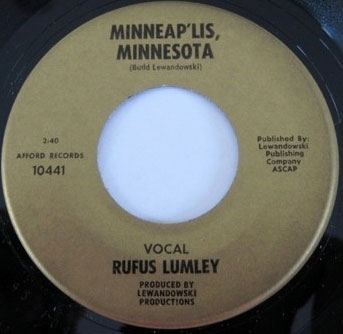
Humphrey Campaign: 1968
In his autobiography, Me, the Mob, and the Music: One Helluva Ride With Tommy James and the Shondells, Tommy describes his active role in Hubert Humphrey’s presidential campaign. He traveled all over the country, and even gave HHH a black beauty once to help him stay awake to write a speech. Tommy writes:
We were there the night of the election at the Leamington Hotel in Minneapolis. I can’t begin to tell you how electric the scene was. It was so exciting because of how much was riding on this election, the assassinations months before, the convention, the war – we felt like we were at the center of things. And we were. The hotel was filled with celebrities like Gene Barry, Lee Majors. All the TV networks were there. We were actually on all three at once and we played a couple of sets waiting for the results to come in. Nixon had begun months before with an outrageous lead in the polls, somewhere around 30 percent. By election night, the candidates were neck and neck. Humphrey credited us with the bump in the polls, and though I don’t think we played that crucial a part, we were tickled with the compliment.
David Hicks again:
Also in 1968 election night HHH had his election party at the hotel Leamington which had Tommy James and The Shondells playing at one side of the grand ballroom and Sonny and Cher playing at the same time on the other side of the ballroom. What a night. I was about 10 feet in front of the stage when HHH gave his [ever optimistic] speech at about 2:30 in the morning.
Tommy James said that the voting machines in Chicago had broken down. “Later that morning, a flood of votes went Nixon’s way and he was projected the winner. Everyone knew what had happened. It was Mayor Daley’s revenge on the Democrats for his national humiliation at the [Democratic National] convention.” Humphrey officially conceded the next day.
Summer ’68 Action Tour for Teenagers: 1968
Dick Clark Action Tours sponsored a “Summer ’68 Action Tour for Teenagers,” from August 9 to 29. Stops included Hollywood, Hawaii, and Mexico. Price: $775 from Los Angeles. This ad was in the St. Louis Park Echo, June 4, 1968:
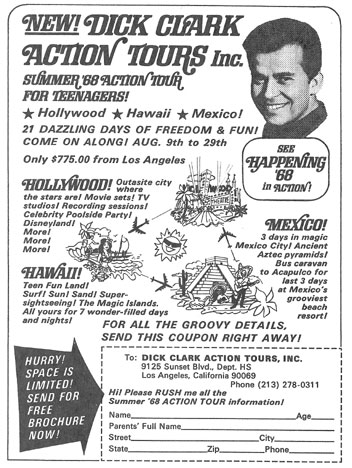
Jimi Hendrix: 1968
Jimi Hendrix was slated to play the Minneapolis Armory on August 11, 1968, but the date was moved to November 2, 1968, at the Minneapolis Auditorium. About 6,000 people saw the 45 minute performance.
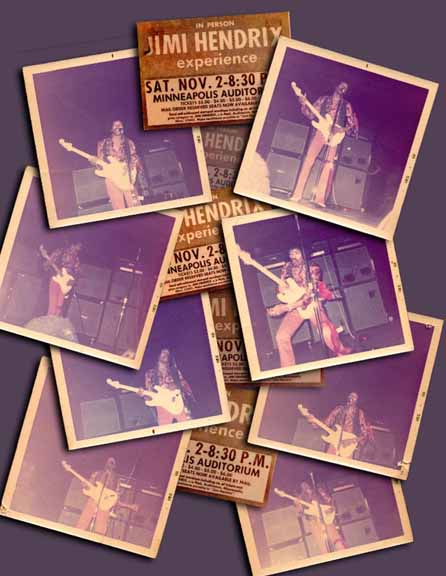
Collage of Tickets and Photos courtesy Robb Henry
Notes from Tony Glover’s review in Metanoia:
- Cat Mother and the All-Night Newsboys opened the show [do you remember their hit?] “They seemed to be a pretty tight group, using electric fiddle and mandolin off and on… But how many really paid any attention to them? Turns out Hendrix was producing them.
- Hendrix, “his sidemen and his road managers are about the nicest group of people I’ve come in contact with in the music business, ever. And that’s saying something.”
- Jonny Matthews, “underground cat at KDWB,” introduced the band.
- After the first number (“Fire”) “he says that there is amplifier trouble. With a grin he announces, ‘We want to dedicate this number to all the narcotics agents and plainclothesmen here, you know who you are … and any other bastards who might be in the crowd.'”
- During the second number the crowd surged forward and “one chick fainted.” The promoter wanted security to clear the stage area but the Hendrix people encouraged the surge. It got dangerous. After the number Matthews announced that the show would be stopped unless people returned to their seats.
- “There’s a fantastic hostility flow in the crowd near the stage”
- After “Voodoo Chile” Hendrix says, “Please give us another ssecond to get our amplifiers straight” and leaves the stage, “disgusted.”
- Next song is a 15-minute “Red House.”
- Hendrix: “This song is dedicated to somebody’s girl friend tonight, I don’t know who yet, we’ll find out after the gig…”
- He keeps complaining about the equipment, although Glover says it sounds fine.
- Hendrix thanks the audience, says he’ll be back and play twice as long, and then launches into the “Star Spangled Banner,” which turns into “Purple Haze.”
- Glover claims that Hendrix actually sings, “‘Scuze me while I kiss this guy” and turns toward bandmate Mitch Mitchell.
- They stayed at the Ritz – after the show they watched Laurel and Hardy on TV.
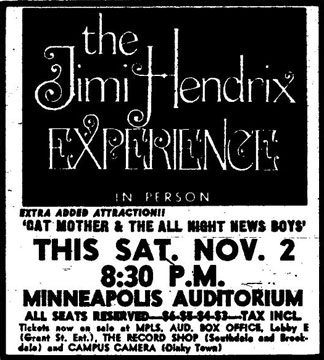
Allan Holbert of the Minneapolis Tribune was not impressed!
The Jimi Hendrix show at the Minneapolis Auditorium Saturday night was billed as “an experience,” and that’s a good name for it. It was an experience, an undesirable one. For those of you who are not yet aware of this shining new talent, Jimi Hendrix could be best described as a black Elvis Presley. That is to say, he doesn’t sing too well, and he doesn’t play his white guitar too well, but he does have a lot of sex.
HE HAS long hair. He wears a pink, flowery shirt and pink pants and white shoes. He twists and moves around a lot as he sings and caresses his guitar. So his talent is really not significant and neither is that of something called [Mother] Cat and the all night newsboys, the rock band that preceded Hendrix before intermission. The things that made the Hendrix experience an experience was the behavior of the love-oriented (remember) hippie types in all their conforming nonconformist costumes who crowded and forced themselves up to the front of the stage when Hendrix came on.
THE MUSIC by Hendrix and his two white sidemen was loud but not too clear. Among his songs were “Foxy Lady” and “Are You Experienced,” which he dedicated to “all the narcotics agents and detectives and a few other bastards.” People sitting in the balcony probably had no trouble seeing Hendrix. For those sitting up front it was quite difficult because of those rude, smelly long-haired kids who pushed their way up to the stage, completely intimidating law officers and Andy Frain ushers. It was possible to see if you stood up, but Jimi Hendrix isn’t worth standing up for.
From Owen Husney:
My friend and I spent the night hanging with Jimi after the show that night. He played the Minneapolis Auditorium and stayed at the old Sheraton Ritz downtown. I’ll never forget that evening..just the three of us talking music and watching Laurel and Hardy on TV (with the help of a few other things). One of the nicest people I’ve ever met.
Photos below of the band and unidentified Braniff International stewardesses at the airport are from Robb Henry, who got them from a collector in New Zealand.
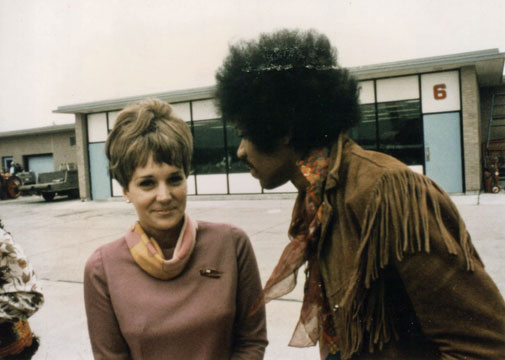
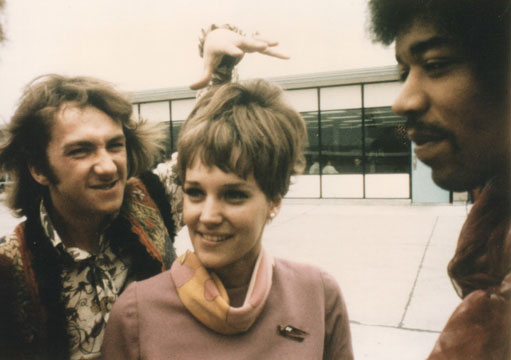
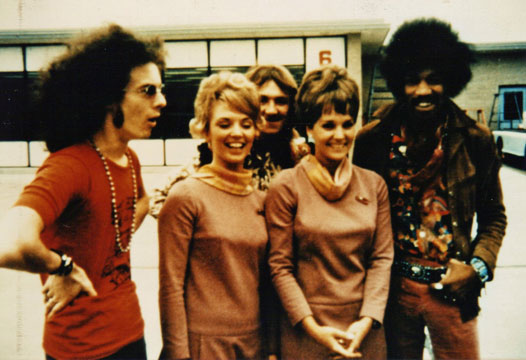
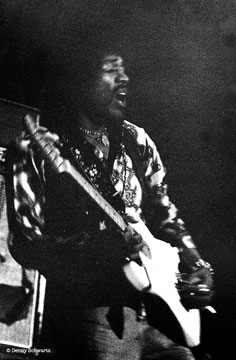
Photo by Denny Schwartz
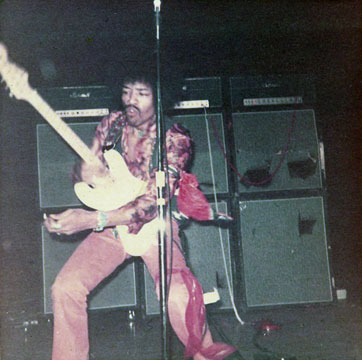
Photo courtesy Robb Henry
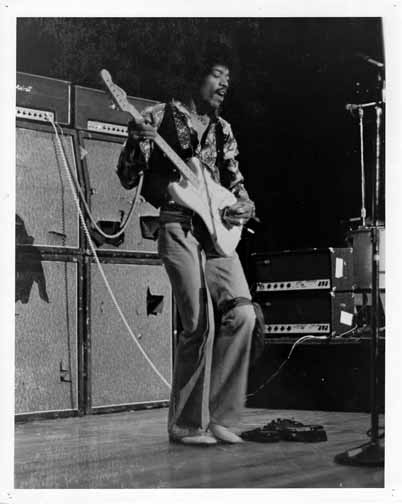
Photo courtesy Mike Ciresi
The Doors: 1968
The Doors played the Minneapolis Auditorium on November 10, 1968.
The opening act was Midwest Hydraulic Company.
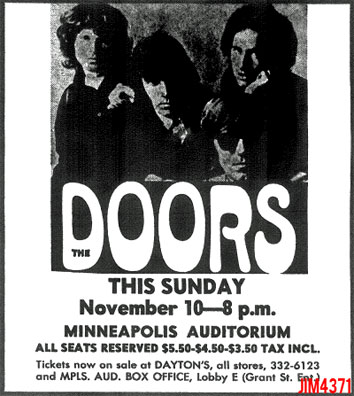
Photo from www.mildequator.com
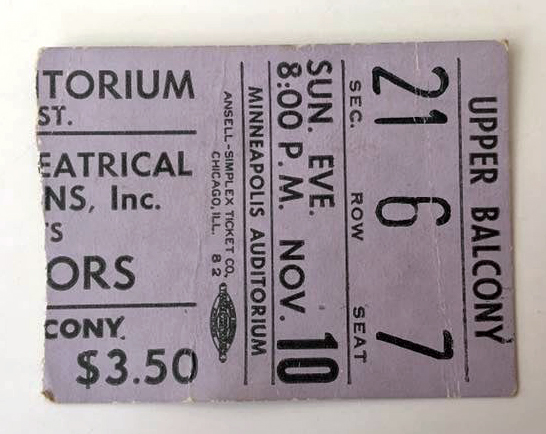
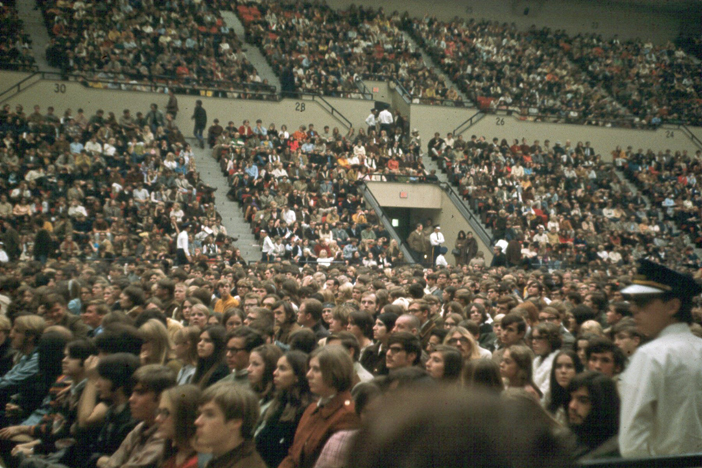
Crowd shot courtesy Al Bjerke
Reports are that Jim Morrison drank “numerous Hamm’s beers from 16oz. cans on stage” and then “puked onstage behind the guitar amps during an instrumental section.”
Burton Cummings of the Guess Who, via Facebook:
I was actually at this show in Minneapolis in November of ’68…seven of us drove in two cars, 500 miles from Winnipeg in the winter to see the Doors live. We were up in the balcony, but it was still an event to remember. Very, very loud, even up where we were. Jim’s screams were deafening. Tony Glover played some harp, but true Doors fans couldn’t have cared less about Tony Glover. Jim swore a lot, really foul mouthed that night, we’d never heard that kind of language out in the open in a huge crowd before. They didn’t play that long, but it was pretty hypnotic at times…highlight…actually being there for “When The Music’s Over” live…about twenty minutes worth of history…
TONY GLOVER IS A DOOR FOR A DAY
Local musician and DJ Tony Glover was invited to join them on harmonica – he is seen in the photos below.
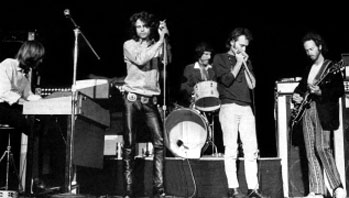
Photo from www.mildequator.com
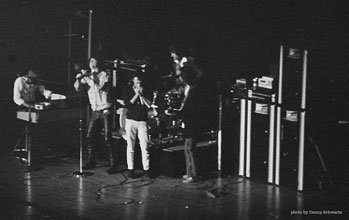
Photo by Denny Schwartz
YouTube videos from that show:
“Love Me Two Times,” featuring Tony Glover
SETLIST (From Setlist.fm)
Soul Kitchen
Break on Through (To the Other Side)
When the Music’s Over
Back Door Man (with Tony Glover on harp) ((Including “Next One Down Upon The Line” & “Fuck Me, Babe” interludes)
Little Red Rooster (with Tony Glover)
Wild Child (with Tony Glover)
Money (That’s What I Want) (with Tony Glover)
Love Me Two Times (with Tony Glover) (Including “Softer” & ” Love You All Night Long” interludes)
Mystery Train (“Love Me Two Times” continued)
Light My Fire
Flight: 1968
KDWB, in conjunction with MGM Records, held a talent contest in an extensive campaign to promote the film “The Impossible Years,” a film about the generation gap. The record company wanted to find a band that they could name after the film (and presumably either appear in the movie or sing the theme song).
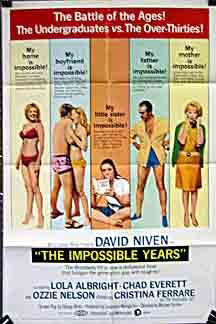
In the Twin Cities more than 30 bands submitted audition tapes. The winner is the relatively new band Flight, a precursor to the mighty Pepper Fog, made up of Dale Strength on guitar and vocals; Gregg Inhofer on keyboards and vocals; Ron Merchant on bass guitar and vocals; and Bob Strength on drums and vocals. The band plays cover songs from the hard rock bands of the time including: Jimi Hendrix; Cream; The Who; The Rolling Stones; and Vanilla Fudge. In the fall of 1968 Flight recorded a version of “Sugar and Spice” (by The Cryan’ Shames from Chicago) at George Garrett’s basement studio as their audition tape. Flight won our local contest, moving on to a regional competition in Chicago. Runners up were Holy Smoke and Dandelion Wine, and all-girl band. In Chicago the winners were the Pacers, from Lincoln, Nebraska, but the theme of the movie was ultimately performed by the Cowsills.
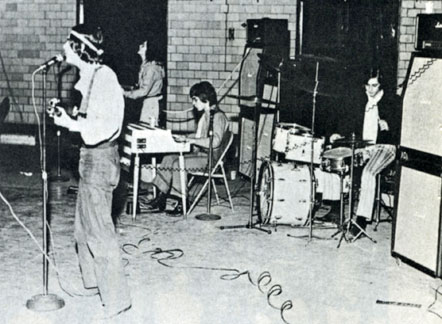
Flight, from the December 21-28, 1968 Insider; photo by Mike Barich
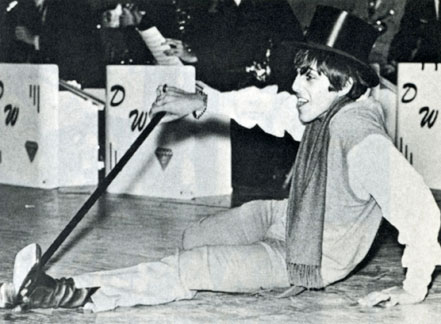
Flight also earned the job of opening for Indian teen idol Sajid Khan, who opened his show at the Minneapolis Armory on December 14, 1968 by riding in on an elephant. This photo of Kahn, taken by Mike Barich, appeared in the December 21-28, 1968 Insider.
Annual Christmas Party: 1968
Concert promoter and local music industry giant Marsh Edelstein held the first of his annual Christmas parties at Magoo’s on December 18, 1968. He had already been holding an annual Memorial Day Barbeque. The Insider reported that a jazz trio was hired but there was no piano so they went home. “Everybody in the industry was there, including some who just dropped in off the street seeking shelter from the snow. He fed them too.” Marsh is still hosting Christmas parties to this day.
Big Daddy Wagg: 1968
“Big Daddy Wagg” owned Wagener Music, the Vox dealership in Minneapolis, with one store on Penn Ave. No. and another in on Highway 61 in the White Bear Shopping Center. On December 25, 1968, he held a music marathon featuring local bands:
- South 40
- Del Counts
- Grasshoppers
- System
- Bananas
- Clover
- Electric Brigade
- Soul Purpose
- Youngsters
- Stillroven (maybe)
New Year’s Eve: 1968
The Insider reported that all the teen clubs except Magoos’ and Dania Hall were closed, citing too much trouble controlling underage drinking.
Almost 1,000 people crammed into Magoo’s to hear seven bands:
- Flight
- Stillroven
- White Lightning
- South 40
- Youngsters
- Del Counts
- Zarathustra
The Dania Hall show was promoted by Steve Barich and either was planned as or turned into a “jam session for musicians.” One of the bands there was Poison Bird Pie.
KDWB Underground Show: 1969
Johnny Matthews did his KDWB Underground Show from the New City Opera House on January 5, 1969, in front of 700 fans. Appearing on the show were:
- White Lightning
- Jokers Wild
- CA Quintet
- Skin Trade
- Michael Yonkers
- Nickel Revolution
- Poison Bird Pie
Events: 1969
Deep Purple appeared at Dania Hall in 1969, someone remembers.
Andy Williams and Roger Miller performed at the Met Sports Center on December 6, 1968, at a show sponsored by WDGY.
Blood, Sweat and Tears, January 16, 1969.
The Buckinghams performed at Hamline University’s Norton Fieldhouse on January 17, 1969.
Blackwood Apology appeared at Dania Hall on January 19, 1969.
The Brothers Four appeared at Augsburg University on January 24, 1969.
Wilson Pickett, Northrop Auditorium, January 25, 1969
Johnny Matthews did a remote “Pop and Head Show” on KDWB from the New City Opera House on February 2, 1969. It was sponsored by Trafficante Music Store.
The Grateful Dead appeared at the Labor Temple on February 2, 1969.
Jethro Tull and the Rotary Connection appeared at the Labor Connection appeared at the Labor Temble on February 9, 1969.
Buddy Miles appeared at the Labor Temple on March 2, 1969.
Sweetwater, supported by Blackwood Apology and Zarathustra, appeared at “Magoo’s New City Opera House” on March 7 and 8, 1969. “Stars of Miami Pop Festival – Album picked as one of ’68s 3 Best – The IN Group of 1969!”
Jokers Wild played a gig at Dania Hall on March 16, 1969.
The Association appeared at Melby Hall, Augsburg College on March 22, 1969.
Pete Seeger appeeared at the Guthrie on March 22, 1969.
The George Shearing Quintet appeared on March 23, 1969, possibly at Northrop Auditorium.
The Vogues appeared at St. Thomas College on March 29, 1969.
Mason Williams made a personal appearance at B.Dalton Bookstore at Southdale on April 3, 1969.
Vanilla Fudge and the Crazy World of Arthur Brown played the Met Center on April 11, 1969. Opening was The Stillroven.
Marshall Fine’s review was brutal, toward the venue and the performers. He deemed the Met Center perfectly fine for the North Stars, but “too much of a barn to play rock music in.”
His first scathing remarks were for local band The Stillroven: “The band showed a rare ability to take any good rock song and painfully decapitate it. They seem to work as alchemist in reverse, taking gold and turning it into tin.” Perhaps this review precipitated their breakup in July 1969?
He did like the Crazy World of Arthur Brown, who “put on a hell of a show.” The group consisted of an organist, a drummer, and himself. He called the music a weird combination of jazz and Gothic that could give you the chills. Brown changed costumes after every number, ranging from an orange velvet devil suit, to Papal robes, to a crown of flames. He ended his act with a puff of smoke, and Fine wished that the puff would have made Vanilla Fudge disappear, but unfortunately they showed up this time.
Fine had liked Vanilla Fudge on record, where they had taken old songs and completely renovated them in a good way.
In concert, however, they are simply offensive. They substitute obnoxious movements for true showmanship. And they replace musicianship with noise playing the amplifier rather than the guitar. Still it took gall to even come after they failed to show for their concert last August. (Minneapolis Star, April 12, 1969)
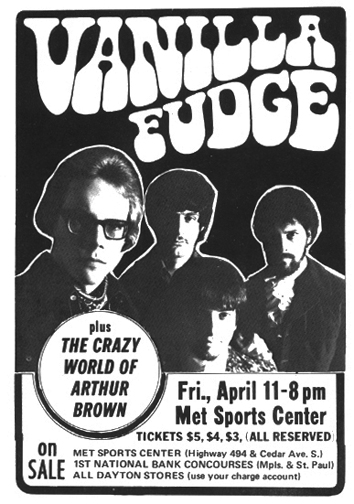
Ad from the Insider
The Iron Butterfly played the Minneapolis Armory on April 13, 1969. The show was opened by the Steve Miller Band and featured an early use of fire pots on stage.
Dick Winter at RW Music sponsored a Hootnanny on April 18, 1969, their second. KQRS had an RW Music Hour on Sundays at 9 pm.
April 23, 1969: Glenn Yarborough at Hamline University
Ravi Shankar appeared on April 27, 1969, possibly at Northrop Auditorium.
Grateful Dead, April 27, 1969
May 9, 1969: James Brown, Minneapolis Auditorium
Spirit at Labor Temple, May 11, 1969
Led Zeppelin, Guthrie, May 18, 1969
Deep Purple, Illinois Speed Press, Labor Temple, May 18, 1969
May 19, 1969, was the date of the 1969 Connie Awards.
Peter, Paul, and Mary performed at the Minneapolis Auditorium on May 24, 1969.
Rhinoceros and Aorta appeared at the Minneapolis Armory on May 31, 1969. “Ride the Space Waves of the Mind!” With light show by NOVA.
June 1, 1969: Albert King, Labor Temple. Didn’t show.
Gary Puckett and the Union Gap, the Peppermint Rainbow, and the Corporation appeared at the Minneapolis Auditorium on June 6, 1969. Also appearing were WDGY’s All-Americans: Johnny Canton, Jerry Brook, Scott Burton, Gene Leader, and Jim Dandy. Instruments were provided by B-Sharp Music. Puckett was born in Hibbing, spent a very short time in (was it Pelican Rapids?) and attended the U of M.
June 8, 1969: Who at Guthrie
Buddy Rich at the Prom, June 12, 1969.
The Doors played the Minneapolis Auditorium on June 15, 1969. The Staple Singers were also on the bill. An internet account indicates that members of the 8,500 audience called out for Jim Morrison to repeat his “Miami performance,” which had led to a charge of obscenity.
Photo below from the www.mildequator.com web page.
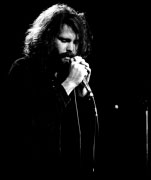
June 16, 1969: Walker Arts Center
June 29, 1969: Johnny Winters at Guthrie
Percy Faith appeared as guest conductor in the fourth concert of the Summer Pops Jubilee with the Minnesota orchestra on July 9, 1969, at the Minneapolis Auditorium.
Three Dog Night appeared at the Prison on July 9, 1969.
The Village of Mendota had its first Jazz Festival, July 11-13, 1969. Mendota was the home of the Hall Brothers Emporium of Jazz and the epicenter of Dixieland in the Twin Cities. Guest artists were Kid Thomas and his Preservation Hall Jazz Band.
July 13, 1969: Mothers of Invention, Guthrie
July 18, 1969: Dionne Warwicke
The New Christy Minstrels performed at a Hootenanny with the Minnesota Orchestra at the Minneapolis Auditorium on July 23, 1969.
The Buckinghams played the Prison on August 9, 1969.
August 23, 1969: Sir Douglas Quintet
August 30, 1969, was the date of the Jackie Awards.
Lee Michaels and the Mystics played the Prison on August 30, 1969.
In mid-1969 radio stations started presenting “underground” programs, usually late at night. Jimmy Reed and Tac Hammer did theirs on KRSI, and George Fisher had a Nightwatch show on KQRS.
Paul Revere and the Raiders came to Augsburg College on September 5, 1969.
On September 18, 1969, KDWB sponsored the Association at the Minneapolis Auditorium.
The Soul of a City Community Arts Festival was held on September 18-21, 1969, organized by Lonnie Morgan and the Center for Creative Communications. The festival included art, music, film, plays, dance, painting, even cooking.
In an October 1969 article in the Insider, frustration was expressed about high schools opening up their dances to non-students, taking business away from the teen clubs.
There was also discussion in the Insider about the fact that downtown clubs would not book bands with black members for fear that it would be labeled a black-only club and draw trouble. A solution offered was to have more than one to avoid concentration. This was a very controversial subject and discussed in detail in the Insider.
There was a fire at the Red Baron in October and the Paisleys lost all of their equipment. They took all of their insurance money and had their instruments replaced at Traficante’s music store.
Buddy Miles Express played the Prison in Burnsville on October 10 and 11, 1969.
Mason Williams appeared with the Minnesota Orchestra at Northrop Auditorium on October 12, 1969
Steve Miller appeared at the October 12, 1969.
Doug Clark and the Hot Nuts played at the Bank in October 1969. Really, follow the link.
Duff’s house band the Titans recorded “Ode to Billy Martin,” dedicated to the Twins Manager who had just been fired. It was on the Duff’s label. Didn’t find it on Youtube – probably a collector’s item!
Santana kicked off a new policy of national acts at the New City Opera House on October 16, 1969. Also appearing were Triad and the Paisleys.
Johnny and Edgar Winter appeared for a Homecoming Concert at Northrop Auditorium on October 18, 1969.
Judy Collins appeared at Stem Hall at the St. Paul Auditorium on October 19, 1969.
The Fifth Dimension played the Minneapolis Auditorium on October 21, 1969.
The First Edition and Pat Paulsen appeared at Augsburg College’s Melby Hall on October 31, 1969.
Pacific Gas & Electric played at the New City Opera House on October 31, 1969.
John Gary performed at the St. Paul Auditorium on November 5, 1969.
Joe Cocker appeared at the Guthrie on November 9, 1969.
Herb Alpert and the Tijuana Brass and O.C. Smith played the Met Center on November 21, 1969.
Three Dog Night appeared at the St. Paul Auditorium on November 23, 1969.
Arlo Guthrie, November 23, 1969.
The Nice, November 26, 1969
The New Colony Six appeared at the New City Opera House/Magoos on November 29, 1969.
James Brown brought his “Popcorn Festival” to the Minneapolis Armory on November 29, 1969. Wikipedia says “The Popcorn” is a 1969 instrumental written and recorded by James Brown. It was the first of several records Brown made inspired by the popular dance of the same name. Released as a single on King Records, it charted #11 R&B and #30 Pop.”
Incredible String Band, November 30, 1969
1910 Fruitgum Company appeared at the New City Opera House on December 5, 1969.
Glen Campbell, Jackie DeShannon, and comics Gaylord and Holiday appeared somewhere – possibly the Minneapolis Auditorium – on December 6. WDGY’s Johnny Canton was the emcee.
Chambers Brothers, December 7, 1969
House of Leather: 1969
THE HOUSE OF LEATHER
1969 was the year that Dale Menten (music) and Frederick Gaines (script) wrote and produced the rock musical “House of Leather.”
The show was set in a house of prostitution before, during, and after the Civil War. I was shocked to find a program among my mother’s souvenirs!
THE ALBUM
The House of Leather LP by Blackwood Apology was written by Dale Menten and recorded at Kay Bank Studios. The album was recorded under the Castaways’ Mercury/Fontana Records contract, with studio musicians Ron Beckman on bass, Tom “Foot” Husting on guitars with Menten, Denny Craswell on drums with Elliott Fine on the 6/8 time signature Civil War cut, Gregory Dee Maland on the Hammond organ parts, and Dennis Libby on grand and electric piano. Maland’s hospitalization for lung failure caused them to use Bob Schultz, engineer and choir director, to fill in on a few harmony parts in Maland’s absence. They were dubbed Blackwood Apology.
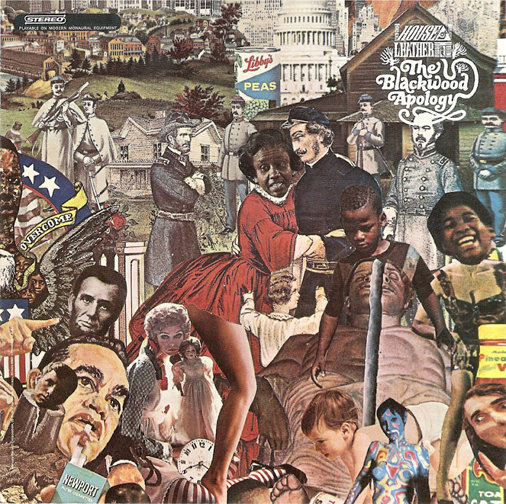
House of Leather Album Cover
Tracks
1. Medley: Swanee River Overture / House Of Leather Theme – 2:06
2. Do You Recall The House Of Leather? – 2:47
3. Recess With Mrs. Grim – 1:03
4. Graduates Of Mrs. Grim’s Learning – 3:10
5. There Is Love In The Country (On The Donny Brooks Farm) – 2:03
6. Here I Am – 4:27
7. She Lives With Me – 1:07
8. There’s Love In The Country (On The Donny Brooks Farm) Reprise – 2:05
9. Time Marches On – 5:23
10. Dixie And The War – 3:21
11. Death And Reality – 2:52
12. Sarah’s On Her Knees – 2:46
13. Theme From House Of Leather (Epilogue In Suede) – 2:45
All compositions by Dale Menten
The House of Leather LP won the Connie Award for 1969 as Best Album of the Year. Dale Menten also won Best Artist and Repertoire and Best Composer for the work. Bob Schultz won the honors as Best Recording Engineer for his work on the album.
CHOIR CHRYSTAL
Rod Eaton wrote:
A Minnesota high school wanted to book the band for a dance. Because there was no actual Blackwood Apology, an agent decided he’d improvise – he’d send a group called Choir Crystal. No one knew what Blackwood Apology looked like. Neither did many know Choir Chrystal. I played in Choir Chrystal. We were a trio – Hammond, guitar, drums. We were also short lived – a handful of gigs in Wisconsin and outstate Minnesota. Plus one interesting afternoon amongst the fashion in the young men’s department of a JC Penney’s. On this night we traveled as Blackwood Apology. Along for the experience was Dennis Libby. Dennis could claim Blackwood bona fides – he played on the album. At the dance we had to apologetically inform the kids we were unable to play any of the music from House of Leather. Didn’t the agent tell you? Oh we’re so sorry – copyright restrictions. The dance went well despite the charade – everyone had a good time.
TOURING BAND
Menten created a new band with Dennis Libby as the only remaining member, and added Bruce Pedalty on keys, Dick Hedlund on bass, and Joey Piazza on drums. This band rehearsed with Menten on guitar, and went on the road to promote the House of Leather album in 1969. This was the band that opened the first Labor Temple Grateful Dead Show.
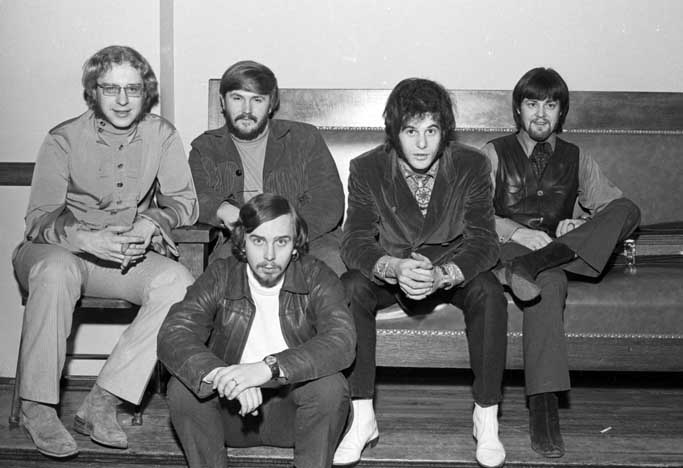
Blackwood Apology at the Labor Temple, February 2, 1969. Photo copyright Mike Barich
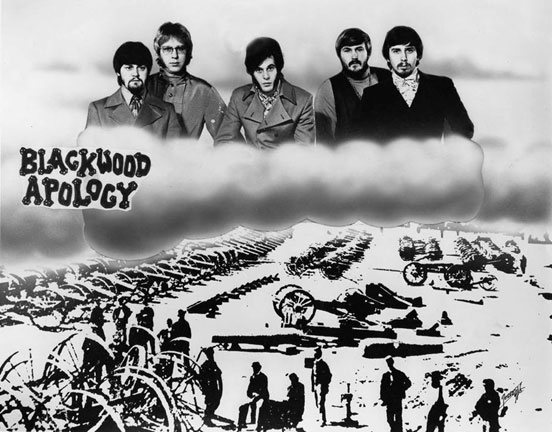
Photo courtesy Dale Menten
Photo above: The band that went on the road in 1969 to promote the Mercury/Fontana album, “The House of Leather.” Left to right: Dick Hedlund, Bruce Pedalty, Joe Piazza, Dale Menten, and Dennis Libby.
THE ROCK OPERA – MINNESOTA
Fred Gaines wrote a book of the same name and subsequent stage play, and H. Westley Balk, of Center Opera Company, directed the rock opera at Minneapolis’s Cricket Theater. It opened on March 26, 1969, and it played nearly 50 sold-out shows. The Cricket Theater production included the Blackwood Apology musical lineup.
The Schubert Club then sponsored another run at the Crawford-Livingston Theater in St. Paul, from July 18 to August 24, 1969. The program listed the musicians as:
- Dale Menten, Lead Guitar
- Dick Hedland, Fender Guitar
- Dick Rees, Organ and Flute
- Scott Sansby, Drums
- Dennis Libby, Lead Singer and Guitar
And that’s our Patrick Devine in the cast!
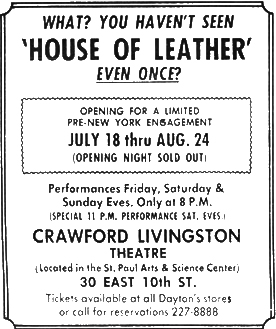
Minneapolis Tribune, July 13, 1969
Below is the handbill given at the theater entrance in St. Paul and New York to set the mood of the Antebellum enterprise of the period fully legal.
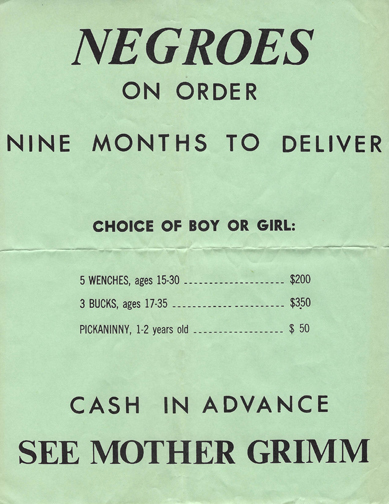
Image courtesy Dennis Libby
NEW YORK CITY
On the strength of its popularity in the Twin Cities, the play was taken to New York City.
Its debut on March 18, 1970, at the off-Broadway Ellen Stewart Theater (240 E. Third Street) brought a bad review from the New York Times, but favorable ones from the Village Voice and the Wall Street Journal.
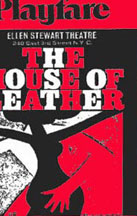
On the strength of its popularity in the Twin Cities, the rock opera was taken to New York City. Personnel included:
- Dick Shapiro, Producer
- William H. Semans (according to the New York Times review)
- Westley Balk, Director
- Dale Menten, Musical Director
- Gus Dewey (formerly of the Gestures and City Mouse),
- George Miller (from Choir Chrystal and Crocket), organ and vocals
- Peter De Anda (described as a late addition to the cast; known for work on “One Life to Live” and “Dan August”) replacing Minneapolis cast member Alfred Babbington Johnson
- Barry Bostwick (the future Brad in “Rocky Horror Picture Show” but described at the time as “a former member of the APA-Phoenix Repertory Company” with no screen credits at the time) replacing John Parriot
- Norma Jean Wood remained as Mrs. Grimm from the Minneapolis company.
- Jonelle Allen was recast as Sarah Jane, replacing Lynn Moody.
- Kathleen Miller was from a rock band called Saturday’s Children
Menten renamed the band “Hugo” for the New York run.
Feb 9: Rehearsal
Feb 17: Barry
Feb. 28: Charles McHarry of the New York Daily News reported that Marshall Naify, board chairman of United Artists Theaters, was the solo backer of “House of Leather.”
After many notices saying that the show would open on March 16, it was announced in the New York Daily News that it “has put down next Wednesday for its premiere.. It had been listed for next Monday.”
HOW MANY PERFORMANCES?
Common thought is that the show closed after one performance. The New York Times review on March 19, 1970, seemed to indicate that there were three performances.
Dennis Libby said that the show sold out previews for several weeks, six shows and two matinees per week before its official debut on March 18.
The New York Daily News said it in one sentence: “The House of Leather closed Wednesday after its initial performance.”
THE NEW YORK TIMES REVIEW
Its debut on March 18, 1970, at the off-Broadway Ellen Stewart Theater (240 E. Third Street) elicited a snide and vicious review from Clive Barnes of the New York Times the next day. Excerpts:
Now anyone can write dull musical. Given a little dull experience, I could probably write a dull musical myself. But to write a dull rock musical about a New Orleans whorehouse at the time of the Civil War takes a certain kind of genius for dullness.
Mr. Menten’s sounds are not as much rock as concrete, and Mr. Gaines’s book is a mixture of pretentiousness and ineptitude.
The direction by H. Wesley Balk proved as pompous and as inflated as the writing.
The rest of the cast was at least adequate, and the musicians always en [This last word is cut off online and hopefully it is “enjoyable?”]
PANIC AND CLOSURE
Based on that one review, Dick Shapiro and Cricket Theater Artistic Director William Semans closed the show. The next morning, the Village Voice and the Wall Street Journal printed favorable reviews, but the decision had already been made.
Dick Hedlund and Dick Borotolussi reported in the May 16-23, 1970 issue of the Insider that one of the things that went wrong in New York was the addition of more sex to the show.
Dennis Libby makes his position clear that the show was cancelled prematurely:
No hearsay, no conjecture: Shapiro and Semans blew it, and it’s needed to be said for a long time. What better place then right here, right now.
ANOTHER BOMB
Coincidentally, our Minnesota musicians were in New York at the same time and place as the Weathermen bombing in Greenwich Village on Friday, March 6, 1970. Weatherman members Theodore Gold and Kathy Boudin blew themselves up into millions of pieces while making bombs in the basement of a posh townhouse.
Dennis Libby remembers:
We were staying in suites at the historic Van Rensselaer Hotel near Washington Square in the East Village, a long block from the “Weatherman” secret headquarters where the violently subversive, revolutionary group were building bombs in the basement. Early one early Friday afternoon, as we were to ready to exit the 5th floor hotel suites to catch cabs to the theater for matinee and evening shows, a huge explosion occurred at the Weatherman brownstone up the street, blowing the glass windows into our suites, creating a huge crater in the street, damaging Dustin’s Hoffman’s brownstone next door (luckily no one home), and creating chaos on the street, as we attempted to flag cabs to the theater. Returning late evening from our two shows was difficult as well, since there were hundreds of people milling around the now barricaded street with a bomb squad truck sitting in the crater out front of the demolished building and police everywhere. Reports the next day stated that body parts of the man whose bomb blew up were discovered on several roofs and elsewhere away from the blast. We were still finding small shards of window pane glass for days on the carpets of our rooms.
STRANDED?
Hedlund and Borotolussi also stated that union disputes left the Minneapolis musicians stranded in New York for a while.
Dennis Libby wrote that “the band, seasoned troopers they were, packed up the van and came home; those of us that were Actors Equity had provisional transportation for airfare in our contracts.”
SEVENTH INDIANA CAVALRY
Menten went on to write a follow-up to “House of Leather” called “Seventh Indiana Cavalry,” which had to do with Wounded Knee. It premiered on June 10, 1970, at St. Paul’s Crawford-Livingston Theater, produced by Hugo Square Productions and the Schubert Club.
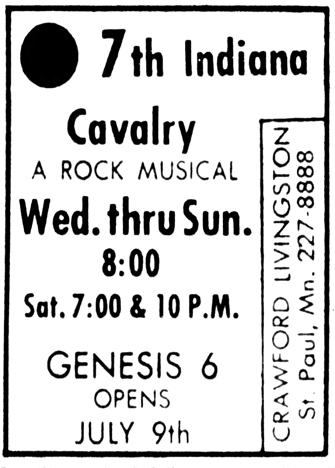
Minneapolis Tribune, June 21, 1970
Minnesota Orchestra Summer Pops Jubilee: 1969
The Minnesota Orchestra Summer Pops Jubilee featured:
- Chet Atkins and the Nashville Sound at the Minneapolis Auditorium Concert Bowl on June 17, 1969
- The Cowsills on June 24, 1969. Before their evening concert they performed at Donaldson’s Sixth Floor Auditorium from 12:30 to 3 pm.
- O.C. Smith on July 2, 1969.
The Minnesota Orchestra played the first half, and the pop act the second.
Bach to Rock: 1969
An ambitious show billed as the “greatest night in the history of local music” was held at the Minneapolis Auditorium on June 30, 1969. It was sponsored by members of the Minneapolis Musicians’ Association (Swanee Swanson of Northwest Organ and Franny Dear) as a benefit to help musicians pay medical bill. The four hour show was called Bach to Rock, emcee’ed by Charlie Boone. Performers included:
- Minnesota Symphony Woodwind Quintet
- Doc Evans and His Dixieland Band
- Golden Strings from the Radisson Hotel
- Dick Whitbeck and his Big Band
- Clyde Olson on the pipe organ
- Kay Nygaard and the Sound Effects
- Buddy Davis Trio
- Zarathustra
- Sherwin Linton and the Cotton Kings
Big Daddy Wags Night: 1969
Big Daddy Wags Night was at the Prison on July 19th, 1969. Bands participating included
- The 19th Amendment
- Bananas
- Pure Honey
- Pride & Joy
- Olivers
- Pepper Fog
- CA Quintet
- Stone Hedge
- Boiling Point
Big Daddy arranged for the Voxmobile to be at the event. Below is an image of the… whatever it was… from a postcard. Don’t think it actually ran.
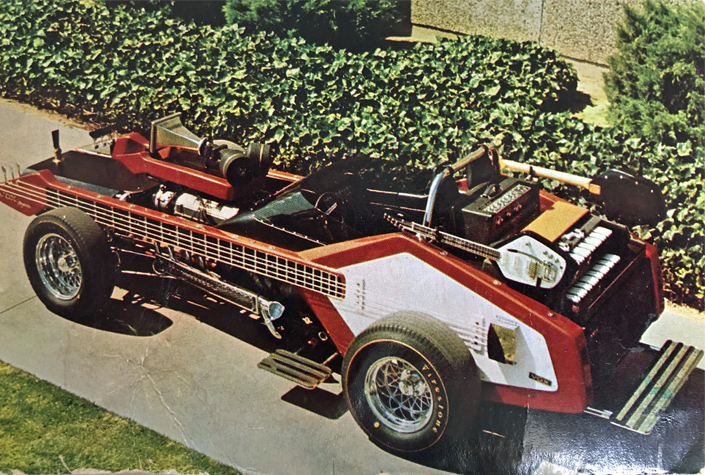
Image courtesy Dennis L. Libby
Midwest Rock Festival: 1969
The Midwest Rock Festival took place at State Fair Park in West Allis, Wisconsin (suburb of Milwaukee), on July 25-27, 1969.
A huge lineup of acts played to a relatively small audience of 25,000. The show had a flatbed trailer as a stage set on the field in front of the racetrack grandstand. A poster from the show went for $1,500! The following is a list of performers who were advertised to come, but not all did:
- Delaney and Bonnie and Friends (including Eric Clapton)
- Blind Faith
- Jethro Tull
- Johnny Winter
- The First Edition
- Taste with Rory Gallagher
- Joe Cocker
- Buffy Sainte-Marie
- Jeff Beck
- Pacific Gas & Electric
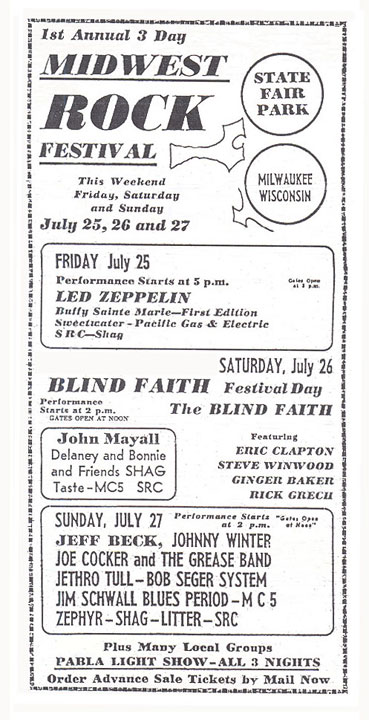
According to Wikipedia, these are the acts that did appear on July 25:
- Led Zeppelin
- Buffy Sainte-Marie
- The First Edition
- Sweetwater
- Pacific Gas & Electric
- SRC
- Shag
July 26:
- Blind Faith
- Delaney and Bonnie and Friends
- Shag
- Taste
- John Mayall & the Bluesbreakers
- MC5
July 27:
- Johnny Winter
- Joe Cocker and the Grease Band
- Bob Seger System
- Jim Schwall Blues Period
- MC5
- Zephyr
- Shag
- Litter
- SRC
Tom on Facebook reported that:
Show ended early on the third day when Jeff Beck took the stage and announced checks were bouncing and groups weren’t getting paid, said “Fxxx It!” and walked off without playing. Then Johnny Winter came on and said he heard the same news, said “Fxxx It!” and played for two hours to close out the festival.
Steppenwolf: 1969
Steppenwolf played the Minneapolis Armory on August 8, 1969. Rod Wallace remembers: “I was at that concert and it was the first time I heard a headliner mess up the sound system for the opening act. I’m not sure who it was but their sound was terrible. Then before Steppenwolf came on stage they announced that the keyboard player was out sick. So I was expecting a bad set from them also; but when they started playing the sound ‘magically’ got perfect, and they sounded better than their records.” Also on the bill were the bands Skin Trade and Danny’s Reasons.
Something must have gone wrong, because in the next Connie’s Insider, it was announced that KDWB was refusing to accept advertising for Danny’s Reasons. From Danny’s web site: “Following a show that the band played with Steppenwolf on August 8th, 1969, KDWB Radio pulled all advertising that had anything to do with Danny’s Reasons. This was decided after the The Reasons performed ‘… Songs which were highly suggestive of off color material…’ Club owners and operators grew increasingly nervous; if they couldn’t advertise the band that was already booked to play their nightclubs and concert halls attendance would plummet. Though KDWB took a very harsh stance, (going so far as forbidding any employee of the radio station to even attend a Danny’s Reasons show) it ultimately had the opposite effect: using the image of ‘banned in Boston’, the band’s popularity continued to sky rocket.” Apparently the controversial material was from “Hair” and the matter was resolved when Danny agreed not to perform it before a teen audience.
New City Opera House: 1969
The American Breed, the Del Counts, and Danny’s Reasons played the New City Opera House on August 15, 1969.
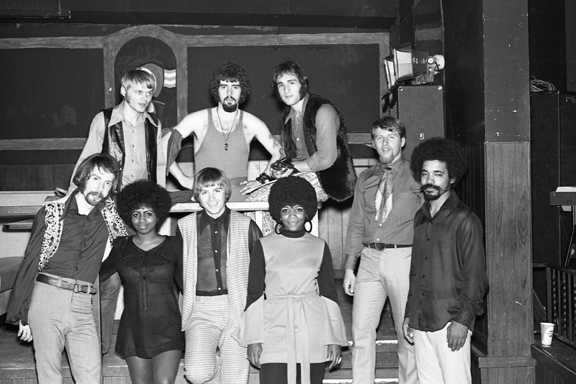
Photo of the American Breed Courtesy Mike Barich
Creedence Clearwater Revival: 1969
Triangle Productions presented Creedence Clearwater Revival at the Minneapolis Auditorium on August 22, 1969. The Litter opened. Dave Marrs remembers:
My buddies and I went to that show to see the Litter. We really didn’t care much about CCR. CCR came out and played their set sounding exactly like their recordings, and never said a word to the crowd. They were good but lifeless. Litter was great. This was the lineup with Mark Gallagher on vocals. Their guitarist Ray Melina had just left and I don’t know who played lead. Always great to see Dan Rinaldi on rhythm!
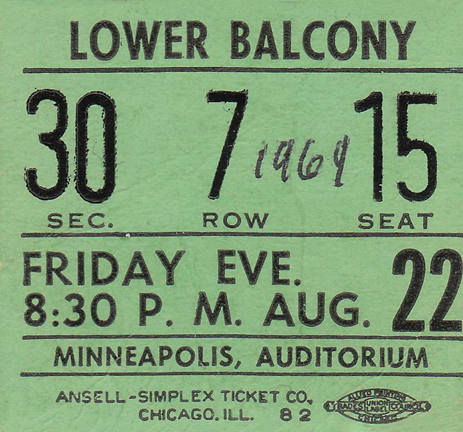
Jay Mattsson’s ticket to this great event!
Tom Murray of the Litter noted that they were booked for a six gig tour with CCR.
After the second or third date with CCR they kicked us off the tour because the crowd was yelling for us while CCR was still playing . oooops! We had the Emerge album out at the time.
Michael’s Mystics: 1969
Michael’s Mystics hit Billboard’s Bubbling Under chart with their local hit “Pain” on August 23, 1969. It languished there for two weeks, only reaching #116. My story: I was making a tape for my dentist and naturally I wanted to include “Pain.” I looked for it in my Billboard Top Pop Singles book and it wasn’t there. How could this be? It was such a monster hit in Minneapolis. Couldn’t believe it. Still sounds great.
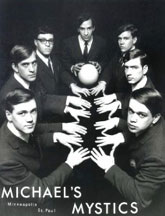
Phantasmagoria: 1969
Local band Phantasmagoria provided the music at an anti-war dance/fund raiser at the U of M on October 31, 1969. Arne Shulstad says, “We got that gig because a friend of our bass player was in the Socialist Workers Party, which was partnered with the Student Mobilization Committee to End the War in Vietnam.”
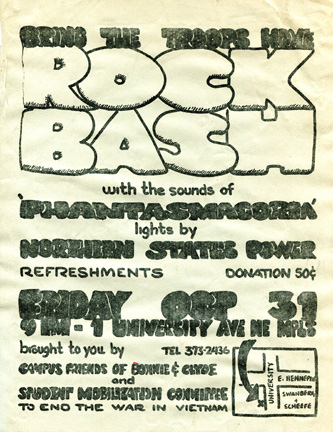
Poster courtesy Arne Shulstad
International Student Strike: 1969
The International Student Strike Against the Vietnam War took place on November 13, 1969.
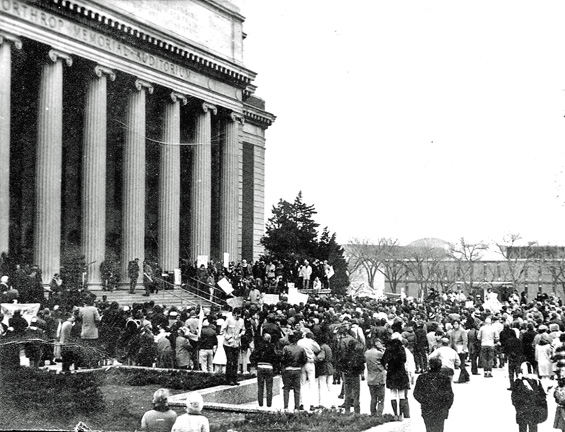
Music played a part in this all-day event at the University of Minnesota:
- Phantasmagoria played on Northrop Plaza from 11:00 to noon. The band was made up of students from St. Paul Murray High School, including Arne Shulstad, who reported – then and now – that it was really too cold in November to be playing guitar outside. The Minnesota Daily – and I – will delicately delete the expletives.
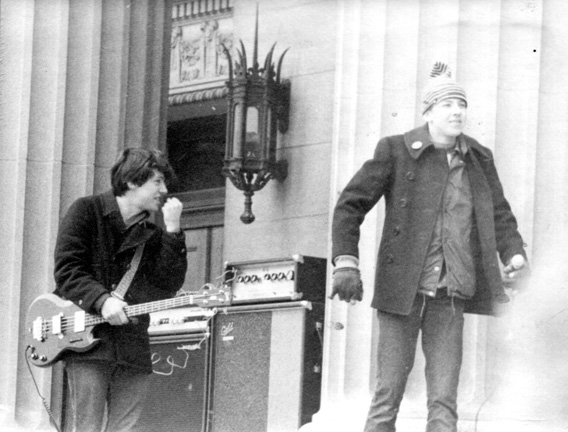
Courtesy Arne Shulstad
- After a rally with speeches (including one by Bonnie Usan, a student at St. Louis Park High School), and a march to the Old Federal Office Building there was a 4:30 dance at Coffman Union featuring local band Showtime I and II.
More on the Vietnam war at home, focusing on St. Louis Park, is available here.
WDGY Thanksgiving Holiday Spectacular: 1969
Ray Charles played the Minneapolis Auditorium on November 19, 1969. The show was billed as a WDGY Thanksgiving Holiday Spectacular, promoted by Arnie Sagarsky of A & A Enterprises. Sagarski was the force behind the “Purple Cigar” teen dance hall in St. Louis Park.
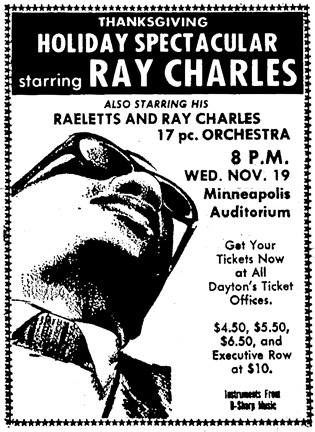
Ad from Minnesota Daily, November 12, 1969
Association: 1969
The Association appeared at the College of St. Thomas on November 20, 1969. Tickets were $3.50.
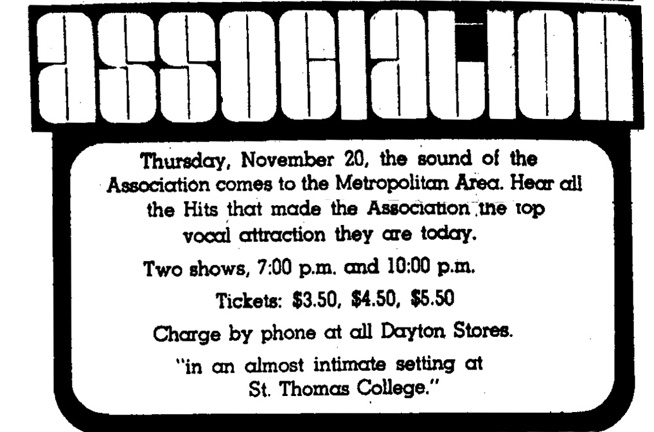
Ad from Minnesota Daily
Janis Jopline: 1969
Janis Joplin and the Kozmic Blues Band played the Minneapolis Armory on November 22, 1969, to a crowd of 8,000. For a change we’ll cite a review by the Current, which was a short-lived underground newspaper at St. Louis Park High. This review is by Shelly Thomas:
Janis Joplin has a definite hold over her audiences that finds them wanting much more than they get at her concerts. Saturday, November 22, at the Minneapolis Armory was no exception. The billing started out with Danny’s Reasons, who sounded like a recording of Smokey Robinson and the Miracles. The lead singer was a good dancer..
The Crow followed. They came out saying “we aren’t going to stuff all that political crap down you.” It was unsophisticated, wild fun. They performed music on their next album, to be released in February.
By the end of their part of the show, many people agreed that they’d already gotten their money’s worth. But the best was yet to come – Joplin walked out on stage!
Her presence drew loud applause. Then came her plea to turn off the balcony lights. “I’ll take full responsibility,” Janis offered. Unfortunately there are city ordinances forbidding it.
She launched into songs from her first solo album “I Got Dem Ol’ Kozmic Blues Again, Mama.” … After singing the album’s title song she received a standing ovation, which was continuous through the rest of the concert.
Until this time all the audience witnessed was Janis wiggling around on the stage. She overcame this problem in the first fifteen minutes of the concert and just sang (which was greatly appreciated). Next came “Piece of My Heart” from about a year ago. Joplin’s new back-up band (complete with brass) performed much better than “Big Brother.”
Most of the main floor audience found their way to the stage. Those in the balcony were standing and dancing. Janis was called back for an encore. She wailed out “Ball and Chain” to the delight of her fans. Someone shouted out “Janis, we love you.” “I love you to,” she replied.
Connie Hechter started out the November 29, 1969, issue of the Insider with his review:
The great white chick who wails the blues with mournful, soulful sounds came to town last Saturday, the 22nd, and accomplished something very few artists can do: she literally packed the huge, barn-like Minneapolis Armory. It is rarer to fill the Armory than it is the Minneapolis Auditorium.
Janis Joplin is strong enough to pull thousands (perhaps 8,000) of the hip, folk-rock youth who showed in their finery; the style show down the aisle as bodies went looking for their seats was worth the price of admission. She also attracted hundreds of hip adults (over 25) who wanted to be turned on by her brand of charisma and shouting. She wailed into the mike, combining her lyrics with the famous Joplin screams, and the crowd responded with applause and cheers.
Her back-up band was more than up to the task of providing tight music with well rehearsed arrangements which more than once echoed of Big Brother, her former cohorts. It was Janis at her best, except for the fact that anyone sitting more than half way back in the hall could really not see her too well. The p.a. system she used also left much to be desired. It was tough to understand her much of the time and the kids rushed forward toward the end of her show, blocking the aisles and the view of hundreds of seated patrons. It was a bad scene when this happened, something like the scene at the Jimi Hendrix show at the Minneapolis Auditorium last year. As in the Hendrix concert, many left the Armory in disgust. Her fans in the [?] rows who couldn’t come up with the price of the “better” seats didn’t have any alterative if they wanted to view and hear the show….
She was exciting though, and I’d welcome the chance to catch her in a smaller hall or club.
Joe Cocker: 1969
Joe Cocker braved a snowstorm to perform at the Prison (at the Burnsville Bowl) on December 14, 1969, his last appearance in the US before returning to England. Danny’s Reasons opened the show.
Tom Barbeau reports:
There couldn’t have been more than 2-300 hundred people there. That was a small crowd in that room, as I recall a lot of empty space. My group of 6 or 7 guys who made the trip (packed into a ’53 Ford coming from St. Paul, through a snow storm), had no trouble getting to within 20 to 30 feet of the stage with lots and lots of empty space behind us. Everything he had at Woodstock the previous August, he showed us there, that night, and the crowd was totally blown away.
At that time Cocker had four singles on the charts, none in the top 20. Tom indicated that he was relatively unknown at the time. Although he had made a star-making appearance at Woodstock, the film Woodstock wouldn’t be released until 1970.
Events: 1970
The Insider applauded Northwestern National Bank for using John Denver’s music in their commercials, 1970 – 1971.
Pepper Fog at Coffman Union, January 13, 1970, 8:00
B.J. Thomas, Roy Orbison, and the Four Tops appeared at the Met Center on February 6, 1970.
What a gas to have this first hand account from Rollie Anderson!
Roy doesn’t show, BJ’s late and here’s three of the Four Tops
Tonight we went to the B J Thomas show at the Metropolitan Sports Center with Mitch & Marilyn and Norm. They drove. Besides the Four Tops, Roy Orbison was supposed to be there but he supposedly “hurt his back” and couldn’t make it. The advertising posters boasted a huge 3 ½ hour spectacular! Well, as it turned out, the show was scheduled to begin at 8 pm but we waited until 8:40 when disc jockey, Scott Burton, came out and gave us the bad news about Roy and then said B J Thomas missed his flight and was “on his way right now” and would be there about 9:30.
Despite the above headline, all of the Four Tops showed up and performed for 50 minutes and they were pretty good. However, they did not perform my favorite song of theirs, “It’s the Same Old Song.” After a 30 minute break, the backup group for B J, “The Arrangement,” came out to perform. Then when B J finally came out, he sang three songs before saying “I hope you didn’t mind waiting.” I couldn’t believe it when he finished singing in less than 25 minutes, walked off the stage and the lights came on and it was all over at 10:40.
So, the great 3½ hour spectacular, after subtracting all the delays was only 1 ½ hours long including the back up group’s appearance! After that farce, the five of us went to the Embers restaurant at highway 100 and 36th. We had a lot of fun there!
Tony Glover and Pepper Fog at Whole Coffee House, January 16, 1970
Andre Kostelanetz at Northrop Auditorium, January 18, 1970
Turtles at the Prison, January 24, 1970
Grand Funk Railroad, January 25, 1970
Cold Blood, a 9-piece jazz rock group from San Francisco, appeared at the New City Opera House on January 30-31, 1970.
The Butterfield Blues Band played Northup Auditorium on January 31, 1970.
Allman Brothers, Labor Temple, February 1, 1970
Tiny Tim, February 4, 1970
Bobby “Blue” Bland performed at the Cedar Village Theater, sponsored by the Walker Art Center, February 5, 1970.
Crow and Abraxis, February 6, 1970
Roy Orbison, B.J. Thomas, Met Sports Center, February 6, 1970
Savoy Brown, Labor Temple, February 8, 1970
Delaney, Bonnie and Friends with Eric Clapton performed at the Minneapolis Auditorium, February 12, 1970. A review said that the opening act was the John Koerner band, which included Willie Murphy. Tony Glover got up from the audience and played harmonica on one song, “Lucille,” for old times’ sake.
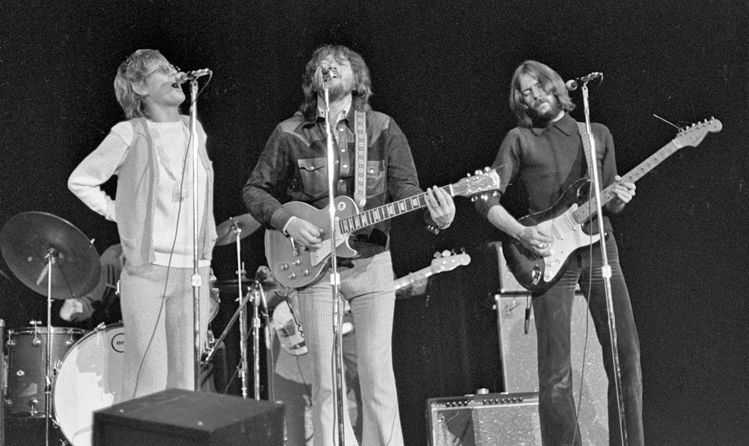
Bonnie, Delaney, & Clapton. Photo copyright Mike Barich
Sam and Dave, Guthrie, February 15, 1970
Byrds, Labor Temple, February 15, 1970
Sweetwater, Labor Temple, February 22, 1970
Mercy performed at Northup Auditorium on February 28, 1970.
Youngbloods, Labor Temple, March 1, 1970
Mark of Zorro appeared at the Prison on March 7, 1970. Local group?
Spirit and Zephyr appeared at the Magoo’s New City Opera House on March 8, 1970. The ad promised Nova Lights and a new stage.
Country Joe and the Fish at the Labor Temple, March 8, 1970
A source on the Internet says that the Allman Brothers Band played in St. Paul on March 1 and April 18, 1970.
Doug Kershaw was at the Cedar Village Theater on March 2, 1970. Bamboo opened.
Smokey Robinson had a concert (at least planned) for the Minneapolis Auditorium on March 10, 1970.
Iron Butterfly and Mason Proffit performed at the Minneapolis Auditorium on March 13, 1970. The Butterfly was panned in the Insider.
The Moody Blues had a concert (at least planned) for a concert at the Minneapolis Auditorium for March 15, 1970.
MET CENTER POP FESTIVAL
What was billed as the First Met Center Pop Festival was held at the Met Center with 12 bands on March 20, 1970. The 8-hour show started at 4 pm, and the ticket price was an astounding $5! Featured acts were:
- Canned Heat
- Grand Funk Railroad
- Buddy Miles Express
- The Amboy Dukes (Ted Nugent)
- The Litter
- Brownsville Station
- The Stooges (Iggy Pop)
- Johnny Winter, unexpectedly joined on stage by brother Edgar
- Rotary Connection (Minnie Ripperton was out sick)
- S.R.C.
- Truth – according to Wikipedia, this was an American Contemporary Christian group, active from 1971 to 2001. Formed by John Roger Breland, the ensemble’s name stands for “Trust, Receive, Unchangeable, True Happiness [in Jesus]”. It was initially composed of 15 members, eventually expanding to 22 members.
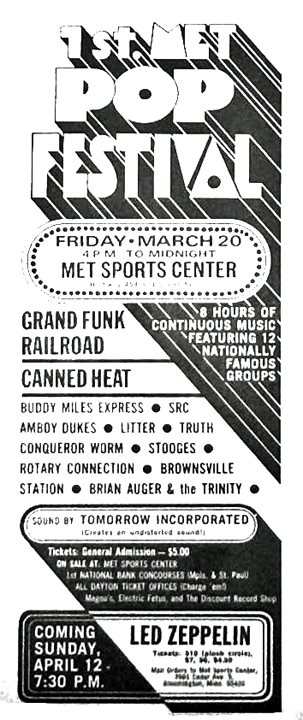
Originally scheduled acts the Who, Brian Auger and Trinity, and Conqueror Worm did not make the show. Although it was much advertised that a special sound system was being brought in by Tomorrow, Incorporated from Chicago “for undistorted sound,” apparently the acoustics were terrible. The show was a joint venture of Gary Jorgensen of the New City Opera House and Ray Heim of the Met Center.
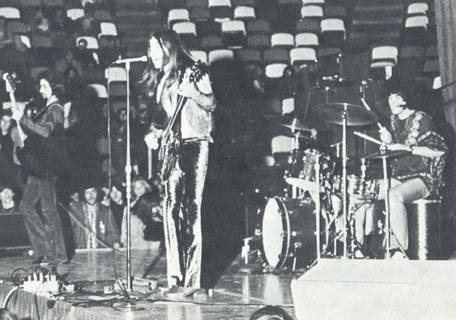
Photos of Grand Funk Railroad and Iggy Pop copyright Mike Barich, St. Paul
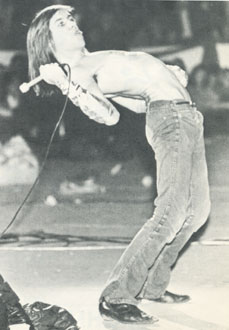
Vanilla Fudge reportedly bombed.
The photo below shows Canned Heat’s Fito de la Parra, Bob Hite, and Alan Wilson (behind Hite).
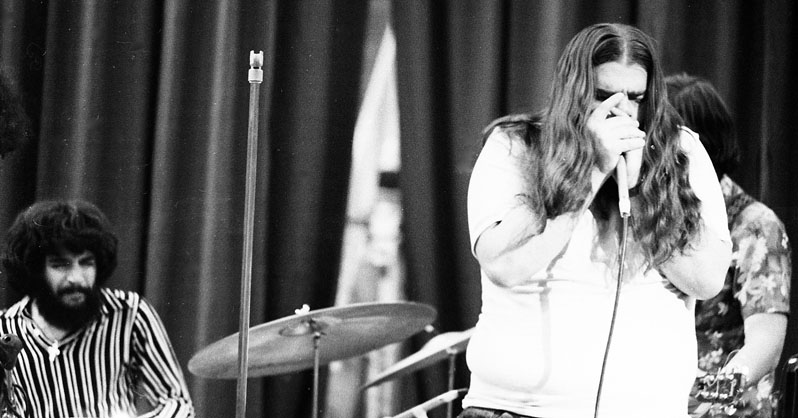
Canned Heat photo by Denny Schwartz courtesy Gary Schwartz
Below is a photo of Canned Heat’s Alan Wilson from that show. He wrote and sang their hit song “Going Up The Country.” He died half a year later.
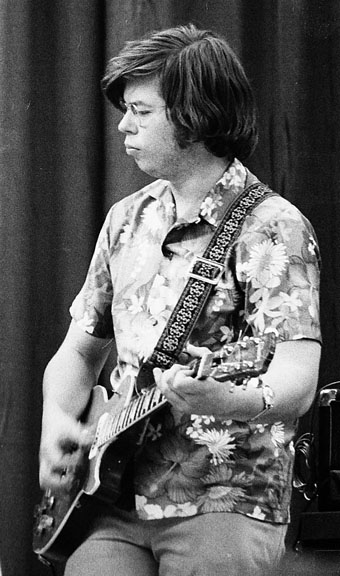
Photo of Alan Wilson by Denny Schwartz, courtesy Gary Schwartz
Ramsey Lewis, Northrop Auditorium, March 22, 1970
March 22, 1970: Johnny Winter was at the Labor Temple
March 22, 1970: The Band was at the Guthrie. What a choice!
Fever Tree and Mojo Buford, Labor Temple, March 29, 1970
In an interesting ad in the April 1970 Insider, we find: “Records from this market have long been criticized for their ‘Minneapolis-sound.’ Sound 80 has definitely broken through that barrier and brings a refreshing change to recording in this market. When you release a record remember it has to compete for air play with the best.. Prior to deciding where you want to record make certain you consider Sound 80 ‘Cuz It’s A Gas!'” Not many years later Minneapolis would be proud of its “Sound.”
Howlin’ Wolf was at the Cedar Village Theater on April 2, 1970.
Glenn Yarbrough appeared on April 4, 1970, at Melby Hall, Augsburg College.
Paul Butterfield was at the Depot on April 11, 1970.
Led Zeppelin played the Met Center on April 12, 1970 – sponsored by New City Opera House.
Miscellaneous memories from Facebook:
- It was very foggy.
- Tripleheader with Twins in AM, North Star playoff in afternoon and a late start for Zeppelin
- Jimmy Page had a broken finger. Didn’t hear any difference….
- Large and spirited crowd
- Was that the show that they were very late to arrive, pulled the limo up next to the stage when they arrived? Plant was so loaded he needed a chair to keep him standing up!
- “I think this is the Zep show we walked out of into a freezing sideways rain….They were preety bad…”
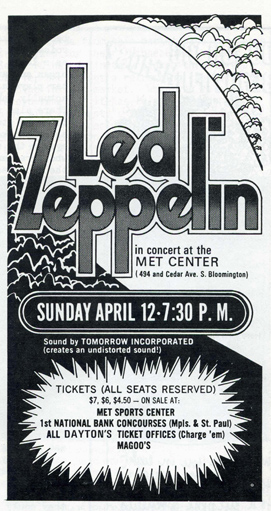
Ad from the Insider, April 11, 1970
Dania Hall historian David Markle speculates that the last event in the large hall took place in April 1970:
According to Glen Hanson, members of the Jokers Wild band registered surprise on looking out over the “abnormal” crowd that had arrived. The hall had been hired for an event for students following a [pop artist] Robert Rauschenberg opening at Dayton’s Gallery 12. Apparently Rauschenberg enjoyed the party.
Poco, April 17 – 18, 1970
Small Faces with Rod Stewart, Alice Cooper, Labor Temple, April 19, 1970
NORMAN GREENBAUM
A barely-known Norman Greenbaum appeared at the Prison to a small crowd on April 25, 1970. On June 1, 1970, Greenbaum would appear on the national TV show “Something Else,” aired at 6:30 here and hosted by John Byner. His self-penned “Spirit in the Sky” was released in late 1969. The single became a gold record, selling two million copies from 1969 to 1970, and reached number three on the Billboard Hot 100 chart (April 18, 1970), where it lasted for 15 weeks in the Top 100. Billboard ranked the song Number 22 song of 1970. Despite the line “I got a friend in Jesus,” Greenbaum was raised and remained an observant Jew. He wrote it in 15 minutes! (Wikipedia)
The Hollies appeared at the Prison on April 26, 1970.
Ferante and Teicher, Northrop Auditorium, April 26, 1970
Blood, Sweat & Tears drew 8,000 to the Minneapolis Auditorium on April 28, 1970. Bob Mikkelson remembered that John Denver opened and no one cared. When Denver said it was his last number the place cheered. Denver just replied that he was as excited as the rest of us to hear BS&T.
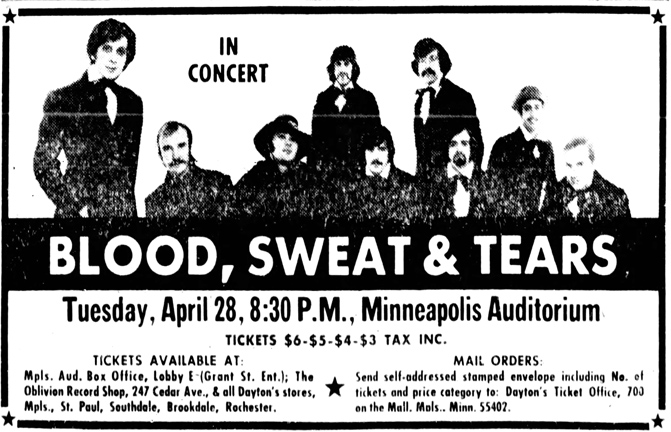
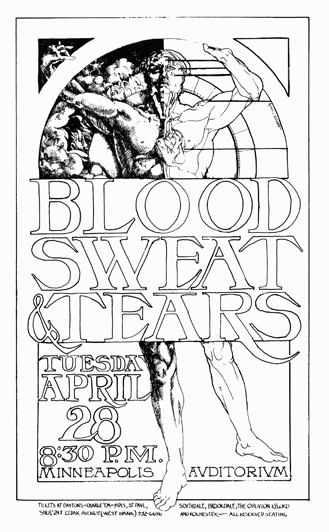
Ad from the Insider, April 11, 1970
“A Band Called Smith” (later known as just Smith) appeared at the outdoor O’Shaughnessy Stadium at the College of St. Catherine’s on May 2, 1970. Also on the bill were Kathy Jones, the C.A. Quintet, and the Mystics.
JIMI HENDRIX
Jimi Hendrix played the St. Paul Civic Center on May 3, 1970, his second appearance in the Twin Cities. The concert (the “Cry of Love” tour) was taped by a member of the audience; read about it here. Tom Pinkert’s dentist sort of remembers that Jimi may have been airlifted into the venue. Opening acts were Oz and Savage Grace, a band from Detroit. Although Jimi was at the top of his fame (he would die that September), someone managed to spell his name wrong in the ad in the Insider, below. Excerpts of the concert are posted to YouTube. He was backed by the Band of Gypsies with Billy Cox and Buddy Miles.
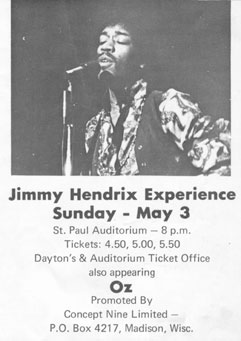
Image from Insider Magazine
Memories from the concert:
Jimi took the stage and said to the audience, “If you got seats, take ’em. If you got joints, pass ’em.”
There seems to be some disagreement as to whether Mitch Mitchell or Buddy Cox was playing drums.
Started tuning his guitar, Jimi said “Only cowboys stay in tune” and ripped into “Fire!”
John Gary, Minneapolis Auditorium, May 3, 1970
The Ramsey Lewis Trio appeared at the Depot on May 5, 1970.
Big Mama Thornton appeared at the Walker (or Coffman Union?) on May 6, 1960.
Ewan MacColl and Peggy Seeger appeared at the Cedar Village Theater on May 6, 1970.
The Friends of Distinction and Young/Holt Unlimited appeared at the Minneapolis Armory.
Chicago Transit Authority’s first performance in Minneapolis was on May 10, 1970, at the Minneapolis Auditorium. Illinois Speed Press was also on the bill.
Tom Pinkert: “For some reason during a lunar eclipse I chanced upon Mance Lipscomb playing an outdoor concert somewhere on the west bank campus, must have been summer of 1970.” Cool!
Van Cliburn appeared at Northrop Auditorium on May 15, 1970.
Mitch Ryder appeared at the Depot on May 17, 1970.
Fever Tree, May 17, 1970
Gordon Lightfoot appeared at the Guthrie on May 17, 1970
Byrds concert at Minneapolis Auditorium, May 18.
The Byrds and the Peppermint Rainbow appeared at the Minneapolis Auditorium on May 18, 1970. The KDWB hit list told how you could win the Byrds to play at a dance at your high school! Did that happen?
May 19, 1970: Cedar Village Theater
- Midwest
- Thundertree
- 19th Amendment
Peter, Paul and Mary played the Minneapolis Auditorium on May 22, 1970.
The Kinks appeared at the Depot on May 22 and 23, 1970.
The 1970 Connie Awards took place on June 1, 1970.
Neil Diamond performed at the Minneapolis Auditorium on June 13, 1970. KDWB issued a flier “saluting” the performance.
Traffic was scheduled at the “Auditorium” for June 21, 1970, as advertised on a KDWB music survey. Jef Cierniak says,
I was at this one. I believe that Country Joe and The Fish were the opener. Towards the end of the Traffic set, the officials began to close the curtains, but many audience members hopped on the stage and pulled it back open. Traffic played another song with people sitting around them on stage.
BOTTLENECK I
On June 18, 1970, a free festival was held in Loring Park, co-sponsored by the Center Arts Council (CAC) of the Walker Art Center. It was described as an “improvisational summer festival” centered around the Loring Park Bandstand, starting at 1:00 pm. The bands Cottonwood, Cisco Grove, and Soul Package volunteered their time and talent to entertain.
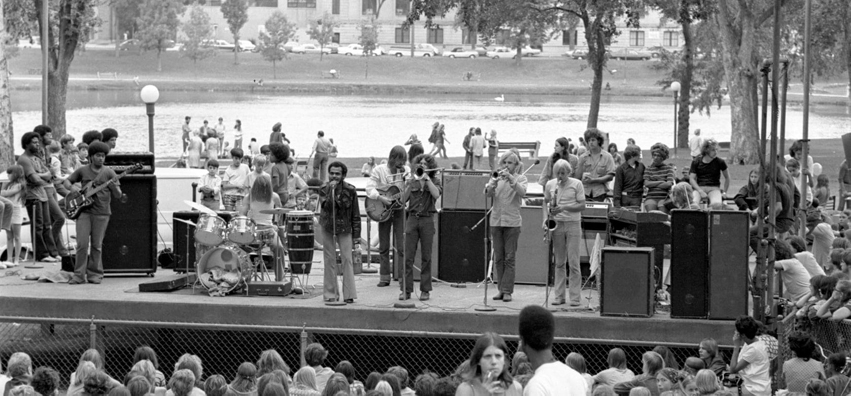
Soul Package at Bottleneck I – photo copyright Mike Barich
Onstage above are Dewayne T. Lewis on bass; Mark Aletky on drums; Rudy Martin, vocals, Mark Menke, guitar; Eric Aletky, Trombone, Mark Bratten on sax
The festival included “theater happenings and improvisational performances” by:
- The Theatre of Communities, which was a co-sponsor of the event, headed by Gary Parker,
- The Minneapolis Ensemble Theatre,
- The Afro-American Dance Troupe,
- The Kata Novak Festival Dancers, and
- Dudley Riggs’ Brave New Workshop
The event was organized by 20-year-old Bruce Margolis, described as a U of M Theater Department dropout, Guthrie Theater employee, and a member of the CAC. It was an idea to get new members for the CAC other than a party that would cost a lot and that people wouldn’t come to. It was hoped that the Festival would be spontaneous, with “theater games, audience participation, and a very loose, everyone-get-involved kind of spirit.” Other ideas were inflatable plastics and sculptural events with artist Ron Brodigan making art out of 25 bales of hay. “Margolis said everyone is encouraged to bring their families, friends, costumes, musical instruments, balloons, kits, whatever, and do it.” (Minneapolis Tribune, June 21, 1970)
Here’s a local record spotted by the ever-vigilant Jeff Lonto. Notable is the IDS Tower under construction in the background.
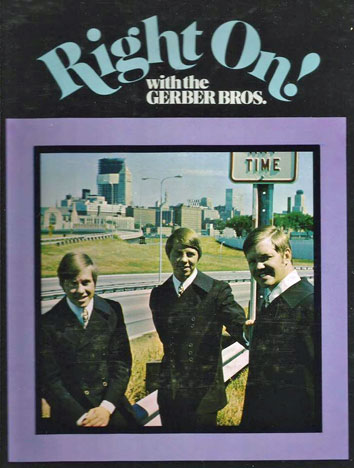
Sonny Terry and Brownie McGhee appeared at the Cedar Village Theater on June 30, 1970, sponsored by the Walker Arts Center.
The Who, Minneapolis Auditorium, on July 3, 1970. There was a 90-minute equipment delay, and the band played selections from “Tommy,” which by then was a little worn out. The Mystics opened.
July 8 – 12, 1970: Local hero band Crow played at the famed Whisky A-Go-Go in Los Angeles. The other band listed was Crucible.
Crosby, Stills, Nash, and Young performed at the Met Sports Center on July 9, 1970. This show was rescheduled from a show that was boycotted because of high ticket prices.
Three Dog Night, July 12, 1970, Minneapolis Auditorium, as advertised in a KDWB music survey.
Tom Jones, Met Center, July 19, 1970.
The U of M held a series of blues concerts on the Anderson Hall Mall. Mississippi Fred McDowell performed to an audience of 1,200 on July 22, 1970.
Arlo Guthrie and Linda Ronstadt appeared at the Minneapolis Auditorium on July 26, 1970.
Gary Isensee(?) from Hundred Flowers wrote that Arlo opened his set with a musical answer to “Okie from Muskogee,” and finished with a monologue about dope and uppers. Gary found it half funny, half interesting, and often overdone. He did a rock version of Woodie Guthrie’s “I Ain’t Got no Home in This World Anymore,” and a fast version of “Alice’s Restaurant.”
Reviewer Gary was disappointed that the audience in the third full auditorium was not appreciating Linda Ronstadt’s opening set as they should. Her songs included “I’ll be Your Baby Tonight,” “Silver Threads and Golden Needles,” and “Lovesick Blues.” (July 31, 1970)
Pacific Gas & Electric appeared at the Depot on July 26, 1970.
KDWB brought Bobby Sherman to the Minneapolis Auditorium on July 31 , 1970. Scream!!!!
August 9th, 1970, was KDWB/63’s 6th Annual Drag Festival.
Steppenwolf, August 9, 1970, Minneapolis Auditorium. Tickets were $4. The Underbeats were scheduled to open but were replaced by Gypsy. Wait a minute – the Underbeats WERE Gypsy!
Buck Owens appeared at the Minneapolis Auditorium on August 14, 1970.
The Rascals, with the Litter and Kiwani, played the Minneapolis Auditorium on August 16, 1970.
Exuma did his act at the Depot on August 16, 1970.
The Judd Group formed in Rochester in 1970.
Bamboo and John Koerner appeared at the Guthrie on August 23, 1970.
The Lemon Pipers came to St. Paul on August 31, 1970
Leon Russell performed at the Guthrie on September 6, 1970
Jimmy McGriff appeared at Georgia Brown’s on September 16, 1970.
? Cassidy appeared at the Cedar Village Theater on September 17, 1970.
Youngbloods appeared at the Guthrie on September 20, 1970
Gypsy appeared at the Labor Temple on September 20, 1970.
Freda Payne, Al Jarreau, Sorry Muthas, September 26, 1970
Johnny Winter, Labor Temple, September 27, 1970
Al Jarreau, Depot, September 27, 1970
Sha Na Na, Labor Temple, October 4, 1970
Mason Profitt, Depot, October, 1970
The Lettermen appeared at the Minneapolis Auditorium on October 10, 1970.
In the fall of 1968 Jim Johnson got back from Viet Nam, rejoined the Underbeats, and they made their way west to Los Angeles. They were soon playing regularly at clubs on the Sunset Strip and changed their name to Gypsy. Their eponymous debut album, only the second double album of the era, hit the charts on October 10, 1970, stayed there for 20 weeks, and peaked at No. 44. The single “Gypsy Queen – Part 1” entered the charts on December 5, 1970, peaking at No. 62.
Poco, Depot, October 11, 1970
Ramsey Lewis at the Depot, October 13, 1970
John Mayall, with the bands Flock and Ned, appeared at the Minneapolis Auditorium on October 16, 1970.
Badfinger appeared at St. Thomas on October 16, 1970
The Grateful Dead appeared at the Guthrie on October 18, 1970.
The Fifth Dimension appeared at the Minneapolis Auditorium on October 25, 1970 (sponsored by KDWB).
MC 5 appeared at the Depot on October 25, 1970 (Mothers of Invention?)
Mountain appeared at the Minneapolis Auditorium on November 1, 1970 (sponsored by KDWB). Don Ellis also on the bill.
Don Ellis at the Depot, November 3, 1970
Cannonball Adderly at the Prom, November 4, 1970
Rod Stewart and the Small Faces, November 8, 1970
Iron Butterfly and Crow, Met Center, November 13, 1970.
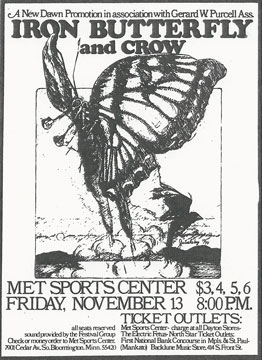
Ad from Hundred Flowers courtesy Wayne Klayman
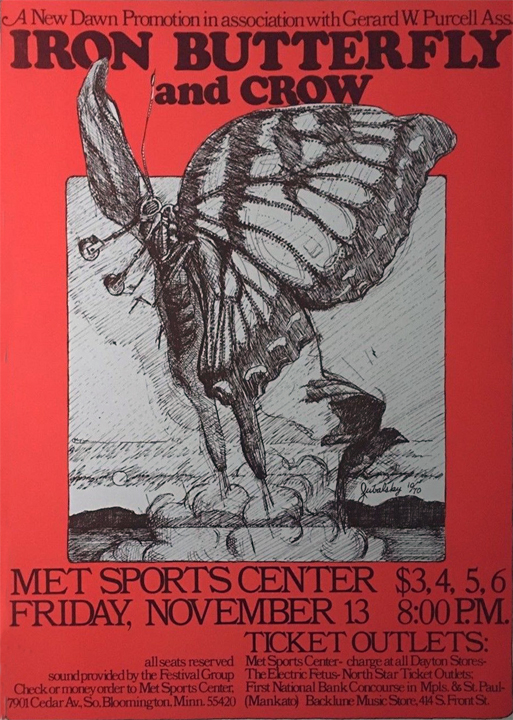
The poster, as advertised on eBay
Ten Wheel Drive at Northrop, November 14, 1970
John Sebastian at the Guthrie, November 15, 1970
Wayne Cochran at the Depot, November 17-18, 1970
The New Christy Minstrels appeared with the Minnesota Orchestra at Northrop Auditorium on November 22, 1970.
Grand Funk Railroad with Humble Pie (featuring Peter Frampton) at Met Sports Center, November 22, 1970
Sweetwater at Depot, November 22, 1970
Elton John at the Guthrie, November 29, 1970
Exuma at the Depot, November 29, 1970
Buffy Ste. Marie appeared with the Minnesota Orchestra at Northrop Auditorium on December 6, 1970.
James Gang at Depot, December 6, 1970
In an article in the Minneapolis Tribune dated November 27, 1972, journalist Terry Farrell noted that a change had come about two years before in terms of black patrons of clubs. A.B. Cassius, a bar owner for 36 years, said “For years it was just a policy: No Negroes served on Hennepin Ave.” A dramatic transformation took place in 1970 “particularly on Hennepin Ave., between 6th and 9th Streets. Significant numbers of black people began frequenting those establishments, which previously – by design or informal social custom – had been patronized almost exclusively by white people.”
Leo Kottke at the Guthrie, December 26, 1970
By the end of 1970, the Purple Barn was the only teen club left, and it was only open on Fridays. Club owners blamed the schools, who had changed their policies to allow non-students to attend their dances.
Airport: 1970
The film “Airport” was released on March 5, 1970, starring our own WDGY DJ Johnny Canton! Well, he had one line. But without it, Maureen Stapleton wouldn’t have known where the gate to Rome was. Screen grab courtesy Pavek Museum of Broadcasting.
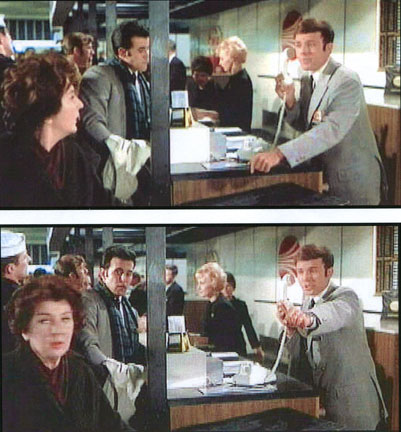
The movie was filmed in Minneapolis, and also included local actress Nancy Nelson (billed as Nancy Ann Nelson) as Bunnie, the girl who sold the bomber his travel insurance. Nancy was a hip chick in the ’60s, costarring on “A Date With Dino” (see TV Shows), writing a column and being the secretary for Twin City a-Go-Go (see Publications), and doing a stint as the go-go booted “Saturday Night Weather Girl” just before Dave Moore’s “Bedtime Newz.” Her debut on local TV was at age 3, where she sang “Good Night Ladies” on “Toby Prin’s Talent Show.” While working on “Mel’s Matinee Movie” she interviewed Don Stolz and started working as an actress at the Old Log Theater. She was also “Princess of Prizes” on Don Dahl’s Bowlerama. She spent a year as Miss Minnesota, and in 1970 she married local heartthrob Bill Carlson. John Denver wrote “Follow Me” for them and sang it at the wedding (which I think is a little weird if you listen to the lyrics and think of a couple with two big careers). Danny’s Reasons also played at the event. She and Bill had competing talk shows for awhile until she moved to Los Angeles, commuting home every weekend. She later became the queen of infomercials, doing almost 100 of them. She was inducted into the Museum of Broadcasting Hall of Fame in 2009, where she declared that as a child she could never stop talking and could memorize anything.
March for Peace: 1970
On May 9, 1970, there was a March for Peace from Hamline University to the State Capitol, organized by Barry Knight. The Paisleys were playing at the finish line, and there were speeches by Indian activists Clyde Bellecourt and Dennis Banks. That night there was a concert at Macalester College with the Flying Burrito Brothers.
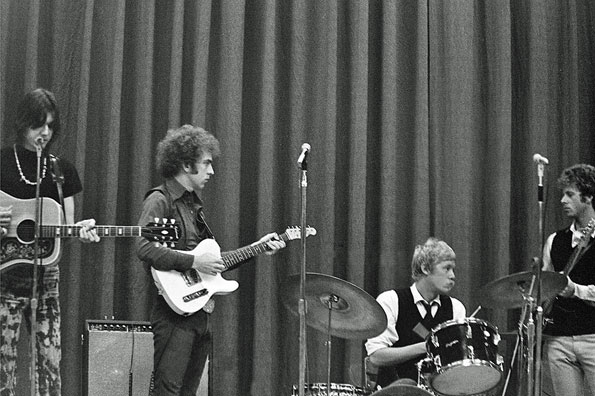
Flying Burrito Brothers: From left to right – Gram Parsons, Bernie Leadon, Michael Clarke, Chris Hillman. Sneaky Pete Kleinow was there but is not in this photo taken during their sound check. Photo by Denny Schwartz, courtesy Gary Schwartz
Rod McKuen: 1970
Rod McKuen appeared at the Minneapolis Auditorium on April 17, 1970, before a crowd of 5,000. Bonnie Usan, journalist for the St. Louis Park Echo, found McKuen’s work “melancholy, dejected, and lonely,” good for business, and just a little boring and repetitive. His basic themes were “his aborted attempts at love, memories of lost animal pets, and the bittersweet pain of being lonely.” She offered up “my mother or two affectionate goldfish.”
Eau Claire Peace Festival: 1970
The Eau Claire Peace Festival was held at the University of Wisconsin on April 18, 1970, Vietnam Moratorium Day, as reported by the Minneapolis Flag (April 10, 1970). Rain moved the 1500 celebrants inside. Acts were:
- Mandrake Memorial
- Townes Van Zandt
- Zulu
- The Paisleys
- Cottonwood
- Thundertree
- Pepper Fog
- Mauraders
- Seaman’s Mark
- Chesterfield Gathering
Eau Claire Peace Festival: 1970
The Eau Claire Peace Festival was held at the University of Wisconsin on April 18, 1970. Rain moved the 1500 celebrants inside. Acts were:
- Mandrake Memorial
- Townes Van Zandt
- Zulu
- The Paisleys
- Cottonwood
- Thundertree
- Pepper Fog
- Mauraders
- Seaman’s Mark
- Chesterfield Gathering
Sound Storm Rock Revival: 1970
The Sound Storm Rock Revival took place on April 24-26, 1970, near Madison, Wisconsin, billed as the Midwest’s First Great Freak Festival and organized by Golden Freak Enterprises, Inc. It featured:
- The Grateful Dead
- Crow
- Biff Rose
- Illinois Speed Press
- Rotary Connection
- Sorry Muthas
- Author Ken Kesey
- Headlights by Glateic Vision
Jefferson Airplane: 1970
Jefferson Airplane played at the Minneapolis Auditorium on Friday, May 15, 1970, with local – now national – band Crow playing warmup.
Jayme Kleinbaum remembers:
I was there. When Grace saw the size of the crowd she said, “Wow, Minneapolis, welcome to San Francisco.” We said, “San Francisco, welcome to Minneapolis.”
Songs mentioned in Will Shapira’s review were:
- Volunteers
- Somebody to Love
- The Other Side of This Life
- We Can be Together
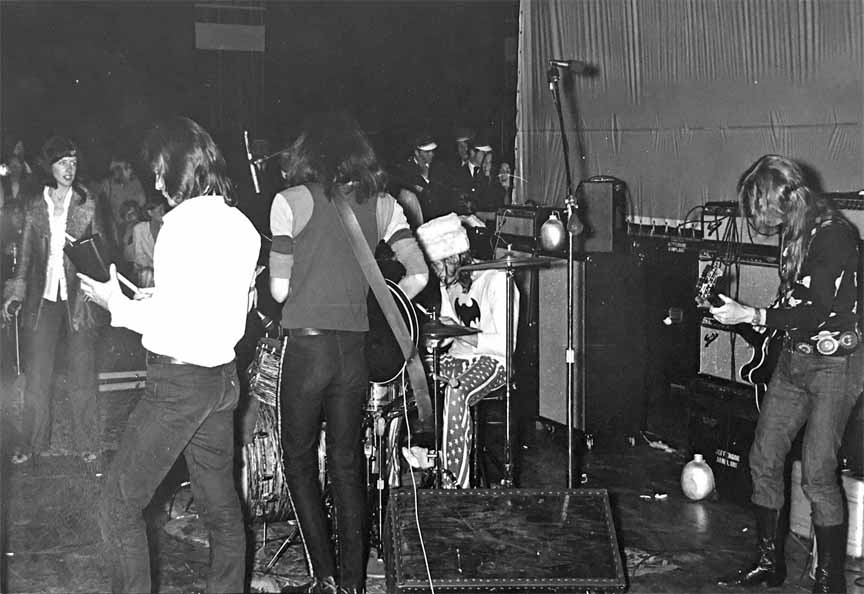
Photo of Jefferson Airplane courtesy Paul Pash
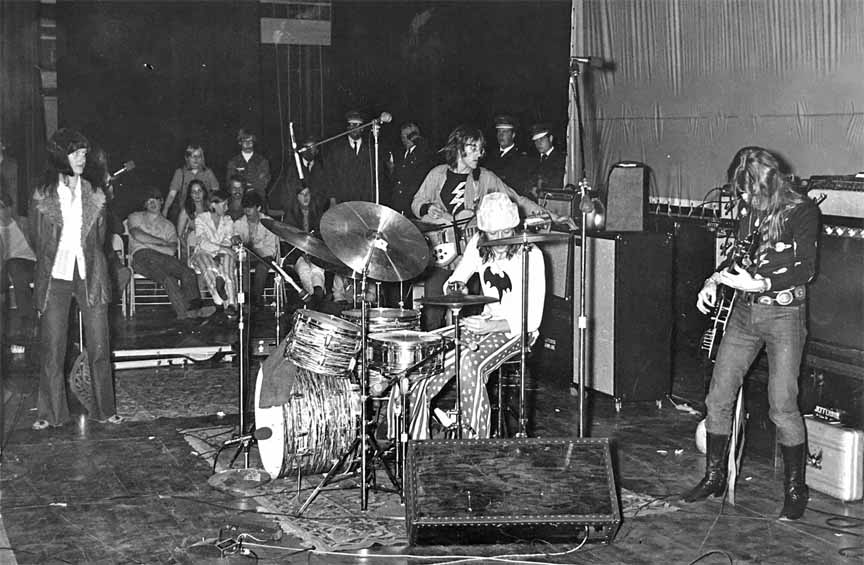
Photo of Jefferson Airplane courtesy Paul Pash
REVIEWS
Local reports are that Crow was really tight and the Airplane came off really sloppy.
Dodd Lamberton, reviewing for the Minneapolis Star, noted that Crow, formerly the South Forty, had a successful national reputation and much of its repertoire was original. The lead singer sounded quite a bit like John Fogerty, he though, and the gyrations and facial contortions of the drummer (Denny Craswell?) made him afraid that a heart attack was soon to follow.
Then came the chaos. During “Slow Down,” the crowd rushed the foot of the stage, making it impossible of the fans seated on the main floor. The band and the management begged them to move, they didn’t, and the band played on.
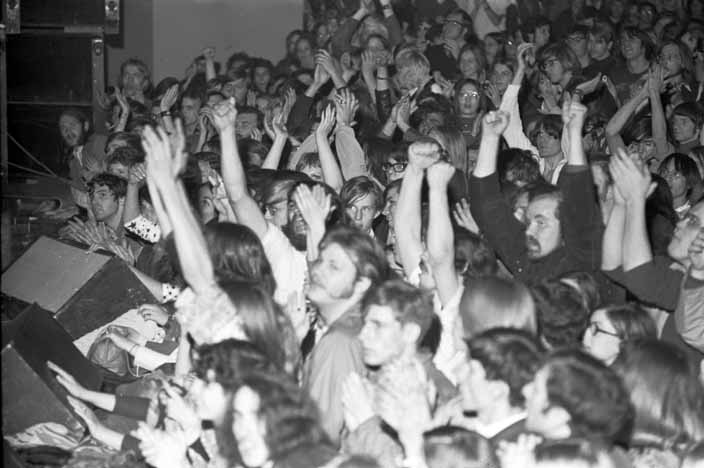
Photo copyright Mike Barich
When the Airplane arrived, the crowd went even wilder, which didn’t set well with the reviewer. No middle-aged stiff himself, Lamberton was a music major at the U. Nevertheless, he wrote, “It is unfortunate that whenever Minneapolis rock fans get a first-rate group to perform, they make fools of themselves by clustering around the stage, dancing and cheering every movement the performers make.” (May 16, 1970)
The Minneapolis Tribune recruited Will Shapira, a writer for Connie’s Insider, to review the show. Shapira reported that 8,000 “young heads” had turned out for the performance. He, too, noted that the crowd surged to the edge of the stage, but that there was “no trouble.” (May 17, 1970)
BALIN BUSTED IN BLOOMINGTON
It all started with a phone call by an irate parent who called the police and complained about a pot party his daughter had attended at the Thunderbird Motel with two soundmen with the group, Graydon C. Odell and Terry D. Cost. The two were originally arrested at 6 am Saturday, May 16, for contributing to the delinquency of minors, but while they were being transported to the Bloomington Police Department, they “attempted to conceal containers containing narcotics.” They were they charged with unlawful possession of marijuana and cocaine.
This resulted in a search warrant, which turned up marijuana and a cube of hashish in the possession of Martyn J. Buchwald, who performed under the name of Marty Balin. Bloomington police arrested Balin shortly before noon on Saturday, May 16. It is unclear whether he spent Sunday, May 17 in Jail. (Minneapolis Star, May 19, 1970)
On Monday May 18, the three appeared in Hennepin County Municipal Court on charges of possessing marijuana. They all demanded a pretrial hearing and were released on $5,000 each. (Minneapolis Tribune, May 19, 1970)
Below is the iconic photo of Marty Balin – Probably taken on May 18, 1970, on the way to the Hennepin County Courthouse for arraignment after a weekend in the Bloomington Jail?
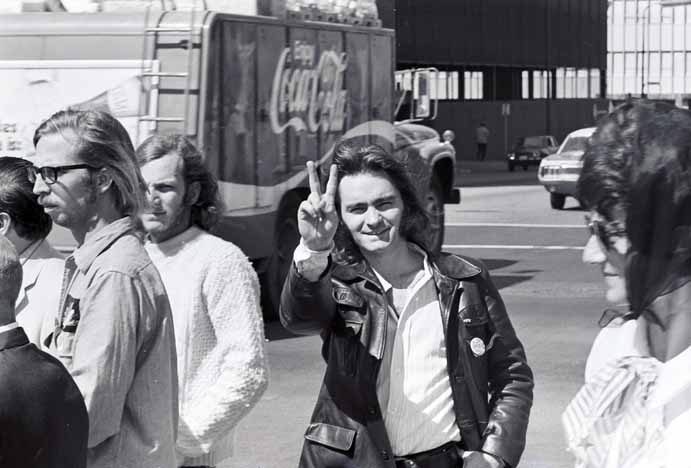
Photo copyright Mike Barich
Although the pretrial hearing was scheduled for June 16, the two soundmen (now referred to as stagehands) pleaded guilty to two counts of unlawful possession of narcotics on May 27. They were fined $1,000 each, and given suspended one-year workhouse sentences and put on five years unsupervised probation. (Minneapolis Star, May 29, 1970)
At Balin’s two-day hearing (May 28 and June 1, 1970), the judge found him guilty of one of the two counts against him of unlawful possession of marijuana. Balin did not deny the charge, and insisted that the real issue was illegal search and seizure. The policeman who found the marijuana in Balin’s motel room entered the room under the pretext of looking for one of the soundmen, who he knew was already in jail. The verdict of guilty was given by the judge, who sentenced Balin to one year in the workhouse and a $1,000 fine, stayed. (Minneapolis Star, June 2, 1970)
Marty Balin died on September 27, 2018, in Tampa at the age of 76.
CSNY: 1970
Crosby, Stills, Nash & Young were scheduled for the Minneapolis Auditorium for May 24, 1970, with ticket prices at $5, $6, $7, and $10.
Hundred Flowers reported that Barry Knight and John Kome organized a boycott over the high prices, and the group cancelled, supposedly for other reasons. They eventually rescheduled for July 9, with prices at $2, $4, $5.50, and $7. In his autobiography, Wild Tales, Graham Nash says of the concerts on that tour:
As the dates tumbled on … the delicate CSNY fabric got even more frayed. The electric portions of our show brought out the best and worst in us, particularly when it came to Stephen and Neil. Their old competitive shit started frothing onstage. The guitar breaks were like duels. Ideally, those guys should have been inspiring each other, picking up on a riff and playing it right back. Instead they were squaring off, trying to show each other up. Stepping all over each other. Afterward, in the dressing room, we’d almost have to separate them before they lunged at each other, ready to draw blood.
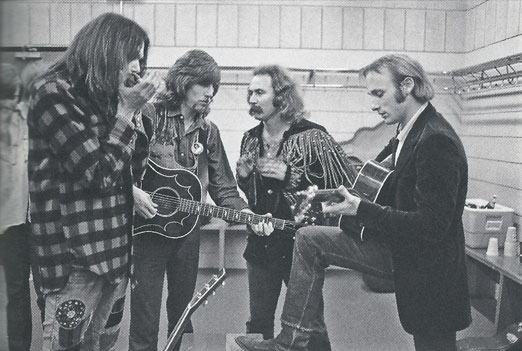
CSNY in the dressing room, Met Sports Center – photo by Henry Diltz
Bacchanlia (sic) Revival: 1970
Advertised in the Insider was the Bacchanlia (sic) Revival, scheduled for May 30, 1970, indoors at the State Fair Hippodrome, organized by John Brevik of Twin Town, Inc. Performers were to be:
- Shocking Blue
- Ike and Tina Turner Revue
- Tony Joe White
- Steam
- Sorry Muthas
- Catfish
- Syl Foremanf
- The Paisleys
- Zarathustra
- Youngsters
- Fairport Convention
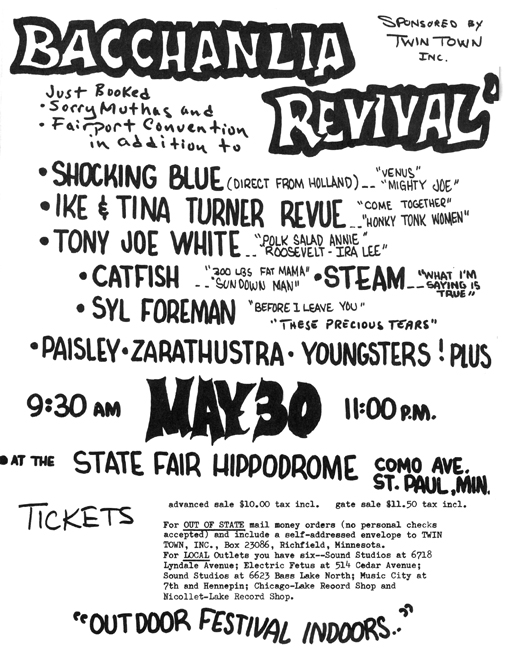
People’s Fair: 1970
A People’s Fair held near Steven’s Point, Wisconsin on June 26-28, 1970, was marred by band no-shows and bad behavior, according to an account in the Insider. Drugs were rampant, there were no police except the six helicopters hovering above, there was garbage everywhere, and a bunch of bikers came on Sunday and literally shot and beat people. Many people left before the headliners appeared. The list of acts that were supposed to perform includes:
- Chuck Berry
- Paul Butterfield
- Taj Mahal – cancelled at the last minute
- Steve Miller – backed out
- S.R.C.
- Crow
- Buddy Rich
- Buffy Sainte-Marie
- Johnny Winter – backed out
- Mason Proffit
- Ravi Shankar
- Ides of March
- Terry Reid
Jarreau: 1970
Alwin Lopez “Al” Jarreau (March 12, 1940 – February 12, 2017) was originally from Milwaukee. In 1970 he briefly moved to Minneapolis and formed the band Jarreau.
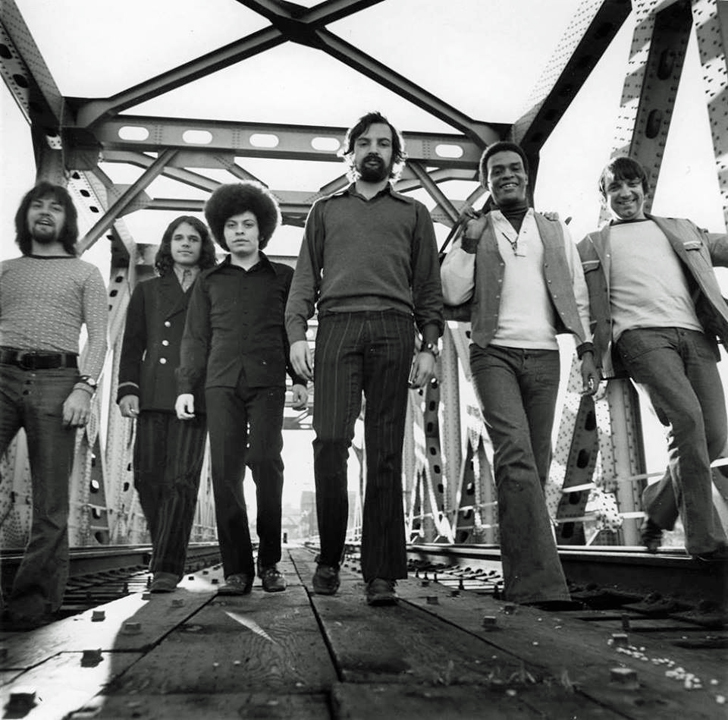
Jarreau, 1970: Dik Hedlund, Rich Dworsky, Bobby Schnitzer, Julio Martinez, Al Jarreau, Dick Bortolussi. Photo courtesy Rich Dworsky
The band made appearances in town during 1970, including:
The Depot in August

Supporting act for Poco at the Labor Temple, October 11, 1970.
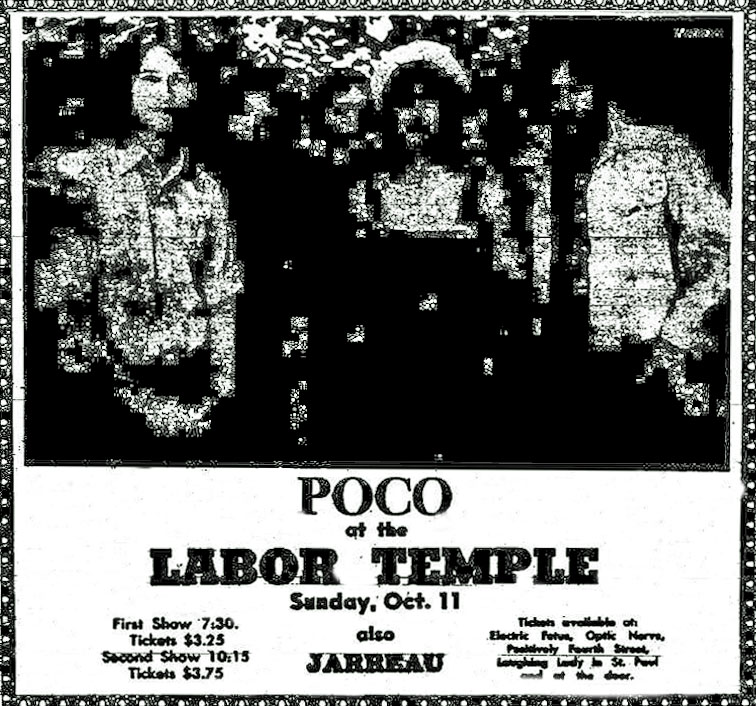
The photo below is from an appearance with Bill Carlson, some time in 1970:
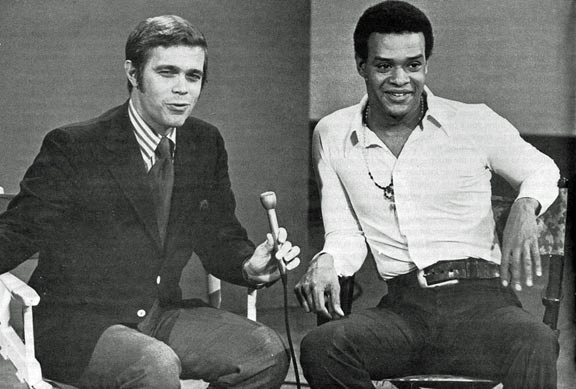
The band also opened for acts like Canned Heat and Steppenwolf in Canada.
It wasn’t long until Al (and a 17-year-old Dworsky) set off for Los Angeles and launched his very successful career. He received a total of seven Grammy Awards and was nominated for over a dozen more. Jarreau is perhaps best known for his 1981 album Breakin’ Away. He also sang the theme song of the late-1980s television series Moonlighting, and was among the performers on “We Are the World.”
Rich Dworsky, of course, became the pianist, bandleader, and music director of Guy’s All-Star Shoe Band on A Prairie Home Companion.
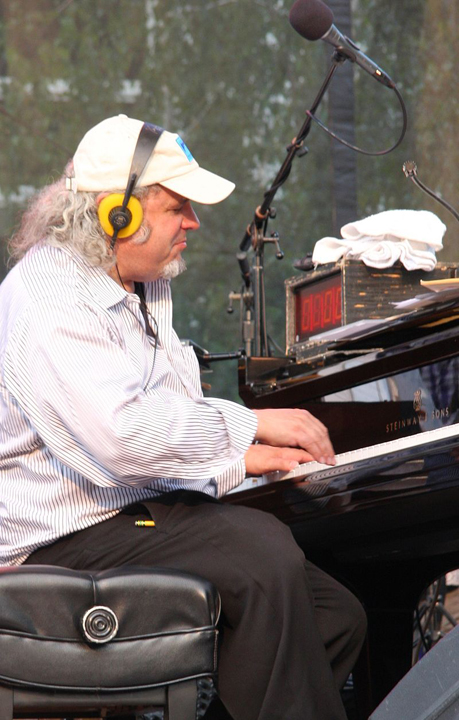
Rich Dworsky, 2015 – photo courtesy Wikipedia
Donwtown Bloomington: 1970
Sometime in 1970 or 1971, Dale Menten wrote the song “Downtown Bloomington,” the joke being that there is really no such thing. Dale is from Mankato, and first made his mark writing the song “Run, Run, Run” for his band the Gestures in 1964.
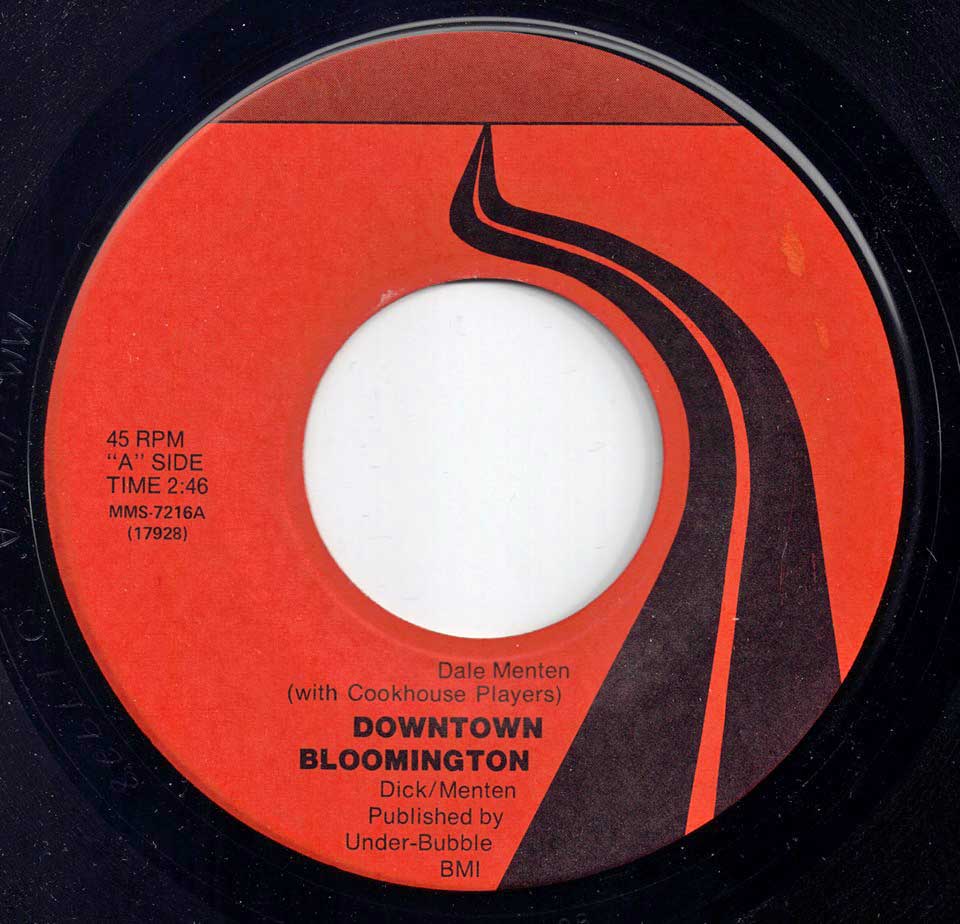
Mighty Tiny: 1970
And this, just because someone posted it on Facebook, the Mighty Tiny! See demonstration here.
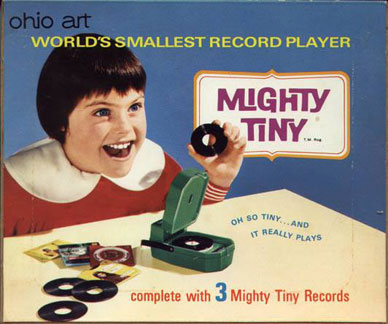
Open Air Rock Festival: 1970
An Open Air Rock Festival was held at Parade Stadium on July 19, 1970, attended by 6,000 people. 150 cops made 20 arrests for gate crashing but left dope smokers alone. Organizer Pat Rains, owner of the Prison, hired 10 Olympic karate experts to keep people off the stage. For his trouble he lost $35,000. Despite a cold, foggy day, the participants enjoyed performances by:
- White Lightning
- Sly and the Family Stone (who supposedly called Minneapolis “worthless”) Sly went on late, starting with the words “Minneapolis stinks” and played too long, leaving no time for the planned performance of Bloomsberry People.
- Illinois Speed Press (subbing for the Amboy Dukes)
- Richie Havens
- Johnny Winter
Soul of a City Festival: 1970
The 1970 Soul of a City Festival, August 20-23, 1970, was organized by Lonnie Morgan of F&M Bank, and took place on Nicollet Mall, the U of M, and Fair Oaks Park by the Art Institute. The list of acts scheduled to perform is below. The Insider reported that some of the acts didn’t get paid.
- Mojo Buford
- Lazy Bill Lucas
- George Avaloz jazz group
- Sam Bivens Sextet
- Cyril Paul’s group
- Grizzly
- Cottonwood
- Light
- Midwest
- Mauraders
- House of Fire
- Paisleys
Eric Burdon and War, Crow, and White Lightning: 1970
Eric Burdon and War, Crow, and White Lightning appeared at the Minneapolis Auditorium on August 23, 1970.
Neal Bond tells this story about the show:
This was my final stand in for promoter Scott Johnson’s wife, who at this point was in basic training for the Military.
Crow was riding high on the charts with “Evil Woman.” War was basically unknown except for Eric Burdon and they were the headliner. It was my understanding that Scott had booked Crow as the opening act for $1000 and Eric and War for $3500. Crow’s manager wanted to renegotiate and charge $7500 because of the chart action “Evil Woman” was getting nationwide.
I knew all the guys personally and had worked with the band many times in the past so it kind of left me in a precarious position. I finally told him that if that was the case we would have to get another opening act.
That was when White Lightning was added. All of the print and radio ads had already gone out. Crow’s manager finally came to his senses, deciding it would damage the bands reputation if they didn’t show and agreed the band would play.
The day of the show Eric and band arrived without a PA. They said it was in the contract that the promoter would provide the sound system. I’m thinking what….nobody told me…..
It was a Sunday and I’m faced with the dilemma of trying to get a sound system large enough to fill an arena with everyone who had the capability closed for the weekend. I called Jim Kane from the Litter and Freedom Electronics and they were playing in Chicago so there was no chance of using their sound system.
We finally decided that if we combined White Lightning and Crow’s sound systems it would be decent enough to fill 3/4 of the room. I called a few other bands I knew and got more speakers. So it put a band aid on a potentially huge problem.
It worked because there were only about 3500 people in attendance in a hall that held 10.000, but if you were in the nosebleed seats the sound was really muffled.
White Lightning came on as a five piece and did one really outstanding short set. A promoter from Canada was in town and backstage. He was really impressed with Lightning and with Mick Stanhope’s stage work. His comment to me was “He’s better than Jagger.”
When Crow came on the place went ballistic. Dave Waggoner asked me backstage if it would be all right if he asked the crowd to move up because of the PA situation. I said sure. When he did everyone rushed the stage area and the promoter from Canada had to help me stop the show and talk the crowd into calming down. The fire marshal was not pleased but it ensured that everyone had good sound. When Crow came back on the room was electric and I believe they got called back for two encores.
Eric Burdon and War put on a fabulous set afterwards. MGM, their label at the time, was dead set on changing the music scene from anything psychedelic and was cleaning house. Burdon had an asthma attack onstage and collapsed later in their tour, so War continued to tour without him and became a huge act later in the ’70s. MGM held Burdon’s contract and refused to release his new recordings. While I was out in LA I saw him protesting outside their building. Though they were short lived as an attraction, Eric Burdon and War were one terrific live act.
Overall it was one fantastic night. Everyone got more than their money’s worth. After the show the Canadian promoter told me that he was trying to break into the Twin Cities market and asked me if I wanted to work with him. I told him I was just filling in and headed to Colorado at the time to do a series of concerts as a folk performer so I turned him down.
But that’s another story…….
Association: 1970
The Association appeared at the St. Paul Civic Center on October 17, 1970. Ads started appearing in July.
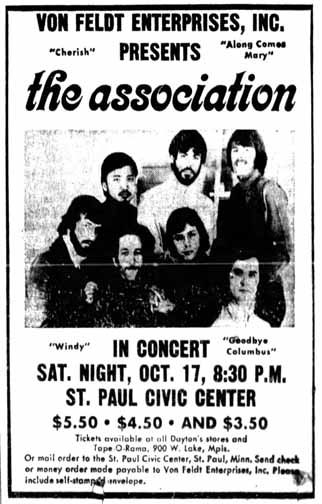
Festival of Hope: 1970
A Festival of Hope was held on December 23, 1970, at the Minneapolis Convention Hall. It was organized by Rev. Roger Paine and folksinger Ken Schaffer. Acts included:
- Pepper Fog
- Willie Murphy
- The Paisleys
- Lonnie Knight
- Roy Alstad
- Charles Keating
International Auto Show ’71
Spider Man, and Donna Wandrey, an actress on “Dark Shadows.”
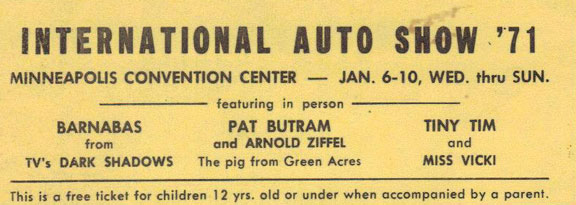
Events: 1971
PLEASE NOTE:
Although performances are noted here, all shows for the following venues are described in more detail on their venues pages:
- O’Shaughnessy Auditorium
- The Depot
- The Guthrie
Three Dog Night appeared at the Met Center on January 8, 1971, sponsored by the Junior Miss Stores of the Twin Cities area. Undercover Bloomington narcs dressed as hippies arrested 16 teenagers for possessing or selling pot.
Gypsy, opened by Copperhead, played at the O’Shaughnessy Auditorium on January 10, 1971.
Tiny Tim played the Depot on January 10, 1971
Neil Young performed at the Guthrie on January 14, 1971
The Nashville Brass appeared with the Minnesota Orchestra on January 17, 1971.
Al Kooper was at the Depot on January 17, 1971
Mason Proffit was at the Depot on January 24, 1971
Sha Na Na at Depot January 31, 1971
Taj Mahal at Guthrie, February 4, 1971
Gypsy, O’Shaughnessey Auditorium, February 4, 1971 (?)
The WDGY Listen List for February 10, 1971, advertised professional Motorcycle Races indoors at the Minneapolis Armory, featuring riders from 6 states – added attraction, “Mini” bike races. The event was on February 20. Tickets were $2.
John Denver performed at Northrop Auditorium on February 18, 1971. Tickets were $3.
Sly and the Family Stone and the Mystics, February 19, 1971, Met Center
Savoy Brown & Grease Band & Small Faces, February 20, 1971, Met Center. Ken Schaffer’s group Dawn opened the show. Tickets were $4. The hippie rag Hundred Flowers published a story about a guy with no money who hitched a ride to the concert, sneaked in with a paying customer’s torn ticket, and complained about bad sound and capitalist pigs.
Richie Havens at the Depot, February 21, 1971
Tafi’s, a jazz venue, hosted Latin jazz musician Cal Tjader and his Quintet on February 22-27, 1971.
“Hair” played sold-out performances at the St. Paul Civic Center Theater, opening February 23, 1971, then the same cast returned for another engagement in May – the first show ever to be brought back to the Twin Cities for a second run in the same season. The February engagement broke box office records at the venue.
The Cowsills appeared at the North Hennepin State Junior College, 74th and 85the Ave. No. in Brooklyn Park, on February 27, 1971.
Leo Kottke appeared at the Whole Coffehouse on March 4, 1971, and got a good review from Hundred Flowers.
The Gopher State Timing Association presented its 15th Rod and Custom Spectacular at the Minneapolis National Guard Armory (6th and Portland Downtown) on March 5-7, 1971, as advertised on KDWB’s Top 36 for that week.
Ike and Tina Turner Revue at the Depot, March 14, 1971
Eric Burdon at the Depot, March 21, 1971
The Allman Brothers Band and the Litter played two shows at the O’Shaughnessy Theater on March 25, 1971.
BB King at Depot, March 28, 1971
Jethro Tull at Guthrie, April 1, 1971
Don Ellis at Guthrie, April 4, 1971
Procol Harum at Depot, April 4, 1971
Quicksilver Messenger Service with Brewer and Shipley appeared for two shows on April 7, 1971, at the O’Shaughnessy Auditorium.
Ten Years After appeared at the St. Paul Civic Center Arena with Humble Pie on April 9, 1971. Produced by Greathall – CBA.
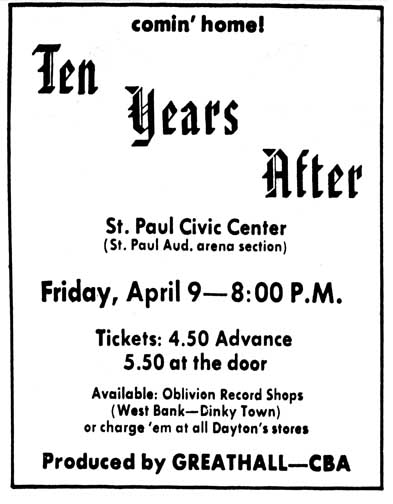
Minneapolis Tribune
James Gang at Depot, April 11, 1971
MC5 plus SRC, presented by North Country Music, were at the Minneapolis Armory on April 16, 1971.
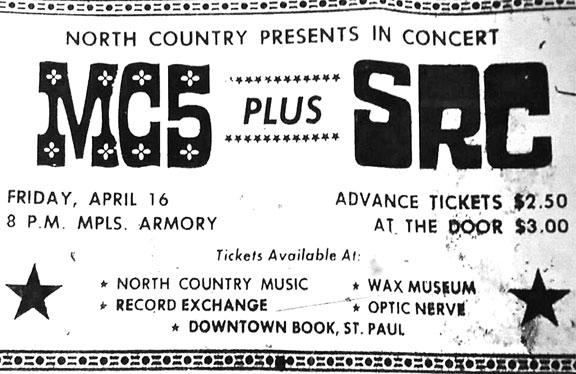
Ad courtesy Wayne Klayman, owner of North Country Music
Some comments on this show from Facebook:
Mark: “I was one of the few there. AND I snuck in. Very small crowd, probably about 400 people. SRC was fantastic. MC5 were bummed because of the small crowd and it showed. Very cool to see that.”
Paul: “I was there and very surprised at the small crowd. They just weren’t a mainstream band.”
Another Mark: “I was there! I remember the MC5 doing a long version of Louie Louie that night.”
Arlo: “I saw this show and after the MC5 started there was a small riot in front of the band claiming it was not the real MC5!”
Blood, Sweat & Tears, Minneapolis Auditorium, April 18, 1971. 6,000 attended the concert, which was panned in the Insider.
Rod McKuen, Minneapolis Auditorium, April 23, 1971
The Grassroots and “special guest stars” at the Met Center on April 23, 1971. Carol reports that the lineup was Flash Cadillac and the Continental Kids, Alice Cooper and then the Grassroots. She says, “Alice Cooper had huge fans onstage, and slashed open feather pillows, blowing the feathers all throughout the venue. They were pretty tame back then.”
Gypsy at the Depot, April 25, 1971
Laura Nyro, Guthrie, April 25, 1971
Leo Kottke, April 27, 1971
Brewer and Shipley at the Whole Coffeehouse, April 29, 1971
Kris Kristofferson at the Guthrie, May 3, 1971
Big Mama Thornton came to the Whole Coffeehouse on May 4 and 5, [5 and 6] 1971.
Chicago came to the Minneapolis Auditorium on May 9, 1971, presented by WOE.
Iggy and the Stooges at the Depot, May 9, 1971
Son House appeared at the Whole on May 10.
Emerson, Lake and Palmer at the Guthrie, with Mott the Hoople, May 11, 1971
The Association, Melby Hall, Augsburg College, May 15, 1971
Bread appeared at the St. Paul Auditorium on May 15, 1971
John Mayall at the Guthrie, May 16, 1971
Redbone at the Depot, May 16, 1971
The Carpenters appeared with the Minnesota Orchestra at Northrop Auditorium on May 23, 1971. An ad said that the emcee would be a personality from WWTC.
Johnny Winter appeared at the Depot on May 23, 1971.
Livingston Taylor at Guthrie, May 30, 1971
Tom Jones performed at the Met Sports Center on June 3, 1971
Edgar Winter at the Depot, June 6, 1971
The Depot closed for good on June 14, 1971.
The Jefferson Airplane appeared at the Minneapolis Auditorium as part of their farewell tour on June 24, 1971. The last time they were here Marty Balin and two roadies were busted at their motel in Bloomington. “Light show by Heavy Water.”
Ike and Tina Turner, with the Grease Band, appeared at the Minneapolis Auditorium on June 24, 1971.

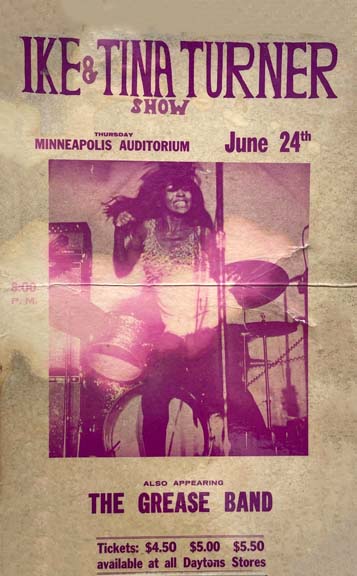
Image courtesy Paul Pash
Jesse “Lone Cat” Fuller, a 75-year-old black blues singer and musician, performed at Eddy Hall Knoll, East Bank of the U of M, on June 30, 1971, reported the Star. “His performance on the guitar, kazoo, harmonica and fotdella (an invention of his own) is one of laughing, dancing, happy songs.” He decided on the one-man-band concept in 1951 when he wanted to form his own band but found it difficult to find dependable, capable musicians.
Black Sabbath and Bloodrock performed at the St. Paul Civic Center on July 5, 1971. This date has been difficult to nail down, but Alessandro in Italy found this sound bite from RadioTapes – after minute 18.
Steven Stills, August 7, 1971, Minneapolis Auditorium – cancelled
GYPSY – IN THE GARDEN
Gypsy’s second album, “In the Garden,” charted on August 7, 1971, reaching No. 173 on the Billboard Pop Albums charts in 1971.
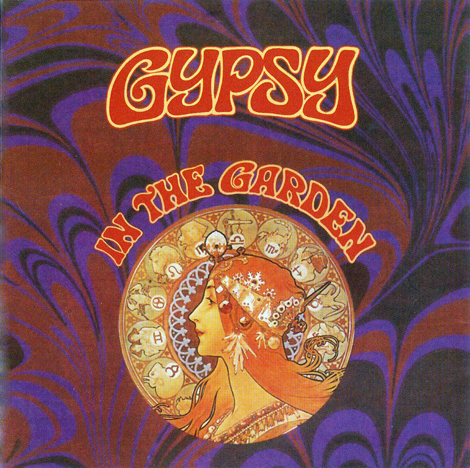
Bonnie Raitt made an appearance at the Joint on August 8, 1971.
August 8, 1971, was KDWB’s 7th Annual Drag Festival at Minnesota Dragways.
Judy Collins, August 13, 1971, Minneapolis Auditorium
Big Mama Thornton appeared in front of Northup Auditorium on August 15, 1971.
THE WHO 1971
The Who, August 15, 1971, Met Center, also featuring LaBelle. Various reports are that gate crashers or an influx of phony tickets resulted in bedlam at every entrance, and the Bloomington Police Department used teargas for the first time. Most of it blew in the cops’ faces. Most of the show was songs from “Who’s Next,” which hadn’t been released yet. The sound of a synthesizer magically appeared, either from a guy behind the curtain or via tape. Ad below posted by Jim Froehlich. Wishbone Ash opened.
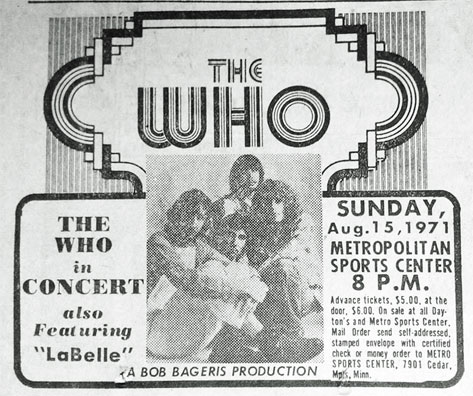
The second annual “Soul of a City: The Urban Environment” event was held the week of August 16-22, 1971, with arts events held in venues all around Minneapolis.
Meanwhile, the Old Guard was grousing. The St. Paul Musician, house organ for the St. Paul Musician’s Union, tried to make sense of it:
Some of our members who keep telling me that rock music is on the way out must be less than naive if the record crowds of over 25,000 customers who shelled out about $7.00 each to attend the recent rock concerts at Midway Stadium is any indicator. Hot or rainy weather, discomforts, and still they pack them in. On the other hand bands like Woody Herman or Count Basey [sic!] who are tops in the field of jazz, play The Prom in concerts can’t seem to draw more than 800 people at box office prices substantially less than at midway Center. It all adds up that the kids still want their favorite rock bands.
The Guess Who and Gypsy appeared at the St. Paul Auditorium on August 28, 1971.
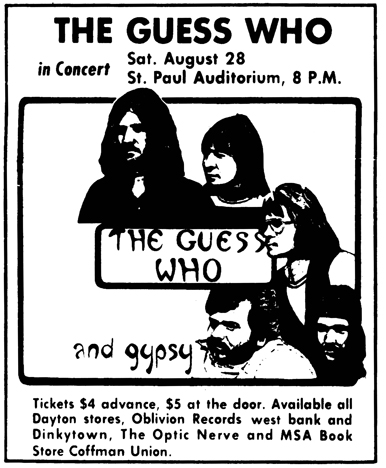
Minneapolis Star
Genesis (the Genesis?) and Cree appeared at the Cedar Village Theater on August 28, 1971.
BOTTLENECK II
On Sunday, September 5, 1971, Loring Park was the site of “Bottleneck II & the First Minneapolis Open Air Resource Catalogue, organized by Barry Knight and sponsored by the Center Arts Council of the Walker Arts Center.”
It was a kind of living Whole Earth Catalog, if you remember that, with about 50 groups at tables handing out literature and educating people on topics like recycling, the arts, food, technology, health, and housing. Members of the Nancy Hauser Dance Company “frolicked,” and music was provided by the Whole Earth Rainbow Band, the Bumblebees, and Michael and Anthony Hauser.
Jackson 5, opened by the Commodores, Met Sports Center, September 8, 1971
James Gang, Minneapolis Auditorium, September 12, 1971
Howlin’ Wolf appeared with Chase, Minneapolis Auditorium, September 18, 1971
David Crosby and Graham Nash at the Guthrie, September 19, 1971
John Baldry with Madura performed at the O’Shaughnessy Auditorium on September 19, 1971.
George Shearing was at the St. Paul Civic Center on September 24, 1971.
The Bee Gees with the Ian Forrest Orchestra and Tin Tin, September 24, 1971, Met Center
Don Ellis and Friends appeared at O’Shaughnessy Auditorium on September 25, 1971.
Dave Ray and Big Mama Thornton at Whole Coffeehouse, September 25, 1971
Flash Cadillac and the Continental Kids and Cree at Augsburg College, September 29, 1971
On October 12, 1971, WCCO aired “Moore on Tuesday” at 9:30 pm with a segment on the Minneapolis music scene.
Three Dog Night with Gayle McCormick (from Smith, now with the Underhand Band), October 15, 1971, Met Center. Wolfman Jack was working with Three Dog Night, and Johnny Canton introduced him.
Hank McKenzie recalls:
It was memorable because while we were in enjoying the concert, there were a number of disgruntled fans outside who couldn’t get in and the police were called. When we came out of the concert we were confronted by police and told to move on. I explained that we were waiting for a ride home and were to meet our ride in front of the auditorium. The cop told me that I could not meet them there. We ended up walking into downtown to catch a bus back to Robbinsdale where my driver was extremely angry as my friends were ‘under age’ so to speak. All was smoothed out the next morning when the news came on about the riots at the concert the night before.
Crow and Willie and the Bumblebees appeared at O’Shaughnessy Auditorium on October 18, 1971. (?)
Jesus Christ Superstar, October 19, 1971, Met Center
The Grateful Dead, with New Riders of the Purple Sage, at Northrop Auditorium on October 19, 1971.
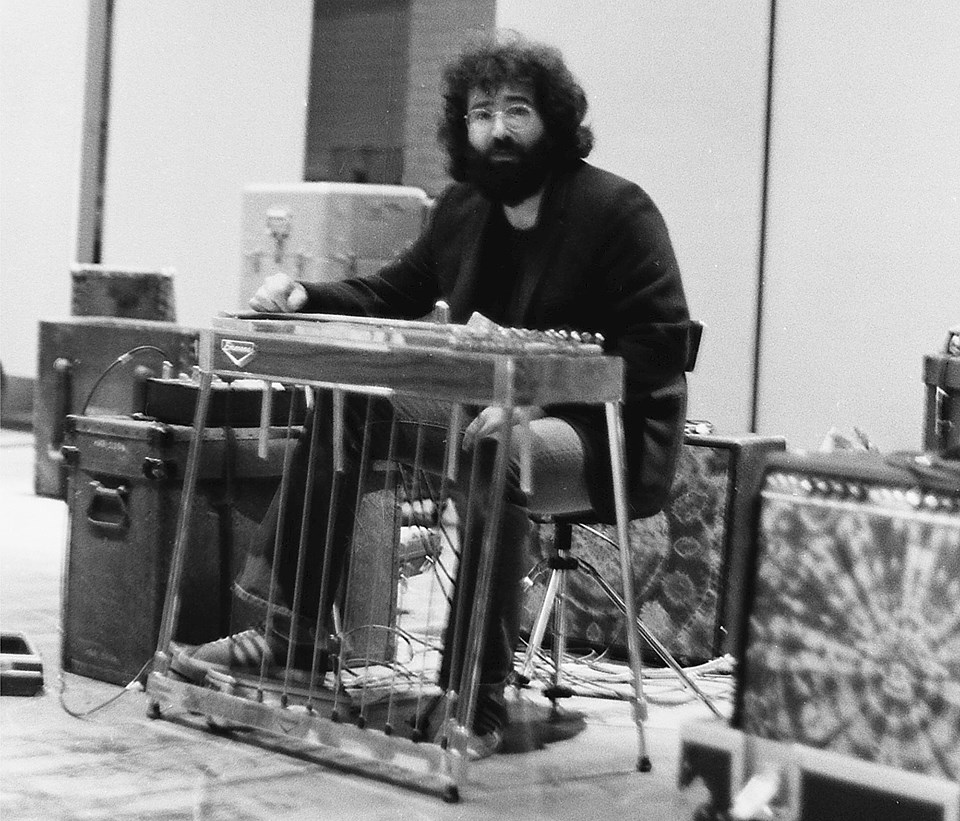
Jerry Garcia warming up on his steel guitar, which he played with the New Riders of the Purple Sage later that day when they opened up for the Grateful Dead. Photo courtesy Gary Schwartz
Jeff Beck and BB King, October 22, 1971, Minneapolis Auditorium
Grand Funk Railroad and Ballin’ Jack, October 27, 1971, Met Center. Concerts West Presents an Historic Event!
Joan Baez came to Northrop Auditorium on October 28, 1971.
Johnny Cash, Carl Perkins, Statler Brothers, Met Sports Center, October 29, 1971
Donovan, November 5, 1971, Minneapolis Auditorium
Elvis, November 5, 1971, Met Center See Elvis in the Twin Cities.
The Insider advertised that Roberta Flack would appear at the O’Shaughnessy Auditorium on November 6, 1971 for two shows, but there is no evidence in the Minneapolis newspapers that this actually happened.
Whole Earth Rainbow Band, the Joint, November 9, 1971
DOORS AT AUGSBURG
The Doors played Melby Hall at Augsburg College on November 13, 1971. The Spencer Davis Group opened the show.
It was the first tour of the Doors since the death of Jim Morrison, who died in July 1971. This show was the second show of the tour, presented by Schon Productions.
A partial setlist for the Doors was:
- Tightrope Ride
- I’m Horny, I’m Stoned
- In the Eye of the Sun
- Close to You
- Love Me Two Times
- Light My Fire
ROCK ‘N’ ROLL REVIVAL
There was a Richard Nader Rock ‘n’ Roll Revival at the St. Paul Civic Center on November 14, 1971, featuring:
- Chuck Berry
- Bill Haley and the Comets
- Bo Diddley
- The Shirelles
- The Dovells
- Gary U.S. Bonds
- Bobby Comstock and the Comstock Ltd.
Jose Feliciano, November 14, 1971, Minneapolis Auditorium. The Tribune highlighted the show with a drawing by Dick Guindon. The text said that Feliciano had been here in 1965, at a Twin Cities supper club.
Bonnie Raitt did a stint at the Whole Coffeehouse on November 17-20, 1971.
The Lettermen were at the Minneapolis Armory on November 19, 1971.
Beach Boys at the Guthrie, November 21, 1971
John Hartford was at the St. Paul Civic Center on November 28, 1971.
Pentangle was at the O’Shaughnessy, also on November 28, 1971.
Randy Newman at the Guthrie, December 5, 1971
The Doors, minus Jim Morrison, appeared at Melby Hall, Augsburg College, with the Spencer Davis Group, December 13, 1971. Tony Glover does not appear at this show, but did appear with them on November 23, 1971, at a concert at Carnagie Hall in New York.
Ten Years After: 1971
Ten Years After appeared at the St. Paul Civic Center on April 9, 1971, opened by Humble Pie. Some source I can’t find now said that King Crimson and Black Sabbath were also there, but after Alessandro from Italy wrote to question this, even a thorough search by a heroic librarian named Carol at the St. Paul Public Library could not find confirmation:
I was able to confirm that Humble Pie and Ten Years After did play at the Civic Center on April 9, 1971, but I was not able to confirm if Black Sabbath or King Crimson were there. Black Sabbath supposedly played at the St. Paul Civic Center on July 2, 1971, but there were no reviews or advertisements for that concert either in the St. Paul newspapers or the Minneapolis newspapers. The published itinerary of Black Sabbath does make it possible that they could have played in St. Paul on either April 9 or July 1. It seems less likely that King Crimson was here since they were in Europe shortly before and shortly after those dates and airfare was considered extremely expensive at that time.
Wow! Wish I could hire Carol as a research assistant!
Fake Buddy Miles Fiasco: 1971
In late 1970 Magoo’s had become the Cafe Extraordinaire, owned by Bobby and Doris Jackson. They started with a Jazz Festival, bringing in such big names as the Elvin Jones Quintet, Joe Henderson, Eddie Harris and his Quartet, Kenny Burrell, and Freddy Hubbard. The people just didn’t respond, so in December 1970 the format switched to soul, featuring acts such as Zulu and Showtime I and II.
The Jacksons booked Buddy Miles to appear on April 10, 1971. An article promised sidemen Andrew Lewis on clarinet and organ, Marlo Henderson on guitar, Charlie Karp on lead guitar, Dave Hull on bass, Tom Hall on trumpet, Hank Redd on tenor sax, Mike Fugate on trumpet, and Stemsy Hunter on sax.
But things went awry. Tom Behr shared the story on Facebook:
[My] brother Bob was an agent and the club owner asked him to book Buddy Miles. When Miles’ agent said he’d need a deposit to lock the date in, the club owner told Bob that he would take over the negotiations and send in the deposit. Then Bob was told that Buddy would be coming without the Express Band, so Jr. Trejo’s Saxon Soul was asked to sit in as Buddy’s back up band.
Here’s where the story gets better: Jr. said they had a rehearsal the afternoon of the show and Buddy played drums, but asked Jr.’s singer to sing his songs because he had laryngitis.
The crowd was beginning to sense there was scam going on. [Apparently someone recognized the keyboard player’s B3, which was covered with a blanket, and that’s when people realized something was up.] On the first break Jr. told the club owner that he finally figured out this guy was a sham and they were going to pull the plug on the show. [Jackson] said, “You better play or the crowd will trash the club not to mention your equipment!” Then he says “Hey Jr. can you play something by Chicago?” (I’m serious)
So as soon as they start to play the second set, people where booing, and throwing food, then drinks at the band, one by one the guys get off the stage, leaving “Buddy” to play a drum solo. Now as the riot is on, fake Buddy jumps off the drums, tosses off his Afro wig and out the back door he ran. The epilogue gets better: the Trib had a picture on the front page of the wig sitting on a table with a bunch of beer mugs, and it turned out the fake Buddy Miles was the janitor at Sacred Heart Church on the East side. I’m still laughing at that one!!
Marshall Fine was suspicious; in his review of April 12 he noted that:
- “Miles” was obviously wearing an Afro wig.
- Miles was fatter than “Miles.”
- Miles has a huge ego, but “Miles” stayed in the background in a dark stage.
- “Miles” only sang backup, while at a previous Labor Temple show, Miles “dominated his group with his thin voice, heavy-handed mannerisms and tiresome drumming.”
- “Miles” “did a drum solo at the end that was superior to anything Buddy Miles has done.”
From the Minneapolis Tribune, April 12, 1970 (Terry Farrell):
Youths rip club during disturbance
About 1,000 young people went to the New Cafe Extraordinaire late Saturday to hear black drummer-singer Buddy Miles and got “ripped off,” youthese for “taken.”
So, some of them decided to rip off the Cafe Extraordinaire, 2933 Nicollet Av. And they did.
They smashed the plush music club’s interior stained-glass windows, overturned and smashed tables, damaged some of the band’s equipment, emptied a fire extinguisher on a rug, tore open cash registers and a cigarette machine, broke a plate glass window, hurled glass mugs about the room, and then pushed out onto Nicollet Av.
Police were called about midnight, shortly after the eruption began. Squad cars quickly blocked off that portion of Nicollet. Policemen began to disperse the crowds and about an hour after the disturbance began it was all over.
It began when the predominantly black crowd realized that the performer who claimed to be Miles was an impersonator. And each of them had paid $5 a ticket.
Club owner Bobby Jackson, sitting amidst the ruins of the club, Sunday said he is not “at liberty to say what went on” concerning the impersonation. But, he added, “all responsibility should lie with the real Buddy Miles. A contract was signed with him.”
Jackson, in good spirits despite the loss of a night’s sleep and what he estimated to be $50,000 in damage to his two clubs (the New City Opera House adjoins the Extraordinaire) said “somebody slipped along the line.”
He said he did not think that his insurance would cover the damage to the clubs, valued at $1450,000. “There’s no way we can reopen.”
Jackson, 29 and black, said he “would go back to playing drums for $100 a week.”
He said that when the incident began he “split – there was no reason to stay.” He said he grabbed money from two cash registers and went home.
Soon after Jackson left, the police arrived. For the most part, though at times, gruff, they were restrained and efficient in dispersing the crowds. However, at least one incident did occur.
About six policemen led by an officer and with a police dog, crossed from in front of the clubs to the west side of Nicollet Av.
The officer, billy club extended, shouted to the people who lined the sidewalk to “move it. Go on, get out of here. One black man did not move fast enough. The officer kicked him in the groin, and he was picked up off the sidewalk by two other policemen to a squad car. Another man was also arrested.
No injuries were reported by police. The two men were arrested on charges of breach of the peace, failure to obey an officer and obscenity in public, police said.
Marshall Fine shed more light on the situation on April 15, revealing that the back-up band was called Saxon, led by Gary Winkler. The band had been hired to back Miles, and worked hard to learn the material. They met “Miles” just before the show, and noticed that “He was too skinny, and his hair looked fake.” Then Winkler was told that Miles had laryngitis, and that he’d have to sing all his numbers. Winker reported that when he realized the hoax, “I was embarrassed, man, like really ashamed. It got to the point where I was signing with my back to audience, I was so ashamed.”
It was after the second set started that the crowd turned. “Miles” hit the back door, and owner Jackson hit another door with $7,500 to $10,000 of the ticket money. Neither “Miles” nor Saxon got all the money they were promised. KUXL disc jockey Jimmy Smith, who had emcee’d the show, told Fine that he looked for Jackson, but his apartment had been cleared out and his phone cut off. This turned out not to be true; a subsequent article says that he had come to the police station and given a statement. He told police that when the hoax was discovered he had started refunding money, but was overcome by the crowd and left.
Another article by the Tribune’s Howard Erickson gave this as Jackson’s account:
Although some patrons became upset at what they considered deception and demanded their money back, “most of the people were satisfied, I think.” He said refunds were being made at the box office when “two, maybe three guys started making a big scene. One of them threw a beer bottle through a stained-glass window, hollered ‘Phoney,’ and fired a pistol. That got the whole audience panicky. The band left the stage and everybody else headed for the exits, fast. That’s what produced the damage – most of it was accidental from the crowd’s haste.”
Apparently the real Miles had been in town, but when he didn’t get the front money he was promised, he cancelled and went back to Boston, where he was during the whole thing.
The event was reported in Rolling Stone on May 13, 1971, in an article rather harshly entitled “You’re Not Buddy Miles, You Pig.” The last paragraph reads:
The real Buddy was not available for real comment, but his company, Mercury, claimed that Miles’ manager cancelled out of the gig the day before because Jackson had come up with only $500 of the $1500 deposit required by the contract.
PERRY PEOPLES
Regardless of whether he also worked as a church janitor, the imposter was actually an accomplished local drummer. Perry Carson Peoples, Sr., 40, had been performing around town for decades – one note said he played for the Stan Haugesag Orchestra for many years. In 1958 he led his Interpreters of Jazz at St. Paul’s Red Feather. Members of the combo included Hensley Hill on flugelhorn, Woodson Bush on alto, Irv Williams on tenor, Tim O’Donnell at the piano, David Facen, bass, Ira Pettiford. The group also presented a concert in 1958 at Macalester College. In 1963 Peoples was in Irv William’s Quartet.
Peoples was born in Kansas in 1928, one of nine children. In 1940 the family was living at 706 Rondo Street in St. Paul, and his father was a singer, employed under a WPA project. Three of his sisters were maids. The family had apparently moved to Minnesota in about 1935.
Although an article on Peoples identified him as a professional musician for 25 years, it also quoted him as saying he was the chief engineer at a St. Paul “institution” which he did not identify. In 1972 he was working as the maintenance manager at Crystler City (6800 Wayzata Blvd. in Golden Valley, now the site of Menard’s). But he was back working in music in 1978-1980. In 1980 his son, Perry Peoples, Jr., was convicted of murdering his common-law wife and sentenced to 15 years in Stillwater. The son died in 1986. References to Perry, Sr. end in 1989 with a letter to the editor indicating that he now lived in North Minneapolis. He died on January 16, 2003.
Both Marshall Fine and Terry Farrell reported that Peoples said that he did not know that he was impersonating Miles and that Jackson had hired him to play “on my own merits.”
END OF THE EXTRA-ORDINAIRE
The incident was investigated by police, and detectives had taken the matter to the county attorney’s office for review, but the it was found that “There wasn’t sufficient evidence for us to prove a felony by any particular individual.” Dayton’s refunded money to those who had bought their tickets there.
However, although no criminal charges were brought, the Minneapolis license inspector recommended that the City Council revoke Jackson’s beer license. And as it turned out, Jackson lost his liquor license for a bad check. Jackson had paid for his license renewal with a check for $650, which bounced. He came back and was able to pay $300 on acccount, and was told to pay the other $350 on April 12, but when he came back to pay the balance, he was refused. When he asked for the original $300 back, the treasurer’s office refused to give it to him. Alderman Robert Denny told him that he “was lucky to get out with that,” and that if the whole $650 had been good, he would have probably lost that “for other reasons,” meaning the riot. As Jackson left the committee room, he was heard to say, “They’re all a bunch of liars in there, man.”
CODA
One of the men arrested on the night of the riot was Oscar Thomas Govan. He was found guilty of making inflammatory statements when the police were clearing the area. Officers testified that he had shouted things like “Kill the pigs,” “Burn the squad cars,” and “Get bricks.” Tribune reporter Terry Farrell (see above) testified that Govan had been kicked in the groin by a police officer and knocked to the ground during the arrest, but the judge said that that was irrelevant. (Govan, a Marine who was wounded by a land mine in Vietnam, received 100 percent disability payments.) He received a suspended sentence of 30 days in the workhouse. Govan died in 1988 at the age of 40.
Peacerock Festival: 1971
A rock festival was planned near Hibbing for May 14-16 [28-31], 1971, organized by one John Grimes. The April 17, 1971, issue of Hundred Flowers reported that the actual location would not be disclosed until the date came closer, for fear of an injunction. Plans called for 25 local and three national bands. Security was a big issue; Grimes planned on having 150 security guards on horseback and 500 volunteers from Karate and self defense clubs to keep anyone from hurting anyone else.
The next issue reported that St. Louis County had issued an injunction against the festival and arrested Grimes for selling tickets in advance. The location was identified as the 600-acre Nels Rude Farm, 20 miles west of Cook and 20 miles north of Hibbing. So far Thundertree and some bands from North Dakota had signed on. Hundred Flowers expressed an objection to the festival because it appeared to be a money-making endeavor on the part of Grimes.
On May 21 it was reported that the festival had been moved to Woodstock, Minnesota, and that Alice Cooper and the Stooges had been signed. By now Hundred Flowers was convinced that Grimes was a “rip-off artist” and urged readers not to buy tickets.
No indications that this festival ever happened.
Poco: 1971
Poco and a “special performance” by Shawn Phillips came to the St. Paul Auditorium Theater on May 21, 1971.
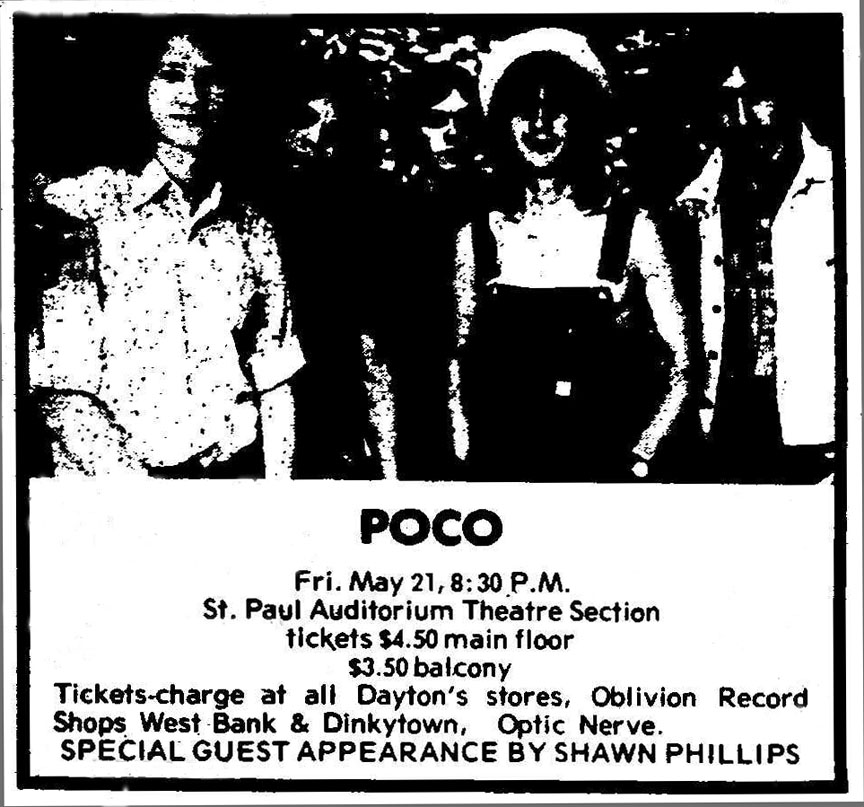
Loring Park Festival: 1971
A free Music Festival took place on May 21 and 22, 1971, in Loring Park, sponsored by Metro State Jr. College. Performing were:
- John Koerner
- The Hall Brothers
- Lazy Bill Lucas
- Dave Ray
- The Marauders
- Baby Doo Caston
Open Air I: 1971
The first of three planned open air concerts was held at Midway Stadium on June 26, 1971.
Performers were, in order of appearance:
- Tony Glover
- Muddy Waters
- Crow (subbing for Free)
- The Butterfield Blues Band
- Delaney & Bonnie
- John Sebastian
- The Band
Sound was provided by Magnum Opus, out of Boulder.
The promoter was Harry Beacom. He had organized a similar event on the campus of Michigan State University the summer before that attracted 42,000 people
Plans called for:
- 200 Simms ushers
- 90 policemen (nine on horseback)
- Two complete stage crews
- The traditional hot dogs (31,000 of them, 600 of which were eaten backstage and in the press booth)
- Health food choices such as yogurt, granola, and carrot juice made from 160 pounds of carrots.
- 24 parking lots
- 130 first aid volunteers
- One doctor
- Seven interns
- Ambulance service
- Complete first aid station
- Free posters at ticket outlets while supplies last
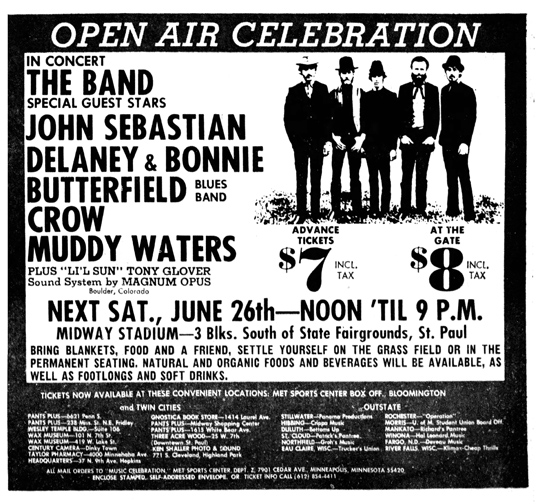
Minneapolis Tribune
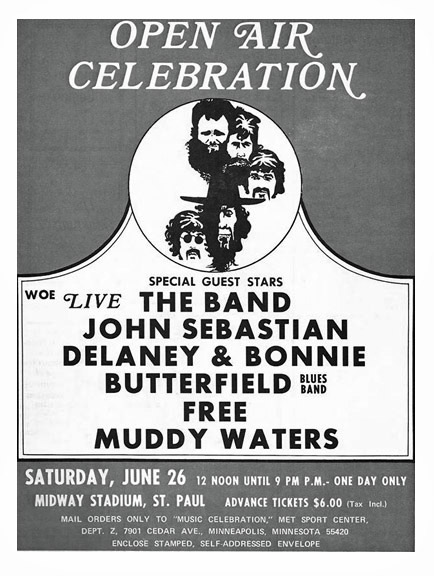
Ad from the Insider
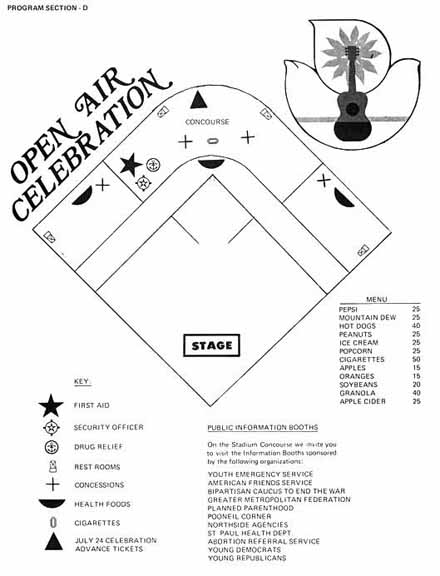
Map from the Insider
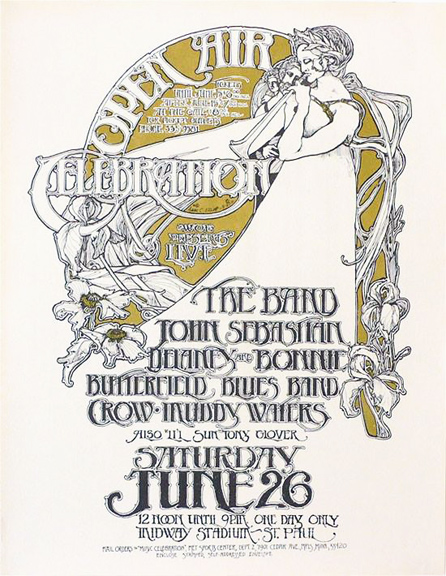
Poster by Anne C. Elliott
HOOPLA
People came from all around the five-state area to attend the show. About 50 people camped overnight on a grassy area in front of the stadium. When the gates opened at 9 am, about 1,500 people were waiting to get in; by noon the infield was at capacity with about 8,000 people on blankets. The final tally was 24,900 ticket holders, according to Beacom. The gross came to $150,000; Beacom said he needed $128,000 to break even. Acts were paid more than $70,000 (assume in total).
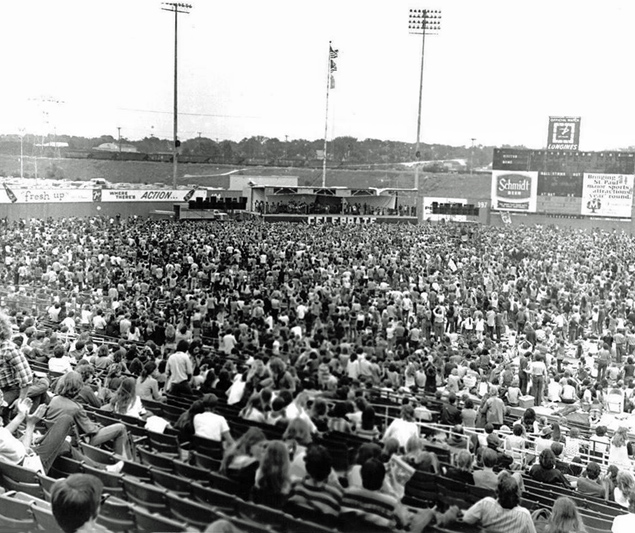
Crowd shot courtesy Larry Wiegand
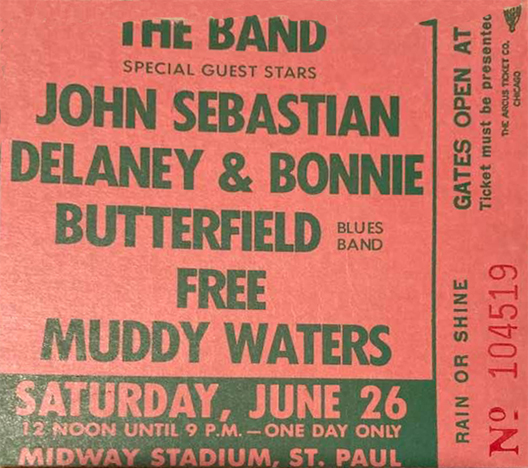
Ticket posted on Facebook by Marcia Edwards
GATE CRASHERS I
Beacom estimated that as many as 3,000 people may have enjoyed a day at the park without one of the special counterfeit-proof tickets.
But many people were seen climbed over the fence on ready-made poles and ladders and there was occasional storming of one large wooden door next to the bleachers. (On one occasion late in the afternoon two intrepid ushers at the door were swept aside by a group of nearly 50 – like King Kong vs. the islanders.)
THE SHOW
The stage had four areas; while one act performed, stage crews set up four Hammond organs, four pianos, and eight Leslie speakers attached to a Custom 24-channel speaker system. There were 24 microphones, but Beacom planned for 60 mikes for the next one: “The problem was that a harp player would see all those mikes and grab three for himself.”
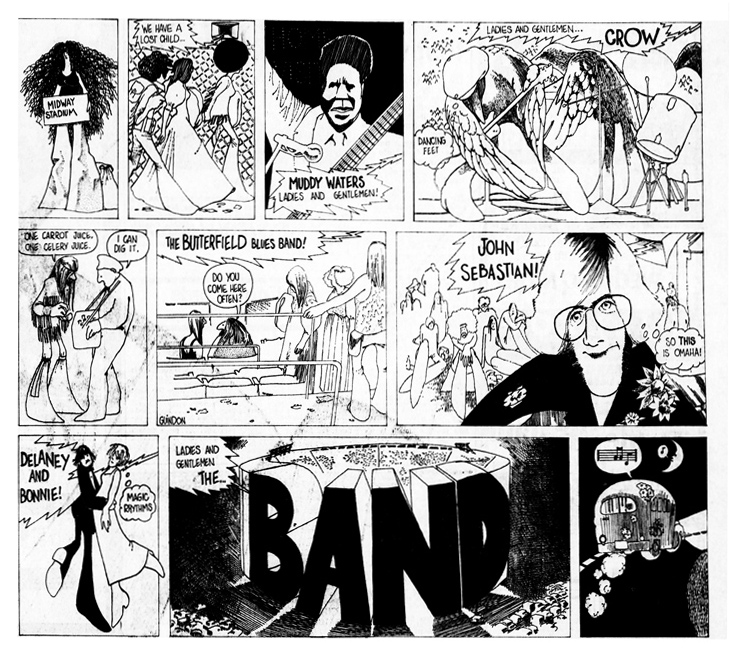
Minneapolis Tribune, June 13, 1971
CROW
How lucky to have photos from Larry Wiegand, bass player of our hometown heroes, Crow! Thank you, Larry!
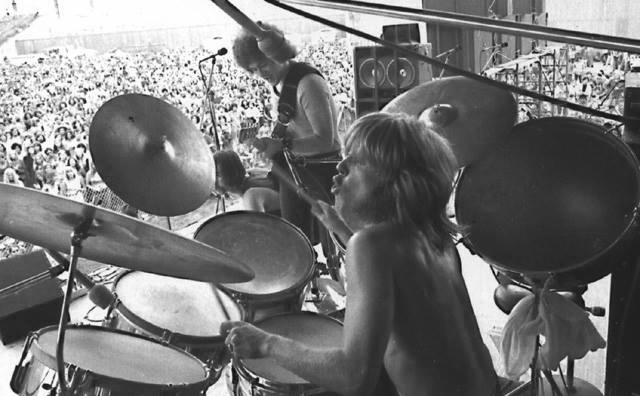
Larry Wiegand on bass and Denny Craswell on drums. Photo courtesy Larry Wiegand
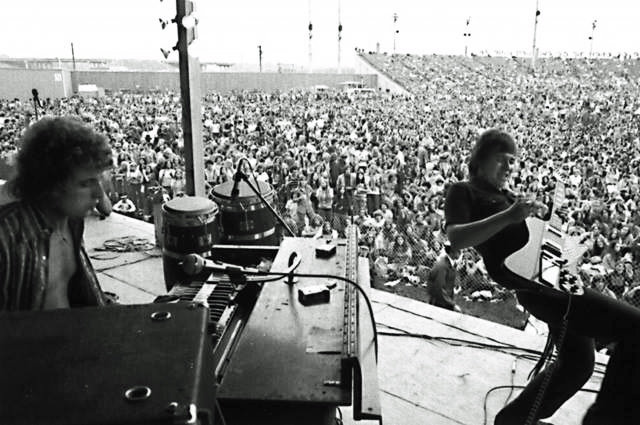
Crow photo courtesy Larry Wiegand
Below is a great shot of the stage. Larry: “Some of the folks on the right side of the picture are with The Band.”
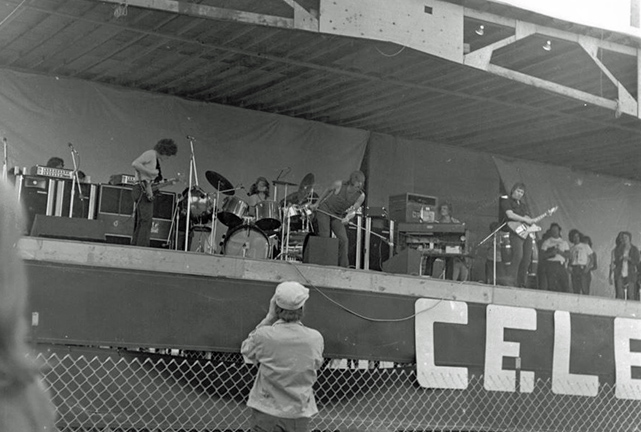
Photo courtesy Larry Wiegand
JOHN SEBASTIAN
John Sebastian was reportedly wearing the same tie-dye pants he wore at Woodstock.
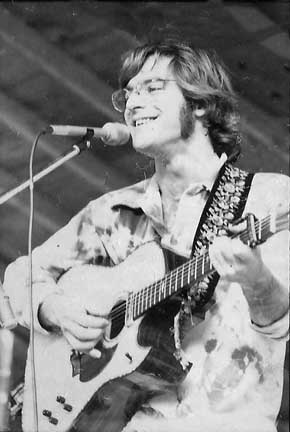
John Sebastian – Photo copyright Mike Barich, St. Paul
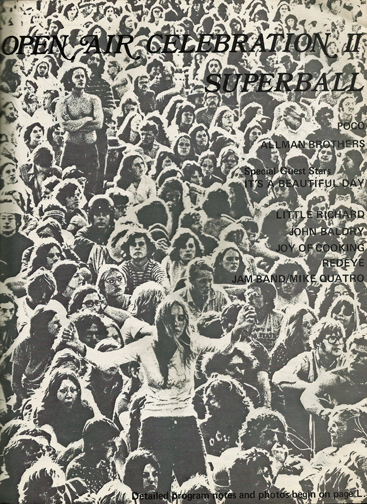
Crowd shot from Open Air I – Insider – courtesy Bill Graske
REVIEWS
Michael Anthony of the Minneapolis Tribune said of the crowd of 24,000: “Some people said it was the biggest attendance at a single musical event in Minnesota history.” (June 27, 1971)
Dodd Lamberton’s review in the Minneapolis Star (June 28, 1971) was glowing, saying the event was a “great success… Ample food facilities … an adequate medical staff, and excellent stage and sound system, agreeable weather, and an amiable and cooperative audience.”
Lamberton broke down each act:
- Crow rocked through most of their hits, but he found their new material “weak in comparison.”
- The Paul Butterfield Blues Band “only had moments that indicated they might still be on top of the heap,” although Butterfield himself was in fine form.
- Delaney and Bonnie were a disappointment. Their first two songs brought the crowd to its feet, but then they “drifted into aimless jamming.”
- He gave the best reviews to John Sebastian. “Pages could be written about his folksy and easy-going, yet totally effective performing style. Let it suffice to say that he got the warmest ovation by far (and deserved it).
- By the time the Band was ready to go on, people were getting tired and ready to go, “But the Band halted the exodus with ‘The Shape I’m In’ and continued with a set of rocking tunes that sent the crowd happily on its way.”
Faces, Deep Purple, and Southern Comfort: 1971
The Faces, Deep Purple, and Southern Comfort, Minneapolis Auditorium, July 11, 1971. This lineup of the Faces included Rod Stewart, Ronnie Lane on bass, and Ron Wood on guitar.
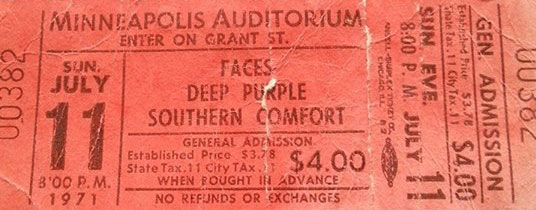
Courtesy Jim Fischer
Certs Breath Mints: 1971
Bob Burtis writes: “Back in the early ’70s, Twin Cities composer and musician Nate Bucklin won a contest when he wrote a jingle for Certs Breath Mints. His jingle was then professionally recorded at Micside studio and broadcast on KDWB and WDGY radio stations.” Here’s a print ad featuring the recording of the jingle:
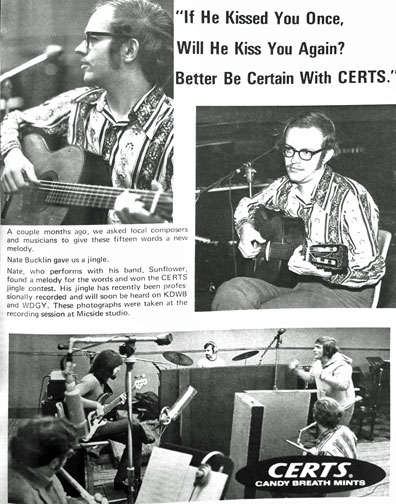
Open Air II: 1971
Open Air Celebration II was held on July 24, 1971, also at Midway Stadium.
It was one of three Open Air Celebrations, two of which actually happened.
The performers were:
- It’s a Beautiful Day
- The Allman Brothers
- Little Richard
- Richie Furay and Poco
- John Baldry
- Joy of Cooking
- Redeye
- Jam Band/Mike Quatro
The Insider also mentioned Lee Michaels, Rita Coolidge, Chuck Berry, the Grateful Dead, and New Riders of the Purple Sage but they didn’t come to pass.
The M.C. was Tony Glover.
As with Open Air I, the promoter was Harry Beacom. He wore his fishing hat throughout the day for luck. At the request of the St. Paul City Council, he installed an additional 42 portapotties.
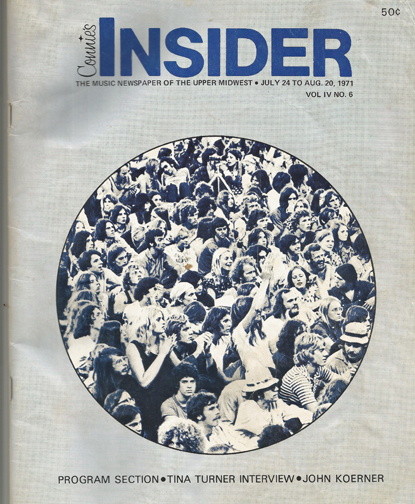
Connie’s Insider also served as a program
Sound was provided by Magnum Opus of Boulder, Colorado, who brought a 24-channel system “the only one of its kind” with 60 microphones and 12,000 watts worth of amplifiers.


An ad in the paper promised:
- Free Celebration souvenir editions of Connie’s Insider
- 100 ushers
- 24 parking lots
- Tao health food stand will make a large selection of organic health foods available.
- Footlongs and soft drinks
- 130 first aid volunteers
- One doctor
- 7 Internes
- Ambulance Service
- Complete First Aid Station
- Free posters at ticket outlets while supplies lasted
Booths were represented by:
- Y.E.S. (Youth Emergency Service)
- Pooneil Corner
- Abortion Referral Service
- Minnesota Conscientious Objectors
- American Friends Service
- Bipartisan Caucus to End the War
- S.O.U.L.
- Give and Take
- Vet’s House
- Birth Rite
- U.S. Public Health Dept.
A Jesus People group claimed they had converted 15 people during the day.
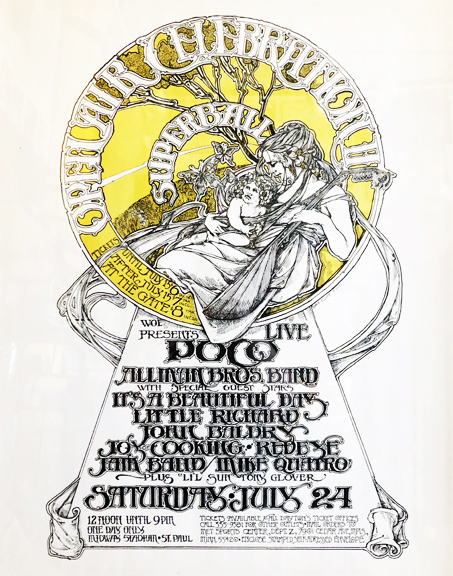
Poster by Anne C. Elliot from the collection of Mark Freiseis
In the poster below, the image is from Open Air I, showing John Sebastian hoisting his guitar.
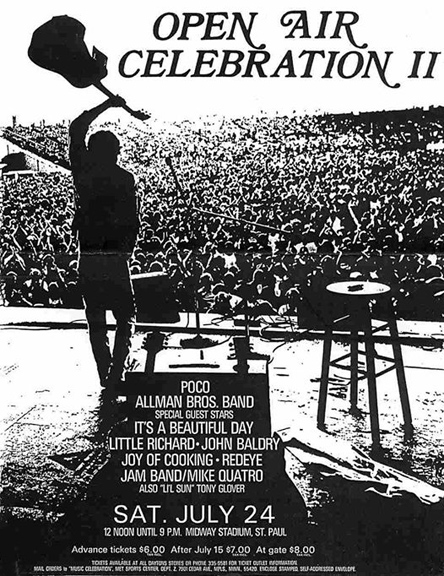
Posted on Facebook by Jim Cizinski
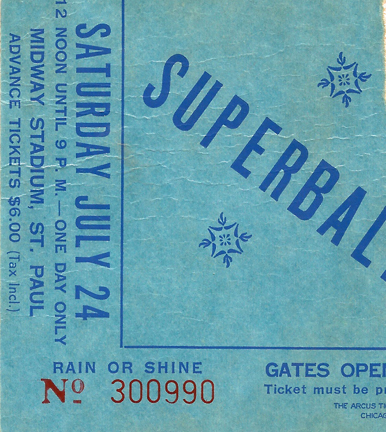
Ticket courtesy Bill Graske
BEFORE THE SHOW
About 500 people camped near the stadium the night before in order to get a place near the stage.
The event drew 25,000 people, about the same as Open Air I. Michael Anthony of the Minneapolis Tribune (July 25, 1971) said that people came as far away as San Francisco to attend the 10-hour event. They “rapped, cheered, ate, played cards, or just cruised around shoeless, shirtless, and braless.”
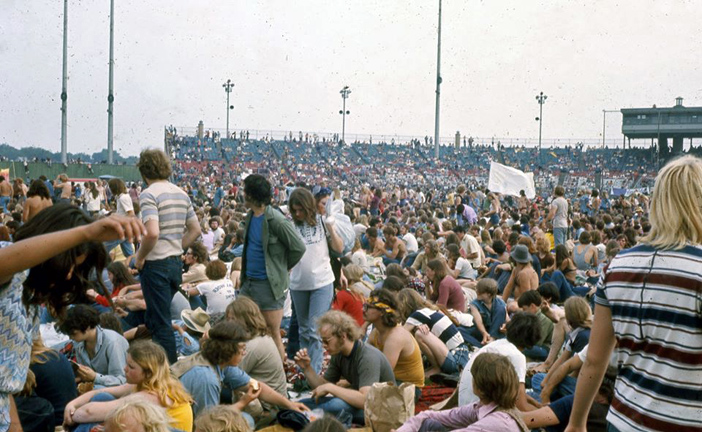
Crowd shot courtesy Mark Peterson
THE SUPERBALL
Johnny Hanson recalled the “Superball” part of the program:
As the first band hit the first chord, the Staff tossed giant inflated red balls into the crowd…big big rubber suckers, 8′ in diameter!…yow! They bounced around all day and I saw them actually knock some people down…scared the bee-jeezis out of the folks on LSD…
“Bowling For Hippies” scored a number of casualties that day…saw a ball come down on a hipster hauling six sodas back from the popstand…dropped him like a rock, like the “AppleBonkers” in The Beatles Yellow Submarine movie…yow!…
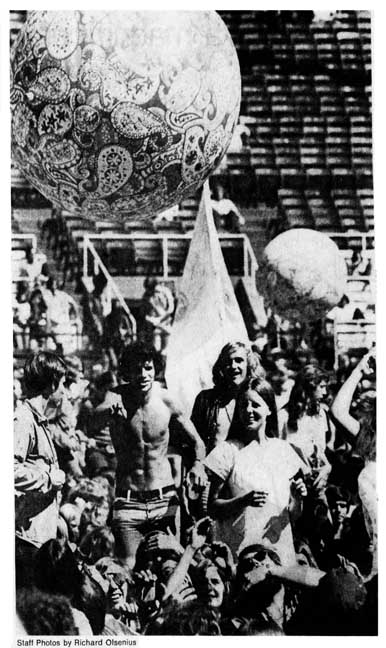
A paisley “Superball” – photo by Richard Olsenius, Minneapolis Tribune, July 25, 1971
THE SHOW
In the Minneapolis Star, (July 26, 1971) Marshall Fine reported that the delay between acts really was only 15 minutes, thanks to a well-trained stage crew. He found the crowd “enthusiastic and appreciative.”
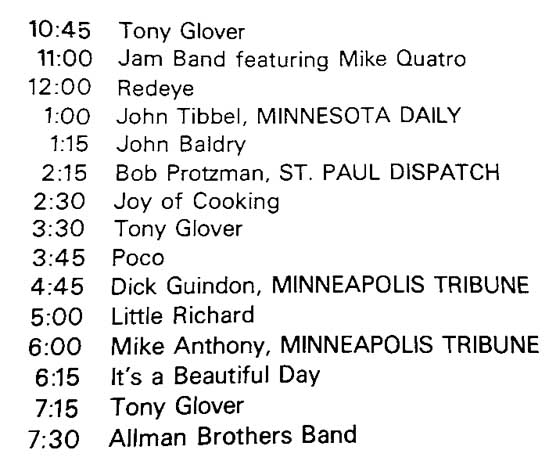
Schedule from the Insider – courtesy Patrick Gallagher
Fine reviewed each act:
The music started with Mike Quatro/Jamband, consisting of Quatro on a giant piano and a drummer. Not memorable.
Thanks to Robert Moore, who identified the photo below as Mike Quatro, and said, “The Jam Band open the show and ending their short set with ‘Court of the Crimson King.‘”
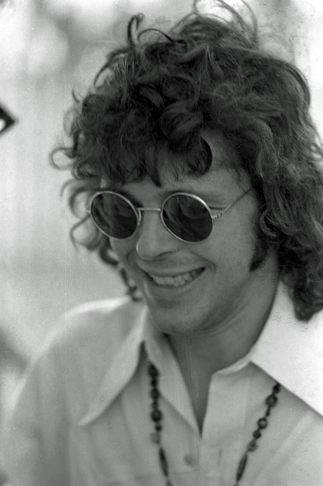
Photo of Mike Quatro copyright Mike Barich, St. Paul
Redeye had one Top-40 hit, but were only adequate due to their lack of originality.
Long John Baldry (he’s 6′ 7″)
started the Superball rolling with an hour of growly, bluesy material. Baldry showed himself to be an ingratiating showman with his little raps between songs and his whiplike use of his body during vocals.
Joy of Cooking “played some of the most cooking music I’ve heard in a while.” Vocals were by Terry Garthwaite (guitar) and Toni Brown (piano).
Poco
steamed on more than an hour early and drove the crowd with their hard-rocking, occasionally countrified sound. They got it on more than I’ve seen them do in their last two Twin Cities appearances.
LITTLE RICHARD
Marshall Fine:
Little Richard played for only 20 minutes. He played well enough, but without the usual flashing eyes and teeth, without enthusiasm. He looked like he was in pain (he has reccently been treated for stomach trouble.)
Michael Anthony:
One of the high points was a semistrip by Little Richard. Dressed in bright red white and blue with accompanying baubles and beads, Richard came on stage to thunderous applause, performed a most sedate bow and sat down at the piano.
“I’m the beautiful Little Richard from down in Macon, Georgia. I’m still young and I still look good. Shut up.”
During his set, Richard climbed atop the piano and demurely removed a shoe, shirt, and some jewelry, then finished the number.
Gary Schwartz:
At one point Little Richard got up on the piano, started to take his clothes off, and threw them into the audience. [His brother] Denny ended up with one of Little Richard’s white patent leather shoes!
Another concert-goer remembered Richard spent more time tossing jewelry into the crowd than playing music.
Tom Husting:
I worked on the stage crew that day and sat on the ground with Little Richard and his bass player and we ate an entire watermelon prior to his set. Now, you don’t do that every day. R.I.P. Richard. You have always been the King of Rock and Roll.
Gary Olson:
My brother-in-law’s band “Bluebird “ played earlier that day. He met Little Richard back stage… His comment to me about the experience…Whoa! Then his band started wearing makeup!
Back to Marshall Fine:
It’s a Beautiful Day played for an hour and a half, giving a full an amazingly energetic performance.
THE ALLMAN BROTHERS
The setlist, according to one website, was:
| 1. | Don’t Keep Me Wonderin’ |
| w/Tony Glover (harmonica) | |
| 2. | Done Somebody Wrong |
| w/Tony Glover (harmonica) | |
| 3. | One Way Out |
| 4. | In Memory of Elizabeth Reed |
| 5. | You Don’t Love Me |
| 6. | Whipping Post |
| 7. | Revival |
Mark Ryan captured some footage of the event on video and has graciously allowed us to see it!
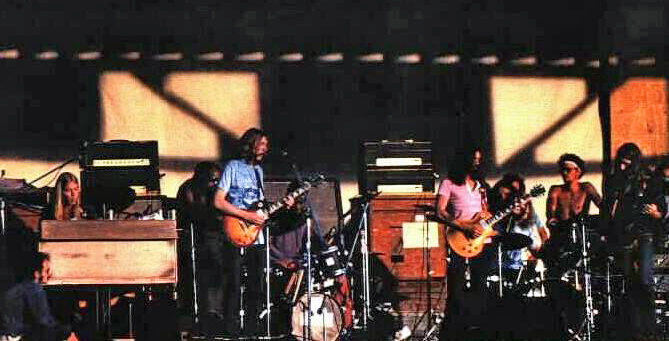
Photo of the Allman Brothers by Ridgeley Petersen. Bill Lydon: “Tony Glover sitting next to Gregg, staring at the wonder that is Duane.”
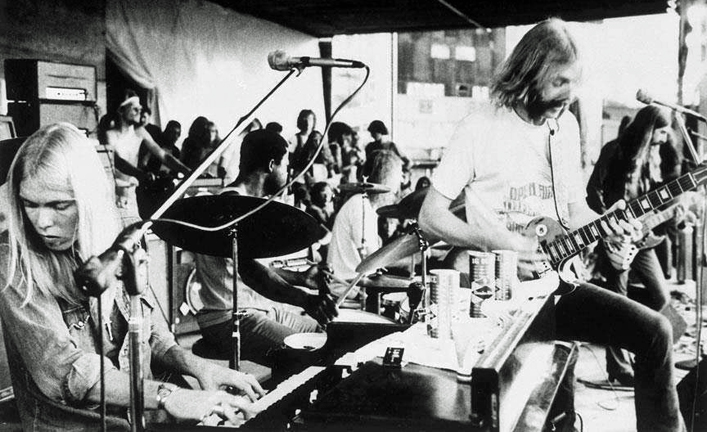
Photo courtesy Forrest George
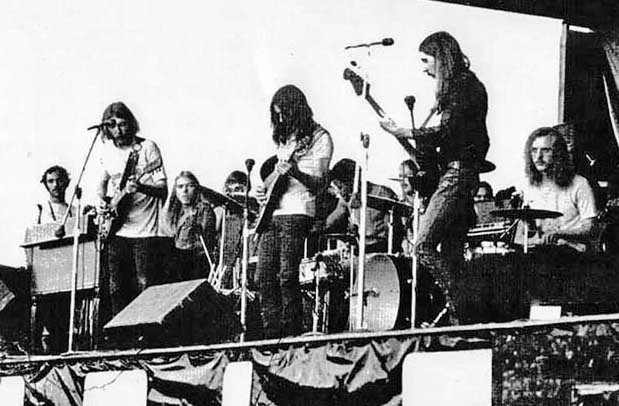
Photo courtesy Forrest George
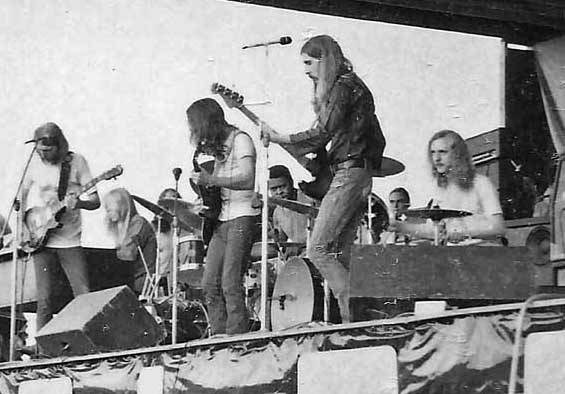
Photo copyright Mike Barich, St. Paul
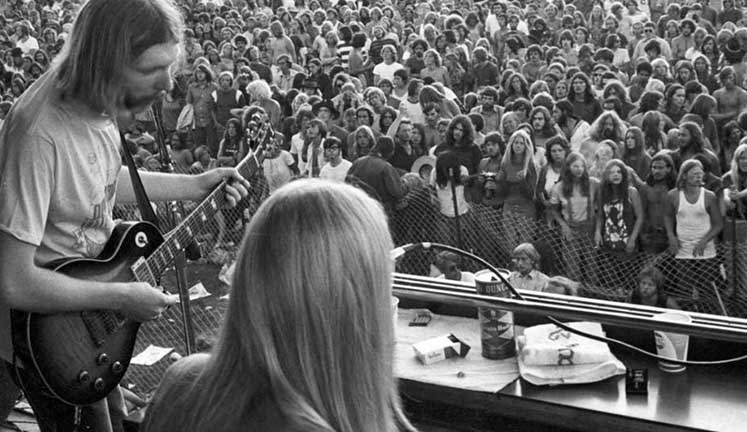
Photo courtesy John Lund
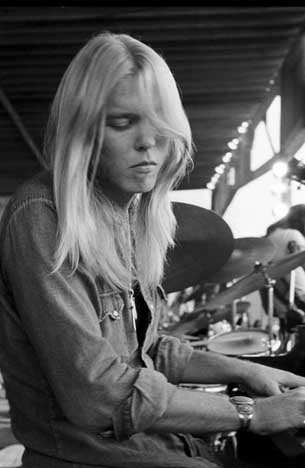
Photo courtesy John Lund
Marshall Fine:
The Allmans were absolute magicians Saturday night, picking up the crowd and lifting it to brilliant peaks with their smooth fluidity and invigorating electricity. Guitarists Duane Allman and Dicky Betts were untouchable.
GATE CRASHERS
Beacom took extra precautions to foil the gate crashers that had invade Open Air I. At the request of the St. Paul City Council, he installed three strands of barbed around the walls, reported Michael Anthony. Anthony also reported:
As extra insurance, a crew was out earlier in the week greasing the outside wall of the stadium with STP, Beacom said. A further precaution was the use of 60 police officers, 90 ushers, and a “special police squad” of 16 ex-football players and semi-professional wrestlers.
Below is a photo of the apprehension of an unfortunate gate crasher from the October 1971 edition of the Insider.
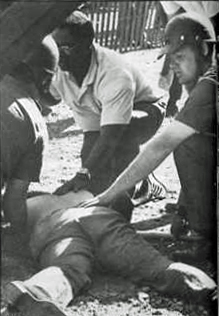
Photo copyright Mike Barich, St. Paul
Despite the precautions, Fine reported that “A nervous St. Paul police captain tried to halt the festival” because of the “ticket-less people outside.”
CASUALTIES
The ten nurses, ten medical students, and two doctors treated cut feet, burns, and about 150 bad trips according to a volunteer at Pharm House. Comments on Facebook start with how hot it was, the sunburn afterwards, and the Orange Barrel Acid … St. Paul Ramsey Hospital treated about 14 people, “mostly for bad trips and a few cuts,” according to an employee.
THE SCOREBOARD INCIDENT…
Many people remember a young man who fell from the scoreboard, and think it was funny that he landed in the Boone’s Farm booth. One participant remembers MC Tony Glover saying ” O.K. no more jumpin’ off the scoreboard.”
The truth was much more serious. According to witnesses, he had threatened to jump for about an hour. His “fall” was 30 feet down, and he was taken to St. Paul Ramsey Hospital in serious condition. A subsequent report revealed that the 21-year-old man from St. Paul suffered abdominal injuries and multiple arm and leg fractures.
The young man’s injuries no doubt had much to do with the decision of St. Paul, and then Bloomington, to deny Beacom a permit to hold Open Air III.
Leon Russell: 1971
Leon Russell, July 30, 1971, Minneapolis Auditorium.
Paul Strickland recalls that “the great Freddie King was the opening act. He had just signed a deal with Shelter, also Leon’s label, and they were touring together.” Johnny Hanson called King’s a “blistering set.”
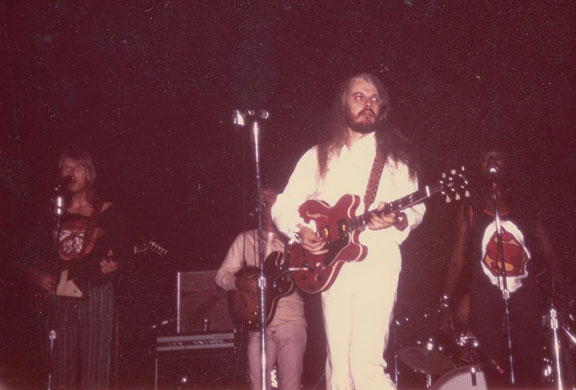
Courtesy Paul Strickland
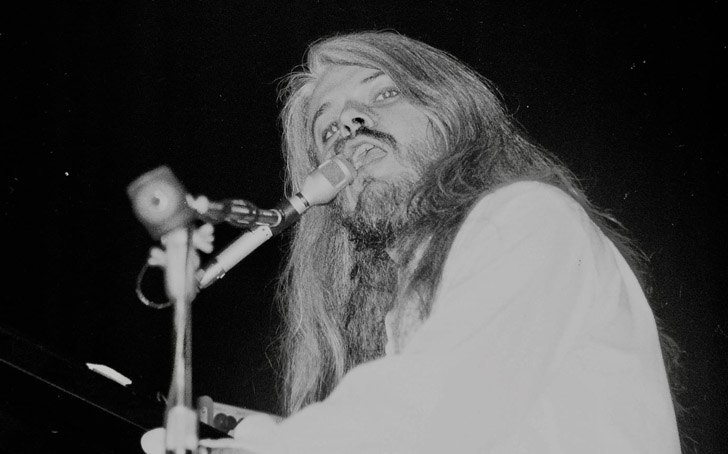
Photo by Denny Schwartz
Open Air III: 1971
Open Air Celebration III was scheduled for Midway Stadium on August 22, 1971.
Performers were to be:
Jefferson Airplane
Hot Tuna
Leo Kottke
Koerner and Glover were to emcee.
But the concert was cancelled – Midway Stadium, which had hosted Open Air I and Open Air II, refused to take a chance on another one, and when the promoters tried to get it into the Met Center, the Insider reported that “the Mayor encouraged the Bloomington City Council to apply pressure to cancel” and the “Bloomington Police voted among themselves not to work.”
The two previous shows at Midway Stadium were marred by gate crashers, and someone jumped off a high pole at the second concert. The three promoters, Timothy D. Kehr, Harry Beacom, and Walter Bush, had all their money tied up in the third concert and lost “tons of money.” The Insider reported that the disaster lost Harry Beacom $70,000 and sent him into self-imposed exile.
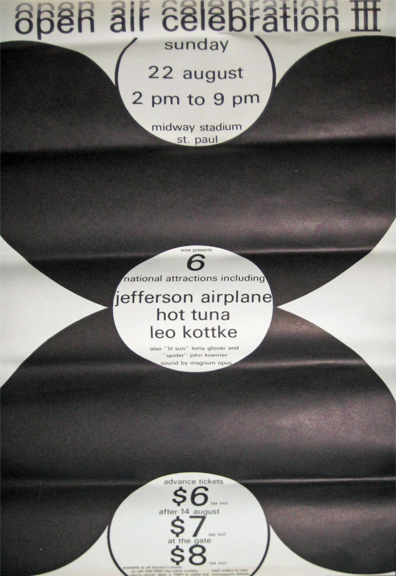
Official poster, courtesy Bill Graske
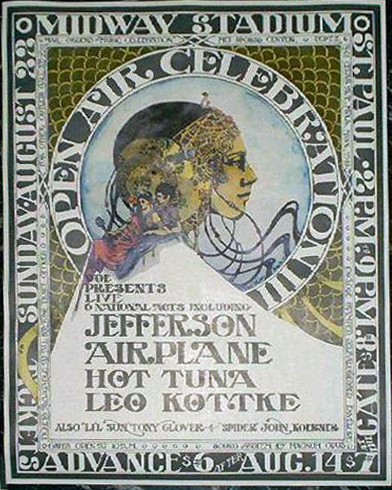
This may be a handbill?
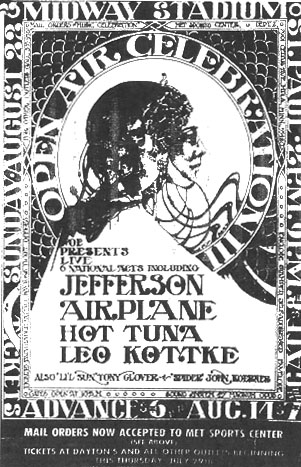
Newspaper ad, courtesy Jim Froehlich
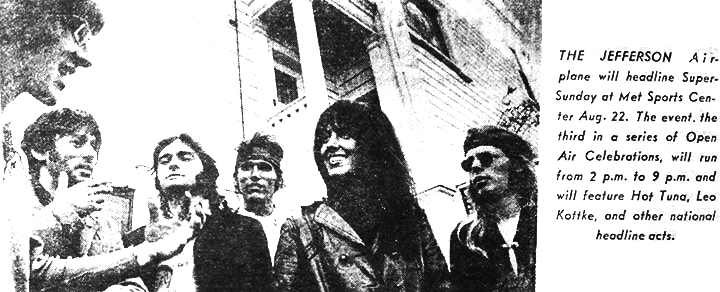
Another ad, courtesy Jim Froehlich
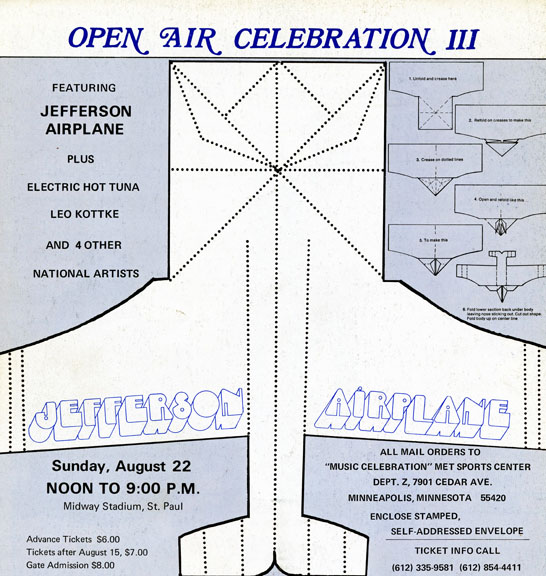
This ad appeared on the back cover of the Insider
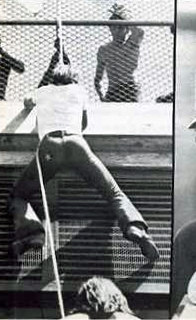
This photo of a gate crasher at Open Air II appeared in the Insider in the October 1971 issue of the Insider.
Elton John: 1971
Elton John played the Minneapolis Auditorium on August 31, 1971. Facebook fact: his sidemen included the former rhythm section of the Spencer Davis Group. Ad below from the Insider; photo courtesy David Tanner. That year, DJ Barry McKinna was the first person to play a song not on a record in the Twin Cities – a tape cartridge of Elton John’s “Crocodile Rock.” Also on the bill was Dan Hicks and His Hot Licks.
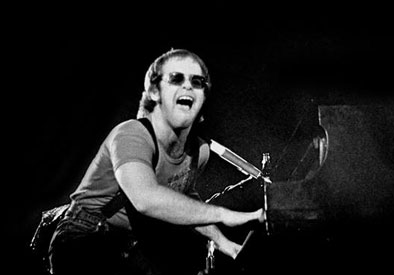
Photo courtesy Mike Barich
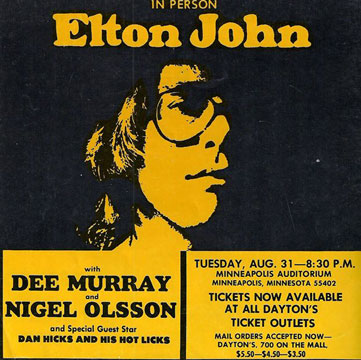
Doobie Brothers: 1971
Jeff Lonto offers this interesting item:
On September 7, 1971, the Doobie Brothers performed the first rock concert to air live on a Twin Cities radio station. But the concert was not heard on KQRS; it was heard on WWTC (1280 AM) of all places.
WWTC, then primarily a middle-of-the-road music station, broadcast the concert live from Sound 80 recording studio in south Minneapolis. The show lasted about an hour and fifteen minutes. Dick Driscoll (who had moved from KQ to WWTC in 1969) interviewed the band. Driscoll recalls asking them why they called themselves the “Doobie Brothers” when they weren’t brothers and none of them were named Doobie.
“They looked at me like I was some kind of square,” Driscoll recalls.
Performing the concert on a 5,000-watt AM station gave the Doobies much needed exposure while allowing minimal risk of pirates “Bootlegging” recordings of the show.
A Minneapolis Star article the following day pointed out that the show was unlikely to be bootlegged anyway “because the Doobie Brothers are not an extremely popular group.”
The Doobies would not have their first hit until the next year. The show consisted of an acoustic set and an electric set.
Blues and Folk Marathon: 1971
On September 21, 1971, there was a Blues and Folk Marathon held at Memorial Stadium at the U of M. Scheduled performers were:
- Leo Kottke
- John Lee Hooker (apparently did not appear)
- Fred McDowell
- Doc Watson and Son
- Charlie Musselwhite
- Harmonica George Smith
Allman Brothers: 1971
Allman Brothers, Minneapolis Auditorium, September 30, 1971.
David Tanner recalls that it was a snowy night and the opening band didn’t show. He took these great photos – thanks, David!
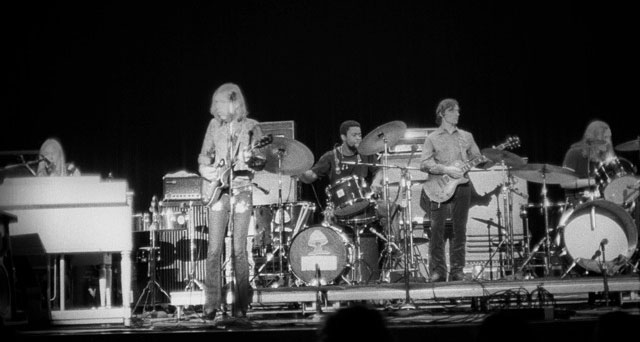
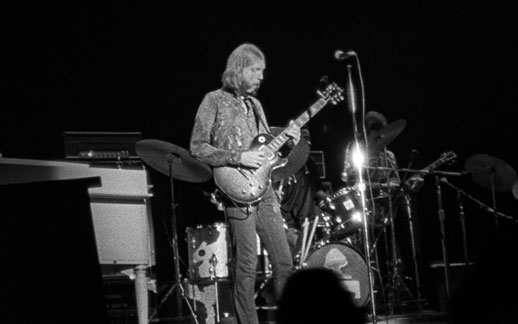
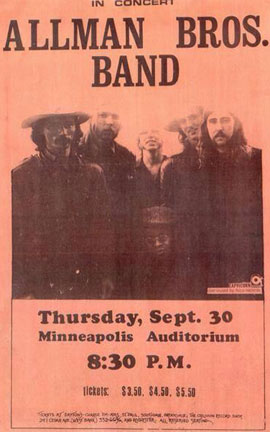
Moody Blues: 1971
Moody Blues, Minneapolis Auditorium, October 9, 1971. The first show sold out so they added a second midnight show. Dwight L. provides the set list:
Gypsy
Tuesday Afternoon
Tortoise and the Hare
Our Guessing Game
Melancholy Man
After You Came
One More Time To Live
The Story In Your Eyes
Are You Sitting Comfortably?
The Dream
Have You Heard (Part 1)
The Voyage
Have You Heard (Part 2)
Nights In White Satin
Legend of a Mind
Question
Ride My See-Saw
Events: 1972
PLEASE NOTE:
Although performances are noted here, all shows for the following venues are described in more detail on their venues pages:
- O’Shaughnessy Auditorium
- The Guthrie
Traffic appeared at the “St. Paul Civic Center (Formerly St. Paul Auditorium)” on January 18, 1972. Presented by Howard Stein.
Deep Purple, Buddy Miles and His Band, and Uriah Heep at the Met Center, January 21, 1972. Triangle Productions. The ad that Pepsi published had a hilarious (okay, mildly amusing) typo, calling the third act “Uriak & Heet.”
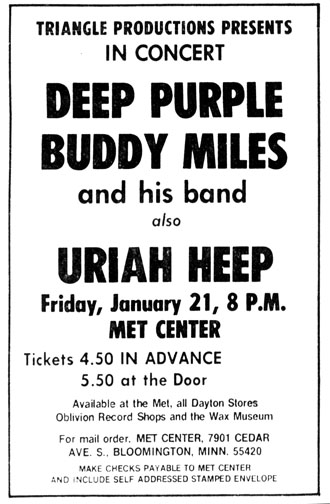
Minneapolis Tribune
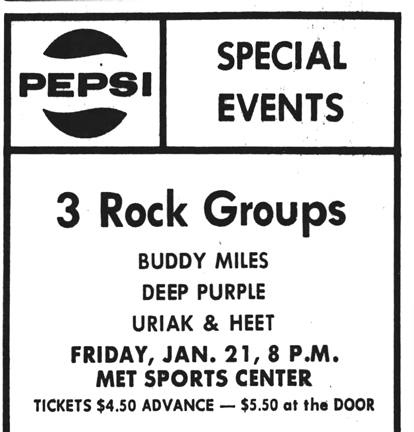
Minneapolis Star
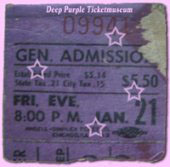
Image from the Deep Purple Ticket Museum
Marshall Fine’s review was headlined, “The bands battle, but for last place,” not a good omen.
Uriah Heep opened the show, which drew 11,000 fans. He put Heep in the “downer rock” genre that Grand Funk Railroad created. The group’s appeal escaped him, but their listeners, “whose mean age was probably 16,” appeared to enjoy them.
Buddy Miles came next, and he was “his fat, sassy self.” Fine called him a “barely competent drummer whose style consists of mostly flash and little savvy. He overpowers most of his songs with a blaring horn section and his pale voice. He butchered Neil Young’s mystical ‘Down by the River,’ losing all subtleties, favoring the cheap emotional twist of the voice and an overly apparent drum part.”
Deep Purple closed the show and Fine found them to be “simply boring.” In fact, Fine found the whole concert depressing because of the “music quality and the vibrations from the crowd.”
At one point, a policeman chased a youth down the aisle, presumably for crashing the gate. He collard the youth, handcuffed him, and led him away. To that youth, wherever he may be: It wasn’t worth the trouble.
On January 23, 1972, Gordon Lightfoot performed two sold-out shows at the O’Shaughnessy Auditorium.
Sly and the Family Stone at Met Sports Center, February 4, 1972
Weather Report, Orchestra Hall, February 18, 1972
Delaney and Bonnie, O’Shaughnessy Auditorium, February 22, 1972. Opened by Kevin Odegard and His Friends.
Alice Cooper, Edgar Winter, and Redbone appeared at the St. Paul Civic Center on February 27, 1972.
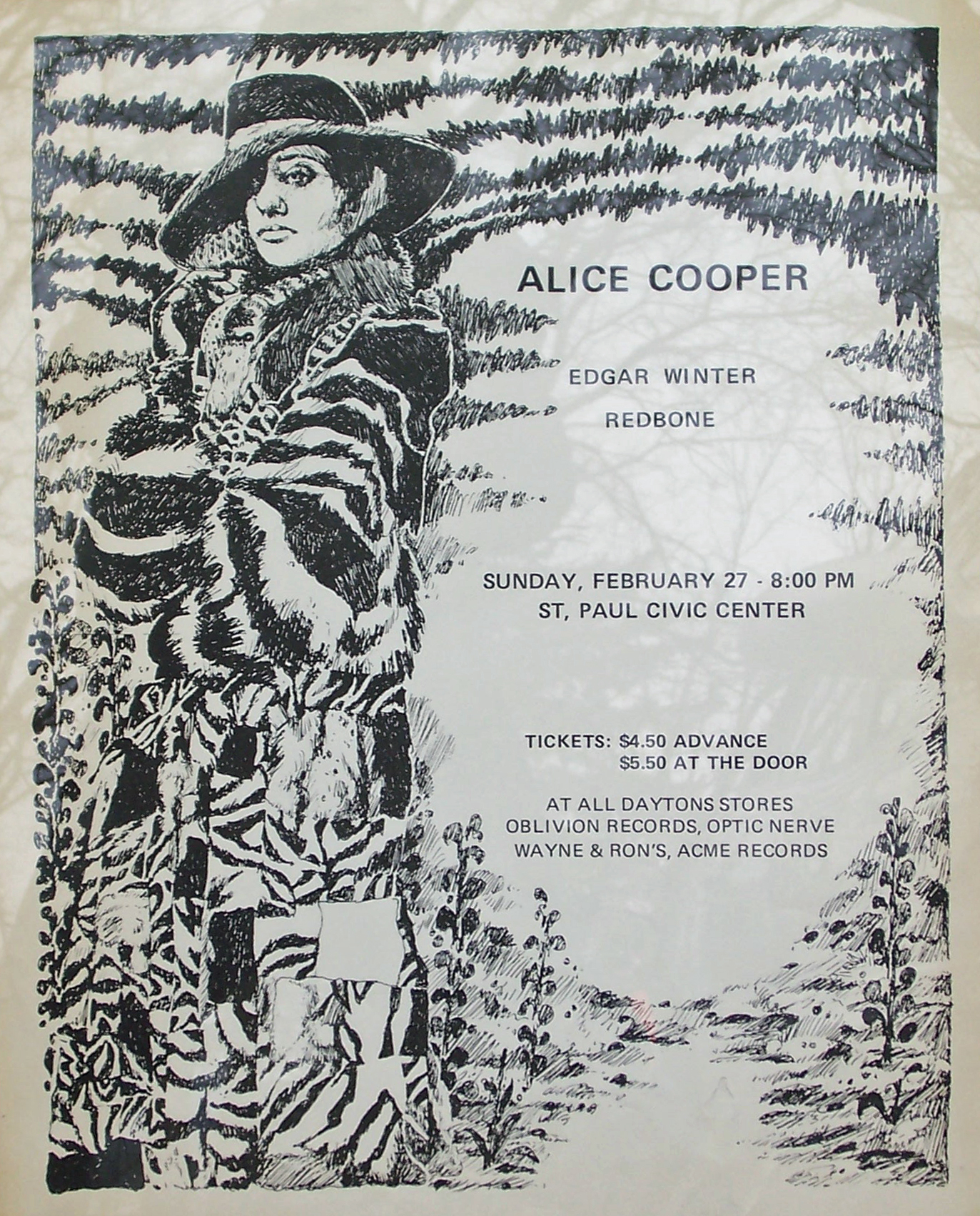
From the collection of Mark Freiseis
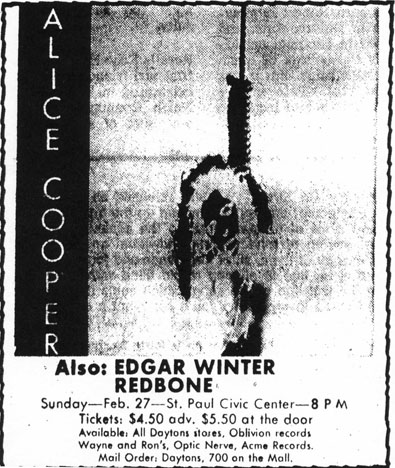
Minneapolis Tribune, February 27, 1972
Mahavishnu Orchestra with John McLaughlin at the Guthrie, February 27, 1972
Andy Williams and Henry Mancini at Met Sports Center, March 3, 1972
Rock ‘n’ Roll Revival, March 4, 1972
Richard Harris, Minneapolis Auditorium, March 5, 1972
Emerson, Lake & Palmer appeared at the St. Paul Civic Center on March 16, 1972.
Savoy Brown, Fleetwood Mac, and Long John Baldry appeared at the St. Paul Auditorium on March 19, 1972.
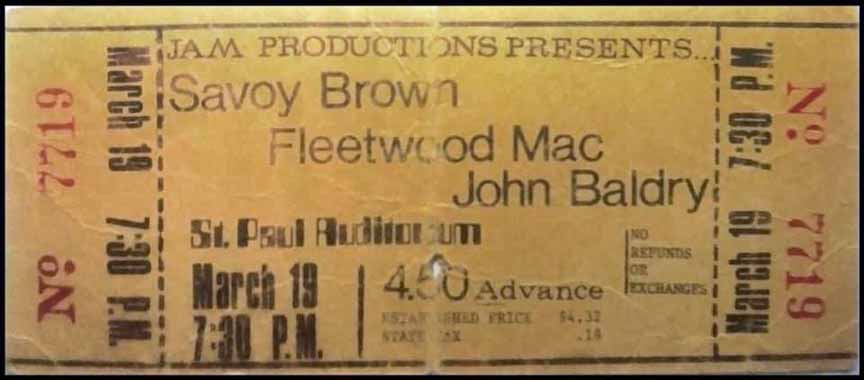
Savoy Brown ticket courtesy John Kuntz
Wayne Cochrane and the CC Riders, March 23, 1972
In April 1972 the Insider devoted pages to a discussion of racial discrimination in the music business, saying that black musicians were not being hired except at all-black or “head” clubs. This topic had also been addressed in its June 5 – 19, 1971 issue.
Linda Ronstadt appeared at the XL5 Club on April 3, 1972
Joe Cocker, Met Sports Center on April 3, 1972
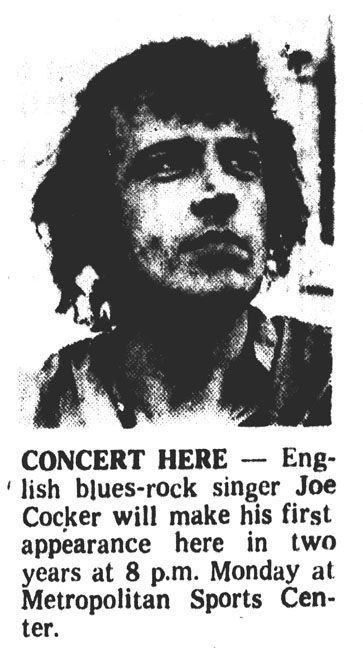
Minneapolis Star
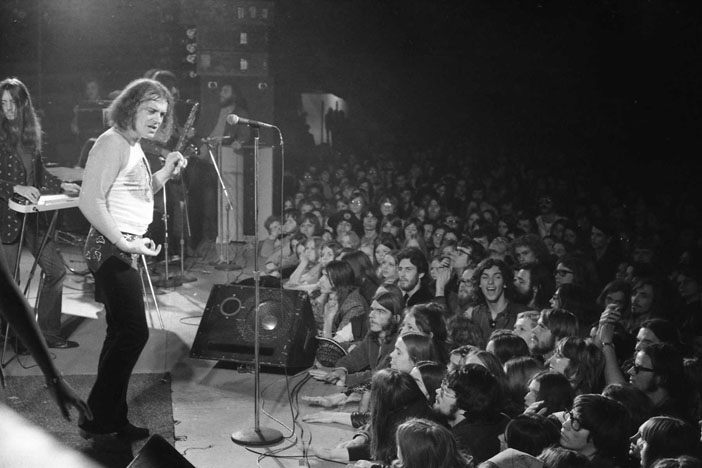
Photo copyright Mike Barich, St. Paul
Mason Proffit and Jackson Browne appeared at the St. Paul Civic Center on April 8, 1972
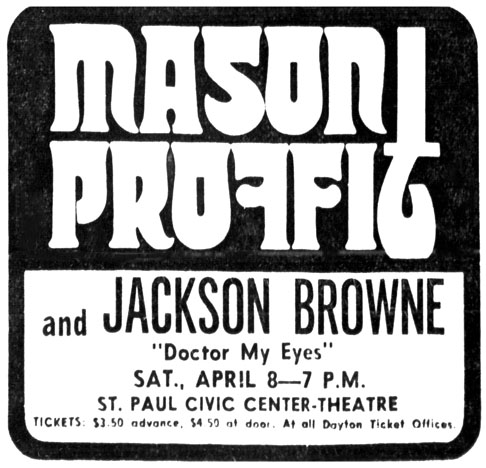
Minneapolis Tribune
Humble Pie, Alexis Korner, Free, Minneapolis Auditorium, April 13, 1972. Presented by Howard Stein.

Minneapolis Star
Chuck Berry and Bo Diddley were scheduled to appear at the St. Paul Civic Center, April 16, 1972.
Ten Years After, Wild Turkey, Procol Harum, Met Center, April 19, 1972. Presented by Howard Stein. See ad above under April 13. Tony sez, “If I remember right, they had the stage sideways in the middle of the hockey rink, turned 90 degrees from how it usually is…more of a “bowl” seating…never saw them use the stage like that again…”
The Minneapolis Auditorium began refusing to hold concerts by some hard rock groups like Alice Cooper and Jefferson Airplane after an incident at the St. Paul Civic Center, where windows were smashed after a Black Sabbath concert. This explains the first concert I found for the year, on April 21, 1972:
Rod McKuen played the Minneapolis Auditorium, to “what must have been the best-groomed straight-arrow audience ever at” the venue, according to Linda Hoeschler of the Star. She reported that his performance was much more varied than the show presented two years ago, but “nevertheless soon settled into tedium.”
James Brown appeared at the Met Center on April 28, 1972.
Creedence Clearwater Revival performed at the Met Center on May 5, 1972. Freddie King and Tony Joe White opened. One memory of this show is that it ended early when someone threw a roll of toilet paper on the stage.
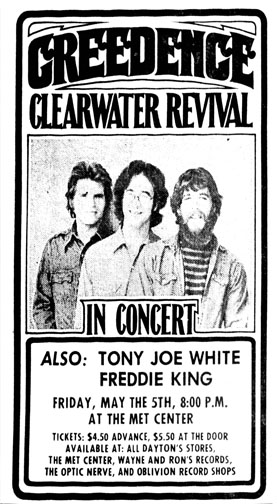
Minneapolis Tribune
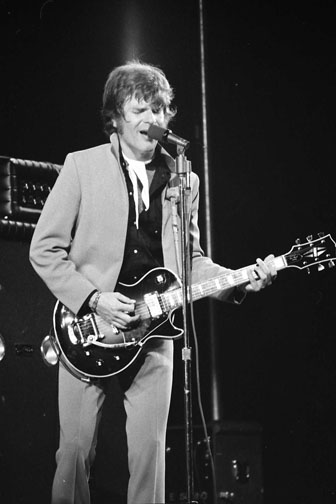
John Fogarty at the Met. Photo copyright Mike Barich, St. Paul
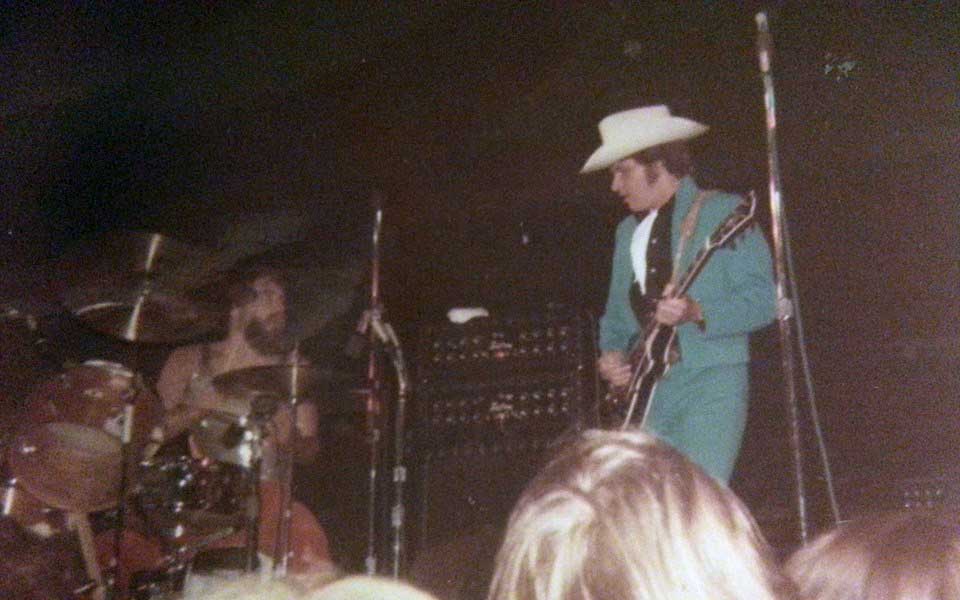
Jon Kyllo posted this great photo on Facebook.
It’s a Beautiful Day at the Guthrie, May 7, 1972
Manfredo Fest performed at the Fox and Hounds on May 11, 1972
JEFF BECK
The Jeff Beck Group’s show at the Minneapolis Armory, scheduled for May 14, 1972, was cancelled, possibly for unrest on the U of M campus. Tranquility was to be the opening band. It was a Howard Stein Production. John Richardson reports that he got his money back, but was bummed because Tranquility broke up after their equipment was stolen.
On July 24, 1972, the Jeff Beck Group was officially disbanded and Beck’s management put out this statement:
The fusion of musical styles of the various members has been successful, within the terms of individual musicians, but they didn’t feel it had led to the creation of a new musical style with the strength they had originally sought.
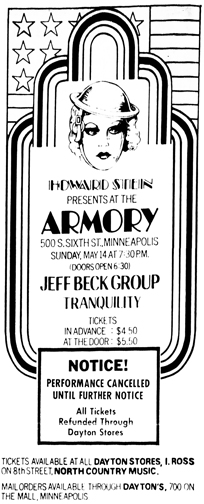
Minneapolis Tribune, May 14, 1972
Beck-[Tim] Bogart-[Carmine] Appice, the newest reincarnation of the Jeff Beck Group, appeared at the Minneapolis Armory on April 5, 1973.
Elton John performed at the Minneapolis Auditorium on May 16, 1972
The Snoose Boulevard Festival was held in the Cedar-Riverside neighborhood from 1972 through 1977. Click on the link for much more about this interesting part of Minneapolis musical history.
Todd Rundgren made his Twin Cities debut at the Guthrie on June 4, 1972, with Hello People opening.
Jethro Tull performed at the Met Center on June 5, 1972, presented by Howard Stein. Thick as a Brick tour, tickets $7.95. Mary Hamel opened.
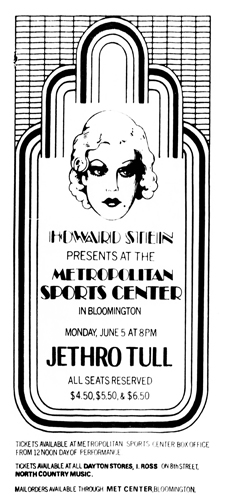
Minneapolis Tribune
Wikipedia says:
The album is notable for only including one song, which spans the entire album. Thick as a Brick was deliberately crafted in the style of a concept album (and as a “bombastic” and “over the top” parody). The original packaging, designed like a newspaper, claims the album to be a musical adaptation of an epic poem by a (fictional) 8-year-old boy, though the lyrics were actually written by the band’s frontman, Ian Anderson. The album was a commercial success and topped the US charts. Following the release of the album, the band set out on tour, playing the entire album with some extra additions that took the performance from 40 minutes to over an hour to perform. [Band member Martin] Barre recalls the first live performances being “a terrible experience” as there was a lot of complex music with a variety of time signature changes to remember. During the show, the entire band stopped in mid performance when a telephone rang on stage, which Anderson would answer, before carrying on with the music. [John] Evan read the news and weather reports halfway through the show.
Todd S. posted:
Thick as a Brick was ALL T.A.A.B., right down to a phone left on stage as the band left after its encores …. Then the phone rang and rang and rang, until Ian Anderson appeared, rushing to the front of the stage to lift the receiver… and as he answered, he listened, then looked out at the crowd and said ” It’s … for YOU!”
THE ROLLING STONES AT THE MET 1972
Rolling Stones performed at the Met Center on June 18, 1972. The concert was marred by gate crashers, counterfeit tickets, and teargas, and ultimately cut short, but the Stones were reportedly gentlemen. 17,500 attended. Tickets were $6. Stevie Wonder opened, using the synthesizer on songs that would make up the album “Innervisions.” Presented by Howard Stein and Sunday Promotions.
Jon Bream provided a mini-review of the show on November 23, 1997:
The double-disc “Exile on Main Street,” arguably the band’s finest album, had just been released, and the single “Tumbling Dice” was rolling up the charts. Opening act Stevie Wonder, perhaps at his creative peak, did a 10-minute drum solo in his first number that wasn’t appreciated by the 17,300 concertgoers. Jagger, in a purple jumpsuit with pink sash, rocked for 15 songs and 75 minutes. The lack of air conditioning was as annoying as the ineffective sound system. (Or was it the arena’s acoustics?) Most memorable was the tear gas that filtered into the building from police skirmishes with ticketless fans outside the arena. (three stars out of five stars)
Peg Meier and Mike Anthony of the Tribune filed a story on June 19, 1972:
Ticketless Stones fans, police clash
As 17,300 young people stomped and cheered the Rolling Stones Sunday night at the Metropolitan Sports Center, another 1,000 or so were chased away from the outside of the building by a few rounds of police-tossed tear gas.
Hundreds of ticketless youths tried to crash the gate to view what many people consider to be the most popular rock-music group today.
Others milled around the outside of the building – drinking, smoking and listening to the music pulsating through the walls. Most of them ignored pleas from authorities to disperse. there apparently were no serious injuries – just weeping eyes from the tear gas and cuts from flying bottles and rocks.
Police said there were only a few arrests, such as the two young men who were picked up trying to break into the Rolling Stones’ van.
It had been the most eagerly anticipated concert in recent Twin Cities history, the auditorium having been sold out in four hours on May 24. Ticket scalping began the same day, and continued until concert time, with some sellers asking as high as $65 for $6.50 tickets. …..
Police gave a number of warnings to the outside crowd at least an hour before the tear gas was used. Few left the area Some members of the crowd tossed beer bottles and firecrackers toward the police, but most of the injured people were other youths who arrived late for the concert and were in the line of fire. ….
[Sports Center Manager Bob] Reid had about 300 security guards and ushers and policemen on duty last night, the greatest number in the history of the sports center. About 100 men are on duty on an average hockey night.
Only one star has outdrawn the Rolling Stones here. His name is Billy Graham and he attracted 20,000 people a few summers ago. ….
Head Rolling Stone Mick Jagger, eyes surrounded by sparkles and wearing a purple jumpsuit, was, as usual, the star of the show, strutting, bumping, twisting, jerking and occasionally chugging a bottle of beer.
About half of the 75-minute set was oldies but goodies – “Gimme Shelter,” “In Love in Vain,” and “Midnight Rambler.” During the latter song Jagger flagellated the stage with a golden belt. The rest of the show came from “Exile on Main Street,” their new album: “Tumbling Dice,” “All Down the Line,” and others. The big finish was “Jumpin’ Jack Flash” and “Street Fighting Man,” a song that was banned on many radio stations before the political convention months of 1968.
Jagger flung rose petals from a basket as the Rolling Stones bowed off stage. They would return on June 9, 1975 at the St. Paul Civic Center Arena.
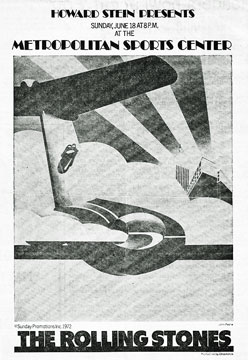
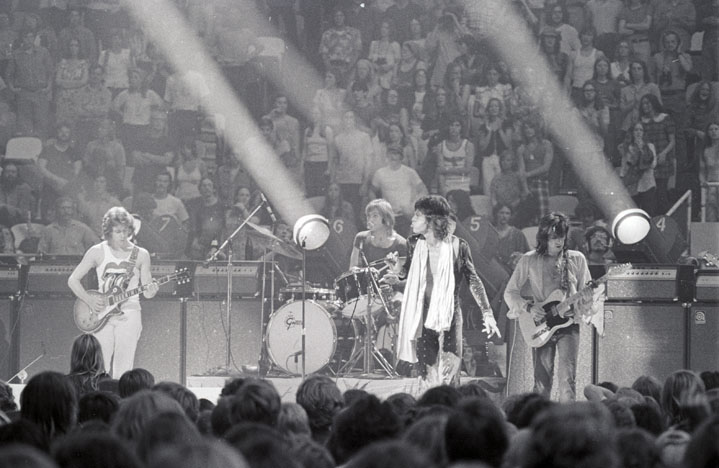
Photo of the Stones at the Met copyright Mike Barich
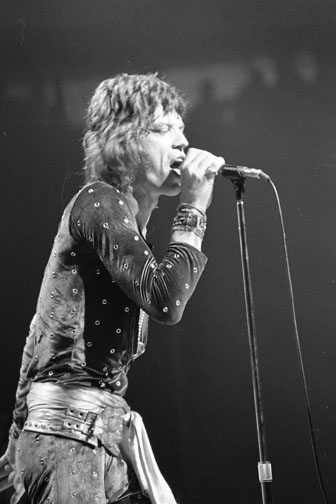
Photo of Mick Jagger at the Met copyright Mike Barich
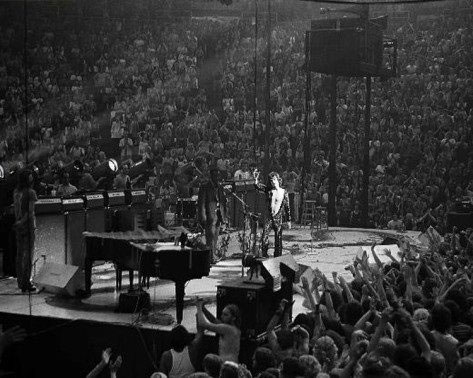
Source of photo unknown
Uncle Sam’s opened on July 6, 1972, after the building – the former Depot – had been closed for a year. Photographer Mike Barich went to take pictures but it was so crowded that he couldn’t shoot.
New Riders of the Purple Sage, Dr. Hook and the Medicine Show, and the Exciting All Girl Group Fanny performed at the Minneapolis Auditorium on July 10, 1972.
Three Dog Night, Buddy Miles, and Black Oak Arkansas appeared at the Met Center on July 15, 1972.
July 23, 1972, was the date of this musical extravaganza at the Minneapolis Auditorium, sponsored by the Minneapolis Musicians’ Association – who were they? This was quite a mixture of musical modes, with Rock! Rock! Rock! provided by Skogie and the Flaming Pachucos, Mr. Poster Maker. Thanks to the Facebook folks for helping to figure out the year of this huge event!
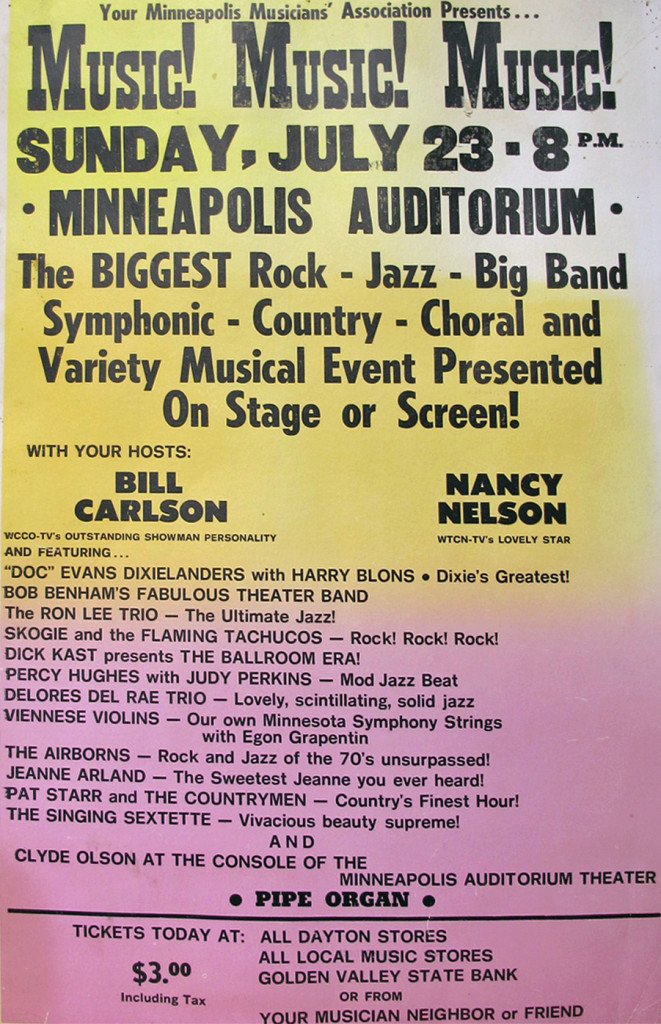
Alice Cooper played the Minneapolis Armory on July 27, 1972, presented by Howard Stein. Special guest star Wishbone Ash. Mark Stang also remembers a third act called Captain Beyond.

Minneapolis Tribune
B.J. Thomas was scheduled to perform at the Minneapolis Auditorium on July 28, 1972, but the show was cancelled because of illness. Presented by Sunshine Productions and the Minneapolis Aquatennial.
David Cassidy – At Last in Person! July 30, 1972 at the Minneapolis Auditorium. Presented by Sunshine Productions and the Minneapolis Aquatennial.
Mark Naftalin appeared at the Guthrie on July 30, 1972.
On a night in late July 1972, the Minneapolis Tribune reported that a group of 20-25 black youths went to at least three Minneapolis bars that were owned by blacks or had primarily black clientele. They demanded that the bars be closed by 8:00 pm, and one reportedly carried a high-powered rifle. Among the bars were the Peacock Alley and the Cozy Bar and Lounge. Only one apparently closed down for the night. The issue turned out to be that there was a meeting that they wanted people to go to.
TAKE OUT THE TRASH
Uriah Heep, Long John Baldry, and a group called Jerry LaCroix and White Trash were to appear at the Minneapolis Auditorium on August 3, 1972.
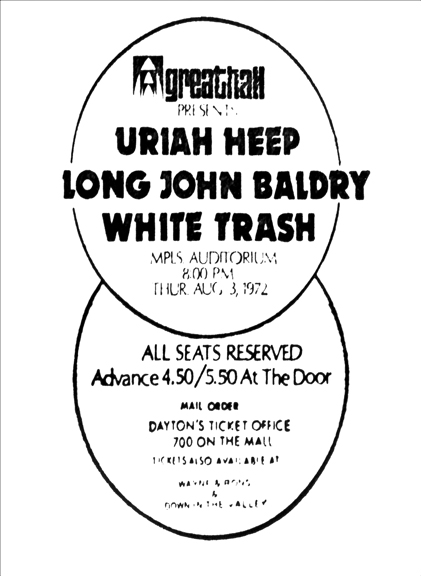
Minneapolis Tribune. This ad appeared on July 30, 1972.
Speculation is that White Trash did not appear because their drummer, Robert Ramirez, had died on August 3. I did a search for White Trash, and found shows in:
- Chicago on July 25 (where the fight was that eventually killed Ramirez)
- Detroit on July 27
- Indianapolis on August 1
- Allentown, PA on August 4 (failed to appear)
- New York City on August 5
The ad below, published in the Minneapolis Star the day below the show, only mentions Long John Baldry and Uriah Heep.
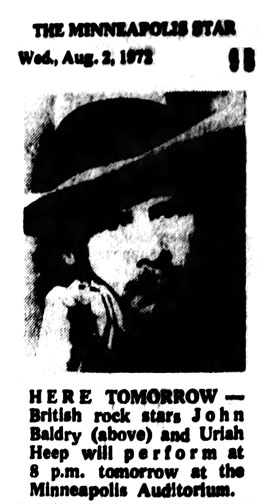
B.B. King entertained at the Minneapolis Auditorium on August 6, 1972. Presented by Grodnik/Sharpe.
Rick Springfield performed at the Radisson South on August 9, 1972.
Emerson, Lake, and Palmer appeared at the Minneapolis Armory on August 10, 1972, presented by Howard Stein. Blue Oyster Cult also on the bill?
Local group Batch, featuring our friend Arne Fogel, performed at Powderhorn Park in the summer of 1972. There is footage of this event taken by the incredible Michael Yonkers, available on YouTube. Arne sings “Domino.” Others in the band are Barry Thomas Goldberg, Gary Paulak, and Gary Lane.
The Osmonds, the Heywoods, and Jan Baker appeared at the Met Center on August 19, 1972.
Argent performed at the Guthrie on August 20, 1972
Bobby Goldsboro, August 30, 1972
Black Sabbath, Armory, September 5, 1972 (written in Mike Barich’s appointment book)
Leon Russell appeared at the St. Paul Civic Center on September 10, 1972. Nitzinger opened.
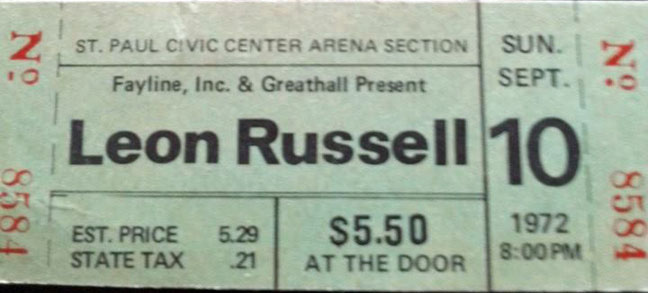
Image courtesy Jim Froehlich.
“Seasons at McGovern Rally,” September 11, 1972
The Allman Brothers Band and Eric Quincy Tate were scheduled to play the Minneapolis Armory on September 12, 1972, presented by Howard Stein and Owen Husney. The concert was postponed because the band had postponed its national tour. The concert was rescheduled for December 7, 1972. That concert was cancelled – see below.
Peter Yarrow did a solo at the O’Shaughnessy Auditorium on October 2, 1972.
Bonnie Raitt graced the Whole Coffeehouse at the U of M on October 6 and 7, 1972.
Grand Funk Railroad appeared with Black Oak Arkansas at the Met Center on October 13, 1972
Buffy Sainte-Marie appeared at Northrop Auditorium on October 22, 1972
Steel guitar player Curly Chalker performed at the Star Spangled Banner VFW Post 1149 in South Minneapolis (3018 – 17th Ave. So.) on October 22, 1972.
The Moody Blues appeared at the Met Center on October 29, 1972.
Bread performed at the Minneapolis Auditorium, November 10, 1972
Chicago appeared at the Met Center on November 18, 1972.
DEEP PURPLE AND FLEETWOOD MAC
Deep Purple and Fleetwood Mac Plus Dick Heckstall-Smith appeared at the Met Center on December 3, 1972. Triangle Productions.
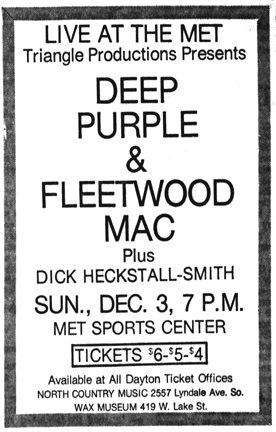
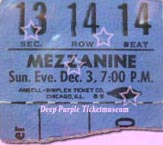
Image from the Deep Purple Ticket Museum
Judy Collins performed two shows at O’Shaughnessy Auditorium on December 6, 1972, presented by Fred Krohn.
The Allman Brothers were to appear at the Minneapolis Armory on December 7, 1972, rescheduled from September 12, 1972. The show was cancelled due to the death of the group’s bass guitarist, Berry Oakley, 24, who was killed in a bus-motorcycle accident in Macon, Georgia, on November 11, 1972. (Minneapolis Star, December 7, 1972)
Boz Scaggs and Dr. John appeared at the Guthrie on December 10, 1972
Leo Kottke appeared at the Guthrie on December 20, 1972
Sunshine Productions and Capitol Records presented Preview “73” featuring the Raspberries, Special Guest Stars from England Flash, and Introducing Bang. Minneapolis Armory, December 28, for the unbelievable low price of $3.
Bill Haley: 1972
Bill Haley appeared at f. david’s on February 13. Kudos to Jim Froehlich for finding this Pioneer Press ad!
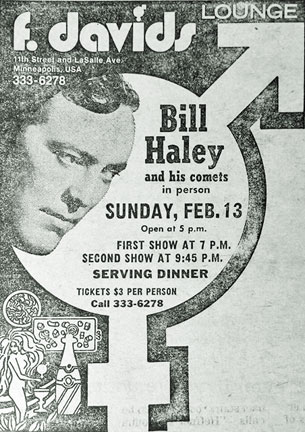
Black Sabbath: 1972
Black Sabbath appeared at the St. Paul Civic Center on March 21, 1972, presented by Howard Stein. The tour was to support the “Master of Reality” album. Apparently windows were smashed after the concert, making venue managers wary of booking hard rock acts. King Crimson (John Wetton era) was a possible opener. The band’s website also mentions Yes and/or Wild Turkey as opening acts.
Touring Personnel
- Ozzy Osbourne – Vocals
- Tony Iommi – Guitar
- Geezer Butler – Bass
- Bill Ward – Drums
Typical Set List
- N.I.B.
- War Pigs
- Sweet Leaf
- Black Sabbath
- Iron Man
- Embryo
- Children of the Grave
- Wicked World
- Guitar Solo
- Drum Solo
- Paranoid
- Fairies Wear Boots
Gypsy: 1972
Gypsy played a benefit concert on May 10, 1972, at Aldrich Arena, 1850 White Bear Ave. in Maplewood. Profits were to go to Anicom, a Minneapolis-based sound company whose technicians were involved in a serious truck accident several weeks before. Also performing were:
- Copperhead
- Pepper Fog
- Valdons
Save Big Money at Menard’s: 1972
The original Menards jingle that we all know and love was originally created in 1972. John Menard Jr. founded the company in 1960, and his friend Bob Holton wrote the lyrics over some stock banjo music. Holton was the station manager of radio stations WAXX/WAYY in Eau Claire. The jingle was recorded at Irish Saxe Studios in Appleton, Wisconsin (later known as Saxe Productions). The jingle was re-recorded in 1982 by Mitch Irish and Barbara Simon. Menard’s pitch man’s name was Ray Szmanda. Ray died on May 6, 2018.
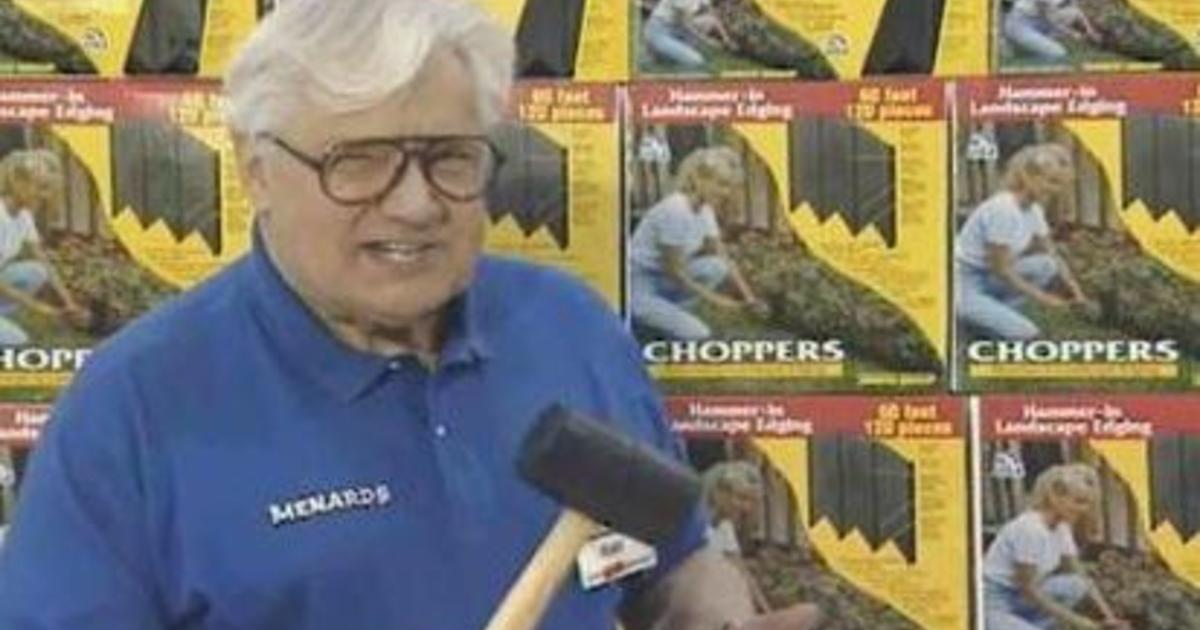
Black Sabbath’s Volume 4 Tour: 1972
Black Sabbath with Jo Jo Gunne and Gentle Giant were scheduled to perform at the Minneapolis Armory on August 28, 1972, presented by Howard Stein and Owen Husney. This was Black Sabbath’s “Volume 4” Tour:
Touring Personnel
- Ozzy Osbourne – Vocals
- Tony Iommi – Guitar
- Geezer Butler – Bass
- Bill Ward – Drums
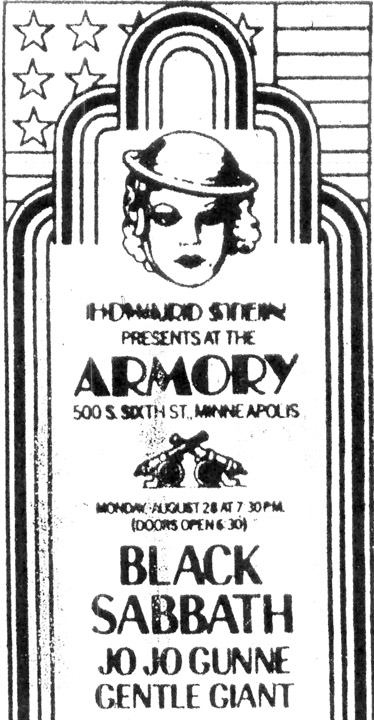
A Gentle Giant fan site says:
At one time, they had planned to open for Yes on the West Coast from Aug. 15 through Aug. 20, but it turned out their very first North American gigs were on a U.S. tour with Black Sabbath later in the month, an odd mismatch to be sure. They had shared a stage with this band on occasion before but, on this tour, the band did not always go over well with the Sabbath crowd, giving Giant some unpleasant early experiences in America. Out of necessity, they had to sometimes play in a heavier style and “rock out” more, in order to get through the gigs. Even though the band members do recall having audience trouble at times on this tour, Gary Green also remembers Giant being treated well by Sabbath’s lead singer, Ozzy Osbourne.
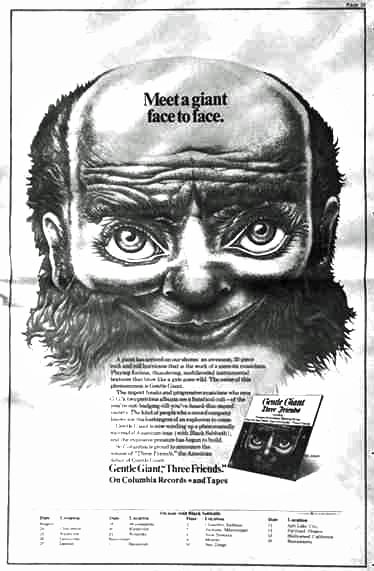
Gentle Giant ad, August-September 1972
The Minneapolis show was rescheduled to October 5, 1972, because Ozzy Osbourne had lost his voice. Still looking for documentation that the October 5 event took place. Gentle Giant was added to the already scheduled show on September 23 with Yes and the Eagles.
The Eagles, Yes, and Gentle Giant: 1972
Yes, the Eagles, and Gentle Giant at the Minneapolis Armory on September 23, 1972, presented by Howard Stein and Owen Husney. The Eagles were up first, Gentle Giant second. Or vice-versa. Seems to be no consensus.
Comments from Facebook:
“Yes come out of a space-ship-looking lit-up-pulsing pod-thing, where they returned to when they were finished…I also recall the drum set had wings and floated upward.”
“One of the great things about this concert was that there were no chairs on the main floor so I went and sat just about as close to the front as possible. It also cost only $3.50 as far as I can remember – perfect for a college kid’s budget.”
“The Eagles played an acoustic set of Chris Hilman songs. I had not heard of Gentle Giant and found them like elves playing enchanting music and dancing about. Then Yes appeared and the audience just melted into the floor. They changed my musical tastes forever. I saw them on the same tour in Dallas the following April. A good show but nothing like the group of us on the floor in Mpls. A small but passionate crowd.”
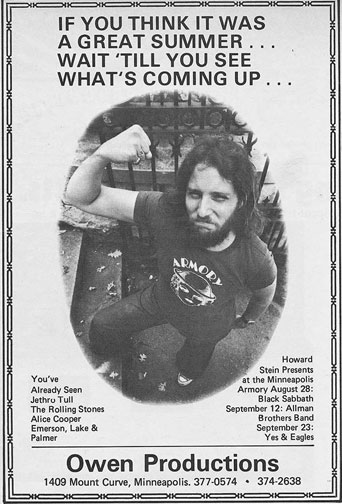
Courtesy Owen Husney!
Blues and Folk Marathon II: 1972
The Blues and Folk Marathon II was held on September 24, 1972, at Memorial Stadium at the U of M, presented by UPC Welcome Week. Performers included:
- Shawn Phillips
- The Albert King Revue
- Bonnie Koloc, from Chicago
- Casey Kelly
- Special Guest Stars Loggins and Messina
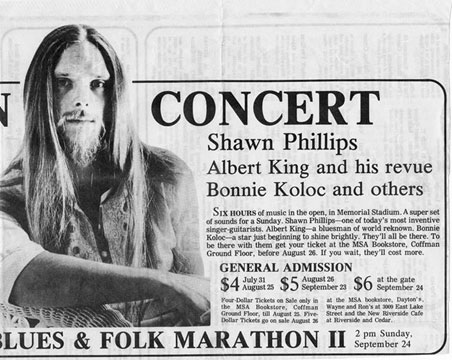
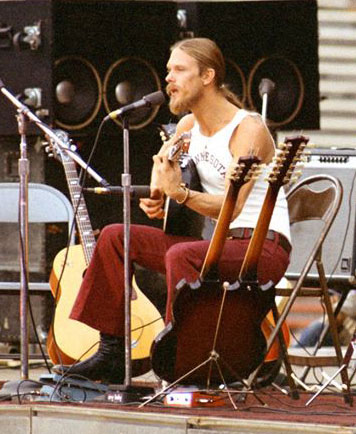
Photo courtesy Mike Evangelist
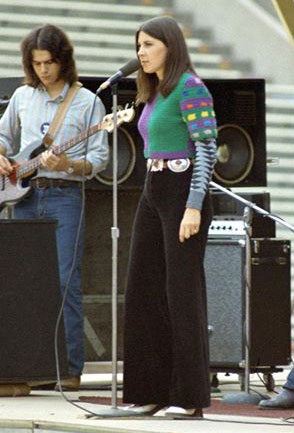
Photo courtesy Mike Evangelist
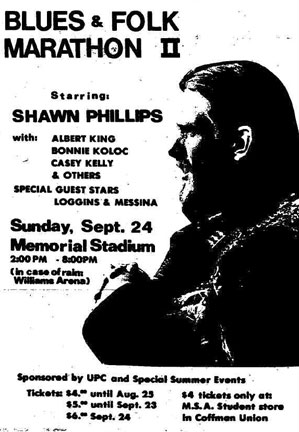
Ad courtesy Bill Tetzlaff

Pete Seeger: 1972
Pete Seeger appeared at Northrop Auditorium on October 1, 1972. Here is a touching story from Alan Freed:
During his visit he stayed at a neighbor’s house, a friend of his. Your trusty kid correspondent (me) could not wait to get an interview using his new Sears cassette recorder, an audio device that was yet to be a common item in the households of America. I recently found what I had thought was the forever lost cassette containing the conversation. He was amazingly patient, especially considering I showed up at the house practically minutes after he had arrived. Following some audio cleanup (the kid had some technical issues during the recording), the 10-minute interview has been uploaded at http://goo.gl/viDHxc
Here is Pete outside the Winters’ home on S. Cedar Lake Road during that visit, and the postcard he sent me a few months following my first celebrity interview.
RIP Pete Seeger.
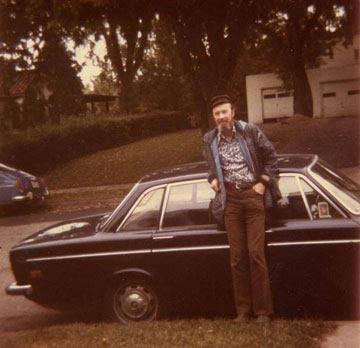
Photo © Amy Winters Galberth, Ellie Borkon
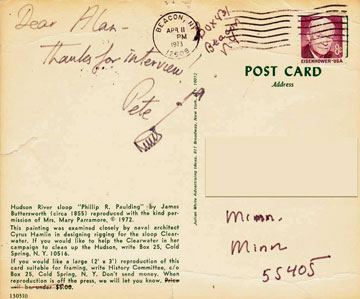
Postcard Alan Freed
Northtown Mall Opening: 1972
When the Northtown Mall opened in Blaine on October 12, 1972, Peggy Lee and Johnnie Whittaker (from the show Family Affair) were on hand to open the new Musicland store. So was Mike Evangelist, who took this great photo! The man in the middle is Robert Muir, owner and developer of the mall.
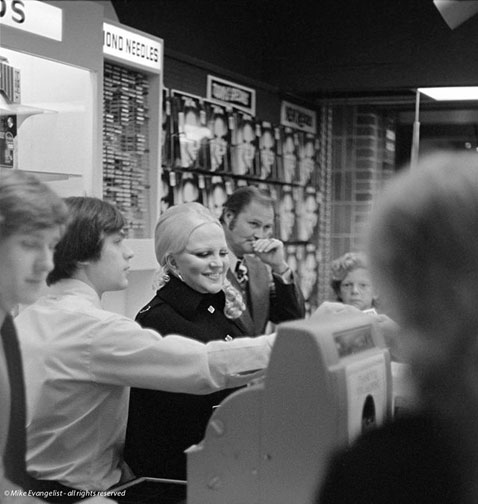
Stephen Stills and Manassas: 1972
Stephen Stills and his band Manassas (spelled wrong in the ad) and including Chris Hillman played the Minneapolis Auditorium on October 22, 1972. Ticket image below courtesy Jim Fischer.
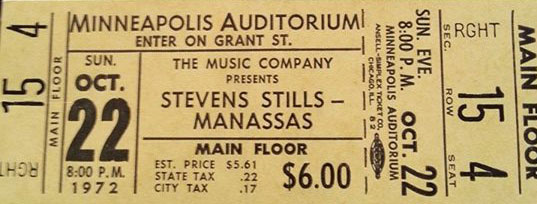
Beach Boys: 1972
The Beach Boys appeared at the Minneapolis Armory on November 8, 1972.
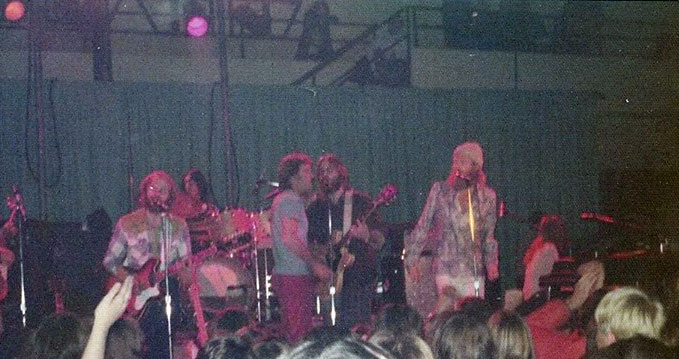
Photo by Steve Klemz: Al Jardine, Dennis Wilson, Carl Wilson and Mike Love.
John Mayall: 1972
John Mayall appeared with Delbert McClinton and Glen Clark at the Orpheum Theater on November 13, 1972.
Dan Rheaume says:
I was at that show! I had never heard of Delbert & Glen before. Delbert came out and grabbed a mic as Glen sat down at a Wurlitzer electric piano. Delbert said, “Hey! I’m Delbert and this is Glen and we’re going to have a really good time!” Then they proceeded to blow the roof offa da joint. Then John Mayall capped off the night with a full cover of Jazz/Blues Fusion!!!
Delbert McClinton had famously played the harmonica on Bruce Channel’s hit song “Hey Baby” in 1962.
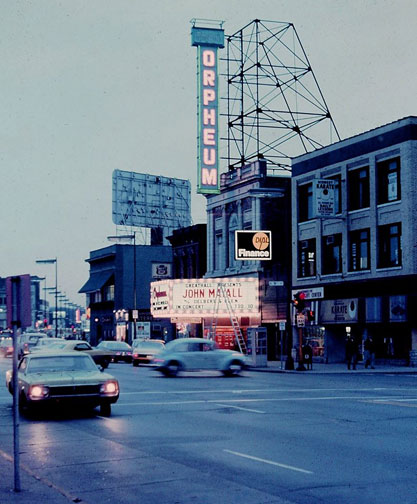
Photo courtesy Denny Schwartz
Rare Earth with Poco: 1972
Rare Earth with Special Guest Star Poco, November 25, 1972, at the Minneapolis Armory, a Greathall Production. According to a published review by B.W. Froelich, these two bands drew different audiences, and many people left after Poco opened the show. Poco did a lot of material from their album “A Good Feeling to Know,” but failed to do an encore. When Rare Earth appeared, someone yelled “Poco!”
Bob Pratt pointed out the photo below from the 1973 Echowan yearbook, taken by his father, news videographer Ken Pratt. Pictured is Paul Cotton – Bob even remembers that they were playing “Bad Weather” when this photo was taken.
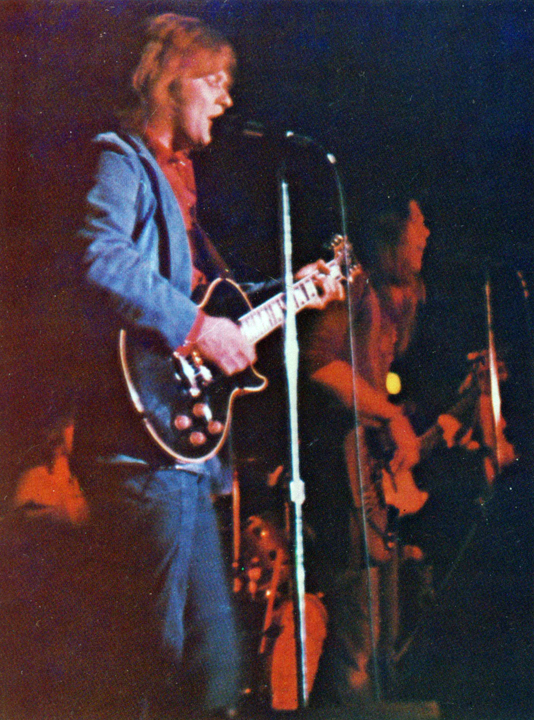
Poco’s Set List:
- Hoedown
- Restrain
- Bad Weather
- Keeper of the Fire
- A Good Feeling to Know
- C’mon
Events: 1973
PLEASE NOTE:
Although performances are noted here, all shows for the following venues are described in more detail on their venues pages:
- O’Shaughnessy Auditorium
- The Guthrie
Denny Craswell, veteran drummer of the Castaways, Crow, South 40, and sort of my cousin, premiered his famous solo “Ape Show” at the Coffeehouse Extempore. He apparently incorporated fire into his act at one point.
Neil Young with the Stray Gators, Time Fades Away Tour, January 7, 1973, Met Center
Sha Na Na, February 3, 1973, Met Center
Blood, Sweat and Tears appeared at the Orpheum Theater on February 9. KQRS broadcast the concert, recorded and encoded in four-channel sound. Hear an introduction to the concert on KQRS at www.radiotapes.com/KQRS.html
Gordon Lightfoot performed two sold-out shows at O’Shaughnessy Auditorium at the College of St. Catherine’s in St. Paul on February 11, 1973.
The Hollies performed at the Orpheum on February 12, 1973.
Edgar Winter was at the St. Paul Auditorium Theater on February 16, 1973.
Guess Who, February 16, 1973, Met Center
Loggins and Messina were at the Minneapolis Auditorium on February 17, 1973. Photographer Mike Barich was trampled, attacked, and badly bruised at the concert by a rowdy crowd, reports the Insider. Weren’t Loggins and Messina comparatively mellow?
The Grateful Dead appeared at the St. Paul Auditorium on February 17, 1973.
Blood, Sweat & Tears appeared at the Orpheum Theater on February 19, 1973.
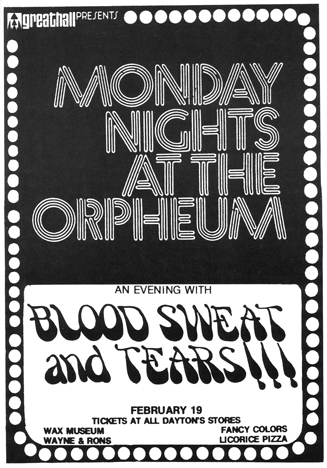
Connie’s Insider
Mason Proffit was scheduled to perform at St. Louis Park High for their Sno-Daze concert on February 28, 1973, but not enough tickets were sold to cover the band’s $3,000 fee so they were replaced with local performers not quite so well known.
Steel guitar player Curly Chalker performed at the Star Spangled Banner VFW Post 1149 in South Minneapolis (3018 – 17th Ave. So.) on March 18, 1973.
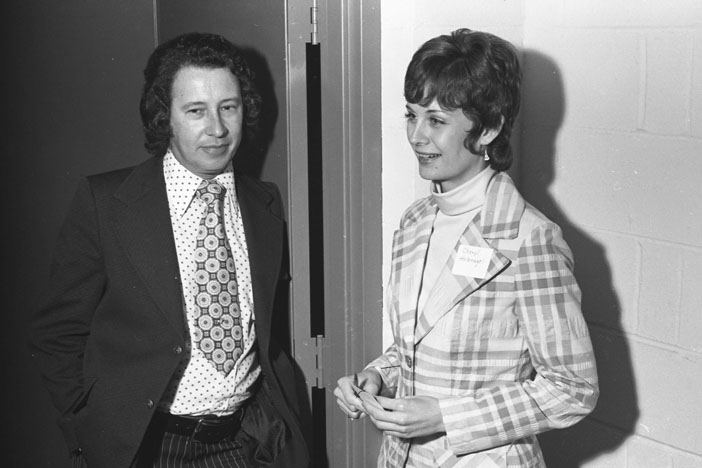
Curly Chalker photo copyright Mike Barich, St. Paul
Bobby Womack performed at the Met Center on March 19, 1973.
Santana, with Bobby Womack and Peace, March 19, 1973, Met Center. Attendance 13,356
The band was promoting their new LP Caravanserai, their fourth studio album, which was released on October 11, 1972.
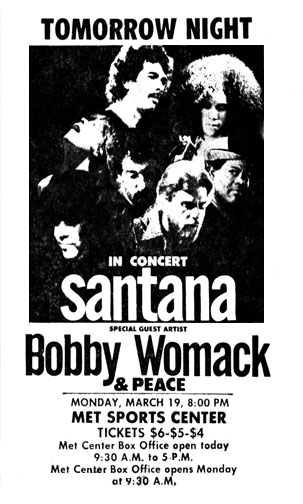
Minneapolis Tribune
Pat O’Brien remembers:
I was at this show. Before Santana came out, the road crew placed hundreds of long sticks of incense (joss) towards the front of the stage. You could smell the sweet scent of it everywhere, even in the large Met Sports Center. The lights dimmed and a single spot light was on Carlos. He was sporting very short hair and was dressed in all white. He asked for a moment of silence. After about 30 seconds someone yelled “What a transformation!” They continued with the silence, then the long sustain note which was such a signature Santana sound. If I remember correctly there were four or five drummer/percussionists. They played almost the entire Caravanserai album. Really a great show.
Charlie Rich appeared at Camelot on March 21, 1973.
John Denver performed at the Minneapolis Auditorium on March 23, 1973.
Bobby Womack performed at the Met Center on March 19, 1973.
Charlie Rich appeared at Camelot on March 21, 1973.
John Denver performed at the Minneapolis Auditorium on March 23, 1973.
March 31, 1973, gave you three good choices:
- John Hammond and Jerry Jeff Walker at the Whole Coffeehouse
- Leo Kottke and Michael Johnson at the Extemp
- Kris Kristofferson and Rita Coolidge at the O’Shaughnessy Auditorium.
BECK, BOGERT & APPICE
Beck, Bogert & Appice, the newest reincarnation of the Jeff Beck Group, appeared at the Minneapolis Armory on April 5, 1973. Also on the bill were Black Oak Arkansas and Wet Willie.
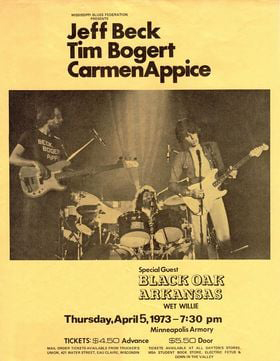
Poster courtesy Gary Narducci
Beck, Bogert & Appice was a rock supergroup and power trio formed by guitarist Jeff Beck and evolving from the Jeff Beck Group. It included bassist Tim Bogert and drummer Carmine Appice, who were both previously in Vanilla Fudge and Cactus.
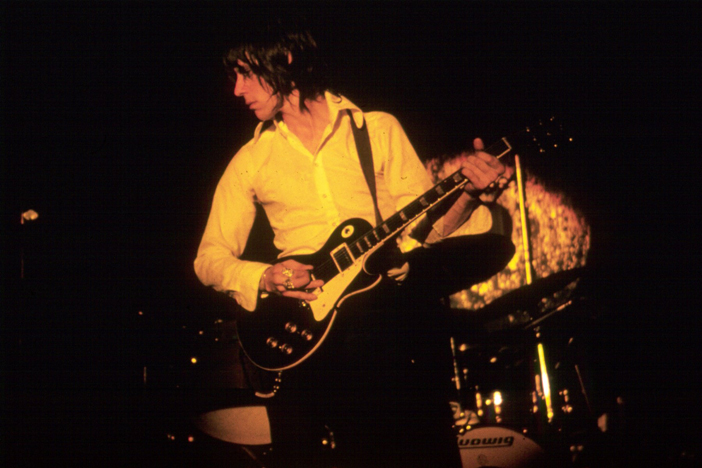
Photo of Jeff Beck taken by Rob “Cubby” Colby. Digitized and provided by Al Bjerke.
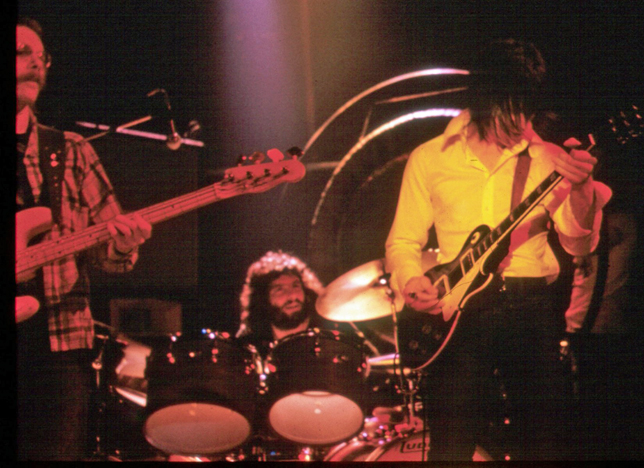
Bogert, Appice, and Beck. Photo taken by Rob “Cubby” Colby. Digitized and provided by Al Bjerke.
Marshall Fine, an experienced rock critic, found the whole thing just too loud, and 30 minutes into the Beck set he had to leave.
David on Facebook reported that “Bogert had no voice. He had spent the night before on the floor of a Chicago jail. He tried, but could not sing. Played great. This was still a great concert. Appice sang most of the songs.”
Folksinger Michael Johnson appeared at the “New West Bank Auditorium” on April 6. Also on the bill was Jerico Harp, which consisted of Jim Thomas and Tom Schmidt.
Wishbone Ash, Vinegar Joe, and Fanny performed at the St. Paul Civic Center Theater on April 11, 1973.
According to the Star‘s Tom Murtha, the show was “several hours of generic British boogie.” The house was about two-thirds full, with 80 percent of the audience male. Murtha had nothing nice to say about Vinegar Joe (which included Robert Palmer), and Wishbone Ash was all about posturing and decibels. He walked out after four songs.
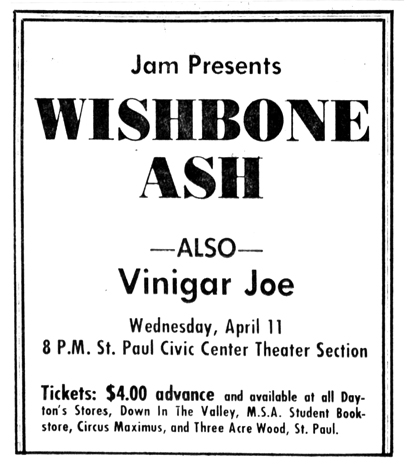
Minneapolis Tribune
It’s a Beautiful Day, with Sylvester and the Hot Band and Bloodrock, at the St. Paul Civic Center Theater, on April 16, 1973. It was a capacity 2,700 crowd at the 5 hour show. David LaFlamme had left It’s a Beautiful Day.
The Faces featuring Rod Stewart and Jo Jo Gunne appeared at the Minneapolis Auditorium on April 23, 1973, and the new St. Paul Civic Center Arena on April 24.
Minneapolis Tribune reviewer Michael Anthony reported that the sound was fuzzy and unbalanced and the ushers lost the battle to keep several hundred of the 4,000 in the audience from rushing the stage. “The set was generally too loose and [Rod] Stewart’s vocal energy low, though he seemed to be enjoying himself playing his role of the fey madcap (“Hyeh’s anothah numbah of great social significance…’) in painted lips, white gloves, silk pants, sequined vest and what one might call a very chintzy-looking necklace.” Ah, the Seventies.
Tom Murtha reviewed the show for the Star, and while he liked the Faces, “Second-act Jo Jo Gunne, on the other hand, amplified the worst aspects of rock in its decline as a pure form: pretentious, even prideful banality; melodic bankruptcy; third-rate showmanship, and empty technique. How any group can play so well and display so little imagination will always escape me.” Ouch.
The photos of the show below were posted on Facebook by Steve Klemz.
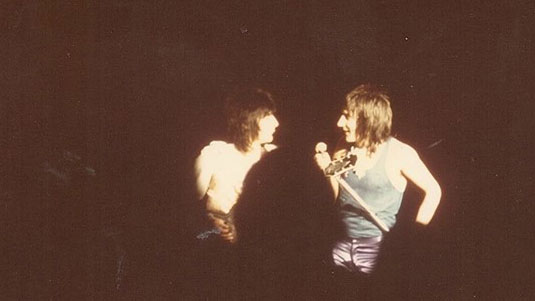
Ron Wood and Rod Stewart
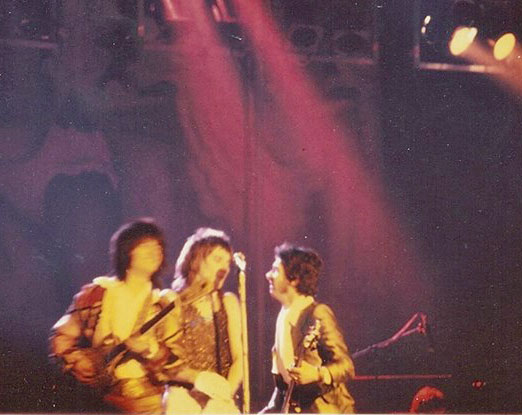
Wood, Stewart, and Ronnie Lane
Gram Parsons appeared at the Whole Coffeehouse April 27 and 28, 1973.
Ferrante and Teicher appeared at the St. Paul Civic Center on April 29, 1973.
Pepsi sponsored Ten Years After, Foghat, and the Strawbs at the Met Center on April 30, 1973. The show was presented by Howard Stein as “A British rock Spectacular.” On March 25, an ad first showed the third act as Spooky Tooth.
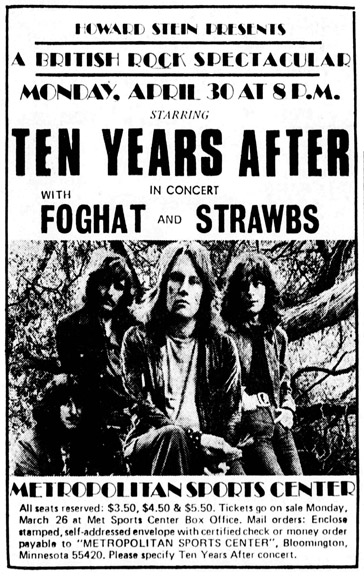
Minneapolis Tribune
Stevie Wonder appeared at the Minneapolis Auditorium on May 3, 1973.
Taj Mahal was at the St. Paul Civic Center Theater on May 12, 1973.
A “Monday Nights at the Orpheum” concert on May 14, 1973, featured Cold Blood and Joy of Cooking.
“Teenagers – Get Tickets Now! $1.50” ran the headline for the Love Sounds Contemporary Folk Music Festival at the St. Paul Civic Center on May 18, 1973. The acts were:
- The Way
- The Sixth Day
- The Dayspring
- Fishermen
The Doobie Brothers, with Argent and Bob Seger at the St. Paul Civic Center on May 25, 1973.
May 30, 1973: Alice Cooper, Met Center
This was the Billion Dollar Babies Tour, opened by Flo and Eddie.
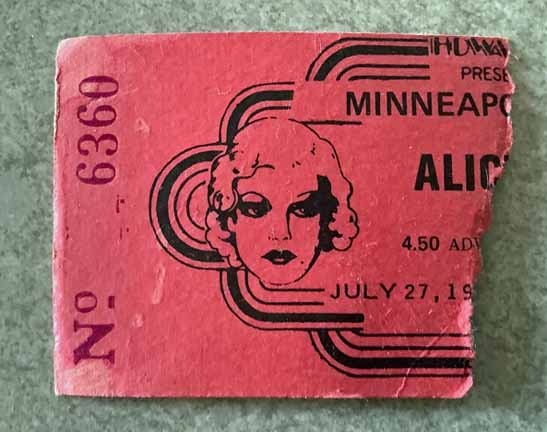
Ticket posted on Facebook by D Arnie Peterson
Wikipedia describes Cooper’s show:
The live performances featured Cooper wearing a costume with fake blood stains at the crotch, tearing apart baby dolls, attacking mannequins, and being decapitated by a guillotine. Cooper has said that the mutilation of the dolls symbolized child neglect. The effects were designed by magician James Randi, and Randi traveled with the tour to supervise and coordinate them. Randi even played a part in the stage show as “The Executioner.”
Between 40 and 50 people were employed and 26,000 pounds of equipment were used. In preparation for the tour, two semi-trailer trucks carried a wide variety of props, including a dentists drill, four whips, a surgical table, six hatchets, 33,000 program books, 300 baby dolls, 22,000 sparklers, 58 mannequins, 280 spare light bulbs, 1,000 patches, 6,000 mirror parts, 14 bubble machines, 28 gallons of bubble juice, and 250,000 packages of bubble bath.
DRINKING AGE CHANGES TO 18
On June 1, 1973, the age of majority – and thus the drinking age – was changed from 21 to 18 in the State of Minnesota. Regulars at the bars were leery at first of the new teenagers, but kids flocked to the watering holes of Excelsior Blvd. and to discos like Uncle Sam’s. The Insider reported that many bars changed to a rock format to accommodate the new customers. On September 1, 1976, the drinking age in Minnesota was raised from 18 to 19. On September 1, 1986, the drinking age was raised from 19 to 21, with a grandfather clause that allowed people who were at least 19 on that date to drink legally.
Jam presented Savoy Brown, Blue Oyster Cult, and Manfred Mann at the St. Paul Auditorium on June 7, 1973. Produced by Owen Husney.
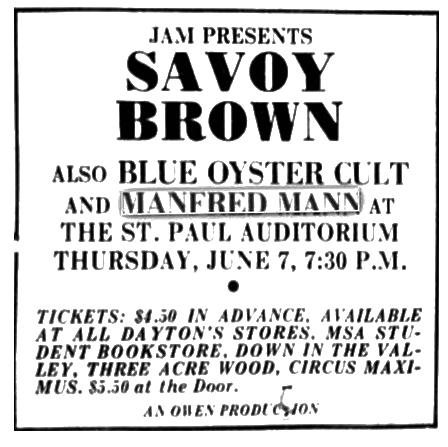
Sonny and Cher, June 8, 1973, Met Center. Comedian David Brenner opened.
Johnny Cash brought his show to the Minneapolis Auditorium on June 13, 1973.

Minneapolis Tribune
The first rock concert at the St. Paul Civic Center Arena was advertised as the J. Geils Band on June 23, 1973. Other acts on the bill were Mason Profitt, Canned Heat, and the Climax Blues Band. Stone Bleu was negotiating with NBC-TV to cover it as an episode of “Midnight Special.” (Minneapolis Tribune, June 8, 1973) The arena had opened on January 1, 1973. Joe Scanlan says that his band Karma opened the show, followed by Canned Heat.
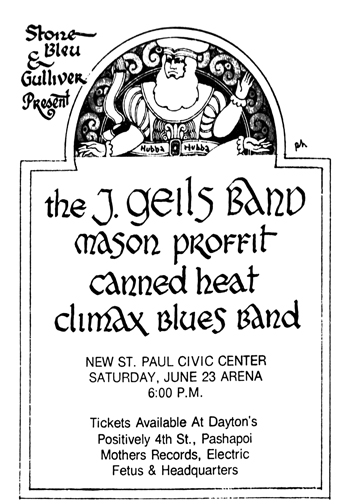
Minneapolis Tribune
Harry Belafonte at the St. Paul Civic Center, June 27, 1973.
A Nashville Spectacular, starring Hank Williams, Jr. and other Country stars, scheduled for June 30, 1973, at the St. Paul Civic Center Arena, was cancelled when only $3,000 in tickets were sold.
Jethro Tull, July 2, 1973, Met Center – Passion Play tour. Steeleye Span opened.
Pat O. posted:
The Passion Play show was really pretty interesting. After the crazy worldwide success of Thick as a Brick, Tull’s management booked studio time for the new LP and a world tour. They first recorded in a studio in France. They spent months doing it and it was such a disaster that they scraped (and did save) some of it for War Child and recorded it shortly before the US Tour at Morgan Studio in London. No one in the US had heard or knew what they opened the show with and carried on for over a hour. Passion Play was followed by a huge frenzied standing ovation. Once the ovation died down Ian said “we’d now like to play this nice little tune” which was the opening section of Thick as a Brick. The crowd went mad. What a show.
LED ZEPPELIN
Led Zeppelin performed at the St. Paul Civic Center on July 9, 1973. The show was promoted by Concerts West – Tom Hulett.
Chip Jones says this was their “Houses of the Holy” tour. 17,000 tickets for the show were sold in six hours in mid-June.
The show was delayed 45 minutes until people stopped crushing the stage. An article by Mike Sweeney, presumably of the Minneapolis Tribune, said that potential concert goers started lining up at 2am for the 8pm concert, camping out on the concrete in front of the west entrance. Someone thought “festival seating” was a good idea – tickets were first-come, first-served.
Jeffrey remembered:
The “Festival” seating made this show very uncomfortable. Of course everyone wanted to be on the main floor. I think we even left early because it got so hot in there. Too many people jammed in there.
Michael Guion remembers:
I brought binoculars – I was watching Jimmy during a slow burn, intense solo. Someone threw a firecracker of some sort near Page, no telling how close it was as my binoculars were on his face. Jimmy’s eyes were closed as he was playing and when the firecracker went off; he didn’t miss a note. Just gave a slight, disgusted side to side shake of his head.
The show was recorded. Ad below courtesy Jim Froehlich.
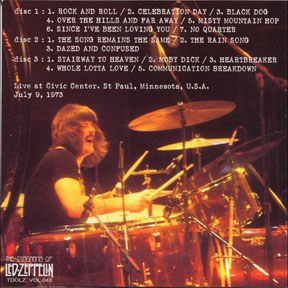
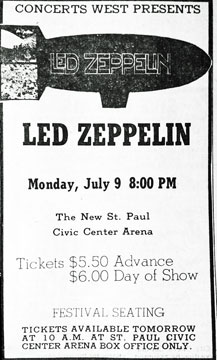
-
Rock and Roll
- Celebration Day
-
Black Dog
-
Over the Hills and Far Away
- Misty Mountain Hop
- Since I’ve Been Loving You
- No Quarter
-
The Song Remains the Same
-
The Rain Song
-
Dazed and Confused (Jake Holmes cover)
-
Stairway to Heaven
- Moby Dick
-
Heartbreaker
-
Whole Lotta Love
-
Communication Breakdown
Focus appeared at the Orpheum Theater on July 19, 1973. Remember “Hocus Pocus” by Focus?
Lighthouse, with Brownsville Station at the St. Paul Civic Center Theater, July 22, 1973.
Roberta Flack: July 27, 1973, Met Center
New Riders of the Purple Sage, Commander Cody & His Lost Planet Airmen, and Country Joe & the All-Star Band came to the Minneapolis Auditorium on August 5, 1973. Tickets were $4, $5, and $6.
Quicksilver Messenger Service, BB King, August 12, 1973, Met Center
The Pointer Sisters opened for Chicago at the St. Paul Civic Center Arena on August 16, 1973. It was the Minneapolis debut for the Pointer Sisters, and Michael Anthony’s review in the Tribune gave the sisters more ink than Chicago. The show drew an SRO crowd of 18,500.
Weather Report and Stairlight appeared at the St. Paul Civic Center Theater on August 19, 1973.
Elton John, August 23, 1973, Met Center. The supporting act was The Sutherland Brothers and Quiver.
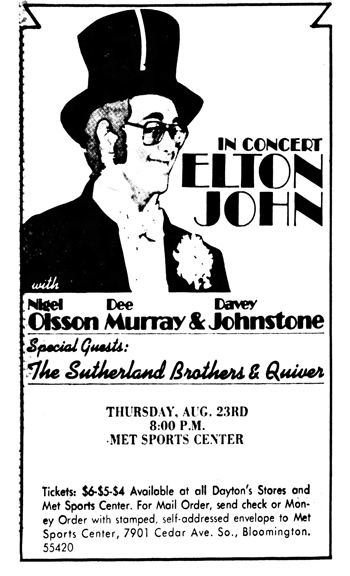
Minneapolis Tribune
Bob remembers,
He opened up with “Funeral For Friend/Love Lies Bleeding,” and then went into “Elderberry Wine.” It was right about the time when the double album “Goodbye Yellow Brick Road” album came out!
Mark says:
Elton took the stage wearing a top hat and a cape, which he quickly discarded. The real visual was on his face where he was sporting an oversized set of glasses which spelled out the letters E L T O N in flashing lights. He could always make an entrance.
Leon Russell with Mary McCreary appeared at Parade Stadium on August 30, 1973. Our own Scott Sansby was the drummer in McCreary’s band, and says it was the biggest tour he ever played. Russell and McCreary were soon married. Here’s a photo of her band.
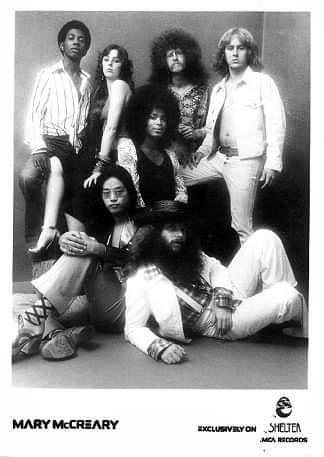
Photo courtesy Scott Sansby
Three Dog Night, Foghat, and Teen King and the Princes, September 2, 1973, Met Center. West Central Productions. Three Dog Night also played Duluth on that tour. Three Dog Night was originally scheduled to play the St. Paul Civic Center Arena, as announced in July 1973.
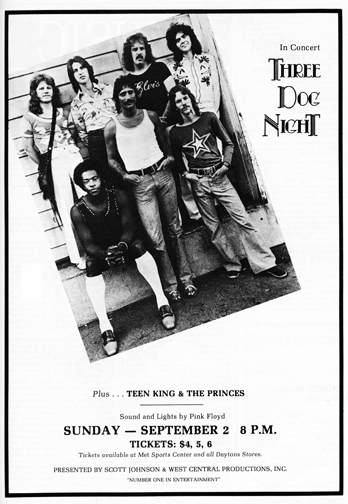
Ad from the Insider
Steely Dan played the Orpheum on September 10, 1973.
John Mayall’s Jazz/Blues Fusion-era band at the St. Paul Auditorium Theater Section, September 18, 1973. Muddy Waters opened.
Muddy Waters also appeared at Macalester College Field House in the Fall of 1973.
Lawrence Welk and a cast of 40 appeared at the St. Paul Civic Center on September 23, 1973.
George Carlin appeared at the Orpheum Theater on September 24, 1973.
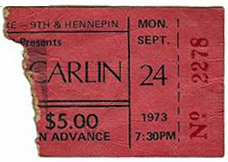
Courtesy Michael Gacek
McCoy Tyner and Natural Life, St. Paul Civic Center, October 2, 1973
On October 5, 1973, the Memphis Blues Caravan came to the St. Paul Civic Center Theatre. Performers, some of them quite elderly, included:
- Furry Lewis
- Bukka White
- Sleepy John Estes
- Hammie Nixon
- Piano Red Williams
- Harmonica Frank Floyd
- Houston Stackhouse
- Joe Willie Wilkins and the King Biscuit Boys
Guy Lombardo, St. Paul Civic Center, October 7, 1973
The Lettermen, St. Paul Civic Center, October 7, 1973
Sha-Na-Na, with Muddy Waters, Minneapolis Auditorium, October 7, 1973
Dr. John, St. Paul Civic Center, October 9, 1973
Fleetwood Mac, Blue Oyster Cult, Minneapolis Auditorium, October 11, 1973
Tony Bennett, O’Shaughnessy Auditorium, College of St. Catherine, October 12 – 13, 1973
Carlos Montoya, St. Paul Civic Center, October 13, 1973
Helen Reddy and Robert Klein appeared at the Minneapolis Auditorium on October 14, 1973.
Bonnie Raitt was the first of a series of performers booked into the Marigold Ballroom by Owen Husney of Owen Productions. She did two shows on October 14, 1973. The otherwise old time/polka/big band venue began a policy of hosting rock acts one Sunday a month.
Grand Funk Railroad appeared at the St. Paul Civic Center on October 20, 1973. “They took the stage in front of a large screen showing a vintage black and white film clip of a steam locomotive heading straight towards the camera.”
Opening act that night was remembered by one person as Ballin’ Jack and another as Humble Pie. The scale is tipping toward Ballin’ Jack, since one person remembers seeing them open for the same show the next night in Duluth.
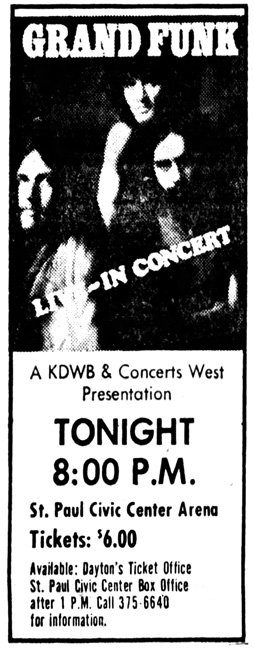
Minneapolis Tribune, October 20, 1973
Judy Collins, O’Shaughnessy Auditorium, College of St. Catherine, October 19, 1973
Grand Funk Railroad, St. Paul Civic Center Arena, October 20, 1973
Jim Froelich reports that the New York Dolls’ management bit off more than they could chew and scheduled a headline gig at the Orpheum Theater for October 22, 1973, which was subsequently cancelled due to low ticket sales.
GRATEFUL DEAD: PEACE AND LOVE AND ASSAULT AND BATTERY
Grateful Dead, October 23, 1973, Met Center. Comments on Facebook tell the story; if these are your quotes and you will let me add your name, please contact me.
In the middle of “Casey Jones” a fan went over the security barricade in front of the stage. The security guards started tearing into him. Bobby took his mic stand and swung at the security guys. He said something to the effect of “Stop punching our *** audience.” He then refused to start the music until the security guys left the front of the stage. They left, the song continued. In what turned out to be the finial encore, there was pushing up front. Wier did yell “*** knock it off or we will leave.” They left.
And another:
What really sucked was that this show was advertised as “The Grateful Dead Performing 3 Sets.” “Casey Jones” was the first song of Set 3. The fight was ugly – several security dudes beating on one guy who was dancing in the aisle right in front of the stage, even Bill K. jumped off the stage to help break things up and security started pounding on Bill, that’s what Phil is so upset about. The melee ended soon after. By then, Jerry and Phil were both sitting on the stage floor – everyone seeming quite upset by this sudden change of weird energy and bad vibe. The band had several discussions – you could see that they were at serious odds about whether they should continue with the plan and do a third set. After all, the first two sets were well played, creative and joyful. When they finally tried to play “Saturday Night,” you could tell their hearts and minds were no longer into continuing this night. Too bad for all of us. Those security punks must have left their “Minnesota Nice” at the door or when they donned their uniforms.
The “Wang Dang Doodle” Organ Jam – if memory serves me right – was actually the band and crew trying to get, what we all thought was the House’s Wurlitzer, on stage and put through the PA. The crew and Keith dealt with this for a long time between the first and second sets, and finally the rest of the band came on stage – with house lights still up – and started playing this tune. Kind of a mini sound check. They brought the house lights down and continued on. A night full of unusual occurrences.
Mark Luebker sent a link to the actual recording of the concert – thanks!
Taj Mahal, St. Paul Civic Center Theater, October 25, 1973.
Glenn Yarbrough and the Limelighters Reunion, St. Paul Civic Center Theater, October 26, 1973
Tower of Power, St. Paul Civic Center Theater, October 29, 1973
Mott the Hoople, St. Paul Civic Center Theater, November 1, 1973
The Mahavishnu Orchestra and John McLaughlin appeared at the Orpheum Theater on November 2, 1973.
Black Oak Arkansas and the James Montgomery Band appeared at the St. Paul Civic Center Theater on November 3, 1973.
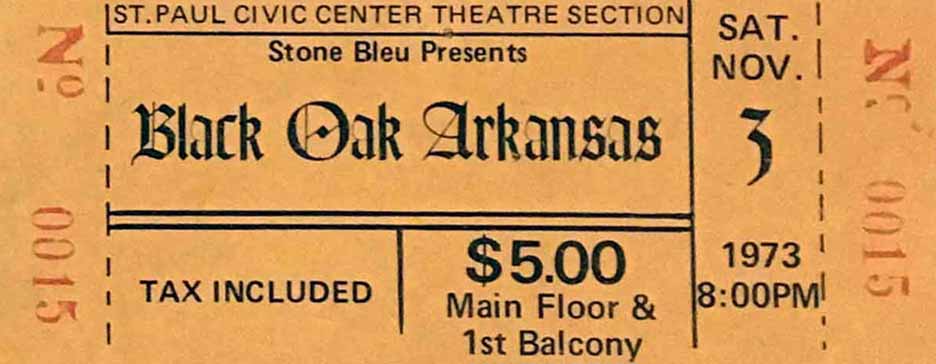
Black Oak Arkansas Ticket courtesy Steve Roell

Ad courtesy Steve Roell
Shawn Phillips with Quartermass, Orpheum Theater, November 5 an 6, 1973 (2 shows each night)
Paul Williams, St. Paul Civic Center Theater, November 7, 1973
Rock ‘n’ Roll Revival, Minneapolis Auditorium, November 10, 1973
November 11, 1973, was a big night for music, resulting in smallish numbers for each of the shows. Your choices were:
- The Allman Brothers at the Met Center, supported by Charlie Daniels and Grinderswitch
- The Pointer Sisters and Martin Mull at the Guthrie
- Joe Walsh with Barnstorm and the Climax Blues Band at the St. Paul Civic Center Theater – a Stone Bleu production.
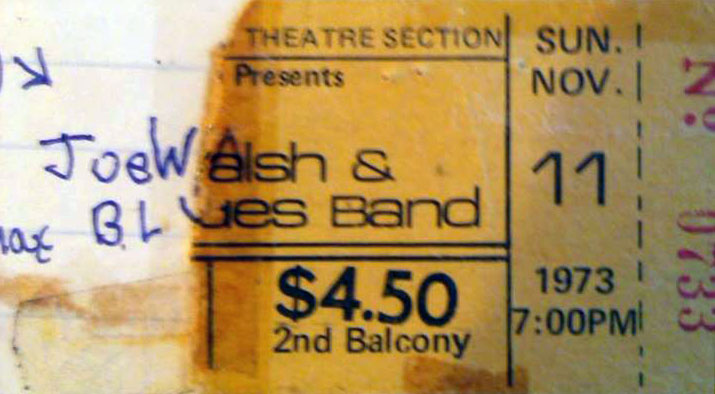
Image courtesy Nicky Jester
Loggins and Messina, November 16, 1973, Met Center
Doobie Brothers, Met Center, November 18, 1973
Wishbone Ash and Renaissance appeared at the St. Paul Civic Center Theater on November 19, 1973. Stone Bleu Productions
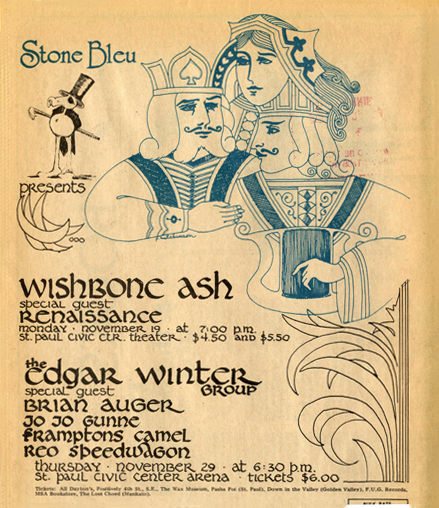
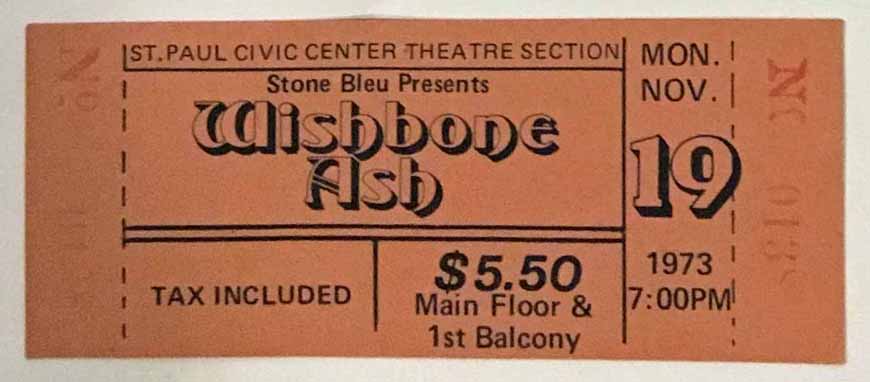
Courtesy SteveRoell
Johnny Mathis, St. Paul Civic Center, November 25, 1973
Doobie Brothers, November 28, 1973, Met Center
On November 29, 1973, at the St. Paul Civic Center Arena there was a big show with the Edgar Winter Group, Brian Auger, Jo Jo Gunne, Frampton’s Camel, and REO Speedwagon. See poster above under November 19, 1973.
Kris and Rita Kristofferson performed at the O’Shaughnessy Auditorium on November 30, 1973.
Emerson, Lake & Palmer, with Stray Dog. December 1, 1973, Met Center. Presented by Howard Stein.
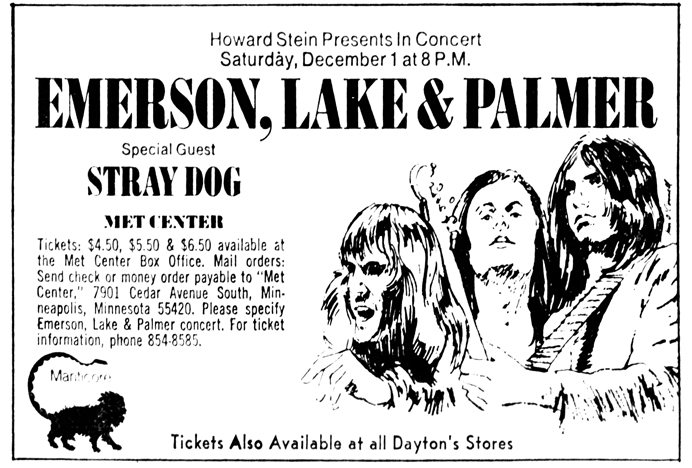
Minneapolis Tribune
John Prine, Guthrie, December 2, 1973
Guess Who and Poco, December 7, 1973, Met Center
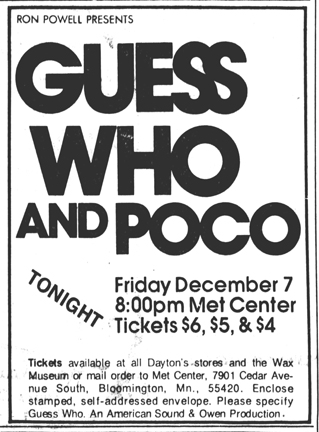
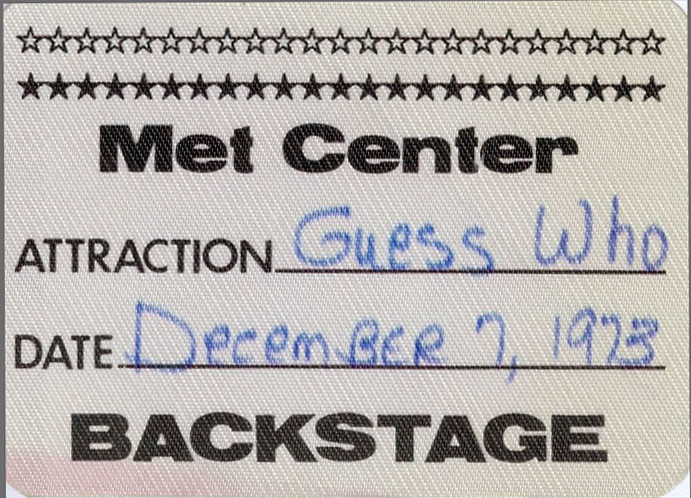
Denny Jones Archives
Nitty Gritty Dirt Band, Jesse Colin Young, and Maria Muldaur at the St. Paul Civic Center Theater, December 7, 1973. The poster below indicates that instead of Maria Muldaur, the concert introduced the opening act was the Ozark Mountain Daredevils, being introduced to the Twin Cities. A Stone Bleu production.
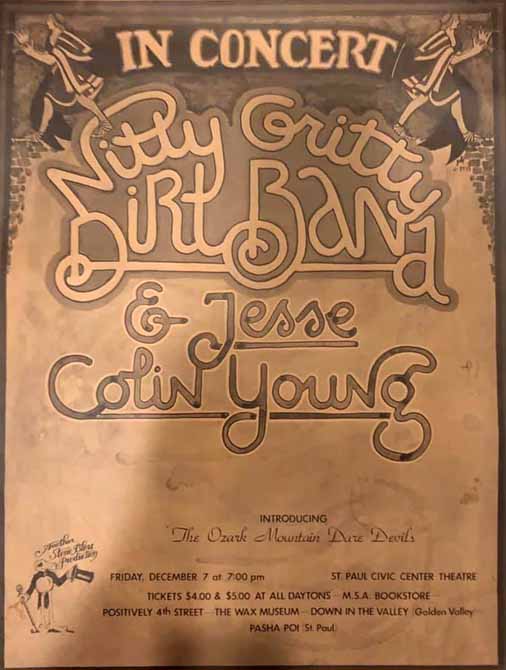
Lynyrd Skynyrd opened for the Steve Miller Band at the St. Paul Civic Center on December 11, 1973. Also on the bill was Chick Corea.
Sly and the Family Stone, December 16, 1973, Met Center. Those who were there say that they were two hours late, Sly was high as a kite, and they played a very short set. Thanks, Facebook friends!
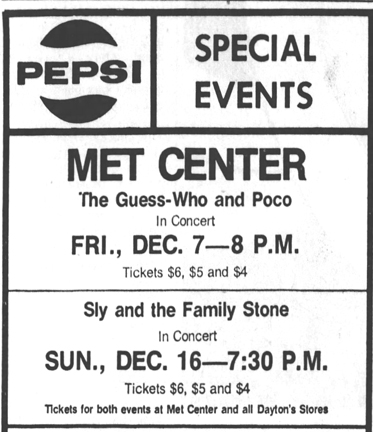
Leo Kotkke, Guthrie Theater, December 16, 1973
Johnny Winter, with REO Speedwagon, appeared at the St. Paul Civic Center on December 27, 1973, presented by Greathall.
Charles Quimby of the Star reported that the logistics of getting in were inexplicably difficult, and people were throwing things at promoter Dick Shapiro for the slow trickle of fans that were allowed in out of the cold. Rick on Facebook says, “Johnny came out in a puff of smoke wearing a top hat and playing a white Firebird.”
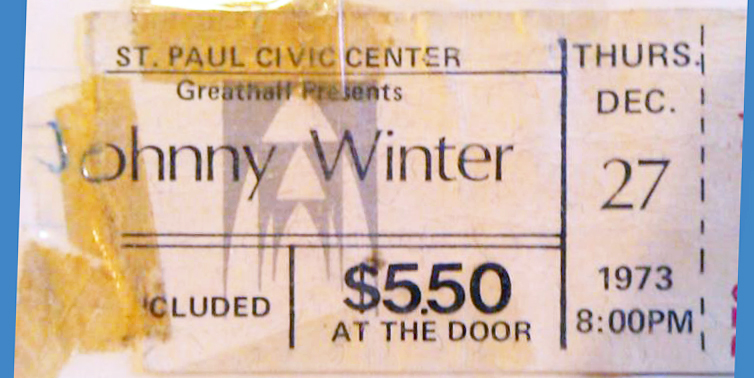
Ticket image courtesy Nicky Lester
Fleetwood Mac: 1973
Fleetwood Mac tickets for the Orpheum Theater on March 5, 1973, sold out in three days so a second show was added.
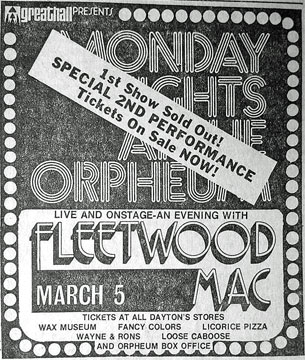
Ad courtesy Jim Froehlich
Was this the concert where Jon Hiseman’s Tempest opened up the second show and was booed off the stage because the second show started so late and people were there for Fleetwood Mac?
Dr. Hook and the Medicine Show: 1973
April 1, 1973, brought Dr. Hook and the Medicine Show and Flash Cadillac and the Continental Kids to a less than one-quarter full house at the Minneapolis Armory. Marshall Fine reported in the Star that Dr. Hook handled their generally serious songs with a great deal of incongruous humor and showed fine musicianship. He was not impressed with Flash Cadillac. The ad below is a little chewed up but you get the idea. Thanks to Alan Freed and Jay Pee on the Old Minneapolis Facebook page.
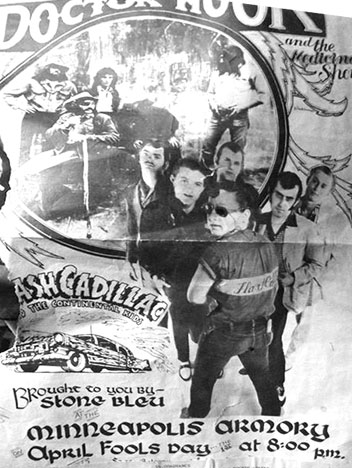
Jack Costanzo and Gerrie Woo: 1973
Jack Costanzo and Gerrie Woo appeared at the Kobbersted in April, 1973. Costanzo was known as “Mr. Bongo.” I think I have one of his albums but not this one:
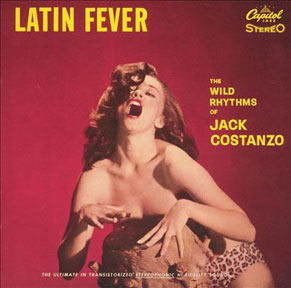
Shawn Phillips: 1973
ORPHEUM THEATER: April 10 and 11, 1973
Shawn Phillips played four shows over two nights on April 10 and 11, 1973, at the Orpheum Theater and all were sold out.
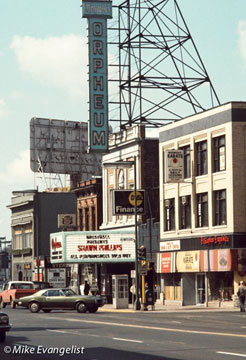
Photo courtesy Mike Evangelist
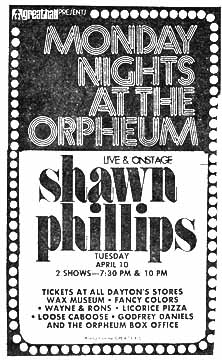
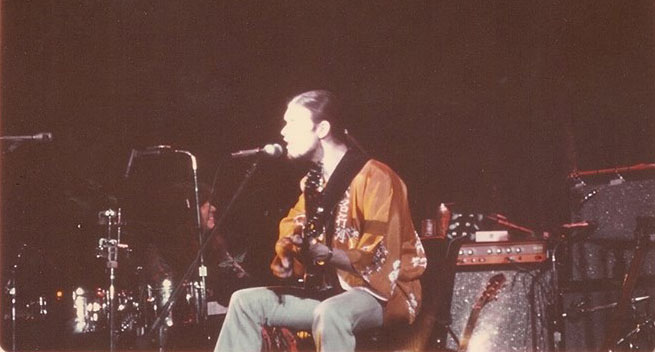
Photo courtesy Steve Klemz
ORPHEUM THEATER, November 5 and 6, 1973
Shawn Phillips returned to the Orpheum on November 5 and 6, 1973, with his band Quartermass. In his review of November 7, Marshall Fine just couldn’t figure out why Phillips was so popular here in the Twin Cities – “His four albums have all sold well here while making an unappreciable dent in the record business elsewhere. Phillips has received more radio airplay in the Twin Cities than in any other market.”
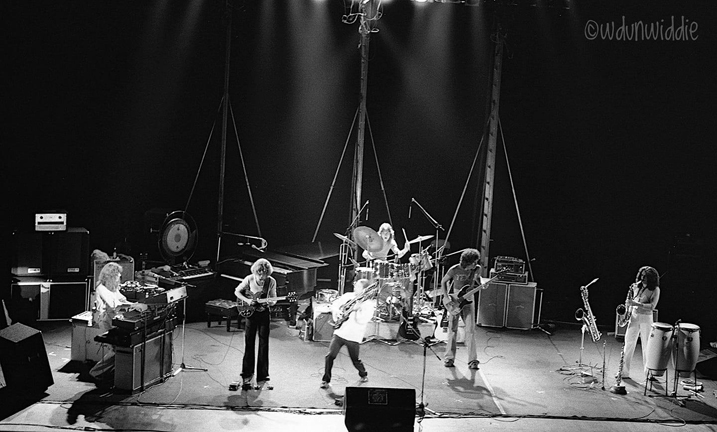
Image courtesy Will Dunwiddie
ST. LOUIS PARK HIGH SCHOOL
In 1973 or ’74 Phillips performed at St. Louis Park High School. Phillips was born in Fort Worth, grew up all over the world, and some say had ties to Edina. Roni Broms Gingold remembers: “At the concert everyone would yell ‘Let down your hair’ and he would take the ponytail out.” Roni took the photo below at the concert.
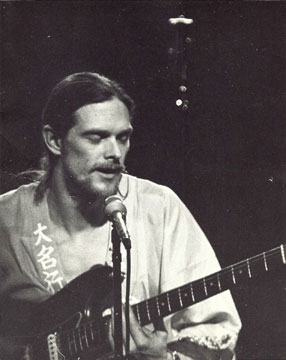
Photo courtesy Roni Broms Gingold
Festival of Music: 1973
A “Festival of Music” was presented at the Minneapolis Auditorium on May 12,1973, starring:
- Boots Randolph
- Floyd Cramer and the Boots Randolph Orchestra
- Danny Davis and the Nashville Brass
- The Music City Sound of Strings
- Special Guest Star Jethro Burns
Mankato State: 1973
Mankato State College held a free concert on May 16, 1973. It was an annual fundraiser for Native American students called the Little Crow Concert, and was probably organized by Peter Hornby,
WDGY’s Jimmy Reed was emcee. The bands scheduled were:
- Climax Blues Band
- Axteca
- Bruce Springsteen
- Rise and Shine
- Rue Delight
BUT… Springsteen and the Climax Blues Band dropped out. The lineup for the show was:
- Rue Delight
- Rose
- Rise and Shine
- Vixen
- Cold Blood
- Larry Coryell
- Bob Seger
This corrected information comes to you courtesy of the wonderful Neal Bond, his followers on Facebook, and the archives of The Reporter student newspaper.
Doobie Brothers: 1963
The Doobie Brothers, Argent, and Bob Seger played the St. Paul Auditorium on May 25, 1973. Show produced by (and image provided by) Owen Husney.
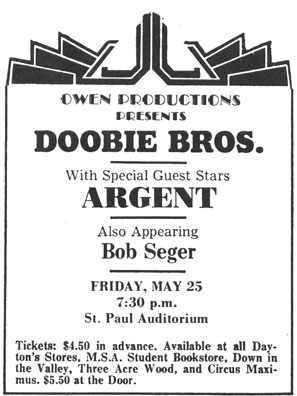
British Invasion Reunion: 1973
A British Invasion Reunion show came to Minneapolis on July 11, 1973. From the blog of Jerry Fuentes:
The 1973 British Invasion tour promoted by Richard Nader. This tour was the first substantial nod to the budding nostalgia craze in America. New York promoter Ron Delsener had the idea and contacted agent Danny Betesh about securing the talent. Betesh had handled a number of acts back in the day, including Freddie and the Dreamers, who he still handled. Unfortunately Freddie had a summer season booked in Great Yarmouth so he was unavailable. Dave Clark turned down an offer but Peter Noone was interested and pretty soon a package was put together. It was at that point that Delsener had to bow out. He was dealing with the summer-long Shaeffer Music Festival in Central Park and had no time to devote to the tour. Oldies producer Richard Nader stepped into the breach and promoted the tour.
An amazing reunion resulted from this tour and Peter Noone reunited with the Hermits. In addition to Herman’s Hermits and Billy J. Kramer and the Dakotas, other bands on this tour included Gerry and the Pacemakers, The Searchers, and Wayne Fontana and the Mindbenders. Billed as “The British are Coming Again,” the 21-date nationwide tour of the U.S. and Canada began on the East Coast and worked its way to the West before working their way back to the Midwest.
In addition to the tour, Nader arranged a booking with TV producer Burt Sugarman to do a British themed Midnight Special. The filming took place on July 15th after the LA and San Francisco shows were cancelled and included all of the acts on the tour in addition to the Hollies and the Bee Gees, who hosted the show. It aired on August 10, 1973.
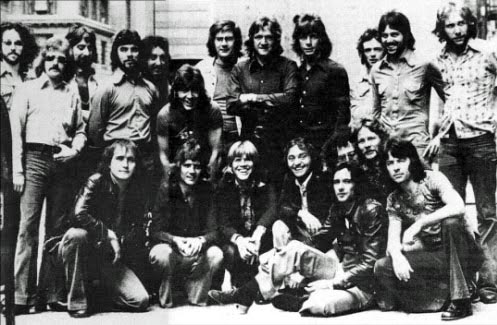
From the blog of Jerry Fuentes
Annual Tomahawk Days: 1973
Mike Evangelist thinks the photo below came from Apache Plaza’s annual Tomahawk Days in 1972 or ’73. Kids got a little headband with a feather in it and a rubber tomahawk. Any idea who the group is? The mall met its demise in 2004.
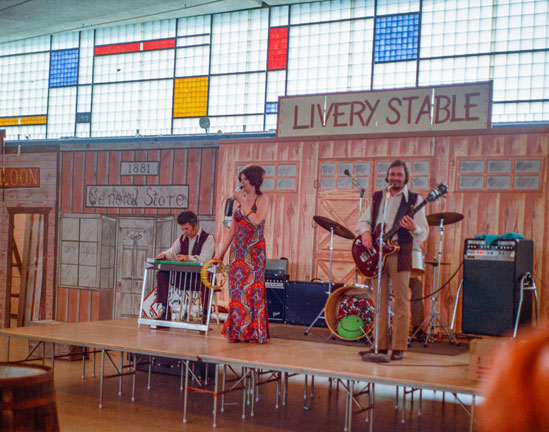
WCCO: 1973
WCCO never gets much air on this site, but Bob says:
‘CCO made a bit of an effort in the early ’70s to shift its music to being a bit hipper. “Hip” to ‘CCO consisted essentially of The Fifth Dimension and the Carpenters. They might actually have broken down and played “Yesterday” by the Beatles once or twice and maybe “The Wreck of the Edmund Fitzgerald” by Gordon Lightfoot [1976]. Howard Viken, their hugely popular morning guy, did a lot to break “(They Long to Be) Close to You” in the late spring and early summer of 1970 – he played it pretty much every day, he LOVED that record.
And that, my friends, might be the first and last you see of WCCO. Not hip. But thanks, Bob!
Aquatennial Beach Party/Rock Festival: 1973
KDWB sponsored an Aquatennial Beach Party/Rock Festival at Lake Calhoun on July 19, 1973. It was organized by Don Cline and Chuck Buell from KD. Rain kept the crowd to 5,000 – 10,000. Performing were Tony Joe White, Brownsville Station, and Don Bleu and the Upper Division. Rain cancelled Marshall Tucker, but they came back the following Tuesday and performed at Minnehaha Falls, as did the band Straight Up.
Rock Festival: 1973
A rock festival took place at the Donnybrooke Speedway in Brainerd on September 2, 1973. It was a 425-acre site with an 80 ft. stage and featured a People’s Cultural Fair. Performing were:
- Black Oak Arkansas
- David Bromberg
- Gypsy
- Iggy and the Stooges
- Baby
- REO Speedwagon
- Tony Joe White
Other announced acts may or may not have come:
- Quicksilver Messenger Service
- Dr. John
- Roy Wood’s Wizard
Marathon III: 1973
Marathon III, part of Welcome Week, took place at Memorial Stadium at the U of M on September 23, 1973, according to the Insider. Groups performing were:
- Paul Butterfield’s Better Days
- Freddie King
- David Bromberg
- New Grass Revival
- Michael Johnson
- Ellen McIlwaine
- Moondogg and Muledeer Medicine Show was/were? the emcees.
Johnny Hanson sez:
It was a helluva lineup but it was really a cold day. By evening it was nearly freezing Some folks in the bleachers next to us collected trash and built a bonfire (not good). Bromberg got halfway thru his set and apologized: “Our fingers are freezing to the strings” and that was that.
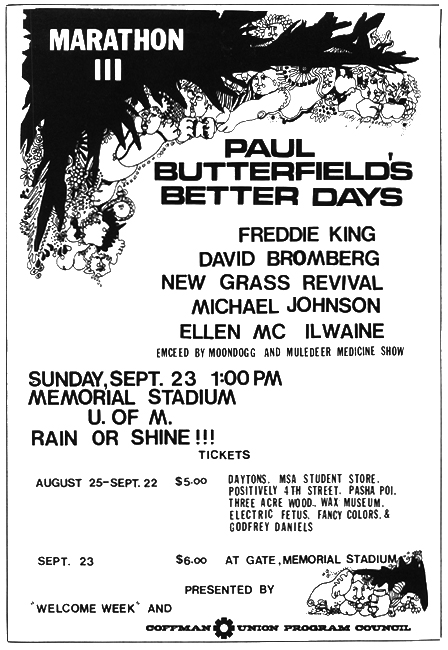
Image courtesy of the Insider
Events: 1974
In January KDWB published an apology about some unspecified remark that DJ Bob Shannon had said on the air. It turned out to be a publicity stunt to let everyone know about new guy Shannon, who had actually been at the station eight years before as “Kelly.” Shannon was no Howard Stern but he did generate some angry calls and letters, according to Irv Letofsky in the Trib.
Melissa Manchester, Danny O’Keefe, and Muske and Raths were booked into the Marigold Ballroom by Owen Productions on January 18, 1974.
Linda Ronstadt and Jackson Browne, February 3, 1974, Guthrie Theater
Canned Heat, February 9, 1974, St. Paul Civic Center (Theatre)
BB King and Bobby Lyle, February 15, 1974, St. Paul Civic Center (Theatre)
Gordon Lightfoot’s two shows on February 17, 1974, filled up so fast at the O’Shaughnessy Auditorium that a third show was added the next night, February 18, at 7:30 pm.
DEEP PURPLE
Deep Purple and Savoy Brown, February 22,1974, Met Center. This concert was cancelled due to the illness of Deep Purple organist John Lord.
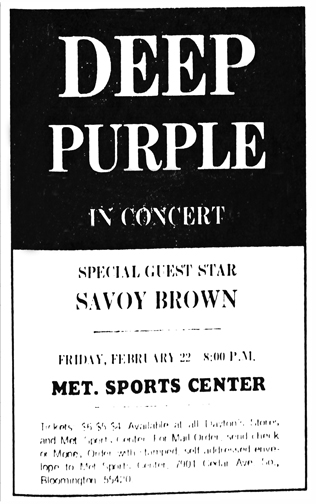
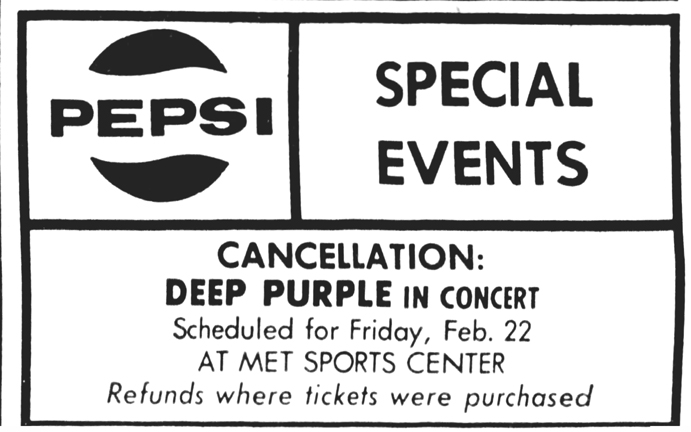
YES
Yes, March 5, 1974, Met Center, with John Martyn.
Here is video shot by David Allan Wright!
Yes Lineup: (Info from Forgotten Yesterdays fan site, apparently defunct)
- Jon Anderson – Vocals
- Steve Howe – Guitar
- Christ Squire – Bass
- Rick Wakeman – Keyboards
- Alan White – Drums
Setlist:
- Firebird Suite
- Siberian Khatru (Close To The Edge)
- And You And I (Close To The Edge)
- Close To The Edge (Close To The Edge)
- Revealing Science Of God, The (Tales From Topographic Oceans)
- The Ancient (Tales From Topographic Oceans)
- Ritual (Tales From Topographic Oceans)
- Roundabout (Fragile)
- Starship Trooper (The Yes Album)
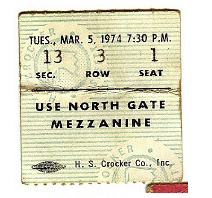
Ticket stub courtesy Michael Gacek
Seals and Crofts, March 20, 1974, Met Center
Tower of Power, March 23, 1974, St. Paul Civic Center (Theatre)
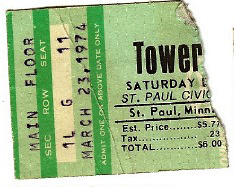
Ticket posted on Facebook by Michael Gacek
The Pointer Sisters performed at the Orpheum Theater in Minneapolis on April 1, 1974.
Todd Rundgren, April 5, 1974, St. Paul Civic Center (Theatre)
Paul Williams, April 6, 1974, St. Paul Civic Center (Theatre). Opened by Home Cookin’
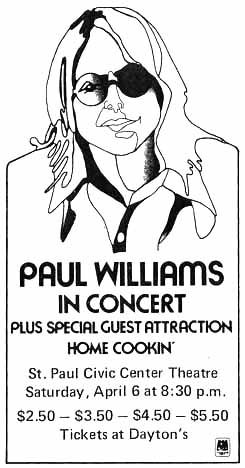
Ad from the Insider
Facebook Facts: “The Theatre sat 3000 people. I was in the 8th row and Billy Gibbons had 8 Marshall stacks . I gave up about 10 dB in my top end hearing for that show.” “I remember a streaker dancing across the stage!” The Strib does not show any ads for this.
The Electric Light Orchestra appeared at the Orpheum Theater on April 17, 1974.
Foghart and Montrose, April 17, 1974 – Marigold Ballroom
Tom Jones performed at the Chimera Theater from April 19 to May 5, 1974, if I’m reading the Insider’s calendar right.
Bachman Turner Overdrive, May 11,1974, Met Center
Mahavishnu Orchestra with John McLaughlin and the Mahavishnu Orchestra appeared at the Orpheum Theater on May 13, 1974. The group’s previous performances had been at the much smaller Guthrie Theater, indicating a jump in their appeal.
MARSHALL TUCKER BAND
The Marshall Tucker Band, with Pat Ireland, performed at the St. Paul Civic Center Theater on April 29, 1974.
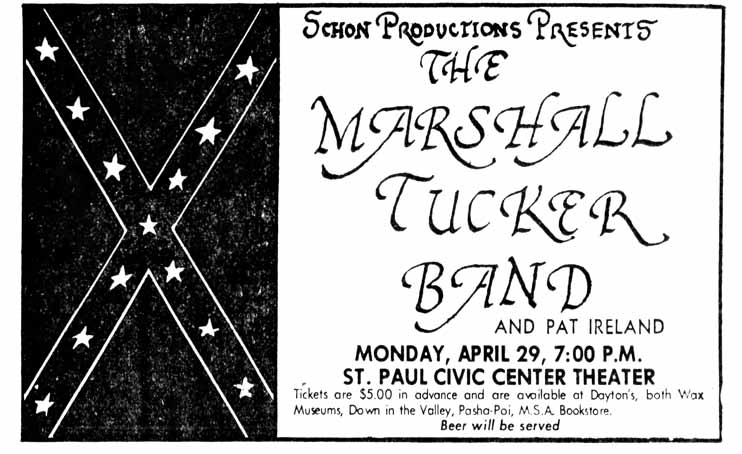
Minneapolis Tribune, April 1974
Jon Bream, in his “R n’ R Hootchie Koo” column in the TC Express magazine (July 1, 1974), gave the group high marks boosting its standing as one of the best new groups to emerge last year.
Leader Toy Caldwell showed us more moves in less than one hour than any guitarist since Duane Allman – and he picks with bare thumb and fingers. Brother Tommy Caldwell, bassist for the South Carolina group, earned his keep …
Eddie Kendricks, opened by Graham Central Station, at O’Shaughnessy Auditorium, St. Catherine’s University, in St. Paul on May 16, 1974.
None other than Marlene Dietrich was booked to give two shows at the O’Shaughnessy Auditorium on May 26, 1974. Due to inadequate ticket sales, the second show was cancelled.
Ten Years After with Dave Mason, May 31, 1974, Met Center, 8:00
Sonny Terry and Brownie McGhee appeared at the Whole Coffeehouse at the U of M on June 7 and 8, 1974. One of these was my first concert!
Pianists Ferrante and Teicher were guest performers for the Minnesota Orchestra’s June 8, 1974, Summer Pops concert at the Minneapolis Auditorium – Henry Charles Smith conducting.
ZZ Top with Maggie Bell, June 19, 1974, St. Paul Civic Center Auditorium.
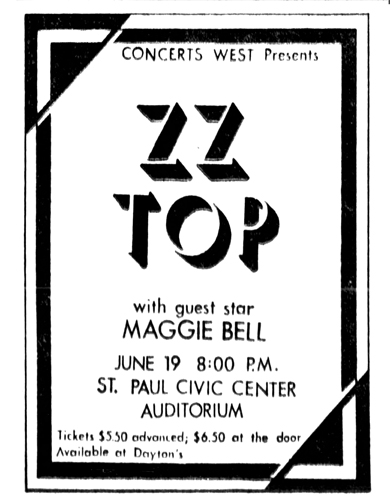
Minneapolis Tribune
SCHOOL’S OUT DANCE
There was a Dance and Concert billed at the St. Paul Civic Center Auditorium on June 22, 1974. It was alternately billed as a “Summer Solstice Spectacular,” “School’s Out Wipeout,” “’70s Stomp” and “the Largest Dance Party in Minnesota History.” The ad promised balloons, noise makers, beer, dance contest, and giveaways. Randy Levy of Schon Productions said that the emphasis was on dancing, and there would be no chairs. Also planned were “revolving spotlights splashing multi-colored lights around the dance floor” like an old time ballroom. 10,000 to 12,000 people were expected. The bands were:
- Slade “England’s No. 1 Rock And Roll Show”
- James Gang (from Cleveland)
- Brownsville Station (from Ann Arbor)
- The Charlie Daniels Band
- Maggie Bell “England’s #1 Female Vocalist
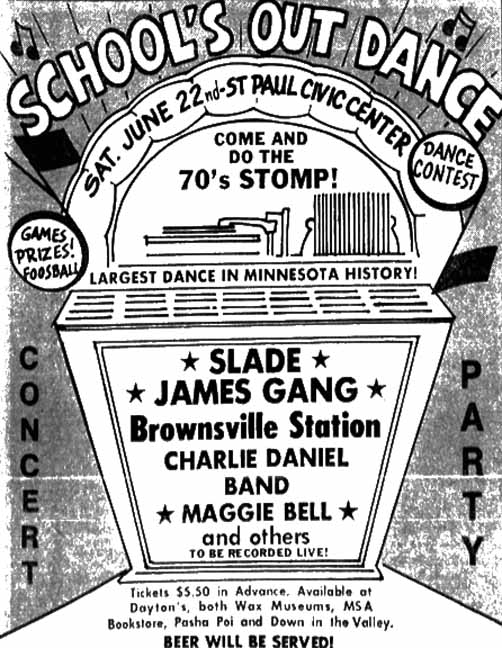
Allman Brothers Band Summer Campaign ’74, July 8, St. Paul Civic Center Arena. With Grinderswitch.
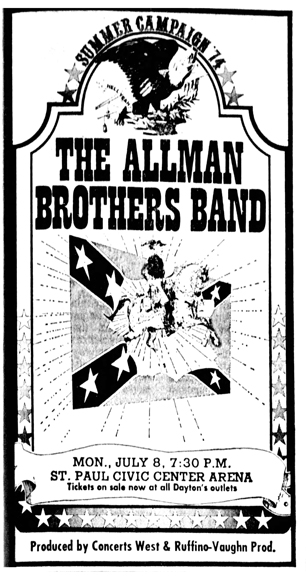
Minneapolis Tribune
Maggie Bell was in St. Paul on June 19, 1974. Jon Bream reported that Atlantic Records hosted a party for her but she was late, having come from New York that day. Her set that night was a mere 30 minutes – “all-too-brief,” but it “confirmed Maggie’s staggering vocal power even though her supporting band lacked polish and discipline.” Maggie Bell was formerly the lead singer of a defunct band called Stone the Crows.
Cat Stevens, July 6, 1974, Met Center – just him, a piano, and a guitar.
Crusaders and Minnie Ripperton, July 11, 1974, St. Paul Civic Center Theater
David Bromberg and Wendy Waldman, July 14, 1974 – Marigold Ballroom
The Santana, Poco, Aerosmith, and Mountain show scheduled for July 19, 1974, at the St. Paul Civic Center was cancelled because Santana’s drummer, Michael Shrieve, was hospitalized with kidney stones and the tour was delayed. The show was rescheduled for August 17 with Leon Russell.
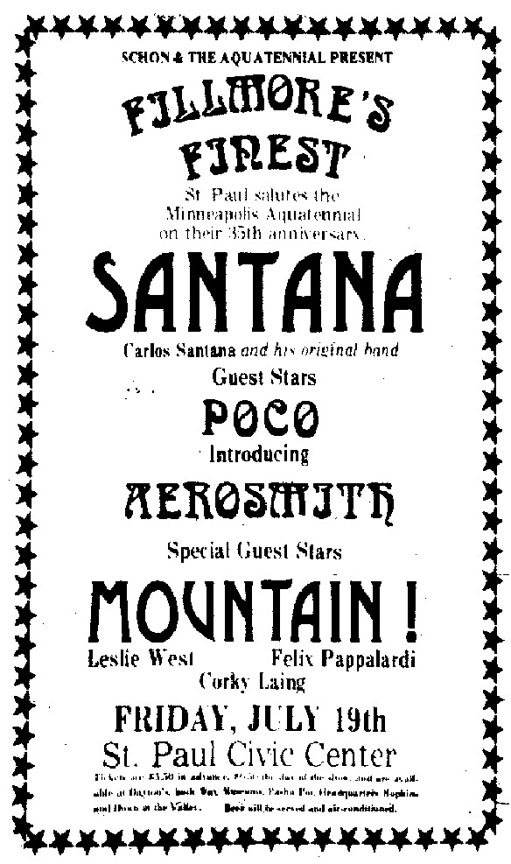
Cleo Laine appeared with the Minnesota Orchestra at the Minneapolis Auditorium on July 20, 1974.
The Eagles opened for Joe Walsh and Barnstorm on July 20, 1974, St. Paul Civic Center Arena. JoJo Gunne may have also been on the bill. Jim Froehlich says:
The Eagles at this stage were Henley and Frey, plus Randy Meisner, Bernie Leadon and recent addition Don Felder. Walsh replaced Leadon in ’75, Timothy Schmitt replaced Meisner in ’77 and Felder made it through to the band’s first break-up in 1980.
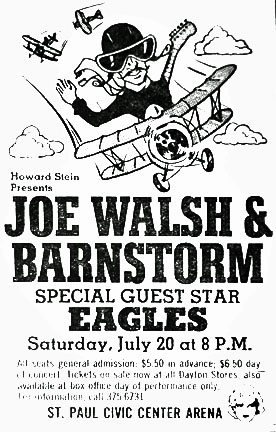
Image courtesy Jim Froehlich
Ry Cooder and Ben Sidran, July 21, 1974 – Marigold Ballroom. Bob Dylan, unsuccessfully incognito, was spotted.
A reportedly off-key Crosby, Stills, Nash, and Young performed at the St. Paul Civic Center on July 22, 1974. Also Jessie Colin Young.
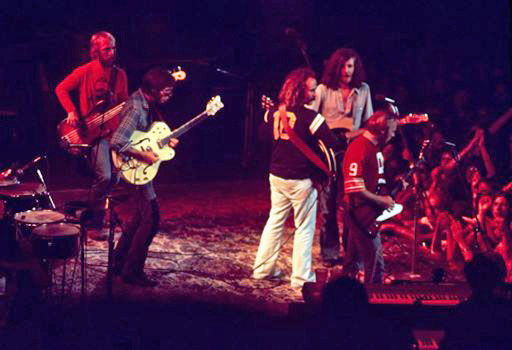
Photo and ticket stub courtesy Mike Evangelist
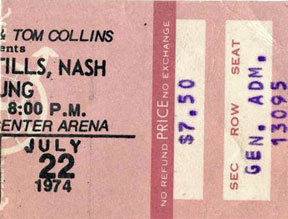
Joni Mitchell made her first appearance in the Twin Cities on July 28, 1974, at the St Paul Civic Center Arena. The three-hour concert also featured Tom Scott and the L.A. Express.
URIAH HEEP AND MANFRED MANN
Uriah Heep’s Wonderworld Tour, opened by Manfred Mann’s Earth Band, July 28,1974, Met Center. Members of Uriah Heep were:
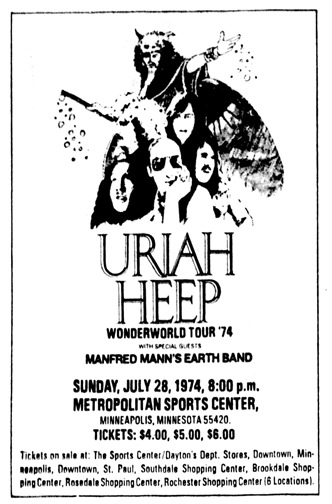
Minneapolis Tribune
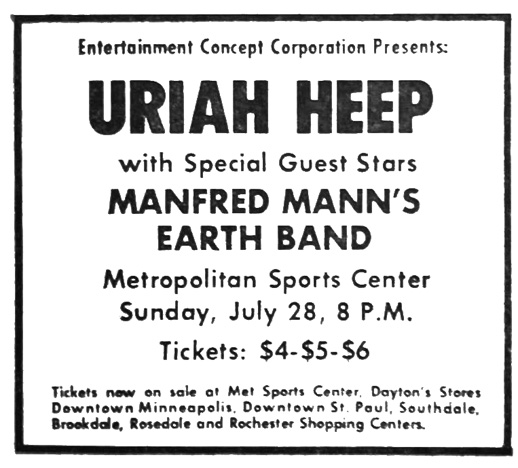
Another ad courtesy Mark Stang
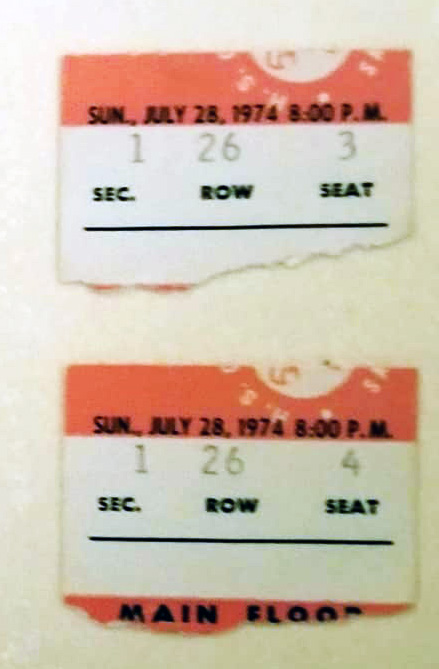
Mark Stang’s ticket stubs
As it was 1974, the year of the Streaker, some remember a naked runner at this show.
Also, Mark Stang remembers that Manfred Mann got an encore and played their cover of Dylan’s “The Mighty Quinn.” He said it was very rare for an opening act to get called back out for an encore.
Mac Davis, August 4, 1974, Met Center (2 shows)
The Guess Who, Wet Willie, and War performed at the St. Paul Civic Center on August 8, 1974, the night Nixon resigned. They played to 22,060 fans, the best-attended single concert at the St. Paul Civic Center. One attendee remembers that they played his speech over the speakers and cut to the music as soon as he said “I’m resigning.”
The Jackson 5 performed at the St. Paul Civic Center on August 16, 1974. A review indicates that they were not yet superstars. It was a benefit for the Afro-American Music Opportunities Association, which started in Minneapolis in 1969. Also on the bill was Haze.
Anne Murray appeared at O’Shaughnessy Auditorium on August 17, 1974.
The Santana, Poco, Aerosmith, and Mountain show scheduled for July 19, 1974, at the St. Paul Civic Center was cancelled because Santana’s drummer, Michael Shrieve, was hospitalized with kidney stones and the tour was delayed. The show was rescheduled for August 17, 1974, with Leon Russell.
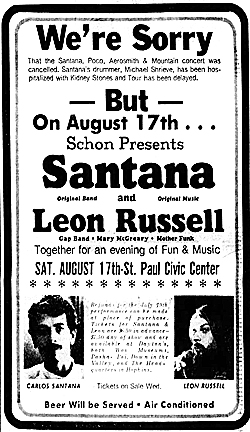
Chicago and the Doobie Brothers appeared at Midway Stadium on August 22, 1974. See the page on Midway Stadium for details.
Dr. John the Night Tripper was scheduled for August 25, 1974, at the Marigold Ballroom but had to cancel. Owen Production.
The Band, Souther Hillman Furay Band and “Surprise Guest:” September 1, 1974, St. Paul Civic Center
Albert Collins performed at the Cabooze, September 12-15, 1974.
Ella Fitzgerald, backed by a quartet, performed at the O’Shaughnessy Auditorium on September 13, 1974.
Van Morrison appeared at the Minneapolis Auditorium on September 13, 1974. It was his first appearance in the Twin Cities after several cancellations.
Three Dog Night appeared with Heartfield and Wolfman Jack at the St. Paul Civic Center on September 13, 1974. Jeff Lonto says,
Wolfman Jack . . . had Minnesota connections, even owning a home near Lake Minnetonka. (He had homes in New York and California as well.) On the afternoon of this Three Dog Night show at the St. Paul Civic Center in September 1974, he DJ’d live on WDGY for an hour with Jimmy Reed. “Clap For the Wolfman” by the Guess Who was a chart hit at the time as well.
The 12 1/2 minute aircheck of Wolfman’s appearance on WDGY is available from Radiotapes.com!
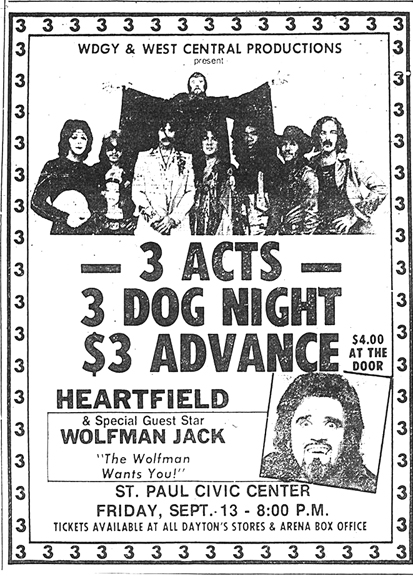
Ad courtesy Jeff Lonto
Chubby Checker appeared at the 1 & 44 Club on September 23 and 24, 1974.
Lynyrd Skynyrd opened for Elvin Bishop at the St. Paul Civic Center Theater on September 26, 1974.
Frankie Valli and the Four Seasons, with Wayne Fontana and the Mindbenders, performed at the St. Paul Civic Center on September 29, 1974.
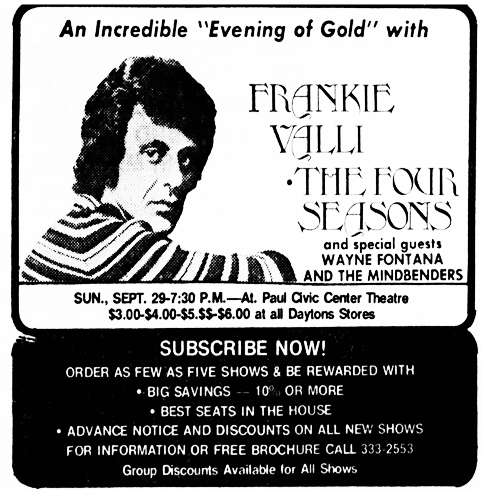
Minneapolis Tribune
Steppenwolf, September 29, 1974, Met Center
Elvis appeared at the St. Paul Civic Center on October 2 and 3, 1974. Jon Rukavina remembers driving in from Excelsior and paying $7 for the ticket! See separate page on Elvis in the Twin Cities.
BOWIE
David Bowie came to the St. Paul Civic Center with his Diamond Dogs Tour on October 5, 1974.
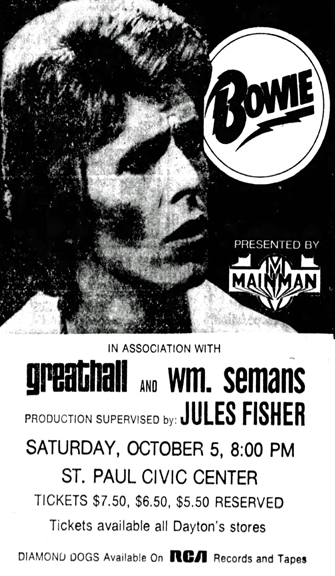
Minneapolis Tribune
SETLIST
According to setlist.fm, Bowie played the following songs:
- 1984
- Rebel Rebel
- Moonage Daydream
- Sweet Thing
- Candidate
- Sweet Thing (Reprise)
- Changes
- Suffragette City
- Aladdin Sane (1913-1938-197?)
- All the Young Dudes
- Cracked Actor
- Rock ‘n’ Roll With Me
- Knock on Wood
- It’s Gonna Be Me
- Space Oddity
- Future Legend
- Diamond Dogs
- Big Brother
- Chant of the Ever Circling Skeletal Family
- Time
- The Jean Genie
- Rock ‘n’ Roll Suicide
- John, I’m Only Dancing (Again)
REVIEWS
On January 11, 2016, a day after Bowie’s death from cancer, the StarTribune’s Jay Gabler reviewed the coverage of all of Bowie’s performances here in the Twin Cities. This is what he wrote about the 1974 show:
On Oct. 7, the Monday after Bowie’s Saturday night show, Tribune reviewer Michael Anthony reported that the show was “less theatrical, I’m sure, than the 6,700 fans expected.” Still, it was “a powerful, high-energy evening: positive proof of Bowie’s far-reaching, innovative talents.”
Anthony called the Diamond Dogs tour “a much more straightforward musical presentation than that of the elaborately staged and choreographed tour he made last summer.” Bowie’s bandleader Mike Garson and his musicians (including, Chris Riemenschneider notes, a still-unknown Luther Vandross) played for a “vigorous half-hour,” and then after an intermission, Bowie came out in “modified Gatsby and a 1950s coif.”
Bowie’s look — the beginning of the Young Americans era, despite the fact that it was still technically a tour to support Diamond Dogs — was much more conservative, Anthony noted, than “some fans in the audience, who, in homage to the King of Glitter Rock, made do with feathers, sequins, capes and all manner of facial makeup.”
Anthony saw the show as a testament to Bowie’s skill as a musician, not merely as a showman. “Bowie, 27, is not yet the Superstar in the U.S. that he is in his native England,” however. “Proclamations from publicity types and a number of rock critics that he will be the major figure in ’70s rock have yet to be borne out.”
Neglecting to mention any specific songs Bowie actually sang, Anthony carried on to opine that “Bowie is the only pop-culture artist of this decade who has really taken the medium in a new direction. His themes of science-fantasy (and his persona of extraterrestrial rock singer, Ziggy Stardust) serve as metaphors for the drug experience, for teen-age alienation and for the pan-sexuality of some members of his audience.”
Meanwhile, in the Minneapolis Star, Bream wrote that “Bowie has been hailed as the next Elvis, next Dylan and the next Beatles, even though the singer-songwriter has become better known for his flamboyant, style-setting, bisexual image than for his wholly original science-fiction rock and roll.”
Bream, too, seemed disappointed the the performer whose show “has been reputed the be the ultimate in stage histrionics” had opted for a relatively conventional approach, “a show that is as slick as Elvis Presley’s.” (The King himself had played the same venue just three days earlier.) Calling the Garson Orchestra’s opening set “a bland set of faceless pop soul,” Bream decided that Bowie’s new songs, “like Bowie’s new stage show, lacked the distinctiveness and creativity of Bowie’s early work.”
One interesting detail from Bream’s review: the show wasn’t sold out. “The sparse crowd of 7,000 (Bowie usually plays to sold out houses) responded faithfully, though not as frenetically as expected.” Anthony must have been looking at a different section of the crowd than Bream was, too: “Their dress,” wrote Bream about the crowd, “like Bowie’s, was surprisingly short on glitter.”
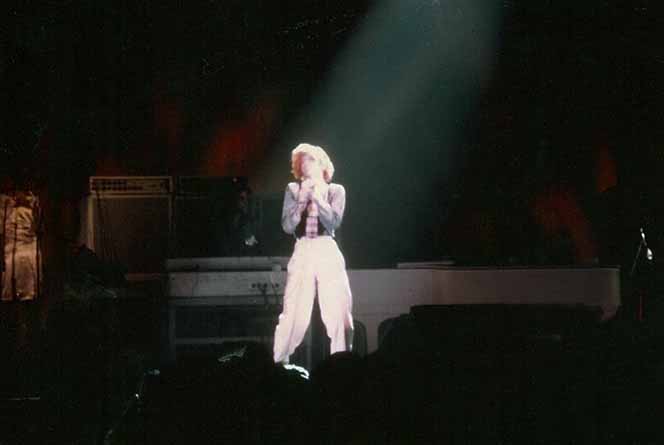
Photo posted on Facebook by Steve Klemz
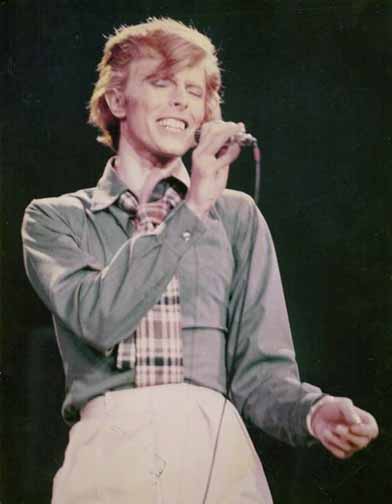
Photo posted on Facebook by Steve Klemz
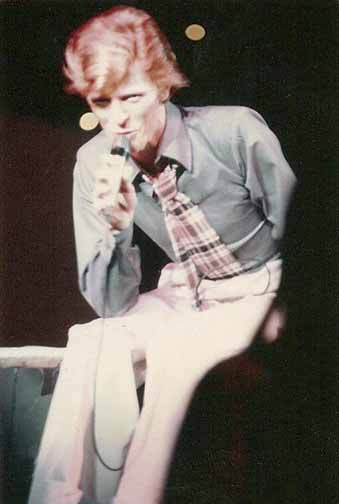
Photo posted on Facebook by Steve Klemz
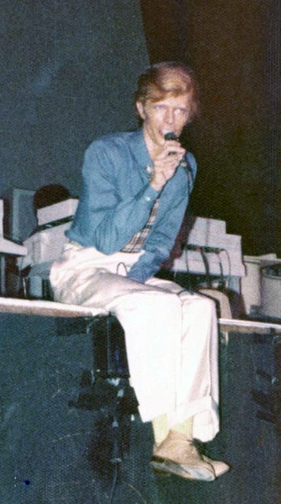
Photo courtesy Bruce Arneson
The two photos below show Bowie in a jacket, either in a different show the same night, or one that he took off during the show.
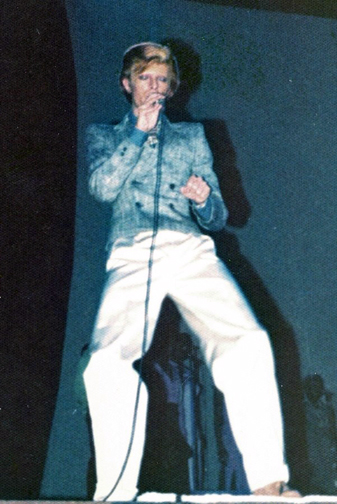
Photo courtesy Bruce Arneson
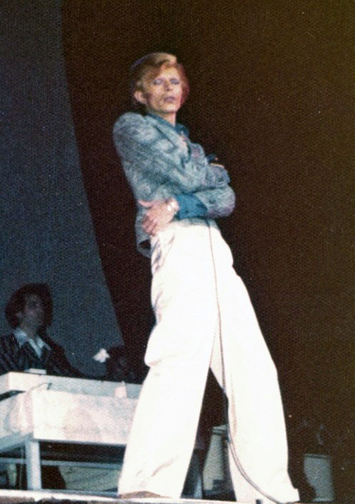
Photo courtesy Bruce Arneson
AFTERPARTY
Below is a shot taken at the October 1974 Bowie concert afterparty at Don Powell’s house on Lake Minnetonka.
Johnny Rey:
We were fortunate to be invited, and Bowie and the whole band/entourage showed up, and as I remember, stayed quite late. Thanks to my friend Anita Collodoro, who can be seen in the bottom left hand corner talking to my good friend, and KYX drummer, Dan Grenier.
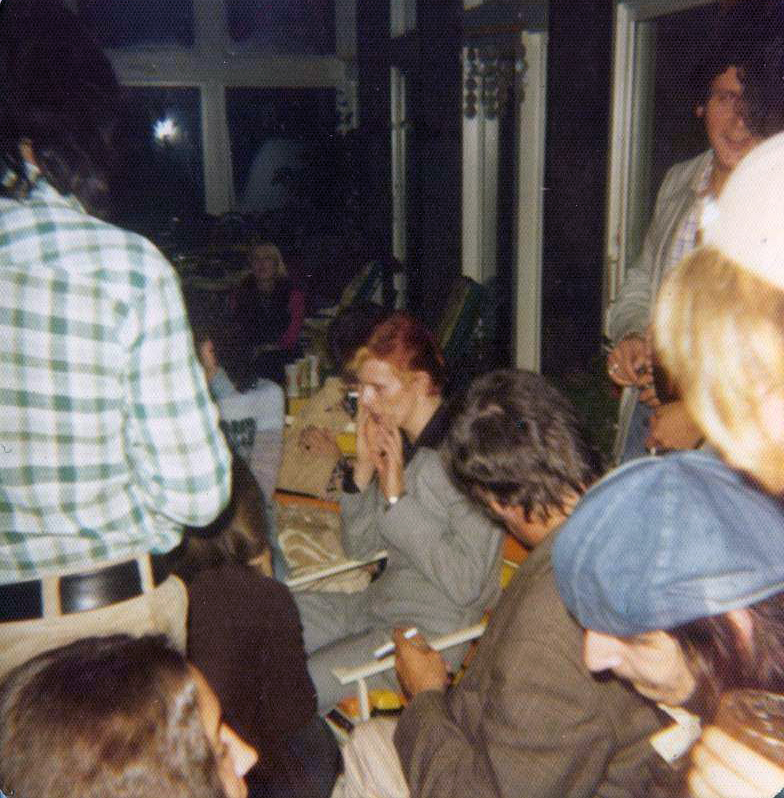
Photo courtesy Johnny Rey
Scott Browning:
It was advertised as the Diamond Dogs Tour that we all read about in all the Rock Magazines at the time and were all dying to see. So it was disappointing to see a stripped- down version of the show without any of the theatrical elements. Bowie passed playing the Twin Cities for more than a decade after this poorly attended show.
Bowie would return to the Twin Cities three more times:
- October 1 and 2, 1987: Glass Spider Tour, St. Paul Civic Center
- October 18, 1997: Earthling tour, Roy Wilkins Auditorium
- January 11, 2004: Reality Tour, Target Center
Glenn Yarborough and the Original Limelighters, October 10, 1974, St. Paul Civic Center Theatre
Billy Joel, Brewer & Shipley: October 13, 1974 – Marigold Ballroom
Minnie Ripperton sang at the West Bank Auditorium on October 16, 1974.
October 16, 1974, brought Golden Earring and Mahogany Rush to the St. Paul Civic Center
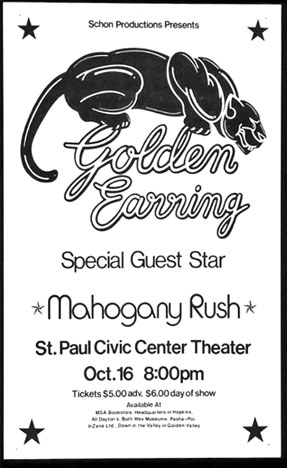
Fleetwood Mac and Triumvirat appeared at the Minneapolis Auditorium Bowl on October 21, 1974.
Kevin Ring wrote that this was “with Bob Welch before the Lindsey/Buckingham era on their “Heroes are Hard to Find” album tour. The warm up band was Triumvirat, a West Germany progressive rock band which played their “Illusions on a Double Dimple” album in its entirety. Never heard of them at the time but is one of my favorite albums.”
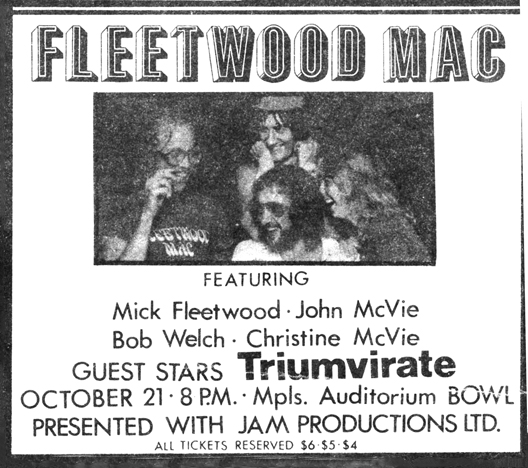
1974
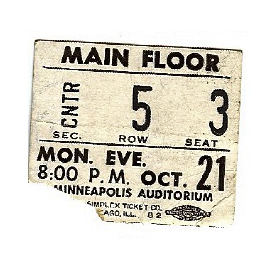
Ticket stub courtesy Michael Gacek
The Lettermen appeared at Northrop Auditorium on October 24, 1974.
Chick Corea and the Chuck Mangione Quartet, Return to Forever, October 27, 1974, St. Paul Civic Center Theatre
Tom Rush and Roger McGuinn appeared at Orchestra Hall on October 28, 1974.
Elton John with Kiki Dee on Oct 31, 1974, Halloween night, St. Paul Civic Center. Tickets were only $7 in advance!
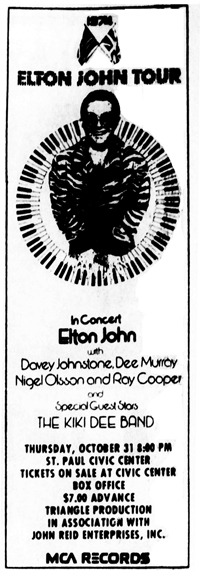
Minneapolis Tribune
Kevin Ring took these great photos of opener Kiki Dee and Elton John:
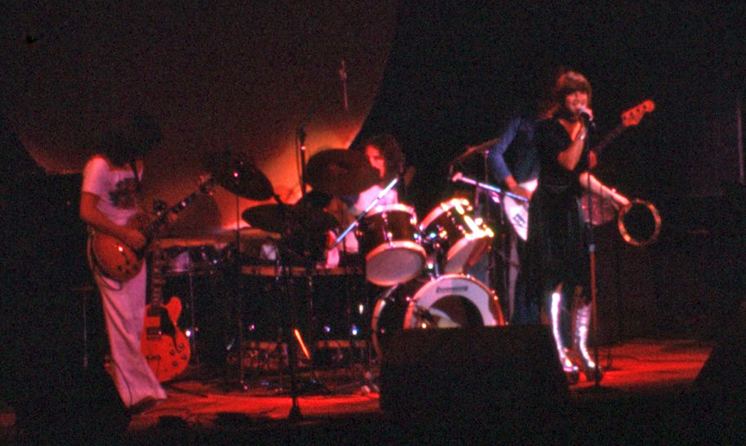
Kiki Dee – photo courtesy Kevin Ring
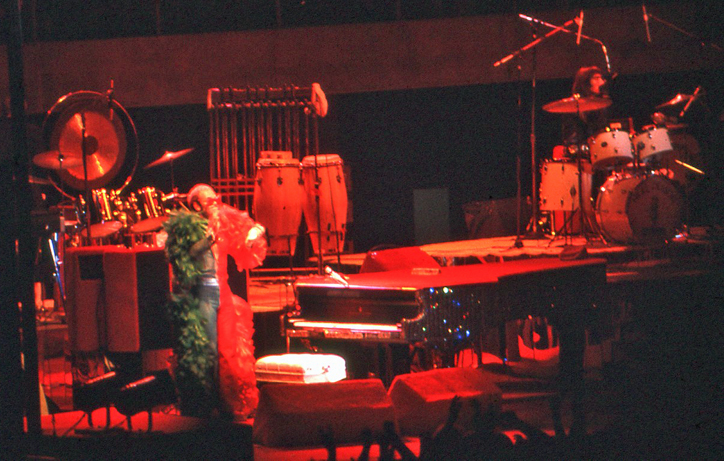
Elton John – photo courtesy Kevin Ring
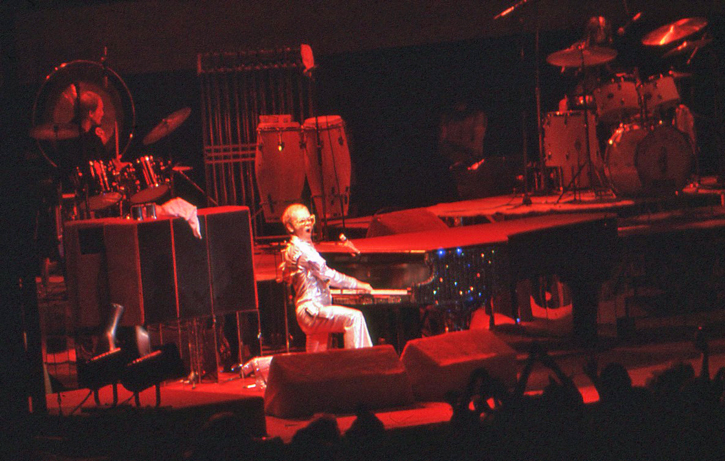
Elton John – photo courtesy Kevin Ring
Facebook:
That show is still brought up occasionally in local newspaper music columns. I was there. They sold the place out, probably 18,000, and then sold an additional 10,000 standing room I believe the week of the show or so. Almost 30,000 in the Civic Center that night. Someone having to do with the show got in trouble for fire code violation I believe and that was the last of doing standing room only tickets. It was a madhouse, everyone having fun.
Todd Rundgren appeared at the Minneapolis Auditorium Bowl on November 3, 1974.
Heartsfield, Plus Muske and Raths, November 3, 1974 – Marigold Ballroom. Owen Production.
Weather Report played Orchestra Hall on November 4, 1974.
Arlo Guthrie appeared at Northrop Auditorium on November 7, 1974
Jackson Browne and Wendy Waldman were at Orchestra Hall on November 11, 1974.
November 15, 1974, featured Black Oak Arkansas at the St. Paul Civic Center.
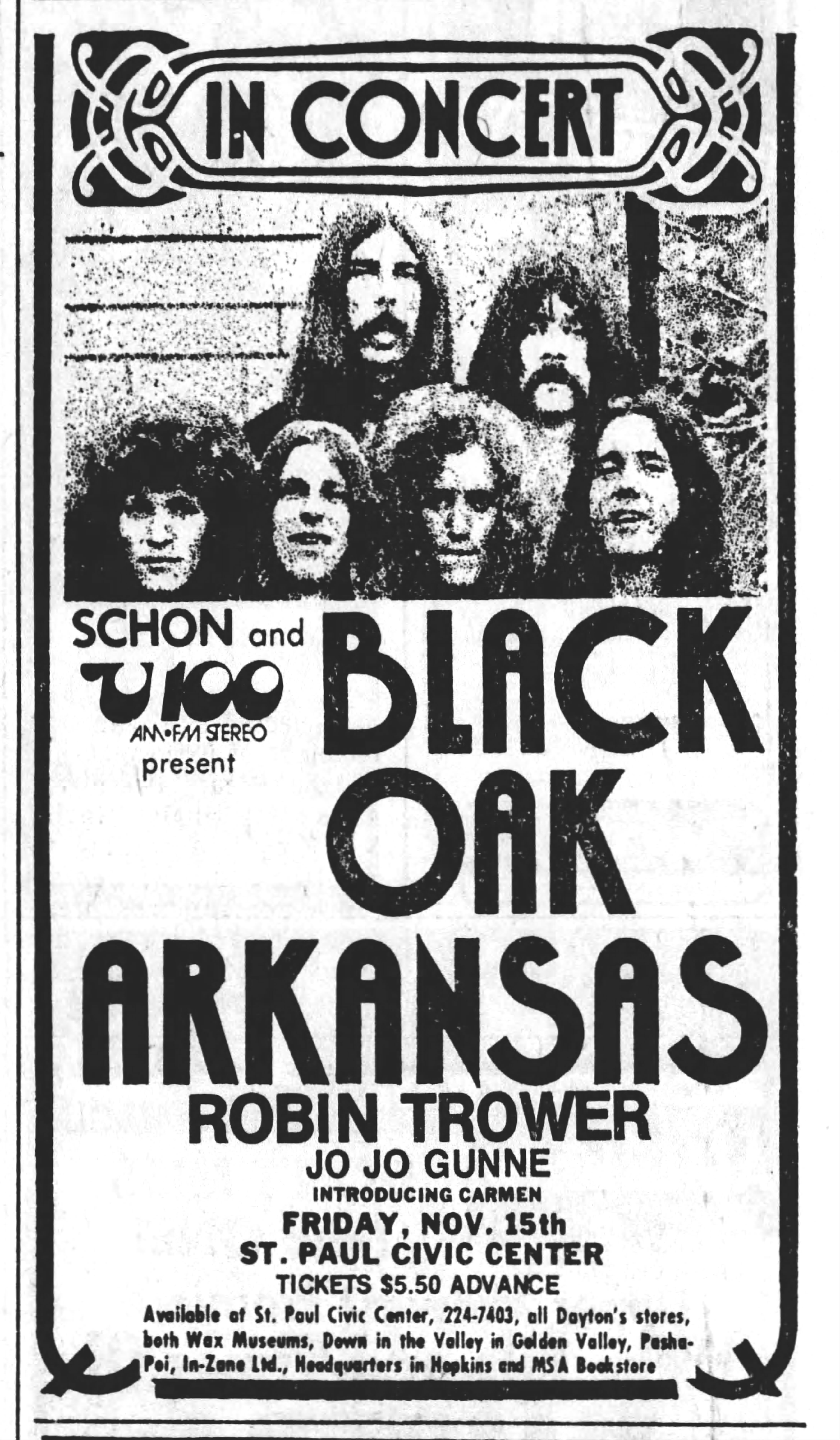
Strib October 27, 1974
Bluesman Furry Lewis graced the Whole Coffeehouse on November 15-16, 1974.
Shawn Phillips came to the Minneapolis Auditorium on November 16, 1974.
Greg Allman played the St. Paul Auditorium on November 23,1974
Theodore Bikel, November 23, 1974, St. Paul Civic Center Theatre
The Kingston Trio were at Orchestra Hall on November 24,1974
America and Poco, November 26, 1974, St. Paul Civic Center
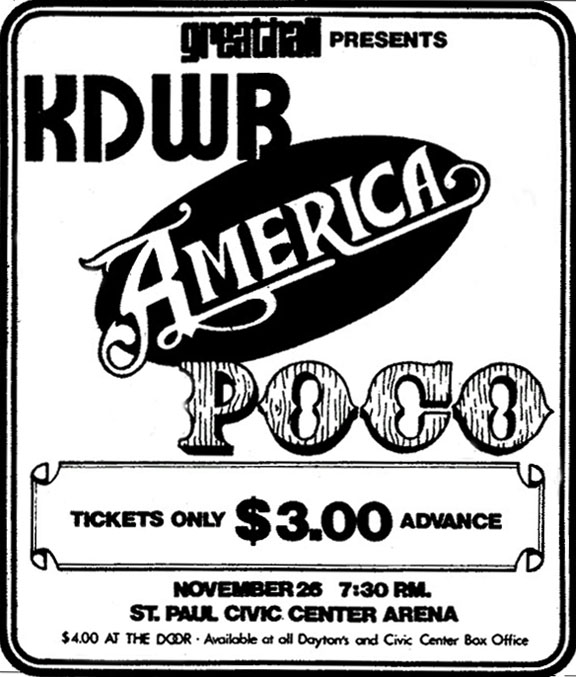
Frank Zappa and the Mothers of Invention Zappa’s first annual Turkey Troy drew a record 15000 fans to the St Paul Civic Center on November 27, 1974, St. Paul Civic Center With the Climax Blues Band.
Songs Performed included:
Dog Breath, in the Year of the Plague
Montana
Penguin in Bondage
Stink-Foot
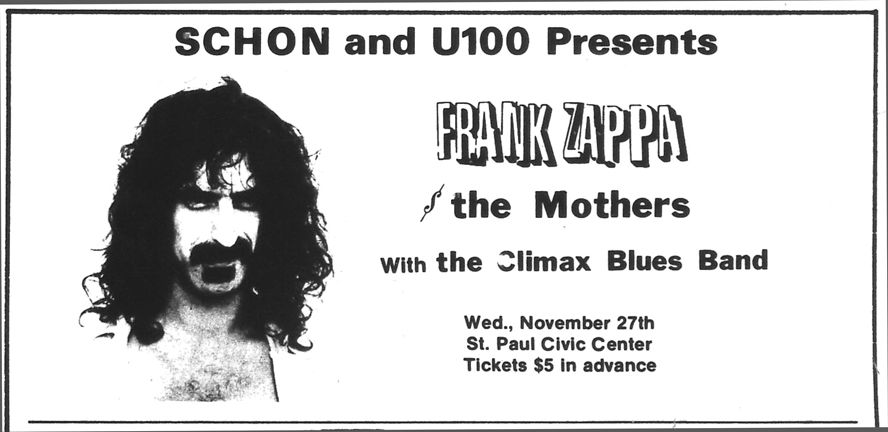
Ad courtesy The Insider
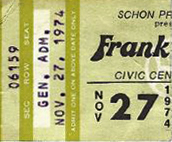
Courtesy Michael Gacek
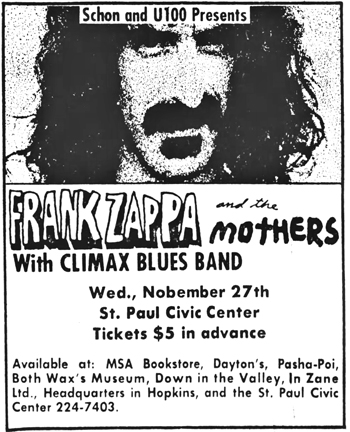
A bootleg LP was made of the entire concert: Thank you Brad Steuernagel!
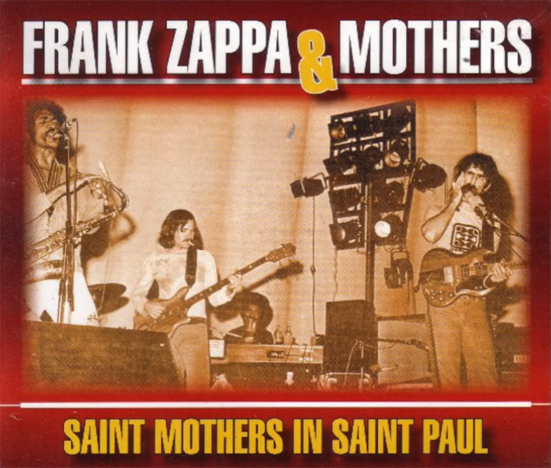
Johnny Mathis, December 1, 1974, St. Paul Civic Center Theatre
Wishbone Ash and Foghat played the St. Paul Auditorium on December 4, 1974.
A show sponsored by Schon Productions and radio station U-100 took place at Northrop Auditorium on December 5, 1974:
- Charlie Daniels Band
- Marshall Tucker Band
- Larry Raspberry and his High Steppers
DEEP PURPLE
Deep Purple Burn Tour, December 9, 1974, Met Center. Deep Purple featured David Coverdale, Glenn Hughes, and Ritchie Blackmore.
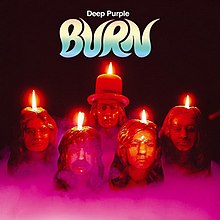
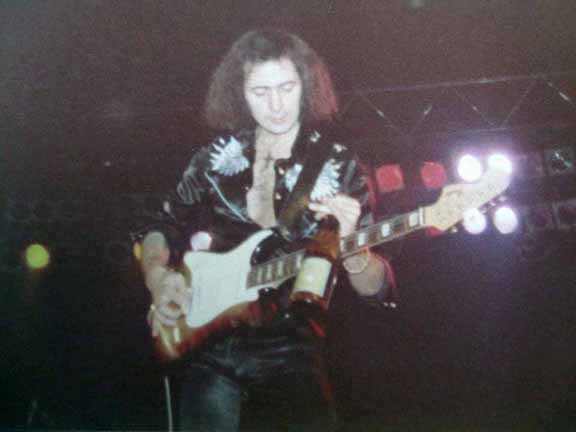
Ritchie Blackmore of Deep Purple – Photo courtesy Rich Aguirre
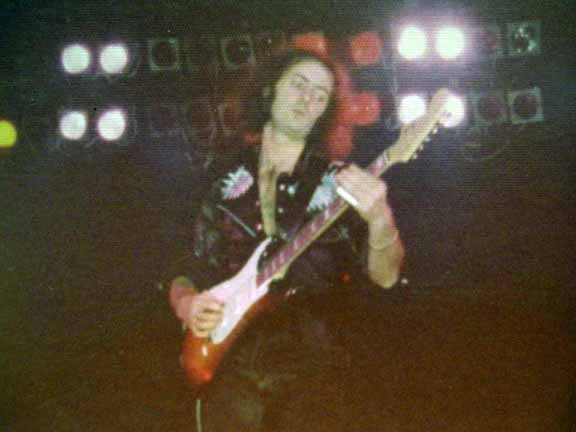
Ritchie Blackmore of Deep Purple – Photo courtesy Rich Aguirre
The show was opened by Elf, a group formed in 1967 by Ronnie James Dio, that had become a regular opening act for Deep Purple.
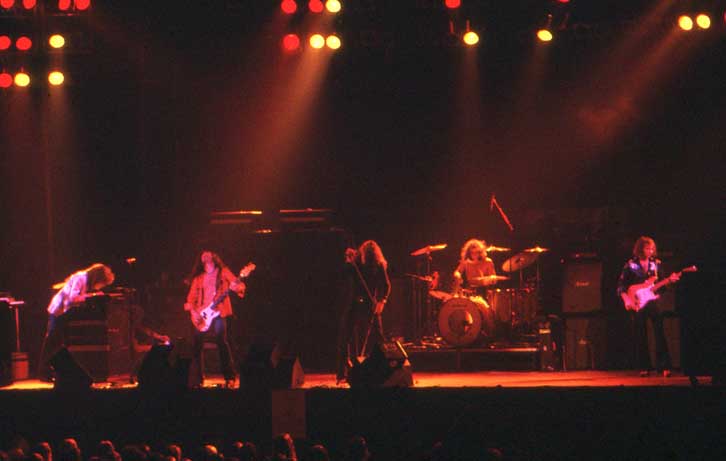
Elf – Photo courtesy Kevin Ring
In 1975, Deep Purple guitarist Ritchie Blackmore founded the band Rainbow and hired Dio to be his lead singer.
Also on the bill was the Electric Light Orchestra
The photo below, posted on Facebook by Nicky Jester, indicates that a concert by Yes was scheduled for November 11, 1974, at the St. Paul Civic Center Arena, but was rescheduled for December 17, 1974. Presented by Howard Stein.
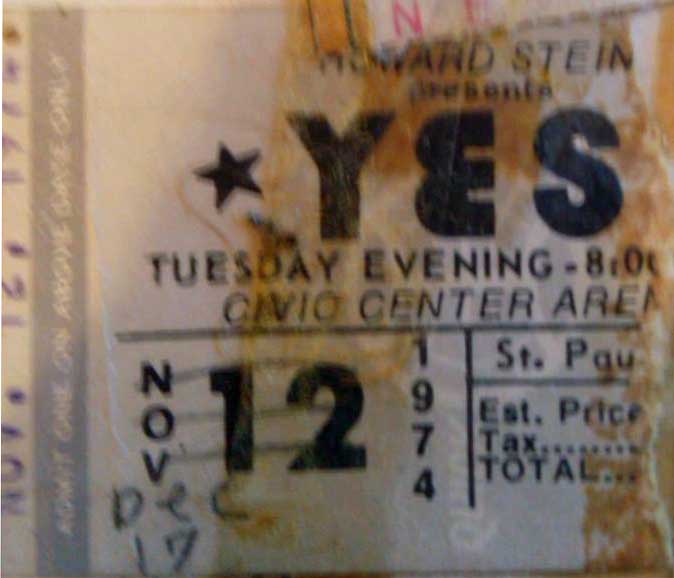
Tooth Of Crime: 1974
T.J. Skinner: “In 1974, I starred in the rock musical “Tooth Of Crime” at the old Cricket Theater. My poster along with Mike Brindisi, Chanhassen Dinner Theater’s Artistic Director/Owner, was all over the Twin Cities and suburbs. The “Rockin’ at the Cricket” article and photos was published in a local rock magazine at the time. The show caused a local sensation and I was a local celebrity for a while. I was on Alan Stone’s KQRS show, he loved the show, and I appeared on all the local talk shows in costume. It was an amazing thing to shave my head in 1974 when even my conservative father was sporting long hair and sideburns.”
Indeed, “Tooth of Crime,” written by Sam Shepard, opened on March 29 at the Cricket, located at 345 – 13th Ave. NE at University Ave. (the old Ritz Theater). The story was about the world of rock ‘n’ roll projected to the year 2000. The score didn’t arrive in time, so it had to be written by Cricket music director Bob Lynn. The music was performed by a band called Nirvana: Tim Moeller, Randy l’Allier, Steve Cassidy, Mark Kryser, and Bob Lynn. In the March/April 1974 issue of the Insider, reviewer Peter Dwyer described the Crow character thusly: “..bald head with a painted on mask, yellow-patent-leather-knee-high platform boots, tight jeans and a black feathered cape… T.J. Skinner’s acting ability is attested to by the believability of his performance as Crow. Chilling and even a bit stunning.”
Great Kiss-Off Contest: 1974
KDWB sponsored the “Great Kiss-Off” contest in May 1974 in the nursery area of the Southdale Bowl. Police busted it up at 2 AM when they found three couples on waterbeds kissing, two of the young men shirtless. The contestants turned out to be between 14 and 17, and although they had permission from their parents to participate, charges of curfew violation were threatened against the kids and contributing to the delinquency of a minor against the bowling alley and the radio station.
Blood on the Tracks: 1974
In September 1974, Bob Dylan recorded the tracks for his album “Blood on the Tracks” in New York. During a visit home to Minneapolis, he was convinced that some of them needed to be redone, so his brother David assembled a group of local musicians. That December, the Minneapolis musicians re-recorded several of the tracks, which were ultimately included on the album. Those musicians were: Kevin Odegard, Chris Weber, Billy Peterson, Gregg Inhofer, Bill Berg, Peter Ostroushko, and Jim Tardoff. 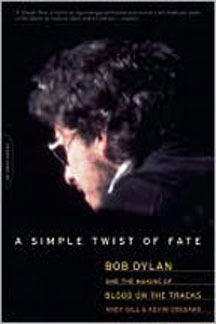 These musicians were not given credit on the record jacket, even after several repressings of the album have given the label multiple opportunities to do so.
These musicians were not given credit on the record jacket, even after several repressings of the album have given the label multiple opportunities to do so.
The Blood on the Tracks Studio Band has reunited several times, beginning with the Million Dollar Bash commemorating Dylan’s 60th birthday at First Avenue in 2001, a sold-out concert at the Pantages Theater in 2004, and its induction into the Minnesota Rock/Country Hall of Fame (now the Mid-America Music Hall of Fame) in 2005. Also in 2005, British journalist Andy Gill and Kevin Odegard co-authored a successful book A Simple Twist of Fate: Bob Dylan and The Making of Blood On The Tracks, distributed by HarperCollins, published by DaCapo Press/Perseus Books, Cambridge, MA. The book is available in local libraries or on websites such as Amazon and Barnes and Noble.
In 2009 Kevin Odegard initiated a “Blood on the Tracks Live” show at the Veterans’ Amphitheater in St. Louis Park, joined by fellow album mates Billy Peterson and Peter Ostroushko. The response was incredible, and concerts have been presented every year since, with additional concerts in Maple Grove starting in 2011. Throughout the years, numerous local musicians have joined “the family,” giving Blood on the Tracks Live a constantly changing look and sound. The band has evolved into a Dylan tribute band, not restricting artist song selections to any one album. In 2011 Kevin turned the reigns of the show over to the very capable hands of longtime friend and fellow local musician Billy Hallquist. Billy was diagnosed with colon cancer in late 2014 and his son Dan Hallquist produced the 2015 shows, along with Odegard and Marc Percansky. Billy Hallquist died in October 2015 and the concerts came to an end.
Sounds of the ’40s Show: 1974
A special “Sounds of the ’40s” Show was presented at Orchestra Hall on November 7, 1974. Performing were:
- Anita O’Day
- Cab Calloway
- Ray Eberle
- Ray MacKinley
- The Modernaires
Northern Light: 1974
From Facebook: “Minnesota,” this mostly-forgotten, Beach-Boys-in-flannel-shirts tribute to the North Star State debuted at number 98 on Billboard’s Hot 100 on May 10, 1975. It stayed on the national charts for five weeks, getting as high as 88. Northern Light was not a band as such—it was basically a group of local musicians who came together in the old Sound 80 studios in Minneapolis to create a home-grown version of the California Sound. (The group’s front man, David Sandler, had worked closely with the Beach Boys’ Brian Wilson.) By the way: That loon you hear at the beginning of the record? It was recorded in Wisconsin. May 9th, 2013. [I have an email from someone who says he performed the loon call, but I’ll have to find it!] From You Tube: Northern Light was formed in 1974 and is made up of four members: guitarist, Spence Peterson, lead guitarist, Nick Raths, bassist, Gary Lopac and David Sandler on piano. The group shares singing roles and is particularly noted for their pristine vocals and masterful pop productions. Sandler writes most of the material and does the arranging and producing with aid from other members of the group. Hear it on You Tube. Northern Light was inducted into the Minnesota Rock/Country Hall of Fame in 2007.
Fantasy Park: 1975
On October 3-5, 1975, U-100 was one of 200 stations that broadcast the syndicated “Fantasy Park: a 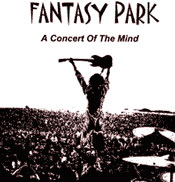 Concert of the Mind.” It was billed as the ultimate rock concert featuring over 40 “super rock stars.” Ads did not elaborate, but Scott Iwen remembered the event: “It was quite the (semi) hoax. While most people realized that this ‘simulcast concert’ was in fact just a bunch of songs being played to mimic a three day rock festival, there were some people who were convinced that this sold out concert was really happening somewhere in the Twin Cities and were just trying to figure out where. Everyone from the Rolling Stones, to the Beach Boys, to you name it, was there. The climax of the whole thing was a bunch of clamoring backstage – and sure enough, a full impromptu Beatles reunion occurred! (Funny how everyone’s songs sounded exactly like the recorded versions, not some live set somewhere, oh well.)
Concert of the Mind.” It was billed as the ultimate rock concert featuring over 40 “super rock stars.” Ads did not elaborate, but Scott Iwen remembered the event: “It was quite the (semi) hoax. While most people realized that this ‘simulcast concert’ was in fact just a bunch of songs being played to mimic a three day rock festival, there were some people who were convinced that this sold out concert was really happening somewhere in the Twin Cities and were just trying to figure out where. Everyone from the Rolling Stones, to the Beach Boys, to you name it, was there. The climax of the whole thing was a bunch of clamoring backstage – and sure enough, a full impromptu Beatles reunion occurred! (Funny how everyone’s songs sounded exactly like the recorded versions, not some live set somewhere, oh well.)
“Turns out that this Fantasy Park Studio Production was making the rounds throughout the US. Each weekend some new, unsuspecting city would ‘host’ this event via a local radio station. The concert would always be halted due to rain on the Sunday morning to allow the locals to get in their regular (usually religious) programming and the whole event always ended promptly at 6 pm on Sunday. It was so popular in the Twin Cities that a return to Fantasy Park was held about a month later. Same radio station, same format, same songs. But everyone now knew there was no ‘real’ concert to be found. One more item regarding that ‘faux concert’ – it was more than just songs being played on the radio, grouped by performer. Fantasy Park had their own emcee and special reporters covering the weekend event giving you the ‘play-by-play’ details along with with some ‘behind-the-scenes’ updates. Of course there were no interviews, but a lot of ‘unplanned’ performances arose – for example, I recall the reporter exclaiming how John Sebastian just happened to be at the concert and was then coaxed onto the stage with a borrowed guitar. From a radio station point of view, it was probably a good way to give most of the regulars the weekend off.”
The show was produced by KNUS, Dallas. DJ Beau Weaver described: The 48 hour opus had college students hitchhiking all over America hoping to get to “Fantasy Park.” In New Orleans when the concert aired, the IRS came knocking on the doors of WNOE trying to attach the gate receipts to make sure the Feds got their cut! In 1975 I had the honor of accepting the Billboard Magazine Award for Best Syndicated Radio Special.” An 18 minute demonstration demo can be heard at www.reelradio.com/bw/index.html, but a paid subscription is required.
A “Return to Fantasy Park” was broadcast on U100 on April 2-4, 1976.
Halloween Party of the Year: 1976
Danny Stevens of Danny’s Reasons hosted the “Halloween Party of the Year” at his spacious, 53-room home at 1819 Mount Curve Ave. The guest list included a number of musicians who were performing in town, including Hall and Oates, Neil Sedaka, John Denver, John Prine, and Lou Rawls. 200 other guests rounded out the event. RCA Records and Greathall Productions asked Danny to give the part because all the stars were to be in town at once. Margaret Morris of the Tribune (October 29, 1976) reported that the house was bequeathed to St. Mary’s College in Winona by a Hoover vacuum heiress and Stevens bought it in 1974 for $300,000, he says.
David Soul: 1977
David Solberg was born on August 18, 1943 in Chicago. In the early ’60s he was a bank teller in Bloomington and spent his lunch hours at the Suneson Music Center at 1611 E. Lake Street. As a folk singer he appeared many times on the Merv Griffin Show as “The Covered Man,” wearing a ski mask. He changed his name to David Soul and became an actor, playing Joshua Bolt in “Here Come the Brides” and Ken Hutchinson in “Starsky & Hutch.” In 1976 he formed Band of Friends and recorded “Don’t Give Up On Us,” which debuted on the charts on January 29, 1977 reached #1 for one week, and stayed on the charts for 19 weeks. Follow up releases were “Going in With my Eyes Open” (#54) and “Silver Lady” (#52), also in 1977.
The Suburbs: 1977
From Wikipedia:
“The Suburbs were formed in the western suburbs of Minneapolis in 1977 following introductions by Chris Osgood of the Suicide Commandos. Following live performances they released “The Suburbs” on the Twin/Tone label (the label’s first release) in early 1978. The record was a nine-song 7-inch red vinyl EP. The band also had two songs, “Urban Guerrillas” and “Ailerons O.K.,” included on the compilation “Big Hits of Mid-America, Volume Three.” Band guitarist Bruce C. Allen did the art direction for the compilation. The band’s popularity increased during the early to mid-1980s, and during this time their new wave dance sound, eclectic lyrics, and stage presence gained a following that broke out of the Midwest and reached both coasts. In 1980 Twin/Tone released their first full length LP, “In Combo.” The single “World War III” (and its B-side, “Change Agent,”) showed development of the band’s songwriting abilities and improved sound. A year later, they released the double album “Credit In Heaven” which added elements of jazz, funk, and disco to the mix. The single “Music for Boys” was taken from the record and became a radio hit. In 1982, the band released a 12-inch single “Waiting,” which frequently found its way onto dance club playlists. An EP “Dream Hog” followed on Twin/Tone, featuring three new songs and a remix of “Waiting” on the B-side, all produced by Steven Greenberg of Funkytown and Lipps Inc fame. Greenberg then brought the Suburbs to the attention of Mercury Records, which added them to their roster in 1983. Mercury started by re-issuing “Dream Hog.” By this time the band’s live performances were muscular and funky, attracting rabid fans and keeping the band busy as an opening act for the likes of Iggy Pop and the B-52’s, as well as headliners in their own right. In 1983 Polygram released “Love is the Law,” a harder-rocking album that included a horn section and some of their most off-beat lyrics, also produced by Steven Greenberg. In 1986 the Suburbs signed with A&M Records and released “The Suburbs,” produced by Prince’s Revolution drummer Bobby Z. (Robert Rivkin). Frustrated by a lack of radio play and abandoned by the major labels, the band broke up in 1987.”
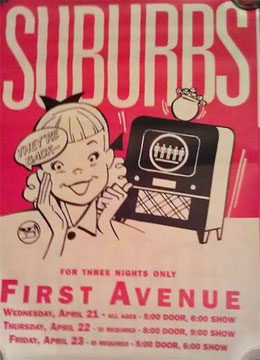
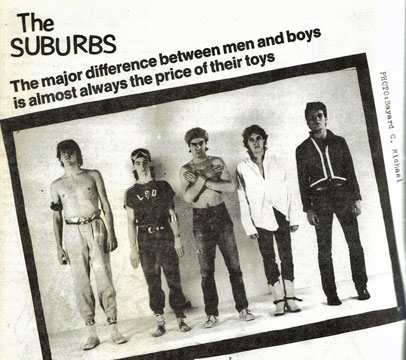
Sussman Lawrence: 1978
1977-85 were big years for Sussman Lawrence. Members, who had all gone to junior high together in St. Louis Park, were:
Peter Himmelman (lead vocals, guitar)
Andy Kamman (drums)
Eric Moen (sax, keyboards, guitar, vocals)
Jeff Victor (keyboards and vocals)
Al Wolovitch (bass, vocals).
The name came from a character on Steamroller, a local Public-access television comedy show that came on after Saturday Night Live and was produced by Park alum Buddy Cohen and written and hosted by Himmelman. The band mixed it up with some rock, reggae, jazz, punk, and performance art, playing a taped educational message before each performance just for fun. Once at Duffy’s they passed out apples and oranges from Sol’s Superette in St. Louis Park. The band played at the Park High Homecoming dance in October 1978. In an October 22, 1978 interview in the Echo, Himmelman was quoted as saying, “I want to be famous. I don’t really want to want to be famous – I know I will be. I know it won’t be the answer to everything, but I want to taste it.” In June 1979 they played at Park High’s all-night party.
Their first album, “Hail to the Modern Hero,” was released on December 19, 1979, on Bigger Than Life Records. It was advertised as “Music for the New Decade” and was recorded at Tracks on Fifth studio in St. Paul. Sussman Lawrence was featured (with other St. Louis Park band Future Legend) at “Spring Jam ’80” on June 1 at the High School Auditorium, a show produced by student radio station KDXL and coordinated by junior Bob Nelson. [Future Legend was Carey Lifson, Mark Lauer, Bill Perkakis, Keith Globus, and John French.] Sussman Lawrence also played at the St. Louis Park Prom in 1983 – “slightly sluggish after a big trip to the East Coast,” according to Ian Nemerov of the Echo, but they kept people dancing to songs such as “Torture Me” and “Call me on Monday.”
Their second album, the double LP “Pop City,” was issued in 1984. Both albums were issued on CD as “The Complete Sussman Lawrence” in 2004 on Shag Records.
Eric Clapton: 1981
On March 14, 1981, Eric Clapton was admitted to St. Paul’s United Hospital where he was confined for several weeks for a perforated ulcer. He had been given a pain-killing injection before his previous show before a sellout crowd in Madison on the 13th. He went straight to the hospital when he got to Minnesota. His manager and his wife, Pattie Boyd, were “stuck in a hotel in Minneapolis with ten feet of snow outside. Minneapolis in winter is not the most exciting place. The lake (sic) is frozen and the locals’ idea of fun is to drive a car into the middle and place bets when it will sink.” (from Pattie’s autobiography)
Events: 1980s-1990s
In the 1980s Cliff Siegel of the High Spirits worked for Warner Brothers, and at some point Prince stayed at his house in St. Louis Park near Cobble Crest. Bandmate Owen Husney was Prince’s manager, and Cliff got him his first big record deal.
1990 marked the debut of singer, songwriter, and St. Louis Park resident Dan Israel.
In 1998 Minneapolis band Semisonic has a #1 hit with “Closing Time.”
Wish I had been around for this show!
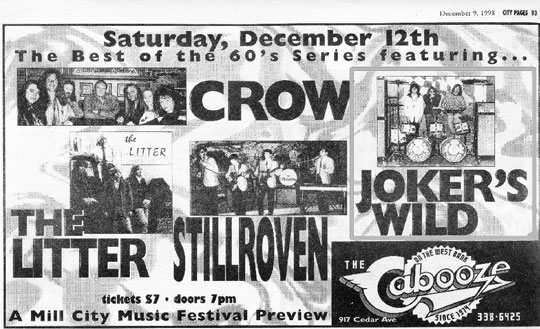
1998
The Replacements: 1981
The Replacements, purveyors of “Trash Rock,” released their first record, “Ma, I Forgot to Take Out the Trash,” in August 1981. The band had fronted Iggy Pop at Duffy’s, and each member of the band was paid $13 for the gig.
30th Anniversary of Rock ‘n’ Roll: 1988
On September 1, 1988, the Medina Ballroom was the site of a show called the 30th Anniversary of Rock ‘n’ Roll. Among the performers were:
- Otis Day and the Knights
- Badfinger
- The Coasters
- Bobby Day
- The New Seekers
- Jerry Wallace
- Danny’s Reasons
- Mitch Ryder and the Detroit Wheels
- Chuck Negron of Three Dog Night
- The Tokens
- Al Wilson
- Donnie Brooks
- Spencer Davis
- Blues Image
- Mike Pinero of Iron Butterfly
1971 Blues Pioneers at Northrop
In the summer of 1971, students at the U of M’s Minneapolis campus were treated to a series of performances by some of the most revered pioneers of blues, boogie-woogie, and nascent rock ‘n’ roll. Most of these performances took place outside, in front of Northrop Auditorium. Others were at the Whole Coffeehouse.
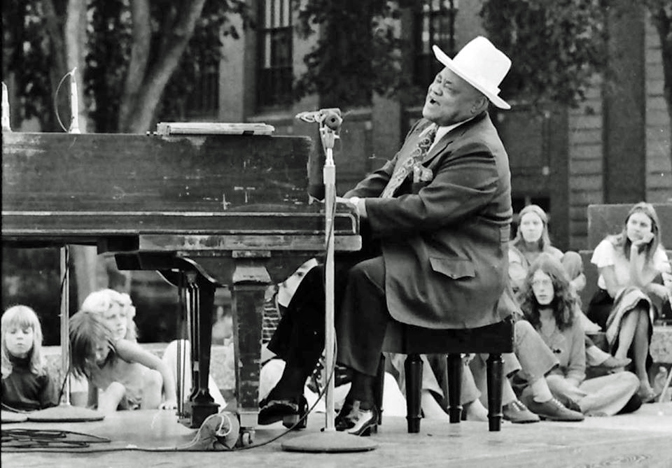
Roosevelt Sykes at Northrop, 1971. Photo by and courtesy of Gary Schwartz
Performers that people remember that summer include:
- Luther Allison
- Blind John Davis
- Hound Dog Taylor
- Big Mama Thornton
- Earl Hines
- Memphis Slim
- Drummer Jump Jackson’s blues review
- Arthur “Big Boy” Crudup
- Jesse “Lone Cat” Fuller
- Son House
Open Air Pop Festival 1970
An Open Air Pop Festival was held at Parade Stadium on July 19, 1970, attended by 6,000 people. This is not to be confused with the two Open Air Festivals held at Midway Stadium in the summer of 1971. This festival was organized by Pat Raines, the owner of the Prison in Burnsville.
Performers who were advertised were:
- Sly and the Family Stone
- Johnny Winter
- Richie Havens
- The Amboy Dukes. They didn’t show, and were replaced by the Illinois Speed Press.
- blumsberry people. Well, they didn’t show either, maybe because the ad butchered their name? There was a band called The Bloomsbury People, described on discogs as a psych rock band out of Milwaukee. This was presumably the warmup band and was replaced by local favorites, White Lightning.
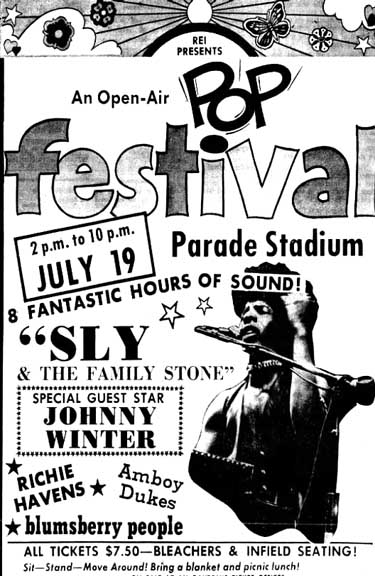
REVIEWS
6,000 fans attended the concert on the gray and blustery day, and it merited reviews in both the Minneapolis Star, by free-lance reviewer Kristen Bachler, and the Minneapolis Tribune, by Will Shapira, who reviewed concerts for the Trib and for Connie’s Insider. Let’s go act by act.
White Lightning opened the show in a hurry, according to Shapira, with tributes to Dick Nixon and Richard Daley. Bachler dismissed them as a “dance rock” band, but liked their “Fantasy Daze 2” original piece. Both enjoyed their crowd-pleasing version of the “William Tell Overture.”
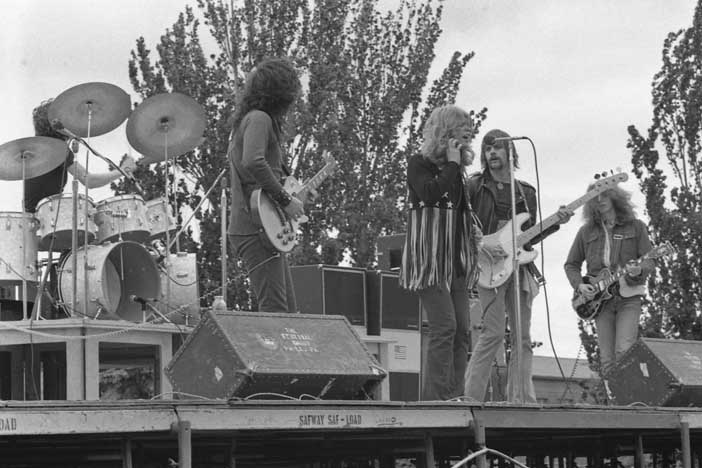
White Lightning at Open Air Pop Festival. Photo copyright Mike Barich, St. Paul
Sly and the Family Stone had committed to play this festival and also Randall’s Island rock festival in New York on the same day. Pat Raines got wind of the double booking and obtained an order in Manhattan Superior Court requiring Sly to appear in Minneapolis. “They were interested in both festivals and weren’t sure which they would make,” said Raines. We helped them make up their minds.” Another version of the story is that Sly had told Raines that he wanted out of his contract ahead of time, but after some jockeying of time spots, he agreed to appear.
At any rate he was there, although he came on at least an hour late and reportedly drunk, starting with the words “Minneapolis stinks.” Sly supposedly called Minneapolis “worthless.” Doug Hoaglund remembered “Sly was very late and the emcee was making excuses like “traffic” or something. When Sly stumbled onstage he laughed about the excuses and said he was sitting in his Limo behind the stage. He sounded out of it. Dumb.” Reviewer Shapira complained that “Sly spent too much time indulging in non sequiturs and curbstone philosophy.”
Illinois Speed Press unveiled a new Country-Rock sound at the show, according to Shapira. He liked it, and so did Bachler, but the latter noted that the group received only a cool response from the audience.
Johnny Winter made his fourth visit to the Twin Cities here, and was the crowd favorite. He shone with his work on electric and slide guitars, “reaching his greatest heights during a guitar duet with Rick Derringer.”
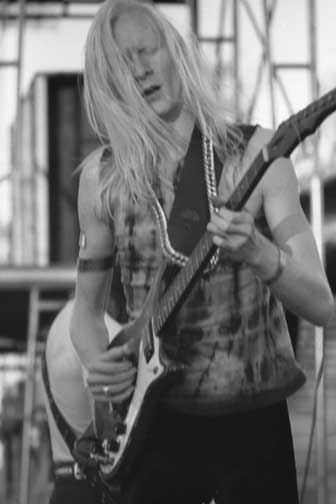
Johnny Winter at Open Air Pop Festival. Photo copyright Mike Barich, St. Paul
Richie Havens closed the show with an excellent set that included his current hit, “Handsome Johnny,” “Fire and Rain,” and his signature “Freedom.” Shapira called him an eloquent and compelling folk singer. Bachler wrote that “the audience really came alive for the first time during the entire day on “Freedom.”
UPSHOT
Bachelor wrote that the festival was beautifully run, and there was potential for magic, but it was lost in the “lifeless, conditioned responses of a large share of the audience.” She felt there was no real connection between the musicians and the people who had come to see them.
Shapira also gave the festival administration high marks, but went further:
Except for the delay before Sly, the festival proceeded without excessive delay. The sound system was good throughout, and between sets a number of people brought out picnic baskets, others communed with mother nature and just about everybody seemed to dig the music and the scene.
There was no major trouble, despite or because of at least 150 cops in riot gear standing guard. There were 20 arrests, many for gate crashing, which was a fad then, especially for outdoor concerts, but cops left dope smokers alone. Rains hired 10 Olympic karate experts from the Midwest Karate Association to keep people off the stage. Other arrests were for obscenity in public, breach of the peace, defacing the American flag, drunkenness, and damaging trees. The names and addresses of the adult (over 18) men who committed these crimes (!) were published in the paper.
For his trouble, Pat Raines lost $35,000.
John Lowen remembered, “What a wild scene it was! Mounted Cops, hippies scaling the fences, Sly screwing up the whole deal, oh what a blast we had though.”
Sources:
Minneapolis Star, July 16 and 20, 1970
Minneapolis Tribune, July 20, 1970
Open Air Celebrations
There were four events that could fall under the category of “Open Air” Celebrations.
The Open Air Pop Festival, July 19, 1970
Open Air Celebration I: June 26, 1971
Open Air Celebration II: July 24, 1971
Open Air Celebration III: August 22, 1971 (Cancelled)
Super Sunday Spectacular: 1969
On February 9, 1969, a Super Sunday Spectacular band marathon was held at the New City Opera House, sponsored by Traficante Music Store. The event took place from 4 pm to midnight. The bands were:
- Pepper Fog
- Milk Novelty
- Extra Added Soul
- White Lightning – one of the biggest draws
- Dragons
- Blue Surge
- Orpheus – one of the biggest draws
- Railroad Company
Connie Hechter, in his February 15 – 22, 1969, Insider, declared Pepper Fog “one of the more outstanding bands I heard.”
Attendance was cut by the Labor Temple show featuring Rotary Connection and Jethro Tull.
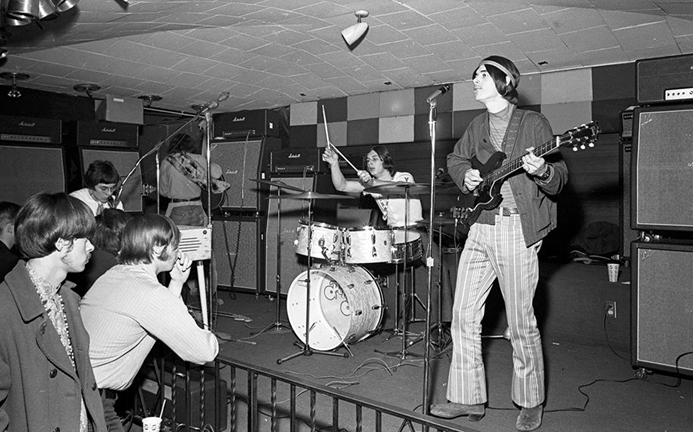
Pepper Fog: Gregg Inhofer, Ron , Bobby Strength, Dale Strength – Photo copyright Mike Barich
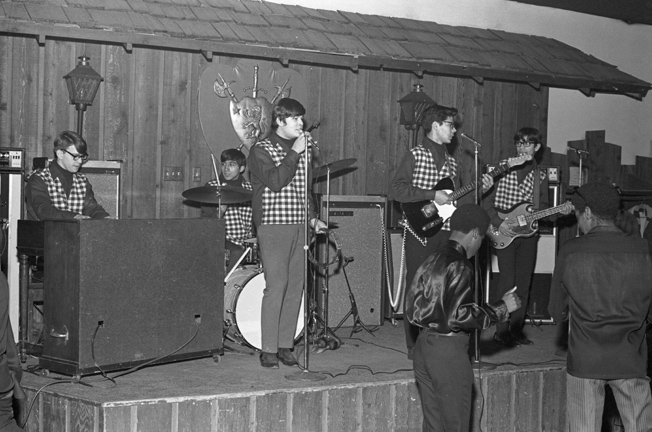
Extra Added Soul – Photo copyright Mike Barich
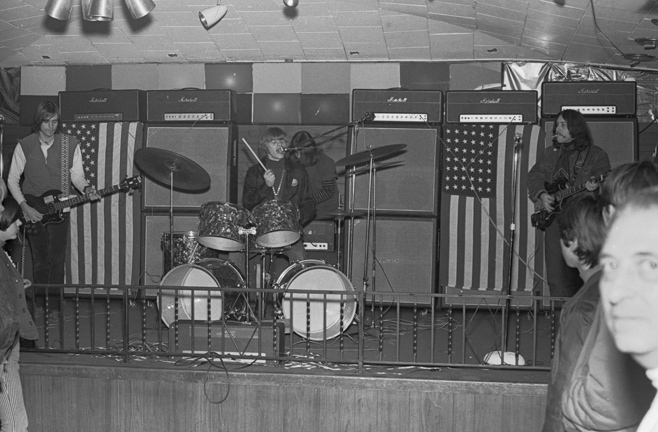
White Lightning – Woody Woodrich, Mick Stanhope, and Zip Caplan. Photo copyright Mike Barich.
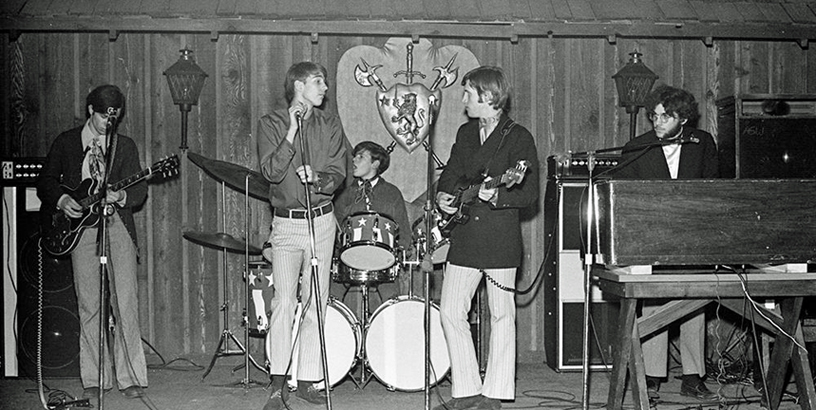
Blue Surge – Photo copyright Mike Barich, St. Paul
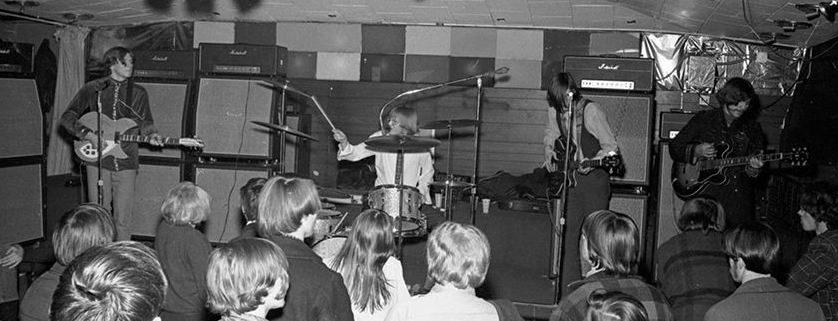
Orpheus – Photo copyright Mike Barich, St. Paul
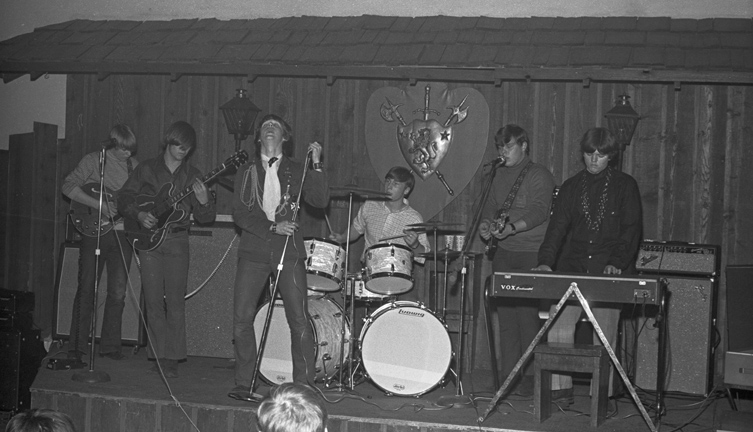
Railroad Company: Brian Olson, Terry Spaeth, Barry Whalen, Tom “Buck” Murray and Pat Murtha. Gary “Gus”Gustafson on drums. Photo copyright Mike Barich

